Robert Bosch Car Multimedia LCN20A Radio Navigation System with Bluetooth User Manual 1093929 2013 asd own
Robert Bosch Car Multimedia GmbH Radio Navigation System with Bluetooth 1093929 2013 asd own
08 user guide

JOBNAME: 1093929-2013-asd-own PAGE: 1 SESS: 4 OUTPUT: Tue Mar 27 10:39:14 2012
Welcome to the growing family of new NISSAN
owners. This vehicle is delivered to you with
confidence. It was produced using the latest
techniques and strict quality control.
This manual was prepared to help you under-
stand the operation and maintenance of your
vehicle so that you may enjoy many miles (kilome-
ters) of driving pleasure. Please read through this
manual before operating your vehicle.
A separate Warranty Information Booklet
explains details about the warranties cov-
ering your vehicle. The “NISSAN Service
and Maintenance Guide” explains details
about maintaining and servicing your ve-
hicle. Additionally, a separate Customer
Care/Lemon Law Booklet (U.S. only) will
explain how to resolve any concerns you
may have with your vehicle, as well as
clarify your rights under your state’s lemon
law.
Your NISSAN dealership knows your vehicle
best. When you require any service or have any
questions, they will be glad to assist you with the
extensive resources available to them.
In addition to factory installed options, your ve-
hicle may also be equipped with additional ac-
cessories installed by NISSAN or by your
NISSAN dealer prior to delivery. It is important
that you familiarize yourself with all disclosures,
warnings, cautions and instructions concerning
proper use of such accessories prior to operating
the vehicle and/or accessory. See a NISSAN
dealer for details concerning the particular ac-
cessories with which your vehicle is equipped.
Before driving your vehicle, please read this
Owner’s Manual carefully. This will ensure famil-
iarity with controls and maintenance require-
ments, assisting you in the safe operation of your
vehicle.
WARNING
IMPORTANT SAFETY INFORMATION RE-
MINDERS FOR SAFETY!
Follow these important driving rules to
help ensure a safe and comfortable trip
for you and your passengers!
●NEVER drive under the influence of al-
cohol or drugs.
●ALWAYS observe posted speed limits
and never drive too fast for conditions.
●
ALWAYS give your full attention to driving
and avoid using vehicle features or taking
other actions that could distract you.
●
ALWAYS use your seat belts and appro-
priate child restraint systems. Preteen
children should be seated in the rear seat.
●ALWAYS provide information about the
proper use of vehicle safety features to
all occupants of the vehicle.
●ALWAYS review this Owner’s Manual
for important safety information.
FOREWORD READ FIRST—THEN DRIVE SAFELY
ZREVIEW COPY—
2013 Altima Sedan (asd)
Owners Manual—USA_English (nna)
03/24/12—dmoore
X
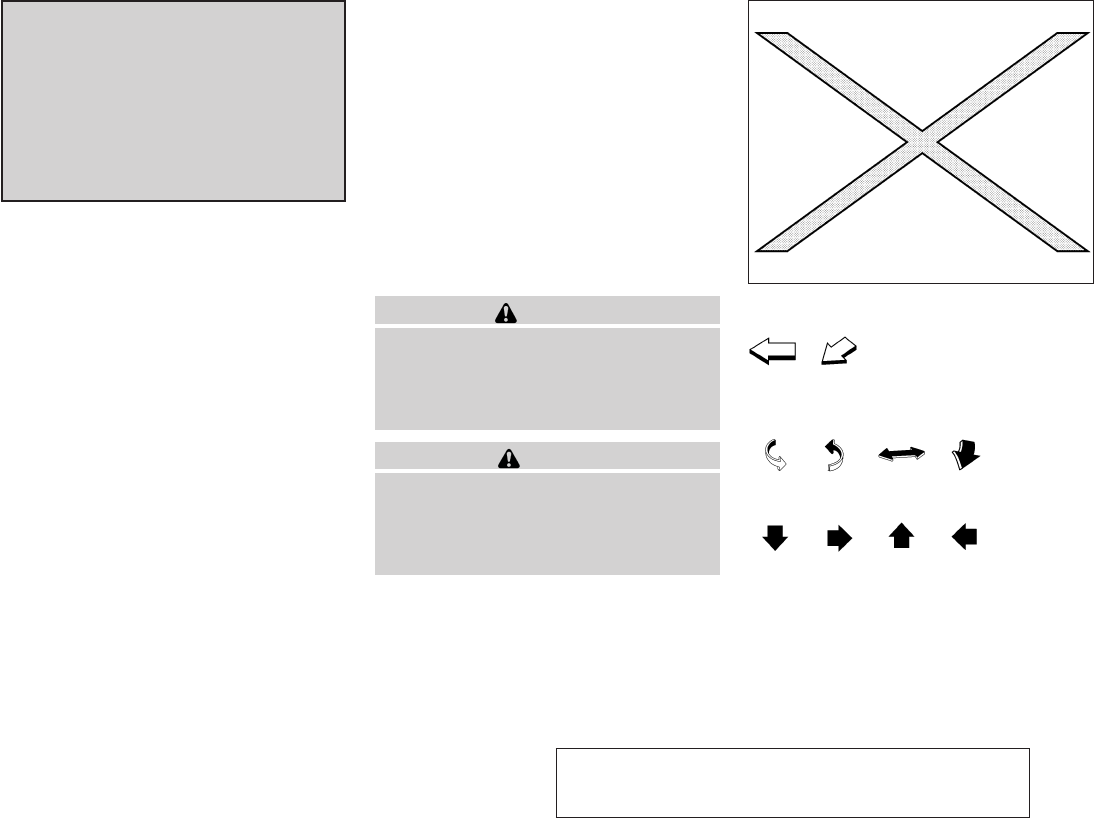
JOBNAME: 1093929-2013-asd-own PAGE: 2 SESS: 4 OUTPUT: Tue Mar 27 10:39:14 2012
MODIFICATION OF YOUR VEHICLE
This vehicle should not be modified.
Modification could affect its
performance, safety or durability, and
may even violate governmental
regulations. In addition, damage or per-
formance problems resulting from modi-
fications may not be covered under
NISSAN warranties.
This manual includes information for all options
available on this model. Therefore, you may find
some information that does not apply to your
vehicle.
All information, specifications and illustrations in
this manual are those in effect at the time of
printing. NISSAN reserves the right to change
specifications or design without notice and with-
out obligation.
IMPORTANT INFORMATION ABOUT
THIS MANUAL
You will see various symbols in this manual. They
are used in the following ways:
WARNING
This is used to indicate the presence of a
hazard that could cause death or serious
personal injury. To avoid or reduce the
risk, the procedures must be followed
precisely.
CAUTION
This is used to indicate the presence of a
hazard that could cause minor or moder-
ate personal injury or damage to your ve-
hicle. To avoid or reduce the risk, the pro-
cedures must be followed carefully.
If you see this symbol, it means “Do not do this”
or “Do not let this happen.”
If you see a symbol similar to these in an illustra-
tion, it means the arrow points to the front of the
vehicle.
Arrows in an illustration that are similar to these
indicate movement or action.
Arrows in an illustration that are similar to these
call attention to an item in the illustration.
APD1005
WHEN READING THE MANUAL
ZREVIEW COPY—
2013 Altima Sedan (asd)
Owners Manual—USA_English (nna)
03/24/12—dmoore
X
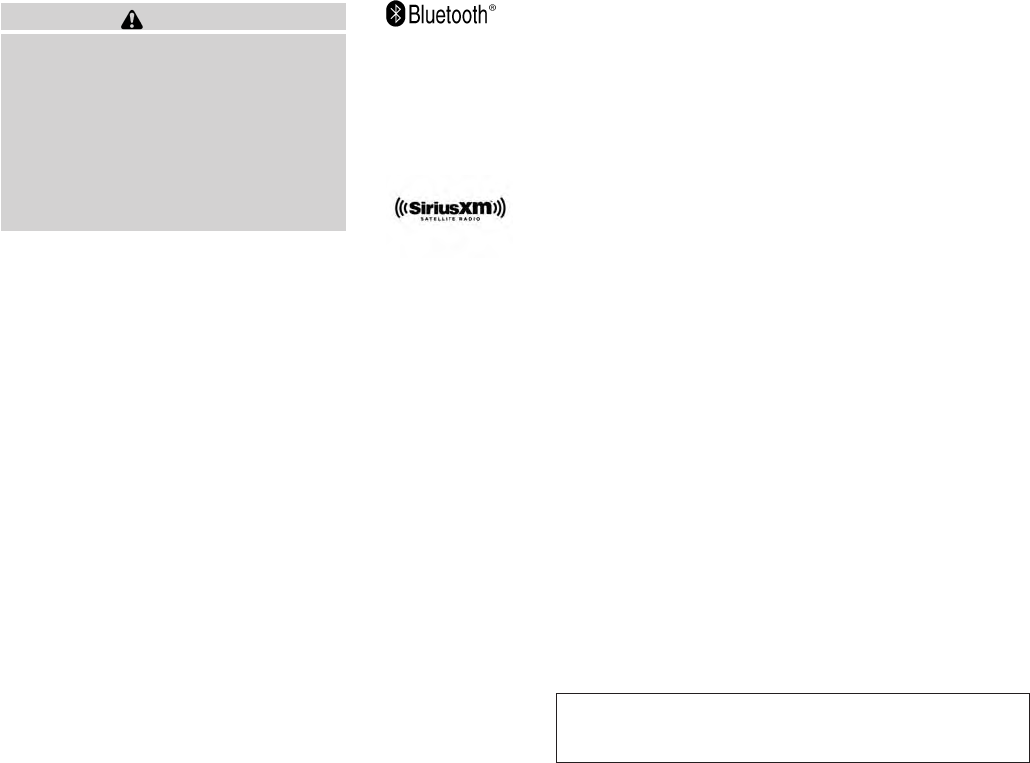
JOBNAME: 1093929-2013-asd-own PAGE: 3 SESS: 4 OUTPUT: Tue Mar 27 10:39:14 2012
CALIFORNIA PROPOSITION 65
WARNING
WARNING
Engine exhaust, some of its constituents,
and certain vehicle components contain
or emit chemicals known to the State of
California to cause cancer and birth de-
fects or other reproductive harm. In addi-
tion, certain fluids contained in vehicles
and certain products of component wear
contain or emit chemicals known to the
State of California to cause cancer and
birth defects or other reproductive harm.
CALIFORNIA PERCHLORATE
ADVISORY
Some vehicle parts, such as lithium batter-
ies, may contain perchlorate material. The
following advisory is provided: “Perchlorate
Material – special handling may apply, See
www.dtsc.ca.gov/hazardouswaste/perchlorate/”.
BLUETOOTHtis a
trademark owned by
Bluetooth SIG, Inc.
and licensed to
Visteon and Clarion.
SiriusXM Satellite
Radio requires sub-
scription, sold sepa-
rately. Not available
in Alaska, Hawaii or
Guam. For more
information, visit
www.siriusxm.com.
© 2012 NISSAN NORTH AMERICA, INC.
All rights reserved. No part of this Owner’s
Manual may be reproduced or stored in a retrieval
system, or transmitted in any form, or by any
means, electronic, mechanical, photocopying,
recording or otherwise, without the prior written
permission of Nissan North America, Inc.
ZREVIEW COPY—
2013 Altima Sedan (asd)
Owners Manual—USA_English (nna)
03/24/12—dmoore
X

JOBNAME: 1093929-2013-asd-own PAGE: 4 SESS: 4 OUTPUT: Tue Mar 27 10:39:14 2012
NISSAN CARES . . .
Both NISSAN and your NISSAN dealer are dedicated to serving all your automotive needs. Your satisfaction with your vehicle and your NISSAN dealer are
our primary concerns. Your NISSAN dealer is always available to assist you with all your automobile sales and service needs.
However, if there is something that your NISSAN
dealer cannot assist you with or you would like to
provide NISSAN directly with comments or
questions, please contact the NISSAN Con-
sumer Affairs Department using our toll-free
number:
For U.S. customers
1-800-NISSAN-1
(1-800-647-7261)
For Canadian customers
1-800-387-0122
The Consumer Affairs Department will ask for the
following information:
– Your name, address, and telephone number
– Vehicle identification number (attached to the
top of the instrument panel on the driver’s
side)
– Date of purchase
– Current odometer reading
– Your NISSAN dealer’s name
– Your comments or questions
OR
You can write to NISSAN with the information at:
For U.S. customers
Nissan North America, Inc.
Consumer Affairs Department
P.O. Box 685003
Franklin, TN 37068-5003
For Canadian customers
Nissan Canada Inc.
5290 Orbitor Drive
Mississauga, Ontario L4W 4Z5
or via e-mail at:
For U.S. customers
nnaconsumeraffairs@nissan-usa.com
For Canadian customers
information.centre@nissancanada.com
We appreciate your interest in NISSAN and thank you for buying a quality NISSAN vehicle.
NISSAN CUSTOMER CARE PROGRAM
ZREVIEW COPY—
2013 Altima Sedan (asd)
Owners Manual—USA_English (nna)
03/24/12—dmoore
X

JOBNAME: 1093929-2013-asd-own PAGE: 5 SESS: 4 OUTPUT: Tue Mar 27 10:39:14 2012
Table of
Contents
Illustrated table of contents
Safety—Seats, seat belts and supplemental restraint system
Instruments and controls
Pre-driving checks and adjustments
Monitor, climate, audio, phone and voice recognition systems
Starting and driving
In case of emergency
Appearance and care
Maintenance and do-it-yourself
Technical and consumer information
Index
0
1
2
3
4
5
6
7
8
9
10

JOBNAME: 1093929-2013-asd-own PAGE: 6 SESS: 4 OUTPUT: Tue Mar 27 10:39:14 2012
ZREVIEW COPY—
2013 Altima Sedan (asd)
Owners Manual—USA_English (nna)
03/24/12—dmoore
X

JOBNAME: 1093929-2013-asd-own PAGE: 7 SESS: 5 OUTPUT: Tue Mar 27 10:39:14 2012
0 Illustrated table of contents
Air bags, seat belts and child restraints . . . . . . . . . . . . . . 0-2
Exteriorfront......................................0-3
Exteriorrear.......................................0-4
Passengercompartment ...........................0-5
Instrument panel. . . . . . . . . . . . . . . . . . . . . . . . . . . . . . . . . . . 0-6
Engine compartment check locations . . . . . . . . . . . . . . . . 0-8
Warning/indicator lights . . . . . . . . . . . . . . . . . . . . . . . . . . .0-10
ZREVIEW COPY—
2013 Altima Sedan (asd)
Owners Manual—USA_English (nna)
03/24/12—dmoore
X
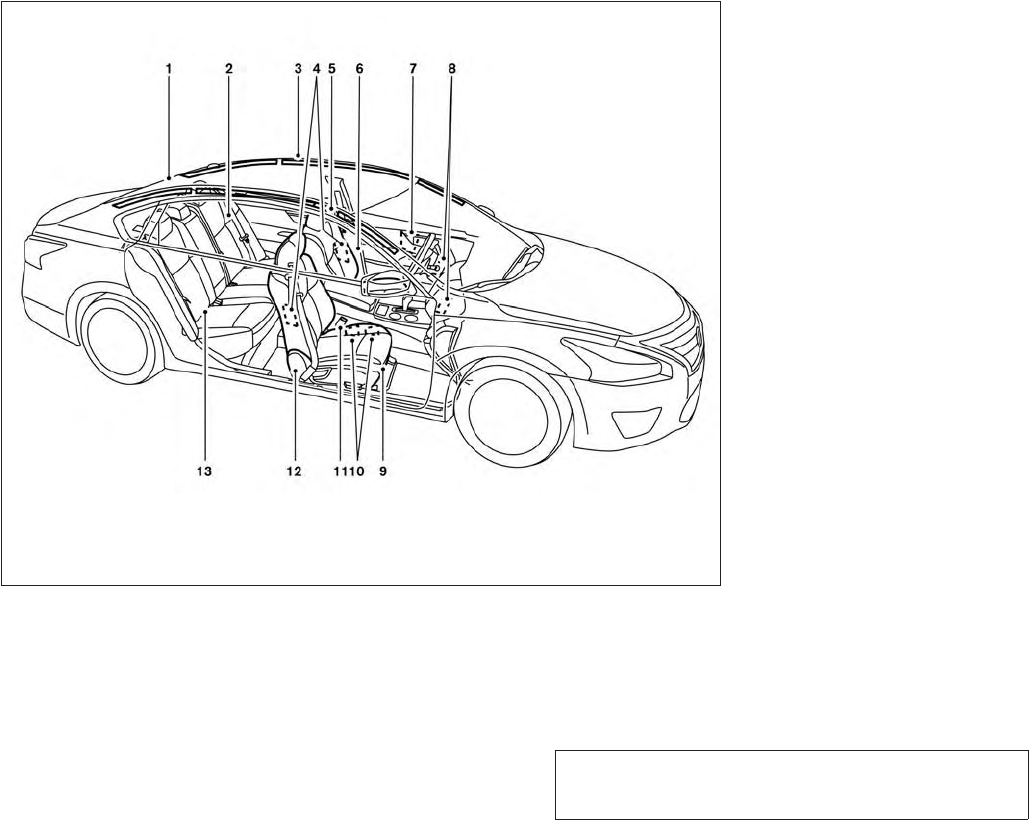
JOBNAME: 1093929-2013-asd-own PAGE: 8 SESS: 5 OUTPUT: Tue Mar 27 10:39:14 2012
1. Top tether strap anchor (P. 1-23)
2. Rear seat belts (P. 1-10)
3. Roof-mounted curtain side-impact
supplemental air bag (P. 1-37)
4. Front seat-mounted side-impact
supplemental air bag (P. 1-37)
5. Head restraints (P. 1-7)
6. Front seat belts (P. 1-10)
7. Side-impact pressure sensor (driver’s
side shown; passenger’s side similar)
(P. 1-52)
8. Supplemental front-impact air bags
(P. 1-37)
9. Seats (P. 1-2)
10. Occupant classification sensor
(weight sensor) (P. 1-45)
11. Pretensioners (P. 1-45)
12. Seat belt with pretensioner (P. 1-51)
13. LATCH (Lower Anchors and Tethers for
CHildren) system (P. 1-21)
See the page number indicated in paren-
theses for operating details.
LII2041
AIR BAGS, SEAT BELTS AND CHILD
RESTRAINTS
0-2 Illustrated table of contents
ZREVIEW COPY—
2013 Altima Sedan (asd)
Owners Manual—USA_English (nna)
03/24/12—dmoore
X
11
12
11
12
Per engineering comment,
pretensioners are not in
the buckle
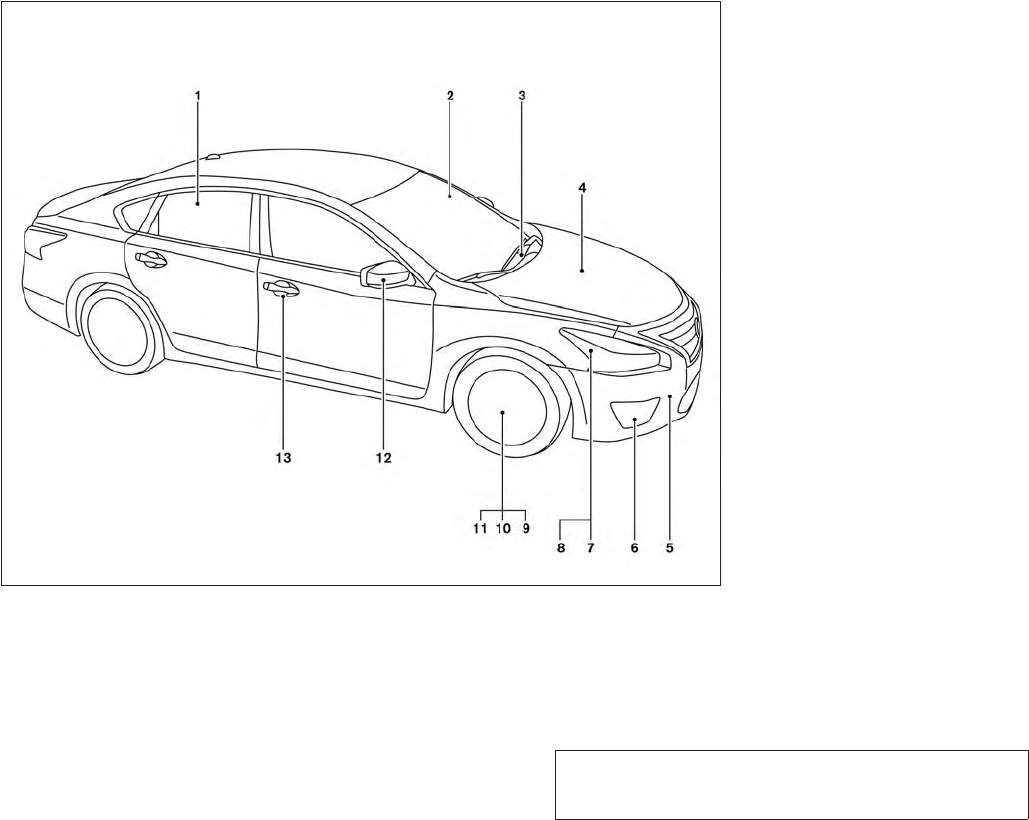
JOBNAME: 1093929-2013-asd-own PAGE: 9 SESS: 5 OUTPUT: Tue Mar 27 10:39:14 2012
1. Power windows (P. 2-42)
2. Windshield (P. 8-21)
3. Windshield wiper and washer switch
(P. 2-28)
4. Engine hood (P. 3-27)
5. Tie down (P. 6-12)
6. Fog light switch (if so equipped)
(P. 2-29)
7. Headlight and turn signal switch
(P. 2-30)
8. Replacing bulbs (P. 8-28)
9. Tire pressure (P. 8-35)
10. Flat tire (P. 6-2)
11. Tire chains (P. 8-43)
12. Mirrors (P. 3-33)
13. Door locks, NISSAN Intelligent Key ™,
keys (P. 3-4, 3-6, 3-2)
See the page number indicated in paren-
theses for operating details.
LII2038
EXTERIOR FRONT
Illustrated table of contents 0-3
ZREVIEW COPY—
2013 Altima Sedan (asd)
Owners Manual—USA_English (nna)
03/24/12—dmoore
X
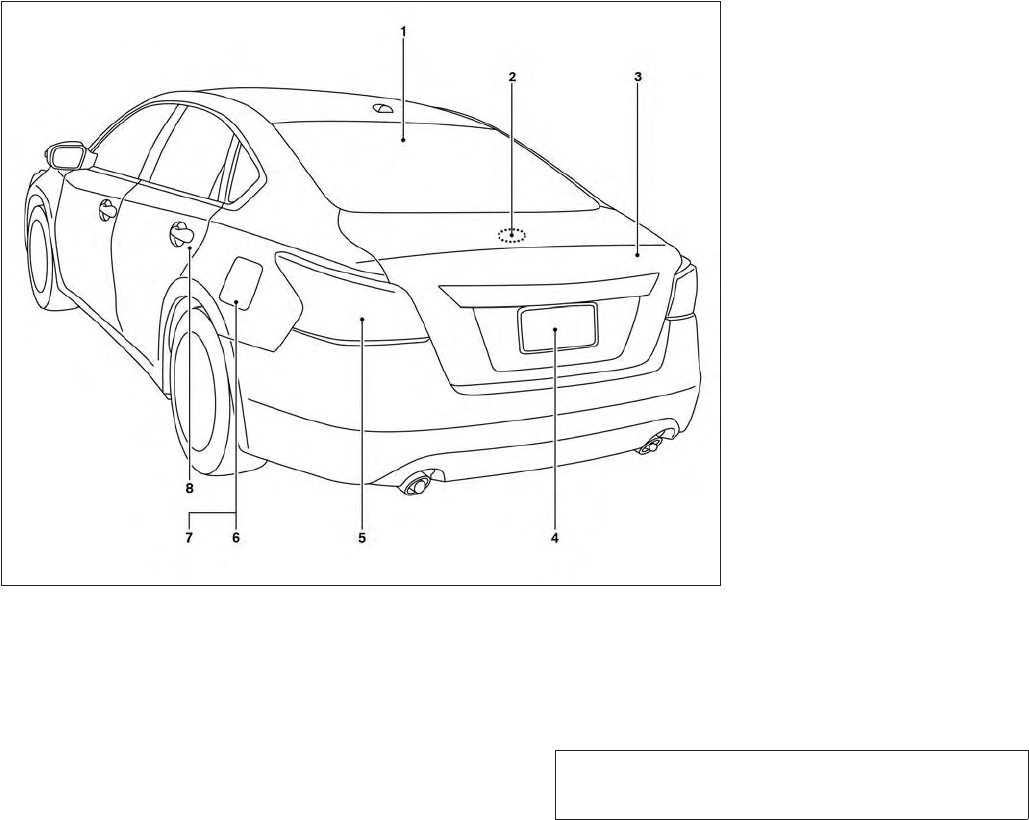
JOBNAME: 1093929-2013-asd-own PAGE: 10 SESS: 5 OUTPUT: Tue Mar 27 10:39:14 2012
1. Rear window defroster switch (P. 2-29)
2. Interior trunk lid release (P. 3-29)
3. Trunk lid (P. 3-27)
4. Opener operation (P. 3-28)
5. Replacing bulbs (P. 8-28)
6. Fuel-filler cap, fuel recommendation
(P. 3-30, P. 9-3)
7. Fuel-filler door (P. 3-30)
8. Child safety rear door lock (P. 3-6)
See the page number indicated in paren-
theses for operating details.
LII2039
EXTERIOR REAR
0-4 Illustrated table of contents
ZREVIEW COPY—
2013 Altima Sedan (asd)
Owners Manual—USA_English (nna)
03/24/12—dmoore
X
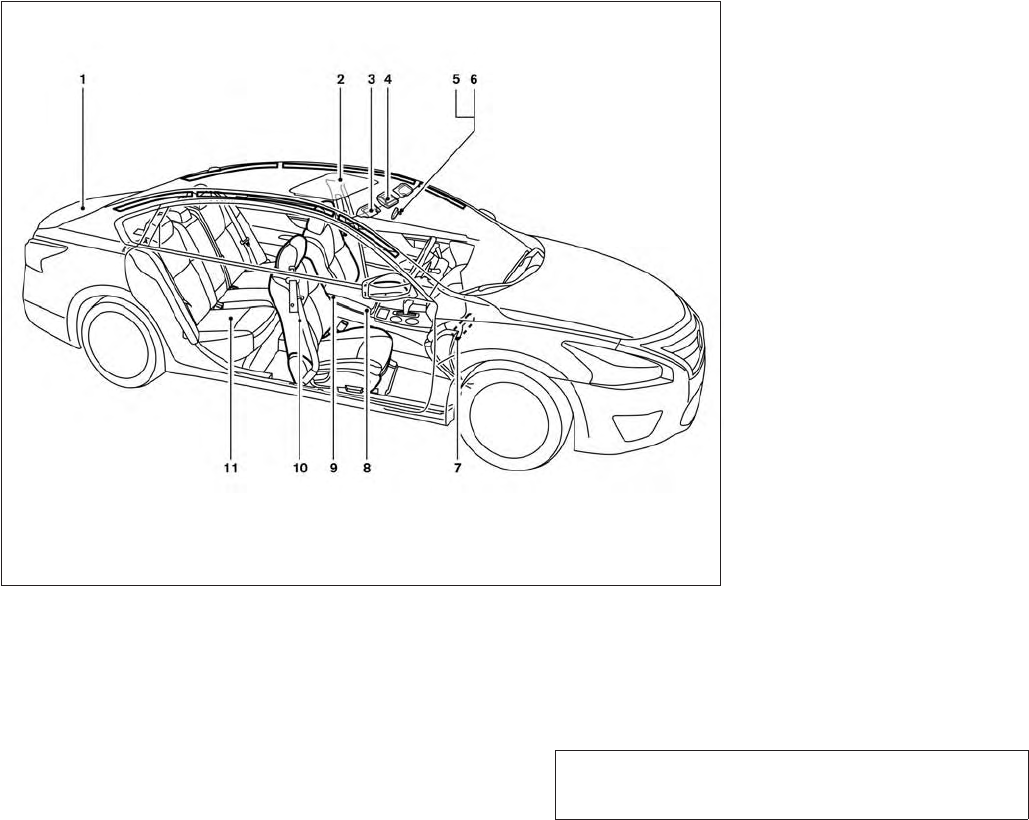
JOBNAME: 1093929-2013-asd-own PAGE: 11 SESS: 5 OUTPUT: Tue Mar 27 10:39:14 2012
1. Interior trunk access (P. 1-6)
2. Moonroof (if so equipped) (P. 2-45)
3. Sun visors (P. 3-32)
4. Interior lights, illuminated entry (P. 2-47)
5. HomeLinkTuniversal transceiver
(if so equipped) (P. 2-49)
6. Automatic anti-glare rearview mirror
(if so equipped) (P. 3-33)
7. Glove box (P. 2-41)
8. Cup holders (P. 2-40 )
9. Console box (P. 2-41)
10. Front seat (P. 1-2)
11. Rear seat (P. 1-6)
See the page number indicated in paren-
theses for operating details.
LII2040
PASSENGER COMPARTMENT
Illustrated table of contents 0-5
ZREVIEW COPY—
2013 Altima Sedan (asd)
Owners Manual—USA_English (nna)
03/24/12—dmoore
X
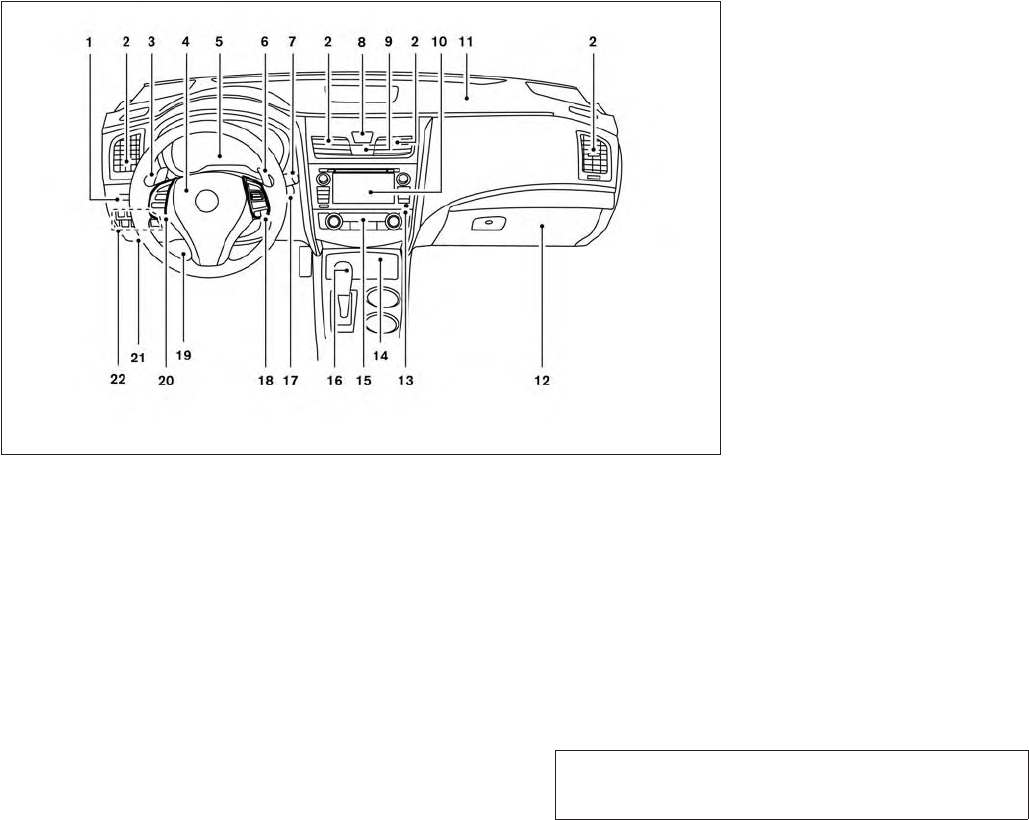
JOBNAME: 1093929-2013-asd-own PAGE: 12 SESS: 5 OUTPUT: Tue Mar 27 10:39:14 2012
1. Instrument brightness control/Trip
computer reset switch (P. 2-34, P. 2-4)
2. Vents (P. 4-18)
3. Headlight/fog light (if so equipped)/turn
signal switch (P. 2-30)
4. Driver supplemental air bag/horn
(P. 1-37, P. 2-35)
5. Meters and gauges (P. 2-3)
6. Paddle shift controls (if so equipped)
(P. 5-15)
7. Windshield wiper/washer switch
(P. 2-28)
8. Hazard warning flasher switch (P. 2-35)
9. Front passenger air bag status light
(P. 1-45)
10. Audio system controls/Navigation
system* (P. 4-30)
11. Front passenger supplemental air bag
(P. 1-37)
12. Glove box (P. 2-41)
13. Aux jack (P. 4-41, 4-47, 4-54)
14. Power outlet/USB port (P.2-38, 4-54,
4-56)
15. Heater and air conditioner (manual or
automatic) (P. 4-19, P. 4-27)
16. Shift selector (P. 5-13)
17. Push-button ignition switch (P. 5-8)
18. Cruise control main/set switch/
BluetoothTHands-free Phone System
(P.5-19 / P. 4-96, P. 4-70, P. 4-85 )
19. Tilt/telescopic steering wheel controls
(P. 3-32)
20. Steering wheel switch for audio control
/Vehicle information display controls
( P. 4-68, P. 2-17)
21. Fuel filler door release/Hood release)
(P. 3-30, P. 3-27)
LIC2369
INSTRUMENT PANEL
0-6 Illustrated table of contents
ZREVIEW COPY—
2013 Altima Sedan (asd)
Owners Manual—USA_English (nna)
03/24/12—dmoore
X

JOBNAME: 1093929-2013-asd-own PAGE: 13 SESS: 5 OUTPUT: Tue Mar 27 10:39:14 2012
22. Vehicle Dynamic Control OFF switch
(P. 2-37)
Trunk opener (P. 3-27)
Heated steering wheel switch
(if so equipped) (P. 2-37)
* Refer to the Navigation System Owner’s manual
(if so equipped)
See the page number indicated in paren-
theses for operating details.
Illustrated table of contents 0-7
ZREVIEW COPY—
2013 Altima Sedan (asd)
Owners Manual—USA_English (nna)
03/24/12—dmoore
X
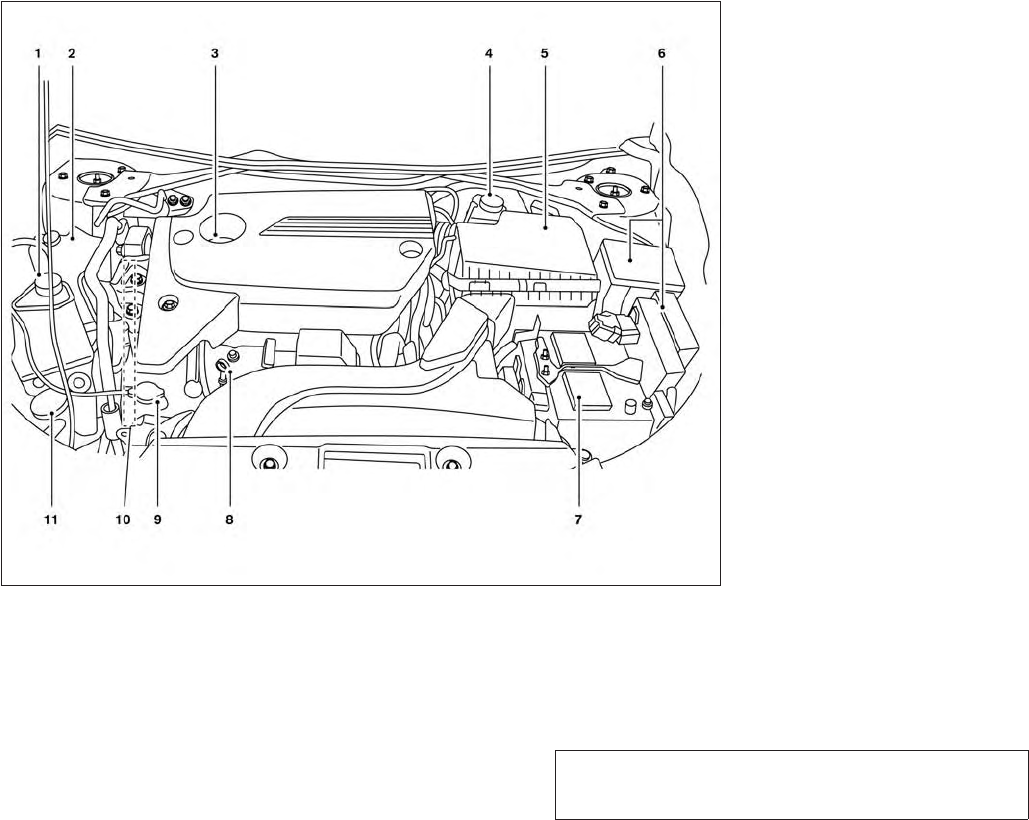
JOBNAME: 1093929-2013-asd-own PAGE: 14 SESS: 5 OUTPUT: Tue Mar 27 10:39:14 2012
QR25DE engine
1. Power steering fluid reservoir (P. 8-14)
2. Engine coolant reservoir (P. 8-8)
3. Engine oil filler cap (P. 8-10)
4. Brake fluid reservoir (P. 8-15)
5. Air cleaner (P. 8-20)
6. Fuse/fusible link box (P. 8-23)
7. Battery (P. 8-16)
8. Engine oil dipstick (P. 8-10)
9. Radiator cap (P. 8-8)
10. Drive belt location (P. 8-19)
11. Windshield-washer fluid reservoir1 (P.
8-15)
See the page number indicated in paren-
theses for operating details.
LDI2111
ENGINE COMPARTMENT CHECK
LOCATIONS
0-8 Illustrated table of contents
ZREVIEW COPY—
2013 Altima Sedan (asd)
Owners Manual—USA_English (nna)
03/24/12—dmoore
X
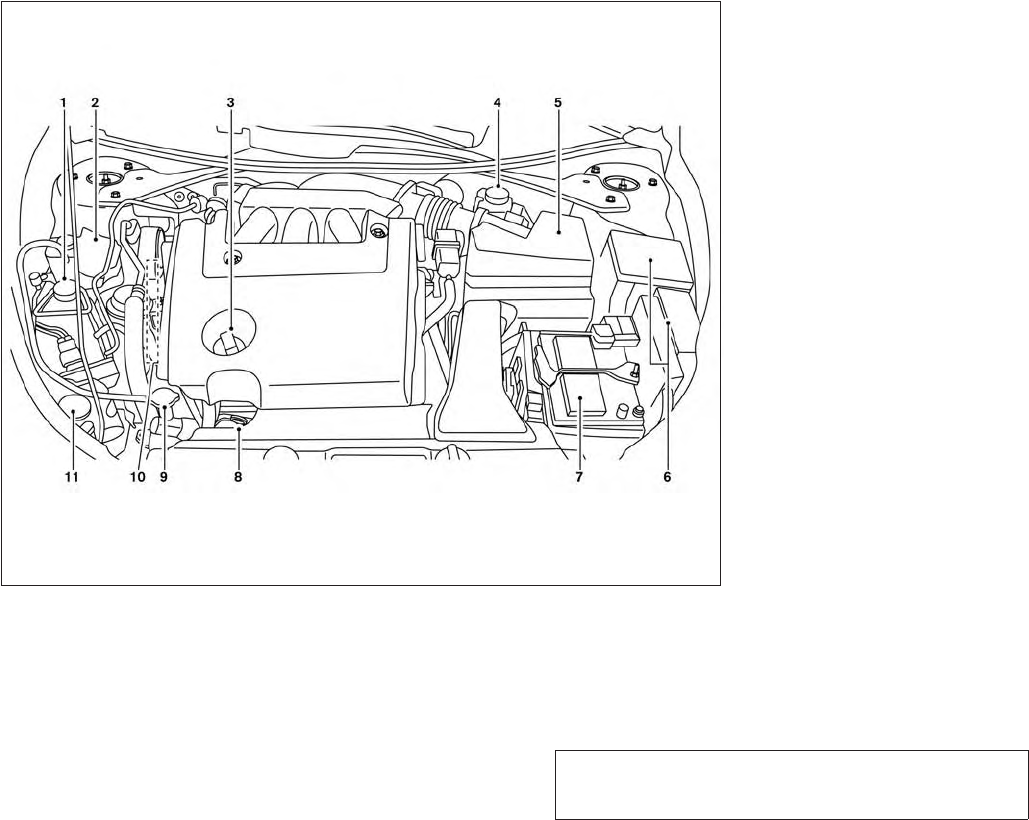
JOBNAME: 1093929-2013-asd-own PAGE: 15 SESS: 5 OUTPUT: Tue Mar 27 10:39:14 2012
VQ35DE engine
1. Power steering fluid reservoir (P. 8-14)
2. Engine coolant reservoir (P. 8-8)
3. Engine oil filler cap (P. 8-10)
4. Brake fluid reservoir (P. 8-15)
5. Air cleaner (P. 8-20)
6. Fuse/fusible link box (P. 8-23)
7. Battery (P. 8-16)
8. Engine oil dipstick (P. 8-10)
9. Radiator cap (P. 8-8)
10. Drive belt location (P. 8-19)
11. Windshield-washer fluid reservoir
(P. 8-15)
See the page number indicated in paren-
theses for operating details.
LDI2112
Illustrated table of contents 0-9
ZREVIEW COPY—
2013 Altima Sedan (asd)
Owners Manual—USA_English (nna)
03/24/12—dmoore
X
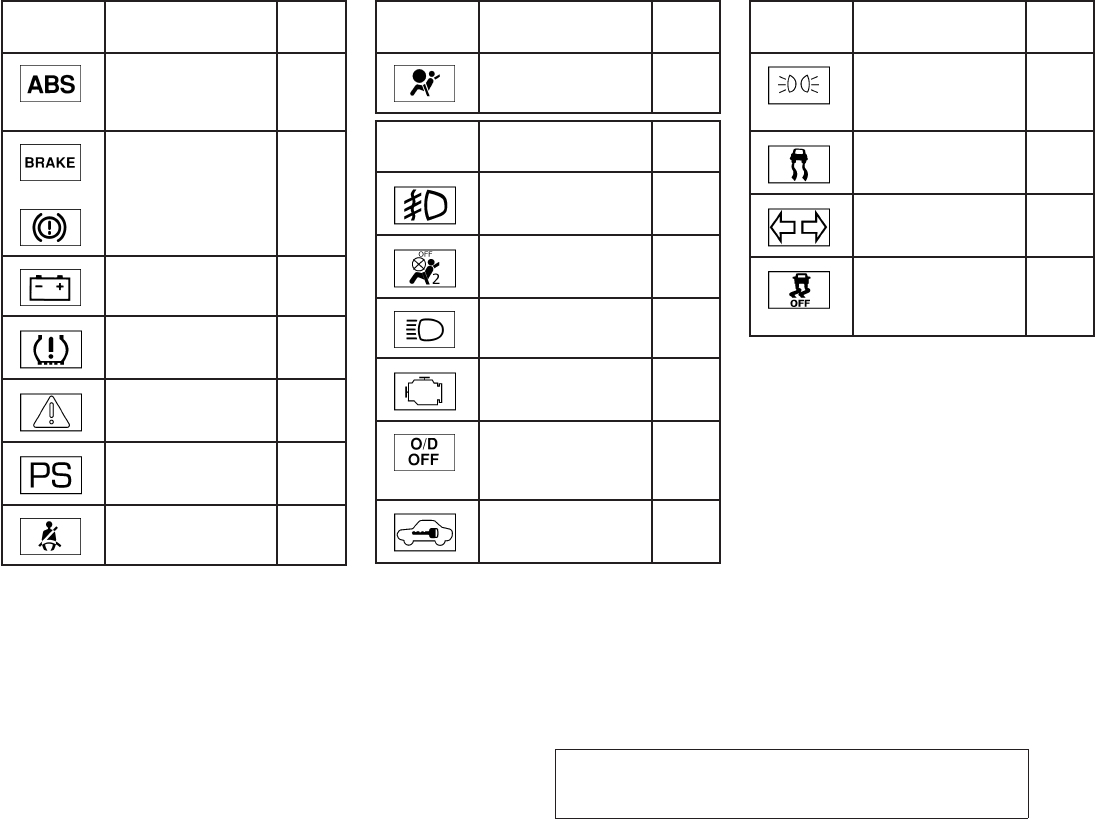
JOBNAME: 1093929-2013-asd-own PAGE: 16 SESS: 5 OUTPUT: Tue Mar 27 10:39:14 2012
Warning
light
Name Page
Anti-lock Braking
System (ABS) warn-
ing light
2-10
or
Brake warning light 2-11
Charge warning
light
2-11
Low tire pressure
warning light
2-11
Master warning light 2-13
Power steering
warning light
2-13
Seat belt warning
light and chime
2-13
Warning
light
Name Page
Supplemental air
bag warning light
2-13
Indicator
light
Name Page
Fog light indicator
light (if so equipped)
2-14
Front passenger air
bag status light
2-14
High beam indicator
light (blue)
2-14
Malfunction Indica-
tor Light (MIL)
2-14
Overdrive off indica-
tor light (if so
equipped)
2-15
Security indicator
light
2-15
Indicator
light
Name Page
Side light and head-
light indicator light
(green)
2-15
Slip indicator light 2-15
Turn signal/hazard
indicator lights
2-16
Vehicle Dynamic
Control (VDC) off
indicator light
2-16
WARNING/INDICATOR LIGHTS
0-10 Illustrated table of contents
ZREVIEW COPY—
2013 Altima Sedan (asd)
Owners Manual—USA_English (nna)
03/24/12—dmoore
X

JOBNAME: 1093929-2013-asd-own PAGE: 17 SESS: 5 OUTPUT: Tue Mar 27 10:39:14 2012
1 Safety—Seats, seat belts and
supplemental restraint system
Seats............................................1-2
Front manual seat adjustment —
(forpassenger’sseat)...........................1-2
Front power seat adjustment
(fordriver’sseat) ...............................1-4
Foldingrearseat ...............................1-6
Headrestraints.................................1-7
Seatbelts .......................................1-10
Precautions on seat belt usage. . . . . . . . . . . . . . . . . .1-10
Pregnantwomen..............................1-13
Injuredpersons................................1-13
Three-point type seat belt with retractor . . . . . . . . . .1-13
Seatbeltextenders............................1-16
Seat belt maintenance . . . . . . . . . . . . . . . . . . . . . . . . .1-17
Childsafety......................................1-17
Infants........................................1-18
Smallchildren.................................1-18
Largerchildren................................1-18
Childrestraints...................................1-19
Precautions on child restraints . . . . . . . . . . . . . . . . . .1-19
LATCH (Lower Anchors and Tethers for
CHildren)System .............................1-21
Rear-facing child restraint installation using
LATCH.......................................1-23
Rear-facing child restraint installation using
theseatbelts .................................1-25
Forward-facing child restraint installation
usingLATCH..................................1-28
Forward-facing child restraint installation
usingtheseatbelts............................1-30
Installing top tether strap . . . . . . . . . . . . . . . . . . . . . . .1-33
Boosterseats.................................1-33
Supplemental restraint system . . . . . . . . . . . . . . . . . . . . .1-37
Precautions on supplemental restraint
system.......................................1-37
Front seat-mounted side-impact
supplemental air bag and roof-mounted
curtain side-impact supplemental air bag
systems......................................1-50
Seat belts with pretensioners (Front seats) . . . . . . . 1-51
Supplemental air bag warning labels. . . . . . . . . . . . .1-52
Supplemental air bag warning light . . . . . . . . . . . . . .1-52
ZREVIEW COPY—
2013 Altima Sedan (asd)
Owners Manual—USA_English (nna)
03/24/12—dmoore
X
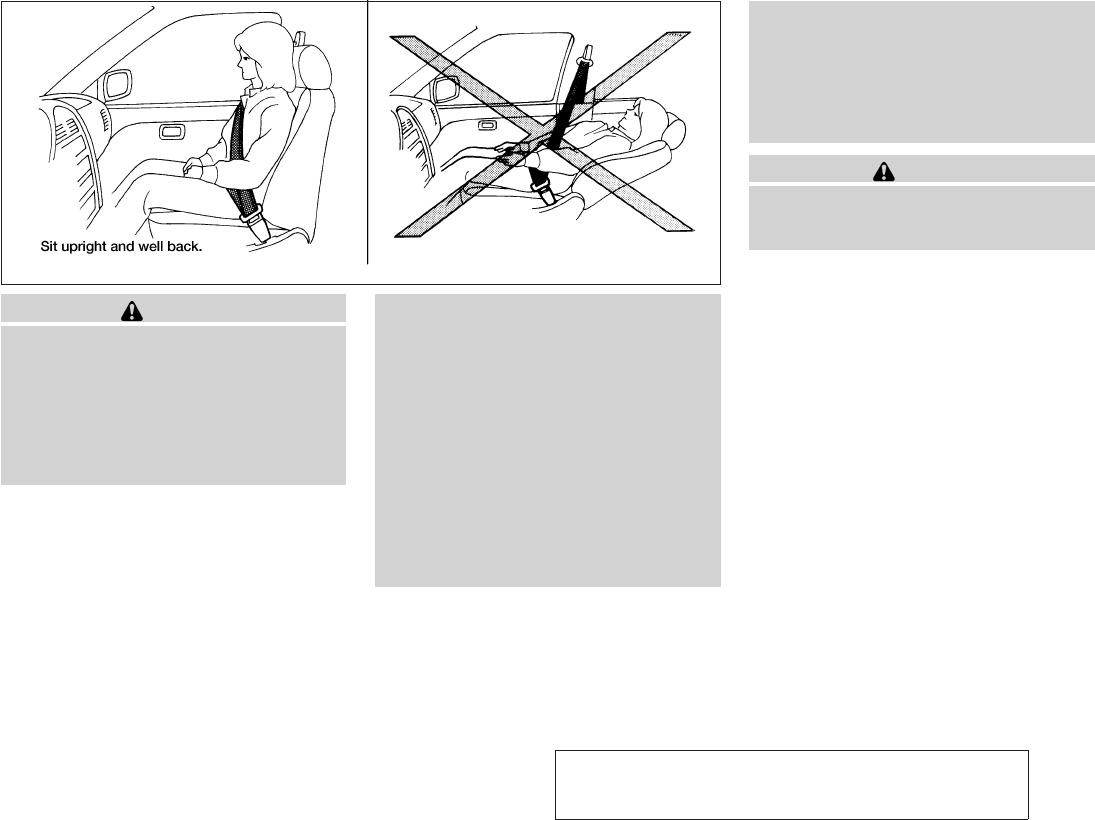
JOBNAME: 1093929-2013-asd-own PAGE: 18 SESS: 4 OUTPUT: Tue Mar 27 10:39:14 2012
WARNING
●Do not ride in a moving vehicle when
the seatback is reclined. This can be
dangerous. The shoulder belt will not
be against your body. In an accident,
you could be thrown into it and receive
neck or other serious injuries. You
could also slide under the lap belt and
receive serious internal injuries.
●For the most effective protection when
the vehicle is in motion, the seat should
be upright. Always sit well back in the
seat with both feet on the floor and
adjust the seat properly. See “Precau-
tions on seat belt usage” later in this
section.
●After adjustment, gently rock in the seat
to make sure it is securely locked.
●Do not leave children unattended inside
the vehicle. They could unknowingly ac-
tivate switches or controls. Unattended
children could become involved in seri-
ous accidents.
●The seatback should not be reclined
any more than needed for comfort. Seat
belts are most effective when the pas-
senger sits well back and straight up in
the seat. If the seatback is reclined, the
risk of sliding under the lap belt and
being injured is increased.
CAUTION
When adjusting the seat positions, be
sure not to contact any moving parts to
avoid possible injuries and/or damage.
FRONT MANUAL SEAT
ADJUSTMENT — (for passenger’s
seat)
ARS1152
SEATS
1-2 Safety—Seats, seat belts and supplemental restraint system
ZREVIEW COPY—
2013 Altima Sedan (asd)
Owners Manual—USA_English (nna)
03/24/12—dmoore
X
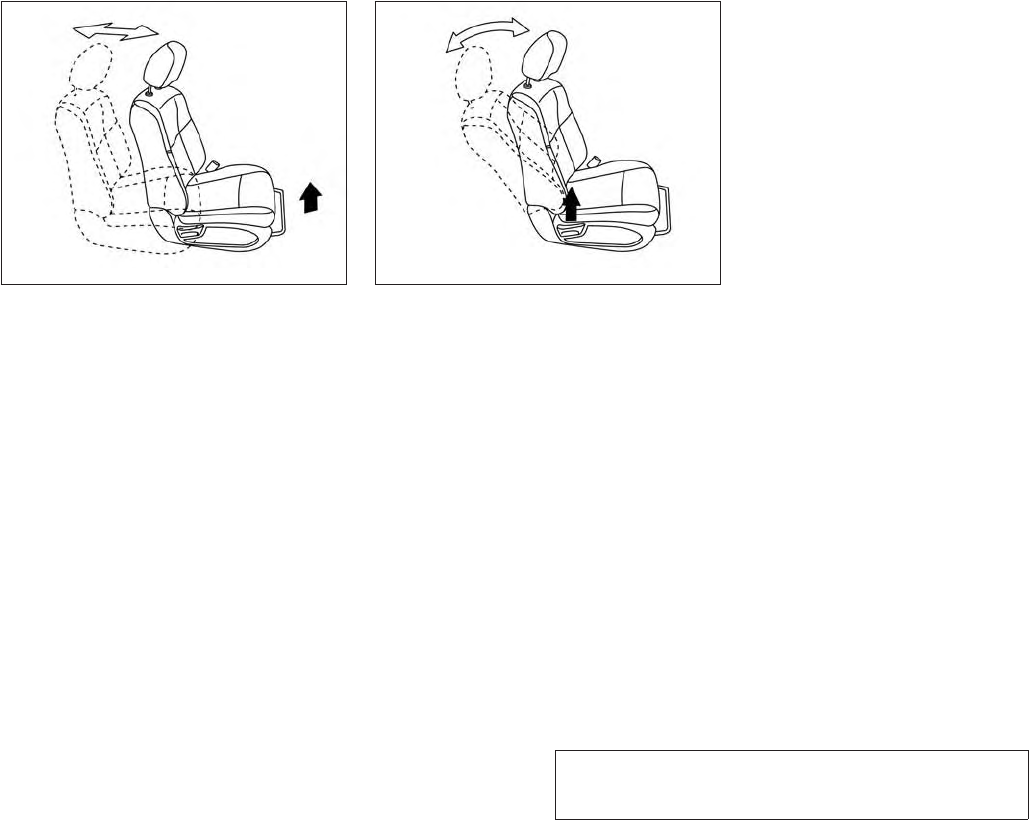
JOBNAME: 1093929-2013-asd-own PAGE: 19 SESS: 4 OUTPUT: Tue Mar 27 10:39:14 2012
Forward and backward
Pull the center of the bar up and hold it while you
slide the seat forward or backward to the desired
position. Release the bar to lock the seat in
position.
Reclining
To recline the seatback, pull the lever up and lean
back. To bring the seatback forward, pull the lever
up and lean your body forward. Release the lever
to lock the seatback in position.
The reclining feature allows adjustment of the
seatback for occupants of different sizes for
added comfort and to help obtain proper seat
belt fit. See “Precautions on seat belt usage”later
in this section. Also, the seatback can be reclined
to allow occupants to rest when the vehicle is
stopped and the transmission is in the P (Park)
position.
LRS2160 LRS2161
Safety—Seats, seat belts and supplemental restraint system 1-3
ZREVIEW COPY—
2013 Altima Sedan (asd)
Owners Manual—USA_English (nna)
03/24/12—dmoore
X
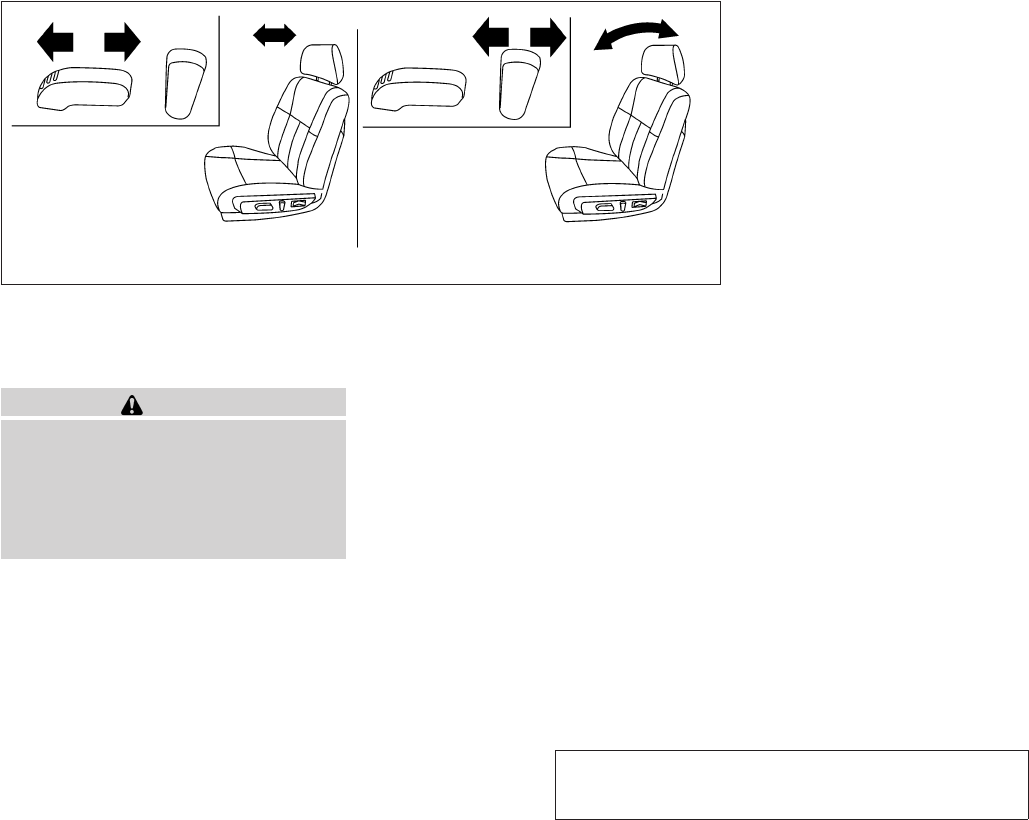
JOBNAME: 1093929-2013-asd-own PAGE: 20 SESS: 4 OUTPUT: Tue Mar 27 10:39:14 2012
FRONT POWER SEAT ADJUSTMENT
(for driver’s seat)
Operating tips
WARNING
Before driving the vehicle, return the seat-
back to an upright seating position after
manually releasing it. Also, make sure the
seat is locked in place. Failure to do so
may cause the seat to move in a collision
or sudden stop. This may result in damage
to the seat or personal injury.
●The power seat motor has an auto-reset
overload protection circuit. If the motor
stops during operation, wait 30 seconds,
then reactivate the switch.
●Do not operate the power seat switch for a
long period of time when the engine is off.
This will discharge the battery.
Forward and backward
Moving the switch forward or backward will slide
the seat forward or backward to the desired
position.
Reclining
Move the recline switch backward until the de-
sired angle is obtained. To bring the seatback
forward again, move the switch forward and
move your body forward. The seatback will move
forward.
The reclining feature allows adjustment of the
seatback for occupants of different sizes for
added comfort and to help obtain proper seat
belt fit, see “Precautions on seat belt usage” later
in this section. Also, the seatback can be reclined
to allow occupants to rest when the vehicle is
stopped and the transmission is in the P (Park)
position.
WRS0751
1-4 Safety—Seats, seat belts and supplemental restraint system
ZREVIEW COPY—
2013 Altima Sedan (asd)
Owners Manual—USA_English (nna)
03/24/12—dmoore
X
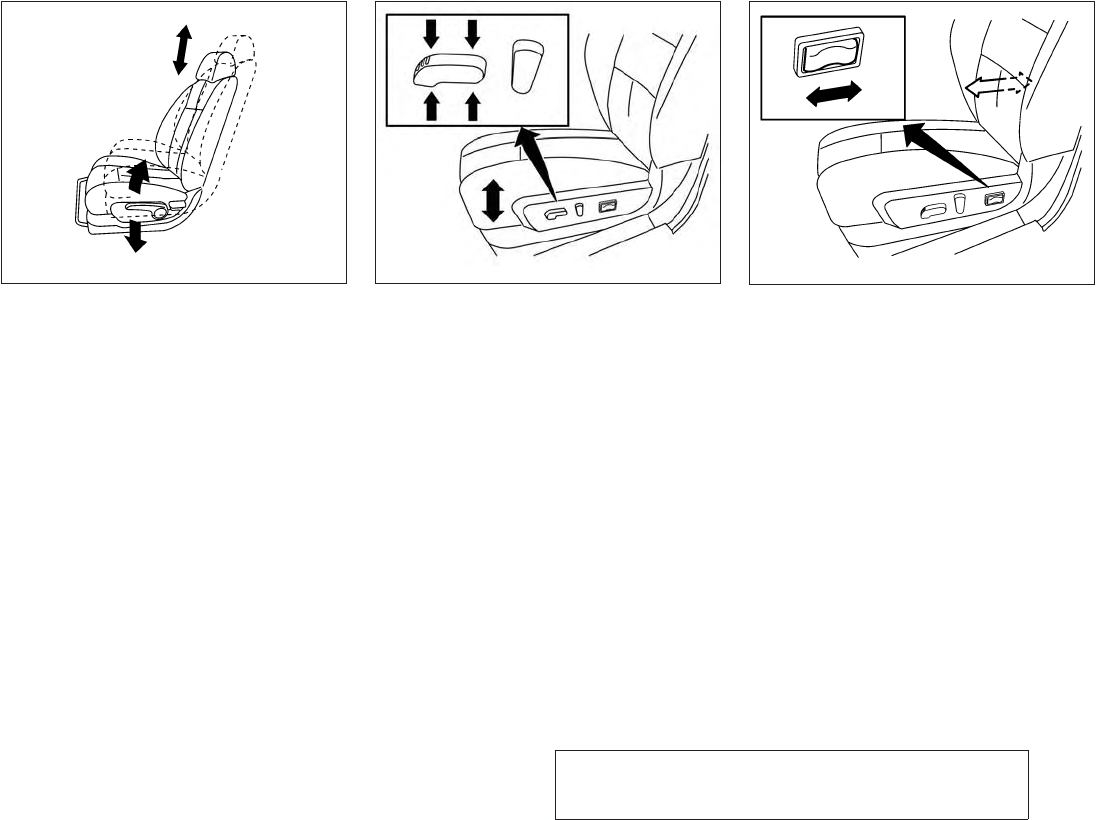
JOBNAME: 1093929-2013-asd-own PAGE: 21 SESS: 4 OUTPUT: Tue Mar 27 10:39:14 2012
Seat lifter (if so equipped for driver’s
seat)
Type A: Pull up or push down the adjusting lever
to adjust the seat height until the desired position
is achieved.
Type B: Push the switch up or down to adjust the
angle and height of the seat cushion.
Lumbar support (if so equipped for
driver’s seat)
The lumbar support feature provides lower back
support to the driver. Push the switch forward or
backward to adjust the seat lumbar area.
Type A
WRS0740
Type B
LRS2162 WRS0743
Safety—Seats, seat belts and supplemental restraint system 1-5
ZREVIEW COPY—
2013 Altima Sedan (asd)
Owners Manual—USA_English (nna)
03/24/12—dmoore
X
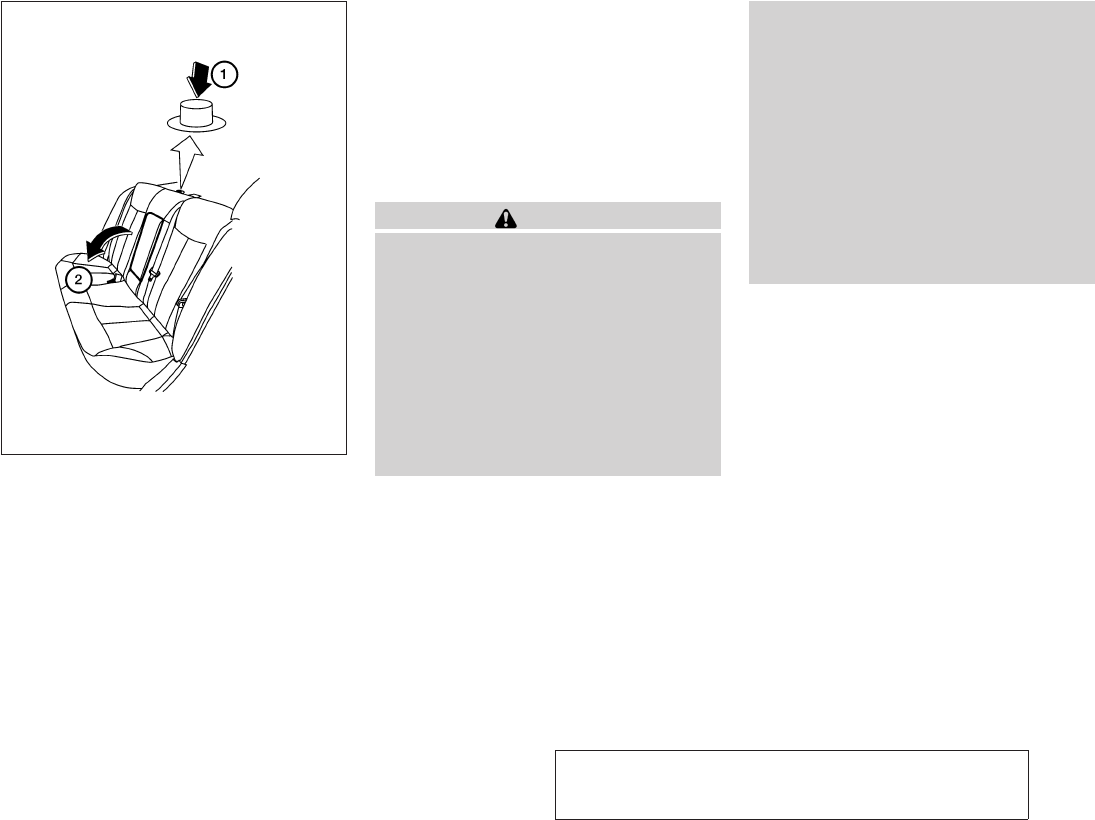
JOBNAME: 1093929-2013-asd-own PAGE: 22 SESS: 4 OUTPUT: Tue Mar 27 10:39:14 2012
FOLDING REAR SEAT
Interior trunk access
The trunk can be accessed from the passenger
side of the rear seat for loading and unloading, as
shown.
1. Move the front passenger seat to the most
forward position.
2. Open the access cover on the rear parcel
shelf.
3. Push down on the button s
1on the rear
parcel shelf.
4. Fold down the passenger’s side seatback
s
2.
WARNING
●Never allow anyone to ride in the cargo
area or on the rear seat when it is in the
fold-down position. Use of these areas
by passengers without proper restraints
could result in serious injury in an acci-
dent or sudden stop.
●Properly secure all cargo with ropes or
straps to help prevent it from sliding or
shifting. Do not place cargo higher than
the seatbacks. In a sudden stop or col-
lision, unsecured cargo could cause
personal injury.
●When returning the seatbacks to the
upright position, be certain they are
completely secured in the latched posi-
tion. If they are not completely secured,
passengers may be injured in an acci-
dent or sudden stop.
●Closely supervise children when they
are around cars to prevent them from
playing and becoming locked in the
trunk where they could be seriously in-
jured. Keep the car locked, with the rear
seatback and trunk lid securely latched
when not in use, and prevent children’s
access to car keys.
WRS0166
1-6 Safety—Seats, seat belts and supplemental restraint system
ZREVIEW COPY—
2013 Altima Sedan (asd)
Owners Manual—USA_English (nna)
03/24/12—dmoore
X
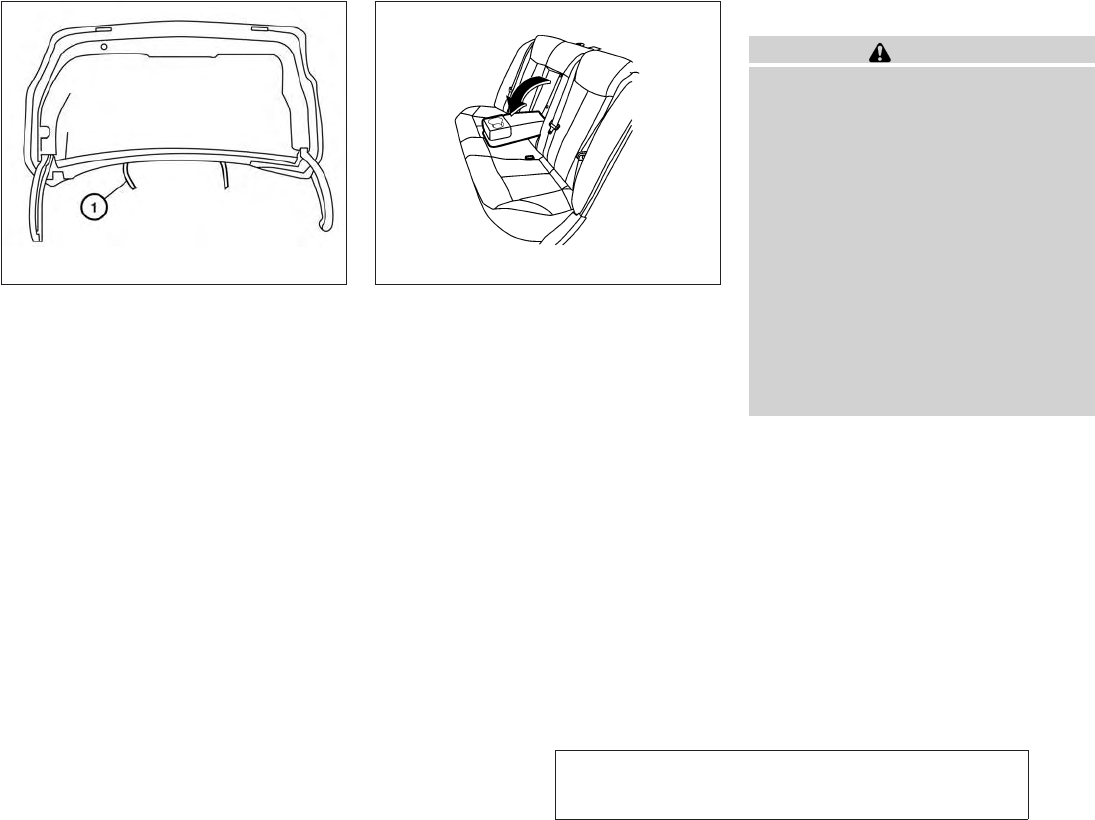
JOBNAME: 1093929-2013-asd-own PAGE: 23 SESS: 4 OUTPUT: Tue Mar 27 10:39:14 2012
To fold down the driver’s side of the rear seat,
open the trunk and pull on the strap s
1.
The rear seats can be locked using the mechani-
cal key to prevent unauthorized access. For more
information on keys, refer to “Keys” in the “Pre-
driving checks and adjustments” section of this
manual.
Center armrest
Pull the armrest down until it rests on the seat
cushion.
HEAD RESTRAINTS
WARNING
Head restraints supplement the other ve-
hicle safety systems. They may provide
additional protection against injury in cer-
tain rear end collisions. Adjust the head
restraints properly, as specified in this
section. Check the adjustment after
someone else uses the seat. Do not attach
anything to the head restraint stalks or
remove the head restraint. Do not use the
seat if the head restraint has been re-
moved. If the head restraint was removed,
reinstall and properly adjust the head re-
straint before an occupant uses the seat-
ing position. Failure to follow these in-
structions can reduce the effectiveness of
the head restraints. This may increase the
risk of serious injury or death in a
collision.
LRS2168 WRS0167
Safety—Seats, seat belts and supplemental restraint system 1-7
ZREVIEW COPY—
2013 Altima Sedan (asd)
Owners Manual—USA_English (nna)
03/24/12—dmoore
X
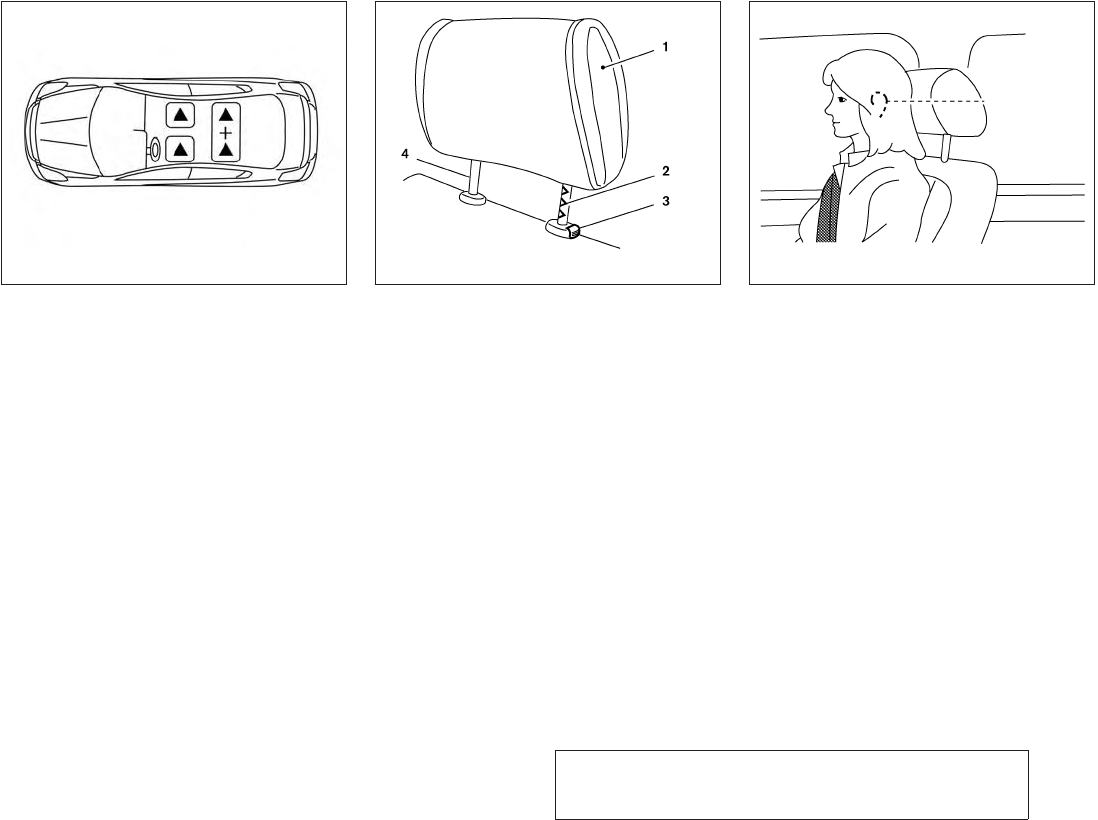
JOBNAME: 1093929-2013-asd-own PAGE: 24 SESS: 4 OUTPUT: Tue Mar 27 10:39:14 2012
The illustration shows the seating positions
equipped with head restraints.
Cloth seat: The front seat head restraints are
adjustable and removable. The rear head re-
straints do not adjust or remove.
Leather seat: The front and rear outboard head
restraints are adjustable and removable. The cen-
ter headrest is not removable and does not ad-
just.
mIndicates the seating position is equipped with
a head restraint.
+ Indicates the seating position is not equipped
with a head restraint or adjustable headrest.
Components
1. Head restraint
2. Adjustment notches
3. Lock knob
4. Stalks
Adjustment
Adjust the head restraint so the center is level
with the center of the seat occupant’s ears.
LRS2164 LRS0887 WRS0134
1-8 Safety—Seats, seat belts and supplemental restraint system
ZREVIEW COPY—
2013 Altima Sedan (asd)
Owners Manual—USA_English (nna)
03/24/12—dmoore
X
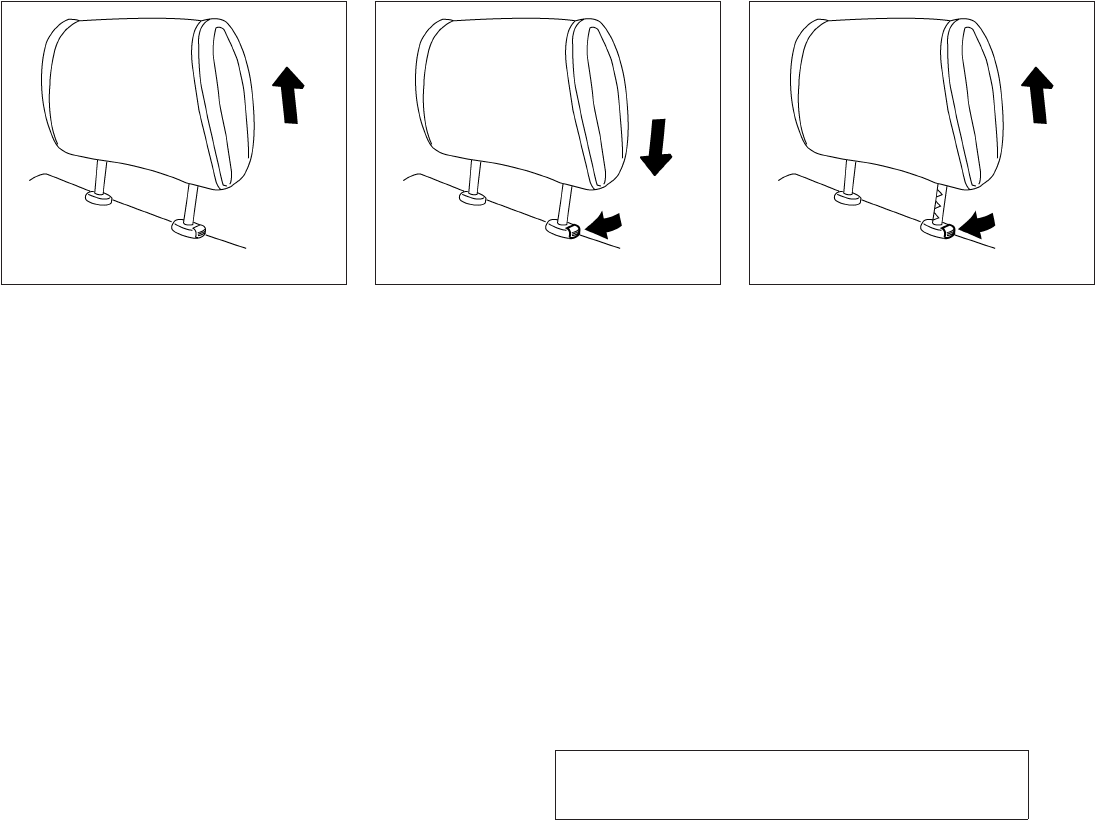
JOBNAME: 1093929-2013-asd-own PAGE: 25 SESS: 4 OUTPUT: Tue Mar 27 10:39:14 2012
To raise the head restraint, pull it up. To lower, push and hold the lock knob and push
the head restraint down. Removal
Use the following procedure to remove the ad-
justable head restraints.
1. Pull the head restraint up to the highest
position.
2. Push and hold the lock knob.
3. Remove the head restraint from the seat.
4. Store the head restraint properly so it is not
loose in the vehicle.
5. Reinstall and properly adjust the head re-
straint before an occupant uses the seating
position.
LRS0888 LRS0889 LRS0890
Safety—Seats, seat belts and supplemental restraint system 1-9
ZREVIEW COPY—
2013 Altima Sedan (asd)
Owners Manual—USA_English (nna)
03/24/12—dmoore
X
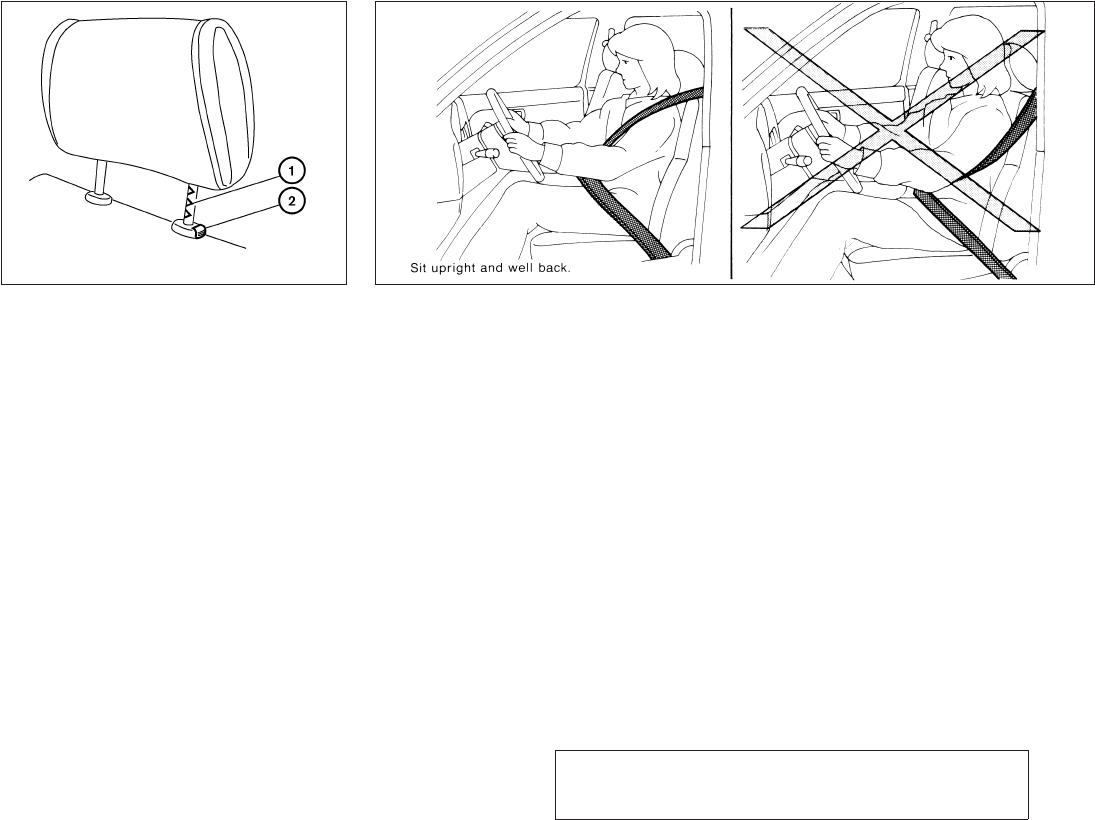
JOBNAME: 1093929-2013-asd-own PAGE: 26 SESS: 4 OUTPUT: Tue Mar 27 10:39:14 2012
Install
1. Align the head restraint stalks with the holes
in the seat. Make sure the head restraint is
facing the correct direction. The stalk with
the adjustment notches s
1must be installed
in the hole with the lock knob s
2.
2. Push and hold the lock knob and push the
head restraint down.
3. Properly adjust the head restraint before an
occupant uses the seating position.
PRECAUTIONS ON SEAT BELT
USAGE
If you are wearing your seat belt properly ad-
justed and you are sitting upright and well back in
your seat with both feet on the floor, your chances
of being injured or killed in an accident and/or the
severity of injury may be greatly reduced.
NISSAN strongly encourages you and all of your
passengers to buckle up every time you drive,
even if your seating position includes a supple-
mental air bag.
Most U.S. states and Canadian provinces
or territories specify that seat belts be worn
at all times when a vehicle is being driven.
LRS0891 SSS0136
SEAT BELTS
1-10 Safety—Seats, seat belts and supplemental restraint system
ZREVIEW COPY—
2013 Altima Sedan (asd)
Owners Manual—USA_English (nna)
03/24/12—dmoore
X
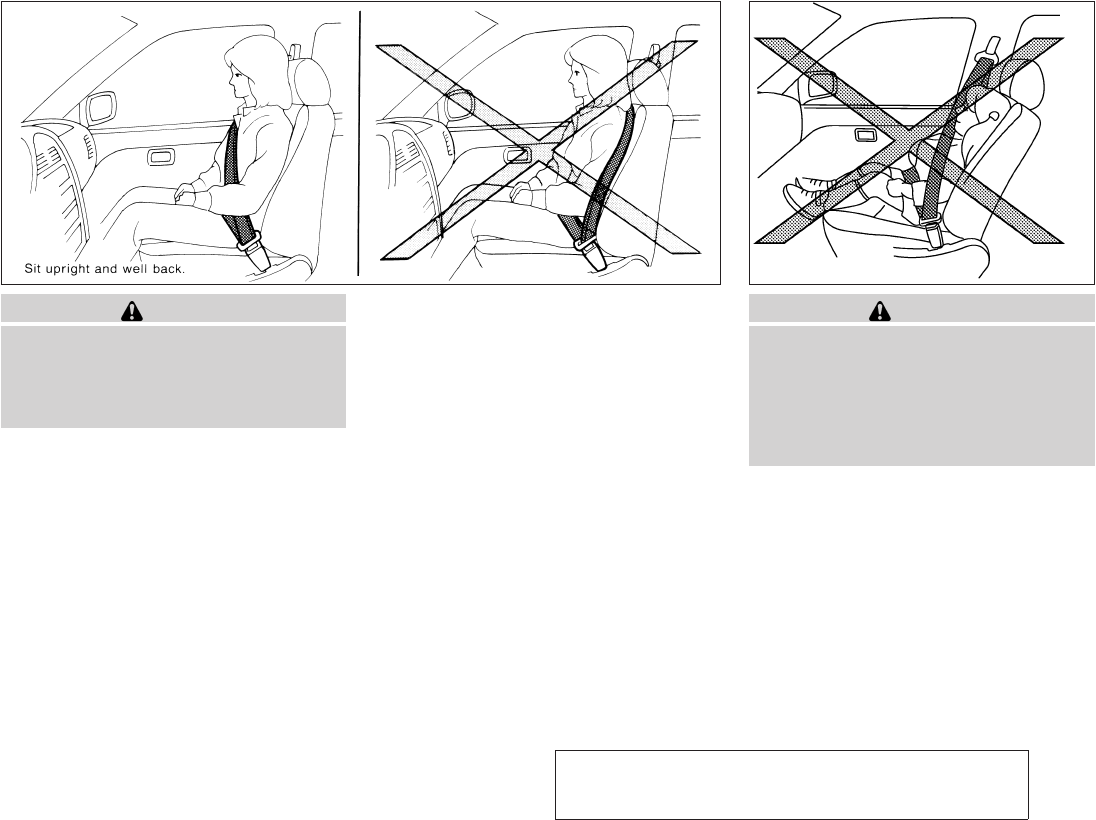
JOBNAME: 1093929-2013-asd-own PAGE: 27 SESS: 4 OUTPUT: Tue Mar 27 10:39:14 2012
WARNING
●Every person who drives or rides in this
vehicle should use a seat belt at all
times. Children should be properly re-
strained in the rear seat and, if appro-
priate, in a child restraint.
WARNING
●The seat belt should be properly ad-
justed to a snug fit. Failure to do so may
reduce the effectiveness of the entire
restraint system and increase the
chance or severity of injury in an acci-
dent. Serious injury or death can occur
if the seat belt is not worn properly.
SSS0134 SSS0016
Safety—Seats, seat belts and supplemental restraint system 1-11
ZREVIEW COPY—
2013 Altima Sedan (asd)
Owners Manual—USA_English (nna)
03/24/12—dmoore
X
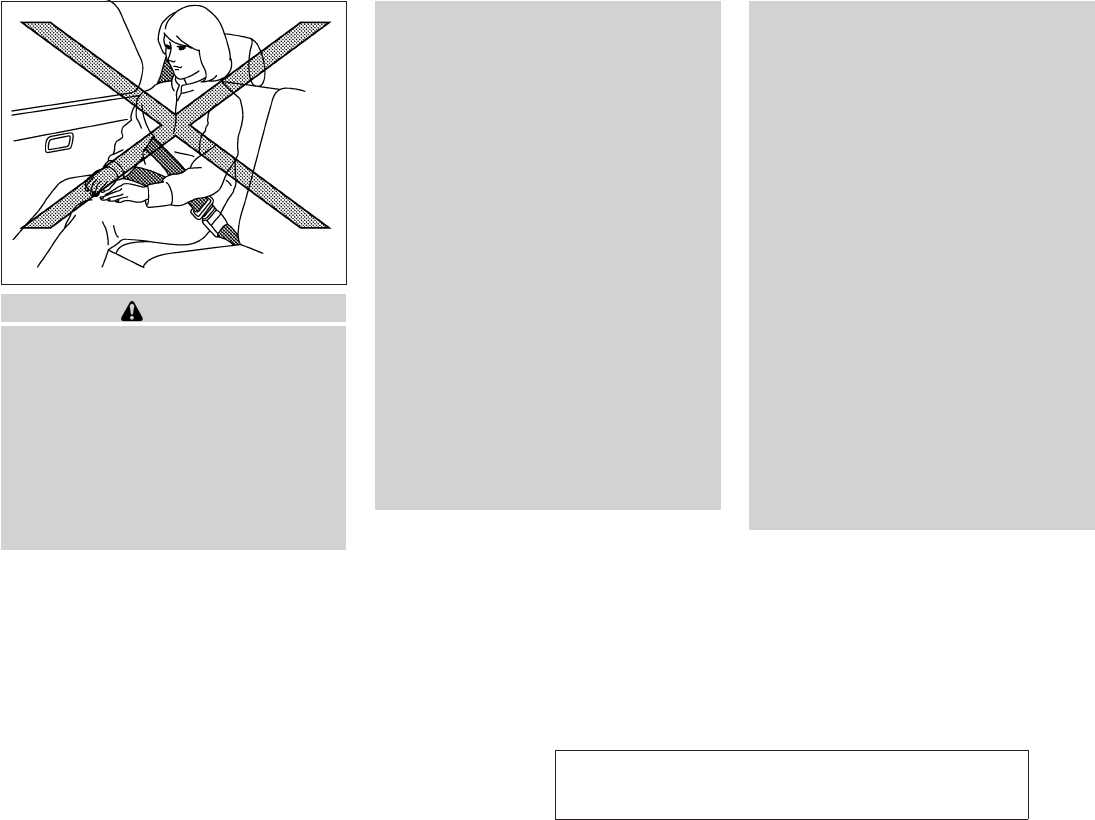
JOBNAME: 1093929-2013-asd-own PAGE: 28 SESS: 4 OUTPUT: Tue Mar 27 10:39:14 2012
WARNING
●Always route the shoulder belt over
your shoulder and across your chest.
Never put the belt behind your back,
under your arm or across your neck. The
belt should be away from your face and
neck, but not falling off your shoulder.
●Position the lap belt as low and snug as
possible AROUND THE HIPS, NOT THE
WAIST. A lap belt worn too high could
increase the risk of internal injuries in
an accident.
●Be sure the seat belt tongue is securely
fastened to the proper buckle.
●Do not wear the seat belt inside out or
twisted. Doing so may reduce its
effectiveness.
●Do not allow more than one person to
use the same seat belt.
●Never carry more people in the vehicle
than there are seat belts.
●If the seat belt warning light glows con-
tinuously while the ignition is turned
ON with all doors closed and all seat
belts fastened, it may indicate a mal-
function in the system. Have the system
checked by a NISSAN dealer.
●No changes should be made to the seat
belt system. For example, do not modify
the seat belt, add material, or install
devices that may change the seat belt
routing or tension. Doing so may affect
the operation of the seat belt system.
Modifying or tampering with the seat
belt system may result in serious per-
sonal injury.
●Once a seat belt pretensioner has acti-
vated, it cannot be reused and must be
replaced together with the retractor.
See your NISSAN dealer.
●Removal and installation of preten-
sioner system components should be
done by a NISSAN dealer.
●All seat belt assemblies, including re-
tractors and attaching hardware,
should be inspected after any collision
by a NISSAN dealer. NISSAN recom-
mends that all seat belt assemblies in
use during a collision be replaced un-
less the collision was minor and the
belts show no damage and continue to
operate properly. Seat belt assemblies
not in use during a collision should also
be inspected and replaced if either
damage or improper operation is noted.
●All child restraints and attaching hard-
ware should be inspected after any col-
lision. Always follow the restraint
manufacturer’s inspection instructions
and replacement recommendations.
The child restraints should be replaced
if they are damaged.
SSS0014
1-12 Safety—Seats, seat belts and supplemental restraint system
ZREVIEW COPY—
2013 Altima Sedan (asd)
Owners Manual—USA_English (nna)
03/24/12—dmoore
X

JOBNAME: 1093929-2013-asd-own PAGE: 29 SESS: 4 OUTPUT: Tue Mar 27 10:39:14 2012
PREGNANT WOMEN
NISSAN recommends that pregnant women use
seat belts. The seat belt should be worn snug and
always position the lap belt as low as possible
around the hips, not the waist. Place the shoulder
belt over your shoulder and across your chest.
Never run the lap/shoulder belt over your ab-
dominal area. Contact your doctor for specific
recommendations.
INJURED PERSONS
NISSAN recommends that injured persons use
seat belts. Check with your doctor for specific
recommendations.
THREE-POINT TYPE SEAT BELT
WITH RETRACTOR
WARNING
●Every person who drives or rides in this
vehicle should use a seat belt at all
times.
●Do not ride in a moving vehicle when
the seatback is reclined. This can be
dangerous. The shoulder belt will not
be against your body. In an accident,
you could be thrown into it and receive
neck or other serious injuries. You
could also slide under the lap belt and
receive serious internal injuries.
●For the most effective protection when
the vehicle is in motion, the seat should
be upright. Always sit well back in the
seat with both feet on the floor and
adjust the seat belt properly.
●Do not allow children to play with the
seat belts. Most seating positions are
equipped with Automatic Locking Re-
tractor (ALR) mode seat belts. If the
seat belt becomes wrapped around a
child’s neck with the ALR mode acti-
vated, the child can be seriously injured
or killed if the seat belt retracts and
becomes tight. This can occur even if
the vehicle is parked. Unbuckle the seat
belt to release the child. If the seat belt
cannot be unbuckled or is already un-
buckled, release the child by cutting the
seat belt with a suitable tool (such as a
knife or scissors) to release the seat
belt.
Safety—Seats, seat belts and supplemental restraint system 1-13
ZREVIEW COPY—
2013 Altima Sedan (asd)
Owners Manual—USA_English (nna)
03/24/12—dmoore
X
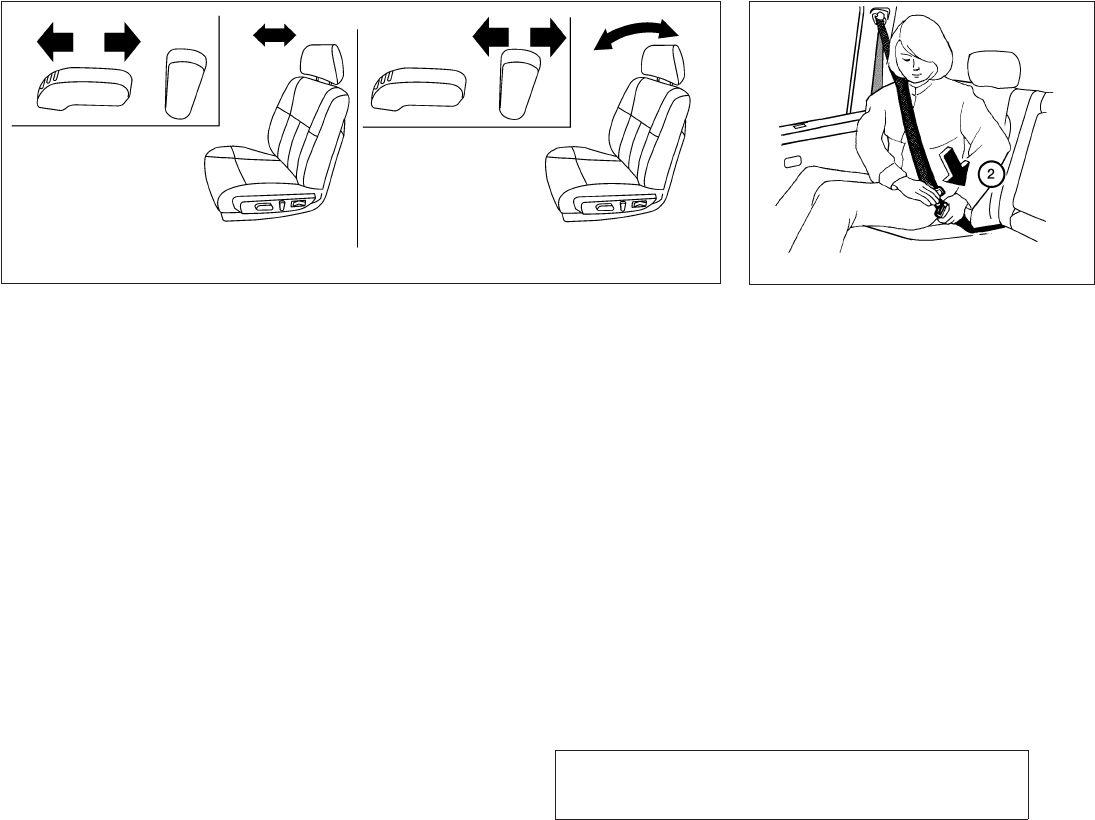
JOBNAME: 1093929-2013-asd-own PAGE: 30 SESS: 4 OUTPUT: Tue Mar 27 10:39:14 2012
Fastening the seat belts
1. Adjust the seat. See “Seats” earlier in this
section.
s
2Slowly pull the seat belt out of the retractor
and insert the tongue into the buckle until
you hear and feel the latch engage.
●The retractor is designed to lock dur-
ing a sudden stop or on impact. A
slow pulling motion permits the seat
belt to move, and allows you some
freedom of movement in the seat.
●If the seat belt cannot be pulled from
its fully retracted position, firmly pull
the belt and release it. Then
smoothly pull the belt out of the re-
tractor.
Front seat shown
WRS0751 LRS0594
1-14 Safety—Seats, seat belts and supplemental restraint system
ZREVIEW COPY—
2013 Altima Sedan (asd)
Owners Manual—USA_English (nna)
03/24/12—dmoore
X
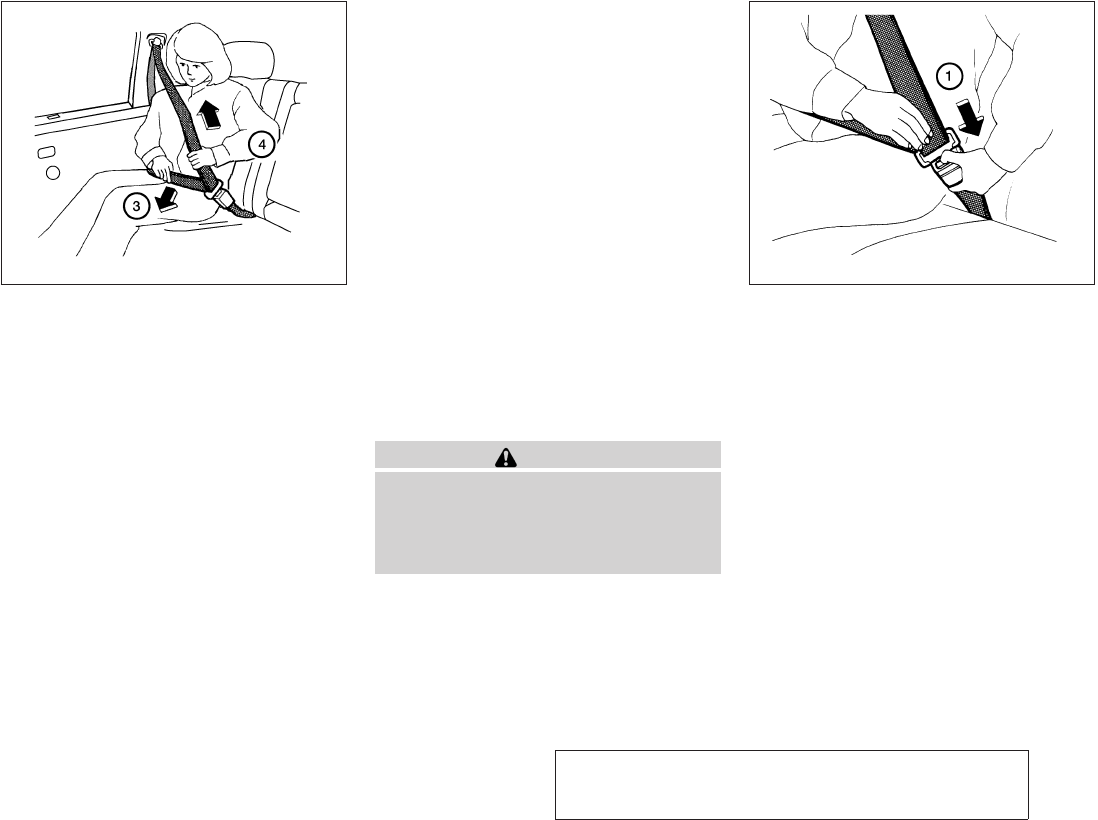
JOBNAME: 1093929-2013-asd-own PAGE: 31 SESS: 4 OUTPUT: Tue Mar 27 10:39:14 2012
s
3Position the lap belt portion low and snug
on the hips as shown.
s
4Pull the shoulder belt portion toward the
retractor to take up extra slack. Be sure the
shoulder belt is routed over your shoulder
and across your chest.
The front passenger seat and the rear seating
positions’ three-point seat belts have two modes
of operation:
●Emergency Locking Retractor (ELR)
●Automatic Locking Retractor (ALR)
The Emergency Locking Retractor (ELR) mode
allows the seat belt to extend and retract to allow
the driver and passengers some freedom of
movement in the seat. The ELR locks the seat belt
when the vehicle slows down rapidly or during
certain impacts.
The Automatic Locking Retractor (ALR) mode
(child restraint mode) locks the seat belt for child
restraint installation.
When the ALR mode is activated, the seat belt
cannot be extended again until the seat belt
tongue is detached from the buckle and fully
retracted. The seat belt returns to the ELR mode
after the seat belt fully retracts. See “Child re-
straints” later in this section for more information.
The ALR mode should be used only for
child restraint installation. During normal
seat belt use by an occupant, the ALR mode
should not be activated. If it is activated, it
may cause uncomfortable seat belt ten-
sion.
WARNING
When fastening the seat belts, be certain
that the seatbacks are completely se-
cured in the latched position. If they are
not completely secured, passengers may
be injured in an accident or sudden stop.
Unfastening the seat belts
s
1To unfasten the seat belt, press the button on
the buckle. The seat belt automatically re-
tracts.
Checking seat belt operation
Seat belt retractors are designed to lock seat belt
movement by two separate methods:
●When the seat belt is pulled quickly from the
retractor.
●When the vehicle slows down rapidly.
LRS0595 WRS0139
Safety—Seats, seat belts and supplemental restraint system 1-15
ZREVIEW COPY—
2013 Altima Sedan (asd)
Owners Manual—USA_English (nna)
03/24/12—dmoore
X

JOBNAME: 1093929-2013-asd-own PAGE: 32 SESS: 4 OUTPUT: Tue Mar 27 10:39:14 2012
To increase your confidence in the seat belts,
check the operation as follows:
●Grasp the shoulder belt and pull forward
quickly. The retractor should lock and re-
strict further belt movement.
If the retractor does not lock during this check or
if you have any questions about seat belt opera-
tion, see a NISSAN dealer.
Shoulder belt height adjustment (Front
seats)
The shoulder belt anchor height should be ad-
justed to the position best for you. See “Precau-
tions on seat belt usage” earlier in this section. To
adjust, pull out the adjustment button s
1and
move the shoulder belt anchor to the desired
position s
2, so the belt passes over the center of
the shoulder. The belt should be away from your
face and neck, but not falling off your shoulder.
Release the adjustment button to lock the shoul-
der belt anchor into position.
WARNING
●After adjustment, release the adjust-
ment button and try to move the shoul-
der belt anchor up and down to make
sure it is securely fixed in position.
●The shoulder belt anchor height should
be adjusted to the position best for you.
Failure to do so may reduce the effec-
tiveness of the entire restraint system
and increase the chance or severity of
injury in an accident.
SEAT BELT EXTENDERS
If, because of body size or driving position, it is
not possible to properly fit the lap/shoulder belt
and fasten it, an extender that is compatible with
the installed seat belts is available that can be
purchased. The extender adds approximately 8 in
(200 mm) of length and may be used for either
the driver or front passenger seating position.
See a NISSAN dealer for assistance with pur-
chasing an extender if an extender is required.
LRS0242
1-16 Safety—Seats, seat belts and supplemental restraint system
ZREVIEW COPY—
2013 Altima Sedan (asd)
Owners Manual—USA_English (nna)
03/24/12—dmoore
X

JOBNAME: 1093929-2013-asd-own PAGE: 33 SESS: 4 OUTPUT: Tue Mar 27 10:39:14 2012
WARNING
●Only NISSAN seat belt extenders, made
by the same company which made the
original equipment seat belts, should
be used with NISSAN seat belts.
●Adults and children who can use the
standard seat belt should not use an
extender. Such unnecessary use could
result in serious personal injury in the
event of an accident.
●Never use seat belt extenders to install
child restraints. If the child restraint is
not secured properly, the child could be
seriously injured in a collision or a sud-
den stop.
SEAT BELT MAINTENANCE
●To clean the seat belt webbing, apply a
mild soap solution or any solution recom-
mended for cleaning upholstery or carpet.
Then wipe with a cloth and allow the seat
belts to dry in the shade. Do not allow the
seat belts to retract until they are completely
dry.
●If dirt builds up in the shoulder belt
guide of the seat belt anchors, the seat
belts may retract slowly. Wipe the shoulder
belt guide with a clean, dry cloth.
●Periodically check to see that the seat
belt and the metal components, such as
buckles, tongues, retractors, flexible wires
and anchors, work properly. If loose parts,
deterioration, cuts or other damage on the
webbing is found, the entire seat belt as-
sembly should be replaced.
WARNING
Do not allow children to play with the seat
belts. Most seating positions are
equipped with Automatic Locking Retrac-
tor (ALR) mode seat belts. If the seat belt
becomes wrapped around a child’s neck
with the ALR mode activated, the child can
be seriously injured or killed if the seat
belt retracts and becomes tight. This can
occur even if the vehicle is parked. Un-
buckle the seat belt to release the child. If
the seat belt cannot be unbuckled or is
already unbuckled, release the child by
cutting the seat belt with a suitable tool
(such as a knife or scissors) to release the
seat belt.
Children need adults to help protect them.
They need to be properly restrained.
In addition to the general information in this
manual, child safety information is available from
many other sources, including doctors, teachers,
government traffic safety offices, and community
organizations. Every child is different, so be sure
to learn the best way to transport your child.
CHILD SAFETY
Safety—Seats, seat belts and supplemental restraint system 1-17
ZREVIEW COPY—
2013 Altima Sedan (asd)
Owners Manual—USA_English (nna)
03/24/12—dmoore
X

JOBNAME: 1093929-2013-asd-own PAGE: 34 SESS: 4 OUTPUT: Tue Mar 27 10:39:14 2012
There are three basic types of child restraint
systems:
●Rear-facing child restraint
●Forward-facing child restraint
●Booster seat
The proper restraint depends on the child’s size.
Generally, infants up to about 1 year and less
than 20 lbs (9 kg) should be placed in rear-facing
child restraints. Forward-facing child restraints
are available for children who outgrow rear-
facing child restraints and are at least 1 year old.
Booster seats are used to help position a vehicle
lap/shoulder belt on a child who can no longer
use a forward-facing child restraint.
WARNING
Infants and children need special protec-
tion. The vehicle’s seat belts may not fit
them properly. The shoulder belt may
come too close to the face or neck. The
lap belt may not fit over their small hip
bones. In an accident, an improperly fit-
ting seat belt could cause serious or fatal
injury. Always use appropriate child
restraints.
All U.S. states and Canadian provinces or terri-
tories require the use of approved child restraints
for infants and small children. See “Child re-
straints” later in this section.
A child restraint may be secured in the vehicle by
using either the LATCH (Lower Anchor and Teth-
ers for CHildren) system or with the vehicle seat
belt. See “Child restraints” later in this section for
more information.
NISSAN recommends that all pre-teens
and children be restrained in the rear seat.
Studies show that children are safer when
properly restrained in the rear seat than in
the front seat.
This is especially important because your
vehicle has a supplemental restraint sys-
tem (air bag system) for the front passen-
ger. See “Supplemental restraint system”
later in this section.
INFANTS
Infants up to at least 1 year old should be placed
in a rear-facing child restraint. NISSAN recom-
mends that infants be placed in child restraints
that comply with Federal Motor Vehicle Safety
Standards or Canadian Motor Vehicle Safety
Standards. You should choose a child restraint
that fits your vehicle and always follow the manu-
facturer’s instructions for installation and use.
SMALL CHILDREN
Children that are over 1 year old and weigh at
least 20 lbs (9 kg) should remain in a rear-facing
child restraint as long as possible up to the height
or weight limit of the child restraint. Children who
outgrow the height or weight limit of the rear-
facing child restraint and are at least 1 year old
should be secured in a forward-facing child re-
straint with a harness. Refer to the manufactur-
er’s instructions for minimum and maximum
weight and height recommendations. NISSAN
recommends that small children be placed in
child restraints that comply with Federal Motor
Vehicle Safety Standards or Canadian Motor Ve-
hicle Safety Standards. You should choose a
child restraint that fits your vehicle and always
follow the manufacturer’s instructions for instal-
lation and use.
LARGER CHILDREN
Children should remain in a forward-facing child
restraint with a harness until they reach the maxi-
mum height or weight limit allowed by the child
restraint manufacturer.
Once a child outgrows the height or weight limit
of the harness-equipped forward-facing child re-
straint, NISSAN recommends that the child be
placed in a commercially available booster seat to
obtain proper seat belt fit. For a seat belt to fit
1-18 Safety—Seats, seat belts and supplemental restraint system
ZREVIEW COPY—
2013 Altima Sedan (asd)
Owners Manual—USA_English (nna)
03/24/12—dmoore
X
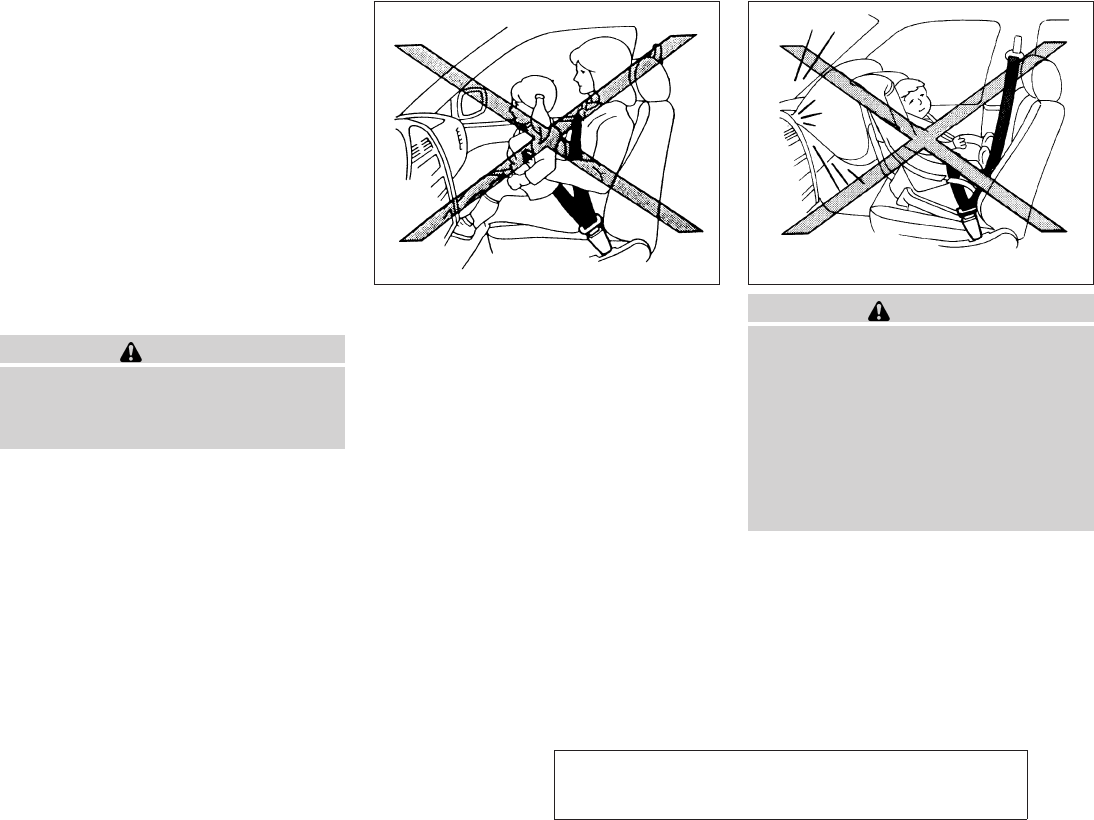
JOBNAME: 1093929-2013-asd-own PAGE: 35 SESS: 4 OUTPUT: Tue Mar 27 10:39:14 2012
properly, the booster seat should raise the child
so that the shoulder belt is properly positioned
across the chest and the top, middle portion of
the shoulder. The shoulder belt should not cross
the neck or face and should not fall off the shoul-
der. The lap belt should lie snugly across the
lower hips or upper thighs, not the abdomen. A
booster seat can only be used in seating posi-
tions that have a three-point type seat belt. The
booster seat should fit the vehicle seat and have
a label certifying that it complies with Federal
Motor Vehicle Safety Standards or Canadian Mo-
tor Vehicle Safety Standards. Once the child has
grown so the shoulder belt is no longer on or near
the face and neck and the lap belt can be posi-
tioned properly across the lower hips or upper
thighs use the seat belt without the booster seat.
WARNING
Never let a child stand or kneel on any
seat and do not allow a child in the cargo
area. The child could be seriously injured
or killed in a sudden stop or collision.
PRECAUTIONS ON CHILD
RESTRAINTS WARNING
●Failure to follow the warnings and in-
structions for proper use and installa-
tion of child restraints could result in
serious injury or death of a child or
other passengers in a sudden stop or
collision:
– The child restraint must be used and
installed properly. Always follow all
of the child restraint manufacturer’s
instructions for installation and use.
ARS1098 WRS0256
CHILD RESTRAINTS
Safety—Seats, seat belts and supplemental restraint system 1-19
ZREVIEW COPY—
2013 Altima Sedan (asd)
Owners Manual—USA_English (nna)
03/24/12—dmoore
X

JOBNAME: 1093929-2013-asd-own PAGE: 36 SESS: 4 OUTPUT: Tue Mar 27 10:39:14 2012
– Infants and children should never be
held on anyone’s lap. Even the stron-
gest adult cannot resist the forces of
a collision.
– Do not put a seat belt around both a
child and another passenger.
– NISSAN recommends that all child
restraints be installed in the rear
seat. Studies show that children are
safer when properly restrained in the
rear seat than in the front seat. If you
must install a forward-facing child
restraint in the front seat, see
“Forward-facing child restraint in-
stallation using the seat belts” later
in this section.
– Even with the NISSAN Advanced Air
Bag System, never install a rear-
facing child restraint in the front
seat. An inflating air bag could seri-
ously injure or kill a child. A rear-
facing child restraint must only be
used in the rear seat.
– Be sure to purchase a child restraint
that will fit the child and vehicle.
Some child restraints may not fit
properly in your vehicle.
– Child restraint anchor points are de-
signed to withstand loads from child
restraints that are properly fitted.
– Never use the anchor points for adult
seat belts or harnesses.
– A child restraint with a top tether
strap should not be used in the front
passenger seat.
– Keep seatbacks as upright as pos-
sible after fitting the child restraint.
– Infants and children should always
be placed in an appropriate child re-
straint while in the vehicle.
●When the child restraint is not in use,
keep it secured with the LATCH system
or a seat belt. In a sudden stop or colli-
sion, loose objects can injure occu-
pants or damage the vehicle.
CAUTION
A child restraint in a closed vehicle can
become very hot. Check the seating sur-
face and buckles before placing a child in
the child restraint.
This vehicle is equipped with a universal child
restraint anchor system, referred to as the LATCH
(Lower Anchors and Tethers for CHildren) sys-
tem. Some child restraints include rigid or
webbing-mounted attachments that can be con-
nected to these anchors. For details, see “LATCH
(Lower Anchors and Tethers for CHildren) sys-
tem” later in this section.
If you do not have a LATCH compatible child
restraint, the vehicle seat belts can be used.
Several manufacturers offer child restraints for
infants and children of various sizes. When se-
lecting any child restraint, keep the following
points in mind:
●Choose only a restraint with a label certifying
that it complies with Federal Motor Vehicle
Safety Standard 213 or Canadian Motor
Vehicle Safety Standard 213.
●Check the child restraint in your vehicle to be
sure it is compatible with the vehicle’s seat
and seat belt system.
●If the child restraint is compatible with your
vehicle, place your child in the child restraint
and check the various adjustments to be
sure the child restraint is compatible with
your child. Choose a child restraint that is
designed for your child’s height and weight.
Always follow all recommended procedures.
1-20 Safety—Seats, seat belts and supplemental restraint system
ZREVIEW COPY—
2013 Altima Sedan (asd)
Owners Manual—USA_English (nna)
03/24/12—dmoore
X
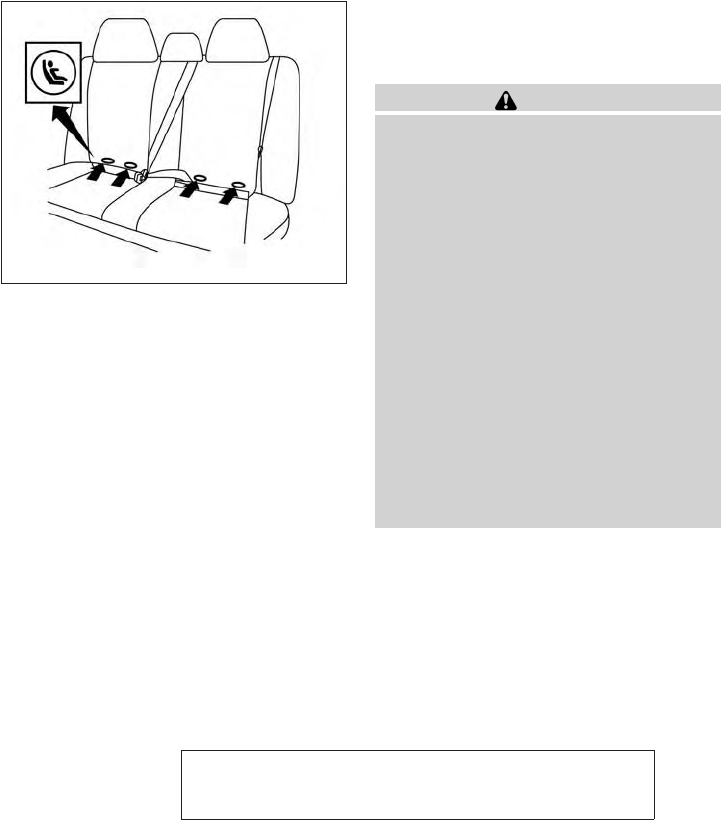
JOBNAME: 1093929-2013-asd-own PAGE: 37 SESS: 4 OUTPUT: Tue Mar 27 10:39:14 2012
All U.S. states and Canadian provinces or
territories require that infants and small
children be restrained in an approved child
restraint at all times while the vehicle is
being operated. Canadian law requires the
top tether strap on forward-facing child
restraints be secured to the designated an-
chor point on the vehicle.
LATCH (Lower Anchors and Tethers
for CHildren) SYSTEM
Your vehicle is equipped with special anchor
points that are used with LATCH (Lower Anchors
and Tethers for CHildren) system compatible
child restraints. This system may also be referred
to as the ISOFIX or ISOFIX compatible system.
With this system, you do not have to use a vehicle
seat belt to secure the child restraint.
The LATCH anchor points are provided to install
child restraints in the rear outboard seating posi-
tions only. Do not attempt to install a child re-
straint in the center position using the LATCH
anchors.
LATCH lower anchor
WARNING
Failure to follow the warnings and instruc-
tions for proper use and installation of
child restraints could result in serious in-
jury or death of a child or other passen-
gers in a sudden stop or collision:
– Attach LATCH system compatible
child restraints only at the locations
shown in the illustration.
– Do not secure a child restraint in the
center rear seating position using
the LATCH lower anchors. The child
restraint will not be secured properly.
– Inspect the lower anchors by insert-
ing your fingers into the lower anchor
area. Feel to make sure there are no
obstructions over the anchors such
as seat belt webbing or seat cushion
material. The child restraint will not
be secured properly if the lower an-
chors are obstructed.
LATCH system anchor locations
LRS2165
Safety—Seats, seat belts and supplemental restraint system 1-21
ZREVIEW COPY—
2013 Altima Sedan (asd)
Owners Manual—USA_English (nna)
03/24/12—dmoore
X
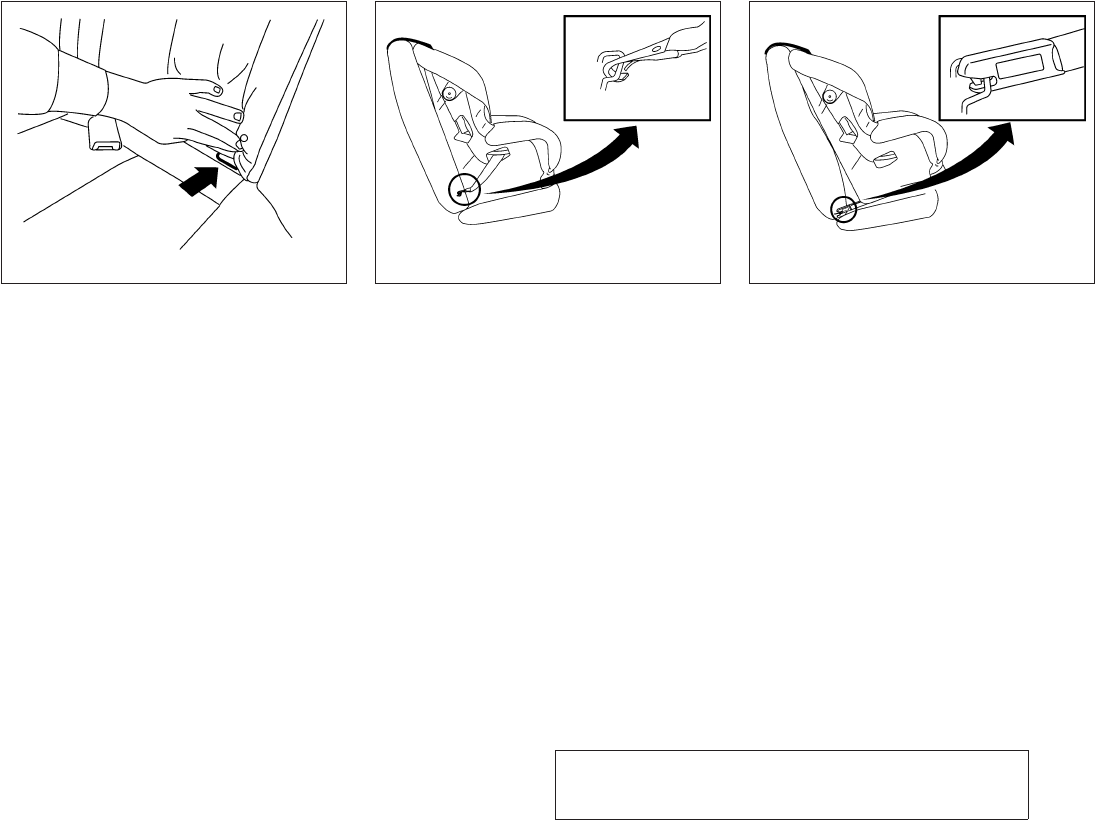
JOBNAME: 1093929-2013-asd-own PAGE: 38 SESS: 4 OUTPUT: Tue Mar 27 10:39:14 2012
LATCH lower anchor point locations
The LATCH anchors are located at the rear of the
seat cushion near the seatback. A label is at-
tached to the seatback to help you locate the
LATCH anchors.
Installing child restraint LATCH lower
anchor attachments
LATCH compatible child restraints include two
rigid or webbing-mounted attachments that can
be connected to two anchors located at certain
seating positions in your vehicle. With this sys-
tem, you do not have to use a vehicle seat belt to
secure the child restraint. Check your child re-
straint for a label stating that it is compatible with
LATCH. This information may also be in the in-
structions provided by the child restraint manu-
facturer.
When installing a child restraint, carefully read
and follow the instructions in this manual and
those supplied with the child restraint.
LATCH lower anchor location
WRS0796
LATCH webbing-mounted attachment
LRS0661
LATCH rigid-mounted attachment
LRS0662
1-22 Safety—Seats, seat belts and supplemental restraint system
ZREVIEW COPY—
2013 Altima Sedan (asd)
Owners Manual—USA_English (nna)
03/24/12—dmoore
X
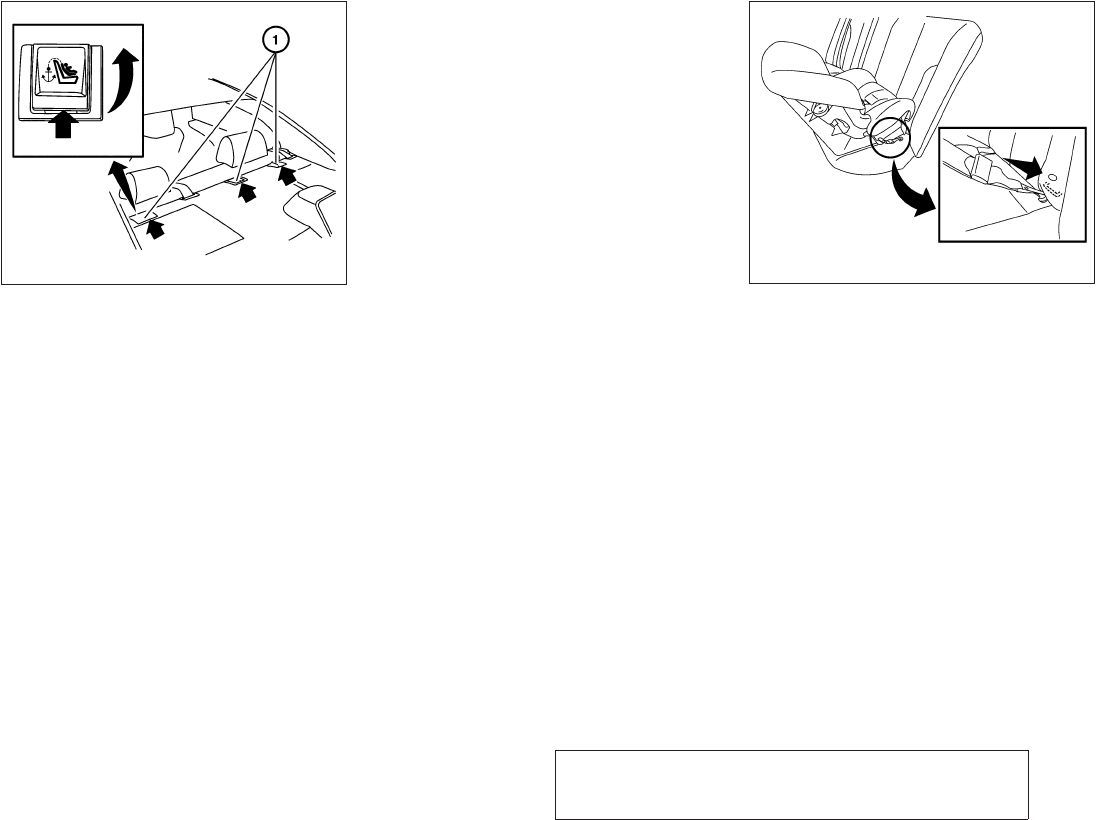
JOBNAME: 1093929-2013-asd-own PAGE: 39 SESS: 4 OUTPUT: Tue Mar 27 10:39:14 2012
Top tether anchor point locations
The child restraint top tether strap must be used
when installing the child restraint with the LATCH
lower anchor attachments or seat belts. See “In-
stalling top tether strap” later in this section.
If you have any questions when installing a
top tether strap, consult your NISSAN
dealer for details.
Anchor points s
1are located on the rear parcel
shelf.
REAR-FACING CHILD RESTRAINT
INSTALLATION USING LATCH
Refer to all Warnings and Cautions in the “Child
Safety” and “Child Restraint” sections before in-
stalling a child restraint.
Follow these steps to install a rear-facing child
restraint using the LATCH system:
1. Position the child restraint on the seat. Al-
ways follow the child restraint manufactur-
er’s instructions.
WRS0797
Rear-facing web-mounted – step 2
WRS0801
Safety—Seats, seat belts and supplemental restraint system 1-23
ZREVIEW COPY—
2013 Altima Sedan (asd)
Owners Manual—USA_English (nna)
03/24/12—dmoore
X
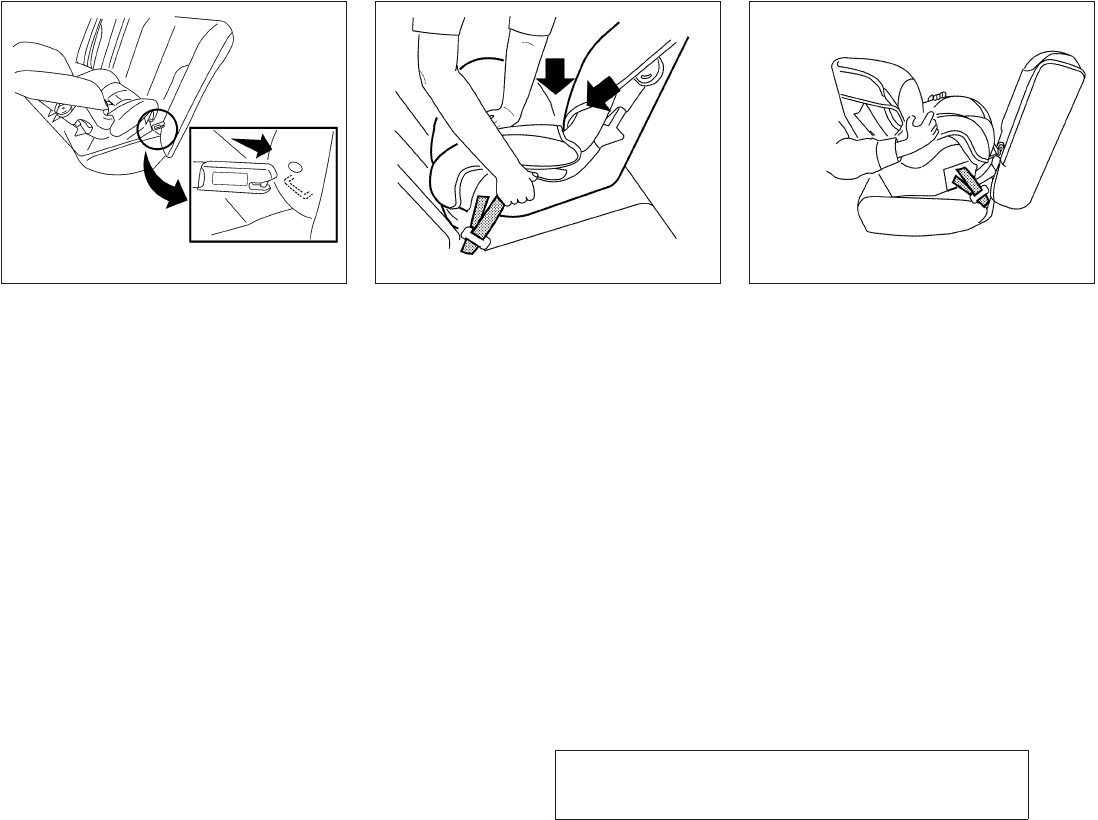
JOBNAME: 1093929-2013-asd-own PAGE: 40 SESS: 4 OUTPUT: Tue Mar 27 10:39:14 2012
2. Secure the child restraint anchor attach-
ments to the LATCH lower anchors. Check
to make sure the LATCH attachment is prop-
erly attached to the lower anchors.
3. For child restraints that are equipped with
webbing-mounted attachments, remove any
additional slack from the anchor attach-
ments. Press downward and rearward firmly
in the center of the child restraint with your
hand to compress the vehicle seat cushion
and seatback while tightening the webbing
of the anchor attachments.
4. After attaching the child restraint, test it be-
fore you place the child in it. Push it from side
to side while holding the child restraint near
the LATCH attachment path. The child re-
straint should not move more than 1 inch (25
mm), from side to side. Try to tug it forward
and check to see if the LATCH attachment
holds the restraint in place. If the restraint is
not secure, tighten the LATCH attachment
as necessary, or put the restraint in another
seat and test it again. You may need to try a
different child restraint or try installing by
using the vehicle seat belt (if applicable).
Not all child restraints fit in all types of ve-
hicles.
Rear-facing rigid-mounted – step 2
WRS0802
Rear-facing – step 3
LRS0673
Rear-facing – step 4
LRS0674
1-24 Safety—Seats, seat belts and supplemental restraint system
ZREVIEW COPY—
2013 Altima Sedan (asd)
Owners Manual—USA_English (nna)
03/24/12—dmoore
X
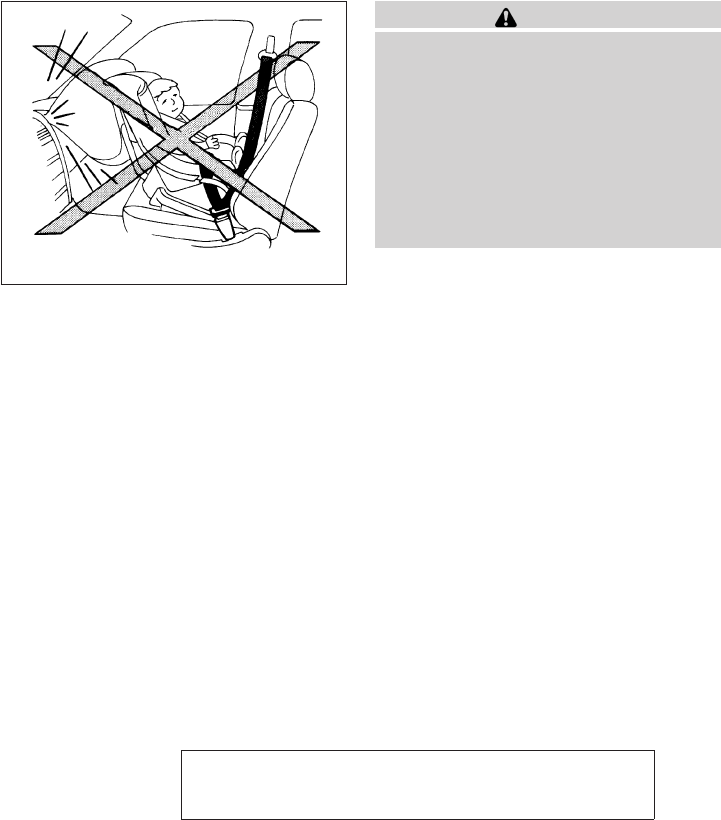
JOBNAME: 1093929-2013-asd-own PAGE: 41 SESS: 4 OUTPUT: Tue Mar 27 10:39:14 2012
5. Check to make sure the child restraint is
properly secured prior to each use. If the
child restraint is loose, repeat steps 2
through 4.
REAR-FACING CHILD RESTRAINT
INSTALLATION USING THE SEAT
BELTS
WARNING
The three-point seat belt with Automatic
Locking Retractor (ALR) must be used
when installing a child restraint. Failure to
use the ALR mode will result in the child
restraint not being properly secured. The
restraint could tip over or be loose and
cause injury to a child in a sudden stop or
collision. Also, it can change the opera-
tion of the front passenger air bag. See
“Front passenger air bag and status light”
later in this section.
WRS0256
Safety—Seats, seat belts and supplemental restraint system 1-25
ZREVIEW COPY—
2013 Altima Sedan (asd)
Owners Manual—USA_English (nna)
03/24/12—dmoore
X
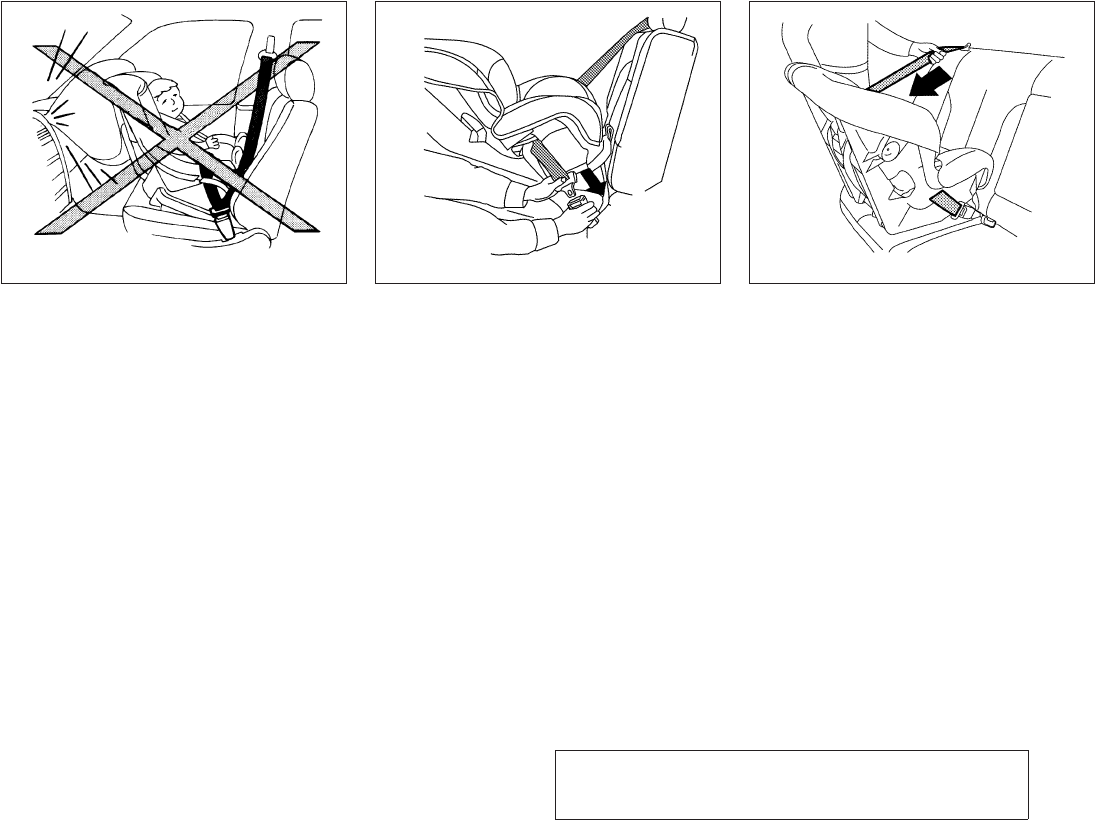
JOBNAME: 1093929-2013-asd-own PAGE: 42 SESS: 4 OUTPUT: Tue Mar 27 10:39:14 2012
Refer to all Warnings and Cautions in the “Child
safety” and “Child restraints” sections before in-
stalling a child restraint.
Follow these steps to install a rear-facing child
restraint using the vehicle seat belts in the rear
seats:
1. Child restraints for infants must be
used in the rear-facing direction and
therefore must not be used in the front
seat. Position the child restraint on the seat.
Always follow the restraint manufacturer’s
instructions.
2. Route the seat belt tongue through the child
restraint and insert it into the buckle until you
hear and feel the latch engage. Be sure to
follow the child restraint manufacturer’s in-
structions for belt routing.
3. Pull the shoulder belt until the belt is fully
extended. At this time, the seat belt retractor
is in the Automatic Locking Retractor (ALR)
mode (child restraint mode). It reverts to the
Emergency Locking Retractor (ELR) mode
when the seat belt is fully retracted.
Rear-facing – step 1
WRS0256
Rear-facing – step 2
WRS0761
Rear-facing – step 3
LRS0669
1-26 Safety—Seats, seat belts and supplemental restraint system
ZREVIEW COPY—
2013 Altima Sedan (asd)
Owners Manual—USA_English (nna)
03/24/12—dmoore
X
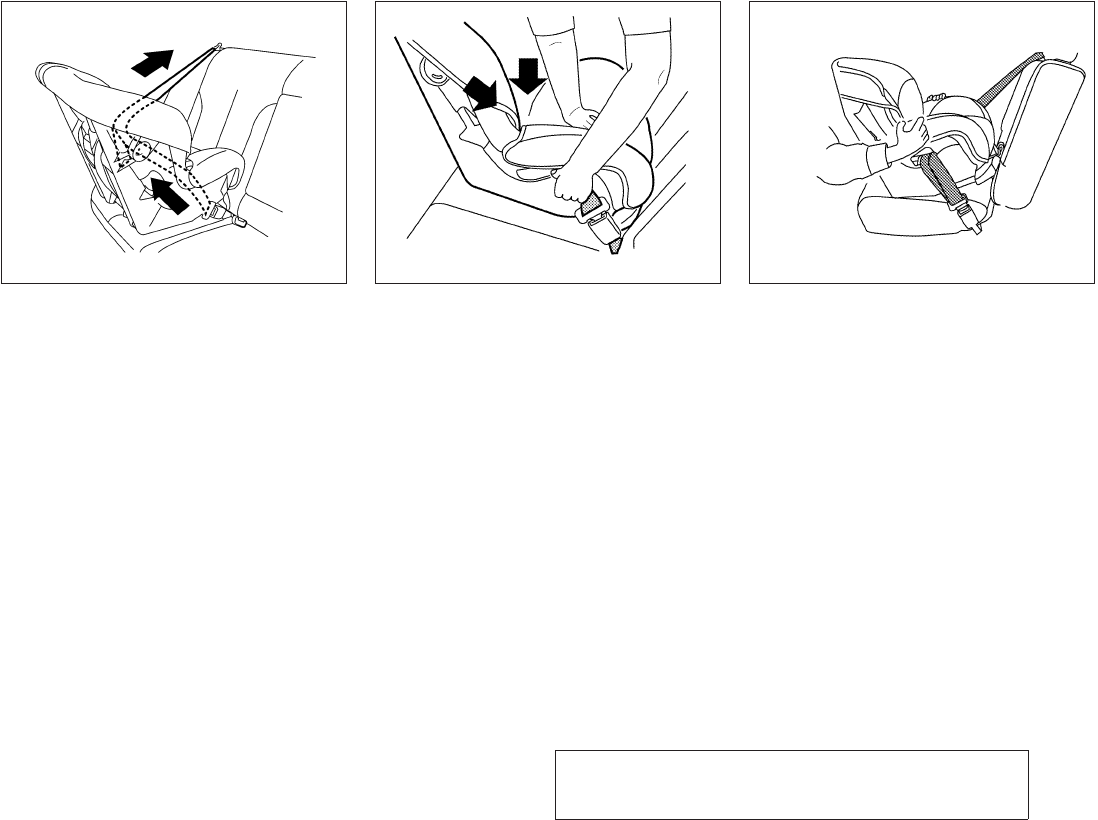
JOBNAME: 1093929-2013-asd-own PAGE: 43 SESS: 4 OUTPUT: Tue Mar 27 10:39:14 2012
4. Allow the seat belt to retract. Pull up on the
shoulder belt to remove any slack in the belt. 5. Remove any additional slack from the seat
belt; press downward and rearward firmly in
the center of the child restraint to compress
the vehicle seat cushion and seatback while
pulling up on the seat belt.
6. After attaching the child restraint, test it be-
fore you place the child in it. Push it from side
to side while holding the child restraint near
the seat belt path. The child restraint should
not move more than 1 inch (25 mm), from
side to side. Try to tug it forward and check
to see if the belt holds the restraint in place.
If the restraint is not secure, tighten the seat
belt as necessary, or put the restraint in
another seat and test it again. You may need
to try a different child restraint. Not all child
restraints fit in all types of vehicles.
Rear-facing – step 4
LRS0670
Rear-facing – step 5
WRS0762
Rear-facing – step 6
WRS0763
Safety—Seats, seat belts and supplemental restraint system 1-27
ZREVIEW COPY—
2013 Altima Sedan (asd)
Owners Manual—USA_English (nna)
03/24/12—dmoore
X
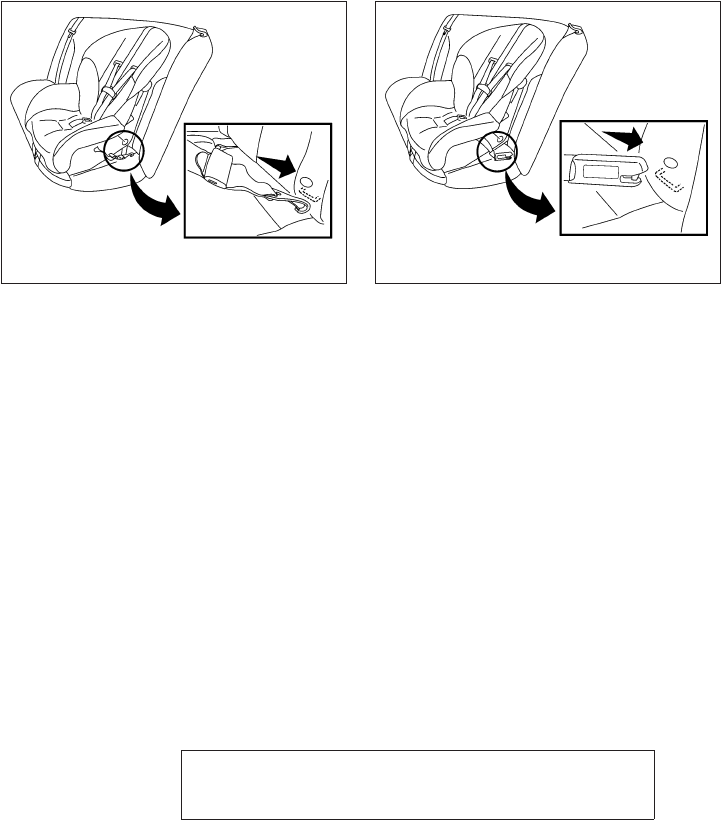
JOBNAME: 1093929-2013-asd-own PAGE: 44 SESS: 4 OUTPUT: Tue Mar 27 10:39:14 2012
7. Check to make sure that the child restraint is
properly secured prior to each use. If the
seat belt is not locked, repeat steps 1
through 6.
After the child restraint is removed and the seat
belt fully retracted, the ALR mode (child restraint
mode) is canceled.
FORWARD-FACING CHILD
RESTRAINT INSTALLATION USING
LATCH
Refer to all Warnings and Cautions in the “Child
Safety” and “Child Restraint” sections before in-
stalling a child restraint.
Follow these steps to install a forward-facing
child restraint using the LATCH system:
1. Position the child restraint on the seat. Al-
ways follow the child restraint manufactur-
er’s instructions.
2. Secure the child restraint anchor attach-
ments to the LATCH lower anchors. Check
to make sure the LATCH attachment is prop-
erly attached to the lower anchors.
If the child restraint is equipped with a top
tether strap, route the top tether strap and
secure the tether strap to the tether anchor
point. See “Installing top tether strap” in this
section. Do not install child restraints that
require the use of a top tether strap in seat-
ing positions that do not have a top tether
anchor.
Forward-facing web-mounted – step 2
WRS0799
Forward-facing rigid-mounted – step 2
WRS0800
1-28 Safety—Seats, seat belts and supplemental restraint system
ZREVIEW COPY—
2013 Altima Sedan (asd)
Owners Manual—USA_English (nna)
03/24/12—dmoore
X
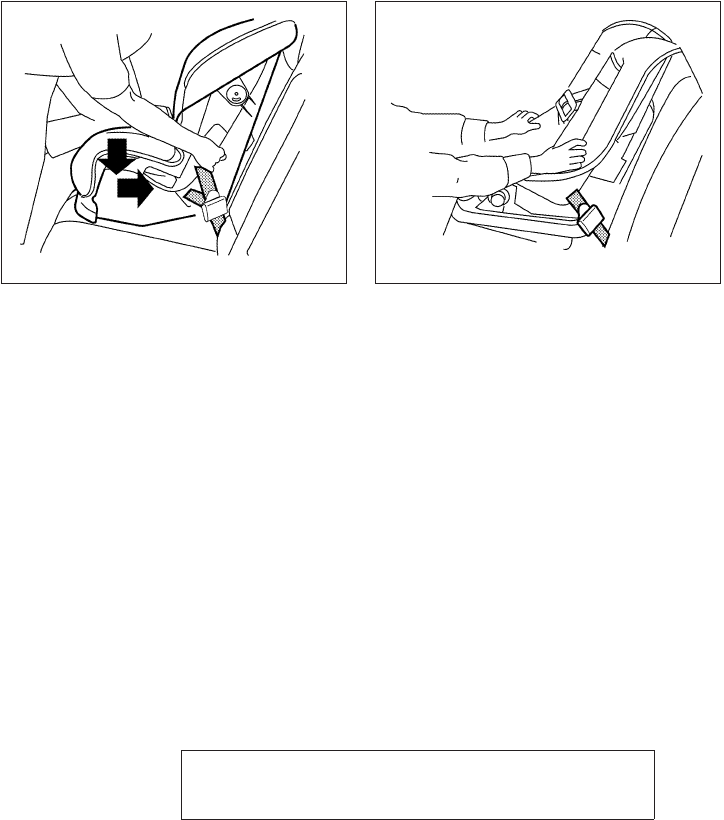
JOBNAME: 1093929-2013-asd-own PAGE: 45 SESS: 4 OUTPUT: Tue Mar 27 10:39:14 2012
3. The back of the child restraint should be
secured against the vehicle seatback.
If necessary, adjust or remove the head re-
straint to obtain the correct child restraint fit.
If the head restraint is removed, store it in a
secure place. Be sure to reinstall the
head restraint when the child restraint
is removed. See “Head restraints” in this
section for head restraint adjustment, re-
moval and installation information.
If the seating position does not have an
adjustable head restraint and it is interfering
with the proper child restraint fit, try another
seating position or a different child restraint.
4. For child restraints that are equipped with
webbing-mounted attachments, remove any
additional slack from the anchor attach-
ments. Press downward and rearward firmly
in the center of the child restraint with your
knee to compress the vehicle seat cushion
and seatback while tightening the webbing
of the anchor attachments.
5. Tighten the tether strap according to the
manufacturer’s instructions to remove any
slack.
6. After attaching the child restraint, test it be-
fore you place the child in it. Push it from side
to side while holding the child restraint near
the LATCH attachment path. The child re-
straint should not move more than 1 inch (25
mm), from side to side. Try to tug it forward
and check to see if the LATCH attachment
holds the restraint in place. If the restraint is
not secure, tighten the LATCH attachment
as necessary, or put the restraint in another
seat and test it again. You may need to try a
different child restraint. Not all child re-
straints fit in all types of vehicles.
Forward-facing – step 4
LRS0671
Forward-facing – step 6
WRS0697
Safety—Seats, seat belts and supplemental restraint system 1-29
ZREVIEW COPY—
2013 Altima Sedan (asd)
Owners Manual—USA_English (nna)
03/24/12—dmoore
X
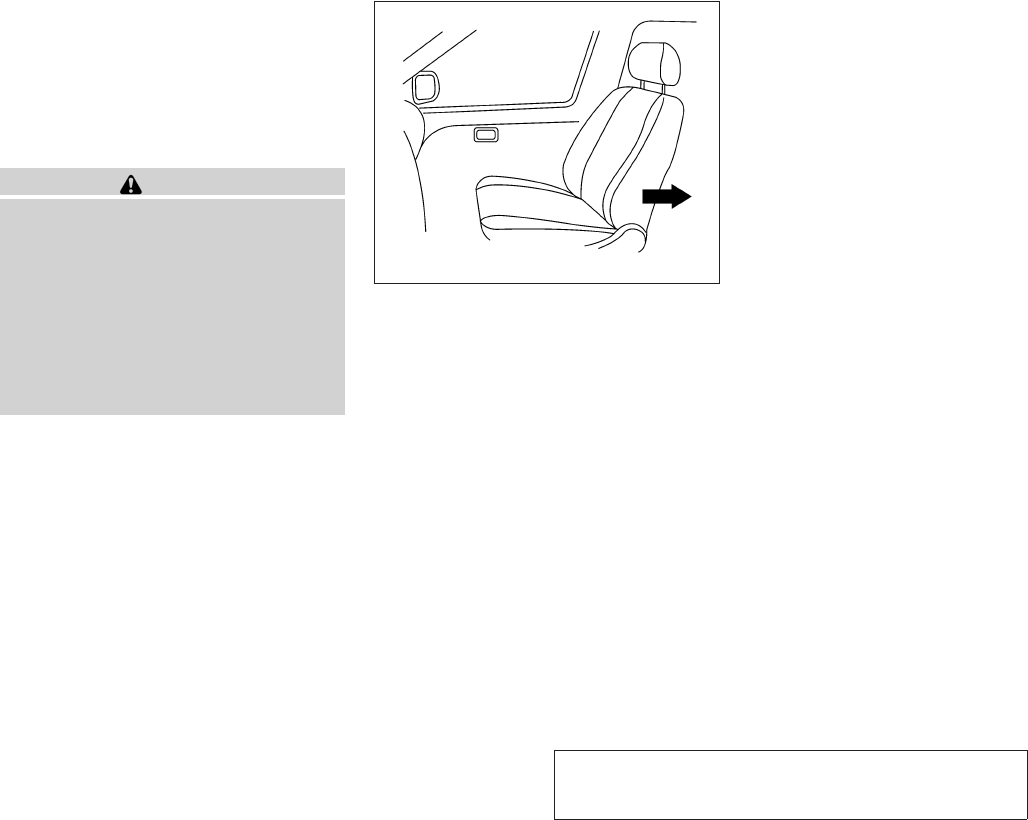
JOBNAME: 1093929-2013-asd-own PAGE: 46 SESS: 4 OUTPUT: Tue Mar 27 10:39:14 2012
7. Check to make sure the child restraint is
properly secured prior to each use. If the
child restraint is loose, repeat steps 2
through 6.
FORWARD-FACING CHILD
RESTRAINT INSTALLATION USING
THE SEAT BELTS
WARNING
The three-point seat belt with Automatic
Locking Retractor (ALR) must be used
when installing a child restraint. Failure to
use the ALR mode will result in the child
restraint not being properly secured. The
restraint could tip over or be loose and
cause injury to a child in a sudden stop or
collision. Also, it can change the opera-
tion of the front passenger air bag. See
“Front passenger air bag and status light”
later in this section.
Refer to all Warnings and Cautions in the “Child
Safety” and “Child Restraint” sections before in-
stalling a child restraint.
Follow these steps to install a forward-facing
child restraint using the vehicle seat belt in the
rear seats or in the front passenger seat:
1. If you must install a child restraint in
the front seat, it should be placed in a
forward-facing direction only. Move
the seat to the rearmost position. Child
restraints for infants must be used in
the rear-facing direction and, there-
fore, must not be used in the front seat.
2. Position the child restraint on the seat. Al-
ways follow the child restraint manufactur-
er’s instructions.
The back of the child restraint should be
secured against the vehicle seatback.
If necessary, adjust or remove the head re-
straint to obtain the correct child restraint fit.
If the head restraint is removed, store it in a
secure place. Be sure to reinstall the
head restraint when the child restraint
is removed. See “Head restraints” in this
section for head restraint adjustment, re-
moval and installation information.
If the seating position does not have an
adjustable head restraint and it is interfering
with the proper child restraint fit, try another
seating position or a different child restraint.
Forward-facing (front passenger seat) –
step 1
WRS0699
1-30 Safety—Seats, seat belts and supplemental restraint system
ZREVIEW COPY—
2013 Altima Sedan (asd)
Owners Manual—USA_English (nna)
03/24/12—dmoore
X
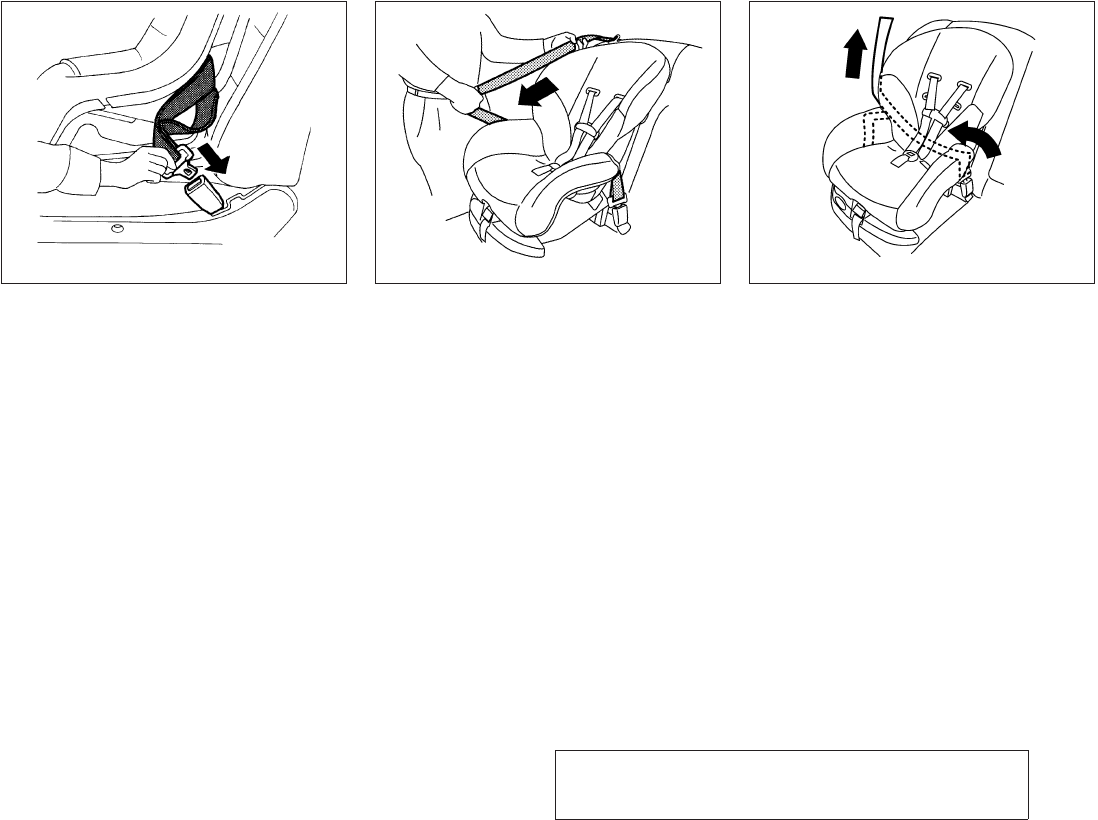
JOBNAME: 1093929-2013-asd-own PAGE: 47 SESS: 4 OUTPUT: Tue Mar 27 10:39:14 2012
3. Route the seat belt tongue through the child
restraint and insert it into the buckle until you
hear and feel the latch engage. Be sure to
follow the child restraint manufacturer’s in-
structions for belt routing.
If the child restraint is equipped with a top
tether strap, route the top tether strap and
secure the tether strap to the tether anchor
point (rear seat installation only). See “In-
stalling top tether strap” in this section. Do
not install child restraints that require the use
of a top tether strap in seating positions that
do not have a top tether anchor.
4. Pull the shoulder belt until the belt is fully
extended. At this time, the seat belt retractor
is in the Automatic Locking Retractor (ALR)
mode (child restraint mode). It reverts to
Emergency Locking Retractor (ELR) mode
when the seat belt is fully retracted.
5. Allow the seat belt to retract. Pull up on the
shoulder belt to remove any slack in the belt.
Forward-facing – step 3
WRS0680
Forward-facing – step 4
LRS0667
Forward-facing – step 5
LRS0668
Safety—Seats, seat belts and supplemental restraint system 1-31
ZREVIEW COPY—
2013 Altima Sedan (asd)
Owners Manual—USA_English (nna)
03/24/12—dmoore
X
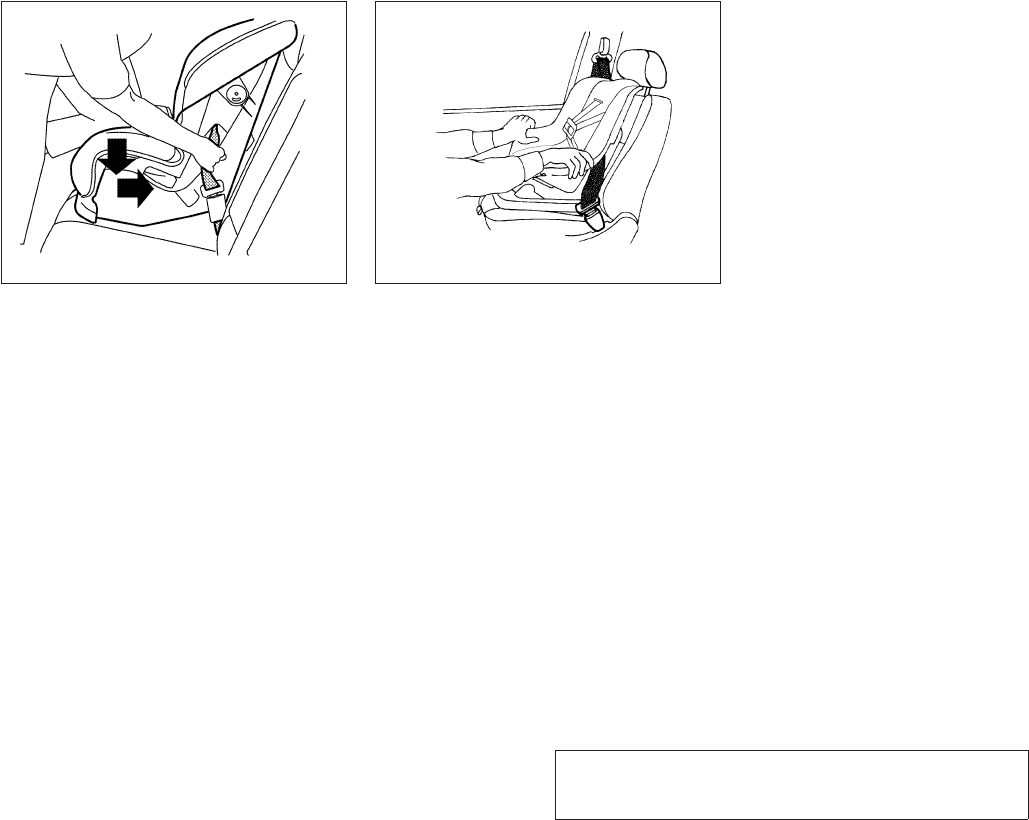
JOBNAME: 1093929-2013-asd-own PAGE: 48 SESS: 4 OUTPUT: Tue Mar 27 10:39:14 2012
6. Remove any additional slack from the seat
belt; press downward and rearward firmly in
the center of the child restraint with your
knee to compress the vehicle seat cushion
and seatback while pulling up on the seat
belt.
7. Tighten the tether strap according to the
manufacturer’s instructions to remove any
slack.
8. After attaching the child restraint, test it be-
fore you place the child in it. Push it from side
to side while holding the child restraint near
the seat belt path. The child restraint should
not move more than 1 inch (25 mm), from
side to side. Try to tug it forward and check
to see if the belt holds the restraint in place.
If the restraint is not secure, tighten the seat
belt as necessary, or put the restraint in
another seat and test it again. You may need
to try a different child restraint. Not all child
restraints fit in all types of vehicles.
9. Check to make sure the child restraint is
properly secured prior to each use. If the
seat belt is not locked, repeat steps 2
through 8.
Forward-facing – step 6
WRS0681
Forward-facing – step 8
WRS0698
1-32 Safety—Seats, seat belts and supplemental restraint system
ZREVIEW COPY—
2013 Altima Sedan (asd)
Owners Manual—USA_English (nna)
03/24/12—dmoore
X
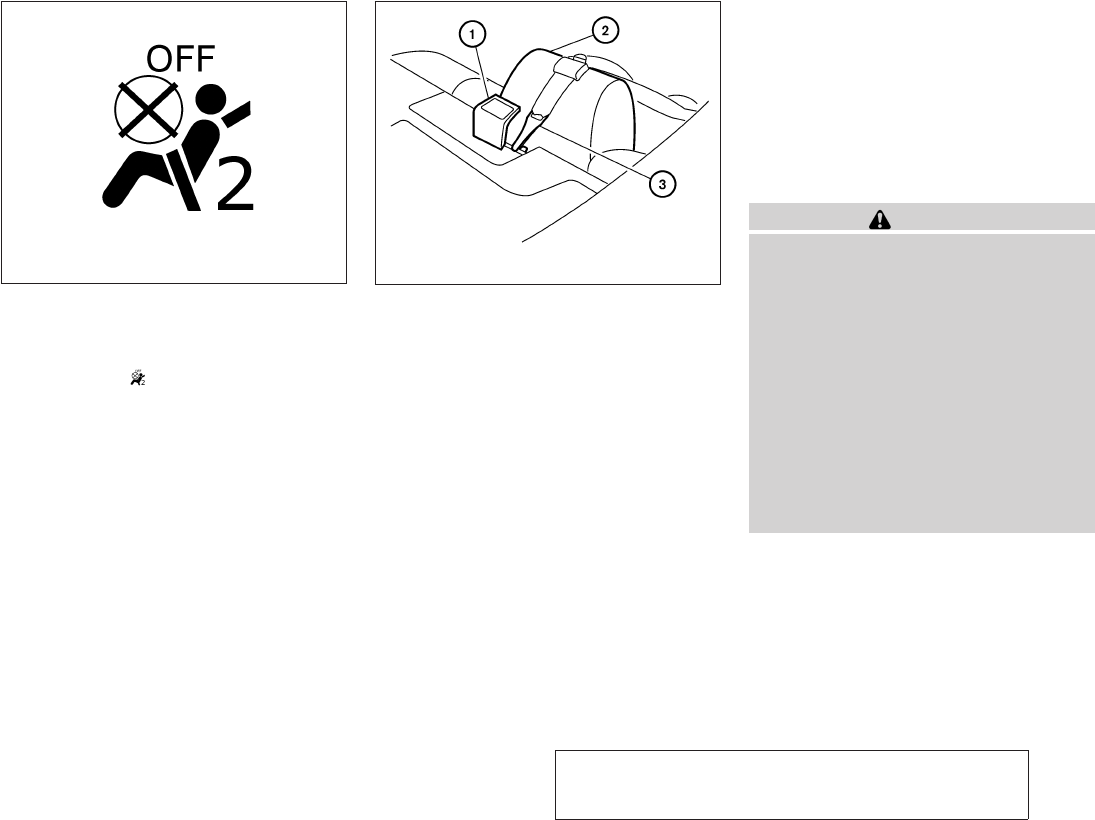
JOBNAME: 1093929-2013-asd-own PAGE: 49 SESS: 4 OUTPUT: Tue Mar 27 10:39:14 2012
10. If the child restraint is installed in the front
passenger seat, place the ignition switch in
the ON position. The front passenger air bag
status light should illuminate. If this
light is not illuminated, see “Front passenger
air bag and status light” in this section.
Move the child restraint to another
seating position. Have the system
checked by a NISSAN dealer.
After the child restraint is removed and the seat
belt is fully retracted, the ALR mode (child re-
straint mode) is canceled.
INSTALLING TOP TETHER STRAP
First, secure the child restraint with the LATCH
lower anchors (rear outboard seat positions only)
or the seat belt, as applicable.
1. Flip up the anchor cover s
1from the anchor
point which is located directly behind the
child seat.
2. Position the top tether strap over the top of
the head restraint s
2.
3. Secure the tether strap to the tether anchor
point on the rear parcel shelf s
3.
4. Refer to the appropriate child restraint in-
stallation procedure steps in this section
before tightening the tether strap.
If you have any questions when installing a
top tether strap, consult your NISSAN
dealer for details.
BOOSTER SEATS
Precautions on booster seats
WARNING
If a booster seat and seat belt are not used
properly, the risk of a child being injured
in a sudden stop or collision greatly
increases:
– Make sure the shoulder portion of
the belt is away from the child’s face
and neck and the lap portion of the
belt does not cross the stomach.
– Make sure the shoulder belt is not
behind the child or under the child’s
arm.
– A booster seat must only be installed
in a seating position that has a
lap/shoulder belt.
Forward-facing – step 10
WRS0475 LRS0798
Safety—Seats, seat belts and supplemental restraint system 1-33
ZREVIEW COPY—
2013 Altima Sedan (asd)
Owners Manual—USA_English (nna)
03/24/12—dmoore
X
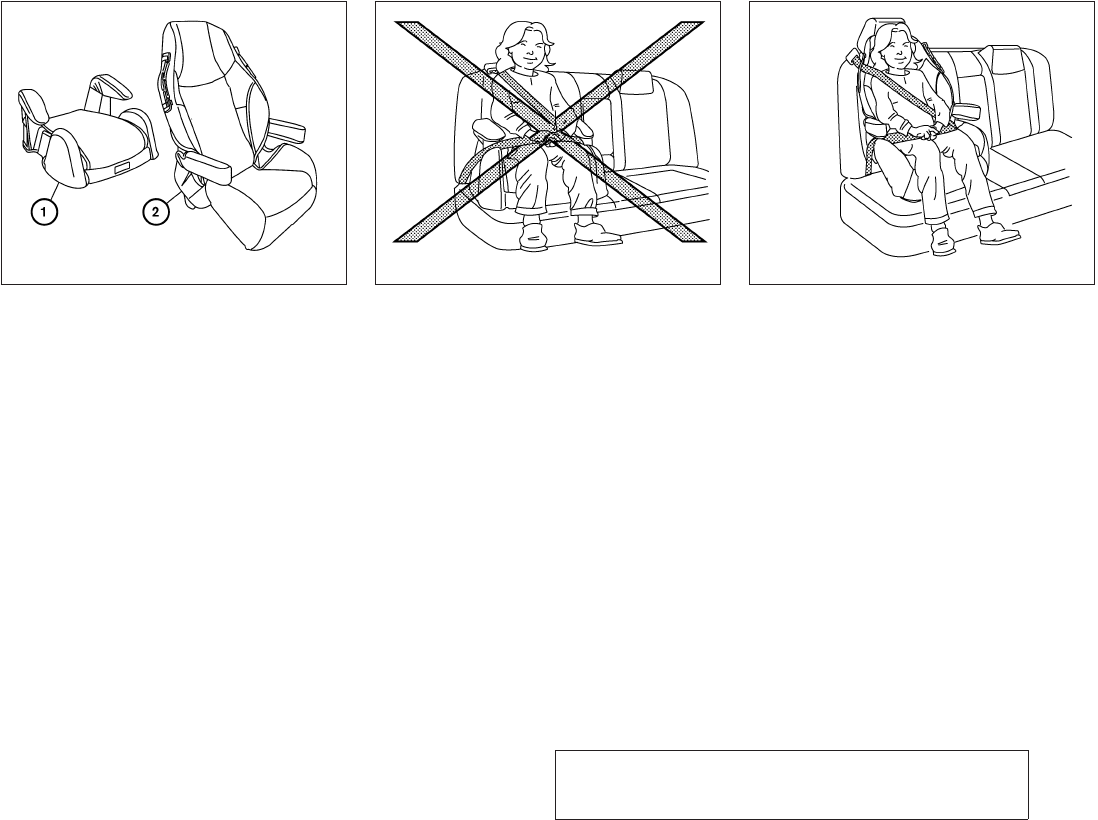
JOBNAME: 1093929-2013-asd-own PAGE: 50 SESS: 4 OUTPUT: Tue Mar 27 10:39:14 2012
Booster seats of various sizes are offered by
several manufacturers. When selecting any
booster seat, keep the following points in mind:
●Choose only a booster seat with a label
certifying that it complies with Federal Motor
Vehicle Safety Standard 213 or Canadian
Motor Vehicle Safety Standard 213.
●Check the booster seat in your vehicle to be
sure it is compatible with the vehicle’s seat
and seat belt system.
LRS0455 LRS0453 LRS0464
1-34 Safety—Seats, seat belts and supplemental restraint system
ZREVIEW COPY—
2013 Altima Sedan (asd)
Owners Manual—USA_English (nna)
03/24/12—dmoore
X
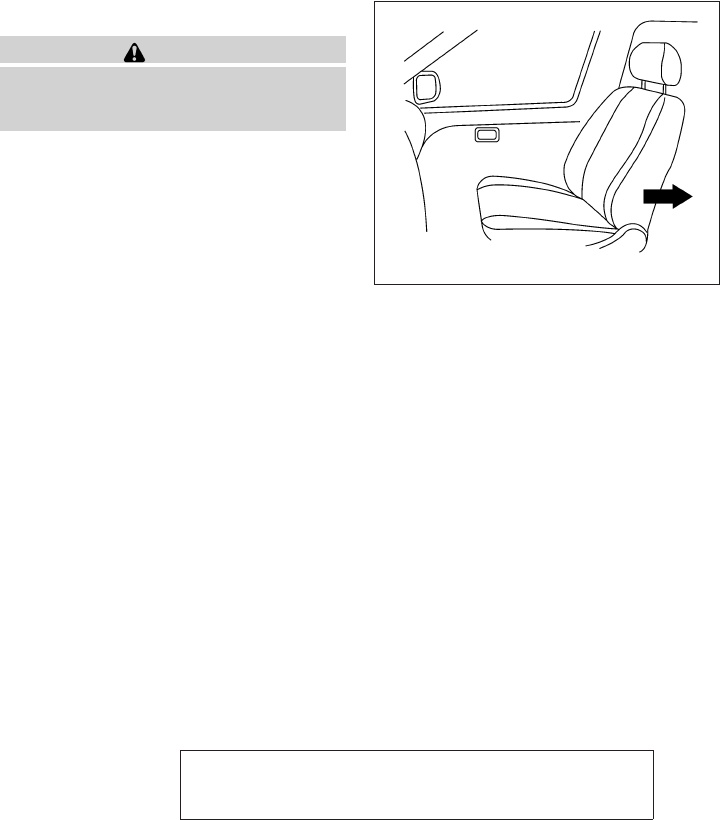
JOBNAME: 1093929-2013-asd-own PAGE: 51 SESS: 4 OUTPUT: Tue Mar 27 10:39:14 2012
●Make sure the child’s head will be properly
supported by the booster seat or vehicle
seat. The seatback must be at or above the
center of the child’s ears. For example, if a
low back booster seat s
1is chosen, the
vehicle seatback must be at or above the
center of the child’s ears. If the seatback is
lower than the center of the child’s ears, a
high back booster seat s
2should be used.
●If the booster seat is compatible with your
vehicle, place the child in the booster seat
and check the various adjustments to be
sure the booster seat is compatible with the
child. Always follow all recommended pro-
cedures.
All U.S. states and Canadian provinces or
territories require that infants and small
children be restrained in an approved child
restraint at all times while the vehicle is
being operated.
The instructions in this section apply to booster
seat installation in the rear seats or the front
passenger seat.
Booster seat installation
CAUTION
Do not use the lap/shoulder belt in the
Automatic Locking Retractor mode when
using a booster seat with the seat belts.
Refer to all Warnings and Cautions in the “Child
Safety”, “Child Restraint” and “Booster Seats”
sections before installing a child restraint.
Follow these steps to install a booster seat in the
rear seat or in the front passenger seat:
1. If you must install a booster seat in the
front seat, move the seat to the rear-
most position.
2. Position the booster seat on the seat. Only
place it in a front-facing direction. Always
follow the booster seat manufacturer’s in-
structions.
WRS0699
Safety—Seats, seat belts and supplemental restraint system 1-35
ZREVIEW COPY—
2013 Altima Sedan (asd)
Owners Manual—USA_English (nna)
03/24/12—dmoore
X
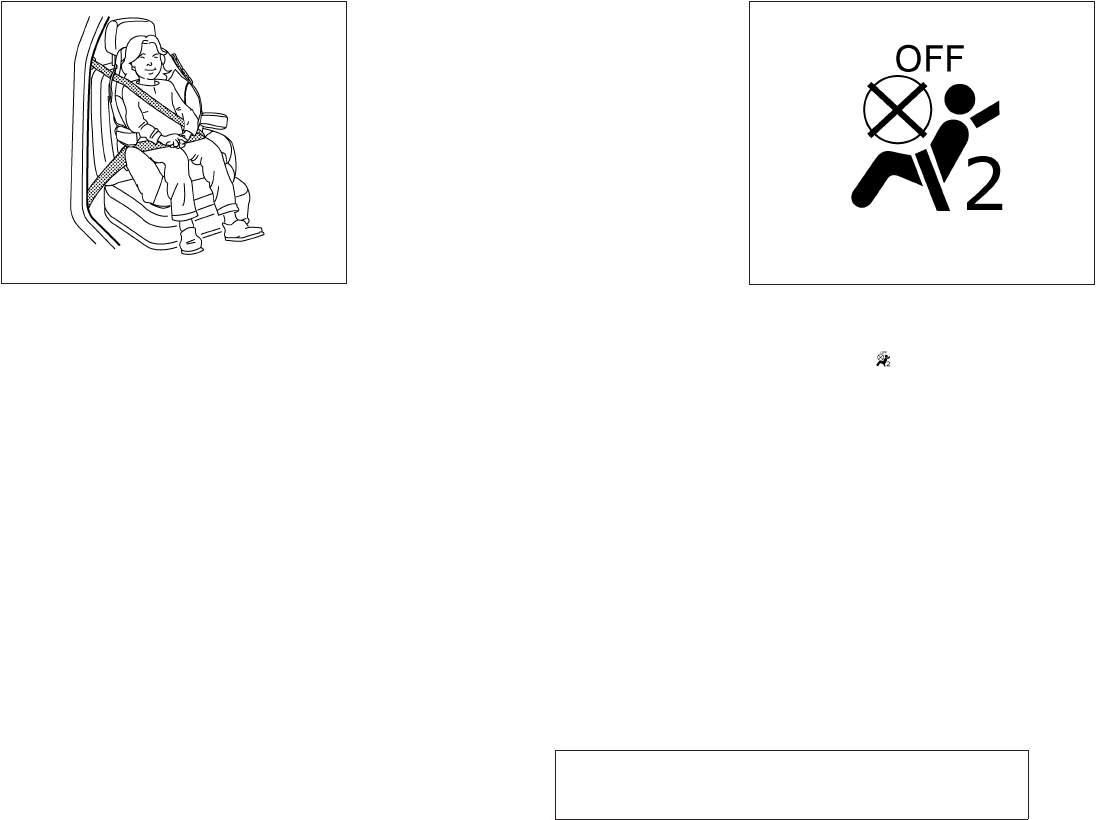
JOBNAME: 1093929-2013-asd-own PAGE: 52 SESS: 4 OUTPUT: Tue Mar 27 10:39:14 2012
3. The booster seat should be positioned on
the vehicle seat so that it is stable.
If necessary, adjust or remove the head re-
straint to obtain the correct booster seat fit. If
the head restraint is removed, store it in a
secure place. Be sure to reinstall the
head restraint when the booster seat is
removed. See “Head restraints”in this sec-
tion for head restraint adjustment, removal
and installation information.
If the seating position does not have an
adjustable head restraint and it is interfering
with the proper booster seat fit, try another
seating position or a different booster seat.
4. Position the lap portion of the seat belt low
and snug on the child’s hips. Be sure to
follow the booster seat manufacturer’s in-
structions for adjusting the seat belt routing.
5. Pull the shoulder belt portion of the seat belt
toward the retractor to take up extra slack.
Be sure the shoulder belt is positioned
across the top, middle portion of the child’s
shoulder. Be sure to follow the booster seat
manufacturer’s instructions for adjusting the
seat belt routing.
6. Follow the warnings, cautions and instruc-
tions for properly fastening a seat belt
shown in “Three-point type seat belt with
retractor” earlier in this section.
7. If the booster seat is installed in the front
passenger seat, place the ignition switch in
the ON position. The front passenger air bag
status light may or may not illuminate,
depending on the size of the child and the
type of booster seat being used. See “Front
passenger air bag and status light” later in
this section.
Front passenger position
LRS0454 WRS0475
1-36 Safety—Seats, seat belts and supplemental restraint system
ZREVIEW COPY—
2013 Altima Sedan (asd)
Owners Manual—USA_English (nna)
03/24/12—dmoore
X

JOBNAME: 1093929-2013-asd-own PAGE: 53 SESS: 4 OUTPUT: Tue Mar 27 10:39:14 2012
PRECAUTIONS ON SUPPLEMENTAL
RESTRAINT SYSTEM
This Supplemental Restraint System (SRS) sec-
tion contains important information concerning
the following systems:
●Driver and passenger supplemental front-
impact air bag (NISSAN Advanced Air Bag
System)
●Front seat-mounted side-impact supple-
mental air bag
●Roof-mounted curtain side-impact supple-
mental air bag
●Seat belt with pretensioner
Supplemental front- impact air bag system:
The NISSAN Advanced Air Bag System can help
cushion the impact force to the head and chest of
the driver and front passenger in certain frontal
collisions.
Front seat-mounted side-impact supple-
mental air bag system: This system can help
cushion the impact force to the chest area of the
driver and front passenger in certain side-impact
collisions. The side air bags are designed to
inflate on the side where the vehicle is impacted.
Roof-mounted curtain side-impact supple-
mental air bag system: This system can help
cushion the impact force to the head of occu-
pants in front and rear outboard seating positions
in certain side-impact or rollover collisions. In a
side impact, the curtain air bags are designed to
inflate on the side where the vehicle is impacted.
In a rollover, both curtain air bags are designed to
inflate and remain inflated for a short time.
These supplemental restraint systems are de-
signed to supplement the crash protection pro-
vided by the driver and front passenger seat belts
and are not a substitute for them. Seat belts
should always be correctly worn and the occu-
pant seated a suitable distance away from the
steering wheel, instrument panel and door finish-
ers. See “Seat belts” earlier in this section for
instructions and precautions on seat belt usage.
The supplemental air bags operate only
when the ignition switch is placed in the
ON position.
After placing the ignition switch in the ON
position, the supplemental air bag warning
light illuminates. The supplemental air bag
warning light will turn off after about 7
seconds if the system is operational.
SUPPLEMENTAL RESTRAINT
SYSTEM
Safety—Seats, seat belts and supplemental restraint system 1-37
ZREVIEW COPY—
2013 Altima Sedan (asd)
Owners Manual—USA_English (nna)
03/24/12—dmoore
X
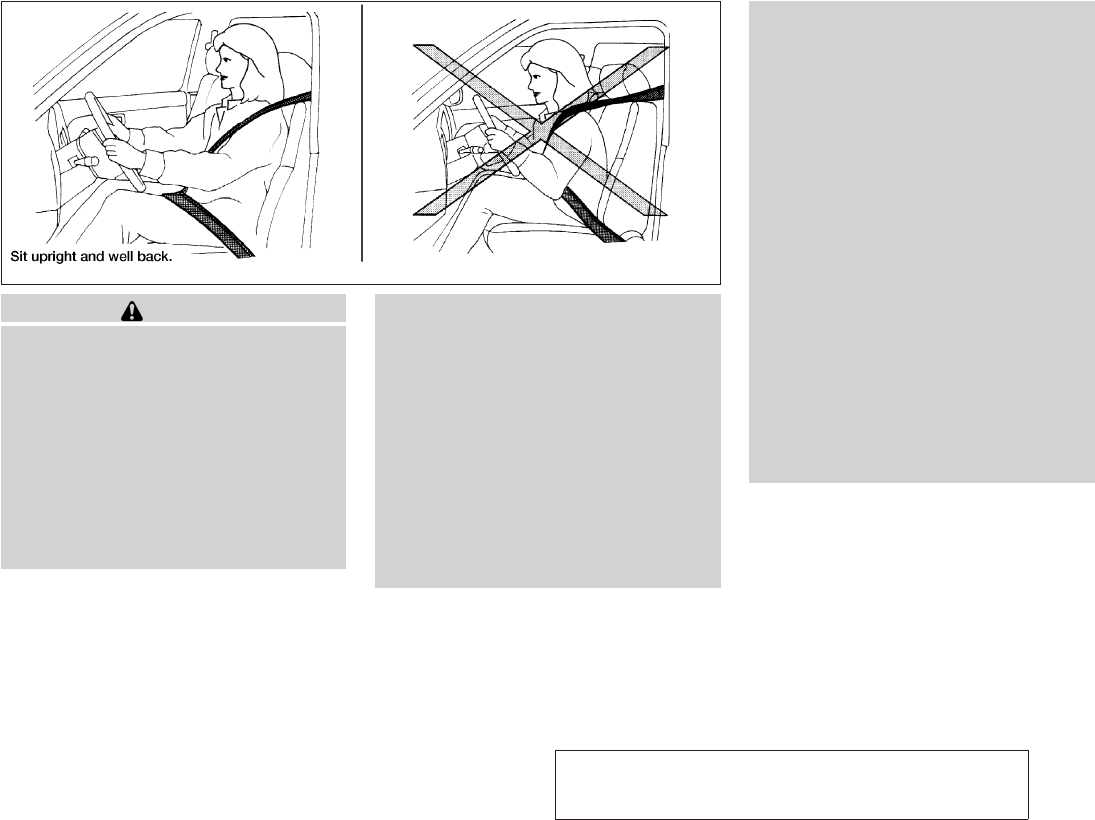
JOBNAME: 1093929-2013-asd-own PAGE: 54 SESS: 4 OUTPUT: Tue Mar 27 10:39:14 2012
WARNING
●The front air bags ordinarily will not
inflate in the event of a side impact, rear
impact, rollover, or lower severity fron-
tal collision. Always wear your seat
belts to help reduce the risk or severity
of injury in various kinds of accidents.
●The front passenger air bag will not
inflate if the passenger air bag status
light is lit or if the front passenger seat
is unoccupied. See “Front passenger air
bag and status light” later in this
section.
●The seat belts and the front air bags are
most effective when you are sitting well
back and upright in the seat. The front
air bags inflate with great force. Even
with the NISSAN Advanced Air Bag Sys-
tem, if you are unrestrained, leaning
forward, sitting sideways or out of posi-
tion in any way, you are at greater risk of
injury or death in a crash. You may also
receive serious or fatal injuries from the
front air bag if you are up against it
when it inflates. Always sit back against
the seatback and as far away as practi-
cal from the steering wheel or instru-
ment panel. Always use the seat belts.
●The driver and front passenger seat belt
buckles are equipped with sensors that
detect if the seat belts are fastened. The
Advanced Air Bag System monitors the
severity of a collision and seat belt us-
age then inflates the air bags as
needed. Failure to properly wear seat
belts can increase the risk or severity of
injury in an accident.
●The front passenger seat is equipped
with an Occupant Classification Sensor
(weight sensor) that turns the front pas-
senger air bag OFF under some condi-
tions. This sensor is only used in this
seat. Failure to be properly seated and
wearing the seat belt can increase the
risk or severity of injury in an accident.
See “Front passenger air bag and sta-
tus light” later in this section.
●Keep hands on the outside of the steer-
ing wheel. Placing them inside the
steering wheel rim could increase the
risk that they are injured when the front
air bag inflates.
WRS0031
1-38 Safety—Seats, seat belts and supplemental restraint system
ZREVIEW COPY—
2013 Altima Sedan (asd)
Owners Manual—USA_English (nna)
03/24/12—dmoore
X
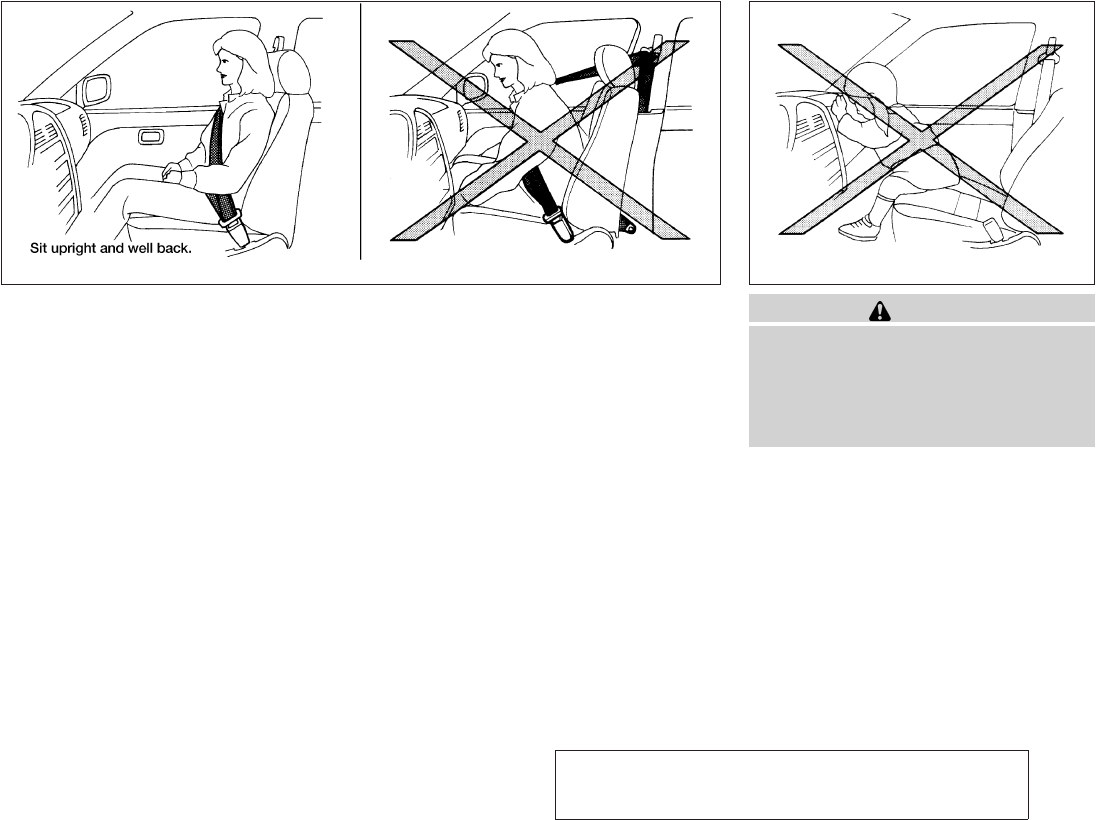
JOBNAME: 1093929-2013-asd-own PAGE: 55 SESS: 4 OUTPUT: Tue Mar 27 10:39:14 2012
WARNING
●Never let children ride unrestrained or
extend their hands or face out of the
window. Do not attempt to hold them in
your lap or arms. Some examples of
dangerous riding positions are shown
in the illustrations.
ARS1133 ARS1041
Safety—Seats, seat belts and supplemental restraint system 1-39
ZREVIEW COPY—
2013 Altima Sedan (asd)
Owners Manual—USA_English (nna)
03/24/12—dmoore
X
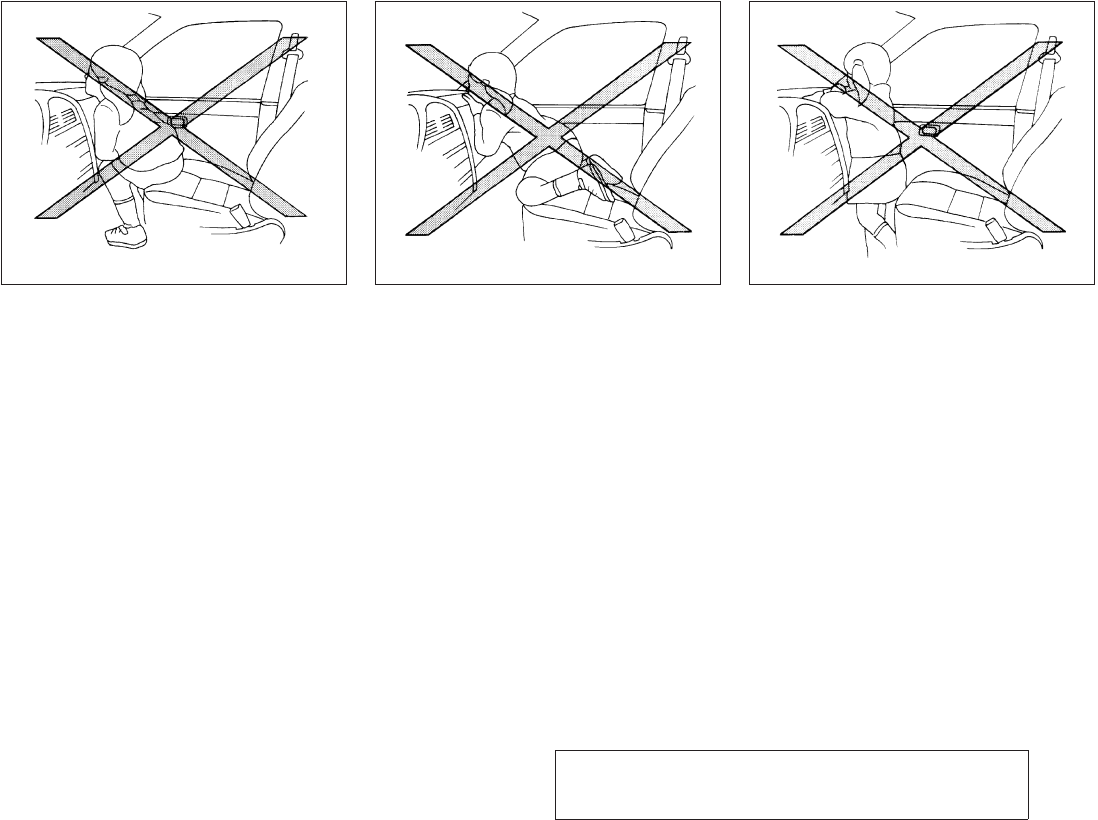
JOBNAME: 1093929-2013-asd-own PAGE: 56 SESS: 4 OUTPUT: Tue Mar 27 10:39:14 2012
ARS1042 ARS1043 ARS1044
1-40 Safety—Seats, seat belts and supplemental restraint system
ZREVIEW COPY—
2013 Altima Sedan (asd)
Owners Manual—USA_English (nna)
03/24/12—dmoore
X
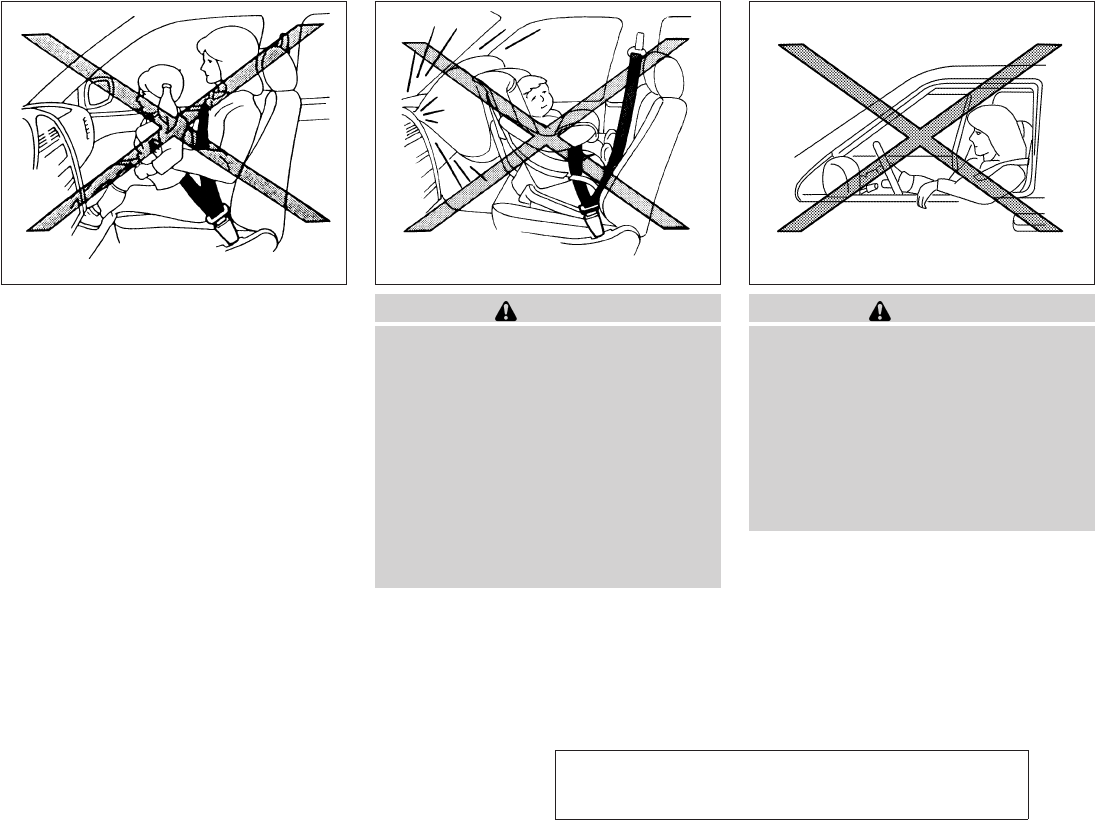
JOBNAME: 1093929-2013-asd-own PAGE: 57 SESS: 4 OUTPUT: Tue Mar 27 10:39:14 2012
WARNING
●Children may be severely injured or
killed when the front air bags, side air
bags or curtain air bags inflate if they
are not properly restrained. Pre-teens
and children should be properly re-
strained in the rear seat, if possible.
●Even with the NISSAN Advanced Air
Bag System, never install a rear-facing
child restraint in the front seat. An in-
flating front air bag could seriously in-
jure or kill your child. See “Child re-
straints” earlier in this section for
details.
WARNING
Front seat-mounted side-impact supple-
mental air bags and roof-mounted curtain
side-impact supplemental air bags:
●The side air bags and curtain air bags
ordinarily will not inflate in the event of
a frontal impact, rear impact, rollover or
lower severity side collision. Always
wear your seat belts to help reduce the
risk or severity of injury in various kinds
of accidents.
ARS1045 ARS1046 WRS0431
Safety—Seats, seat belts and supplemental restraint system 1-41
ZREVIEW COPY—
2013 Altima Sedan (asd)
Owners Manual—USA_English (nna)
03/24/12—dmoore
X
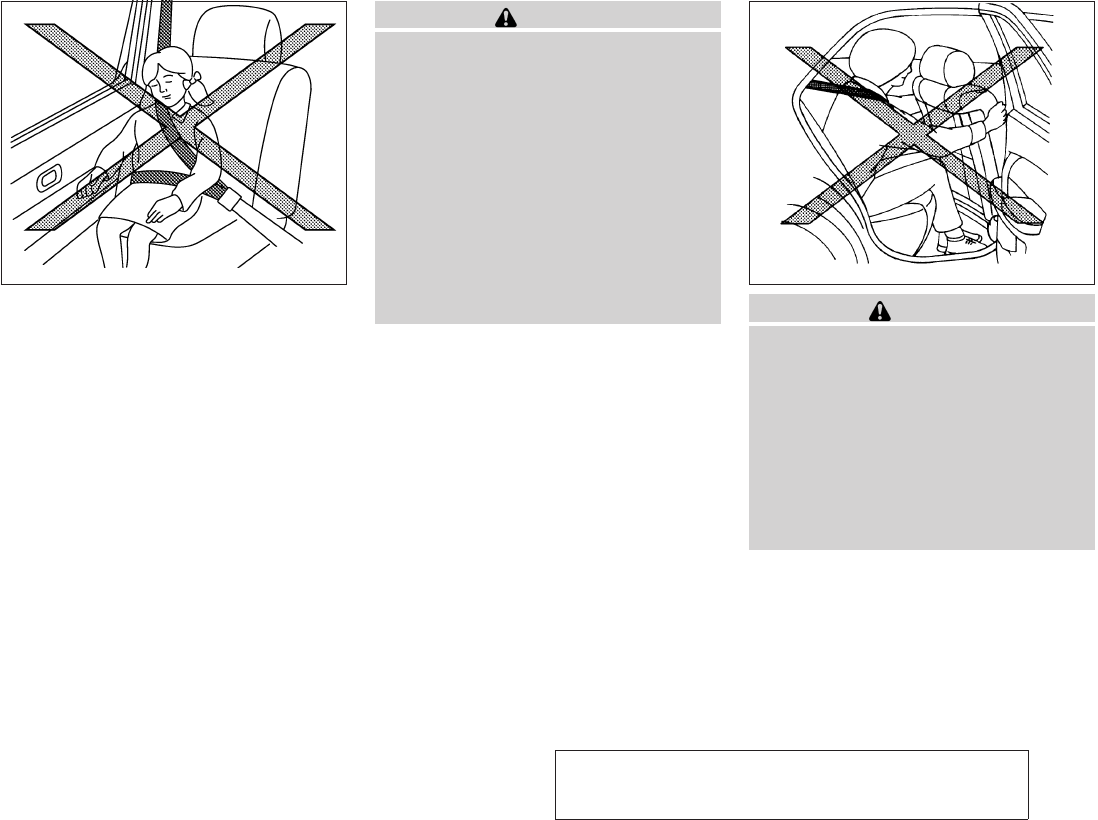
JOBNAME: 1093929-2013-asd-own PAGE: 58 SESS: 4 OUTPUT: Tue Mar 27 10:39:14 2012
WARNING
●The seat belts, the side air bags and
curtain air bags are most effective when
you are sitting well back and upright in
the seat with both feet on the floor. The
side air bag and curtain air bag inflate
with great force. Do not allow anyone to
place their hand, leg or face near the
side air bag on the side of the seatback
of the front seat or near the side roof
rails. Do not allow anyone sitting in the
front seats or rear outboard seats to
extend their hand out of the window or
lean against the door. Some examples
of dangerous riding positions are
shown in the previous illustrations. WARNING
●When sitting in the 2nd row rear seat, do
not hold onto the seatback of the front
seat. If the side air bag inflates, you may
be seriously injured. Be especially care-
ful with children, who should always be
properly restrained. Some examples of
dangerous riding positions are shown
in the illustrations.
●Do not use seat covers on the front
seatbacks. They may interfere with side
air bag inflation.
SSS0162 WRS0032
1-42 Safety—Seats, seat belts and supplemental restraint system
ZREVIEW COPY—
2013 Altima Sedan (asd)
Owners Manual—USA_English (nna)
03/24/12—dmoore
X
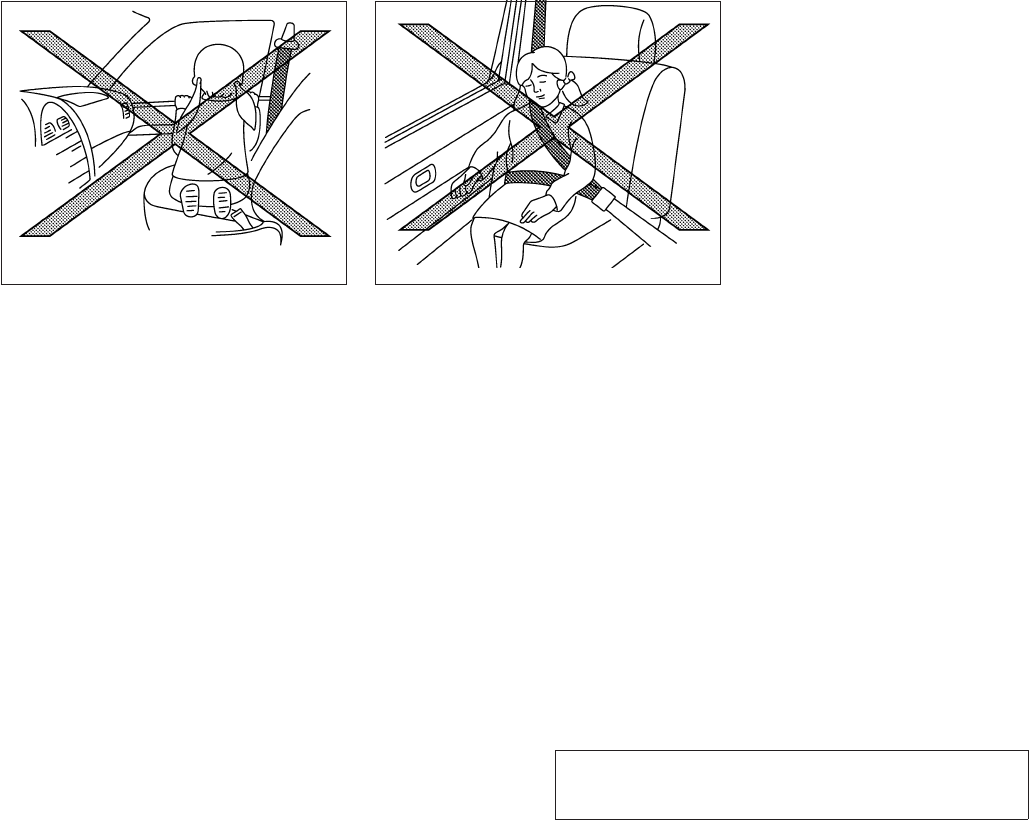
JOBNAME: 1093929-2013-asd-own PAGE: 59 SESS: 4 OUTPUT: Tue Mar 27 10:39:14 2012
SSS0159 SSS0162
Safety—Seats, seat belts and supplemental restraint system 1-43
ZREVIEW COPY—
2013 Altima Sedan (asd)
Owners Manual—USA_English (nna)
03/24/12—dmoore
X
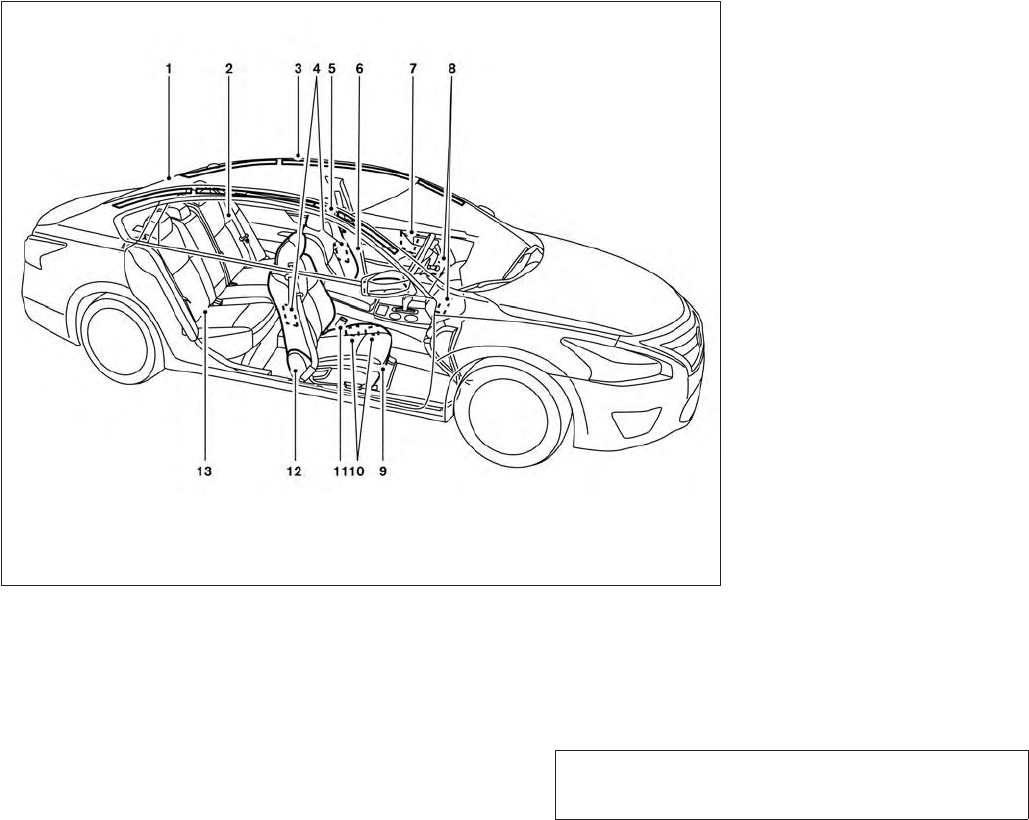
JOBNAME: 1093929-2013-asd-own PAGE: 60 SESS: 4 OUTPUT: Tue Mar 27 10:39:14 2012
1. Top tether strap anchor
2. Rear seat belts
3. Roof-mounted curtain side-impact
supplemental air bag
4. Front seat-mounted side-impact
supplemental air bag
5. Head restraints
6. Front seat belts
7. Side-impact pressure sensor (driver’s
side shown; passenger’s side similar)
8. Supplemental front-impact air bags
9. Seats
10. Occupant classification sensor
(weight sensor)
11. Buckle pretensioner
12. Seat belt with pretensioner
13. LATCH (Lower Anchors and Tethers for
CHildren) system
LII2041
1-44 Safety—Seats, seat belts and supplemental restraint system
ZREVIEW COPY—
2013 Altima Sedan (asd)
Owners Manual—USA_English (nna)
03/24/12—dmoore
X
Per engineering comment,
pretensioners are not in
the buckle
11
12
11
12

JOBNAME: 1093929-2013-asd-own PAGE: 61 SESS: 4 OUTPUT: Tue Mar 27 10:39:14 2012
NISSAN Advanced Air Bag System
(front seats)
WARNING
To ensure proper operation of the passen-
ger’s advanced air bag system, please ob-
serve the following items.
●Do not allow a passenger in the rear
seat to push or pull on the seatback
pocket.
●Do not place heavy loads heavier than
2.2 lb (4 kg) on the seatback, head re-
straint or in the seatback pocket.
●Do not store luggage behind the seat
that can press into the seatback.
●Do not position the front passenger
seat so it contacts the rear seat. If the
front seat does contact the rear seat,
the air bag system may determine a
sensor malfunction has occurred and
the front passenger air bag status light
may illuminate and the supplemental
air bag warning light may flash.
●If a forward facing child restraint is in-
stalled in the front passenger seat, do
not position the front passenger seat so
the child restraint contacts the instru-
ment panel. If the child restraint does
contact the instrument panel, the sys-
tem may determine the seat is occupied
and the passenger air bag may deploy
in a collision. Also the front passenger
air bag status light may not illuminate.
See “Child restraints”earlier in this sec-
tion for information about installing
and using child restraints.
●Confirm the operating condition with
the front passenger air bag status light.
●If you notice that the front passenger air
bag status light is not operating as de-
scribed later in this section, please take
your vehicle to your NISSAN dealer to
check the occupant classification
system.
●Until you have confirmed with your
dealer that your passenger seat occu-
pant classification system is working
properly, position the occupants in the
rear seating positions.
This vehicle is equipped with the NISSAN Ad-
vanced Air Bag System for the driver and front
passenger seats. This system is designed to
meet certification requirements under U.S. regu-
lations. It is also permitted in Canada. However,
all of the information, cautions and warn-
ings in this manual still apply and must be
followed.
The driver supplemental front-impact air bag is
located in the center of the steering wheel. The
passenger supplemental front-impact air bag is
mounted in the dashboard above the glove box.
The front air bags are designed to inflate in higher
severity frontal collisions, although they may in-
flate if the forces in another type of collision are
similar to those of a higher severity frontal impact.
They may not inflate in certain frontal collisions.
Vehicle damage (or lack of it) is not always an
indication of proper front air bag system opera-
tion.
The NISSAN Advanced Air Bag System has dual
stage inflators. It also monitors information from
the crash zone sensor, the Air bag Control Unit
(ACU), seat belt buckle sensors and Occupant
Classification Sensor (weight sensor). Inflator
operation is based on the severity of a collision
and seat belt usage for the driver. For the front
passenger, the occupant classification sensors
are also monitored. Based on information from
the sensors, only one front air bag may inflate in a
Safety—Seats, seat belts and supplemental restraint system 1-45
ZREVIEW COPY—
2013 Altima Sedan (asd)
Owners Manual—USA_English (nna)
03/24/12—dmoore
X
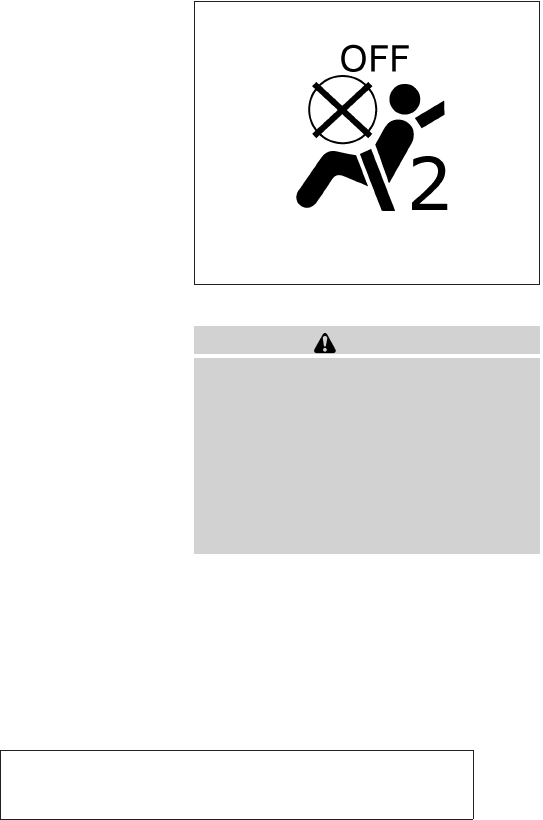
JOBNAME: 1093929-2013-asd-own PAGE: 62 SESS: 4 OUTPUT: Tue Mar 27 10:39:14 2012
crash, depending on the crash severity and
whether the front occupants are belted or un-
belted. Additionally, the front passenger air bag
may be automatically turned OFF under some
conditions, depending on the weight detected on
the passenger seat and how the seat belt is used.
If the front passenger air bag is OFF, the passen-
ger air bag status light will be illuminated (if the
seat is unoccupied, the light will not be illumi-
nated, but the air bag will be off). See “Front
passenger air bag and status light” later in this
section for further details. One front air bag inflat-
ing does not indicate improper performance of
the system.
If you have any questions about your air bag
system, please contact NISSAN or your NISSAN
dealer. If you are considering modification of your
vehicle due to a disability, you may also contact
NISSAN. Contact information is contained in the
front of this Owner’s Manual.
When a front air bag inflates, a fairly loud noise
may be heard, followed by the release of smoke.
This smoke is not harmful and does not indicate a
fire. Care should be taken to not inhale it, as it may
cause irritation and choking. Those with a history
of a breathing condition should get fresh air
promptly.
Front air bags, along with the use of seat belts,
help to cushion the impact force on the face and
chest of the front occupants. They can help save
lives and reduce serious injuries. However, an
inflating front air bag may cause facial abrasions
or other injuries. Front air bags do not provide
restraint to the lower body.
Even with NISSAN advanced air bags, seat belts
should be correctly worn and the driver and pas-
senger seated upright as far as practical away
from the steering wheel or instrument panel. The
front air bags inflate quickly in order to help
protect the front occupants. Because of this, the
force of the front air bag inflating can increase the
risk of injury if the occupant is too close to, or is
against, the front air bag module during inflation.
The front air bags deflate quickly after a collision.
The front air bags operate only when the
ignition switch is placed in the ON position.
After placing the ignition switch in the ON
position, the supplemental air bag warning
light illuminates. The supplemental air bag
warning light will turn off after about 7
seconds if the system is operational.
Front passenger air bag and status light
WARNING
The front passenger air bag is designed to
automatically turn OFF under some con-
ditions. Read this section carefully to
learn how it operates. Proper use of the
seat, seat belt and child restraints is nec-
essary for most effective protection. Fail-
ure to follow all instructions in this
manual concerning the use of seats, seat
belts and child restraints can increase the
risk or severity of injury in an accident.
WRS0475
1-46 Safety—Seats, seat belts and supplemental restraint system
ZREVIEW COPY—
2013 Altima Sedan (asd)
Owners Manual—USA_English (nna)
03/24/12—dmoore
X

JOBNAME: 1093929-2013-asd-own PAGE: 63 SESS: 4 OUTPUT: Tue Mar 27 10:39:14 2012
Status light
The front passenger air bag status light is
located near the climate controls. After the igni-
tion switch is placed in the 9ON9position, the
front passenger air bag status light on the instru-
ment panel illuminates for about 7 seconds and
then turns off or remains illuminated depending
on the front passenger seat occupied status. The
light operates as follows:
●Unoccupied passenger’s seat: The is
OFF and the front passenger air bag is OFF
and will not inflate in a crash.
●Passenger’s seat occupied by a small adult,
child or child restraint as outlined in this
section: The illuminates to indicate
that the front passenger air bag is OFF and
will not inflate in a crash.
●Occupied passenger seat and the passen-
ger meet the conditions outlined in this sec-
tion: The light is OFF to indicate that
the front passenger air bag is operational.
Front passenger air bag
The front passenger air bag is designed to auto-
matically turn OFF when the vehicle is operated
under some conditions as described below in
accordance with U.S. regulations. If the front
passenger air bag is OFF, it will not inflate in a
crash. The driver air bag and other air bags in your
vehicle are not part of this system.
The purpose of the regulation is to help reduce
the risk of injury or death from an inflating air bag
to certain front passenger seat occupants, such
as children, by requiring the air bag to be auto-
matically turned OFF. Certain sensors are used
to meet the requirements.
The occupant classification sensors (weight sen-
sors) are on the seat cushion frame under the
front passenger seat and are designed to detect
an occupant and objects on the seat. For ex-
ample, if a child is in the front passenger seat, the
Advanced Air Bag System is designed to turn the
passenger air bag OFF in accordance with the
regulations. Also, if a child restraint of the type
specified in the regulations is on the seat, the
occupant classification sensors can detect it and
cause the air bag to turn OFF.
The front passenger seat belt sensor is designed
to detect if the seat belt is buckled. Based on the
weight on the seat detected by the occupant
classification sensor and the buckle state, the
Advanced Air Bag System determines whether
the front passenger air bag should be automati-
cally turned OFF as required by the regulations.
Front passenger seat adult occupants who are
properly seated and using the seat belt as out-
lined in this manual should not cause the passen-
ger air bag to be automatically turned OFF. For
small adults it may be turned OFF, however if the
occupant takes his/her weight off the seat cush-
ion (for example, by not sitting upright, by sitting
on an edge of the seat, or by otherwise being out
of position), this could cause the sensor to turn
the air bag OFF. Always be sure to be seated and
wearing the seat belt properly for the most effec-
tive protection by the seat belt and supplemental
air bag.
NISSAN recommends that pre-teens and chil-
dren be properly restrained in a rear seat.
NISSAN also recommends that appropriate child
restraints and booster seats be properly installed
in a rear seat. If this is not possible, the occupant
classification sensor is designed to operate as
described above to turn the front passenger air
bag OFF for specified child restraints as required
by the regulations. Failing to properly secure
child restraints and to use the ALR mode may
allow the restraint to tip or move in an accident or
sudden stop. This can also result in the passen-
ger air bag inflating in a crash instead of being
OFF. See “Child restraints” earlier in this section
for proper use and installation.
If the front passenger seat is not occupied, the
passenger air bag is designed not to inflate in a
crash. However, heavy objects placed on the
seat could result in air bag inflation, because of
the object’s weight detected by the occupant
Safety—Seats, seat belts and supplemental restraint system 1-47
ZREVIEW COPY—
2013 Altima Sedan (asd)
Owners Manual—USA_English (nna)
03/24/12—dmoore
X

JOBNAME: 1093929-2013-asd-own PAGE: 64 SESS: 5 OUTPUT: Tue Mar 27 10:39:14 2012
classification sensor. Other conditions could also
result in air bag inflation, such as if a child is
standing on the seat, or if two children are on the
seat, contrary to the instructions in this manual.
Always be sure that you and all vehicle occupants
are seated and restrained properly.
Using the passenger air bag status light, you can
monitor when the front passenger air bag is au-
tomatically turned OFF with the seat occupied.
The light will not illuminate when the front pas-
senger seat is unoccupied.
If an adult occupant is in the seat but the passen-
ger air bag status light is illuminated (indicating
that the air bag is OFF), it could be that the
person is a small adult, or is not sitting on the seat
properly or not using the seat belt properly.
If a child restraint must be used in the front seat,
the passenger air bag status light may or may not
be illuminated, depending on the size of the child
and the type of child restraint being used. If the air
bag status light is not illuminated (indicating that
the air bag might inflate in a crash), it could be
that the child restraint or seat belt is not being
used properly. Make sure that the child restraint is
installed properly, the seat belt is used properly
and the occupant is positioned properly. If the air
bag status light is not illuminated, reposition the
occupant or child restraint in a rear seat.
If the passenger air bag status light will not illu-
minate even though you believe that the child
restraint, the seat belts and the occupant are
properly positioned, the system may be sensing
an unoccupied seat (in which case the air bag is
OFF). Your NISSAN dealer can check that the
system is OFF by using a special tool. However,
until you have confirmed with your dealer that
your air bag is working properly, reposition the
occupant or child restraint in a rear seat.
The NISSAN Advanced Air Bag System and
passenger air bag status light will take a few
seconds to register a change in the passenger
seat status. For example, if a large adult who is
sitting in the front passenger seat exits the ve-
hicle, the passenger air bag status light will go
from OFF to ON for a few seconds and then to
OFF. This is normal system operation and does
not indicate a malfunction.
If a malfunction occurs in the front passenger air
bag system, the supplemental air bag warning
light , located in the meter and gauges area
of the instrument panel, will blink. Have the sys-
tem checked by a NISSAN dealer.
Other supplemental front-impact air bag
precautions
WARNING
●Do not place any objects on the steer-
ing wheel pad or on the instrument
panel. Also, do not place any objects
between any occupant and the steering
wheel or instrument panel. Such ob-
jects may become dangerous projec-
tiles and cause injury if the front air
bags inflate.
●Do not place objects with sharp edges
on the seat. Also, do not place heavy
objects on the seat that will leave per-
manent impressions in the seat. Such
objects can damage the seat or occu-
pant classification sensors (weight sen-
sors). This can affect the operation of
the air bag system and result in serious
personal injury.
●Do not use water or acidic cleaners (hot
steam cleaners) on the seat. This can
damage the seat or occupant classifica-
tion sensors. This can also affect the
operation of the air bag system and
result in serious personal injury.
1-48 Safety—Seats, seat belts and supplemental restraint system
ZREVIEW COPY—
2013 Altima Sedan (asd)
Owners Manual—USA_English (nna)
03/27/12—dmoore
X

JOBNAME: 1093929-2013-asd-own PAGE: 65 SESS: 5 OUTPUT: Tue Mar 27 10:39:14 2012
●Immediately after inflation, several
front air bag system components will be
hot. Do not touch them; you may se-
verely burn yourself.
●No unauthorized changes should be
made to any components or wiring of
the supplemental air bag system. This is
to prevent accidental inflation of the
supplemental air bag or damage to the
supplemental air bag system.
●Do not make unauthorized changes to
your vehicle’s electrical system, sus-
pension system or front end structure.
This could affect proper operation of
the front air bag system.
●Tampering with the front air bag system
may result in serious personal injury.
Tampering includes changes to the
steering wheel and the instrument
panel assembly by placing material
over the steering wheel pad and above
the instrument panel or by installing
additional trim material around the air
bag system.
●Removing or modifying the front pas-
senger seat may affect the function of
the air bag and result in serious per-
sonal injury.
●Modifying or tampering with the front
passenger seat may result in serious
personal injury. For example, do not
change the front seats by placing mate-
rial on the seat cushion or by installing
additional trim material, such as seat
covers, on the seat that are not specifi-
cally designed to assure proper air bag
operation. Additionally, do not stow any
objects under the front passenger seat
or the seat cushion and seatback. Such
objects may interfere with the proper
operation of the occupant classifica-
tion sensor (weight sensor).
●No unauthorized changes should be
made to any components or wiring of
the seat belt system. This may affect the
front air bag system. Tampering with
the seat belt system may result in seri-
ous personal injury.
●Work on and around the front air bag
system should be done by a NISSAN
dealer. Installation of electrical equip-
ment should also be done by a NISSAN
dealer. The Supplemental Restraint
System (SRS) wiring harnesses* should
not be modified or disconnected. Unau-
thorized electrical test equipment and
probing devices should not be used on
the air bag system.
●A cracked windshield should be re-
placed immediately by a qualified re-
pair facility. A cracked windshield could
affect the function of the supplemental
air bag system.
*The SRS wiring harness connectors are
yellow and orange for easy identification.
When selling your vehicle, we request that you
inform the buyer about the front air bag system
and guide the buyer to the appropriate sections
in this Owner’s Manual.
Safety—Seats, seat belts and supplemental restraint system 1-49
ZREVIEW COPY—
2013 Altima Sedan (asd)
Owners Manual—USA_English (nna)
03/27/12—dmoore
X
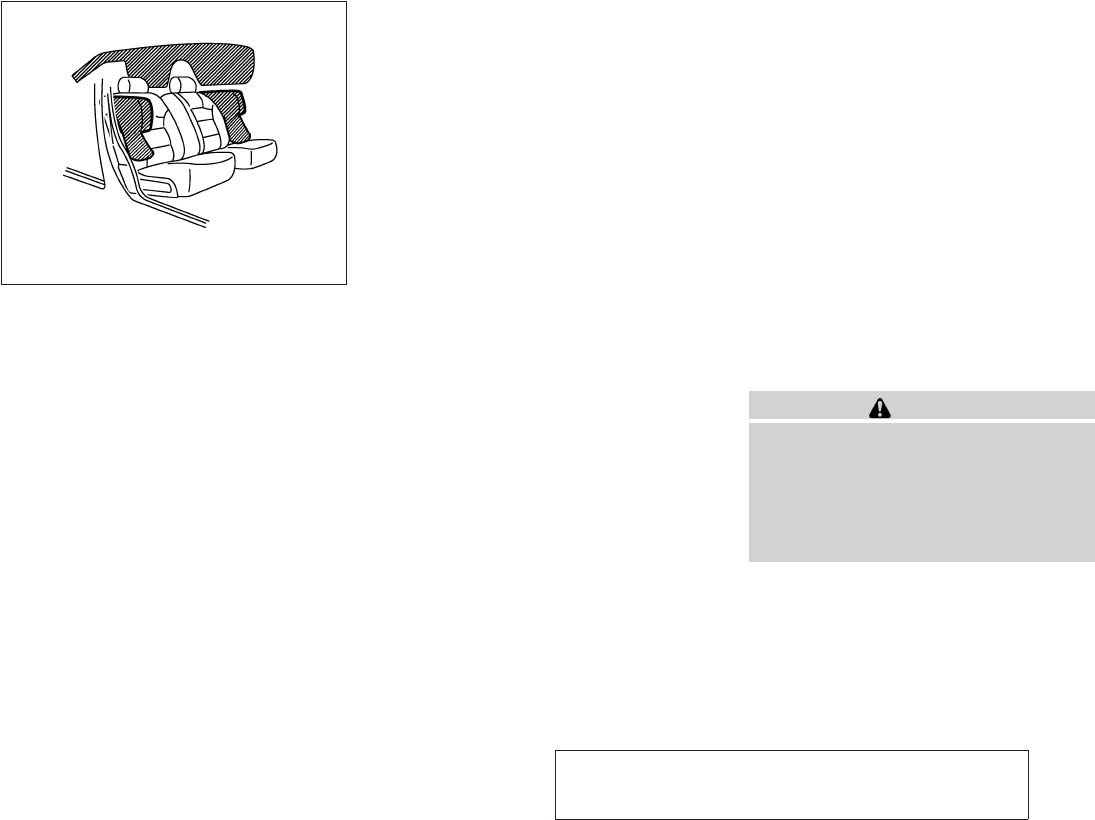
JOBNAME: 1093929-2013-asd-own PAGE: 66 SESS: 4 OUTPUT: Tue Mar 27 10:39:14 2012
FRONT SEAT-MOUNTED SIDE-
IMPACT SUPPLEMENTAL AIR BAG
AND ROOF-MOUNTED CURTAIN
SIDE-IMPACT SUPPLEMENTAL AIR
BAG SYSTEMS
The side air bags are located in the outside of the
seatback of the front seats. The curtain air bags
are located in the side roof rails. These systems
are designed to meet voluntary guidelines to help
reduce the risk of injury to out-of-position occu-
pants. However, all of the information, cau-
tions and warnings in this manual still ap-
ply and must be followed. The side air bags
and curtain air bags are designed to inflate in
higher severity side collisions, although they may
inflate if the forces in another type of collision are
similar to those of a higher severity side impact.
They are designed to inflate on the side where the
vehicle is impacted. They may not inflate in cer-
tain side collisions.
Vehicle damage (or lack of it) is not always an
indication of proper side air bag and curtain air
bag operation.
When the side air bags and curtain air bags
inflate, a fairly loud noise may be heard, followed
by the release of smoke. This smoke is not harm-
ful and does not indicate a fire. Care should be
taken not to inhale it, as it may cause irritation and
choking. Those with a history of a breathing con-
dition should get fresh air promptly.
Side air bags, along with the use of seat belts,
help to cushion the impact force on the chest and
pelvic area of the front occupants. Curtain air
bags help to cushion the impact force to the head
of occupants in the front and rear outboard seat-
ing positions. They can help save lives and re-
duce serious injuries. However, an inflating side
air bag and curtain air bag may cause abrasions
or other injuries. Side air bags and curtain air
bags do not provide restraint to the lower body.
The seat belts should be correctly worn and the
driver and passenger seated upright as far as
practical away from the side air bag. Rear seat
passengers should be seated as far away as
practical from the door finishers and side roof
rails. The side air bags and curtain air bags inflate
quickly in order to help protect the occupants.
Because of this, the force of the side air bag and
curtain air bag inflating can increase the risk of
injury if the occupant is too close to, or is against,
these air bag modules during inflation. The side
air bags and curtain air bag will deflate quickly
after the collision is over.
The side air bags and curtain air bags op-
erate only when the ignition switch is
placed in the ON position.
After placing the ignition switch in the ON
position, the supplemental air bag warning
light illuminates. The supplemental air bag
warning light will turn off after about 7
seconds if the system is operational.
WARNING
●Do not place any objects near the seat-
back of the front seats. Also, do not
place any objects (an umbrella, bag,
etc.) between the front door finisher
and the front seat. Such objects may
become dangerous projectiles and
cause injury if a side air bag inflates.
LRS0259
1-50 Safety—Seats, seat belts and supplemental restraint system
ZREVIEW COPY—
2013 Altima Sedan (asd)
Owners Manual—USA_English (nna)
03/24/12—dmoore
X
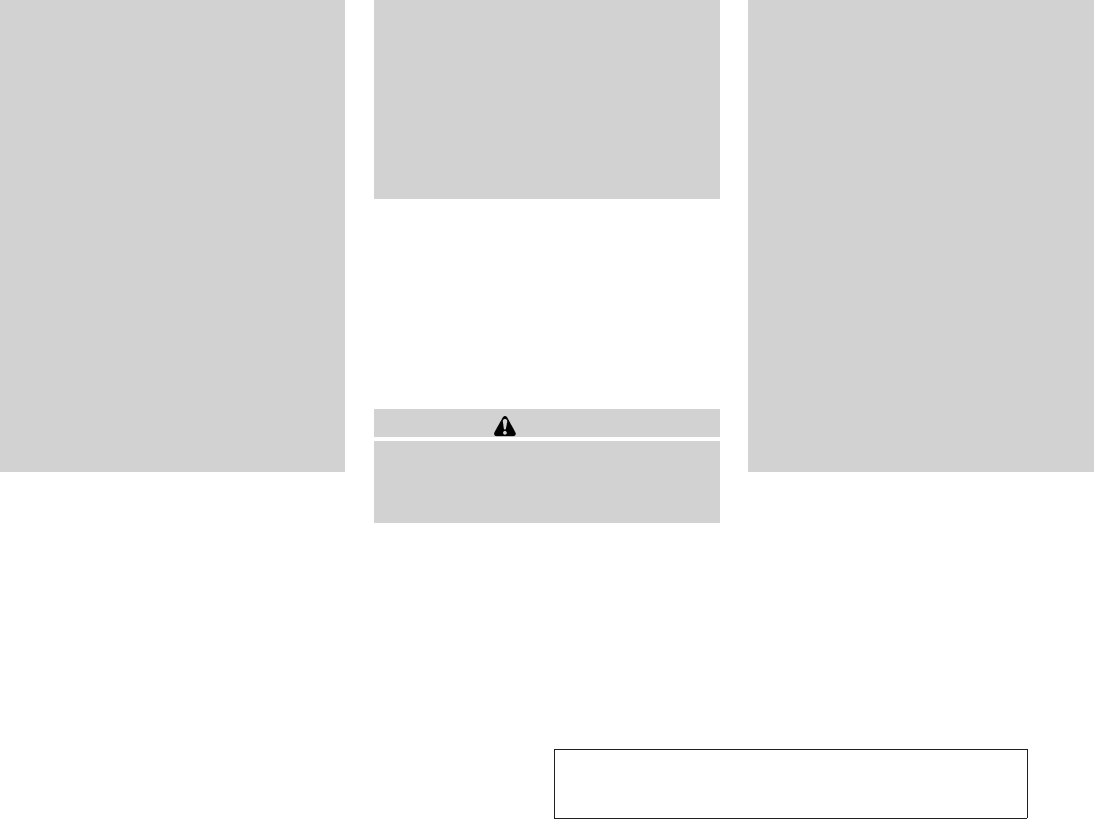
JOBNAME: 1093929-2013-asd-own PAGE: 67 SESS: 4 OUTPUT: Tue Mar 27 10:39:14 2012
●Right after inflation, several side air bag
and curtain air bag system components
will be hot. Do not touch them; you may
severely burn yourself.
●No unauthorized changes should be
made to any components or wiring of
the side air bag and curtain air bag
systems. This is to prevent damage to or
accidental inflation of the side air bag
and curtain air bag or damage to the
side air bag and curtain air bag systems.
●Do not make unauthorized changes to
your vehicle’s electrical system, sus-
pension system or side panel. This
could affect proper operation of the
side air bag and curtain air bag systems.
●Tampering with the side air bag system
may result in serious personal injury.
For example, do not change the front
seats by placing material near the seat-
backs or by installing additional trim
material, such as seat covers, around
the side air bag.
●Work around and on the side air bag
and curtain air bag system should be
done by a NISSAN dealer. Installation
of electrical equipment should also be
done by a NISSAN dealer. The SRS wir-
ing harnesses* should not be modified
or disconnected. Unauthorized electri-
cal test equipment and probing devices
should not be used on the side air bag
or curtain air bag system.
* The SRS wiring harness connectors are
yellow and orange for easy identification.
When selling your vehicle, we request that you
inform the buyer about the side air bag and
curtain air bag systems and guide the buyer to
the appropriate sections in this Owner’s Manual.
SEAT BELTS WITH
PRETENSIONERS (Front seats)
WARNING
●The pretensioners cannot be reused af-
ter activation. They must be replaced
together with the retractor and buckle
as a unit.
●If the vehicle becomes involved in a
collision but a pretensioner is not acti-
vated, be sure to have the pretensioner
system checked and, if necessary, re-
placed by your NISSAN dealer.
●No unauthorized changes should be
made to any components or wiring of
the pretensioner system. This is to pre-
vent damage to or accidental activation
of the pretensioners. Tampering with
the pretensioner system may result in
serious personal injury.
●Work around and on the pretensioner
system should be done by a NISSAN
dealer. Installation of electrical equip-
ment should also be done by a NISSAN
dealer. Unauthorized electrical test
equipment and probing devices should
not be used on the pretensioner system.
●If you need to dispose of a pretensioner
or scrap the vehicle, contact a NISSAN
dealer. Incorrect disposal procedures
could cause personal injury.
Working with the seat belt retractor, the preten-
sioners help tighten the seat belt when the ve-
hicle becomes involved in certain types of colli-
sions, helping to restrain front seat occupants.
Safety—Seats, seat belts and supplemental restraint system 1-51
ZREVIEW COPY—
2013 Altima Sedan (asd)
Owners Manual—USA_English (nna)
03/24/12—dmoore
X
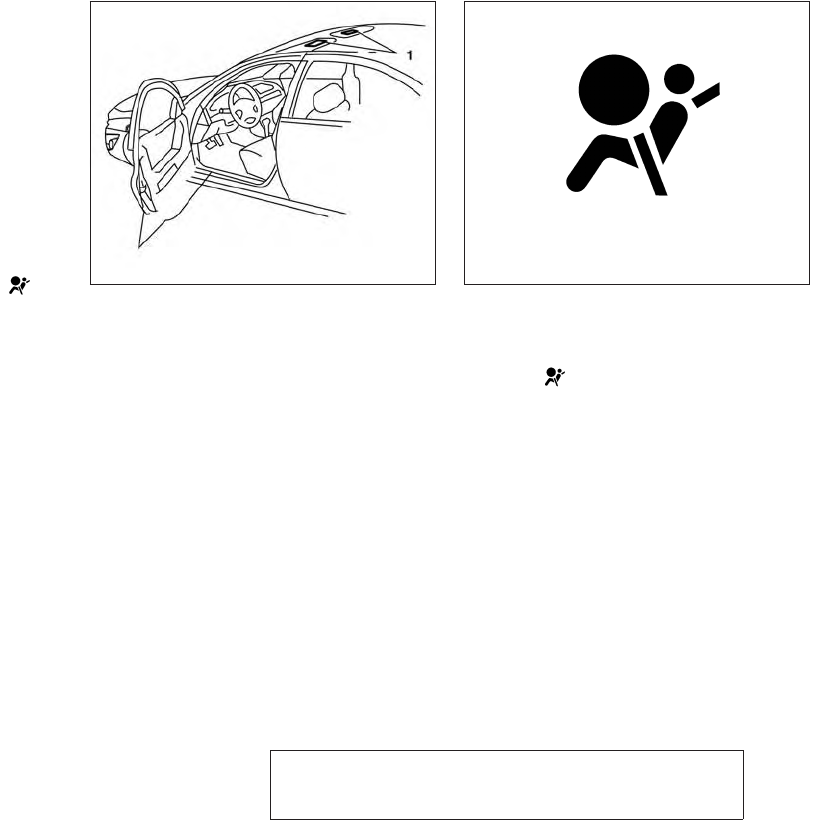
JOBNAME: 1093929-2013-asd-own PAGE: 68 SESS: 4 OUTPUT: Tue Mar 27 10:39:14 2012
The pretensioners are part of the seat belt retrac-
tor assembly . These seat belts are used the
same way as conventional seat belts.
When a pretensioner activates, smoke is re-
leased and a loud noise may be heard. This
smoke is not harmful and does not indicate a fire.
Care should be taken not to inhale it, as it may
cause irritation and choking. Those with a history
of a breathing condition should get fresh air
promptly.
After pretensioner activation, load limiters allow
the seat belt to release webbing (if necessary) to
reduce forces against the chest.
The supplemental air bag warning light is
used to indicate malfunctions in the pretensioner
system. (See 9SUPPLEMENTAL AIR BAG
WARNING LIGHT9in this section for more de-
tails.) If the operation of the supplemental air bag
warning light indicates there is a malfunction,
have the system checked by a NISSAN dealer.
When selling your vehicle, we request that you
inform the buyer about the pretensioner system
and guide the buyer to the appropriate sections
in this Owner’s Manual.
1. SRS air bag warning labels (located on
the sun visors)
SUPPLEMENTAL AIR BAG
WARNING LABELS
Warning labels about the supplemental front-
impact air bag system are placed in the vehicle as
shown in the illustration.
SUPPLEMENTAL AIR BAG
WARNING LIGHT
The supplemental air bag warning light,
displaying in the instrument panel, moni-
tors the circuits for the air bag systems, preten-
sioners and all related wiring.
When the ignition is placed in the ON or START
position, the supplemental air bag warning light
illuminates for about 7 seconds and then turns
off. This means the system is operational.
LRS2163 LRS0100
1-52 Safety—Seats, seat belts and supplemental restraint system
ZREVIEW COPY—
2013 Altima Sedan (asd)
Owners Manual—USA_English (nna)
03/24/12—dmoore
X

JOBNAME: 1093929-2013-asd-own PAGE: 69 SESS: 4 OUTPUT: Tue Mar 27 10:39:14 2012
If any of the following conditions occur, the front
air bag, side air bag and curtain air bag and
pretensioner systems need servicing:
●The supplemental air bag warning light re-
mains on after approximately 7 seconds.
●The supplemental air bag warning light
flashes intermittently.
●The supplemental air bag warning light does
not come on at all.
Under these conditions, the front air bag, side air
bag and curtain air bag or pretensioner systems
may not operate properly. They must be checked
and repaired. Take your vehicle to the nearest
NISSAN dealer.
WARNING
If the supplemental air bag warning light
is on, it could mean that the front air bag,
side air bag, curtain air bag and/or preten-
sioner systems will not operate in an ac-
cident. To help avoid injury to yourself or
others, have your vehicle checked by a
NISSAN dealer as soon as possible.
Repair and replacement procedure
The front air bags, side air bags, curtain air bags
and pretensioners are designed to inflate on a
one-time-only basis. As a reminder, unless it is
damaged, the supplemental air bag warning light
remains illuminated after inflation has occurred.
Repair and replacement of these supplemental
air bag systems should be done only by a
NISSAN dealer.
When maintenance work is required on the ve-
hicle, the front air bags, side air bags, curtain air
bags, pretensioners and related parts should be
pointed out to the person performing the mainte-
nance. The ignition should always be in the LOCK
position when working under the hood or inside
the vehicle.
WARNING
●Once a front air bag, side air bag, or
curtain air bag has inflated, the air bag
module will not function again and
must be replaced. Additionally, the ac-
tivated pretensioners must also be re-
placed. The air bag module and preten-
sioners should be replaced by a
NISSAN dealer. The air bag module and
pretensioners cannot be repaired.
●The front air bag, side air bag, curtain
air bag systems and the pretensioner
system should be inspected by a
NISSAN dealer if there is any damage to
the front end or side portion of the
vehicle.
●If you need to dispose of a supplemen-
tal air bag or pretensioners or scrap the
vehicle, contact a NISSAN dealer. Incor-
rect disposal procedures could cause
personal injury.
Safety—Seats, seat belts and supplemental restraint system 1-53
ZREVIEW COPY—
2013 Altima Sedan (asd)
Owners Manual—USA_English (nna)
03/24/12—dmoore
X

JOBNAME: 1093929-2013-asd-own PAGE: 70 SESS: 5 OUTPUT: Tue Mar 27 10:39:14 2012
2 Instruments and controls
Instrumentpanel...................................2-2
Metersandgauges................................2-3
Speedometer and odometer . . . . . . . . . . . . . . . . . . . . . 2-4
Tachometer....................................2-4
Engine coolant temperature gauge . . . . . . . . . . . . . . . 2-5
Fuelgauge ....................................2-5
Compass display (if so equipped) . . . . . . . . . . . . . . . . . . . 2-6
Compassdisplay...............................2-7
Warning/indicator lights and audible reminders . . . . . . 2-10
Checkingbulbs ...............................2-10
Warninglights ................................2-10
Indicatorlights................................2-14
Audiblereminders.............................2-16
Vehicle Information Display . . . . . . . . . . . . . . . . . . . . . . . .2-16
How to use the vehicle information display . . . . . . .2-17
Startupdisplay................................2-17
Settings......................................2-17
Vehicle information display warnings and
indicators.....................................2-23
Securitysystems.................................2-26
Vehicle security system. . . . . . . . . . . . . . . . . . . . . . . . .2-26
NISSAN vehicle immobilizer system . . . . . . . . . . . . .2-27
Windshield wiper and washer switch . . . . . . . . . . . . . . . 2-28
Switchoperation..............................2-28
Rear window and outside mirror (if so equipped)
defroster switch . . . . . . . . . . . . . . . . . . . . . . . . . . . . . . . . . .2-29
Headlight and turn signal switch. . . . . . . . . . . . . . . . . . . .2-30
Xenon headlights (if so equipped) . . . . . . . . . . . . . . .2-30
Headlight control switch. . . . . . . . . . . . . . . . . . . . . . . . 2-30
Daytime running light system (Canada only) . . . . . .2-33
Instrument brightness control . . . . . . . . . . . . . . . . . . .2-34
Turnsignalswitch .............................2-34
Fog light switch (if so equipped) . . . . . . . . . . . . . . . . 2-34
Hazard warning flasher switch . . . . . . . . . . . . . . . . . . . . .2-35
Horn . . . . . . . . . . . . . . . . . . . . . . . . . . . . . . . . . . . . . . . . . . . .2-35
Heated seats (if so equipped). . . . . . . . . . . . . . . . . . . . . .2-36
Heated steering wheel (if so equipped) . . . . . . . . . . . . .2-37
Vehicle Dynamic Control (VDC) off switch. . . . . . . . . . . 2-37
Power outlet . . . . . . . . . . . . . . . . . . . . . . . . . . . . . . . . . . . . .2-38
Storage . . . . . . . . . . . . . . . . . . . . . . . . . . . . . . . . . . . . . . . . . 2-39
Mappockets..................................2-39
Seatback pockets (if so equipped) . . . . . . . . . . . . . .2-39
Sunglassesholder.............................2-39
Cupholders ..................................2-40
Glovebox ....................................2-41
Consolebox..................................2-41
ZREVIEW COPY—
2013 Altima Sedan (asd)
Owners Manual—USA_English (nna)
03/24/12—dmoore
X

JOBNAME: 1093929-2013-asd-own PAGE: 71 SESS: 5 OUTPUT: Tue Mar 27 10:39:14 2012
Groceryhooks................................2-42
Windows........................................2-42
Powerwindows...............................2-42
Moonroof (if so equipped) . . . . . . . . . . . . . . . . . . . . . . . . . 2-45
Automaticmoonroof...........................2-45
Interiorlight......................................2-47
Console light (if so equipped). . . . . . . . . . . . . . . . . . . 2-47
PersonalLights...................................2-48
Maplights.......................................2-48
Trunklight.......................................2-49
HomeLinkTuniversal transceiver (if so equipped). . . . .2-49
Programming HomeLinkT.......................2-50
Programming HomeLinkTfor Canadian
customers and gate openers. . . . . . . . . . . . . . . . . . . .2-51
Operating the HomeLinkTuniversal
transceiver. . . . . . . . . . . . . . . . . . . . . . . . . . . . . . . . . . . .2-51
Programming trouble-diagnosis . . . . . . . . . . . . . . . . . 2-52
Clearing the programmed information . . . . . . . . . . . . 2-52
Reprogramming a single HomeLinkTbutton . . . . . .2-52
If your vehicle is stolen . . . . . . . . . . . . . . . . . . . . . . . . .2-52
ZREVIEW COPY—
2013 Altima Sedan (asd)
Owners Manual—USA_English (nna)
03/24/12—dmoore
X
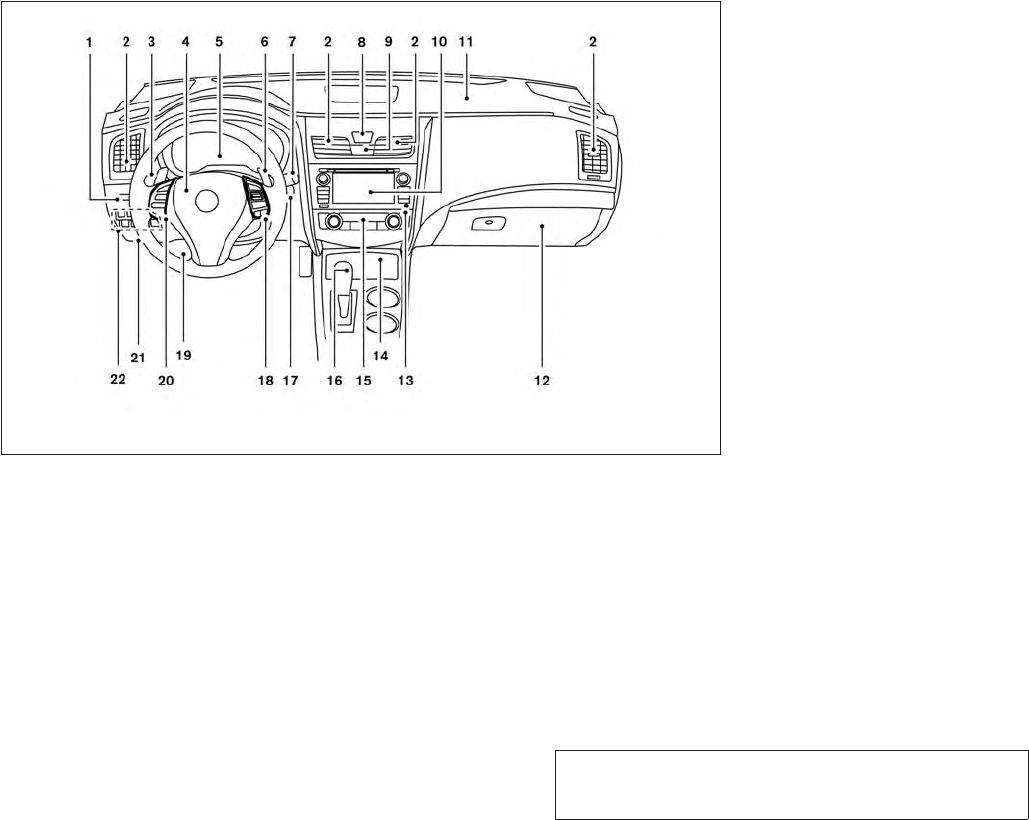
JOBNAME: 1093929-2013-asd-own PAGE: 72 SESS: 5 OUTPUT: Tue Mar 27 10:39:14 2012
1. Instrument brightness control/Trip com-
puter reset switch (P. 2-34, P. 2-4)
2. Vents (P. 4-18)
3. Headlight/fog light (if so equipped)/turn
signal switch (P. 2-30)
4. Driver supplemental air bag/horn
(P. 1-37, P. 2-35)
5. Meters and gauges (P. 2-3)
6. Paddle shift controls (if so equipped)
(P. 5-15)
7. Windshield wiper/washer switch
(P. 2-28)
8. Hazard warning flasher switch (P. 2-35)
9. Front passenger air bag status light
(P. 1-45)
10. Audio system controls/Navigation
system* (P. 4-30)
11. Front passenger supplemental air bag
(P. 1-37)
12. Glove box (P. 2-41)
13. Aux jack (P. 4-41, 4-47, 4-54)
14. Power outlet/USB port (P.2-38, 4-54,
4-56)
15. Heater and air conditioner (manual or
automatic) (P. 4-19, P. 4-27)
16. Shift selector (P. 5-13)
17. Push-button ignition switch (P. 5-8)
18. Cruise control main/set switch/
BluetoothTHands-free Phone System
(P.5-19 / P. 4-96, P. 4-70, P. 4-85 )
19. Tilt/telescopic steering wheel controls
(P. 3-32)
20. Steering wheel switch for audio control
/Vehicle information display controls
( P. 4-68, P. 2-17)
21. Fuel filler door release/Hood release)
(P. 3-30, P. 3-27)
LIC2369
INSTRUMENT PANEL
2-2 Instruments and controls
ZREVIEW COPY—
2013 Altima Sedan (asd)
Owners Manual—USA_English (nna)
03/24/12—dmoore
X
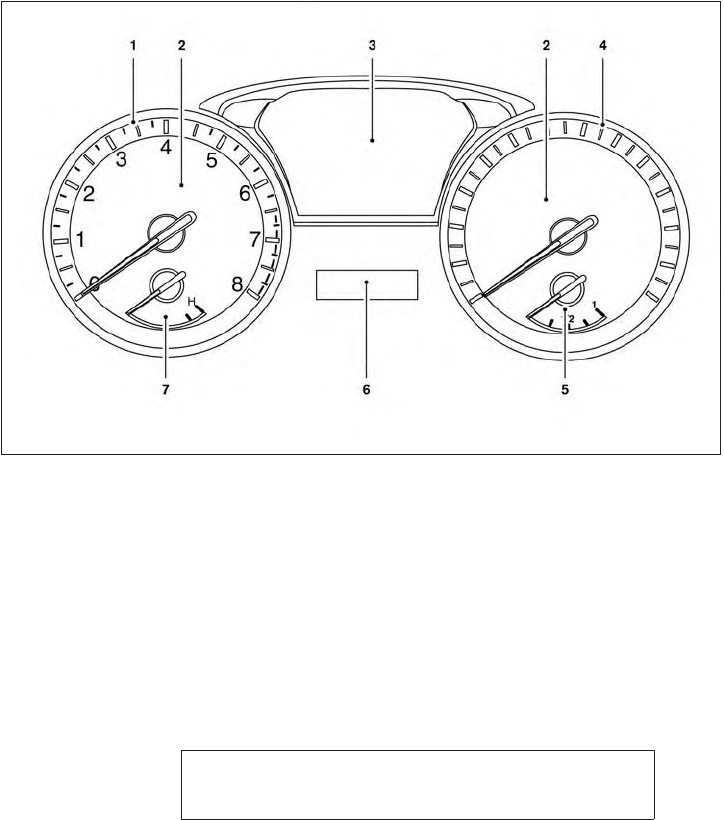
JOBNAME: 1093929-2013-asd-own PAGE: 73 SESS: 5 OUTPUT: Tue Mar 27 10:39:14 2012
22. Vehicle Dynamic Control OFF switch
(P. 2-37)
Trunk opener (P. 3-27)
Heated steering wheel switch
(if so equipped) (P. 2-37)
* Refer to the Navigation System Owner’s manual
(if so equipped)
See the page number indicated in paren-
theses for operating details.
1. Tachometer
2. Warning/indicator lights
3. Vehicle Information Display
4. Speedometer
5. Fuel gauge
6. Odometer/Twin trip odometer
7. Engine coolant temperature gauge
LIC2254
METERS AND GAUGES
Instruments and controls 2-3
ZREVIEW COPY—
2013 Altima Sedan (asd)
Owners Manual—USA_English (nna)
03/24/12—dmoore
X
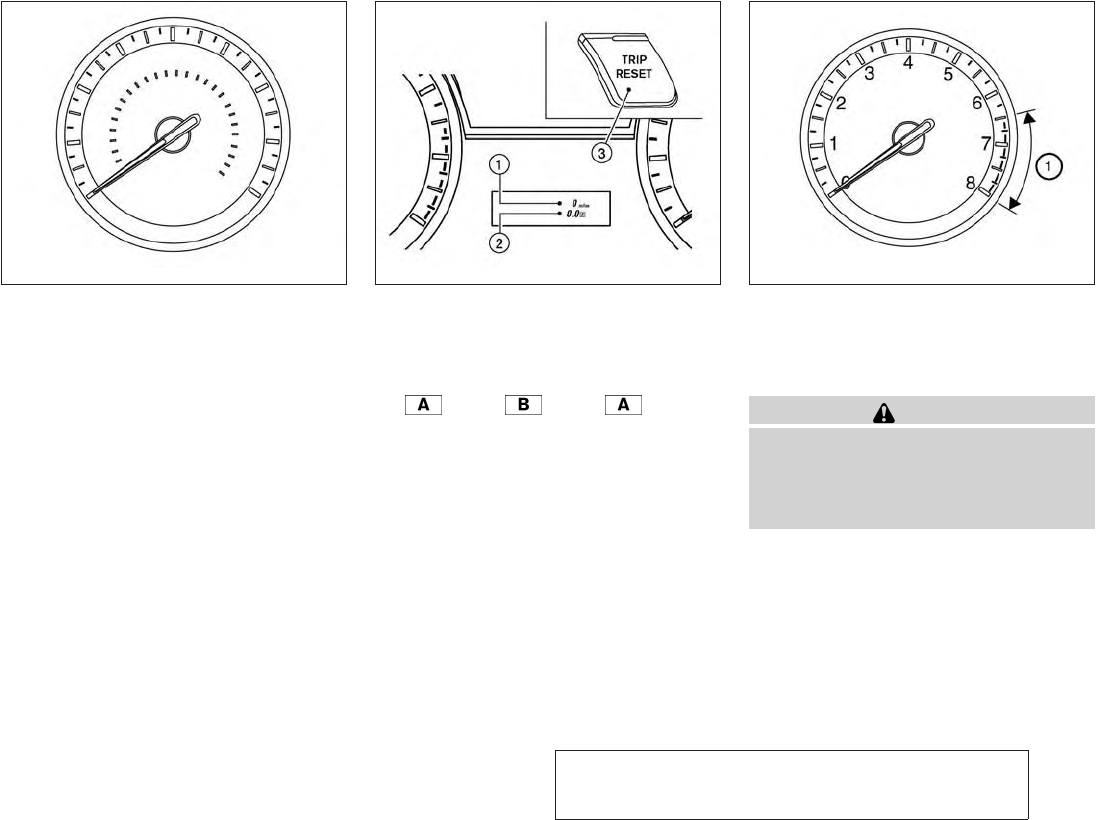
JOBNAME: 1093929-2013-asd-own PAGE: 74 SESS: 4 OUTPUT: Tue Mar 27 10:39:14 2012
SPEEDOMETER AND ODOMETER
Speedometer
The speedometer indicates vehicle speed.
Odometer/Twin trip odometer
The odometer s
1and the twin trip odometer s
2
are displayed below the Vehicle Information Dis-
play when the ignition switch is placed in the ON
position.
The odometer records the total distance the ve-
hicle has been driven.
The twin trip odometer records the distance of
individual trips.
Changing the display:
Pushing the TRIP RESET s
3switch on the left of
the instrument panel to change the display as
follows:
Trip →Trip →Trip
Resetting the trip odometer:
Pushing the TRIP RESET switch s
3for more
than 1 second resets the currently displayed trip
odometer to zero.
Average fuel economy and distance to empty
information is also available. See “Vehicle Infor-
mation Display” in this section.
TACHOMETER
The tachometer indicates engine speed in revo-
lutions per minute (rpm). Do not rev engine into
the red zone s
1.
CAUTION
When engine speed approaches the red
zone, shift to a higher gear or reduce en-
gine speed. Operating the engine in the
red zone may cause serious engine
damage.
LIC2218 LIC2234 LIC2219
2-4 Instruments and controls
ZREVIEW COPY—
2013 Altima Sedan (asd)
Owners Manual—USA_English (nna)
03/24/12—dmoore
X
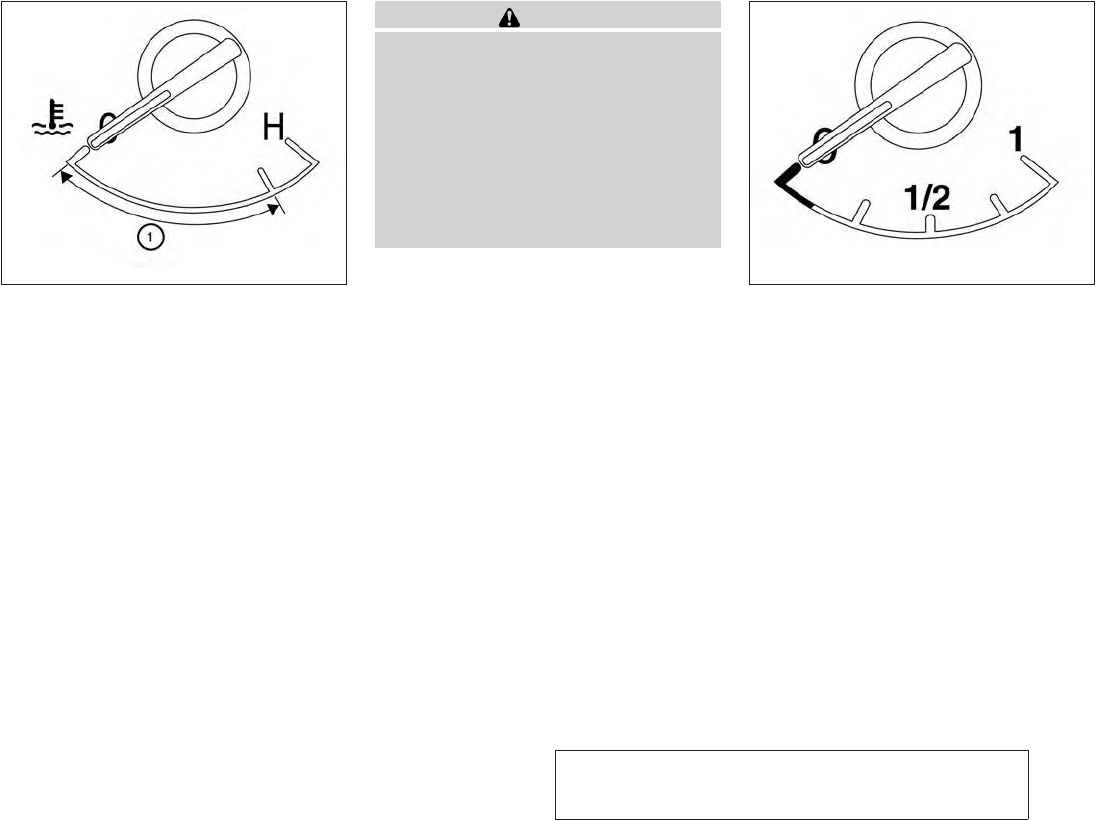
JOBNAME: 1093929-2013-asd-own PAGE: 75 SESS: 4 OUTPUT: Tue Mar 27 10:39:14 2012
ENGINE COOLANT TEMPERATURE
GAUGE
The gauge indicates the engine coolant tempera-
ture. The engine coolant temperature is within the
normal range s
1when the gauge needle points
within the zone shown in the illustration.
The engine coolant temperature varies with the
outside air temperature and driving conditions.
CAUTION
If the gauge indicates coolant tempera-
ture near the hot (H) end of the normal
range, reduce vehicle speed to decrease
temperature. If the gauge is over the nor-
mal range, stop the vehicle as soon as
safely possible. If the engine is over-
heated, continued operation of the ve-
hicle may seriously damage the engine.
See “If your vehicle overheats” in the “In
case of emergency”section for immediate
action required.
FUEL GAUGE
The gauge indicates the approximate fuel level
in the tank.
The gauge may move slightly during braking,
turning, acceleration, or going up or down hills.
The gauge needle returns to 0 (Empty) after the
ignition switch is placed in the OFF position.
The low fuel warning light comes on when the
amount of fuel in the tank is getting low.
Refill the fuel tank before the gauge regis-
ters 0 (Empty).
LIC2220 LIC2222
Instruments and controls 2-5
ZREVIEW COPY—
2013 Altima Sedan (asd)
Owners Manual—USA_English (nna)
03/24/12—dmoore
X
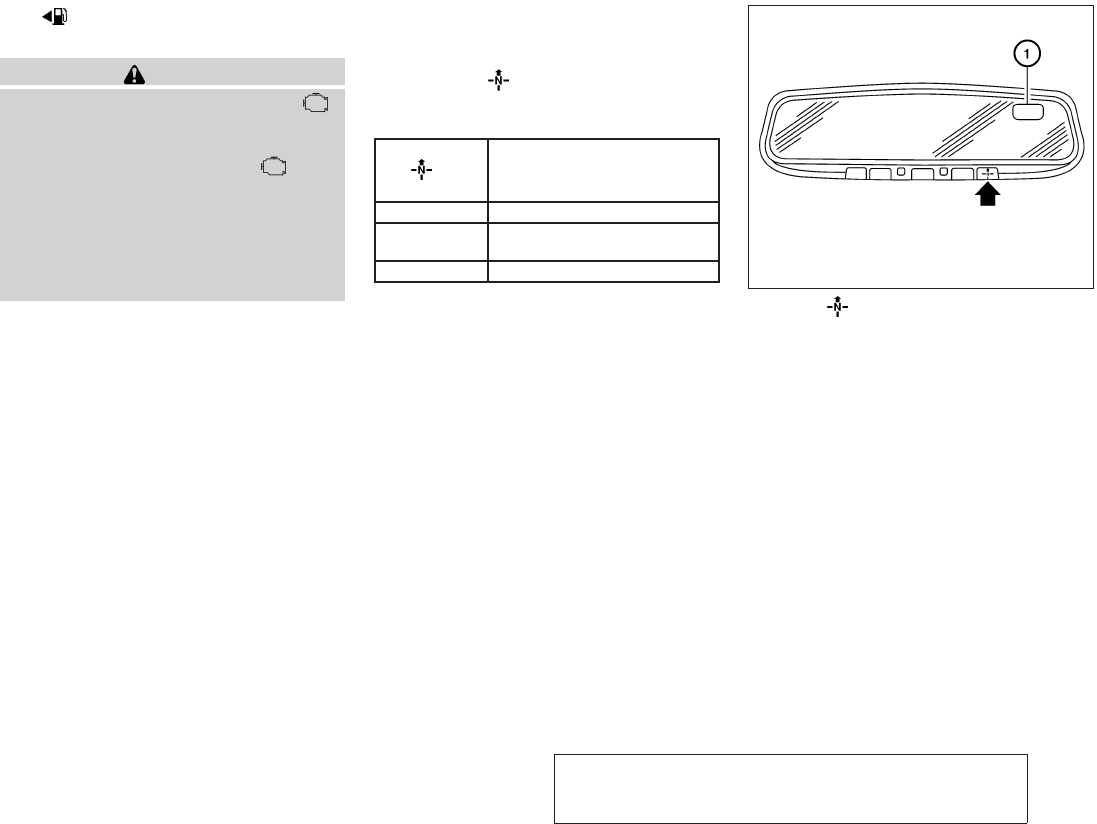
JOBNAME: 1093929-2013-asd-own PAGE: 76 SESS: 4 OUTPUT: Tue Mar 27 10:39:14 2012
The indicates that the fuel-filler door is
located on the driver’s side of the vehicle.
CAUTION
●If the vehicle runs out of fuel, the
Malfunction Indicator Light (MIL) may
come on. Refuel as soon as possible.
After a few driving trips. the light
should turn off. If the light remains on
after a few driving trips, have the ve-
hicle inspected by a NISSAN dealer.
●For additional information, see “Mal-
function Indicator Light (MIL)” later in
this section.
This unit measures terrestrial magnetism and in-
dicates the direction of the vehicle’s heading.
With the ignition switch placed in the ON posi-
tion, press the button as described in the
chart below to activate various features of the
automatic anti-glare rearview mirror.
Push and hold
the
button for about:
Feature:
(Push button again for about 1 sec-
ond to change settings)
1 second Compass display toggles on/off
5 seconds Compass zone can be changed to
correct false compass readings
9 seconds Compass enters calibration mode
For information about the automatic anti-glare
feature, refer to “Automatic anti-glare rearview
mirror” in the “Pre-driving checks and adjust-
ments” section.
Press the button for about 1 second when
the ignition switch is placed in the ON position to
toggle the compass display s
1on or off. The
display will indicate the direction of the vehicle’s
heading.
N: North
E: East
S: South
W: West
If the display reads “C”, calibrate the compass by
driving the vehicle in three complete circles at
less than 5 MPH (8 km/h).
LIC1487
COMPASS DISPLAY (if so equipped)
2-6 Instruments and controls
ZREVIEW COPY—
2013 Altima Sedan (asd)
Owners Manual—USA_English (nna)
03/24/12—dmoore
X

JOBNAME: 1093929-2013-asd-own PAGE: 77 SESS: 4 OUTPUT: Tue Mar 27 10:39:14 2012
You can also calibrate the compass by driving
your vehicle on your everyday route. The com-
pass will be calibrated once it has tracked three
complete circles.
COMPASS DISPLAY
Press the button when the ignition switch
is placed in the ON position. The direction will be
displayed.
Zone variation change procedure
The difference between magnetic north and geo-
graphical north is known as variance. In some
areas, this difference can sometimes be great
enough to cause false compass readings. Follow
these instructions to set the variance for your
particular location if this happens:
1. Establish your location on the zone map.
Refer to the illustration. Record your zone
number.
2. Place the ignition switch in the ON position.
3. Press the button in for 5 seconds until
the current zone entry number is displayed.
4. Press the button repeatedly until the
desired zone entry number is displayed.
Once the desired zone number is displayed, stop
pressing the button and the display will
show compass direction within a few seconds.
NOTE:
Use zone number 5 for Hawaii.
Instruments and controls 2-7
ZREVIEW COPY—
2013 Altima Sedan (asd)
Owners Manual—USA_English (nna)
03/24/12—dmoore
X
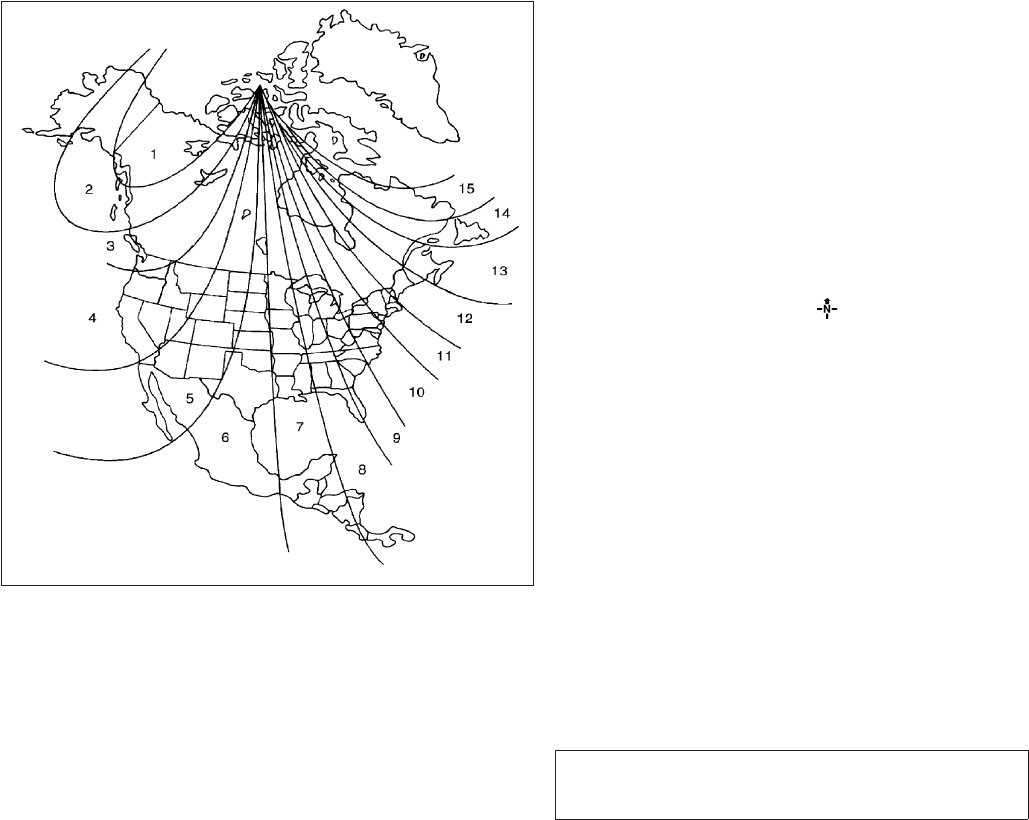
JOBNAME: 1093929-2013-asd-own PAGE: 78 SESS: 4 OUTPUT: Tue Mar 27 10:39:14 2012
●If a magnet is located near the com-
pass or the vehicle is driven where the
terrestrial magnetism is disturbed, the
compass display may not indicate the
correct direction.
●In places where the terrestrial magne-
tism is disturbed, the correction of the
direction starts automatically.
Inaccurate compass direction:
The compass display is equipped with automatic
correction function. If the correct direction is not
shown, follow this procedure.
1. With the display turned on, press and hold
the switch for about 9 seconds. The
display will read “C.”
2. Calibrate the compass by driving the vehicle
in three complete circles at a maximum
speed of 5 MPH (8 km/h).
3. After completing the circles the display
should return to normal.
●If the compass deviates from the correct
indication soon after repeated adjustment,
have the compass checked at an authorized
NISSAN dealer.
WIC0355
2-8 Instruments and controls
ZREVIEW COPY—
2013 Altima Sedan (asd)
Owners Manual—USA_English (nna)
03/24/12—dmoore
X

JOBNAME: 1093929-2013-asd-own PAGE: 79 SESS: 4 OUTPUT: Tue Mar 27 10:39:14 2012
●The compass may not indicate the correct
compass point in tunnels or while driving up
or down a steep hill. (The compass returns
to the correct compass point when the ve-
hicle moves to an area where the geomag-
netism is stabilized.)
CAUTION
●Do not install a ski rack, antenna, etc.,
which are attached to the vehicle by
means of a magnet. They affect the op-
eration of the compass.
●When cleaning the mirror, use a paper
towel or similar material dampened
with glass cleaner. Do not spray glass
cleaner directly on the mirror as it may
cause the liquid cleaner to enter the
mirror housing.
Instruments and controls 2-9
ZREVIEW COPY—
2013 Altima Sedan (asd)
Owners Manual—USA_English (nna)
03/24/12—dmoore
X
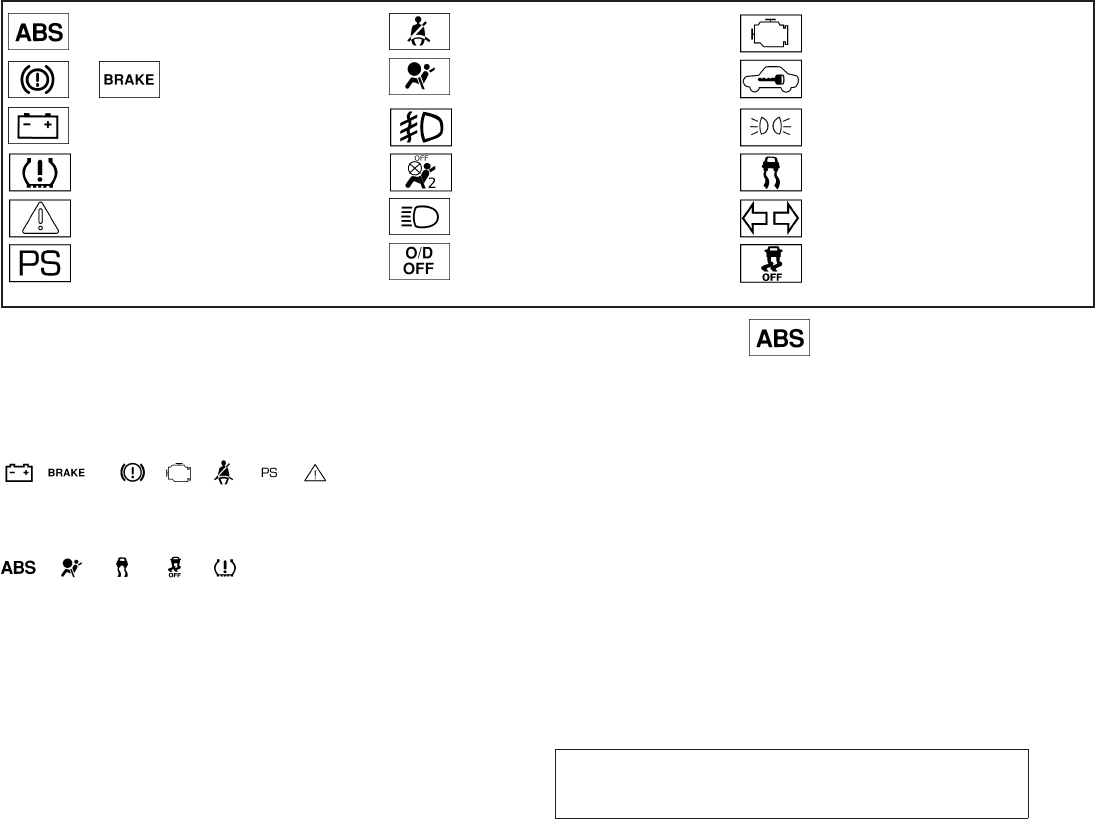
JOBNAME: 1093929-2013-asd-own PAGE: 80 SESS: 4 OUTPUT: Tue Mar 27 10:39:14 2012
Anti-lock Braking System (ABS) warning light Seat belt warning light and chime Malfunction Indicator Light (MIL)
or Brake warning light Supplemental air bag warning light Security indicator light
Charge warning light Fog light indicator light (if so equipped) Side light and headlight indicator light (green)
Low tire pressure warning light Front passenger air bag status light Slip indicator light
Master warning light High beam indicator light (blue) Turn signal/hazard indicator lights
Power steering warning light Overdrive off indicator light (if so equipped) Vehicle Dynamic Control (VDC) off indicator
light
CHECKING BULBS
With all doors closed, apply the parking brake
and place the ignition switch to the ON position
without starting the engine. The following lights
will come on:
, or , , , ,
The following lights (if equipped) come on briefly
and then go off:
, , , ,
If any light fails to come on, it may indicate
a burned-out bulb or an open circuit in the
electrical system. Have the system repaired
promptly.
WARNING LIGHTS
For additional information on warnings and indi-
cators, see “Vehicle information display” later in
this section.
Anti-lock Braking System
(ABS) warning light
When the ignition switch is placed in the ON
position, the Anti-lock Braking System (ABS)
warning light illuminates and then turns off. This
indicates the ABS is operational.
If the ABS light comes on while the engine is
running, it may indicate the anti-lock braking sys-
tem is not functioning properly. Have the system
checked by a NISSAN dealer.
WARNING/INDICATOR LIGHTS AND
AUDIBLE REMINDERS
2-10 Instruments and controls
ZREVIEW COPY—
2013 Altima Sedan (asd)
Owners Manual—USA_English (nna)
03/24/12—dmoore
X
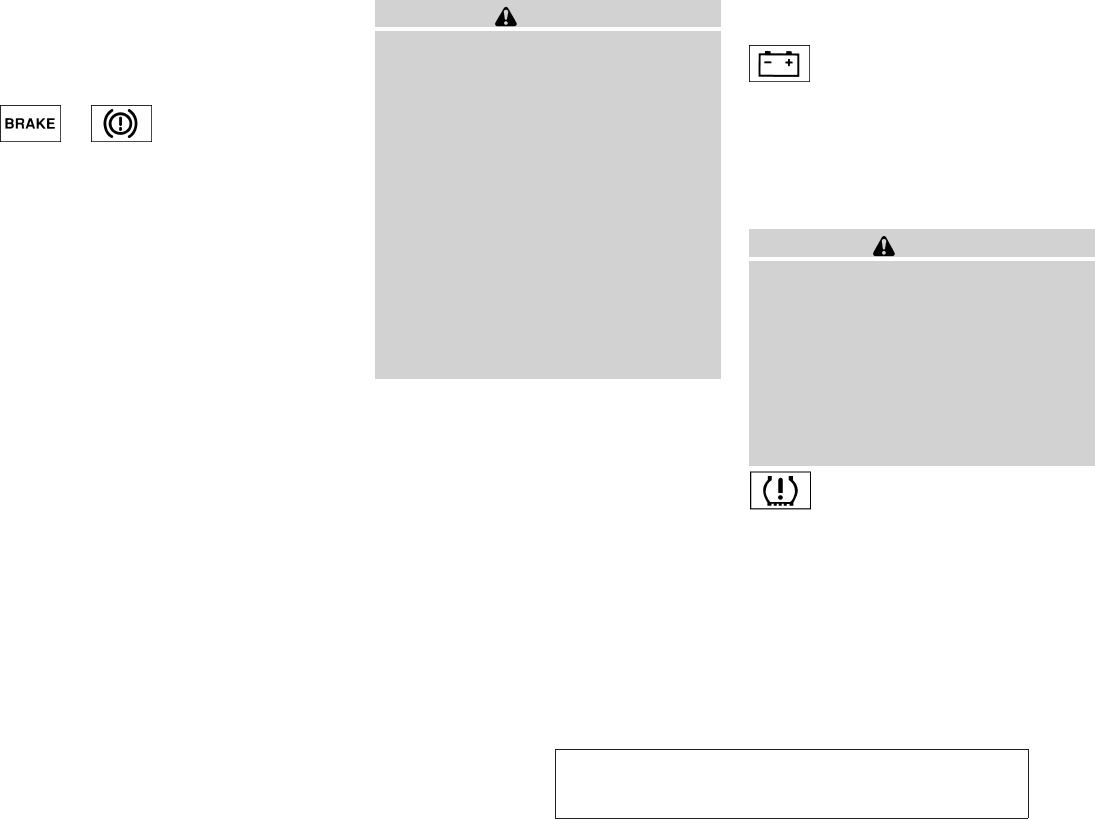
JOBNAME: 1093929-2013-asd-own PAGE: 81 SESS: 4 OUTPUT: Tue Mar 27 10:39:14 2012
If an ABS malfunction occurs, the anti-lock func-
tion is turned off. The brake system then operates
normally, but without anti-lock assistance. See
“Brake system” in the “Starting and driving” sec-
tion.
or Brake warning light
This light functions for both the parking brake and
the foot brake systems.
Parking brake indicator
When the ignition switch is placed in the ON
position, the light comes on when the parking
brake is applied.
Low brake fluid warning light
When the ignition switch is placed in the ON
position, the light warns of a low brake fluid level.
If the light comes on while the engine is running
with the parking brake not applied, stop the ve-
hicle and perform the following:
1. Check the brake fluid level. Add brake fluid
as necessary. See “Brake fluid” in the “Main-
tenance and do-it-yourself” section of this
manual.
2. If the brake fluid level is correct, have the
warning system checked by a NISSAN
dealer.
WARNING
●Your brake system may not be working
properly if the warning light is on. Driv-
ing could be dangerous. If you judge it
to be safe, drive carefully to the nearest
service station for repairs. Otherwise,
have your vehicle towed because driv-
ing it could be dangerous.
●Pressing the brake pedal with the en-
gine stopped and/or a low brake fluid
level may increase your stopping dis-
tance and braking will require greater
pedal effort as well as pedal travel.
●If the brake fluid level is below the
MINIMUM or MIN mark on the brake
fluid reservoir, do not drive until the
brake system has been checked at a
NISSAN dealer.
Anti-lock Braking System (ABS) warning
indicator
When the parking brake is released and the
brake fluid level is sufficient, if both the brake
warning light and the Anti-lock Braking System
(ABS) warning light illuminate, it may indicate the
ABS is not functioning properly. Have the brake
system checked, and if necessary, repaired by a
NISSAN dealer promptly. Avoid high-speed driv-
ing and abrupt braking. (See “Anti-lock Braking
System (ABS) warning light” in this section.)
Charge warning light
If this light comes on while the engine is running,
it may indicate the charging system is not func-
tioning properly. Turn the engine off and check
the generator belt. If the belt is loose, broken,
missing, or if the light remains on, see a NISSAN
dealer immediately.
CAUTION
●Do not ground electrical accessories
directly to the battery terminal. Doing
so will bypass the variable control sys-
tem and the vehicle battery may not
charge completely. Refer to “Variable
voltage control system” in the “Mainte-
nance and do-it-yourself” section later
in this manual.
●Do not continue driving if the generator
belt is loose, broken or missing.
Low tire pressure warning light
Your vehicle is equipped with a Tire Pressure
Monitoring System (TPMS) that monitors the tire
pressure of all tires except the spare.
Instruments and controls 2-11
ZREVIEW COPY—
2013 Altima Sedan (asd)
Owners Manual—USA_English (nna)
03/24/12—dmoore
X

JOBNAME: 1093929-2013-asd-own PAGE: 82 SESS: 4 OUTPUT: Tue Mar 27 10:39:14 2012
The low tire pressure warning light warns of low
tire pressure or indicates that the TPMS is not
functioning properly.
After the ignition switch is placed in the ON
position, this light illuminates for about 1 second
and turns off.
Low tire pressure warning:
If the vehicle is being driven with low tire
pressure, the warning light will illuminate. A
“Tire Pressure Low - Add Air” warning also
appears in the vehicle information display.
When the low tire pressure warning light
illuminates, you should stop and adjust the
tire pressure of all 4 tires to the recom-
mended COLD tire pressure shown on the
Tire Load and Information label located in
the driver’s door opening. The low tire pres-
sure warning light does not automatically
turn off when the tire pressure is adjusted.
After the tire is inflated to the recom-
mended pressure, the vehicle must be
driven at speeds above 16 MPH (25 km/h)
to activate the TPMS and turn off the low
tire pressure warning light. Use a tire pres-
sure gauge to check the tire pressure.
The “Tire Pressure Low - Add Air” warning is
active as long as the low tire pressure warning
light remains illuminated.
For additional information, see “Vehicle informa-
tion display” in the “Instruments and controls”
section and “Tire Pressure Monitoring System
(TPMS)” in the “Starting and driving” section and
in the “In case of emergency” section.
TPMS malfunction:
If the TPMS is not functioning properly, the low
tire pressure warning light will flash for approxi-
mately 1 minute when the ignition switch is
placed in the ON position. The light will remain on
after the 1 minute. Have the system checked by a
NISSAN dealer. The “Tire Pressure Low - Add
Air” warning does not appear if the low tire pres-
sure warning light illuminates to indicate a TPMS
malfunction.
For additional information, see “Tire Pressure
Monitoring System (TPMS)” in the “Starting and
driving” section and “Tire pressure” in the “Start-
ing and driving” section.
WARNING
●Radio waves could adversely affect
electric medical equipment. Those who
use a pacemaker should contact the
electric medical equipment manufac-
turer for the possible influences before
use.
●If the light does not illuminate with the
ignition switch in the ON position, have
the vehicle checked by a NISSAN dealer
as soon as possible.
●If the light illuminates while driving,
avoid sudden steering maneuvers or
abrupt braking, reduce vehicle speed,
pull off the road to a safe location and
stop the vehicle as soon as possible.
Driving with under-inflated tires may
permanently damage the tires and in-
crease the likelihood of tire failure. Se-
rious vehicle damage could occur and
may lead to an accident and could re-
sult in serious personal injury. Check
the tire pressure for all four tires. Adjust
the tire pressure to the recommended
COLD tire pressure shown on the Tire
placard located in the driver’s door
opening to turn the low tire pressure
warning light OFF. If the light still
comes on while driving after adjusting
the tire pressure, a tire may be flat. If
you have a flat tire, replace it with a
spare tire as soon as possible.
2-12 Instruments and controls
ZREVIEW COPY—
2013 Altima Sedan (asd)
Owners Manual—USA_English (nna)
03/24/12—dmoore
X
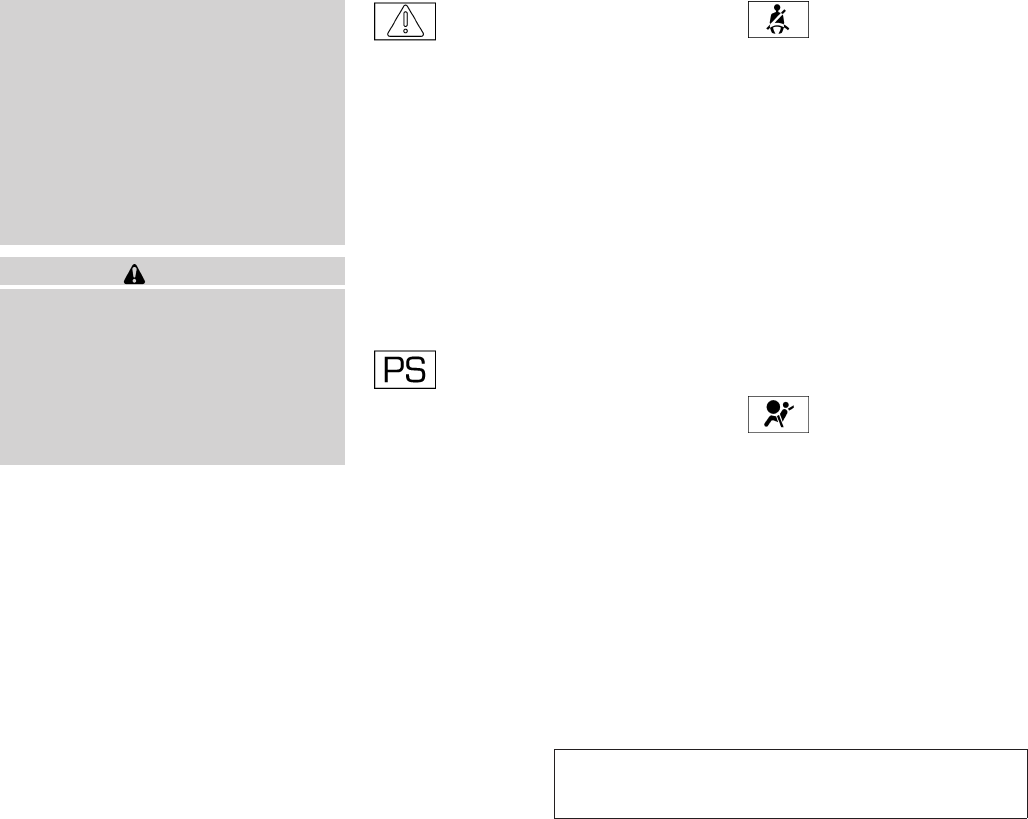
JOBNAME: 1093929-2013-asd-own PAGE: 83 SESS: 4 OUTPUT: Tue Mar 27 10:39:14 2012
●When a spare tire is mounted or a wheel
is replaced, tire pressure will not be
indicated, the TPMS will not function
and the low tire pressure warning light
will flash for approximately 1 minute.
The light will remain on after 1 minute.
Contact your NISSAN dealer as soon as
possible for tire replacement and/or
system resetting.
●Replacing tires with those not originally
specified by NISSAN could affect the
proper operation of the TPMS.
CAUTION
●The TPMS is not a substitute for the
regular tire pressure check. Be sure to
check the tire pressure regularly.
●If the vehicle is being driven at speeds
of less than 25 km/h (16 MPH), the
TPMS may not operate correctly.
●Be sure to install the specified size of
tires to the 4 wheels correctly.
Master warning light
When the ignition is in the ON position, the
master warning light illuminates if any of the fol-
lowing are displayed on the vehicle information
display.
●No key warning
●Low fuel warning
●Low windshield-washer fluid warning
●Parking brake release warning
●Door/trunk open warning
●Loose fuel cap
●Check tire pressure warning
Power steering warning light
When the ignition switch is in the ON position,
the power steering warning light illuminates. After
starting the engine, the hydraulic pump electric
power steering warning light turns off. This indi-
cates that the electric power steering system is
operational. See “Power steering system” in the
“Starting and driving” section.
Seat belt warning light and
chime
The light and chime remind you to fasten your
seat belts. The light illuminates whenever the
ignition switch is placed in the ON or START
position and remains illuminated until the driver’s
seat belt is fastened. At the same time, the chime
sounds for about 6 seconds unless the driver’s
seat belt is securely fastened.
The seat belt warning light may also illuminate if
the front passenger’s seat belt is not fastened
when the front passenger’s seat is occupied. For
7 seconds after the ignition switch is placed in
the ON position, the system does not activate the
warning light for the front passenger.
Refer to “Seat belts” in the “Safety—Seats, seat
belts and supplemental restraint system” section
for precautions on seat belt usage.
Supplemental air bag warning
light
When the ignition switch is placed in the ON or
START position, the supplemental air bag warn-
ing light illuminates for about 7 seconds and then
turns off. This means the system is operational.
Instruments and controls 2-13
ZREVIEW COPY—
2013 Altima Sedan (asd)
Owners Manual—USA_English (nna)
03/24/12—dmoore
X
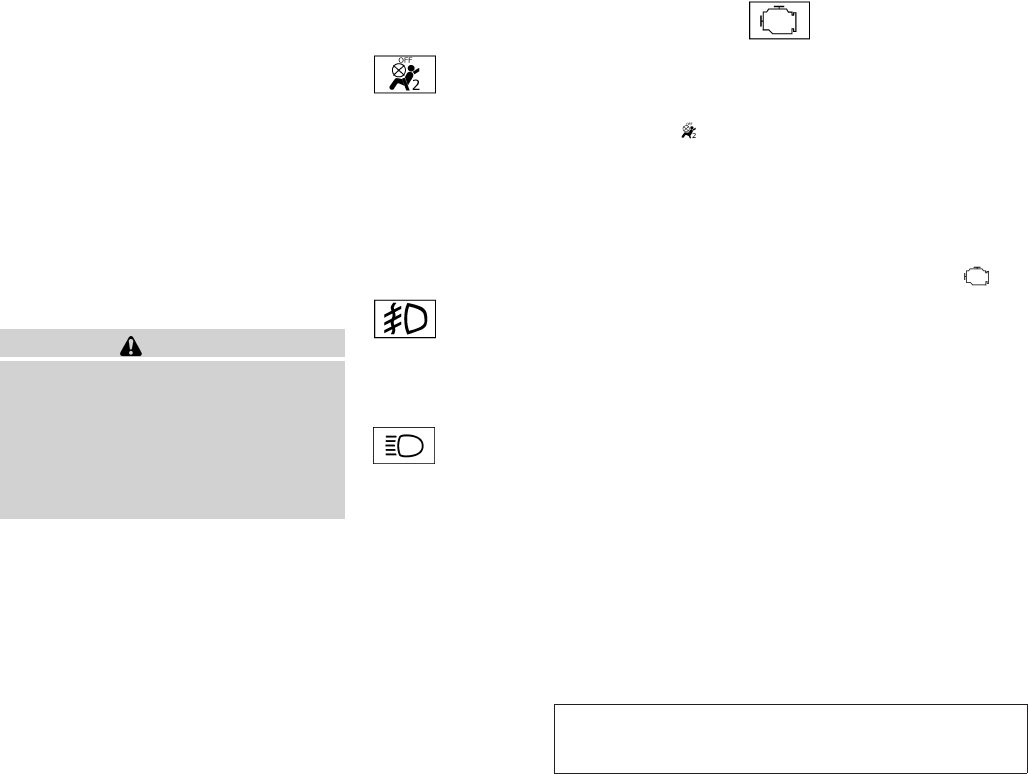
JOBNAME: 1093929-2013-asd-own PAGE: 84 SESS: 4 OUTPUT: Tue Mar 27 10:39:14 2012
If any of the following conditions occur, the front
air bag, side air bag, curtain air bag, and preten-
sioner systems need servicing and your vehicle
must be taken to a NISSAN dealer:
●The supplemental air bag warning light re-
mains on after approximately 7 seconds.
●The supplemental air bag warning light
flashes intermittently.
●The supplemental air bag warning light does
not come on at all.
Unless checked and repaired, the supplemental
restraint system (air bag system) and/or the pre-
tensioners may not function properly. For addi-
tional details, see “Supplemental restraint sys-
tem” in the “Safety—Seats, seat belts and
supplemental restraint system” section of this
manual.
WARNING
If the supplemental air bag warning light
is on, it could mean that the front air bag,
side air bag, curtain air bag systems
and/or pretensioner systems will not op-
erate in an accident. To help avoid injury
to yourself or others, have your vehicle
checked by a NISSAN dealer as soon as
possible.
INDICATOR LIGHTS
For additional information on warnings and indi-
cators, see “Vehicle information display” later in
this section.
Front passenger air bag status
light
The front passenger air bag status light ( )
will be lit and the passenger front air bag will be
OFF depending on how the front passenger seat
is being used.
For front passenger air bag status light operation,
see “Front passenger air bag and status light” in
the “Safety — Seats, seat belts and supplemental
restraint system” section of this manual.
Front fog light indicator light (if
so equipped)
The front fog light indicator light illuminates when
the front fog lights are ON. See “Fog light switch”
later in this section.
High beam indicator light
(blue)
This blue light comes on when the headlight high
beams are on and goes out when the low beams
are selected.
The high beam indicator light also comes on
when the passing signal is activated.
Malfunction Indicator Light
(MIL)
If this indicator light comes on steady or blinks
while the engine is running, it may indicate a
potential emission control malfunction.
The Malfunction Indicator Light may also come
on steady if the fuel-filler cap is loose or missing,
or if the vehicle runs out of fuel. Check to make
sure the fuel-filler cap is installed and closed
tightly, and that the vehicle has at least 3 gallons
(11.4 liters) of fuel in the fuel tank.
After a few driving trips, the light should
turn off if no other potential emission control
system malfunction exists.
If this indicator light comes on steady for 20
seconds and then blinks for 10 seconds when
the engine is not running, it indicates that the
vehicle is not ready for an emission control sys-
tem inspection/maintenance test. See “Readi-
ness for inspection/maintenance (I/M) test”in the
“Technical and consumer information” section of
this manual.
2-14 Instruments and controls
ZREVIEW COPY—
2013 Altima Sedan (asd)
Owners Manual—USA_English (nna)
03/24/12—dmoore
X
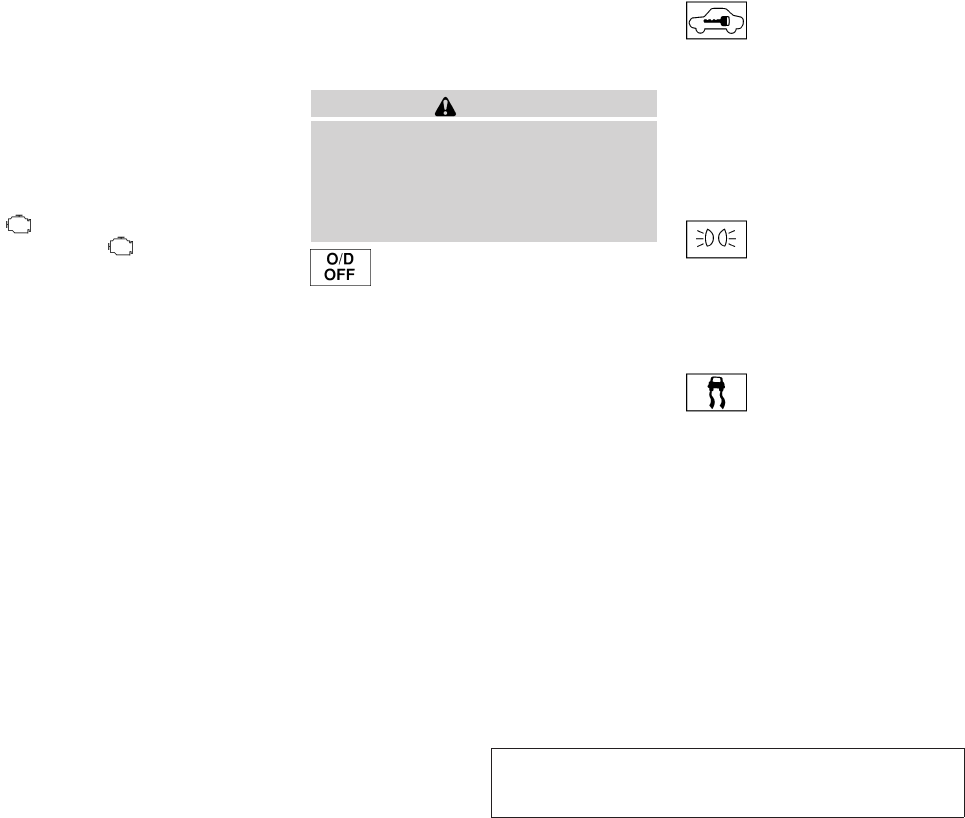
JOBNAME: 1093929-2013-asd-own PAGE: 85 SESS: 4 OUTPUT: Tue Mar 27 10:39:14 2012
Operation
The Malfunction Indicator Light will come on in
one of two ways:
●Malfunction Indicator Light on steady — An
emission control system malfunction has
been detected. Check the fuel-filler cap if
the LOOSE FUEL CAP warning appears in
the vehicle information display. If the fuel-
filler cap is loose or missing, tighten or install
the cap and continue to drive the vehicle.
The light should turn off after a few
driving trips. If the light does not turn
off after a few driving trips, have the vehicle
inspected by a NISSAN dealer. You do not
need to have your vehicle towed to the
dealer.
●Malfunction Indicator Light blinking — An
engine misfire has been detected which may
damage the emission control system. To re-
duce or avoid emission control system dam-
age:
– do not drive at speeds above 45 MPH
(72 km/h).
– avoid hard acceleration or deceleration.
– avoid steep uphill grades.
– if possible, reduce the amount of cargo
being hauled or towed.
The Malfunction Indicator Light may stop blinking
and come on steady. Have the vehicle inspected
by a NISSAN dealer. You do not need to have
your vehicle towed to the dealer.
CAUTION
Continued vehicle operation without hav-
ing the emission control system checked
and repaired as necessary could lead to
poor driveability, reduced fuel economy,
and possible damage to the emission con-
trol system.
Overdrive off indicator light (if
so equipped)
QR25DE:
The overdrive off indicator light illuminates when
the overdrive off mode is selected.
VQ35DE:
This light illuminates and then turns off when the
ignition switch is placed to the ON position.
QR25DE and VQ35DE:
For additional information, see “Continuously
Variable Transmission (CVT)” in the “Starting and
driving” section of this manual.
Security indicator light
This light blinks when the ignition switch is
placed in the OFF, LOCK or ACC position.
The blinking security indicator light indicates that
the security systems equipped on the vehicle are
operational.
For additional information, see “Security sys-
tems” later in this section.
Side light and headlight
indicator light (green)
The side light and headlight indicator light illumi-
nates when the side light or headlight position is
selected. See “Headlight and turn signal switch”
later in this section for further details.
Slip indicator light
This indicator will blink when the VDC system or
the traction control system is operating, thus
alerting that the vehicle is nearing its traction
limits. The road surface may be slippery.
Instruments and controls 2-15
ZREVIEW COPY—
2013 Altima Sedan (asd)
Owners Manual—USA_English (nna)
03/24/12—dmoore
X
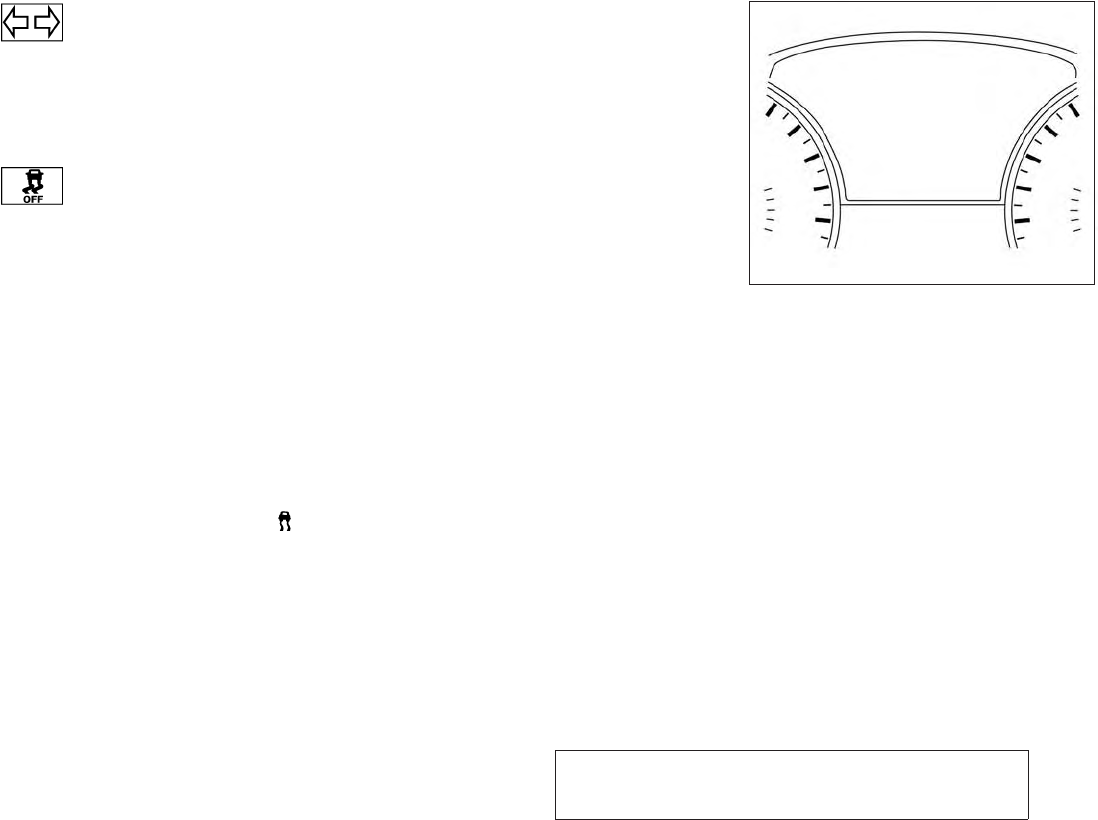
JOBNAME: 1093929-2013-asd-own PAGE: 86 SESS: 5 OUTPUT: Tue Mar 27 10:39:14 2012
Turn signal/hazard indicator
lights
The appropriate light flashes when the turn signal
switch is activated.
Both lights flash when the hazard switch is turned
on.
Vehicle Dynamic Control
(VDC) OFF indicator light
This indicator light comes on when the Vehicle
Dynamic Control off switch is pushed to OFF.
This indicates the Vehicle Dynamic Control has
been turned off.
Push the Vehicle Dynamic Control off switch
again or restart the engine and the system will be
reactivated. See “Vehicle Dynamic Control
(VDC) system” in the “Starting and driving” sec-
tion of this manual.
The Vehicle Dynamic Control light also comes on
when you push the push-button ignition switch to
the ON position. The light will turn off after about
2 seconds if the system is operational. If the light
stays on or comes on along with the indi-
cator light while you are driving, have the Vehicle
Dynamic Control system checked by a NISSAN
dealer.
While the Vehicle Dynamic Control system is
operating, you might feel slight vibration or hear
the system working when starting the vehicle or
accelerating, but this is normal.
AUDIBLE REMINDERS
Brake pad wear warning
The disc brake pads have audible wear warnings.
When a disc brake pad requires replacement, it
makes a high pitched scraping sound when the
vehicle is in motion, whether or not the brake
pedal is depressed. Have the brakes checked as
soon as possible if the warning sound is heard.
Light reminder chime
With the ignition switch placed in the OFF posi-
tion, a chime sounds when the driver’s door is
opened if the headlights or parking lights are on.
Turn the headlight control switch off before leav-
ing the vehicle.
NISSAN Intelligent KeyTdoor buzzer
The Intelligent Key door buzzer sounds if the
Intelligent Key is left inside the vehicle when
locking the doors. When the buzzer sounds, be
sure to check both the vehicle and the Intelligent
Key. See “NISSAN Intelligent Key™ ” in the “Pre-
driving checks and adjustments” section.
The vehicle information display is located to the
left of the speedometer. It displays such items as:
●Vehicle settings
●Trip computer information
●Cruise control system information
●
NISSAN Intelligent KeyToperation information
●Audio information
●Navigation - turn by turn (if so equipped)
●Indicators and warnings
●Tire Pressure information (if so equipped)
●Other information
LIC2205
VEHICLE INFORMATION DISPLAY
2-16 Instruments and controls
ZREVIEW COPY—
2013 Altima Sedan (asd)
Owners Manual—USA_English (nna)
03/27/12—dmoore
X
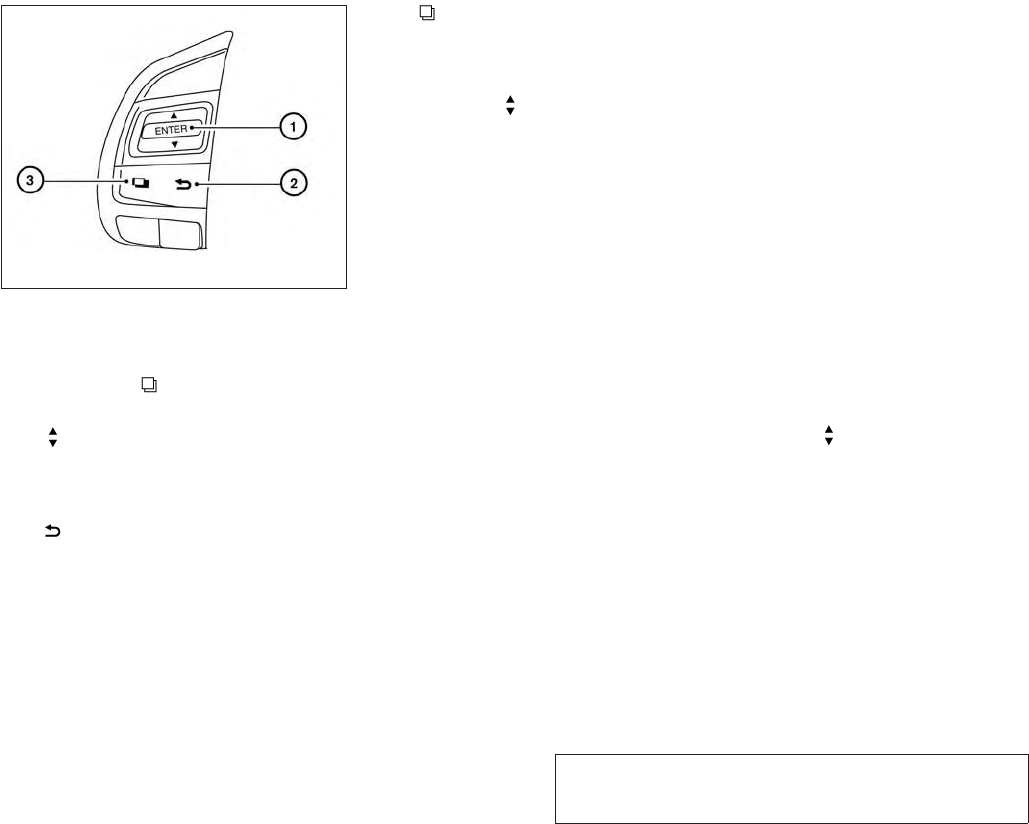
JOBNAME: 1093929-2013-asd-own PAGE: 87 SESS: 4 OUTPUT: Tue Mar 27 10:39:14 2012
HOW TO USE THE VEHICLE
INFORMATION DISPLAY
The vehicle information display can be changed
using the buttons and ENTER located on
the steering wheel.
1. — navigate through the items in ve-
hicle information
ENTER — change or select an item in the
vehicle information display
2. — go back to the previous menu
3. — select/enter the Vehicle informa-
tion menu items or to change from one dis-
play screen to the next (i.e. trip, TPMS, Fuel
economy)
The ENTER and buttons also control audio
and control panel functions. For additional infor-
mation see, “Steering wheel switch for audio
control” in “Monitor, climate, audio, phone and
voice recognition systems” section.
STARTUP DISPLAY
When the vehicle in placed in the ON or ACC
position the screens that display in the vehicle
information include:
●Active system status (if so equipped)
●Trip computer
●Tire pressure information (if so equipped)
●Fuel economy
●Warnings
Warnings will only display if there are any pres-
ent, for more information on warnings and indica-
tors see, “Vehicle information display warnings
and indicators” in this section.
To control what items display in the vehicle infor-
mation display, see “Main menu selection” in this
section.
SETTINGS
The setting mode allows you to change the infor-
mation displayed in the vehicle information display:
●Main Menu Selection
●Body Color
●Maintenance
●Alarms
●Vehicle Settings
●Language
●Unit
●Welcome Effects
●Factory Reset
Main Menu Selection
The items that display can be enabled/disabled
when the ignition switch is placed in the ON
position. To change the items that display.
Use the button to select and the ENTER
button to change a menu item:
●Trip Computer
●Audio
●Navigation (if so equipped)
●Fuel Economy
●Tire Pressures (if so equipped)
LIC2322
Instruments and controls 2-17
ZREVIEW COPY—
2013 Altima Sedan (asd)
Owners Manual—USA_English (nna)
03/24/12—dmoore
X
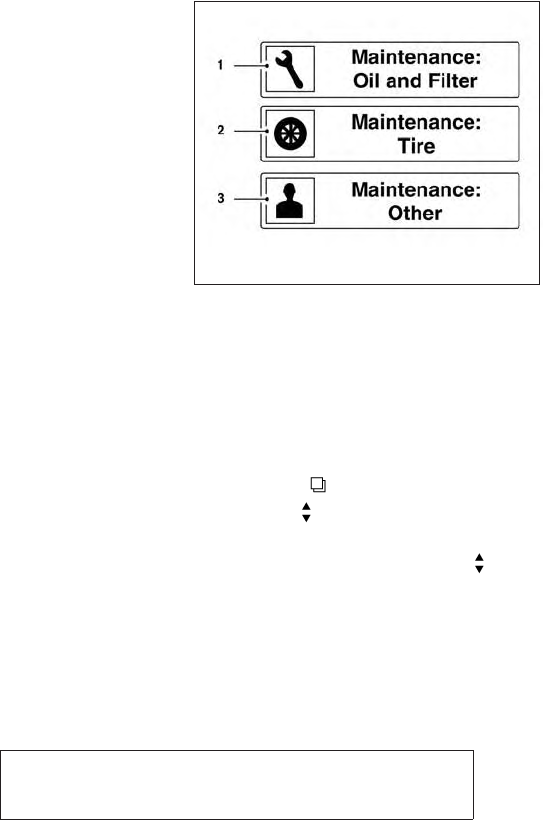
JOBNAME: 1093929-2013-asd-own PAGE: 88 SESS: 4 OUTPUT: Tue Mar 27 10:39:14 2012
Trip Computer
The trip computer can be enabled/disabled to
display in the vehicle information display when
the ignition switch is placed in the ON position.
From the “Main Menu Selection” select “Trip
Computer” to display in the vehicle information
display when the ignition is placed in the ON
position.
Audio
The audio can be enabled/disabled to display in
the vehicle information display when the ignition
switch is placed in the ON position to display the
radio information in the vehicle information dis-
play.
From the “Main Menu Selection”select “Audio”to
display in the vehicle information display when
the ignition is placed in the ON position.
Navigation (if so equipped)
The navigation can be enabled/disabled to dis-
play in the vehicle information display when the
ignition switch is placed in the ON position.
From the “Main Menu Selection” select “Naviga-
tion” to display in the vehicle information display
when turn-by-turn is used and the ignition is
placed in the ON position.
Fuel Economy
The fuel economy can be enabled/disabled to
display in the vehicle information display when
the ignition switch is placed in the ON position.
From the “Main Menu Selection” select “Fuel
Economy” to display in the vehicle information
display when the ignition is placed in the ON
position.
Tire Pressures (if so equipped)
The tire pressures can be enabled/disabled to
display in the vehicle information display when
the ignition switch is placed in the ON position.
From the “Main Menu Selection” select “Tire
Pressures” to display in the vehicle information
display when the ignition is placed in the ON
position.
Body Color
The color of the vehicle that displays in the ve-
hicle information display when the ignition switch
is placed in the ON position can be changed.
1. scheduled service: oil and oil filter
2. tires
3. other
Maintenance
The maintenance mode allows you to set alerts
for the reminding of maintenance intervals. To
change an item:
1. Press the button.
2. Use the button until “Settings” is se-
lected, and press ENTER.
3. Select “Maintenance” using the but-
tons and press ENTER.
LIC2370
2-18 Instruments and controls
ZREVIEW COPY—
2013 Altima Sedan (asd)
Owners Manual—USA_English (nna)
03/24/12—dmoore
X

JOBNAME: 1093929-2013-asd-own PAGE: 89 SESS: 4 OUTPUT: Tue Mar 27 10:39:14 2012
Service
This indicator appears when the customer set
distance comes for changing the engine oil and
filter. You can set or reset the distance for check-
ing or replacing these items. For scheduled main-
tenance items and intervals, see your “NISSAN
Service and Maintenance Guide.”
Tire
This indicator appears when the customer set
distance comes for replacing tires. You can set or
reset the distance for replacing tires.
WARNING
The tire replacement indicator is not a
substitute for regular tire checks, includ-
ing tire pressure checks. See “Changing
Wheels and Tires” in “Maintenance & Do-
It-Yourself” section. Many factors includ-
ing tire inflation, alignment, driving habits
and road conditions affect tire wear and
when tires should be replaced. Setting the
tire replacement indicator for a certain
driving distance does not mean your tires
will last that long. Use the tire replace-
ment indicator as a guide only and always
perform regular tire checks. Failure to per-
form regular tire checks, including tire
pressure checks could result in tire fail-
ure. Serious vehicle damage could occur
and may lead to a collision, which could
result in serious personal injury or death.
Other
This indicator appears when the customer set
distance comes for checking or replacing main-
tenance items other than the engine oil, oil filter
and tires. Other maintenance items can include
such things as air filter or tire rotation. You can set
or reset the distance for checking or replacing
the items.
Alarms
This setting allows the customer to set alarms for
outside temperature and a timer alert.
1. Press the button.
2. Use the button until “Settings” is se-
lected, and press ENTER.
3. Select “Alarms” using the buttons and
press ENTER.
Outside Temperature
This setting allows the customer to
enable/disable the alert for low outside tempera-
ture in the vehicle information display.
1. Use the buttons to select “Outside
Temperature”.
2. Press the ENTER button to turn ON/OFF
the outside temperature in the vehicle infor-
mation display.
Timer Alert
This setting allows the customer to set an alert to
notify the driver that the set time has been
reached.
1. Use the buttons to select “Timer
Alert”.
2. Press the ENTER button.
Instruments and controls 2-19
ZREVIEW COPY—
2013 Altima Sedan (asd)
Owners Manual—USA_English (nna)
03/24/12—dmoore
X

JOBNAME: 1093929-2013-asd-own PAGE: 90 SESS: 4 OUTPUT: Tue Mar 27 10:39:14 2012
3. To change the timer amount, use the
buttons and the ENTER button to save the
selected time amount.
Navigation (if so equipped)
This setting allows the customer to
enable/disable the alert for navigation in the ve-
hicle information display.
1. Use the buttons to select “Naviga-
tion”.
2. Press the ENTER button to turn ON/OFF
the alert.
Vehicle Settings
The vehicle settings allows the customer to
change settings for interior lights, intelligent key
settings, unlock settings and other vehicle set-
tings.
The vehicle settings can be changed using
the , , and the ENTER buttons.
Auto Room Lamp
The interior lights can be set to be ON or OFF if
any door is unlocked. From the Vehicle Settings
menu, select “Auto Room Light”. Use the ENTER
button to turn this feature ON or OFF.
Light Sensitivity (if so equipped)
The light sensitivity can be set to illuminate earlier
based on the brightness outside the vehicle.
From the Vehicle Settings menu, select “Light
Sensitivity”. Use the ENTER button to change the
sensitivity.
Light Off Delay (if so equipped)
The duration of the automatic headlights can be
changed from 0 to 180 seconds. From the Ve-
hicle Settings menu, select “Light Off Delay”. Use
the ENTER button to change the duration.
Wiper with Speed
The wiper with speed can be set to be ON or
OFF. From the Vehicle Settings menu, select
“Wiper with Speed”. Use the ENTER button to
turn this feature ON or OFF.
I-Key Door Lock (if so equipped)
When this item is turned on, the request switch
on the door is activated. From the Vehicle Set-
tings menu, select “I-Key Door Unlock”. Use the
ENTER button to activate this function.
Selective-Unlock
When this item is turned on, only the driver’s door
is unlocked first after the door unlock operation.
When the door handle request switch on the
driver’s or front passenger’s side door is pushed
to be unlocked, only the corresponding door is
unlocked first. All the doors can be unlocked if the
door unlock operation is performed again within
1 minute. When this item is turned to off, all the
doors will be unlocked after the door unlock
operation is performed once. From the Vehicle
Settings menu, select “Selective Unlock”. Use
the ENTER button to activate this function.
Auto Door Unlock
The auto door unlock function automatically un-
locks all the doors when the shift selector is
placed in P (park) position. From the Vehicle
Settings menu, select “Auto Door Unlock”. Use
the ENTER button to enable/disable this func-
tion.
Answer back horn
When the answer back horn is on the horn will
chirp and the hazard indicators will flash once
when locking the vehicle with the Intelligent Key.
Remote Start (if so equipped)
The remote start function can be turned on or off.
If the setting is OFF the vehicle cannot be started
using the intelligent key. From the Vehicle Set-
tings menu, select “Remote Start”. Use the EN-
TER button to enable/disable.
2-20 Instruments and controls
ZREVIEW COPY—
2013 Altima Sedan (asd)
Owners Manual—USA_English (nna)
03/24/12—dmoore
X

JOBNAME: 1093929-2013-asd-own PAGE: 91 SESS: 4 OUTPUT: Tue Mar 27 10:39:14 2012
Battery Saver
Activating the battery saver will automatically turn
off the headlights after a period of time when the
ignition switch is placed in the OFF position
when the headlight switch is in the ,
or position. From the Vehicle Settings
menu, select “Battery Saver”. Use the ENTER
button to enable/disable this function.
Language
The language of the vehicle information display
can be changed to:
●US English
●French
●Spanish
Use the , , and the ENTER buttons to
select and change the language of the vehicle
information display. The language of the center
display/navigation can be changed indepen-
dently of the vehicle information display. For ve-
hicles not equipped with Navigation see “SET-
TING button:” and vehicles equipped with
Navigation see, “System”in the “Monitor, climate,
audio, phone and voice recognition systems”
section of this manual.
Units
The units that are shown in the vehicle informa-
tion display can be changed:
●Mileage
●Tire pressures
●Temperature
Use the , , and the ENTER buttons to
select and change the units of the vehicle infor-
mation display. The units of the navigation screen
can be changed independently of the vehicle
information display. For vehicles equipped with
Navigation, see “System”in the “Monitor, climate,
audio, phone and voice recognition systems”
section of this manual.
Mileage
The unit for the mileage that displays in the ve-
hicle information display can be changed to:
●miles, MPG, Inch
●km/h, l/100km, cm
Use the and the ENTER buttons to select
and change the unit.
Tire Pressures (if so equipped)
The unit for tire pressure that displays in the
vehicle information display can be changed to:
●psi
●kPa
●bar
●Kgf/cm
2
Use the and the ENTER buttons to select
and change the unit.
Temperature
The temperature that displays in the vehicle infor-
mation display can be changed from:
●°F (Fahrenheit)
●°C (Celsius)
Use the ENTER button to toggle choices.
Welcome Effects
The welcome screen display can be turned
ON/OFF to display when the ignition switch is
placed in the ACC or ON position. To
enable/disable the welcome screen:
1. Press the button.
Instruments and controls 2-21
ZREVIEW COPY—
2013 Altima Sedan (asd)
Owners Manual—USA_English (nna)
03/24/12—dmoore
X

JOBNAME: 1093929-2013-asd-own PAGE: 92 SESS: 4 OUTPUT: Tue Mar 27 10:39:14 2012
2. Use the buttons to select “Settings”,
and press ENTER.
3. Select “Welcome Effects” using the
buttons and press ENTER to turn this func-
tion ON or OFF.
Factory Reset
The settings in the vehicle information display can
be reset back to the factory default. To reset the
vehicle information display:
1. Press the button.
2. Use the buttons to select “Settings”,
and press the ENTER button.
3. Select “Factory Reset” using the but-
tons and press the ENTER button.
4. Select “YES” to return all settings back to
default by pressing the ENTER button.
2-22 Instruments and controls
ZREVIEW COPY—
2013 Altima Sedan (asd)
Owners Manual—USA_English (nna)
03/24/12—dmoore
X
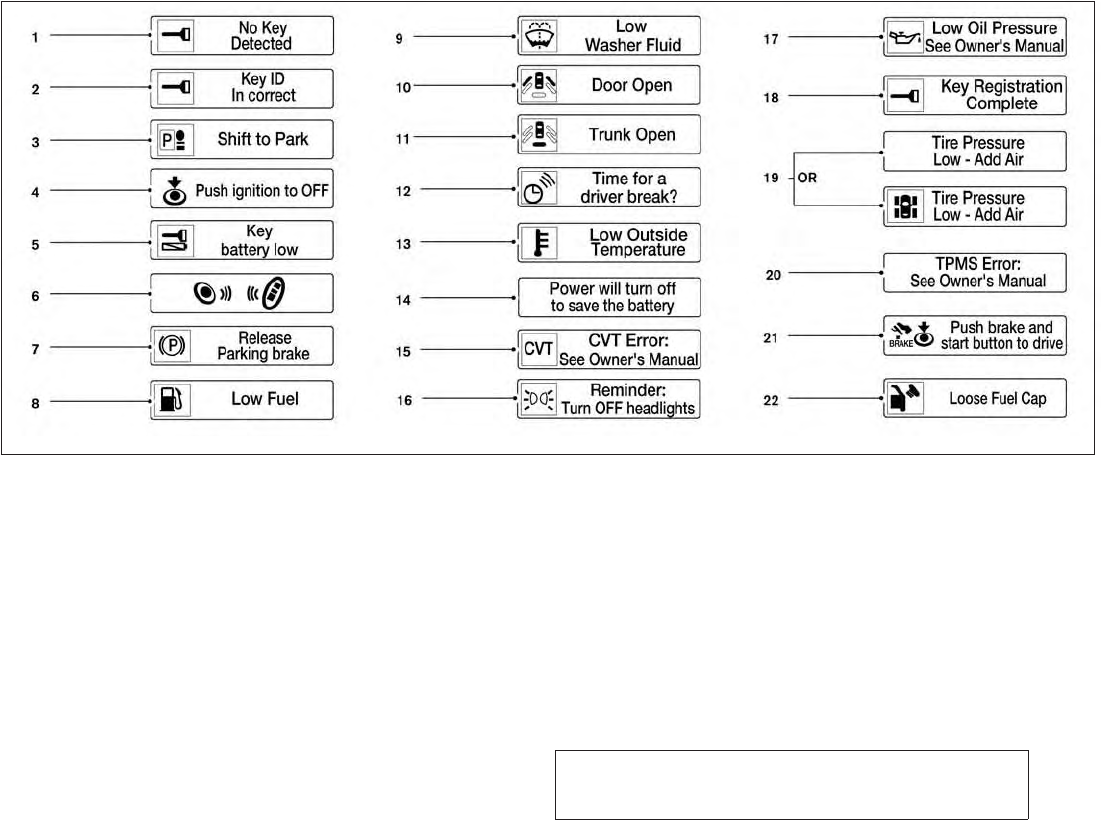
JOBNAME: 1093929-2013-asd-own PAGE: 93 SESS: 4 OUTPUT: Tue Mar 27 10:39:14 2012
VEHICLE INFORMATION DISPLAY
WARNINGS AND INDICATORS
1. No Key Detected
2. Key ID Incorrect
3. Shift to Park
4. Push ignition to OFF
5. Key Battery Low
6. Engine start operation for Intelligent Key sys-
tem
7. Release parking brake
8. Low Fuel
9. Low Washer Fluid
10. Door Open
11. Trunk Open
LIC2343
Instruments and controls 2-23
ZREVIEW COPY—
2013 Altima Sedan (asd)
Owners Manual—USA_English (nna)
03/24/12—dmoore
X

JOBNAME: 1093929-2013-asd-own PAGE: 94 SESS: 4 OUTPUT: Tue Mar 27 10:39:14 2012
12. Timer Alert – Time for a driver break?
13. Low Outside Temperature
14. Power will turn off to save the battery
15. CVT Error
16. Reminder: Turn OFF headlights
17. Low Oil Pressure
18. Key Registration Complete
19. Tire Pressure Low - Add Air (if so equipped)
20. TPMS Error
21. Remote Start (if so equipped)
22. Loose Fuel Cap
No Key Detected
This warning appears when the intelligent key is
left outside the vehicle with the ignition switch is
the ON or ACC position. Make sure the Intelli-
gent Key is inside the vehicle.
Key ID Incorrect
This warning appears when the ignition switch is
placed from the OFF position and the intelligent
key is not recognized by the system. You can not
start the engine with an unregistered key.
See “NISSAN Intelligent KeyT” in “Pre-driving
checks and adjustments” for more information.
Shift to Park
This warning illuminates when the ignition switch
is in the ACC or OFF position and the shift
selector is in any position other than P (Park)
position. Also, a chime sounds when the ignition
switch is in the OFF position.
If this warning illuminates, move the shift selector
to the P (Park) position or start the engine.
For additional information about Intelligent Key,
see “NISSAN Intelligent KeyT” in the “Pre-driving
checks and adjustments” section.
Push ignition to OFF
After the Push ignition to OFF warning illumi-
nates, the warning will illuminate if the ignition
switch is placed in the ACC position when the
shift selector is moved to the P (Park) position.
To turn off the Push warning, place the ignition
switch in the ON position and then in the LOCK
position.
Key Battery Low
This indicator illuminates when the Intelligent Key
battery is running out of power.
If this indicator illuminates, replace the battery
with a new one. See “Battery replacement” in the
“Maintenance and do-it-yourself” section.
Engine start operation for Intelligent Key
system
This indicator appears when the battery of the
Intelligent Key is low and when the Intelligent Key
system and the vehicle are not communicating
normally.
If this appears, touch the ignition switch with the
Intelligent Key while depressing the brake pedal.
For more information see, “Intelligent Key battery
discharge” in the “Starting and driving” section.
Release Parking brake
This warning illuminates in the message area of
the vehicle information display when the parking
brake is set and the vehicle is driven.
Low Fuel
This warning illuminates when the fuel level in the
fuel tank is getting low. Refuel as soon as it is
convenient, preferably before the fuel gauge
reaches 0 (Empty). There will be a small re-
serve of fuel in the tank when the fuel
gauge needle reaches 0 (Empty).
Low Washer Fluid
This warning illuminates when the windshield-
washer fluid is at a low level. Add windshield-
washer fluid as necessary. See “Windshield-
washer fluid” in the “Maintenance and do-it-
yourself” section of this manual.
2-24 Instruments and controls
ZREVIEW COPY—
2013 Altima Sedan (asd)
Owners Manual—USA_English (nna)
03/24/12—dmoore
X

JOBNAME: 1093929-2013-asd-own PAGE: 95 SESS: 4 OUTPUT: Tue Mar 27 10:39:14 2012
Door Open
This warning illuminates when a door has been
opened when the engine is running.
Trunk Open
This warning illuminates when the trunk has been
opened when the engine is running.
Timer Alert – Time for a driver break?
This indicator appears when the set time is
reached. The time can be set up to 6 hours. For
setting the timer see, “Timer alert” in this section.
Low Outside Temperature
This warning appears if the outside temperature
is below 37°F (3°C). The temperature can be
changed to display in Celsius or Fahrenheit, see
“Temperature” earlier in this section.
Power will turn off to save the battery
This warning appears in message area of the
vehicle information display after a period of time if
the shift selector has not moved from the P (Park)
position.
CVT Error
This warning illuminates when the there is a prob-
lem with the CVT system. If this warning comes
on, have the system checked by a NISSAN
dealer.
Reminder: Turn OFF headlights
This warning appears when the headlights are
left in the ON position when exiting the vehicle.
Place the headlight switch to OFF or AUTO po-
sition. For additional information, see “Headlight
and turn signal switch” in this section.
Low Oil Pressure
This warning appears in message area of the
vehicle information display if low oil pressure is
detected. This gauge is not designed to indicated
low oil level. The low oil pressure warning is
not designed to indicate a low oil level. Use
the dipstick to check the oil level. See “Engine oil”
in the “Maintenance and do-it-yourself” section.
Intelligent key registration complete
This appears when a new intelligent key is regis-
tered to the vehicle.
Tire Pressure Low - Add Air warning (if so
equipped)
This warning appears when the low tire pressure
warning light in the meter illuminates and low tire
pressure is detected. If this warning appears,
stop the vehicle and adjust the tire pressures of
all 4 tires to the recommended COLD tire pres-
sure shown on the Tire and Loading Information
label. See “Low tire pressure warning light” ear-
lier in this section and “Tire Pressure Monitoring
System (TPMS)” in the “Starting and driving”
section.
TPMS Error
This warning appears when there is a error with
your TPMS. If this warning comes on, have the
system checked by a NISSAN dealer.
Push to start (if so equipped)
This warning appears in the vehicle information
display when the vehicle has been started using
the remote start function. To start the vehicle,
apply the brake and place the ignition switch in
the ON position.
Loose Fuel Cap
This warning appears when the fuel-filler cap is
not tightened correctly after the vehicle has been
refueled. See “Fuel-filler cap” in the “Pre-driving
checks and adjustments” section of this manual.
Instruments and controls 2-25
ZREVIEW COPY—
2013 Altima Sedan (asd)
Owners Manual—USA_English (nna)
03/24/12—dmoore
X
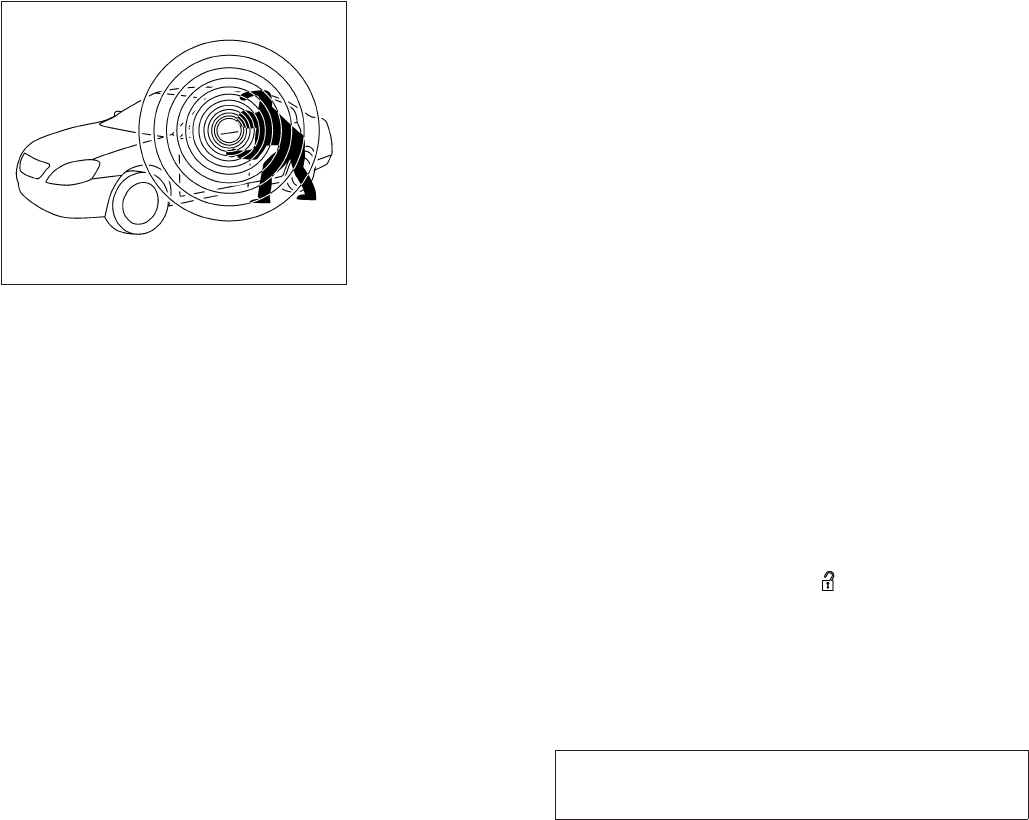
JOBNAME: 1093929-2013-asd-own PAGE: 96 SESS: 4 OUTPUT: Tue Mar 27 10:39:14 2012
Your vehicle may have two types of security sys-
tems:
●Vehicle security system
●NISSAN Vehicle Immobilizer System
VEHICLE SECURITY SYSTEM
The vehicle security system provides visual and
audible alarm signals if someone opens the
doors, trunk lid or the hood when the system is
armed. It is not, however, a motion detection type
system that activates when a vehicle is moved or
when a vibration occurs.
The system helps deter vehicle theft but cannot
prevent it, nor can it prevent the theft of interior or
exterior vehicle components in all situations. Al-
ways secure your vehicle even if parking for a
brief period. Never leave your Intelligent Key in
the vehicle, and always lock the vehicle when
unattended. Be aware of your surroundings, and
park in secure, well-lit areas whenever possible.
Many devices offering additional protection, such
as component locks, identification markers, and
tracking systems, are available at auto supply
stores and specialty shops. Your NISSAN dealer
may also offer such equipment. Check with your
insurance company to see if you may be eligible
for discounts for various theft protection features.
How to arm the vehicle security
system
1. Close all windows. (The system can be
armed even if the windows are open.)
2. Remove the Intelligent Key from the vehicle.
3. Close all doors, hood and trunk. Lock all
doors. The doors can be locked with the
Intelligent Key, door handle request switch
(if so equipped), power door lock switch or
mechanical key.
4. Confirm that the security indicator light
comes on. The security light stays on for
about 30 seconds. The vehicle security sys-
tem is now pre-armed. After about 30 sec-
onds the vehicle security system automati-
cally shifts into the armed phase. The
security light begins to flash once every 3
seconds. If, during the 30-second pre-arm
time period, the driver’s door is unlocked by
the key or the keyfob, or the ignition switch is
placed in the ACC or ON position, the sys-
tem will not arm.
●Even when the driver and/or passen-
gers are in the vehicle, the system will
activate with all the doors, hood and
trunk lid locked with the ignition
switch placed in the LOCK position.
When placing the ignition switch in the
ACC or ON position, the system will be
released.
Vehicle security system activation
The vehicle security system will give the following
alarm:
●The headlights blink and the horn sounds
intermittently.
●The alarm automatically turns off after a pe-
riod of time. However, the alarm reactivates if
the vehicle is tampered with again. The alarm
can be shut off by unlocking the driver’s door
or trunk lid with the key, or by pressing
the button on the Intelligent Key.
LIC0301
SECURITY SYSTEMS
2-26 Instruments and controls
ZREVIEW COPY—
2013 Altima Sedan (asd)
Owners Manual—USA_English (nna)
03/24/12—dmoore
X
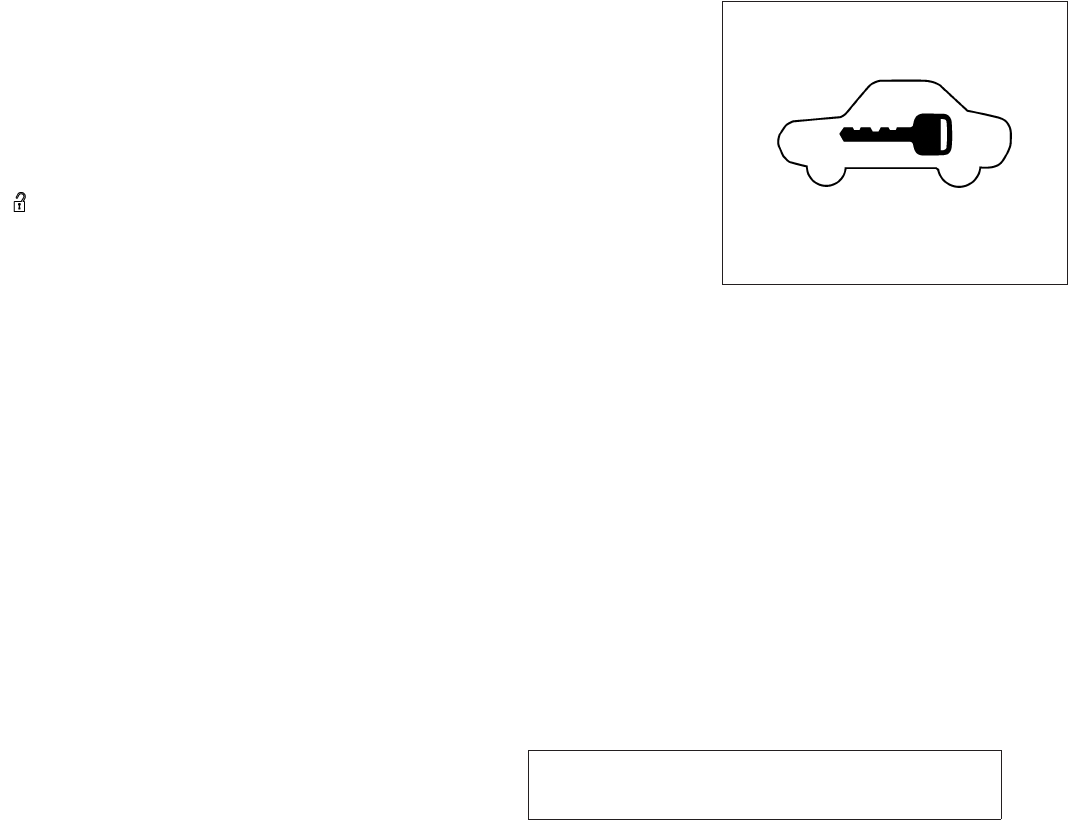
JOBNAME: 1093929-2013-asd-own PAGE: 97 SESS: 4 OUTPUT: Tue Mar 27 10:39:14 2012
The alarm is activated by:
●opening the door or trunk lid without using
the key or Intelligent Key (even if the door is
unlocked by releasing the door inside lock
switch).
How to stop an activated alarm
The alarm stops only by unlocking the driver’s
door or the trunk lid with the key, pressing
the button on the Intelligent Key, or press-
ing the request switch (if so equipped) on the
driver’s or passenger’s door with the Intelligent
Key in range of the door handle.
NISSAN VEHICLE IMMOBILIZER
SYSTEM
The NISSAN Vehicle Immobilizer System will not
allow the engine to start without the use of a
registered key.
Never leave these keys in the vehicle.
Statement related to Section 15 of FCC
Rules for NISSAN Vehicle Immobilizer Sys-
tem
This device complies with part 15 of the
FCC Rules and RSS-210 of Industry
Canada. Operation is subject to the follow-
ing two conditions;
(1) This device may not cause harmful in-
terference, and (2) this device must accept
any interference received, including inter-
ference that may cause undesired opera-
tion of the device.
CHANGES OR MODIFICATIONS NOT EX-
PRESSLY APPROVED BY THE PARTY RE-
SPONSIBLE FOR COMPLIANCE COULD
VOID THE USER’S AUTHORITY TO OPER-
ATE THE EQUIPMENT.
Security indicator light
The security indicator light blinks whenever the
ignition switch is placed in the OFF, LOCK or ACC
position. This function indicates the NISSAN Ve-
hicle Immobilizer System is operational.
If the NISSAN Vehicle Immobilizer System is mal-
functioning, the light will remain on while the
ignition switch is placed in the ON position.
If the light still remains on and/or the en-
gine will not start, see a NISSAN dealer for
NISSAN Vehicle Immobilizer System ser-
vice as soon as possible. Please bring all
registered keys that you have when visiting
your NISSAN dealer for service.
LIC0474
Instruments and controls 2-27
ZREVIEW COPY—
2013 Altima Sedan (asd)
Owners Manual—USA_English (nna)
03/24/12—dmoore
X
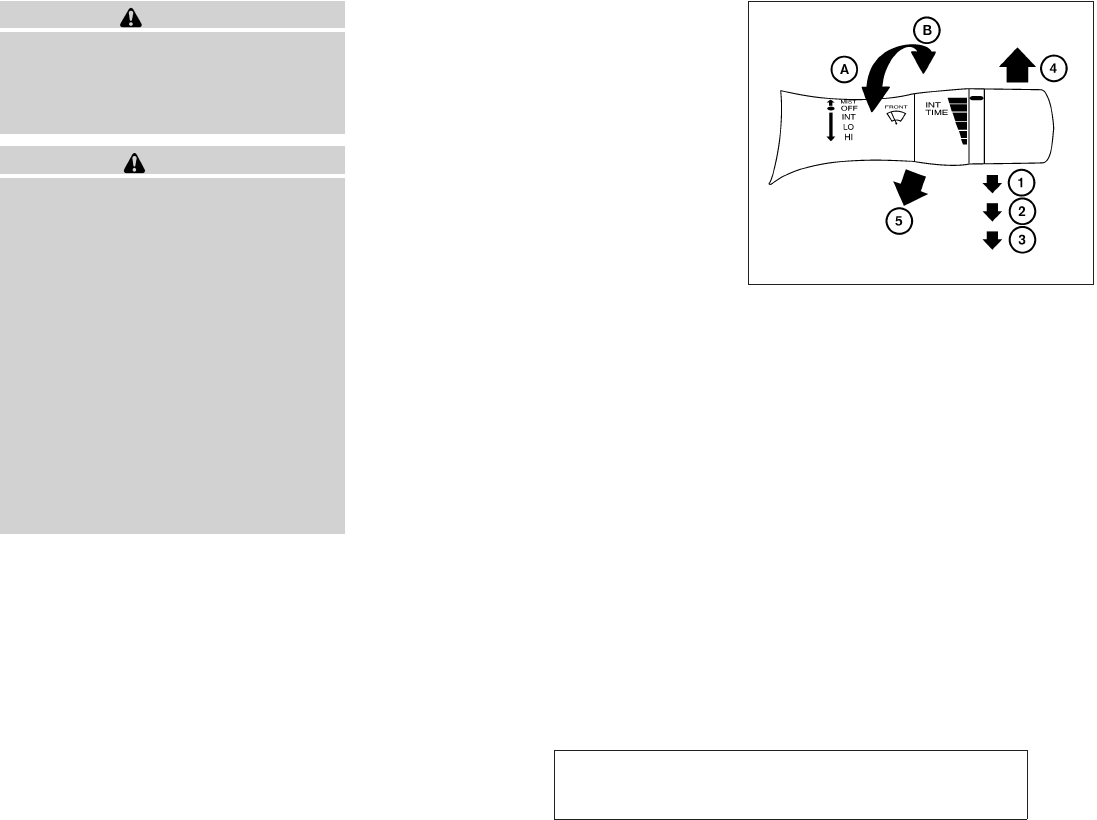
JOBNAME: 1093929-2013-asd-own PAGE: 98 SESS: 4 OUTPUT: Tue Mar 27 10:39:14 2012
WARNING
In freezing temperatures the washer solu-
tion may freeze on the window and ob-
scure your vision which may lead to an
accident. Warm the window with the de-
froster before you wash the window.
CAUTION
●Do not operate the washer continu-
ously for more than 30 seconds.
●Do not operate the washer if the reser-
voir tank is empty.
●Do not fill the window washer reservoir
with washer fluid concentrates at full
strength. Some methyl alcohol based
washer fluid concentrates may perma-
nently stain the grille if spilled while
filling the window washer reservoir.
●Pre-mix washer fluid concentrates with
water to the manufacturer’s recom-
mended levels before pouring the fluid
into the window washer reservoir. Do
not use the window washer reservoir to
mix the washer fluid concentrate and
water.
If the windshield wiper operation is interrupted by
snow or ice, the wiper may stop moving to protect
its motor. If this occurs, turn the wiper switch to
the OFF position and remove the snow or ice that
is on and around the wiper arms. In approximately
1 minute, turn the switch on again to operate the
wiper.
SWITCH OPERATION
The windshield wiper and washer operates when
the ignition switch is in the ON position.
Push the lever down to operate the wiper at the
following speed:
s
1Intermittent (INT) — intermittent operation
can be adjusted by turning the knob toward
s
A(Slower) or s
B(Faster). Also, the inter-
mittent operation speed varies in accor-
dance with the vehicle speed. (For example,
when the vehicle speed is high, the intermit-
tent operation speed will be faster.)
WIC1434
WINDSHIELD WIPER AND WASHER
SWITCH
2-28 Instruments and controls
ZREVIEW COPY—
2013 Altima Sedan (asd)
Owners Manual—USA_English (nna)
03/24/12—dmoore
X
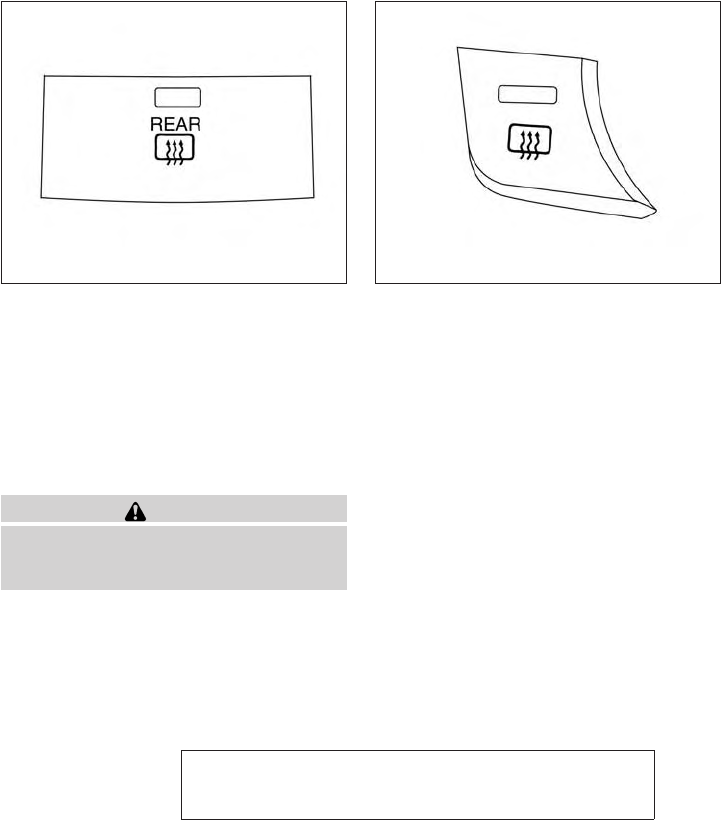
JOBNAME: 1093929-2013-asd-own PAGE: 99 SESS: 4 OUTPUT: Tue Mar 27 10:39:14 2012
s
2Low (LO) — continuous low speed operation
s
3High (HI) — continuous high speed opera-
tion
Push the lever up s
4to have one sweep opera-
tion (MIST) of the wiper.
Pull the lever toward you s
5to operate the
washer. The wiper will also operate several times.
To defrost the rear window glass and outside
mirrors (if so equipped), start the engine and
push the rear window defroster switch on. The
rear window defroster indicator light on the
switch comes on. Push the switch again to turn
the defroster off.
The rear window defroster automatically turns off
after approximately 15 minutes.
CAUTION
When cleaning the inner side of the rear
window, be careful not to scratch or dam-
age the rear window defroster.
NOTE:
The top and bottom few rows of wires on
the rear window are not part of the rear
window defroster system. These wires
make up the antenna for the audio system.
Type A
LIC2324
Type B
LIC2325
REAR WINDOW AND OUTSIDE
MIRROR (if so equipped)
DEFROSTER SWITCH
Instruments and controls 2-29
ZREVIEW COPY—
2013 Altima Sedan (asd)
Owners Manual—USA_English (nna)
03/24/12—dmoore
X
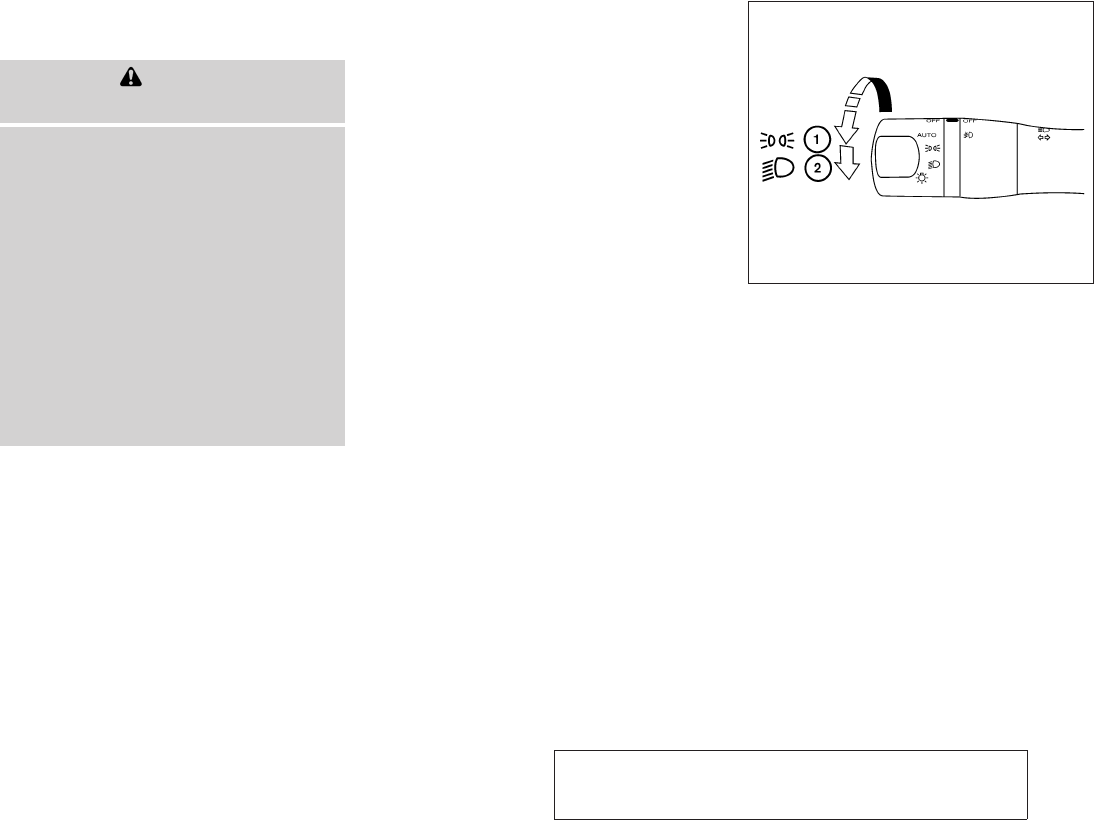
JOBNAME: 1093929-2013-asd-own PAGE: 100 SESS: 4 OUTPUT: Tue Mar 27 10:39:14 2012
XENON HEADLIGHTS (if so
equipped)
WARNING
cHIGH VOLTAGE
●When xenon headlights are on, they
produce a high voltage. To prevent an
electric shock, never attempt to modify
or disassemble. Always have your xe-
non headlights replaced at a NISSAN
dealer.
●Xenon headlights provide considerably
more light than conventional head-
lights. If they are not correctly aimed,
they might temporarily blind an oncom-
ing driver or the driver ahead of you and
cause a serious accident. If headlights
are not aimed correctly, immediately
take your vehicle to a NISSAN dealer
and have the headlights adjusted
correctly.
When the xenon headlight is initially turned on, its
brightness or color varies slightly. However, the
color and brightness will soon stabilize.
●The life of xenon headlights will be
shortened by frequent on-off opera-
tion. It is generally desirable not to turn
off the headlights for short intervals
(for example, when the vehicle stops at
a traffic signal). Even when the daytime
running lights are active (Canada only),
the xenon headlights do not turn on.
This way the life of the xenon head-
lights is not reduced.
●If the xenon headlight bulb is close to
burning out, the brightness will drasti-
cally decrease, the light will start blink-
ing, or the color of the light will be-
come reddish. If one or more of the
above signs appear, contact a NISSAN
dealer.
HEADLIGHT CONTROL SWITCH
Type A
WIC1435
HEADLIGHT AND TURN SIGNAL
SWITCH
2-30 Instruments and controls
ZREVIEW COPY—
2013 Altima Sedan (asd)
Owners Manual—USA_English (nna)
03/24/12—dmoore
X
title will be moved
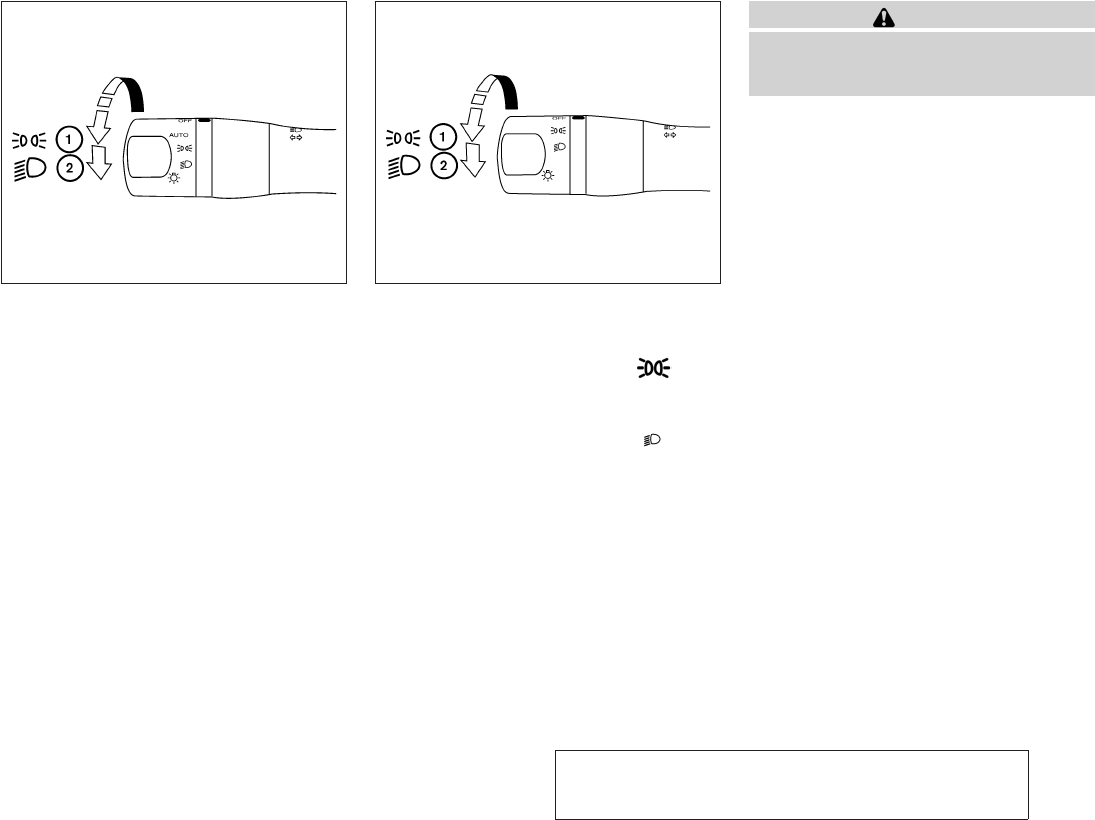
JOBNAME: 1093929-2013-asd-own PAGE: 101 SESS: 4 OUTPUT: Tue Mar 27 10:39:14 2012
Lighting
s
1When turning the switch to the posi-
tion, the front parking, tail, license plate and
instrument panel lights come on.
s
2When turning the switch to the posi-
tion, the headlights come on and all the other
lights remain on.
CAUTION
Use the headlights with the engine run-
ning to avoid discharging the vehicle
battery.
Type B
WIC1436
Type C
WIC1510
Instruments and controls 2-31
ZREVIEW COPY—
2013 Altima Sedan (asd)
Owners Manual—USA_English (nna)
03/24/12—dmoore
X
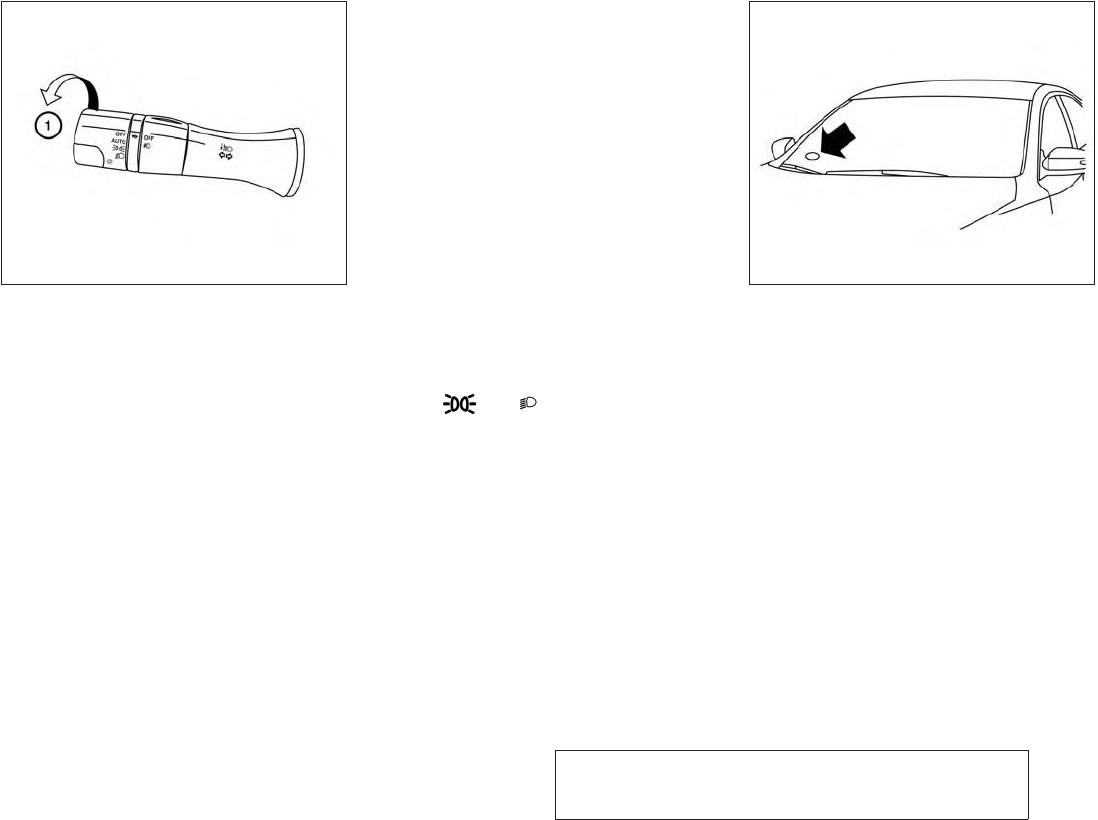
JOBNAME: 1093929-2013-asd-own PAGE: 102 SESS: 4 OUTPUT: Tue Mar 27 10:39:14 2012
Autolight system (if so equipped)
The autolight system allows the headlights to turn
on and off automatically. The autolight system
can:
●Turn on the headlights, front parking, tail,
license plate and instrument panel lights au-
tomatically when it is dark.
●Turn off all the lights when it is light.
●Keep all the lights on for a period of time after
you place the ignition switch in the OFF
position and all doors are closed.
NOTE:
Autolight activation sensitivity and the
time delay for autolight shutoff can be ad-
justed. See “Vehicle information display”in
this section.
To turn on the autolight system:
1. Turn the headlight switch to the AUTO posi-
tion s
1.
2. Turn the ignition switch to ON.
3. The autolight system automatically turns the
headlights on and off.
Initially, if the ignition switch is turned OFF and a
door is opened and left open, the headlights
remain ON for a period of time. If another door is
opened while the headlights are on, then the
timer is reset.
To turn the autolight system off, turn the switch to
the OFF, , or position.
Be sure you do not put anything on top of
the autolight sensor located in the top side
of the instrument panel. The autolight sen-
sor controls the autolight; if it is covered,
the autolight sensor reacts as if it is dark
out and the headlights will illuminate. If
this occurs while parked with the engine
off and the ignition switch placed in the ON
position, your vehicle’s battery could be-
come discharged.
LIC2351 LIC2318
2-32 Instruments and controls
ZREVIEW COPY—
2013 Altima Sedan (asd)
Owners Manual—USA_English (nna)
03/24/12—dmoore
X
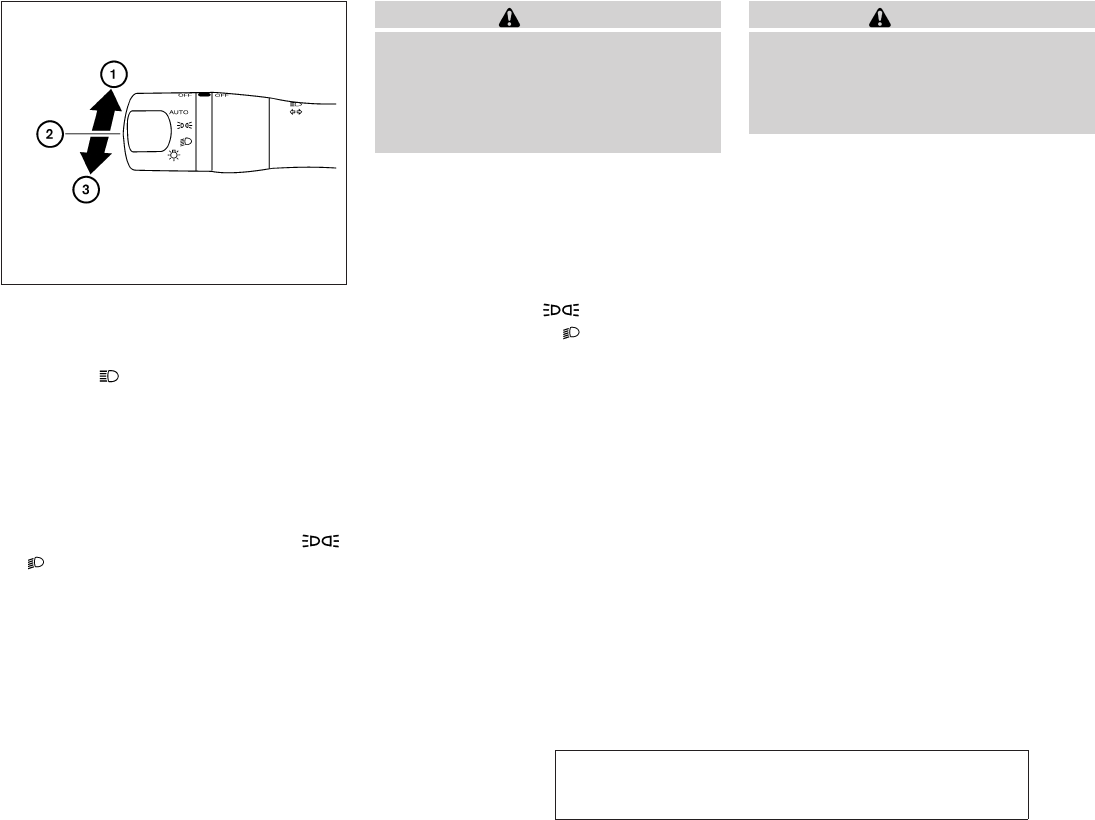
JOBNAME: 1093929-2013-asd-own PAGE: 103 SESS: 4 OUTPUT: Tue Mar 27 10:39:14 2012
Headlight beam select
s
1To select the high beam function, push the
lever forward. The high beam lights come on
and the light illuminates.
s
2Pull the lever back to select the low beam.
s
3Pulling and releasing the lever flashes the
headlight high beams on and off.
Battery saver system
If the ignition switch is placed in the OFF position
while the headlight switch is in the
or position, the headlights will turn off after
a period of time.
CAUTION
Even though the battery saver feature au-
tomatically turns off the headlights after a
period of time, you should turn the head-
light switch to the OFF position when the
engine is not running to avoid discharging
the vehicle battery.
DAYTIME RUNNING LIGHT SYSTEM
(Canada only)
The headlights automatically illuminate at a re-
duced intensity when the engine is started with
the parking brake released. The daytime running
lights operate with the headlight switch in the
OFF position or in the position. Turn the
headlight switch to the position for full
illumination when driving at night.
If the parking brake is applied before the engine is
started, the daytime running lights do not illumi-
nate. The daytime running lights illuminate when
the parking brake is released. The daytime run-
ning lights will remain on until the ignition switch
is placed in the OFF position.
WARNING
When the daytime running light system is
active, tail lights on your vehicle are not
on. It is necessary at dusk to turn on your
headlights. Failure to do so could cause
an accident injuring yourself and others.
WIC1438
Instruments and controls 2-33
ZREVIEW COPY—
2013 Altima Sedan (asd)
Owners Manual—USA_English (nna)
03/24/12—dmoore
X
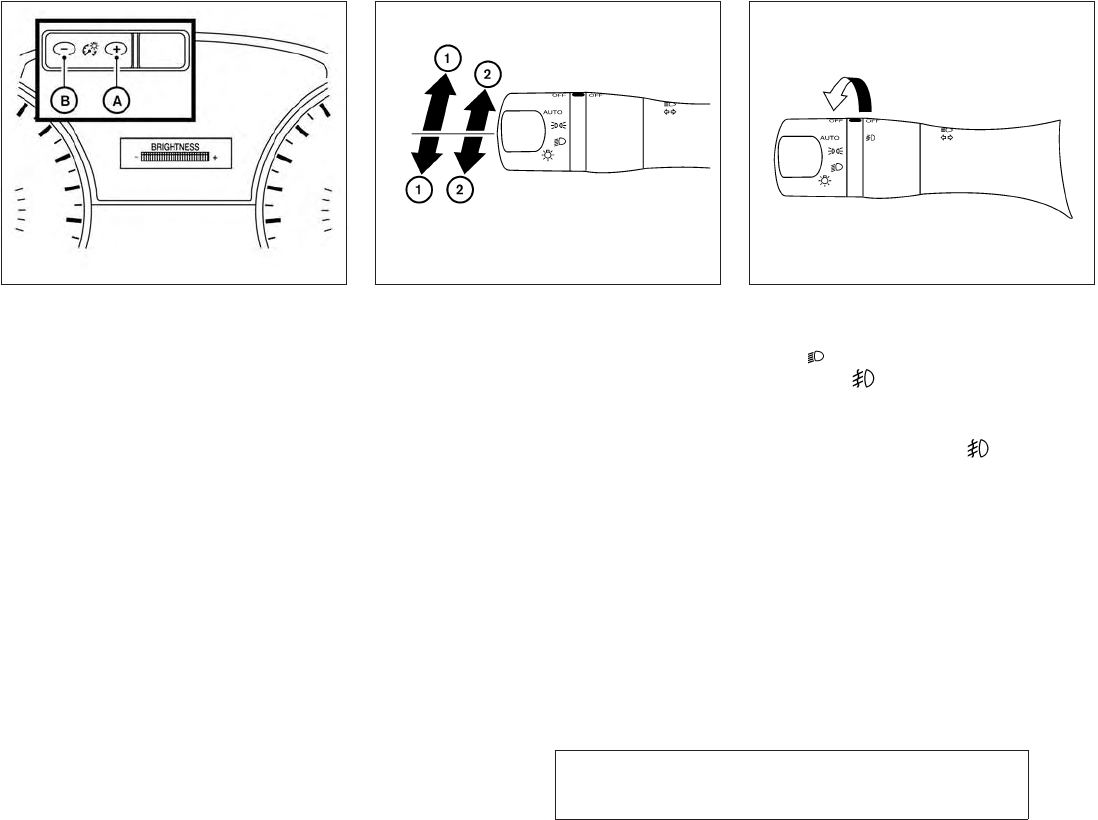
JOBNAME: 1093929-2013-asd-own PAGE: 104 SESS: 4 OUTPUT: Tue Mar 27 10:39:14 2012
INSTRUMENT BRIGHTNESS
CONTROL
Push the “+” button s
Ato increase the bright-
ness of instrument panel lights when driving at
night.
Push the “-” button s
Bto decrease the bright-
ness of instrument panel lights when driving at
night.
TURN SIGNAL SWITCH
Turn signal
s
1Move the lever up or down to signal the
turning direction. When the turn is com-
pleted, the turn signals cancel automatically.
Lane change signal
s
2To signal a lane change, move the lever up or
down to the point where the indicator light
begins to flash, but the lever does not latch.
FOG LIGHT SWITCH (if so equipped)
To turn the fog lights on, turn the headlight switch
to the position, then turn the fog light
switch to the position.
To turn the fog lights on with the headlight switch in
the AUTO position, the headlights must be on, then
turn the fog light switch to the position.
To turn the fog lights off, turn the fog light switch
to the OFF position.
The headlights must be on and the low beams
selected for the fog lights to operate. The fog
lights automatically turn off when the high beam
headlights are selected.
LIC2305 WIC1439 WIC1440
2-34 Instruments and controls
ZREVIEW COPY—
2013 Altima Sedan (asd)
Owners Manual—USA_English (nna)
03/24/12—dmoore
X
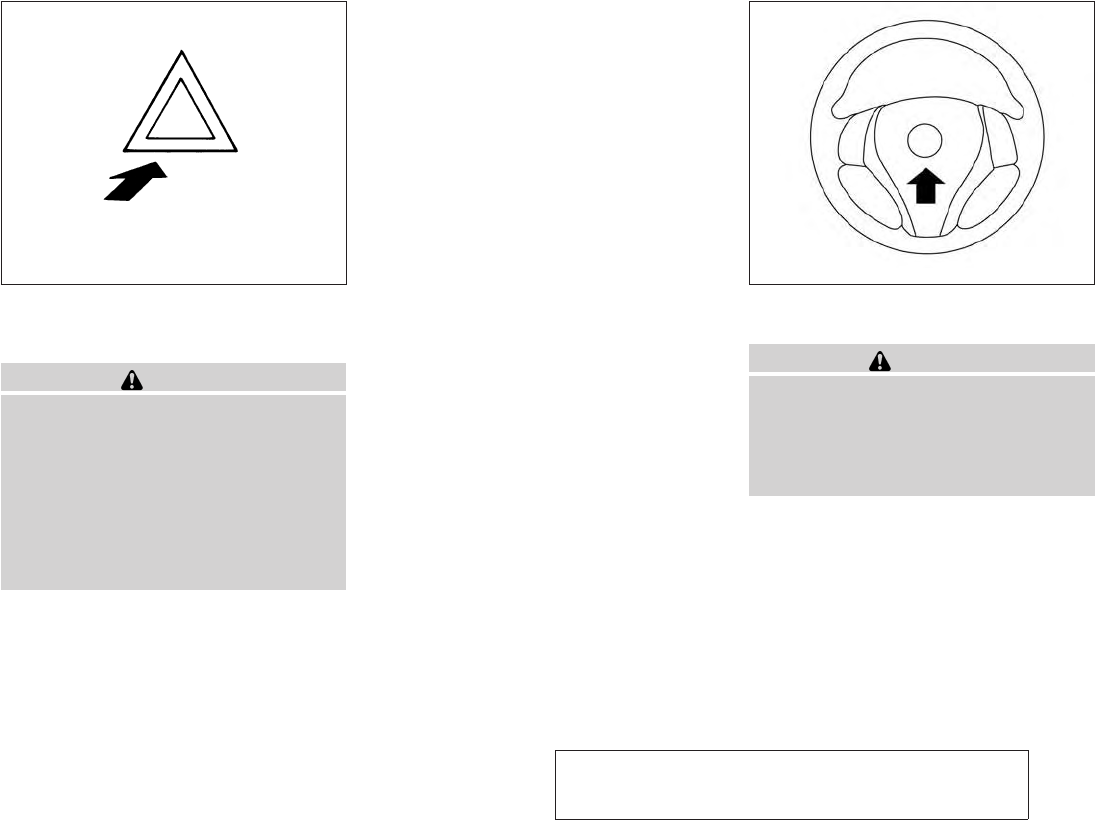
JOBNAME: 1093929-2013-asd-own PAGE: 105 SESS: 4 OUTPUT: Tue Mar 27 10:39:14 2012
Push the switch on to warn other drivers when
you must stop or park under emergency condi-
tions. All turn signal lights flash.
WARNING
●If stopping for an emergency, be sure to
move the vehicle well off the road.
●Do not use the hazard warning flashers
while moving on the highway unless
unusual circumstances force you to
drive so slowly that your vehicle might
become a hazard to other traffic.
●Turn signals do not work when the haz-
ard warning flasher lights are on.
The flashers will operate with the ignition switch
placed in any position.
Some state laws may prohibit the use of
the hazard warning flasher switch while
driving.
To sound the horn, push near the horn icon of the
steering wheel.
WARNING
Do not disassemble the horn. Doing so
could affect proper operation of the
supplemental front air bag system. Tam-
pering with the supplemental front air bag
system may result in serious personal
injury.
LIC0394 LIC2319
HAZARD WARNING FLASHER
SWITCH HORN
Instruments and controls 2-35
ZREVIEW COPY—
2013 Altima Sedan (asd)
Owners Manual—USA_English (nna)
03/24/12—dmoore
X
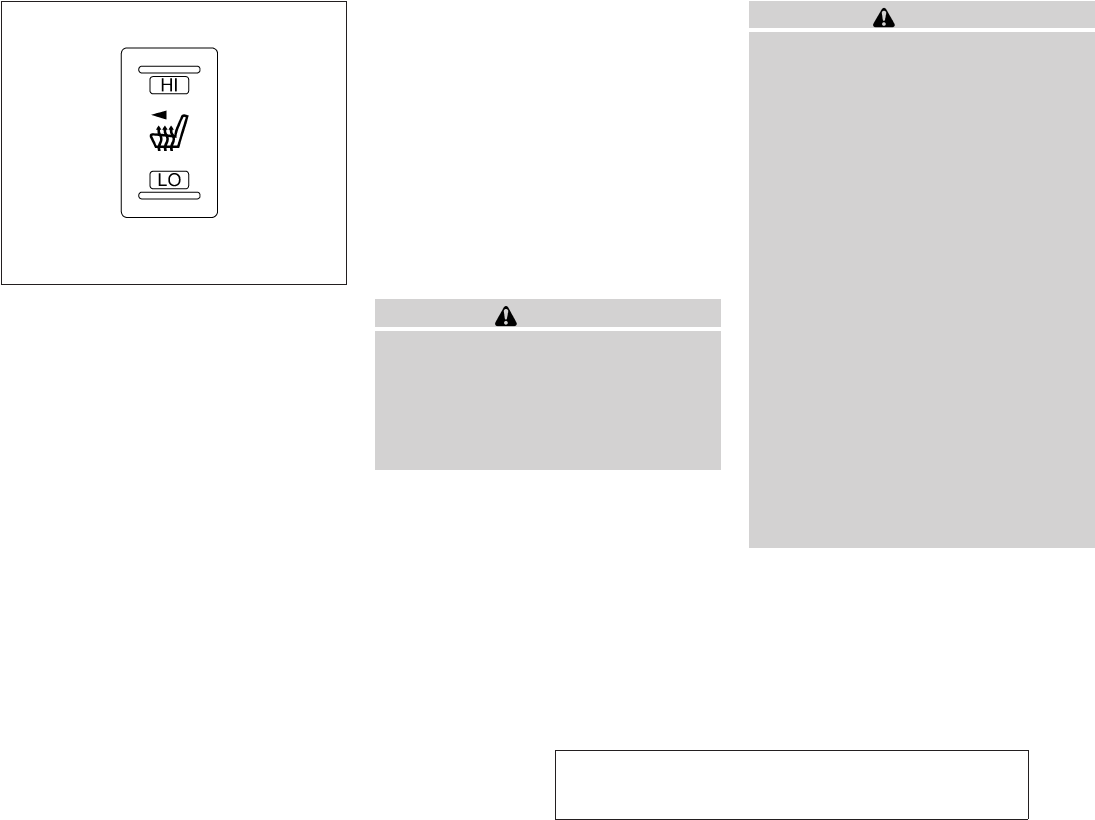
JOBNAME: 1093929-2013-asd-own PAGE: 106 SESS: 4 OUTPUT: Tue Mar 27 10:39:14 2012
The front seats are warmed by built-in heaters.
1. Start the engine.
2. Push the low or high position of the switch,
as desired, depending on the temperature.
The indicator light in the switch will illumi-
nate.
The heater is controlled by a thermostat,
automatically turning the heater on and off.
The indicator light will remain on as long as
the switch is on.
3. When the seat is warmed or before you
leave the vehicle, be sure to turn the switch
off.
WARNING
Do not use or allow occupants to use the
seat heater if you or the occupants cannot
monitor elevated seat temperatures or
have an inability to feel pain in body parts
that contact the seat. Use of the seat
heater by such people could result in se-
rious injury.
CAUTION
●Do not use the seat heater for extended
periods or when no one is using the
seat.
●Do not put anything on the seat which
insulates heat, such as a blanket, cush-
ion, seat cover, etc. Otherwise, the seat
may become overheated.
●Do not place anything hard or heavy on
the seat or pierce it with a pin or similar
object. This may result in damage to the
heater.
●Any liquid spilled on the heated seat
should be removed immediately with a
dry cloth.
●When cleaning the seat, never use
gasoline, benzine, thinner, or any simi-
lar materials.
●If any malfunctions are found or the
heated seat does not operate, turn the
switch off and have the system checked
by your NISSAN dealer.
●The battery could run down if the seat
heater is operated while the engine is
not running.
LIC1543
HEATED SEATS (if so equipped)
2-36 Instruments and controls
ZREVIEW COPY—
2013 Altima Sedan (asd)
Owners Manual—USA_English (nna)
03/24/12—dmoore
X
title will be moved
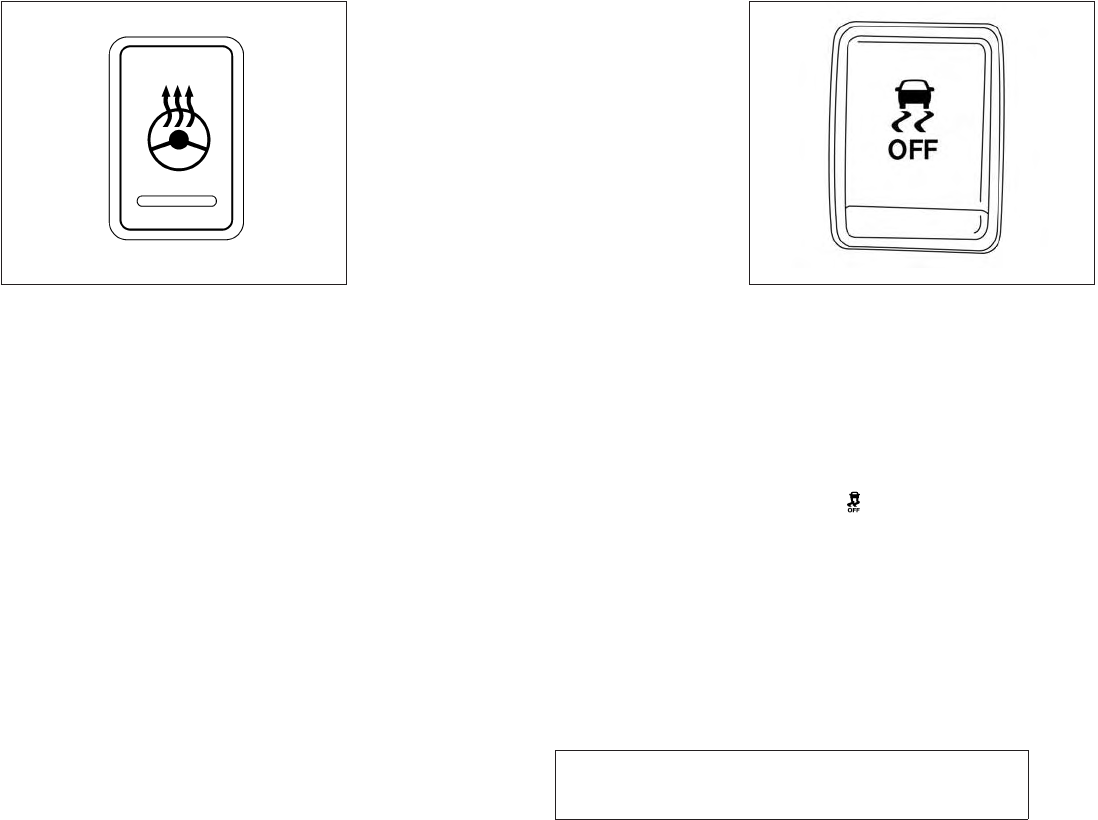
JOBNAME: 1093929-2013-asd-own PAGE: 107 SESS: 4 OUTPUT: Tue Mar 27 10:39:14 2012
The heated steering wheel system is designed to
operate only when the surface temperature of the
steering wheel is below approximately 68°F
(20°C).
Push the heated steering wheel switch to warm
the steering wheel after the engine starts. The
indicator light will come on.
If the surface temperature of the steering wheel is
below 68°F (20°C), the system will heat the
steering wheel to approximately 86°F (30°C),
then turn off automatically.
Push the switch again to turn the heated steering
wheel off manually. The indicator light will go off.
NOTE:
The heated steering wheel switch is
equipped with a 30 minute timer. After the
switch has been activate for 30 minutes,
the system will automatically turn off. If the
surface temperature of the steering wheel
is above 68°F (20°C) when the switch is
turned on, the system will not heat the
steering wheel. This is not a malfunction.
The vehicle should be driven with the Vehicle
Dynamic Control (VDC) system on for most driv-
ing conditions.
If the vehicle is stuck in mud or snow, the VDC
system reduces the engine output to reduce
wheel spin. The engine speed will be reduced
even if the accelerator is depressed to the floor. If
maximum engine power is needed to free a stuck
vehicle, turn the VDC system off.
To turn off the VDC system, push the VDC OFF
switch. The indicator will come on.
Push the VDC OFF switch again or restart the
engine to turn on the system. See “Vehicle Dy-
namic Control (VDC) system”in the “Starting and
driving” section.
LIC0421 LIC2315
HEATED STEERING WHEEL (if so
equipped) VEHICLE DYNAMIC CONTROL (VDC)
OFF SWITCH
Instruments and controls 2-37
ZREVIEW COPY—
2013 Altima Sedan (asd)
Owners Manual—USA_English (nna)
03/24/12—dmoore
X
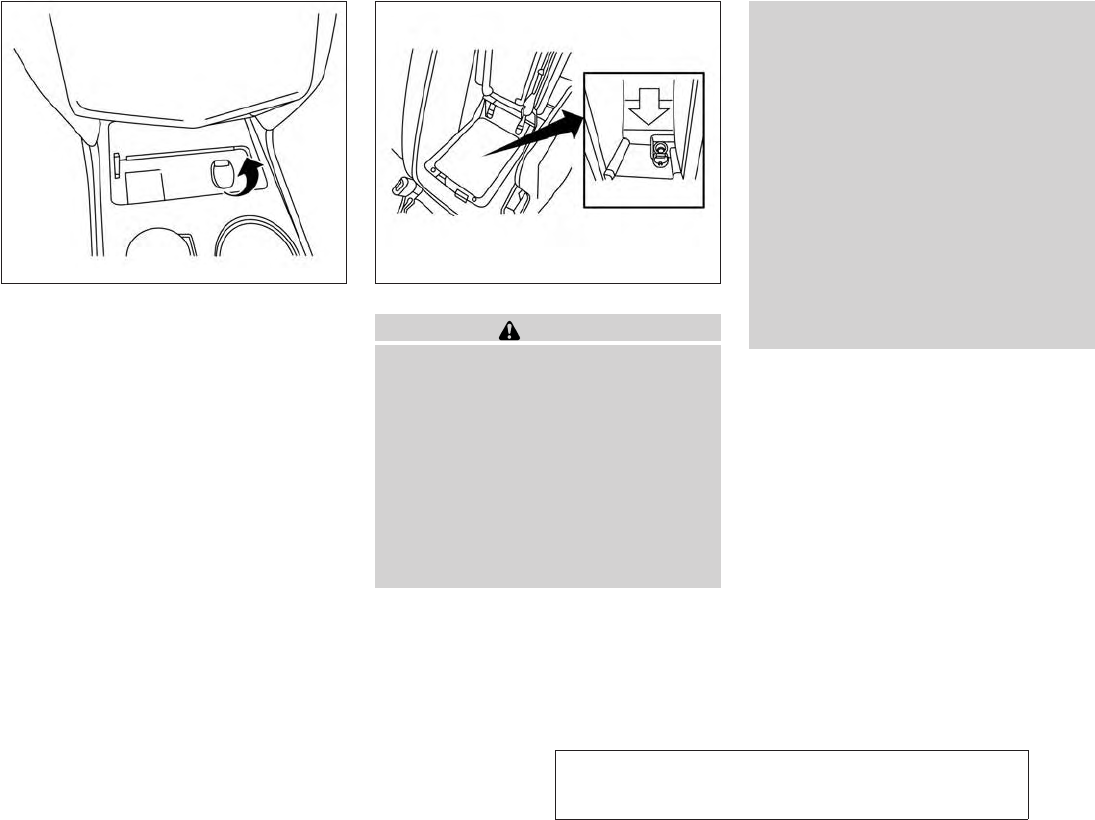
JOBNAME: 1093929-2013-asd-own PAGE: 108 SESS: 4 OUTPUT: Tue Mar 27 10:39:14 2012
The power outlets are for powering electrical
accessories such as cellular telephones. They
are rated at 12 volt, 120W (10A) maximum.
The power outlets are powered only when the
ignition switch is in the ACC or ON position.
Open the lower half of the console box to access
the power outlet. Refer to “Console box” in this
section.
CAUTION
●The outlet and plug may be hot during
or immediately after use.
●Only certain power outlets are designed
for use with a cigarette lighter unit. Do
not use any other power outlet for an
accessory lighter. See your NISSAN
dealer for additional information.
●Do not use with accessories that ex-
ceed a 12 volt, 120W (10A) power draw.
●Do not use double adapters or more
than one electrical accessory.
●Use power outlets with the engine run-
ning to avoid discharging the vehicle
battery.
●Avoid using power outlets when the air
conditioner, headlights or rear window
defroster is on.
●Before inserting or disconnecting a
plug, be sure the electrical accessory
being used is turned OFF.
●Push the plug in as far as it will go. If
good contact is not made, the plug may
overheat or the internal temperature
fuse may open.
●When not in use, be sure to close the
cap. Do not allow water or any other
liquid to contact the outlet.
Instrument panel
LIC2306
Console box
LIC2307
POWER OUTLET
2-38 Instruments and controls
ZREVIEW COPY—
2013 Altima Sedan (asd)
Owners Manual—USA_English (nna)
03/24/12—dmoore
X
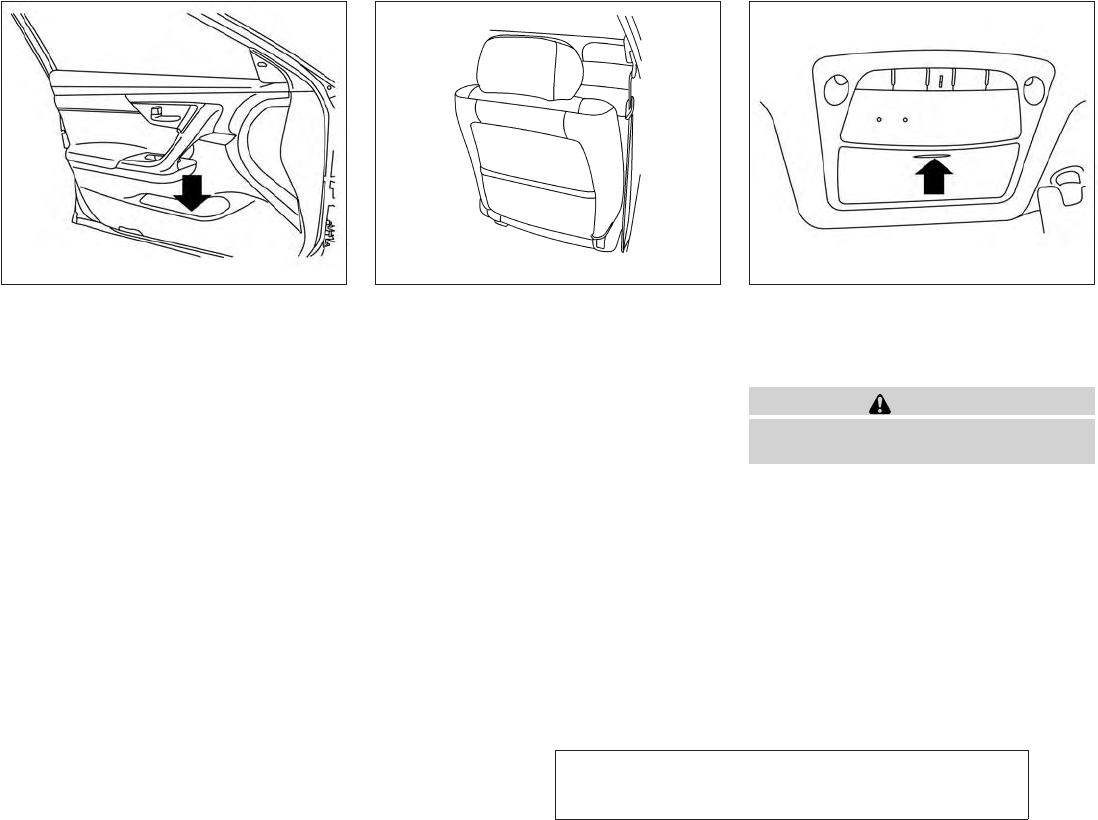
JOBNAME: 1093929-2013-asd-own PAGE: 109 SESS: 4 OUTPUT: Tue Mar 27 10:39:14 2012
MAP POCKETS SEATBACK POCKETS (if so
equipped)
The seatback pockets are located on the back of
the driver’s (if so equipped) and passenger’s
seats. The pockets can be used to store maps.
SUNGLASSES HOLDER
To open the sunglasses holder, push and release.
Only store one pair of sunglasses in the holder.
WARNING
Keep the sunglasses holder closed while
driving to prevent an accident.
LIC2308 LIC0016 LIC2312
STORAGE
Instruments and controls 2-39
ZREVIEW COPY—
2013 Altima Sedan (asd)
Owners Manual—USA_English (nna)
03/24/12—dmoore
X
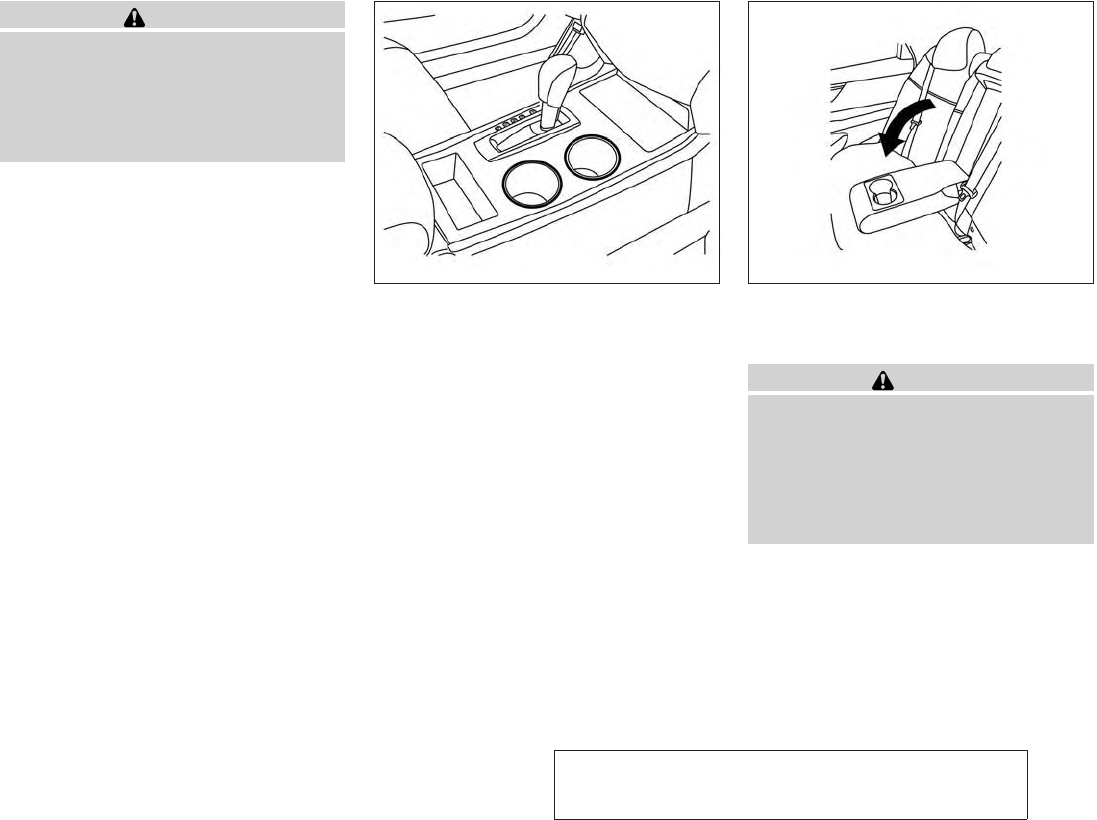
JOBNAME: 1093929-2013-asd-own PAGE: 110 SESS: 4 OUTPUT: Tue Mar 27 10:39:14 2012
CAUTION
●Do not use for anything other than
sunglasses.
●Do not leave sunglasses in the sun-
glasses holder while parking in direct
sunlight. The heat may damage the
sunglasses.
CUP HOLDERS The rear center cup holders are located in the
rear fold-down armrest.
CAUTION
●Avoid abrupt starting and braking when
the cup holder is being used to prevent
spilling the drink. If the liquid is hot, it
can scald you or your passenger.
●Use only soft cups in the cup holder.
Hard objects can injure you in an
accident.
Front
LIC2298
Rear
LIC2297
2-40 Instruments and controls
ZREVIEW COPY—
2013 Altima Sedan (asd)
Owners Manual—USA_English (nna)
03/24/12—dmoore
X
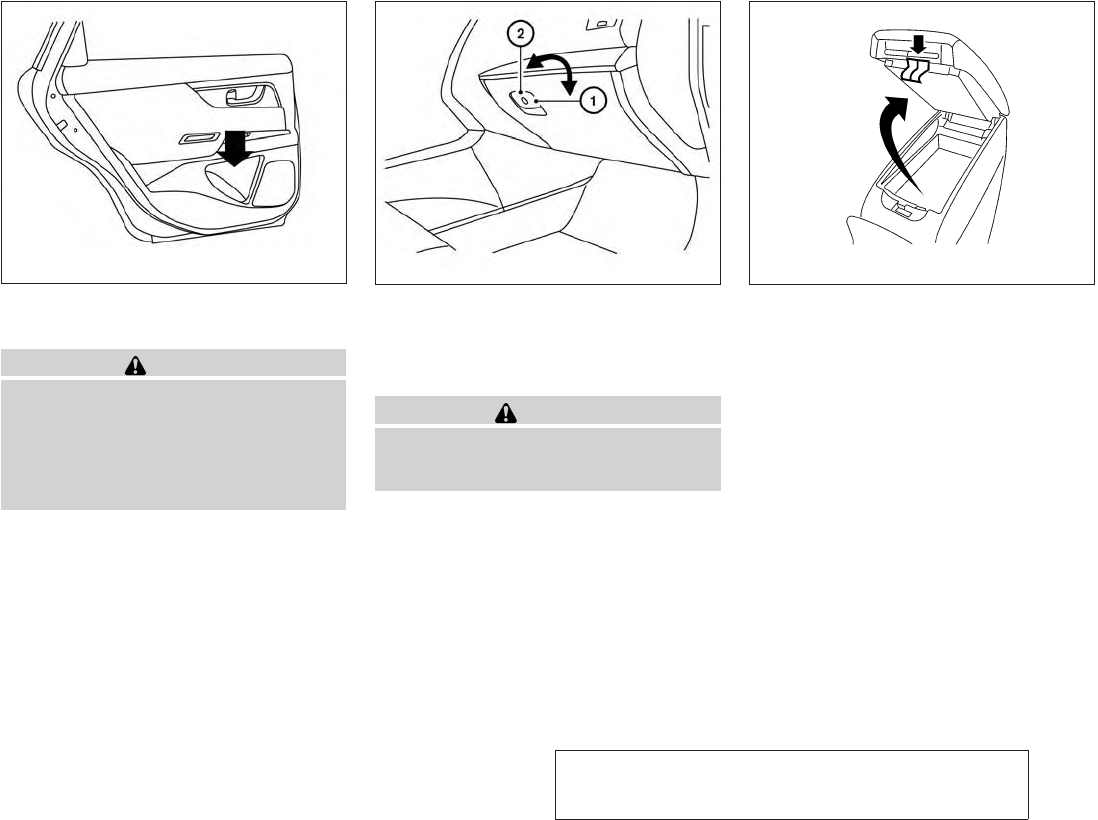
JOBNAME: 1093929-2013-asd-own PAGE: 111 SESS: 4 OUTPUT: Tue Mar 27 10:39:14 2012
Soft bottle holder
CAUTION
●Do not use bottle holder for any other
objects that could be thrown about in
the vehicle and possibly injure people
during sudden braking or an accident.
●Do not use bottle holder for open liquid
containers.
GLOVE BOX
Open the glove box by pulling the handle. Use the
master key when locking s
1or unlocking s
2the
glove box.
WARNING
Keep glove box lid closed while driving to
help prevent injury in an accident or a
sudden stop.
CONSOLE BOX
Upper half
Pull up on the driver’s side latch to open the
upper half of the console box.
The upper half of the console box may be used for
storage of cellular phones. An access hole is
provided at the front of the upper half of the
console box for phone cord routing to the power
outlet.
Soft bottle holder
LIC2296 LIC2300 WIC1120
Instruments and controls 2-41
ZREVIEW COPY—
2013 Altima Sedan (asd)
Owners Manual—USA_English (nna)
03/24/12—dmoore
X
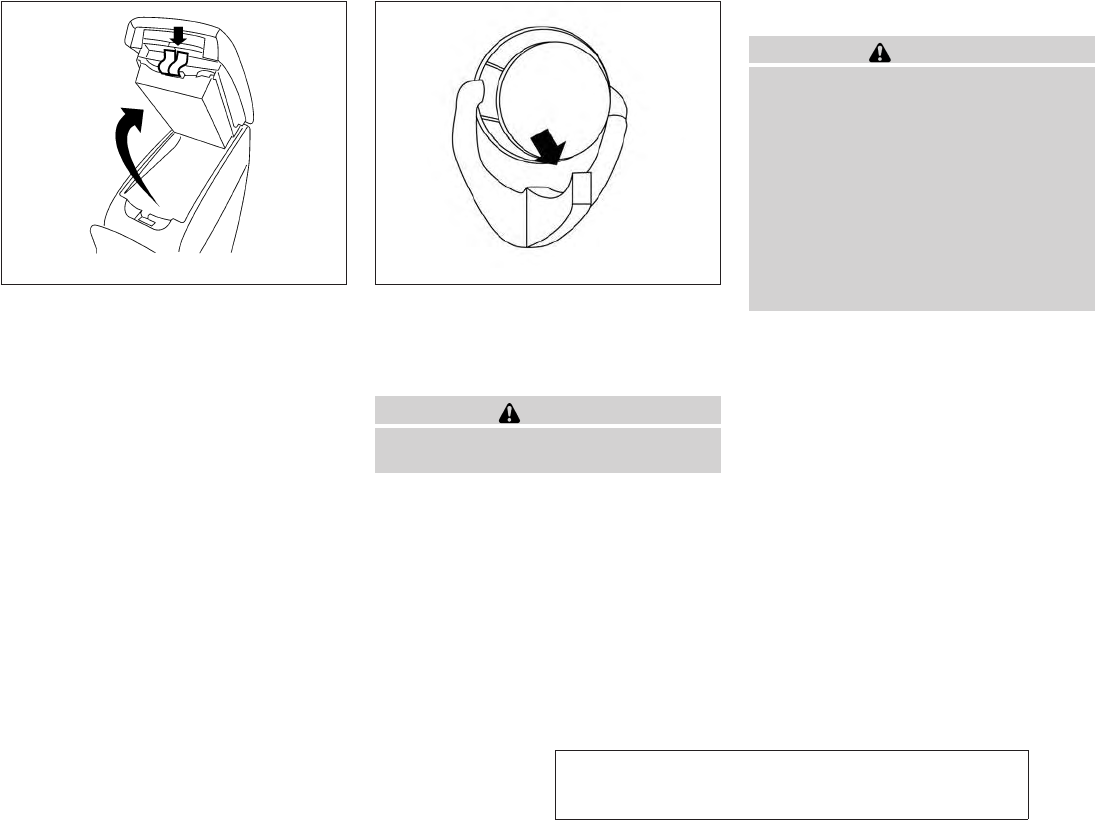
JOBNAME: 1093929-2013-asd-own PAGE: 112 SESS: 4 OUTPUT: Tue Mar 27 10:39:14 2012
Lower half
Pull up on the passenger’s side latch to open the
lower half of the console box. A power outlet is
located inside the console box.
GROCERY HOOKS
The grocery hooks are located in the trunk and
can be used to hang a standard size plastic
grocery bag.
CAUTION
Do not apply a total load of more than 20
lbs (9 kg) to a single grocery hook.
POWER WINDOWS
WARNING
●Make sure that all passengers have
their hands, etc. inside the vehicle while
it is in motion and before closing the
windows. Use the window lock switch
to prevent unexpected use of the power
windows.
●Do not leave children unattended inside
the vehicle. They could unknowingly ac-
tivate switches or controls and become
trapped in a window. Unattended chil-
dren could become involved in serious
accidents.
The power windows operate when the ignition
switch is placed in the ON position, or for a
period of time after the ignition switch is placed in
the OFF position. If the driver’s or passenger’s
door is opened during this period of time, the
power to the windows is canceled.
WIC1121 LIC2362
WINDOWS
2-42 Instruments and controls
ZREVIEW COPY—
2013 Altima Sedan (asd)
Owners Manual—USA_English (nna)
03/24/12—dmoore
X
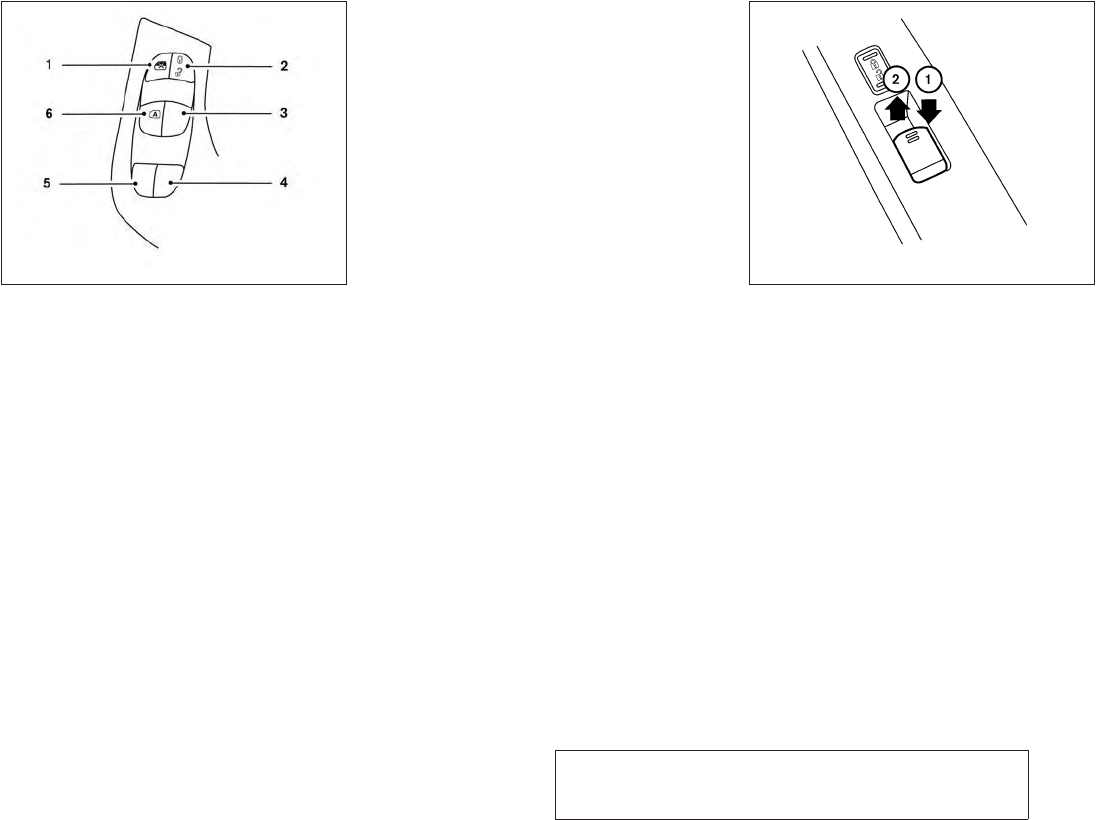
JOBNAME: 1093929-2013-asd-own PAGE: 113 SESS: 4 OUTPUT: Tue Mar 27 10:39:14 2012
1. Window lock button
2. Power door lock switch
3. Front passenger side (automatic opera-
tion if so equipped)
4. Right rear passenger side
5. Left rear passenger side
6. Driver side automatic switch
Driver’s side power window switch
The driver’s side control panel is equipped with
switches to open or close all of the windows.
To open a window, push the switch to the first
detent and continue to hold down until the de-
sired window position is reached. To close a
window, pull the switch to the first detent and
continue to hold up until the desired window
position is reached.
Front passenger’s power window
switch
The passenger’s window switch operates only
the corresponding passenger’s window. To open
the window, push the switch to the first detent
and continue to hold it down until the desired
window position is reached s
1. To close the
window, pull the switch to the first detent and
continue to hold it up until the desired window
position is reached s
2.
LIC2299 WIC1129
Instruments and controls 2-43
ZREVIEW COPY—
2013 Altima Sedan (asd)
Owners Manual—USA_English (nna)
03/24/12—dmoore
X
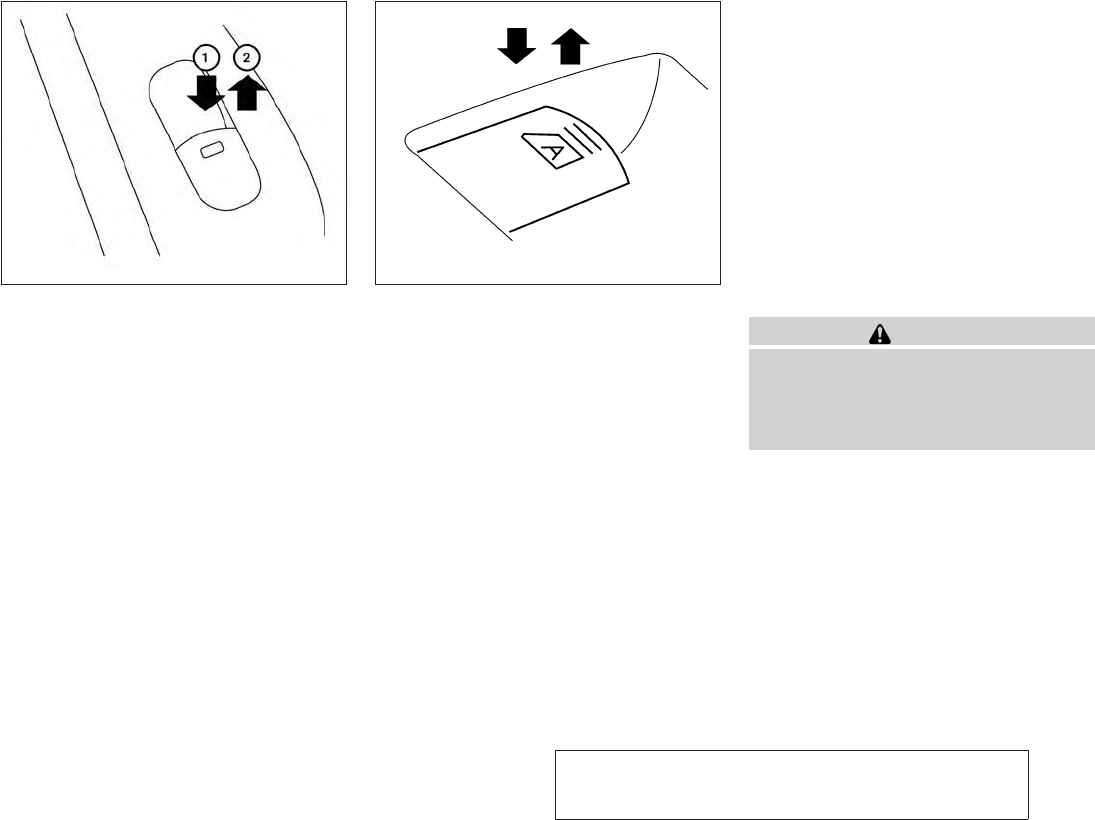
JOBNAME: 1093929-2013-asd-own PAGE: 114 SESS: 4 OUTPUT: Tue Mar 27 10:39:14 2012
Rear power window switch
The rear power window switches open or close
only the corresponding windows. To open the
window, push the switch and hold it down s
1. To
close the window, pull the switch up s
2.
Locking passengers’ windows
When the window lock button is depressed, only
the driver’s side window can be opened or
closed. Push it again to cancel the window lock
function.
Automatic operation
To fully open a window equipped with automatic
operation, press the window switch down (only
driver’s side shown) to the second detent and
release it; it need not be held. The window auto-
matically opens all the way. To stop the window,
lift the switch up while the window is opening.
To fully close a window equipped with automatic
operation, pull the switch up to the second detent
and release it; it need not be held. To stop the
window, press the switch down while the window
is closing.
Auto-reverse function
If the control unit detects something caught in the
window as it is closing, the window will be imme-
diately lowered.
The auto-reverse function can be activated when
the window is closed by automatic operation
when the ignition switch is placed in the ON
position or for a period of time after the ignition
switch is placed in the OFF position.
Depending on the environment or driving
conditions, the auto-reverse function may
be activated if an impact or load similar to
something being caught in the window oc-
curs.
WARNING
There are some small distances immedi-
ately before the closed position which
cannot be detected. Make sure that all
passengers have their hands, etc., inside
the vehicle before closing the window.
When the automatic operation for the
power window switch does not
operate
If the automatic operation does not operate prop-
erly, perform the following procedure to initialize
the power window switch.
LIC2311 LIC0410
2-44 Instruments and controls
ZREVIEW COPY—
2013 Altima Sedan (asd)
Owners Manual—USA_English (nna)
03/24/12—dmoore
X
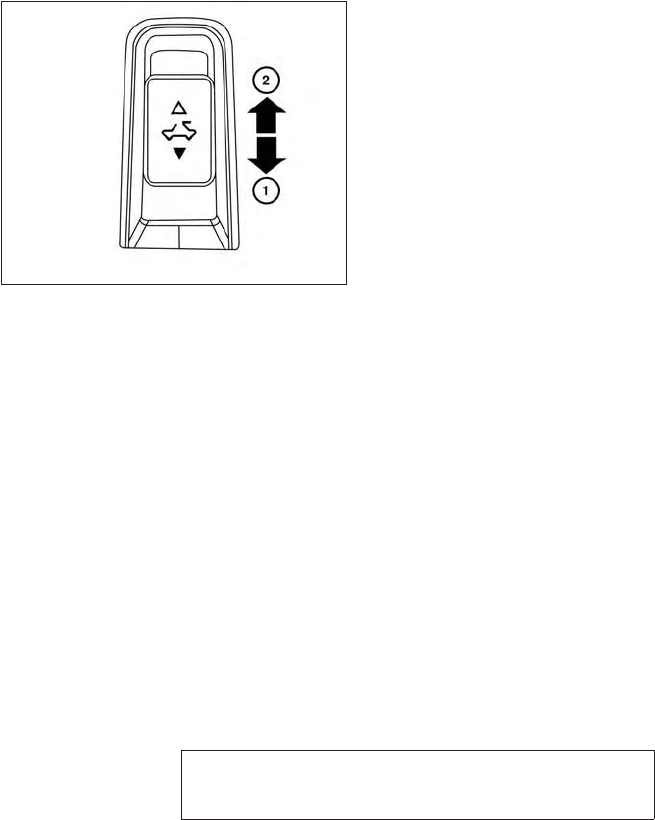
JOBNAME: 1093929-2013-asd-own PAGE: 115 SESS: 4 OUTPUT: Tue Mar 27 10:39:14 2012
1. Place the ignition switch in the ON position.
2. Press and hold the driver’s window switch
down until the window opens completely.
3. Release the switch.
4. Pull and hold the driver’s window switch up
to the second detent until the window glass
has reached the full close position. Con-
tinue to hold the window switch in the
up position for 5 seconds after the win-
dow glass has reached the full close
position. (It is necessary for this entire step
to be completed with one continuous pull of
the window switch.)
5. Release the switch.
Initialization is now complete. The automatic op-
eration for the power window switch should now
operate.
If the automatic operation does not operate prop-
erly after performing the above procedure, see a
NISSAN dealer for assistance.
No initialization is required for all the other win-
dow switches.
AUTOMATIC MOONROOF
The moonroof will only operate when the ignition
switch is placed in the ON position. The auto-
matic moonroof is operational for a period of time,
even if the ignition switch is placed in the ACC or
OFF position. If the driver’s door or the front
passenger’s door is opened during this period of
time, the power to the moonroof is canceled.
Sliding the moonroof
To fully open or close the moonroof, push the
switch to the open s
2or close s
1position and
release it; it need not be held. The roof will
automatically open or close all the way. To stop
the roof, push the switch once more while it is
opening or closing.
Tilting the moonroof
To tilt up, first close the moonroof, then push the
switch to the tilt up position s
1and release it; it
need not be held. To tilt down the moonroof, push
the switch to the tilt down position s
2.
Resetting the moonroof switch
If the moonroof does not operate properly, per-
form the following procedure to initialize the
moonroof operation system.
1. If the moonroof is open, close it fully by
repeatedly pushing the moonroof switch to
the close position s
1to tilt the moonroof up.
2. Push and hold the switch to the close posi-
tion s
1.
3. Release the moonroof switch after the
moonroof moves slightly up and down.
4. Push and hold the switch to the open posi-
tion s
2to fully tilt the moonroof down.
5. Check if the moonroof switch operates nor-
mally.
LIC2313
MOONROOF (if so equipped)
Instruments and controls 2-45
ZREVIEW COPY—
2013 Altima Sedan (asd)
Owners Manual—USA_English (nna)
03/24/12—dmoore
X

JOBNAME: 1093929-2013-asd-own PAGE: 116 SESS: 4 OUTPUT: Tue Mar 27 10:39:14 2012
If the moonroof does not operate properly after
performing the procedure above, have your ve-
hicle checked by an NISSAN dealer.
Auto-reverse function (when closing or
tilting down the moonroof)
The auto-reverse function can be activated when
the moonroof is closed or tilted down by auto-
matic operation when the ignition switch is
placed in the ON position or for a period of time
after the ignition switch is placed in the OFF
position.
Depending on the environment or driving
conditions, the auto-reverse function may
be activated if an impact or load similar to
something being caught in the moonroof
occurs.
WARNING
There are some small distances immedi-
ately before the closed position which
cannot be detected. Make sure that all
passengers have their hands, etc., inside
the vehicle before closing the moonroof.
When closing:
If the control unit detects something caught in the
moonroof as it moves to the front, the moonroof
will immediately open backward.
When tilting down:
If the control unit detects something caught in the
moonroof as it tilts down, the moonroof will im-
mediately tilt up.
If the auto-reverse function malfunctions and re-
peats opening or tilting up the moonroof, keep
pushing the tilt down switch within 5 seconds
after it happens; the moonroof will fully close
gradually. Make sure nothing is caught in the
moonroof.
WARNING
●In an accident you could be thrown from
the vehicle through an open moonroof.
Always use seat belts and child
restraints.
●Do not allow anyone to stand up or
extend any portion of their body out of
the moonroof opening while the vehicle
is in motion or while the moonroof is
closing.
CAUTION
●Remove water drops, snow, ice or sand
from the moonroof before opening.
●Do not place heavy objects on the
moonroof or surrounding area.
Sunshade
Open and close the sunshade by sliding it for-
ward or backward.
If the moonroof does not close
Have your NISSAN dealer check and repair the
moonroof.
2-46 Instruments and controls
ZREVIEW COPY—
2013 Altima Sedan (asd)
Owners Manual—USA_English (nna)
03/24/12—dmoore
X
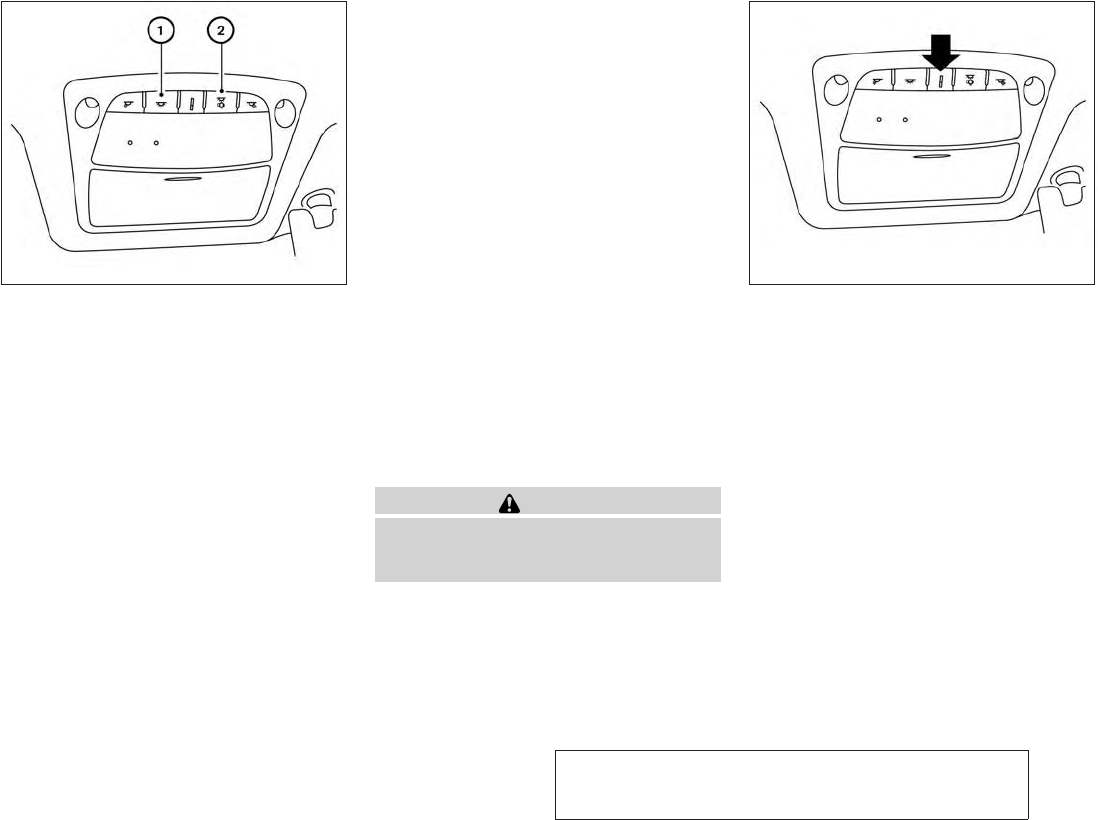
JOBNAME: 1093929-2013-asd-own PAGE: 117 SESS: 4 OUTPUT: Tue Mar 27 10:39:14 2012
s
1The interior light can be turned ON regard-
less of door position. The light will go off after
a period of time unless the ignition switch is
placed in the ON position when any door is
opened.
s
2The interior lights can be set to operate
when the doors are opened. To turn off the
interior lights when a door open, push the
switch, the interior lights will not illuminate,
regardless of door position.
The lights will go off when the ignition switch
is placed in the ON position, or the driver’s
door is closed and locked. The lights will also
go off after a period of time when the doors
are open.
NOTE:
The step lights illuminate when the driver
and passenger doors are opened regard-
less of the interior light switch position.
These lights will turn off automatically after
a period of time while doors are open to
prevent the battery from becoming dis-
charged.
CAUTION
Do not use for extended periods of time
with the engine stopped. This could result
in a discharged battery.
CONSOLE LIGHT (if so equipped)
The console light will turn on whenever the park-
ing lights or headlights are illuminated.
LIC2302 LIC2303
INTERIOR LIGHT
Instruments and controls 2-47
ZREVIEW COPY—
2013 Altima Sedan (asd)
Owners Manual—USA_English (nna)
03/24/12—dmoore
X
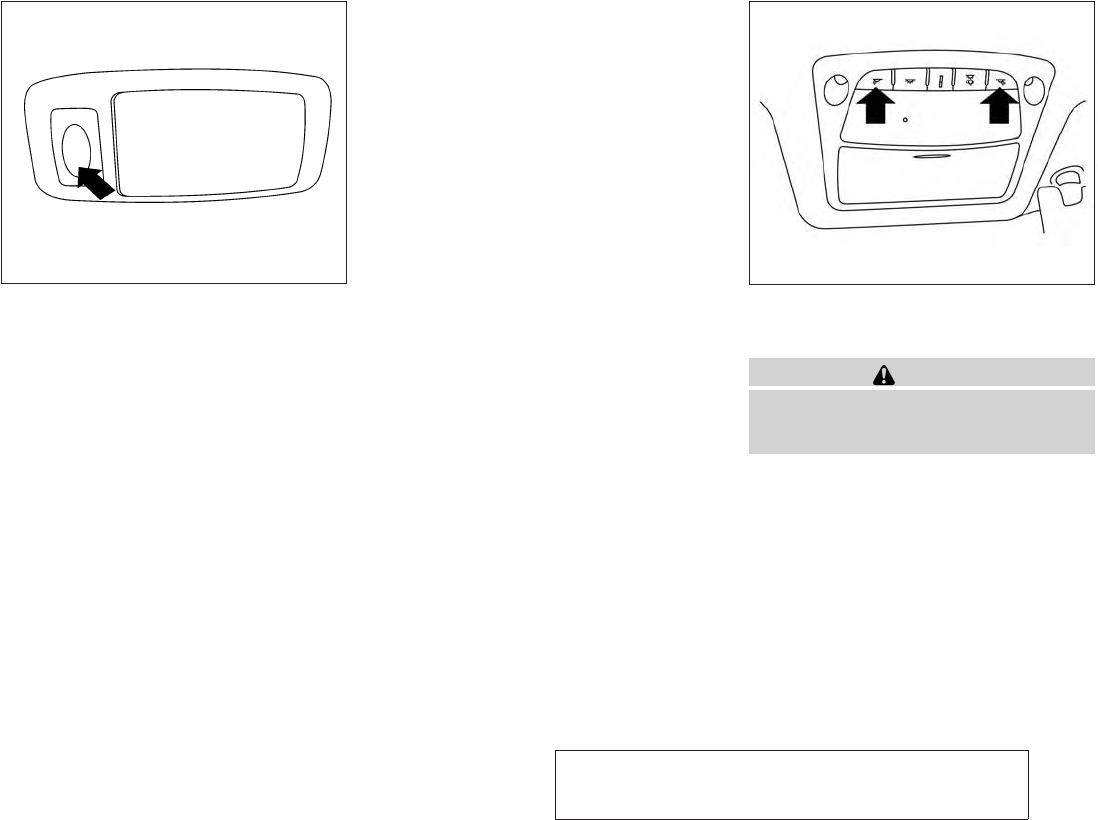
JOBNAME: 1093929-2013-asd-own PAGE: 118 SESS: 4 OUTPUT: Tue Mar 27 10:39:14 2012
To turn the rear personal lights on, press the
switch. To turn them off, press the switch again.
Push the button to turn the map lights on. To turn
them off, press the button again.
CAUTION
Do not use for extended periods of time
with the engine stopped. This could result
in a discharged battery.
Rear personal lights
LIC1083 LIC2304
PERSONAL LIGHTS MAP LIGHTS
2-48 Instruments and controls
ZREVIEW COPY—
2013 Altima Sedan (asd)
Owners Manual—USA_English (nna)
03/24/12—dmoore
X
title will be moved

JOBNAME: 1093929-2013-asd-own PAGE: 119 SESS: 4 OUTPUT: Tue Mar 27 10:39:14 2012
The light illuminates when the trunk lid is opened.
When the trunk lid is closed, the light goes off.
The light will go off after a period of time if the
trunk lid is left open, unless the ignition switch is
placed in the ON position.
For bulb replacement procedures, refer to “Exte-
rior and interior lights” in the “Maintenance and
do-it-yourself” section of this manual.
The HomeLinkTUniversal Transceiver provides a
convenient way to consolidate the functions of up
to three individual hand-held transmitters into
one built-in device.
HomeLinkTUniversal Transceiver:
●Will operate most Radio Frequency (RF)
devices such as garage doors, gates, home
and office lighting, entry door locks and se-
curity systems.
●Is powered by your vehicle’s battery. No
separate batteries are required. If the vehi-
cle’s battery is discharged or is discon-
nected, HomeLinkTwill retain all program-
ming.
When the HomeLinkTUniversal Trans-
ceiver is programmed, retain the original
transmitter for future programming proce-
dures (Example: new vehicle purchases).
Upon sale of the vehicle, the programmed
HomeLinkTUniversal Transceiver buttons
should be erased for security purposes. For
additional information, refer to “Program-
ming HomeLinkT” later in this section.
WARNING
●Do not use the HomeLinkTUniversal
Transceiver with any garage door
opener that lacks safety stop and re-
verse features as required by federal
safety standards. (These standards be-
came effective for opener models
manufactured after April 1, 1982). A ga-
rage door opener which cannot detect
an object in the path of a closing garage
door and then automatically stop and
reverse, does not meet current federal
safety standards. Using a garage door
opener without these features in-
creases the risk of serious injury or
death.
●During the programming procedure
your garage door or security gate will
open and close (if the transmitter is
within range). Make sure that people or
objects are clear of the garage door,
gate, etc. that you are programming.
●Your vehicle’s engine should be turned
off while programming the HomeLinkT
Universal Transceiver. Do not breathe
exhaust gases; they contain colorless
and odorless carbon monoxide. Carbon
monoxide is dangerous. It can cause
unconsciousness or death.
TRUNK LIGHT HOMELINKTUNIVERSAL
TRANSCEIVER (if so equipped)
Instruments and controls 2-49
ZREVIEW COPY—
2013 Altima Sedan (asd)
Owners Manual—USA_English (nna)
03/24/12—dmoore
X
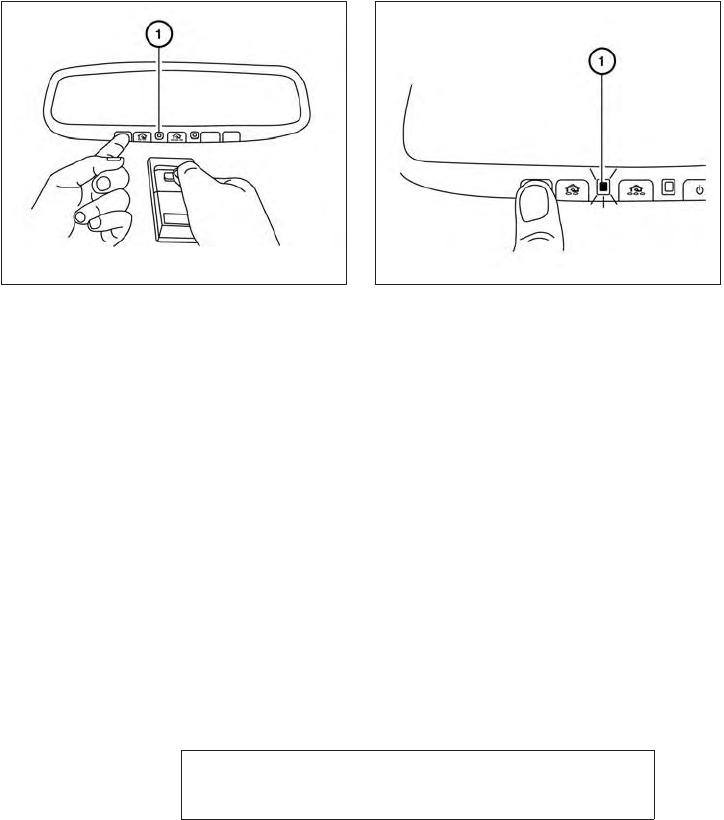
JOBNAME: 1093929-2013-asd-own PAGE: 120 SESS: 4 OUTPUT: Tue Mar 27 10:39:14 2012
PROGRAMMING HOMELINKT
If you have any questions or are having difficulty
programming your HomeLinkTbuttons, refer to
the HomeLinkTweb site at: www.homelink.com
or call 1-800-355-3515.
NOTE:
It is also recommended that a new battery
be placed in the hand-held transmitter of
the device being programmed to
HomeLinkTfor quicker programming and
accurate transmission of the radio-
frequency.
1. Position the end of your hand-held transmit-
ter 1–3 inches (5–14 cm) away from the
HomeLinkTsurface, keeping the HomeLinkT
indicator light s
1in view.
2. Using both hands, simultaneously press and
hold the desired HomeLinkTbutton and
handheld transmitter button. DO NOT re-
lease until the HomeLinkTindicator light s
1
flashes slowly and then rapidly. When the
indicator light flashes rapidly, both buttons
may be released. (The rapid flashing indi-
cates successful programming.)
NOTE:
Some devices may require you to replace
Step 2 with the cycling procedure noted in
the “Programing HomeLinkTfor Canadian
customers and gate openers” section.
3. Press and hold the programmed HomeLinkT
button and observe the indicator light.
●If the indicator light s
1is
solid/continuous, programming is
complete and your device should acti-
vate when the HomeLinkTbutton is
pressed and released.
●If the indicator light s
1blinks rapidly for
two seconds and then turns to a
solid/continuous light, continue
with Steps 4-6 for a rolling code device.
A second person may make the following
steps easier. Use a ladder or other device.
Do not stand on your vehicle to perform
the next steps.
LIC2365 LIC2366
2-50 Instruments and controls
ZREVIEW COPY—
2013 Altima Sedan (asd)
Owners Manual—USA_English (nna)
03/24/12—dmoore
X

JOBNAME: 1093929-2013-asd-own PAGE: 121 SESS: 4 OUTPUT: Tue Mar 27 10:39:14 2012
4. At the receiver located on the garage door
opener motor in the garage, locate the
“learn”or “smart”button (the name and color
of the button may vary by manufacturer but it
is usually located near where the hanging
antenna wire is attached to the unit). If there
is difficulty locating the button, reference the
garage door opener’s manual.
5. Press and release the “learn” or “smart” but-
ton.
6. Return to the vehicle and firmly press and
hold the trained HomeLinkTbutton for two
seconds and release. Repeat the
“press/hold/release” sequence up to 3
times to complete the training process.
HomeLinkTshould now activate your rolling
code equipped device.
7. If you have any questions or are having diffi-
culty programming your HomeLinkTbuttons,
refer to the HomeLinkTweb site at:
www.homelink.com or call 1-800-355-
3515.
PROGRAMMING HOMELINKTFOR
CANADIAN CUSTOMERS AND
GATE OPENERS
Canadian radio-frequency laws require transmit-
ter signals to “time-out” (or quit) after several
seconds of transmission – which may not be long
enough for HomeLinkTto pick up the signal
during training. Similar to this Canadian law,
some U.S. gate operators are designed to “tim-
eout” in the same manner.
If you live in Canada or you are having difficulties
training a gate operator or garage door opener
by using the “Training” procedures, replace
“Programming HomeLinkT”Step 2 with the fol-
lowing:
NOTE:
When programming a garage door opener,
etc., unplug the device during the “cycling”
process to prevent possible damage to the
garage door opener components.
1. See “Programing HomeLinkT” step 1 earlier
in this section.
2. Using both hands, simultaneously press and
hold the desired HomeLinkTbutton and the
hand-held transmitter button. During train-
ing, your hand-held transmitter may auto-
matically stop transmitting. Continue to
press and hold the desired HomeLinkTbut-
ton while you press and re-press (“cycle”)
your hand-held transmitter every two sec-
onds until the frequency signal has been
learned. The HomeLinkTindicator light will
flash slowly and then rapidly after several
seconds upon successful training. DO NOT
release until the HomeLinkTindicator light
flashes slowly and then rapidly. When the
indicator light flashes rapidly, both buttons
may be released. The rapid flashing indi-
cates successful training.
Proceed with “Programming HomeLinkT”
step 3 to complete.
If the device was unplugged during the pro-
gramming procedure, remember to plug it
back in when programming is completed.
OPERATING THE HOMELINKT
UNIVERSAL TRANSCEIVER
The HomeLinkTUniversal Transceiver, after it is
programmed, can be used to activate the pro-
grammed device. To operate, simply press and
release the appropriate programmed HomeLinkT
Universal Transceiver button. The amber indica-
tor light will illuminate while the signal is being
transmitted.
For convenience, the hand-held transmitter of the
device may also be used at any time.
Instruments and controls 2-51
ZREVIEW COPY—
2013 Altima Sedan (asd)
Owners Manual—USA_English (nna)
03/24/12—dmoore
X

JOBNAME: 1093929-2013-asd-own PAGE: 122 SESS: 4 OUTPUT: Tue Mar 27 10:39:14 2012
PROGRAMMING TROUBLE-
DIAGNOSIS
If the HomeLinkTdoes not quickly learn the hand-
held transmitter information:
●replace the hand-held transmitter batteries
with new batteries.
●position the hand-held transmitter with its
battery area facing away from the
HomeLinkTsurface.
●press and hold both the HomeLinkTand
hand-held transmitter buttons without inter-
ruption.
●position the hand-held transmitter 1 - 3
inches (26 - 76 mm) away from the
HomeLinkTsurface. Hold the transmitter in
that position for up to 15 seconds. If
HomeLinkTis not programmed within that
time, try holding the transmitter in another
position – keeping the indicator light in view
at all times.
If you have any questions or are having difficulty
programming your HomeLinkTbuttons, refer to
the HomeLinkTweb site at: www.homelink.com
or call 1-800-355-3515.
CLEARING THE PROGRAMMED
INFORMATION
The following procedure clears the programmed
information from both buttons. Individual buttons
cannot be cleared. However, individual buttons
can be reprogrammed, see “Reprogramming a
single HomeLinkTbutton” in this section.
To clear all programming:
1. Press and hold the two outer HomeLinkT
buttons until the indicator light begins to
flash in approximately 10 seconds. Do not
hold for longer than 20 seconds.
2. Release both buttons.
HomeLinkTis now in the programming mode and
can be programmed at any time beginning with
“Programming HomeLinkT” - Step 1.
REPROGRAMMING A SINGLE
HOMELINKTBUTTON
To reprogram a HomeLinkTUniversal Transceiver
button, complete the following:
1. Press and hold the desired HomeLinkTbut-
ton. DO NOT release the button.
2. The indicator light will begin to flash after 20
seconds. Without releasing the HomeLinkT
button, proceed with “Programming
HomeLinkT” - Step 1.
For questions or comments, contact HomeLinkT
at: www.homelink.com or 1–800–355–3515.
The HomeLinkTUniversal Transceiver button has
now been reprogrammed. The new device can
be activated by pushing the HomeLinkTbutton
that was just programmed. This procedure will
not affect any other programmed HomeLinkT
buttons.
IF YOUR VEHICLE IS STOLEN
If your vehicle is stolen, you should change the
codes of any non-rolling code device that has
been programmed into HomeLinkT. Consult the
Owner’s Manual of each device or call the manu-
facturer or dealer of those devices for additional
information.
When your vehicle is recovered, you will
need to reprogram the HomeLinkTUniver-
sal Transceiver with your new transmitter
information.
2-52 Instruments and controls
ZREVIEW COPY—
2013 Altima Sedan (asd)
Owners Manual—USA_English (nna)
03/24/12—dmoore
X

JOBNAME: 1093929-2013-asd-own PAGE: 123 SESS: 4 OUTPUT: Tue Mar 27 10:39:14 2012
FCC Notice:
For USA:
This device complies with Part 15 of the
FCC Rules. Operation is subject to the fol-
lowing two conditions: (1) This device may
not cause harmful interference, and (2) this
device must accept any interference re-
ceived, including interference that may
cause undesired operation. Note: Changes
or modifications not expressly approved by
the party responsible for compliance could
void the user’s authority to operate the
equipment.
For Canada:
This device complies with RSS-210 of In-
dustry Canada. Operation is subject to the
following two conditions: (1) this device
may not cause interference, and (2) this
device must accept any interference, in-
cluding interference that may cause unde-
sired operation of the device.
Instruments and controls 2-53
ZREVIEW COPY—
2013 Altima Sedan (asd)
Owners Manual—USA_English (nna)
03/24/12—dmoore
X

JOBNAME: 1093929-2013-asd-own PAGE: 124 SESS: 4 OUTPUT: Tue Mar 27 10:39:14 2012
MEMO
2-54 Instruments and controls
ZREVIEW COPY—
2013 Altima Sedan (asd)
Owners Manual—USA_English (nna)
03/24/12—dmoore
X

JOBNAME: 1093929-2013-asd-own PAGE: 125 SESS: 5 OUTPUT: Tue Mar 27 10:39:14 2012
3 Pre-driving checks and adjustments
Keys.............................................3-2
NISSAN Intelligent KeyT........................3-2
NISSAN Vehicle Immobilizer System keys . . . . . . . . . 3-3
Doors............................................3-4
Lockingwithkey................................3-4
Locking with inside lock knob . . . . . . . . . . . . . . . . . . . . 3-5
Locking with power door lock switch . . . . . . . . . . . . . 3-5
Automaticdoorlocks ...........................3-5
Child safety rear door lock. . . . . . . . . . . . . . . . . . . . . . . 3-6
NISSAN Intelligent KeyTWith Door and Trunk
RequestSwitches.................................3-6
Operatingrange................................3-8
Door locks/unlocks precaution . . . . . . . . . . . . . . . . . . . 3-9
NISSAN Intelligent KeyToperation ...............3-9
How to use the remote keyless entry
function......................................3-13
Warningsignals...............................3-16
Troubleshooting guide . . . . . . . . . . . . . . . . . . . . . . . . .3-16
NISSAN Intelligent KeyTWithout Door and Trunk
RequestSwitches................................3-18
Operatingrange...............................3-19
How to use the remote keyless entry
function......................................3-19
Warningsignals...............................3-23
Troubleshooting guide . . . . . . . . . . . . . . . . . . . . . . . . .3-24
Remote Engine Start (if so equipped) . . . . . . . . . . . . . . .3-25
Remote engine start operating range . . . . . . . . . . . .3-25
Remote starting the vehicle . . . . . . . . . . . . . . . . . . . . .3-25
Extending engine run time . . . . . . . . . . . . . . . . . . . . . . 3-26
Canceling a remote start . . . . . . . . . . . . . . . . . . . . . . . 3-26
Conditions the remote start will not work . . . . . . . . .3-26
Hood . . . . . . . . . . . . . . . . . . . . . . . . . . . . . . . . . . . . . . . . . . . 3-27
Trunk lid . . . . . . . . . . . . . . . . . . . . . . . . . . . . . . . . . . . . . . . . .3-27
Openeroperation..............................3-28
Interior trunk lid release . . . . . . . . . . . . . . . . . . . . . . . . 3-29
Fuel-filler door . . . . . . . . . . . . . . . . . . . . . . . . . . . . . . . . . . .3-30
Openeroperation..............................3-30
Fuel-filler cap . . . . . . . . . . . . . . . . . . . . . . . . . . . . . . . . . 3-30
Tilt/telescopic steering . . . . . . . . . . . . . . . . . . . . . . . . . . . . 3-32
Tilt operation . . . . . . . . . . . . . . . . . . . . . . . . . . . . . . . . . .3-32
Telescopic operation. . . . . . . . . . . . . . . . . . . . . . . . . . . 3-32
Sun visors . . . . . . . . . . . . . . . . . . . . . . . . . . . . . . . . . . . . . . .3-32
Vanity mirrors . . . . . . . . . . . . . . . . . . . . . . . . . . . . . . . . .3-33
Mirrors . . . . . . . . . . . . . . . . . . . . . . . . . . . . . . . . . . . . . . . . . .3-33
Rearview mirror (if so equipped). . . . . . . . . . . . . . . . . 3-33
Automatic anti-glare rearview mirror
(ifsoequipped)...............................3-34
Outsidemirrors ...............................3-35
ZREVIEW COPY—
2013 Altima Sedan (asd)
Owners Manual—USA_English (nna)
03/24/12—dmoore
X
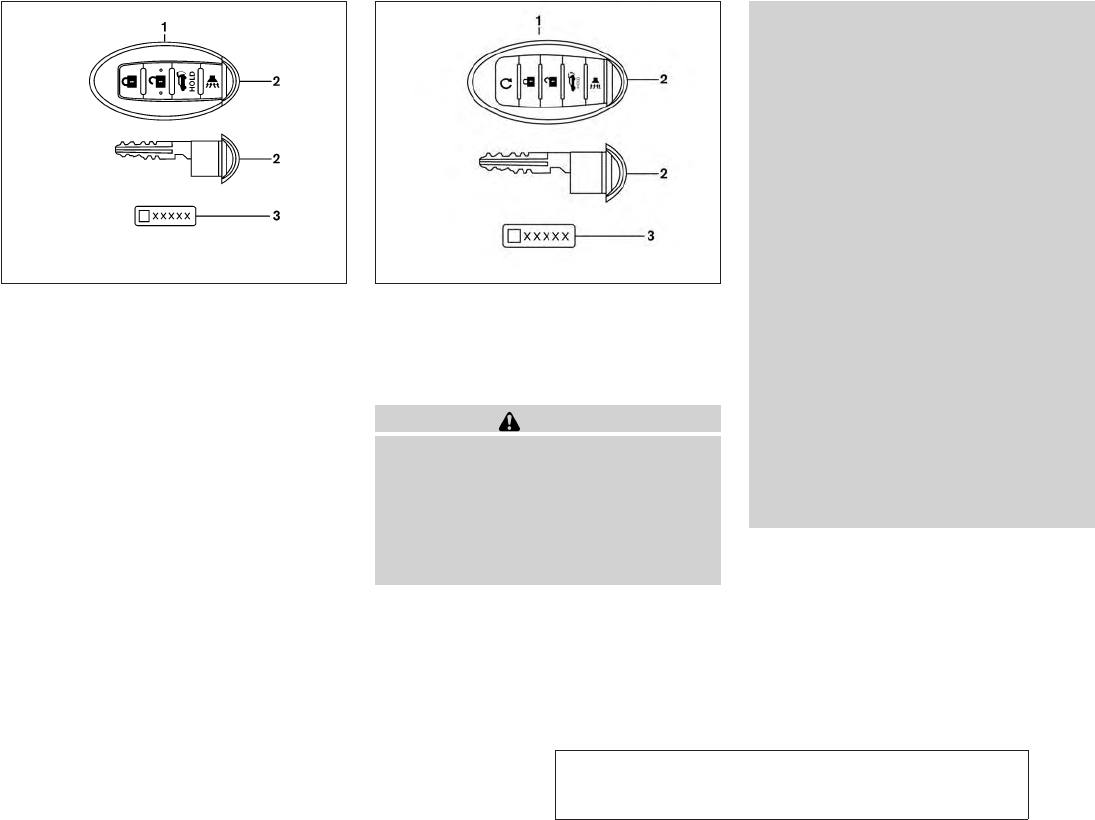
JOBNAME: 1093929-2013-asd-own PAGE: 126 SESS: 4 OUTPUT: Tue Mar 27 10:39:14 2012
1. Intelligent Key (2 sets)
2. Mechanical key
3. Key number plate (1 plate)
NISSAN INTELLIGENT KEYT
Your vehicle can only be driven with the Intelligent
Keys which are registered to your vehicle’s Intel-
ligent Key system components and NISSAN Ve-
hicle Immobilizer System components. As many
as 4 Intelligent Keys can be registered and used
with one vehicle. The new keys must be regis-
tered by an NISSAN dealer prior to use with the
Intelligent Key system and NISSAN Vehicle Im-
mobilizer System of your vehicle. Since the reg-
istration process requires erasing all memory in
the Intelligent Key components when registering
new keys, be sure to take all Intelligent Keys that
you have to the NISSAN dealer.
CAUTION
Listed below are conditions or occurrences
which will damage the Intelligent Key:
●Do not allow the Intelligent Key, which
contains electrical components, to
come into contact with water or salt
water. This could affect the system
function.
●Do not drop the Intelligent Key.
●Do not strike the Intelligent Key sharply
against another object.
●Do not change or modify the Intelligent
Key.
●Wetting may damage the Intelligent
Key. If the Intelligent Key gets wet, im-
mediately wipe until it is completely dry.
●Do not place the Intelligent Key for an
extended period in an area where tem-
peratures exceed 140°F (60°C).
●Do not attach the Intelligent Key with a
key holder that contains a magnet.
●Do not place the Intelligent Key near
equipment that produces a magnetic
field, such as a TV, audio equipment and
personal computers.
If an Intelligent Key is lost or stolen,
NISSAN recommends erasing the ID code
of that Intelligent Key from the vehicle.
This may prevent the unauthorized use of
the Intelligent Key to operate the vehicle.
For information regarding the erasing
procedure, contact an NISSAN dealer.
Type A
WPD0427
Type B
LPD2052
KEYS
3-2 Pre-driving checks and adjustments
ZREVIEW COPY—
2013 Altima Sedan (asd)
Owners Manual—USA_English (nna)
03/24/12—dmoore
X
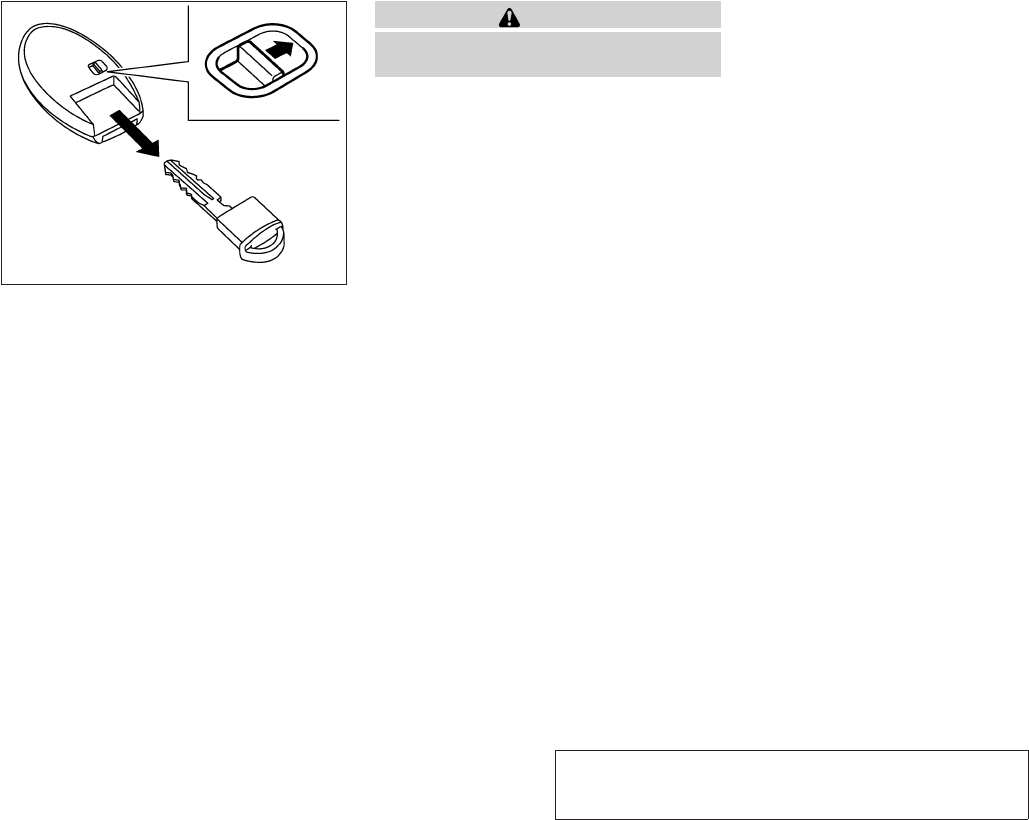
JOBNAME: 1093929-2013-asd-own PAGE: 127 SESS: 4 OUTPUT: Tue Mar 27 10:39:14 2012
Mechanical key
The Intelligent Key contains the mechanical key.
To remove the mechanical key, release the lock
knob on the back of the Intelligent Key.
To install the mechanical key, firmly insert it into
the Intelligent Key until the lock knob returns to
the lock position.
Use the mechanical key to lock or unlock the
doors, glove box and rear seatback lock.
See “Doors” in this section, “Storage” in the
“Instruments and controls” section, and “Seats”
in the “Safety — Seats, seat belts and supple-
mental restraint system” section of this manual.
CAUTION
Always carry the mechanical key installed
in the Intelligent Key slot.
Valet hand-off
When you have to leave a key with a valet, give
them the Intelligent Key itself and keep the me-
chanical key with you to protect your belongings.
To prevent the glove box and the trunk from being
opened during valet hand-off, follow the proce-
dures below:
1. Push the trunk cancel switch to the OFF
position.
2. Remove the mechanical key from the Intelli-
gent Key.
3. Lock the glove box and the rear seats with
the mechanical key.
4. Hand the Intelligent Key to the valet and
keep the mechanical key with you.
See “Storage” in the “Instruments and controls”
section and “Seats” in the “Safety — seats, seat
belts and supplemental restraint system” section.
NISSAN VEHICLE IMMOBILIZER
SYSTEM KEYS
You can only drive your vehicle using the master
keys which are registered to the NISSAN Vehicle
Immobilizer System components in your vehicle.
The master key can be used for all the locks.
Never leave these keys in the vehicle.
Additional or replacement keys:
If you still have a key, the key number is not
necessary when you need extra NISSAN Vehicle
Immobilizer System keys. Your dealer can dupli-
cate your existing key. This is because the regis-
tration process will erase the memory of all key
codes previously registered into the NISSAN Ve-
hicle Immobilizer System.
Do not allow the immobilizer system key, which
contains an electrical transponder, to come into
contact with water or salt water. This could affect
system function.
SPA1951
Pre-driving checks and adjustments 3-3
ZREVIEW COPY—
2013 Altima Sedan (asd)
Owners Manual—USA_English (nna)
03/24/12—dmoore
X
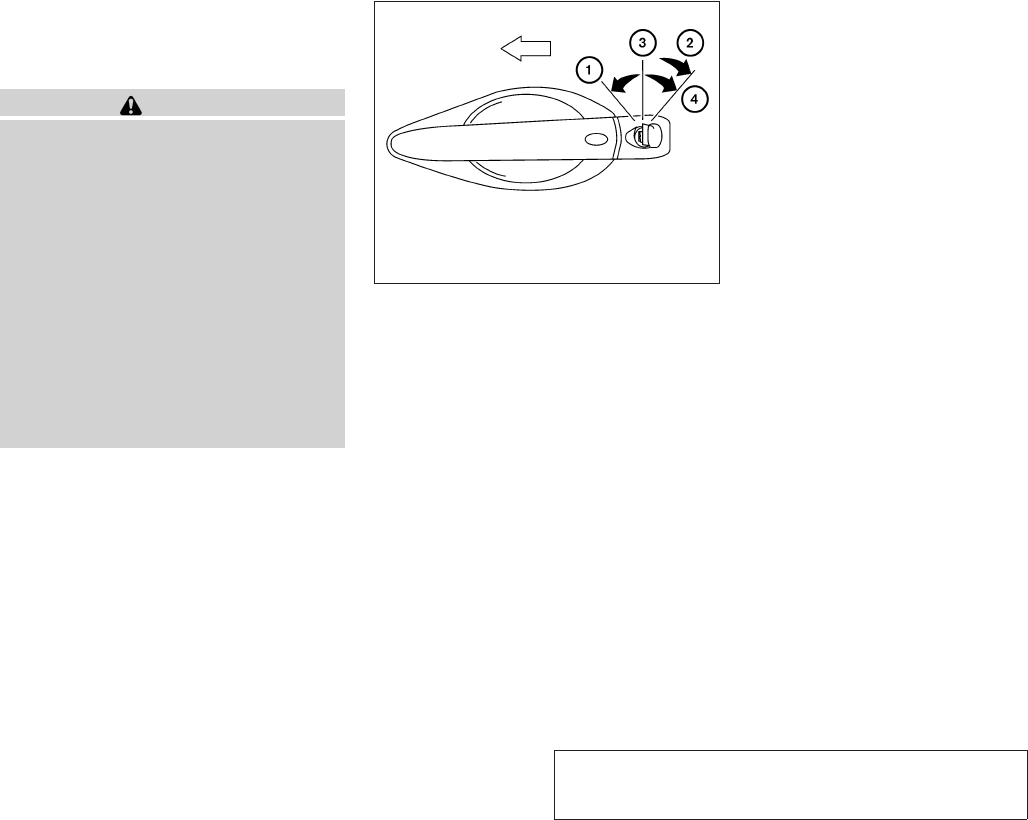
JOBNAME: 1093929-2013-asd-own PAGE: 128 SESS: 4 OUTPUT: Tue Mar 27 10:39:14 2012
When the doors are locked using one of the
following methods, the doors can not be opened
using the inside or outside door handles. The
doors must be unlocked to open the doors.
WARNING
●Always have the doors locked while
driving. Along with the use of seat belts,
this provides greater safety in the event
of an accident by helping to prevent
persons from being thrown from the
vehicle. This also helps keep children
and others from unintentionally open-
ing the doors, and will help keep out
intruders.
●Before opening any door, always look
for and avoid oncoming traffic.
●Do not leave children unattended inside
the vehicle. They could unknowingly ac-
tivate switches or controls. Unattended
children could become involved in seri-
ous accidents.
LOCKING WITH KEY
The power door lock system allows you to lock or
unlock all doors at the same time.
Turning the key toward the front s
1of the vehicle
locks all doors.
Turning the key one time toward the rear s
2of the
vehicle unlocks that door. From that position,
returning the key to neutral s
3(where the key can
only be removed and inserted) and turning it
toward the rear again within 5 seconds unlocks
all doors s
4.
Opening and closing windows (if so
equipped)
The driver’s door key operation allows you to
open and close windows equipped with auto-
matic operation at the same time.
●To open the windows, turn the driver’s door
key toward the rear of the vehicle for longer
than 1 second after the door is unlocked.
●To close the windows, turn the driver’s door
key toward the front of the vehicle for longer
than 1 second after the door is locked.
Windows stop when the key cylinder is released.
Driver’s side
LPD0461
DOORS
3-4 Pre-driving checks and adjustments
ZREVIEW COPY—
2013 Altima Sedan (asd)
Owners Manual—USA_English (nna)
03/24/12—dmoore
X
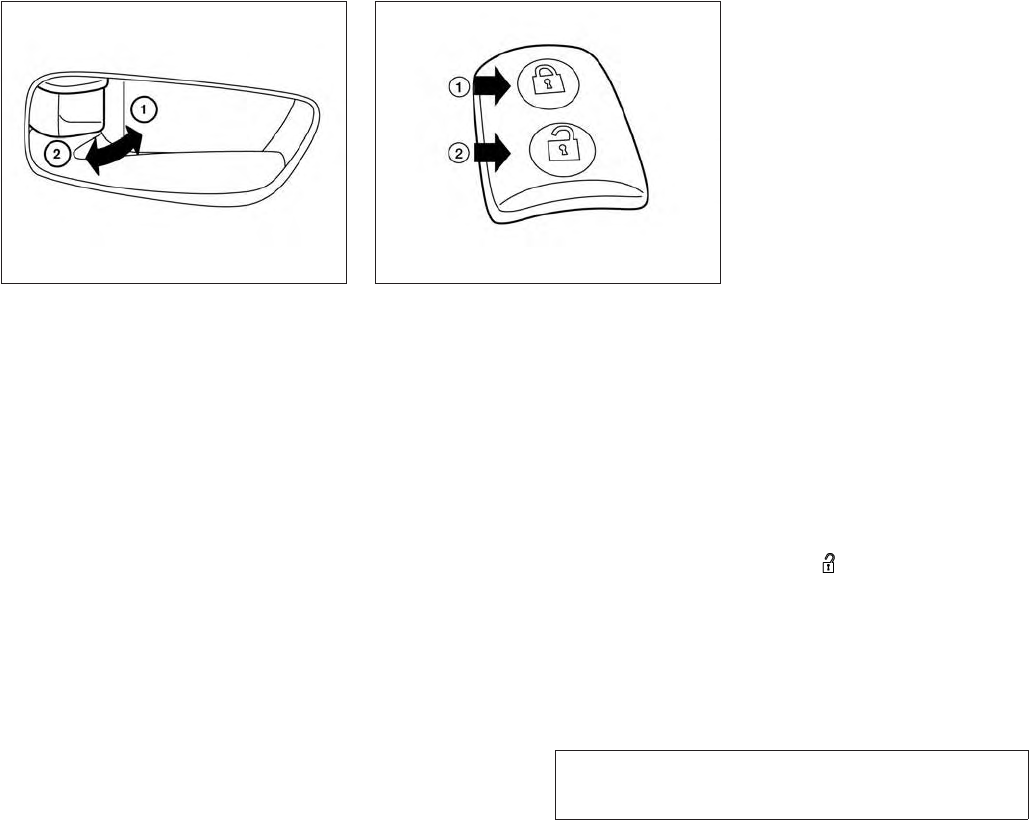
JOBNAME: 1093929-2013-asd-own PAGE: 129 SESS: 4 OUTPUT: Tue Mar 27 10:39:14 2012
LOCKING WITH INSIDE LOCK
KNOB
To lock the door without the key, move the inside
lock knob to the lock position s
1, then close the
door.
To unlock the door without the key, move the
inside lock knob to the unlock position s
2.
LOCKING WITH POWER DOOR
LOCK SWITCH
To lock all the doors without a key, push the door
lock switch (driver’s or front passenger’s side) to
the lock position s
1. When locking the door this
way, be certain not to leave the key inside the
vehicle.
To unlock all the doors without a key, push the
door lock switch (driver’s or front passenger’s
side) to the unlock position s
2.
Lockout protection
When the power door lock switch is moved to the
lock position and any door is open, all doors will
lock and unlock automatically. With the Intelligent
Key left in the vehicle and any door is open, all
doors will unlock automatically and a chime will
sound after the door is closed.
These functions help to prevent the Intelligent
Key from being accidentally locked inside the
vehicle.
AUTOMATIC DOOR LOCKS
●All doors lock automatically when the vehicle
speed reaches 15 MPH (24 km/h).
●All doors unlock automatically when the ig-
nition is placed in the OFF position.
The automatic unlock function can be de-
activated or activated. To deactivate or acti-
vate the automatic door unlock system, perform
the following procedure:
1. Close all doors.
2. Place the ignition switch in the ON position.
3. Within 20 seconds of performing Step 2,
push and hold the power door lock switch to
the position (UNLOCK) for more than
5 seconds.
Inside lock
LPD2092
Door lock switch
LPD2093
Pre-driving checks and adjustments 3-5
ZREVIEW COPY—
2013 Altima Sedan (asd)
Owners Manual—USA_English (nna)
03/24/12—dmoore
X
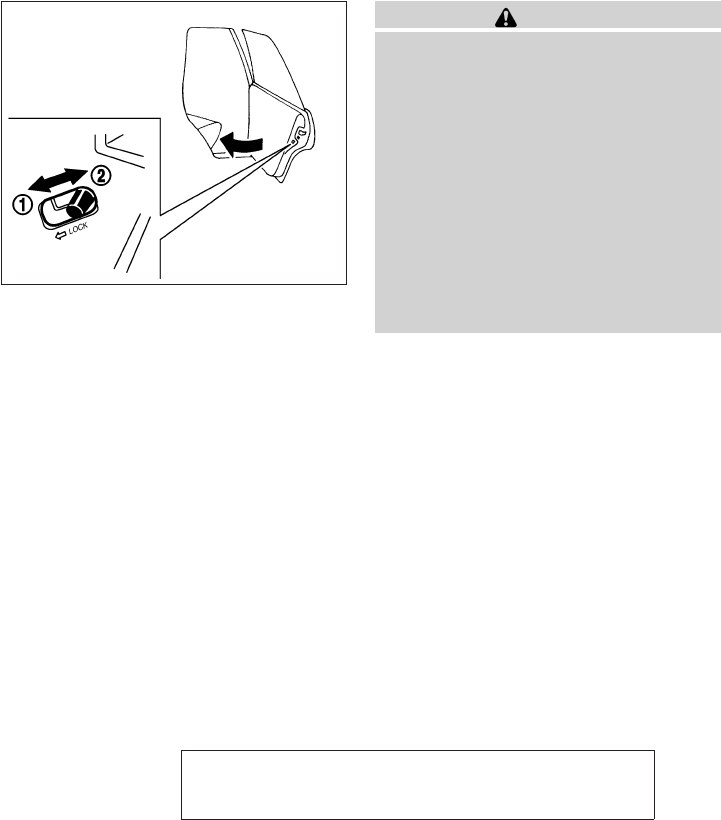
JOBNAME: 1093929-2013-asd-own PAGE: 130 SESS: 4 OUTPUT: Tue Mar 27 10:39:14 2012
4. When activated, the hazard indicator will
flash twice. When deactivated, the hazard
indicator will flash once.
5. The ignition switch must be placed in the
OFF and ON position again between each
setting change.
When the automatic door unlock system is deac-
tivated, the doors do not unlock when the ignition
switch is placed in the OFF position. To unlock
the door manually, use the inside lock knob or the
power door lock switch (driver’s or front passen-
ger’s side).
NOTE:
The automatic door unlock function can be
changed using the Vehicle Settings in the
vehicle information display. The “Auto
Door Unlock” choices are:
●Off
●IGN OFF
●Shift into P
CHILD SAFETY REAR DOOR LOCK
Child safety locks help prevent the rear doors
from being opened accidentally, especially when
small children are in the vehicle.
The child safety lock levers are located on the
edge of the rear doors.
When the lever is in the unlock position s
2, the
door can be opened from the outside or the
inside.
When the lever is in the LOCK position s
1,
the door can be opened only from the out-
side.
WARNING
●Radio waves could adversely affect
electric medical equipment. Those who
use a pacemaker should contact the
electric medical equipment manufac-
turer for the possible influences before
use.
●The Intelligent Key transmits radio
waves when the buttons are pressed.
The FAA advises the radio waves may
affect aircraft navigation and communi-
cation systems. Do not operate the In-
telligent Key while on an airplane. Make
sure the buttons are not operated unin-
tentionally when the unit is stored for a
flight.
The Intelligent Key can operate all the door locks
using the remote controller function or pushing
the request switch on the vehicle without taking
the key out from a pocket or purse. The operating
environment and/or conditions may affect the
Intelligent Key operation.
Be sure to read the following before using the
Intelligent Key.
SPA2037
NISSAN INTELLIGENT KEYTWITH
DOOR AND TRUNK REQUEST
SWITCHES
3-6 Pre-driving checks and adjustments
ZREVIEW COPY—
2013 Altima Sedan (asd)
Owners Manual—USA_English (nna)
03/24/12—dmoore
X

JOBNAME: 1093929-2013-asd-own PAGE: 131 SESS: 4 OUTPUT: Tue Mar 27 10:39:14 2012
CAUTION
●Be sure to carry the Intelligent Key with
you when operating the vehicle.
●Never leave the Intelligent Key in the
vehicle when you leave the vehicle.
The Intelligent Key is always communicating with
the vehicle as it receives radio waves. The Intel-
ligent Key transmits weak radio waves. Environ-
mental conditions may interfere with the opera-
tion of the Intelligent Key under the following
operating conditions:
●When operating near a location where
strong radio waves are transmitted, such as
a TV tower, power station and broadcasting
station.
●When in possession of wireless equipment,
such as a cellular telephone, transceiver,
and CB radio.
●When the Intelligent Key is in contact with or
covered by metallic materials.
●When any type of radio wave remote control
is used nearby.
●When the Intelligent Key is placed near an
electric appliance such as a personal com-
puter.
●When the vehicle is parked near a parking
meter.
In such cases, correct the operating conditions
before using the Intelligent Key function or use
the mechanical key.
Although the life of the battery varies depending
on the operating conditions, the battery’s life is
approximately 2 years. If the battery is dis-
charged, replace it with a new one.
When the Intelligent Key battery is low, an indi-
cator illuminates in the Vehicle Information Dis-
play. See “Vehicle Information Display” in the
“Instruments and controls” section.
Since the Intelligent Key is continuously receiving
radio waves, if the key is left near equipment
which transmits strong radio waves, such as sig-
nals from a TV and personal computer, the bat-
tery life may become shorter.
For information regarding replacement of a bat-
tery, see “Battery replacement” in the “Mainte-
nance and do-it-yourself” section.
As many as 4 Intelligent Keys can be registered
and used with one vehicle. For information about
the purchase and use of additional Intelligent
Keys, contact a NISSAN dealer.
CAUTION
Listed below are conditions or occur-
rences which will damage the Intelligent
Key:
●Do not allow the Intelligent Key, which
contains electrical components, to
come into contact with water or salt
water. This could affect the system
function.
●Do not drop the Intelligent Key.
●Do not strike the Intelligent Key sharply
against another object.
●Do not change or modify the Intelligent
Key.
●Wetting may damage the Intelligent
Key. If the Intelligent Key gets wet, im-
mediately wipe until it is completely dry.
●Do not place the Intelligent Key for an
extended period in an area where tem-
peratures exceed 140°F (60°C).
●Do not attach the Intelligent Key with a
key holder that contains a magnet.
●Do not place the Intelligent Key near
equipment that produces a magnetic
field, such as a TV, audio equipment and
personal computers.
Pre-driving checks and adjustments 3-7
ZREVIEW COPY—
2013 Altima Sedan (asd)
Owners Manual—USA_English (nna)
03/24/12—dmoore
X
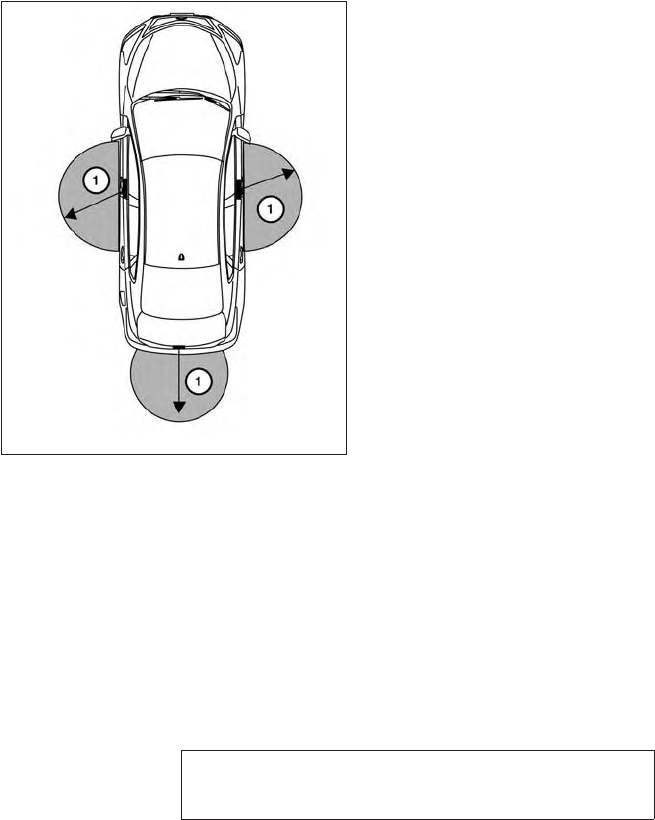
JOBNAME: 1093929-2013-asd-own PAGE: 132 SESS: 4 OUTPUT: Tue Mar 27 10:39:14 2012
If an Intelligent Key is lost or stolen, NISSAN
recommends erasing the ID code of that Intelli-
gent Key from the vehicle. This may prevent the
unauthorized use of the Intelligent Key to operate
the vehicle. For information regarding the erasing
procedure, contact a NISSAN dealer.
OPERATING RANGE
The Intelligent Key functions can only be used
when the Intelligent Key is within the specified
operating range from the request switch s
1.
When the Intelligent Key battery is discharged or
strong radio waves are present near the operat-
ing location, the Intelligent Key system’s operat-
ing range becomes narrower, and the Intelligent
Key may not function properly.
The operating range is within 31.50 in (80 cm)
from each request switch s
1.
If the Intelligent Key is too close to the door glass,
handle or rear bumper, the request switches may
not function.
When the Intelligent Key is within the operating
range, it is possible for anyone, even someone
who does not carry the Intelligent Key, to push the
request switch to lock/unlock the doors.
LPD2073
3-8 Pre-driving checks and adjustments
ZREVIEW COPY—
2013 Altima Sedan (asd)
Owners Manual—USA_English (nna)
03/24/12—dmoore
X
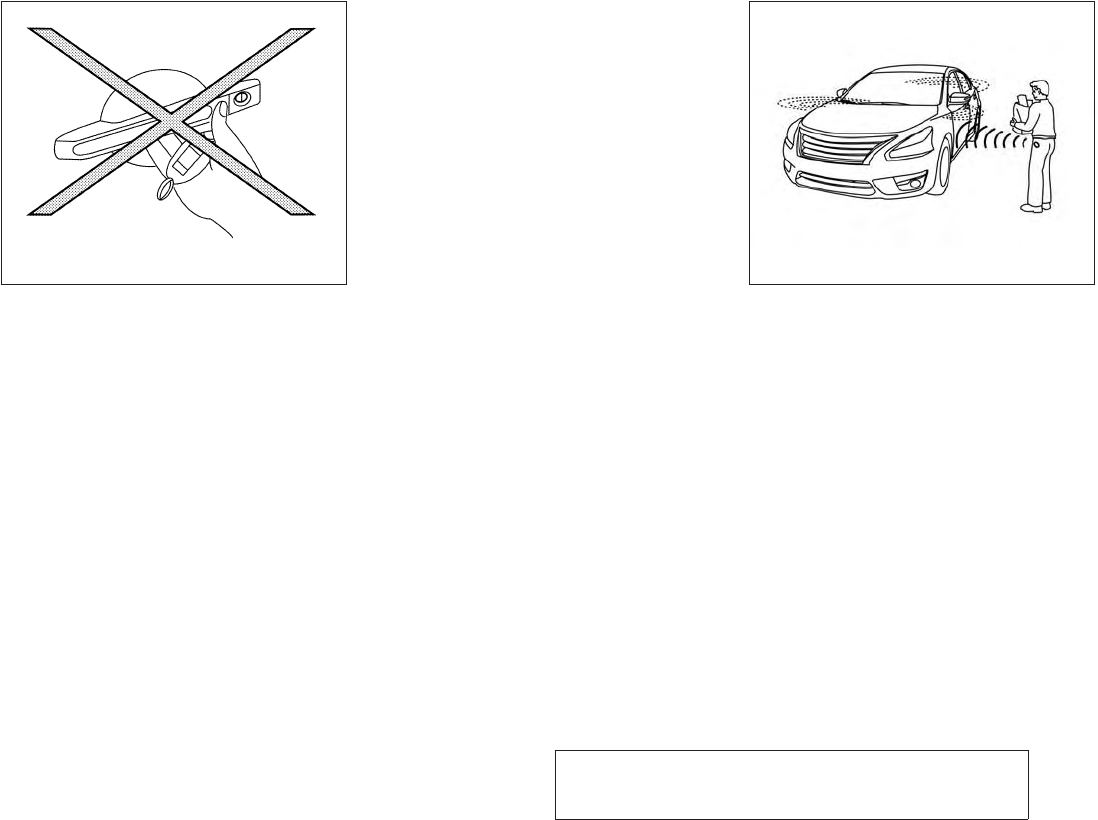
JOBNAME: 1093929-2013-asd-own PAGE: 133 SESS: 4 OUTPUT: Tue Mar 27 10:39:14 2012
DOOR LOCKS/UNLOCKS
PRECAUTION
●Do not push the door handle request switch
with the Intelligent Key held in your hand as
illustrated. The close distance to the door
handle will cause the Intelligent Key system
to have difficulty recognizing that the Intelli-
gent Key is outside the vehicle.
●After locking with the door handle request
switch, verify the doors are securely locked
by testing them.
●To prevent the Intelligent Key from being left
inside the vehicle, make sure you carry the
Intelligent Key with you and then lock the
doors.
●Do not pull the door handle before pushing
the door handle request switch. The door
will be unlocked but will not open. Release
the door handle once and pull it again to
open the door.
NISSAN INTELLIGENT KEYT
OPERATION
You can lock or unlock the doors without taking
the key out of your pocket or bag.
When you carry the Intelligent Key with you, you
can lock or unlock all doors by pushing the door
handle request switch within the range of opera-
tion.
WPD0375 LPD2074
Pre-driving checks and adjustments 3-9
ZREVIEW COPY—
2013 Altima Sedan (asd)
Owners Manual—USA_English (nna)
03/24/12—dmoore
X
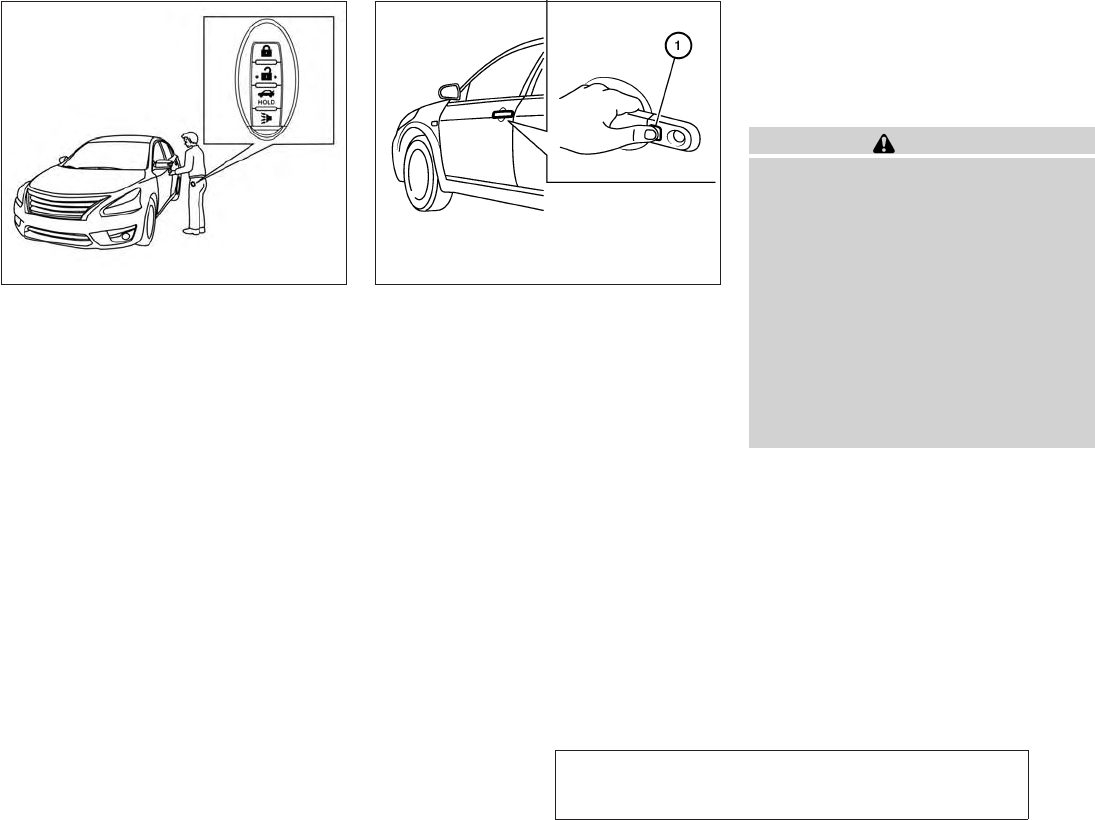
JOBNAME: 1093929-2013-asd-own PAGE: 134 SESS: 4 OUTPUT: Tue Mar 27 10:39:14 2012
Locking doors
1. Move the shift selector to the P (Park) posi-
tion, place the ignition switch in the LOCK
position and make sure you carry the Intelli-
gent Key with you.
2. Close all doors.
3. Push any door handle request switch s
1
while carrying the Intelligent Key with you.
4. All doors and the trunk will lock.
5. The hazard warning lights flash twice and
the outside buzzer sounds twice.
NOTE:
●Request switches for all doors and trunk can
be deactivated when the I-Key Door Lock
setting is switched to OFF in the Vehicle
Settings of the vehicle information display.
See “Vehicle information display” in the “In-
struments and controls” section.
●Doors lock with the door handle request
switch while the ignition switch is not in the
LOCK position.
●Doors do not lock by pushing the door
handle request switch while any door is
open. However, doors lock with the me-
chanical key even if any door is open.
●Doors do not lock with the door handle
request switch with the Intelligent Key inside
the vehicle and a beep sounds to warn you.
However, when an Intelligent Key is inside
the vehicle, doors can be locked with an-
other Intelligent Key.
CAUTION
●After locking the doors using the re-
quest switch, make sure that the doors
have been securely locked by operating
the door handle or the trunk opener
switch.
●When locking the doors using the re-
quest switch, make sure to have the
Intelligent Key in your possession be-
fore operating the request switch to
prevent the Intelligent Key from being
left in the vehicle.
●The request switch is operational only
when the Intelligent Key has been de-
tected by the Intelligent Key system.
LPD2075 WPD0369
3-10 Pre-driving checks and adjustments
ZREVIEW COPY—
2013 Altima Sedan (asd)
Owners Manual—USA_English (nna)
03/24/12—dmoore
X
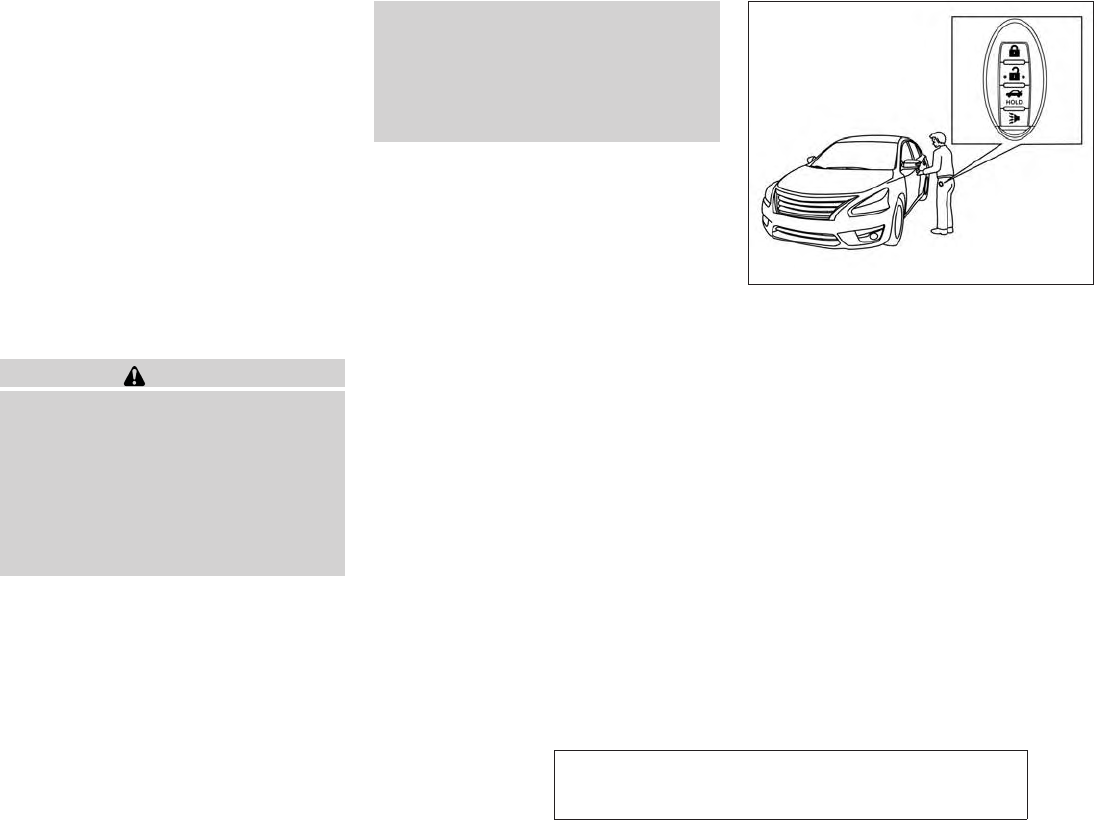
JOBNAME: 1093929-2013-asd-own PAGE: 135 SESS: 4 OUTPUT: Tue Mar 27 10:39:14 2012
Lockout protection
To prevent the Intelligent Key from being acci-
dentally locked in the vehicle, lockout protection
is equipped with the Intelligent Key.
When the driver’s side door is open, the doors
are locked, and then the Intelligent Key is put
inside the vehicle and all the doors are closed;
the lock will automatically unlock and the door
buzzer sounds.
NOTE:
The doors may not lock when the Intelli-
gent Key is in the same hand that is oper-
ating the request switch to lock the door.
Put the Intelligent Key in a purse, pocket or
your other hand.
CAUTION
The lockout protection may not function
under the following conditions:
●When the Intelligent Key is placed on
top of the instrument panel.
●When the Intelligent Key is placed on
top of the rear parcel shelf.
●When the Intelligent Key is placed in-
side the glove box or a storage bin.
●When the Intelligent Key is placed in-
side the door pockets.
●When the Intelligent Key is placed on or
under the spare tire area.
●When the Intelligent Key is placed in-
side or near metallic materials.
Unlocking doors
1. Carry the Intelligent Key.
2. Push the door handle request switch s
1.
3. The hazard warning lights flash once and the
outside buzzer sounds once.
4. Push the door handle request switch s
1
again within 5 seconds to unlock all doors.
If a door handle is pulled while unlocking the
doors, that door may not be unlocked. Returning
the door handle to its original position will unlock
the door. If the door does not unlock after return-
ing the door handle, push the door handle re-
quest switch to unlock the door.
LPD2075
Pre-driving checks and adjustments 3-11
ZREVIEW COPY—
2013 Altima Sedan (asd)
Owners Manual—USA_English (nna)
03/24/12—dmoore
X
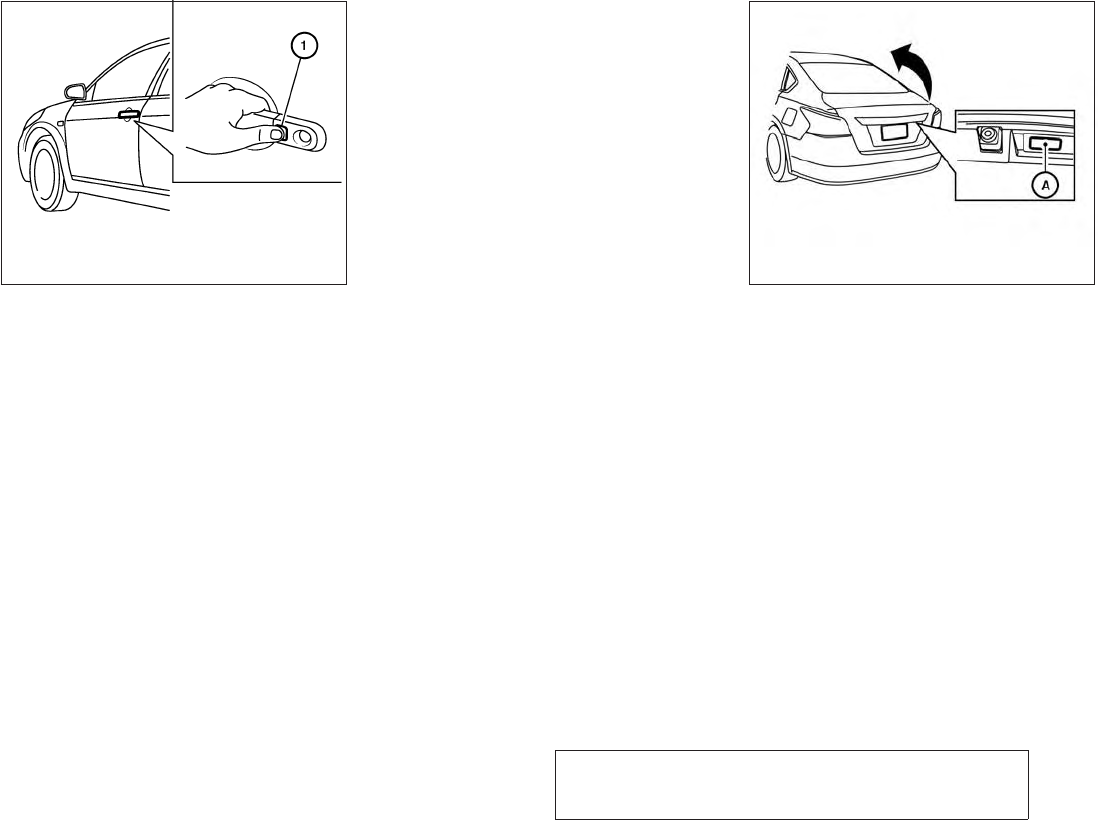
JOBNAME: 1093929-2013-asd-own PAGE: 136 SESS: 4 OUTPUT: Tue Mar 27 10:39:14 2012
All doors will be locked automatically unless one
of the following operations is performed within 1
minute after pushing the request switch:
●Opening any door.
●Pushing the ignition switch.
The interior light timer illuminates for a period of
time when a door is unlocked and the room light
switch is in the DOOR position.
The interior light can be turned off without waiting
by performing one of the following operations:
●Placing the ignition switch in the ON posi-
tion.
●Locking the doors with the remote controller.
●Switching the room light switch to the OFF
position.
Opening the trunk lid
1. Push the trunk opener request switch s
Afor
more than 1 second while carrying the Intel-
ligent Key with you.
2. The trunk will unlatch. A chime will sound 4
times.
3. Raise the trunk lid to open the trunk.
Lockout protection
To prevent the Intelligent Key from being acci-
dentally locked in the trunk, lockout protection is
equipped with the Intelligent Key.
WPD0369 LPD2077
3-12 Pre-driving checks and adjustments
ZREVIEW COPY—
2013 Altima Sedan (asd)
Owners Manual—USA_English (nna)
03/24/12—dmoore
X
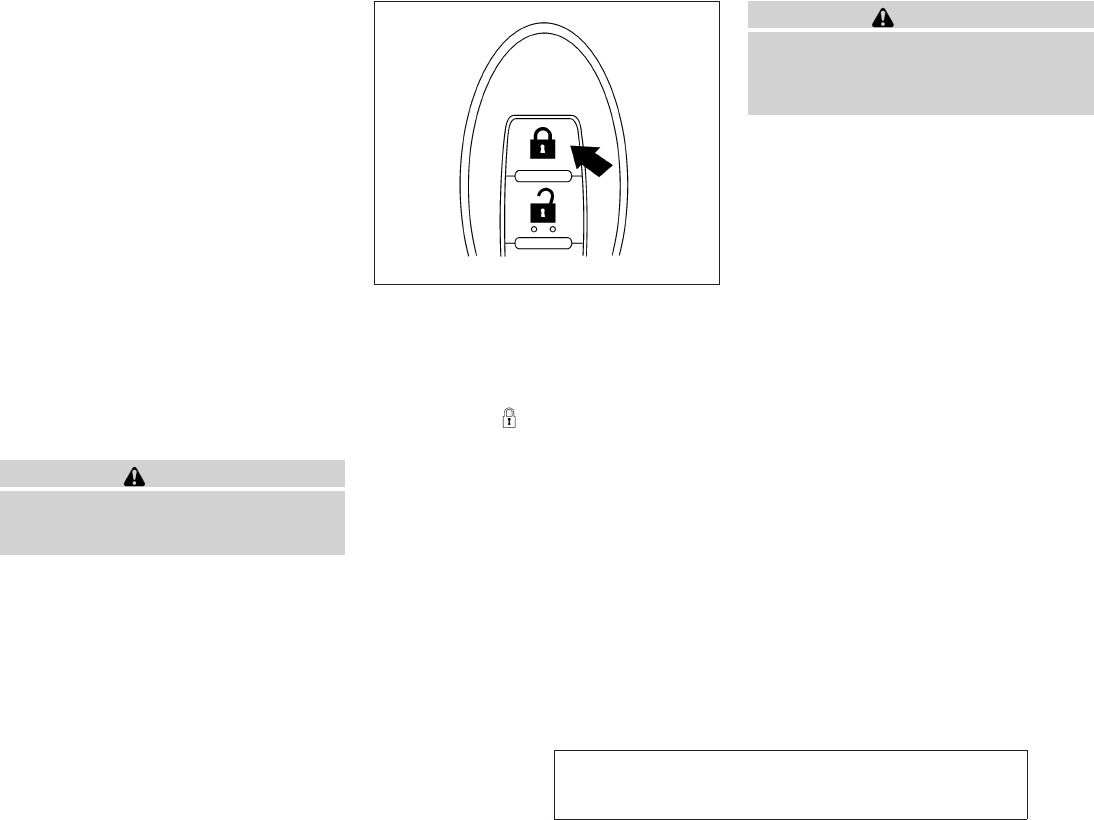
JOBNAME: 1093929-2013-asd-own PAGE: 137 SESS: 4 OUTPUT: Tue Mar 27 10:39:14 2012
When all doors are locked and the trunk lid is
closed with the Intelligent Key inside the trunk,
the outside buzzer will sound and the trunk will
open.
HOW TO USE THE REMOTE
KEYLESS ENTRY FUNCTION
The remote keyless entry function can operate all
door locks using the remote keyless function of
the Intelligent Key. The remote keyless function
can operate at a distance of 33 ft (10 m) away
from the vehicle. The operating distance de-
pends upon the conditions around the vehicle.
The remote keyless entry function will not func-
tion under the following conditions:
●When the Intelligent Key is not within the
operational range.
●When the doors or the trunk are open or not
closed securely.
●When the Intelligent Key battery is dis-
charged.
CAUTION
When locking the doors using the Intelli-
gent Key, be sure not to leave the key in
the vehicle.
Locking doors
1. Place the ignition switch in the LOCK posi-
tion.
2. Close all doors.
3. Press the button on the Intelligent
Key.
4. The hazard warning lights flash twice and
the horn beeps once.
5. All doors will be locked.
CAUTION
After locking the doors using the Intelli-
gent Key, be sure that the doors have been
securely locked by operating the door
handles.
WPD0359
Pre-driving checks and adjustments 3-13
ZREVIEW COPY—
2013 Altima Sedan (asd)
Owners Manual—USA_English (nna)
03/24/12—dmoore
X
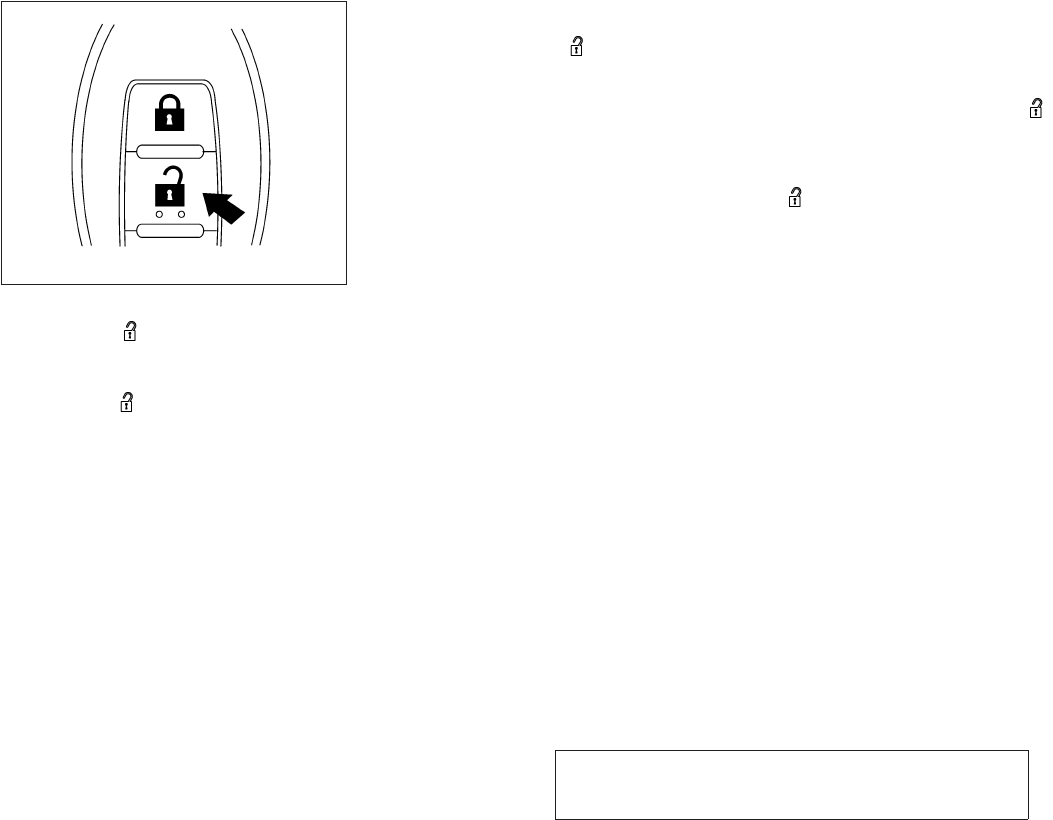
JOBNAME: 1093929-2013-asd-own PAGE: 138 SESS: 4 OUTPUT: Tue Mar 27 10:39:14 2012
Unlocking doors
1. Press the button on the Intelligent
Key.
2. The hazard warning lights flash once.
3. Press the button again within 5 sec-
onds to unlock all doors.
NOTE:
The unlocking operation can be changed in
Selective door unlock in the Vehicle Set-
tings of the vehicle information display. For
additional information, see “Vehicle infor-
mation display” in the “Instruments and
controls” section of this manual.
All doors will be locked automatically unless one
of the following operations is performed within 1
minute after pressing the button:
●Opening any doors.
●Pushing the ignition switch.
The interior light illuminates for a period of time
when a door is unlocked and the room light
switch is in the DOOR position.
The light can be turned off without waiting by
performing one of the following operations:
●Placing the ignition switch in the ON posi-
tion.
●Locking the doors with the Intelligent Key.
●Switching the room light switch to the OFF
position.
●Switching the Auto Room Lamp to the OFF
position in Vehicle Settings of the vehicle
information display. See “Vehicle information
display” in the “Instruments and controls”
section.
Opening windows
The Intelligent Key allows you to simultaneously
open windows equipped with automatic opera-
tion.
●To open the windows, press the but-
ton on the Intelligent Key for longer than 3
seconds after all doors are unlocked.
The door windows will open while pressing
the button on the Intelligent Key.
The door windows cannot be closed by
using the Intelligent Key.
WPD0360
3-14 Pre-driving checks and adjustments
ZREVIEW COPY—
2013 Altima Sedan (asd)
Owners Manual—USA_English (nna)
03/24/12—dmoore
X
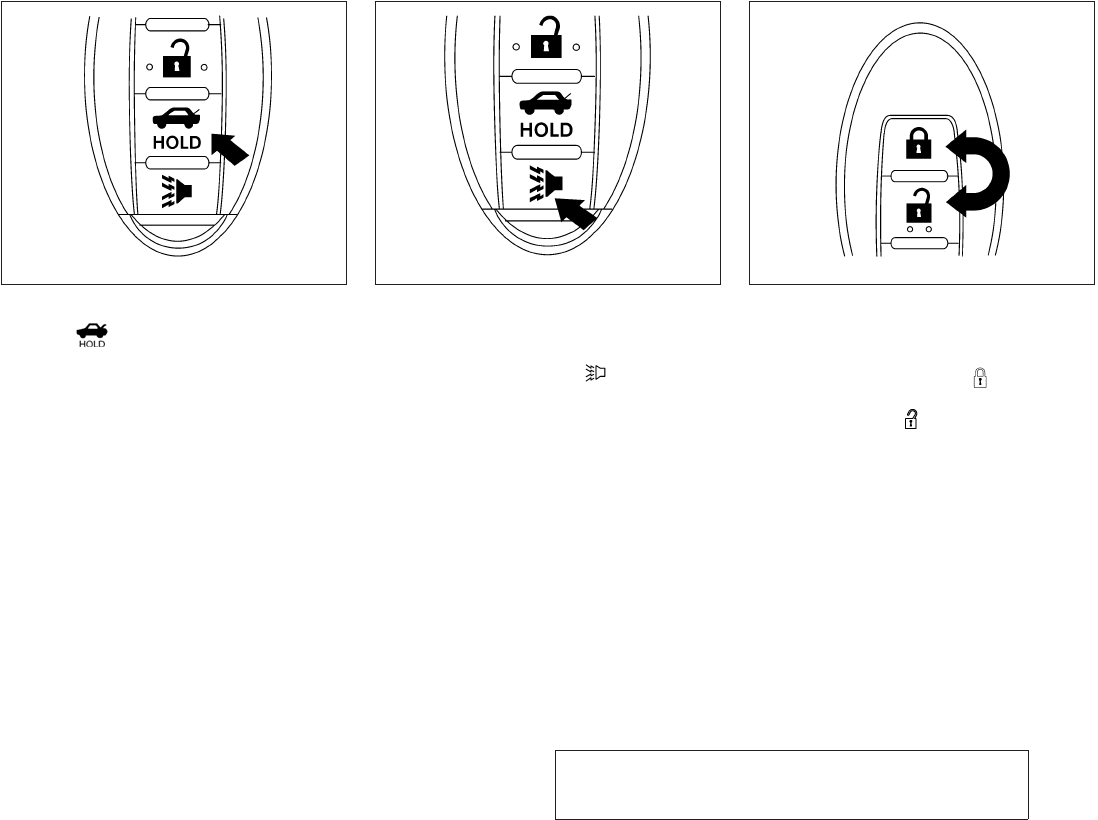
JOBNAME: 1093929-2013-asd-own PAGE: 139 SESS: 4 OUTPUT: Tue Mar 27 10:39:14 2012
Releasing the trunk lid
Press the button for longer than 0.5 sec-
onds to open the trunk lid. The trunk release
button will not operate when the ignition switch is
in the ON position or when the trunk cancel
switch is in the OFF position. See “Cancel
switch” in this section.
Using the panic alarm
If you are near your vehicle and feel threatened,
you may activate the panic alarm to call attention
by pressing and holding the button on the
Intelligent Key for longer than 0.5 seconds.
The panic alarm and headlights will stay on for a
period of time.
The panic alarm stops when:
●It has run for a period of time, or
●Any button is pressed on the Intelligent Key.
●The request switch on the driver or passen-
ger door has been pushed and the Intelligent
Key is in range of the door handle.
Answer back horn feature
If desired, the answer back horn feature can be
deactivated using the Intelligent Key. When de-
activated and the LOCK button is
pushed the hazard indicator flashes twice and
when the UNLOCK button is pushed, nei-
ther the hazard indicator nor the horn operates.
WPD0364 WPD0361 WPD0362
Pre-driving checks and adjustments 3-15
ZREVIEW COPY—
2013 Altima Sedan (asd)
Owners Manual—USA_English (nna)
03/24/12—dmoore
X

JOBNAME: 1093929-2013-asd-own PAGE: 140 SESS: 4 OUTPUT: Tue Mar 27 10:39:14 2012
NOTE:
If you change the answer back horn and
light flash feature with the Intelligent Key,
the vehicle information display screen will
show the current mode after the ignition
switch has been cycled from the OFF to the
ON position. The vehicle information dis-
play screen can also be used to change the
answer back horn mode. See “Answer back
horn” in the “Instruments and controls”
section.
To deactivate: Press and hold the
and buttons for at least 2 seconds.
The hazard warning lights will flash 3 times to
confirm that the answer back horn feature has
been deactivated.
To activate: Press and hold the
and buttons for at least 2 seconds
once more.
The hazard warning lights will flash once and the
horn will sound once to confirm that the horn
beep feature has been reactivated.
Deactivating the horn beep feature does not si-
lence the horn if the alarm is triggered.
WARNING SIGNALS
To help prevent the vehicle from moving unex-
pectedly by erroneous operation of the Intelligent
Key or to help prevent the vehicle from being
stolen, a chime or buzzer sounds from inside and
outside the vehicle and a warning is displayed in
the instrument panel.
When a chime or beep sounds or a warning is
displayed, be sure to check the vehicle and the
Intelligent Key.
See the “Troubleshooting guide” that follows and
“Vehicle information display” in the “Instruments
and controls” section of this manual.
TROUBLESHOOTING GUIDE
Verify the location of all Intelligent Keys that are
programmed for the vehicle. If another Intelligent
Key is in range or inside the vehicle, the vehicle
system may respond differently than expected.
3-16 Pre-driving checks and adjustments
ZREVIEW COPY—
2013 Altima Sedan (asd)
Owners Manual—USA_English (nna)
03/24/12—dmoore
X
This text will be moved above
chart on next page
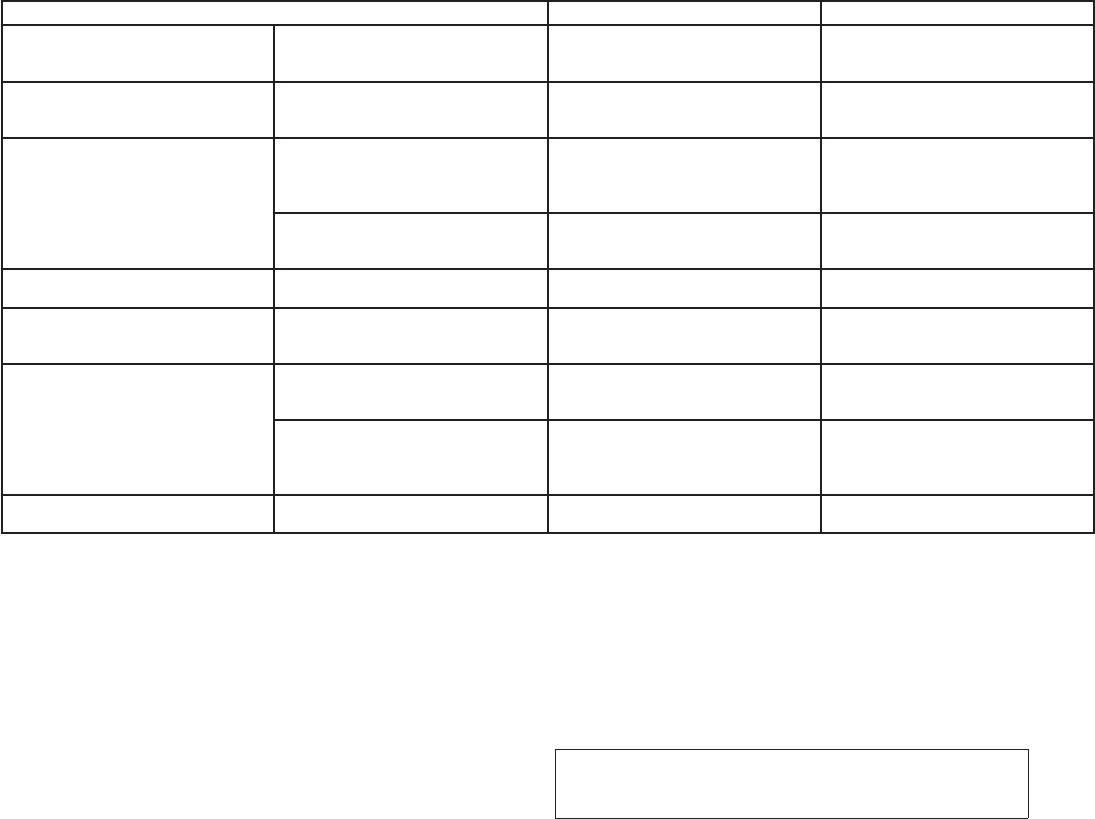
JOBNAME: 1093929-2013-asd-own PAGE: 141 SESS: 4 OUTPUT: Tue Mar 27 10:39:14 2012
Symptom Possible Cause Remedy
When stopping the engine
The Shift to Park warning appears in the
display and the inside warning chime
sounds continuously.
The shift selector is not in the P (Park)
position.
Move the shift selector to the P (Park)
position.
When opening the driver’s door to get out
of the vehicle
The Door Open warning appears in the dis-
play and the inside warning chime sounds
continuously.
The ignition switch is in the ACC position. Place the ignition switch in the OFF
position.
When closing the door after getting out of
the vehicle
The No Key Detected warning appears in
the display, the outside chime sounds 3
times and the inside warning chime sounds
for approximately 3 seconds.
The ignition switch is in the ACC or ON
position.
Place the ignition switch in the OFF
position.
The Shift to Park warning appears in the
display and the outside chime sounds
continuously.
The ignition switch is in the ACC position
and the shift selector is not in the P (Park)
position.
Move the shift selector to the P (Park) posi-
tion and place the ignition switch in the
OFF position.
When closing the door with the inside lock
knob turned to LOCK
The outside chime sounds for approximately
3 seconds and all the doors unlock. The Intelligent Key is inside the vehicle. Carry the Intelligent Key with you.
When pushing the door handle request
switch or the LOCK button on the Intelli-
gent Key to lock the door
The outside chime sounds for approximately
2 seconds. The Intelligent Key is inside the vehicle. Carry the Intelligent Key with you.
When pushing the ignition switch to start
the engine
The Key low battery indicator appears in the
display. The battery charge is low.
Replace the battery with a new one. (See
“Battery” in the “Maintenance and do-it-
yourself” section.)
The KEY ID Incorrect warning appears i n
the display, the outside chime sounds 3
times and the inside warning chime sounds
for approximately 3 seconds.
The Intelligent Key is not in the vehicle. Carry the Intelligent Key with you.
When pushing the ignition switch The Intelligent Key system warning light in
the meter illuminates in yellow.
It warns of a malfunction with the Intelligent
Key system. Contact a NISSAN dealer.
Pre-driving checks and adjustments 3-17
ZREVIEW COPY—
2013 Altima Sedan (asd)
Owners Manual—USA_English (nna)
03/24/12—dmoore
X
TROUBLESHOOTING GUIDE text will be placed here

JOBNAME: 1093929-2013-asd-own PAGE: 142 SESS: 4 OUTPUT: Tue Mar 27 10:39:14 2012
WARNING
●
Radio waves could adversely affect elec-
tric medical equipment. Those who use a
pacemaker should contact the electric
medical equipment manufacturer for the
possible influences before use.
●The Intelligent Key transmits radio
waves when the buttons are pressed.
The FAA advises the radio waves may
affect aircraft navigation and communi-
cation systems. Do not operate the In-
telligent Key while on an airplane. Make
sure the buttons are not operated unin-
tentionally when the unit is stored for a
flight.
The Intelligent Key can operate all the door locks
using the remote controller function. The operat-
ing environment and/or conditions may affect the
Intelligent Key operation.
Be sure to read the following before using the
Intelligent Key.
CAUTION
●Be sure to carry the Intelligent Key with
you when operating the vehicle.
●Never leave the Intelligent Key in the
vehicle when you leave the vehicle.
The Intelligent Key is always communicating with
the vehicle as it receives radio waves. The Intel-
ligent Key transmits weak radio waves. Environ-
mental conditions may interfere with the opera-
tion of the Intelligent Key under the following
operating conditions:
●When operating near a location where
strong radio waves are transmitted, such as
a TV tower, power station and broadcasting
station.
●When in possession of wireless equipment,
such as a cellular telephone, transceiver,
and CB radio.
●When the Intelligent Key is in contact with or
covered by metallic materials.
●When any type of radio wave remote control
is used nearby.
●When the Intelligent Key is placed near an
electric appliance such as a personal com-
puter.
●When the vehicle is parked near a parking
meter.
In such cases, correct the operating conditions
before using the Intelligent Key function or use
the mechanical key.
Although the life of the battery varies depending
on the operating conditions, the battery’s life is
approximately 2 years. If the battery is dis-
charged, replace it with a new one.
When the Intelligent Key battery is low, an indi-
cator illuminates in the Vehicle Information Dis-
play. See “Vehicle Information Display” in the
“Instruments and controls” section.
Since the Intelligent Key is continuously receiving
radio waves, if the key is left near equipment
which transmits strong radio waves, such as sig-
nals from a TV and personal computer, the bat-
tery life may become shorter.
For information regarding replacement of a bat-
tery, see “Battery replacement” in the “Mainte-
nance and do-it-yourself” section.
As many as 4 Intelligent Keys can be registered
and used with one vehicle. For information about
the purchase and use of additional Intelligent
Keys, contact a NISSAN dealer.
NISSAN INTELLIGENT KEYT
WITHOUT DOOR AND TRUNK
REQUEST SWITCHES
3-18 Pre-driving checks and adjustments
ZREVIEW COPY—
2013 Altima Sedan (asd)
Owners Manual—USA_English (nna)
03/24/12—dmoore
X

JOBNAME: 1093929-2013-asd-own PAGE: 143 SESS: 4 OUTPUT: Tue Mar 27 10:39:14 2012
CAUTION
Listed below are conditions or occur-
rences which will damage the Intelligent
Key:
●Do not allow the Intelligent Key, which
contains electrical components, to
come into contact with water or salt
water. This could affect the system
function.
●Do not drop the Intelligent Key.
●Do not strike the Intelligent Key sharply
against another object.
●Do not change or modify the Intelligent
Key.
●Wetting may damage the Intelligent
Key. If the Intelligent Key gets wet, im-
mediately wipe until it is completely dry.
●Do not place the Intelligent Key for an
extended period in an area where tem-
peratures exceed 140°F (60°C).
●Do not attach the Intelligent Key with a
key holder that contains a magnet.
●Do not place the Intelligent Key near
equipment that produces a magnetic
field, such as a TV, audio equipment and
personal computers.
If an Intelligent Key is lost or stolen, NISSAN
recommends erasing the ID code of that Intelli-
gent Key from the vehicle. This may prevent the
unauthorized use of the Intelligent Key to operate
the vehicle. For information regarding the erasing
procedure, contact a NISSAN dealer.
OPERATING RANGE
The Intelligent Key functions can only be used
when the Intelligent Key is within the specified
operating range.
When the Intelligent Key battery is discharged or
strong radio waves are present near the operat-
ing location, the Intelligent Key system’s operat-
ing range becomes narrower, and the Intelligent
Key may not function properly.
The operating range is within 33 ft (10 m) of the
vehicle.
HOW TO USE THE REMOTE
KEYLESS ENTRY FUNCTION
The remote keyless entry function can operate all
door locks using the remote keyless function of
the Intelligent Key. The remote keyless function
can operate at a distance of 33 ft (10 m) away
from the vehicle. The operating distance de-
pends upon the conditions around the vehicle.
The remote keyless entry function will not func-
tion under the following conditions:
●When the Intelligent Key is not within the
operational range.
●When the doors or the trunk are open or not
closed securely.
●When the Intelligent Key battery is dis-
charged.
CAUTION
When locking the doors using the Intelli-
gent Key, be sure not to leave the key in
the vehicle.
Pre-driving checks and adjustments 3-19
ZREVIEW COPY—
2013 Altima Sedan (asd)
Owners Manual—USA_English (nna)
03/24/12—dmoore
X
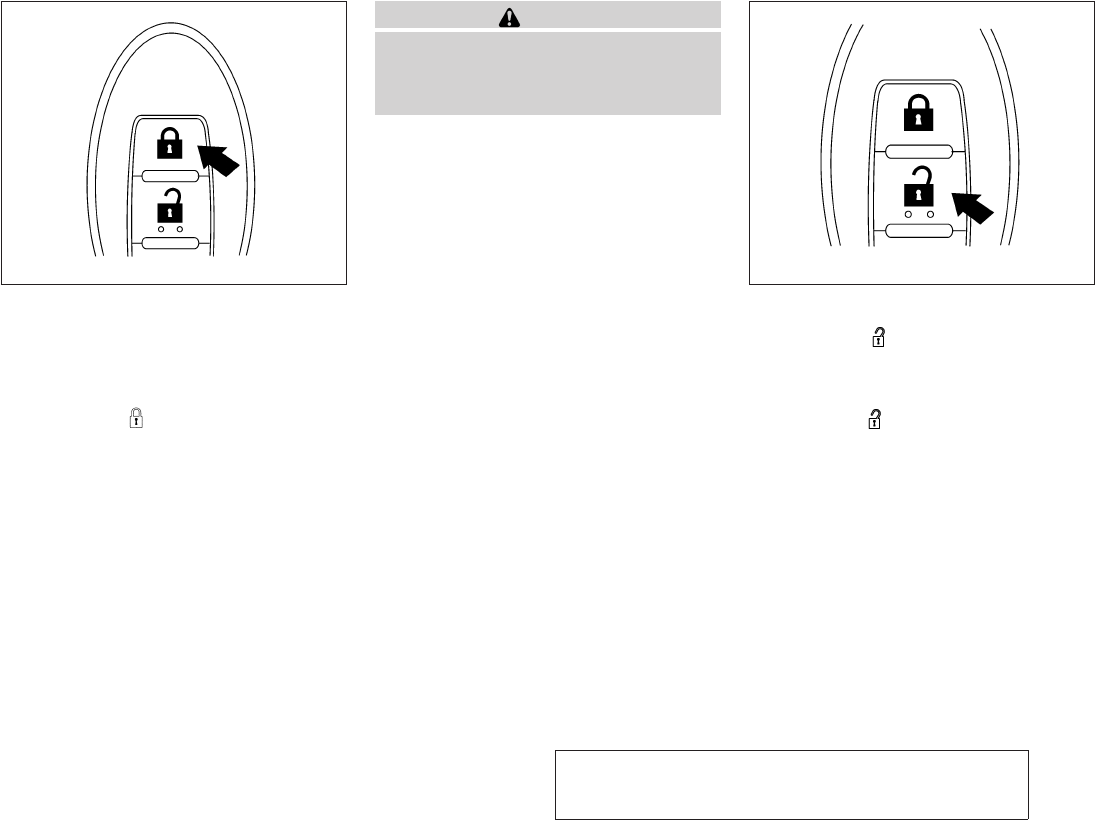
JOBNAME: 1093929-2013-asd-own PAGE: 144 SESS: 4 OUTPUT: Tue Mar 27 10:39:14 2012
Locking doors
1. Place the ignition switch in the LOCK posi-
tion.
2. Close all doors.
3. Press the button on the Intelligent
Key.
4. The hazard warning lights flash twice and
the horn beeps once.
5. All doors will be locked.
CAUTION
After locking the doors using the Intelli-
gent Key, be sure that the doors have been
securely locked by operating the door
handles.
Unlocking doors
1. Press the button on the Intelligent
Key.
2. The hazard warning lights flash once.
3. Press the button again within 5 sec-
onds to unlock all doors.
WPD0359 WPD0360
3-20 Pre-driving checks and adjustments
ZREVIEW COPY—
2013 Altima Sedan (asd)
Owners Manual—USA_English (nna)
03/24/12—dmoore
X
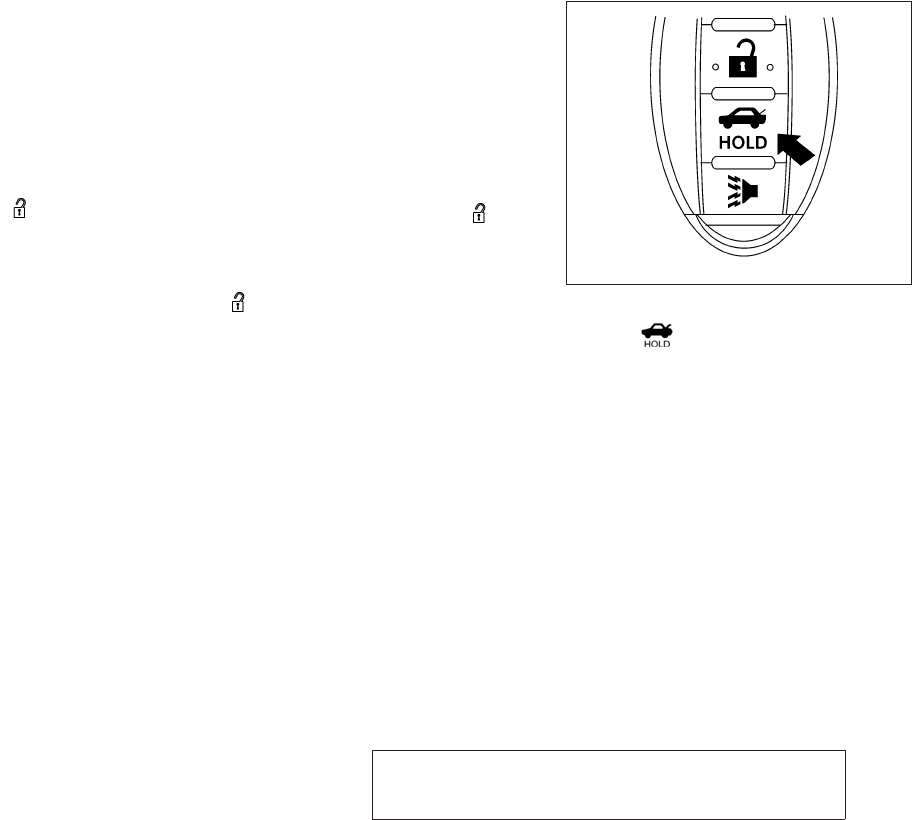
JOBNAME: 1093929-2013-asd-own PAGE: 145 SESS: 4 OUTPUT: Tue Mar 27 10:39:14 2012
NOTE:
The unlocking operation can be changed in
Selective door unlock in the Vehicle Set-
tings of the vehicle information display. For
additional information, see “Vehicle infor-
mation display” in the “Instruments and
controls” section of this manual.
All doors will be locked automatically unless one
of the following operations is performed within 1
minute after pressing the button:
●Opening any doors.
●Pushing the ignition switch.
The interior light illuminates for a period of time
when a door is unlocked and the room light
switch is in the DOOR position.
The light can be turned off without waiting by
performing one of the following operations:
●Placing the ignition switch in the ON posi-
tion.
●Locking the doors with the Intelligent Key.
●Switching the room light switch to the OFF
position.
●Switching the Auto Room Lamp to the OFF
position in Vehicle Settings of the vehicle
information display. See “Vehicle information
display” in the “Instruments and controls”
section.
Opening windows
The Intelligent Key allows you to simultaneously
open windows equipped with automatic opera-
tion.
●To open the windows, press the but-
ton on the Intelligent Key for longer than 3
seconds after all doors are unlocked.
The door windows will open while pressing
the button on the Intelligent Key.
The door windows cannot be closed by
using the Intelligent Key.
Releasing the trunk lid
Press the button for longer than 0.5 sec-
onds to open the trunk lid. The trunk release
button will not operate when the ignition switch is
in the ON position or when the trunk cancel
switch is in the OFF position. See “Cancel
switch” in this section.
WPD0364
Pre-driving checks and adjustments 3-21
ZREVIEW COPY—
2013 Altima Sedan (asd)
Owners Manual—USA_English (nna)
03/24/12—dmoore
X
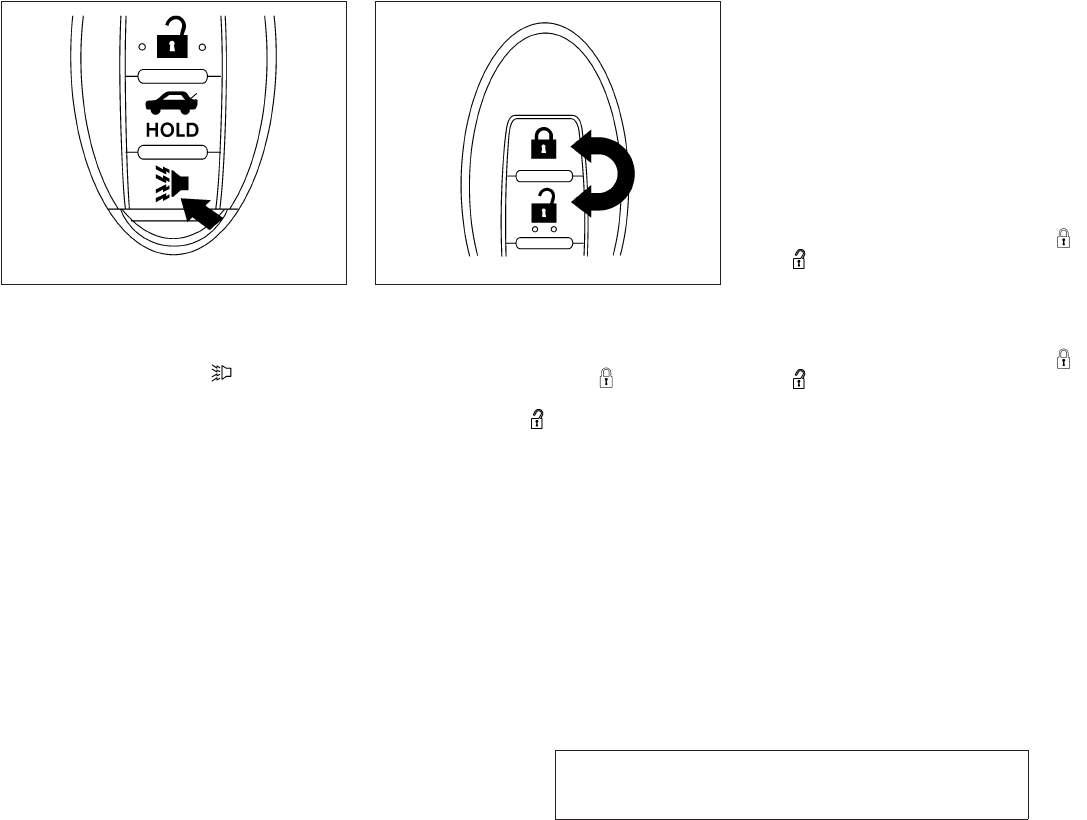
JOBNAME: 1093929-2013-asd-own PAGE: 146 SESS: 4 OUTPUT: Tue Mar 27 10:39:14 2012
Using the panic alarm
If you are near your vehicle and feel threatened,
you may activate the panic alarm to call attention
by pressing and holding the button on the
Intelligent Key for longer than 0.5 seconds.
The panic alarm and headlights will stay on for a
period of time.
The panic alarm stops when:
●It has run for a period of time, or
●Any button is pressed on the Intelligent Key.
Answer back horn feature
If desired, the answer back horn feature can be
deactivated using the Intelligent Key. When de-
activated and the LOCK button is
pushed the hazard indicator flashes twice and
when the UNLOCK button is pushed, nei-
ther the hazard indicator nor the horn operates.
NOTE:
If you change the answer back horn and
light flash feature with the Intelligent Key,
the vehicle information display screen will
show the current mode after the ignition
switch has been cycled from the OFF to the
ON position. The vehicle information dis-
play screen can also be used to change the
answer back horn mode. See “Answer back
horn” in the “Instruments and controls”
section.
To deactivate: Press and hold the
and buttons for at least 2 seconds.
The hazard warning lights will flash 3 times to
confirm that the answer back horn feature has
been deactivated.
To activate: Press and hold the
and buttons for at least 2 seconds
once more.
The hazard warning lights will flash once and the
horn will sound once to confirm that the horn
beep feature has been reactivated.
Deactivating the horn beep feature does not si-
lence the horn if the alarm is triggered.
WPD0361 WPD0362
3-22 Pre-driving checks and adjustments
ZREVIEW COPY—
2013 Altima Sedan (asd)
Owners Manual—USA_English (nna)
03/24/12—dmoore
X

JOBNAME: 1093929-2013-asd-own PAGE: 147 SESS: 4 OUTPUT: Tue Mar 27 10:39:14 2012
WARNING SIGNALS
To help prevent the vehicle from moving unex-
pectedly by erroneous operation of the Intelligent
Key or to help prevent the vehicle from being
stolen, a chime or buzzer sounds from inside and
outside the vehicle and a warning is displayed in
the instrument panel.
When a chime or beep sounds or a warning is
displayed, be sure to check the vehicle and the
Intelligent Key.
See the “Troubleshooting guide” that follows and
“Vehicle information display” in the “Instruments
and controls” section of this manual.
Pre-driving checks and adjustments 3-23
ZREVIEW COPY—
2013 Altima Sedan (asd)
Owners Manual—USA_English (nna)
03/24/12—dmoore
X
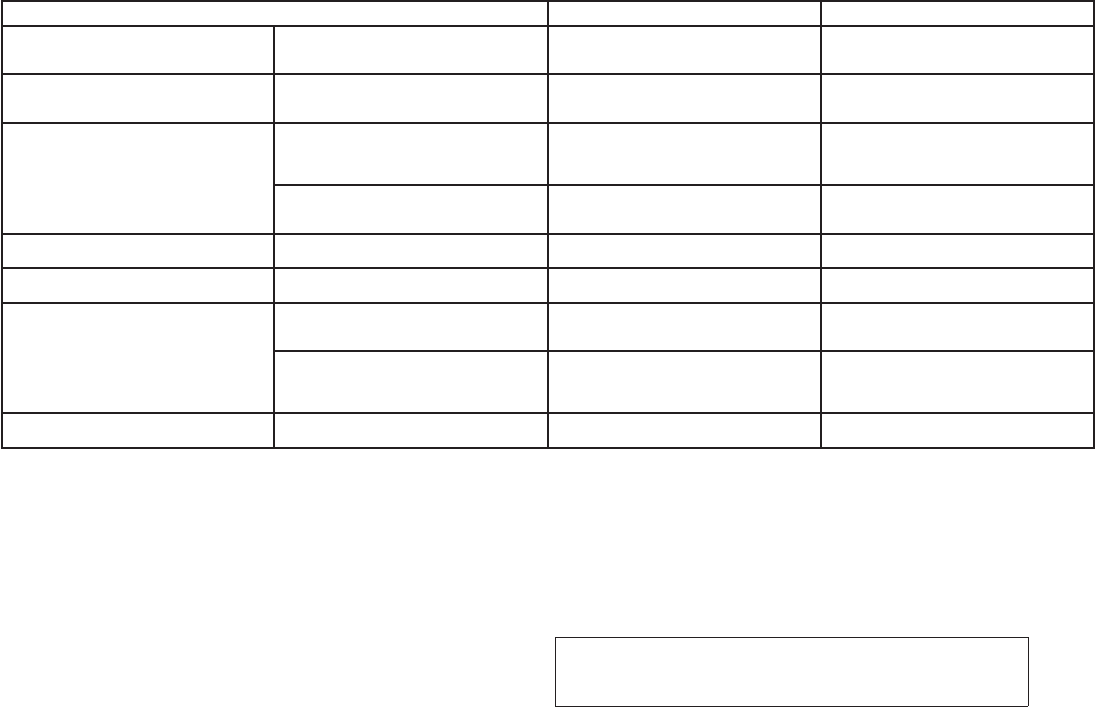
JOBNAME: 1093929-2013-asd-own PAGE: 148 SESS: 4 OUTPUT: Tue Mar 27 10:39:14 2012
TROUBLESHOOTING GUIDE
Verify the location of all Intelligent Keys that are
programmed for the vehicle. If another Intelligent
Key is in range or inside the vehicle, the vehicle
system may respond differently than expected.
Symptom Possible Cause Remedy
When stopping the engine The Shift to Park warning appears in the
display and the inside warning chime
sounds continuously.
The shift selector is not in the P (Park)
position.
Move the shift selector to the P (Park)
position.
When opening the driver’s door to get out
of the vehicle
The Door Open warning appears in the dis-
play and the inside warning chime sounds
continuously. The ignition switch is in the ACC position. Place the ignition switch in the OFF
position.
When closing the door after getting out of
the vehicle
The No Key Detected warning appears in
the display, the outside chime sounds 3
times and the inside warning chime sounds
for approximately 3 seconds.
The ignition switch is in the ACC or ON
position. Place the ignition switch in the OFF
position.
The Shift to Park warning appears in the
display and the outside chime sounds
continuously.
The ignition switch is in the ACC position
and the shift selector is not in the P (Park)
position.
Move the shift selector to the P (Park) posi-
tion and place the ignition switch in the
OFF position.
When closing the door with the inside lock
knob turned to LOCK The outside chime sounds for approximately
3 seconds and all the doors unlock. The Intelligent Key is inside the vehicle. Carry the Intelligent Key with you.
When pushing the LOCK button on the
Intelligent Key to lock the door The outside chime sounds for approximately
2 seconds. The Intelligent Key is inside the vehicle. Carry the Intelligent Key with you.
When pushing the ignition switch to start
the engine
The Key low battery indicator appears in the
display. The battery charge is low. Replace the battery with a new one. (See
“Battery” in the “Maintenance and do-it-
yourself” section.)
The KEY ID Incorrect warning appears in
the display, the outside chime sounds 3
times and the inside warning chime sounds
for approximately 3 seconds.
The Intelligent Key is not in the vehicle. Carry the Intelligent Key with you.
When pushing the ignition switch The Intelligent Key system warning light in
the meter illuminates in yellow. It warns of a malfunction with the Intelligent
Key system. Contact a NISSAN dealer.
3-24 Pre-driving checks and adjustments
ZREVIEW COPY—
2013 Altima Sedan (asd)
Owners Manual—USA_English (nna)
03/24/12—dmoore
X
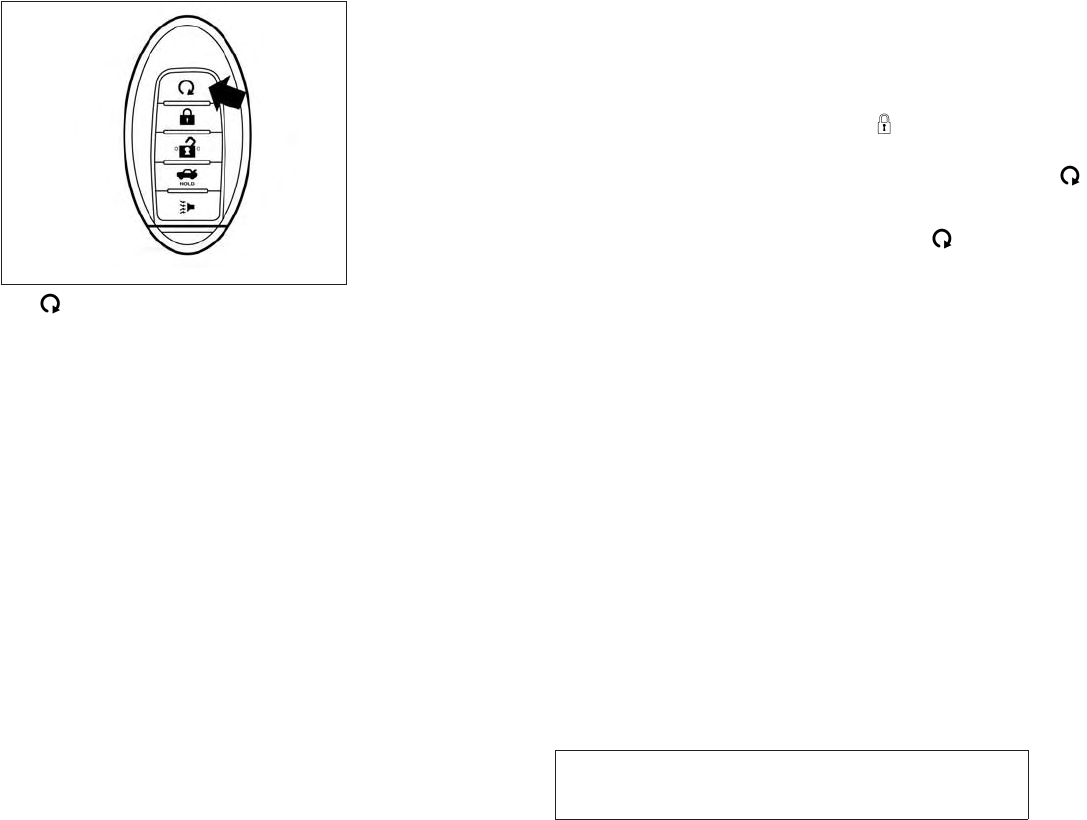
JOBNAME: 1093929-2013-asd-own PAGE: 149 SESS: 4 OUTPUT: Tue Mar 27 10:39:14 2012
The button will be on the NISSAN Intelli-
gent KeyTif the vehicle has remote engine start.
This feature allows the engine to start from out-
side the vehicle.
The following features may be affected when the
remote start feature is used:
●Vehicles with manual or automatic climate
control systems will default to the last used
heating or cooling mode.
●Vehicle equipped with heated seats may
have this feature come on during a remote
start. See “Heated seats”in the “Instruments
and controls” section for more information.
Laws in some local communities may restrict the
use of remote starters. For example, some laws
require a person using remote start to have the
vehicle in view. Check local regulations for any
requirements.
Other conditions may affect the function of the
Remote Engine Start feature. See “Conditions
the remote start will not work” in this section for
additional information.
Other conditions can affect the performance of
the Intelligent Key transmitter. See “NISSAN In-
telligent KeyTSystem” in this section for addi-
tional information.
REMOTE ENGINE START
OPERATING RANGE
The remote engine start function can only be
used when the Intelligent Key is within the speci-
fied operating range from the vehicle.
When the Intelligent Key battery is discharged or
strong radio waves are present near the operat-
ing location, the Intelligent Key operating range
becomes narrower, and the Intelligent Key may
not function properly.
The remote engine start operating range is ap-
proximately 197 ft (60 m) from the vehicle.
REMOTE STARTING THE VEHICLE
To use the remote start feature to start the engine
perform the following:
1. Aim the Intelligent Key at the vehicle.
2. Press the LOCK button to lock all
doors.
3. Within 5 seconds press and hold the
remote start button until the turn signal lights
illuminate. If the vehicle is not within view
press and hold the remote start but-
ton for about 2 seconds.
The following events will occur when the engine
starts:
●The parking lights will turn on and remain on
as long as the engine is running.
●The doors will be locked and the climate
control system may come on.
●The engine will continue to run for 10 min-
utes. Repeat the steps to extend the time for
an additional 10 minutes. See “Extending
engine run time” in this section.
Depress the brake and place the ignition switch
in the ON position before driving. For further
instructions see “Driving the vehicle” in the
“Starting and driving” section.
LPD2078
REMOTE ENGINE START (if so
equipped)
Pre-driving checks and adjustments 3-25
ZREVIEW COPY—
2013 Altima Sedan (asd)
Owners Manual—USA_English (nna)
03/24/12—dmoore
X

JOBNAME: 1093929-2013-asd-own PAGE: 150 SESS: 4 OUTPUT: Tue Mar 27 10:39:14 2012
EXTENDING ENGINE RUN TIME
The remote start feature can be extended one
time by performing the steps listed in “Remote
starting the vehicle” in this section. Run time will
be calculated as follows:
●The first 10 minute run time will start when
the remote start function is performed.
●The second 10 minutes will start immedi-
ately when the remote start function is per-
formed. For example, if the engine has been
running for 5 minutes, and 10 minutes are
added, the engine will run for a total of 15
minutes.
A maximum of two remote starts, or a single start
with an extension, are allowed between ignition
cycles.
The ignition switch must be cycled to the ON
position and then back to the OFF position be-
fore the remote start procedure can be used
again.
CANCELING A REMOTE START
To cancel a remote start, perform one of the
following:
●Aim the Intelligent Key at the vehicle and
press and hold until the parking lights
turn off.
●Turn on the hazard warning flashers.
●Cycle the ignition switch ON and then OFF.
CONDITIONS THE REMOTE START
WILL NOT WORK
The remote start will not operate if any of the
following conditions are present:
●The ignition switch is placed in the ON po-
sition.
●The hood is not securely closed.
●The hazard warning lights are on.
●The I–Key Indicator Light remains
solid in the vehicle information display.
●The alarm sounds due to illegal entry into the
vehicle.
●The ignition switch is pushed without an
Intelligent Key in the vehicle.
●The ignition switch is pushed with an Intelli-
gent Key in the vehicle but the brake pedal is
not depressed.
●Two remote vehicle starts, or a single remote
start with an extension, have already been
used.
●The vehicle is not in P (Park).
●The Remote Start function has been
switched to the OFF position in Vehicle Set-
tings of the vehicle information display. For
additional information, see “Vehicle informa-
tion display” in the “Instruments and con-
trols” section of this manual.
The remote engine start may display a warning or
indicator in the vehicle information display. For an
explanation of the warning or indicator please see
“Vehicle information display warning and indica-
tors” in the “Instruments and controls” section.
3-26 Pre-driving checks and adjustments
ZREVIEW COPY—
2013 Altima Sedan (asd)
Owners Manual—USA_English (nna)
03/24/12—dmoore
X
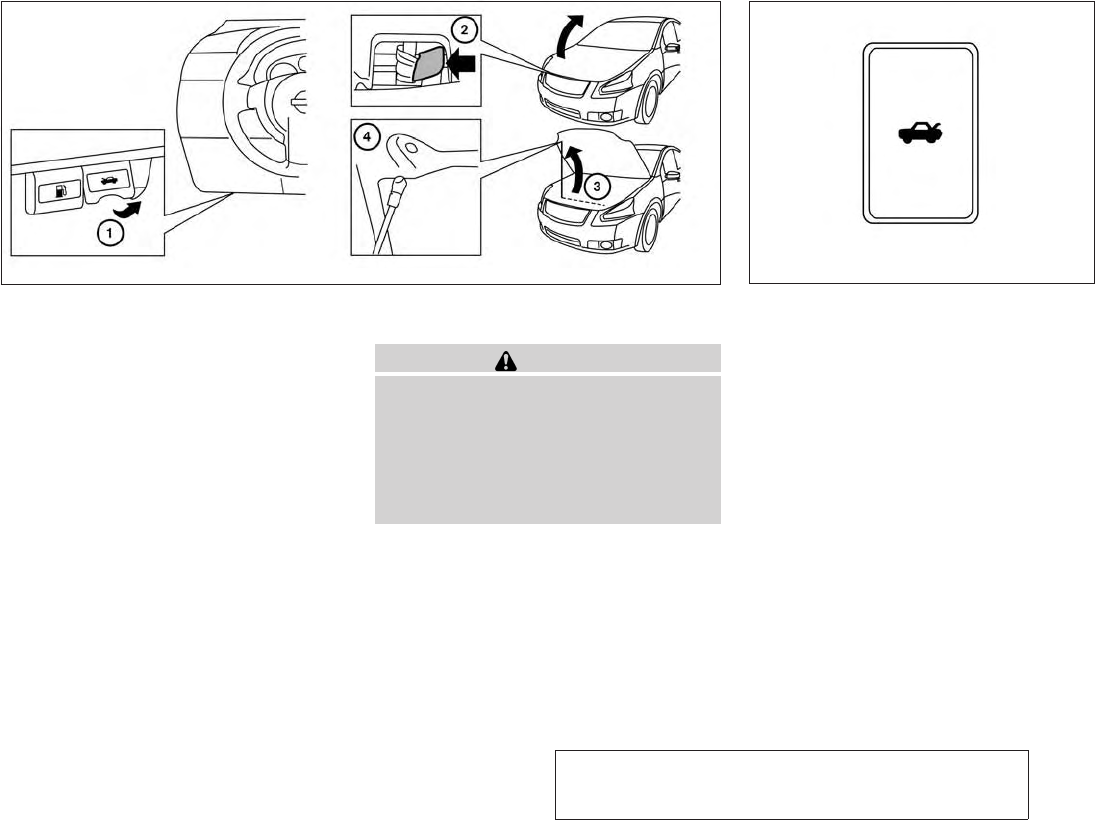
JOBNAME: 1093929-2013-asd-own PAGE: 151 SESS: 4 OUTPUT: Tue Mar 27 10:39:14 2012
s
1Pull the hood lock release handle located
below the driver’s side instrument panel; the
hood springs up slightly.
s
2Push the lever at the front of the hood to the
side as illustrated with your fingertips and
raise the hood.
s
3Remove the support rod from the clamp.
s
4Insert the support rod into the slot on the
passenger side fender ledge.
5. When closing the hood, return the support
rod to its original position, lower the hood to
approximately 30 cm (12 in) above the latch
and release it. This allows proper engage-
ment of the hood latch.
WARNING
●Make sure the hood is completely
closed and latched before driving. The
vehicle should only ever be operated
with the hood securely closed.
●If you see steam or smoke coming from
the engine compartment, to avoid injury
do not open the hood.
LPD2079
Instrument panel
LPD2080
HOOD TRUNK LID
Pre-driving checks and adjustments 3-27
ZREVIEW COPY—
2013 Altima Sedan (asd)
Owners Manual—USA_English (nna)
03/24/12—dmoore
X
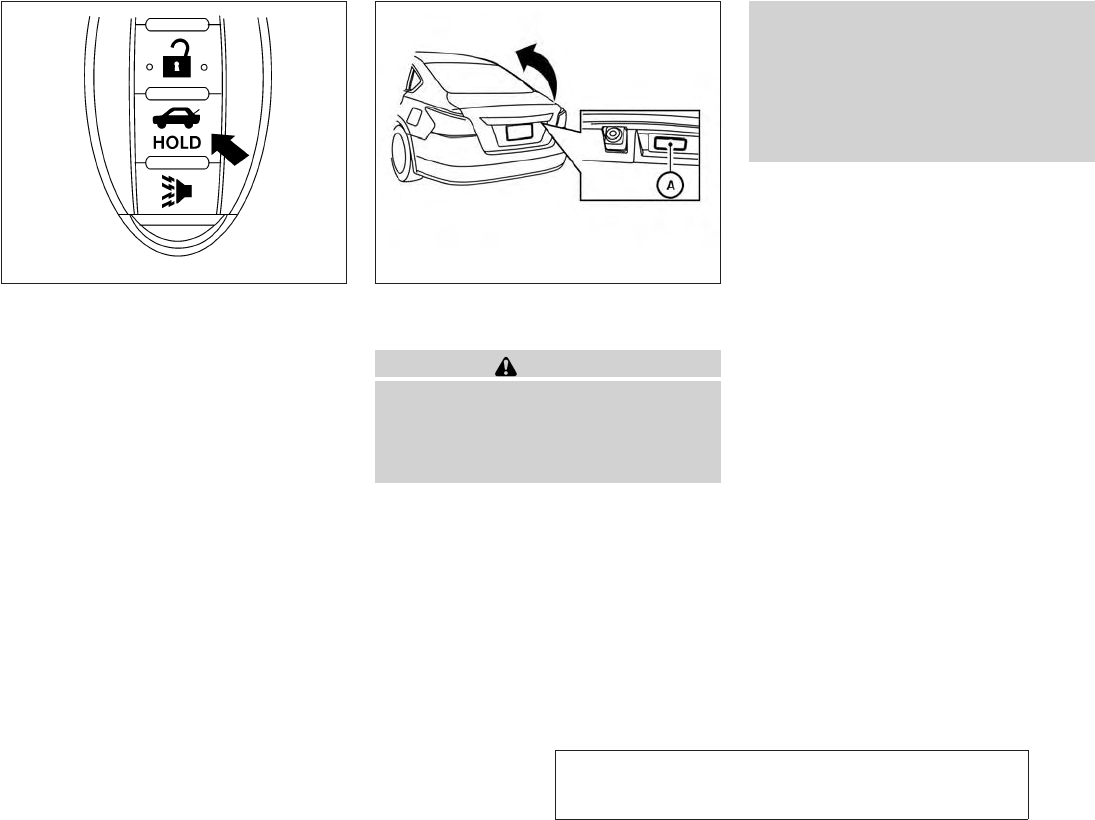
JOBNAME: 1093929-2013-asd-own PAGE: 152 SESS: 4 OUTPUT: Tue Mar 27 10:39:14 2012
OPENER OPERATION
WARNING
●Do not drive with the trunk lid open. This
could allow dangerous exhaust gases
to be drawn into the vehicle. See “Ex-
haust gas” in the “Starting and driving”
section of this manual.
●Closely supervise children when they
are around cars to prevent them from
playing and becoming locked in the
trunk where they could be seriously in-
jured. Keep the car locked, with the rear
seatback and trunk lid securely latched
when not in use, and prevent children’s
access to car keys.
To open the trunk lid perform one of the following
after unlocking the vehicle:
●Press the button on the instrument panel.
●Press the button on the Intelligent Key.
●Push the s
Arelease switch (if so equipped).
To close the trunk lid, lower and push the trunk lid
down securely.
NOTE:
Request switches for all doors and trunk
can be deactivated when the I-Key Door
Lock setting is switched to OFF in the Ve-
hicle Settings of the vehicle information
display. See “Vehicle information display”
in the “Instruments and controls” section.
Intelligent Key
WPD0364
Request switch
LPD2077
3-28 Pre-driving checks and adjustments
ZREVIEW COPY—
2013 Altima Sedan (asd)
Owners Manual—USA_English (nna)
03/24/12—dmoore
X
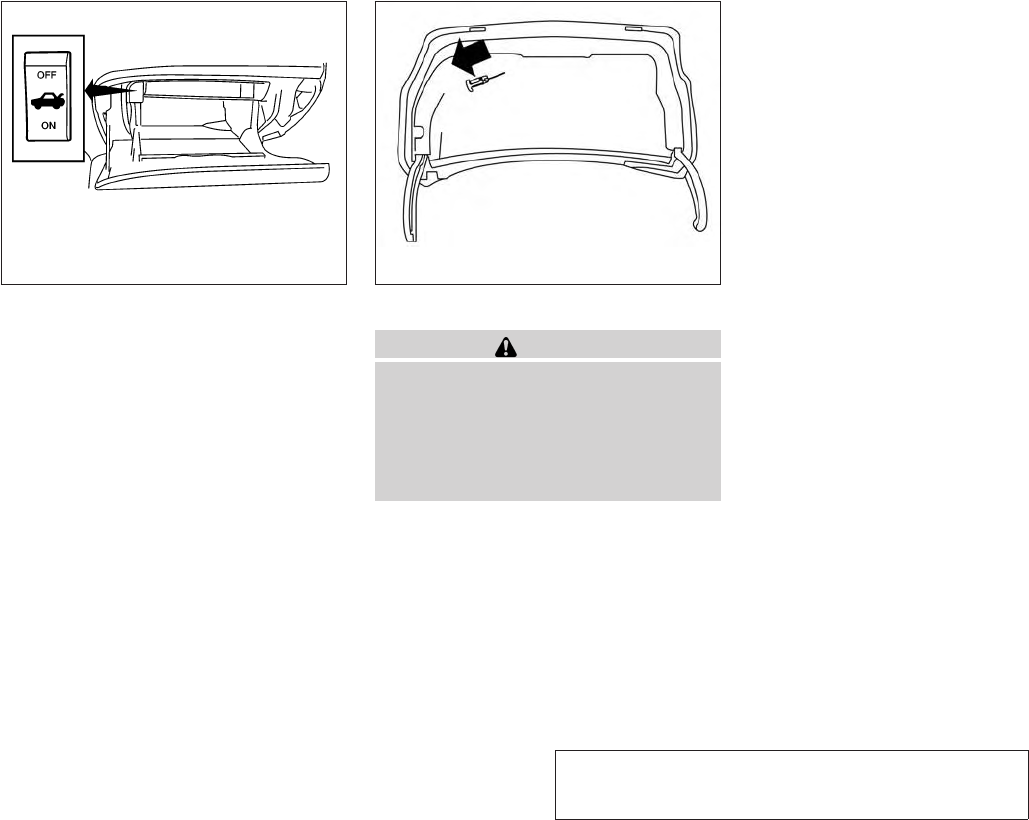
JOBNAME: 1093929-2013-asd-own PAGE: 153 SESS: 4 OUTPUT: Tue Mar 27 10:39:14 2012
Cancel switch
When the switch, located inside the glove box, is
in the OFF position, the power to the trunk lid will
be cancelled.
The trunk lid cannot be opened when:
●using the trunk lid release switch,
●the trunk open request switch (if so
equipped) is pushed, when the Intelligent
Key is in range of the vehicle or
●the HOLD button on the Intelligent Key is
pressed.
INTERIOR TRUNK LID RELEASE
WARNING
Closely supervise children when they are
around cars to prevent them from playing
and becoming locked in the trunk where
they could be seriously injured. Keep the
car locked, with the rear seatback and
trunk lid securely latched when not in use,
and prevent children’s access to car keys.
The interior trunk lid release mechanism provides
a means of escape for children and adults in the
event they become locked inside the trunk.
To open the trunk from the inside, pull the illumi-
nated release handle until the lock releases and
push up on the trunk lid. The release handle is
made of a material that glows in the dark after a
brief exposure to ambient light.
The handle is located inside the trunk compart-
ment on the interior of the trunk lid.
LPD0395 LPD2081
Pre-driving checks and adjustments 3-29
ZREVIEW COPY—
2013 Altima Sedan (asd)
Owners Manual—USA_English (nna)
03/24/12—dmoore
X
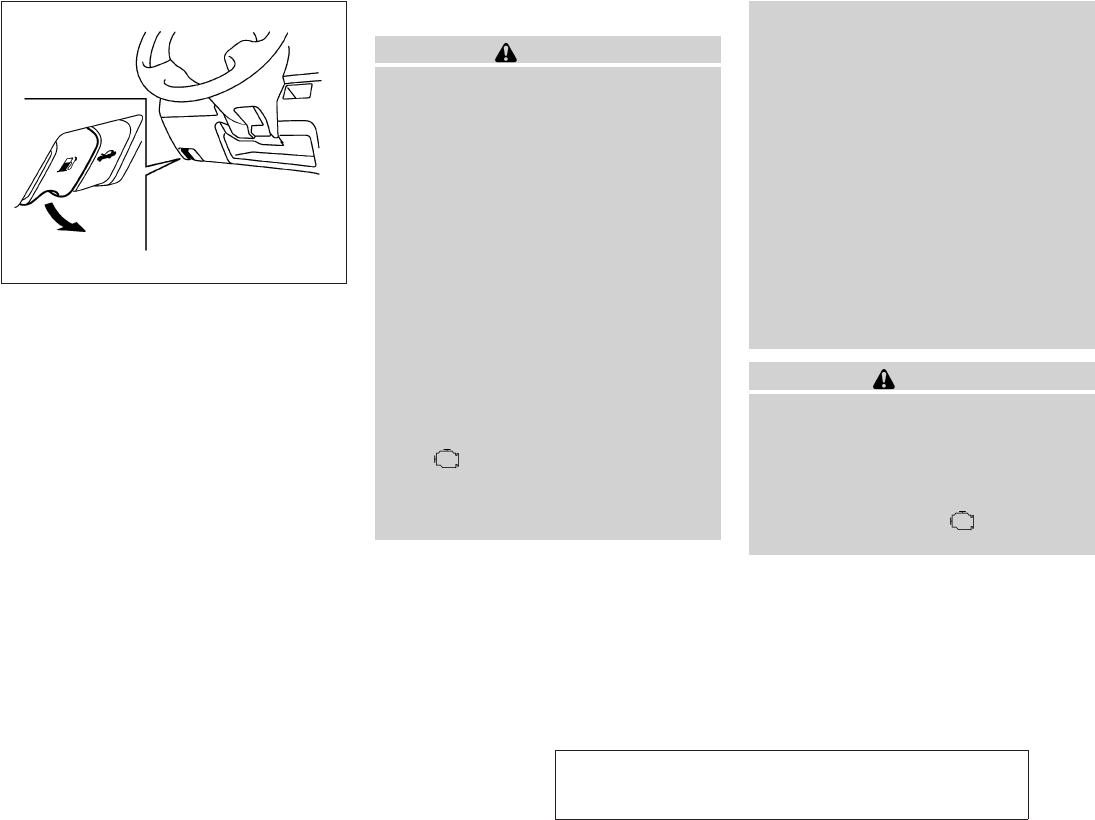
JOBNAME: 1093929-2013-asd-own PAGE: 154 SESS: 4 OUTPUT: Tue Mar 27 10:39:14 2012
OPENER OPERATION
The fuel-filler door release is located below the
instrument panel. To open the fuel-filler door, pull
the release. To lock, close the fuel-filler door
securely.
FUEL-FILLER CAP
WARNING
●Gasoline is extremely flammable and
highly explosive under certain condi-
tions. You could be burned or seriously
injured if it is misused or mishandled.
Always stop the engine and do not
smoke or allow open flames or sparks
near the vehicle when refueling.
●Do not attempt to top off the fuel tank
after the fuel pump nozzle shuts off
automatically. Continued refueling may
cause fuel overflow, resulting in fuel
spray and possibly a fire.
●Use only an original equipment type
fuel-filler cap as a replacement. It has a
built-in safety valve needed for proper
operation of the fuel system and emis-
sion control system. An incorrect cap
can result in a serious malfunction and
possible injury. It could also cause
the Malfunction Indicator Light
(MIL) to come on.
●Never pour fuel into the throttle body to
attempt to start your vehicle.
●Do not fill a portable fuel container in
the vehicle or trailer. Static electricity
can cause an explosion of flammable
liquid, vapor or gas in any vehicle or
trailer. To reduce the risk of serious
injury or death when filling portable fuel
containers:
– Always place the container on the
ground when filling.
– Do not use electronic devices when
filling.
– Keep the pump nozzle in contact
with the container while you are fill-
ing it.
– Use only approved portable fuel con-
tainers for flammable liquid.
CAUTION
●The LOOSE FUEL CAP warning will ap-
pear if the fuel-filler cap is not properly
tightened. It may take a few driving trips
for the message to be displayed. Failure
to tighten the fuel-filler cap properly
after the LOOSE FUEL CAP warning ap-
pears may cause the Malfunction
Indicator Light (MIL) to illuminate.
LPD2022
FUEL-FILLER DOOR
3-30 Pre-driving checks and adjustments
ZREVIEW COPY—
2013 Altima Sedan (asd)
Owners Manual—USA_English (nna)
03/24/12—dmoore
X
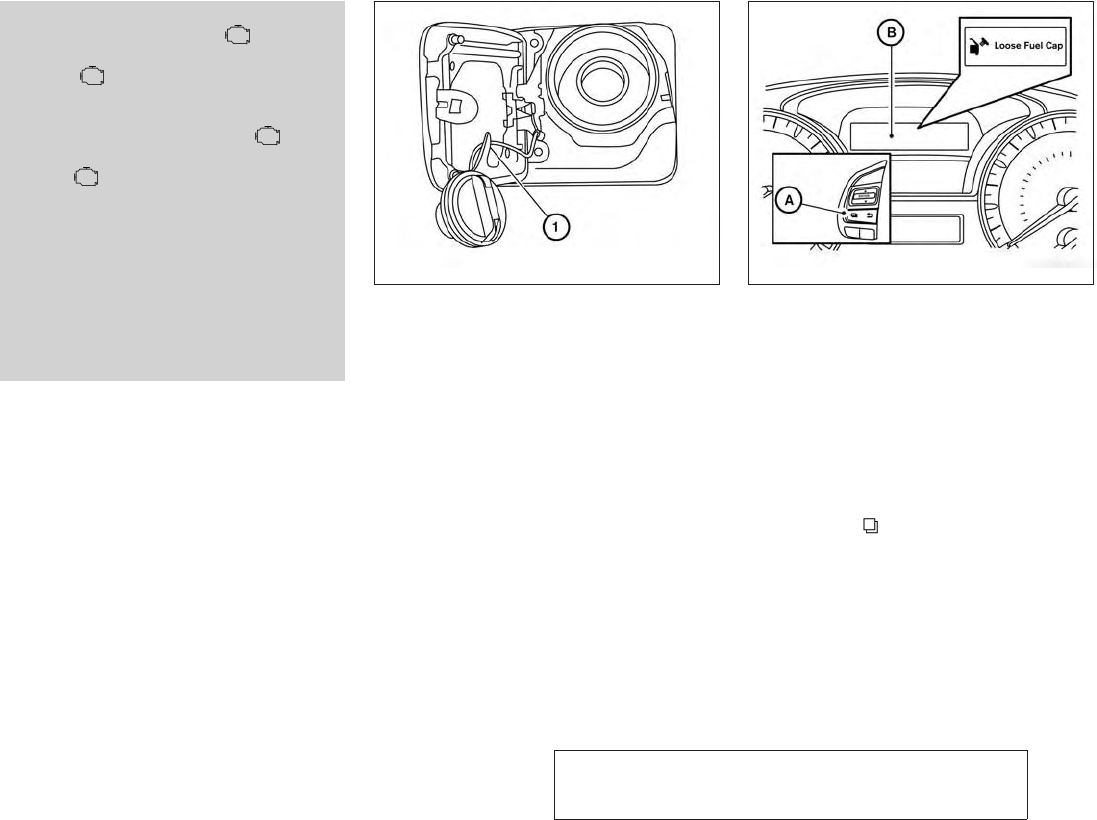
JOBNAME: 1093929-2013-asd-own PAGE: 155 SESS: 4 OUTPUT: Tue Mar 27 10:39:14 2012
●Failure to tighten the fuel-filler cap
properly may cause the Malfunc-
tion Indicator Light (MIL) to illuminate.
If the light illuminates because
the fuel-filler cap is loose or missing,
tighten or install the cap and continue
to drive the vehicle. The light
should turn off after a few driving trips.
If the light does not turn off after a
few driving trips, have the vehicle in-
spected by a NISSAN dealer.
●For additional information, see the
“Malfunction Indicator Light (MIL)” in
the “Instruments and Controls” section
in this manual.
●If fuel is spilled on the vehicle body,
flush it away with water to avoid paint
damage.
To remove the fuel-filler cap:
1. Turn the fuel-filler cap counterclockwise to
remove.
2. Put the fuel-filler cap on the cap holder s
1
while refueling.
To install the fuel-filler cap:
1. Insert the fuel-filler cap straight into the fuel-
filler tube.
2. Turn the fuel-filler cap clockwise until a
single click is heard.
Loose Fuel Cap warning
The LOOSE FUEL CAP warning appears in the
vehicle information display when the fuel-filler
cap is not tightened correctly after the vehicle has
been refueled. It may take a few driving trips for
the message to be displayed. To turn off the
warning, perform the following:
1. Remove and install the fuel-filler cap as soon
as possible. See “Fuel-filler cap”.
2. Tighten the fuel-filler cap until it clicks.
3. Press the next button s
Aon the steer-
ing wheel for about 1 second to turn off the
LOOSE FUEL CAP warning s
Bafter tight-
ening the fuel-filler cap.
LPD2082 LPD2090
Pre-driving checks and adjustments 3-31
ZREVIEW COPY—
2013 Altima Sedan (asd)
Owners Manual—USA_English (nna)
03/24/12—dmoore
X
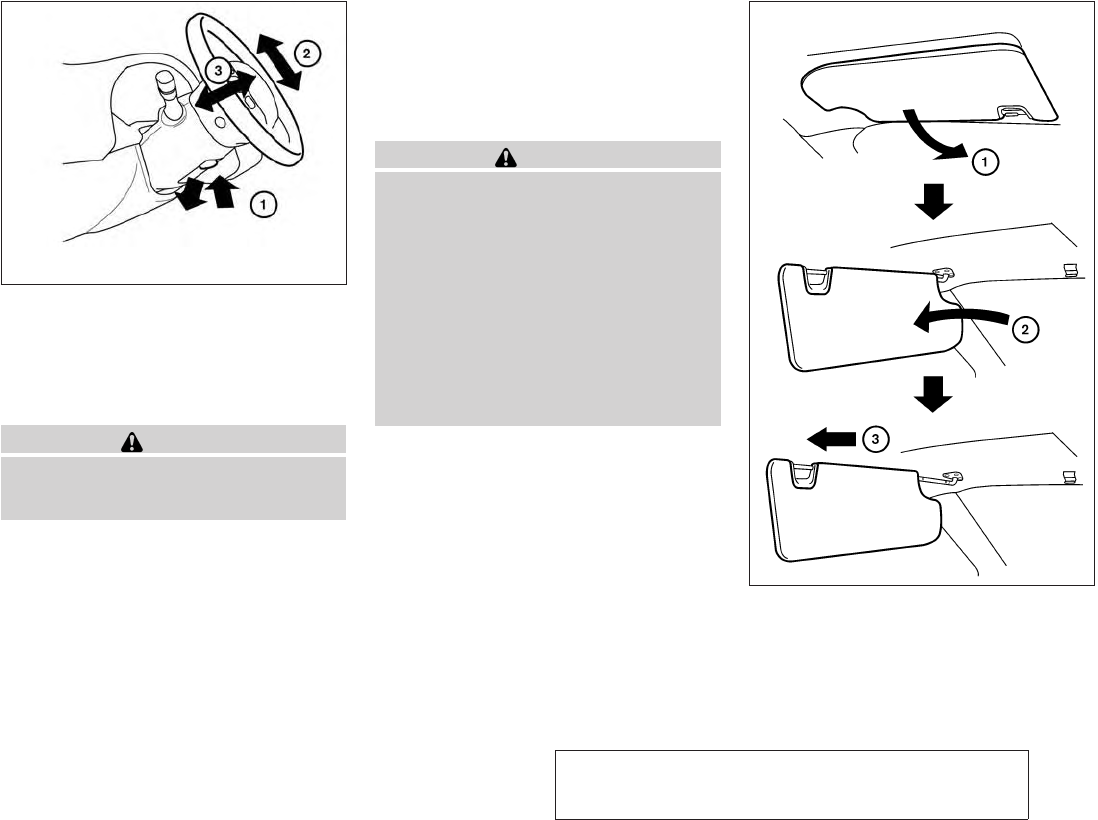
JOBNAME: 1093929-2013-asd-own PAGE: 156 SESS: 4 OUTPUT: Tue Mar 27 10:39:14 2012
TILT OPERATION
Pull the lock lever down s
1and adjust the steer-
ing wheel up or down s
2to the desired position.
Push the lock lever up s
1firmly to lock the
steering wheel in place.
WARNING
Do not adjust the steering wheel while
driving. You could lose control of your
vehicle and cause an accident.
TELESCOPIC OPERATION
Pull the lever s
1all the way toward you and
adjust the steering wheel forward or backward in
direction s
3, to the desired position. Lock the
wheel by releasing the lever and ensure that the
lever has returned to its original position.
WARNING
Do not adjust the steering wheel any
closer to you than is necessary for proper
steering operation and comfort. The driv-
er’s air bag inflates with great force. If you
are unrestrained, leaning forward, sitting
sideways or out of position in any way, you
are at greater risk of injury or death in a
crash. You may also receive serious or
fatal injuries from the air bag if you are up
against it when it inflates. Always sit back
against the seatback and as far away as
practical from the steering wheel. Always
use the seat belts.
LPD2085
WPD0344
TILT/TELESCOPIC STEERING SUN VISORS
3-32 Pre-driving checks and adjustments
ZREVIEW COPY—
2013 Altima Sedan (asd)
Owners Manual—USA_English (nna)
03/24/12—dmoore
X
See attachment A

JOBNAME: No Job Name PAGE: 1 SESS: 3 OUTPUT: Tue Mar 27 18:46:10 2012 SUM: 23EB9F81
/nissan_pdm/nissancims/owners/com/manual-tele.alt
TELESCOPIC OPERATION
Pull the lock lever down s
1and adjust the steer-
ing wheel forward or backward s
3to the desired
position.
Push the lock lever up s
1firmly to lock the
steering wheel in place.
WARNING
Do not adjust the steering wheel any
closer to you than is necessary for proper
steering operation and comfort. The driv-
er’s air bag inflates with great force. If you
are unrestrained, leaning forward, sitting
sideways or out of position in any way, you
are at greater risk of injury or death in a
crash. You may also receive serious or
fatal injuries from the air bag if you are up
against it when it inflates. Always sit back
against the seatback and as far away as
practical from the steering wheel. Always
use the seat belts.
0-1
Attachment A
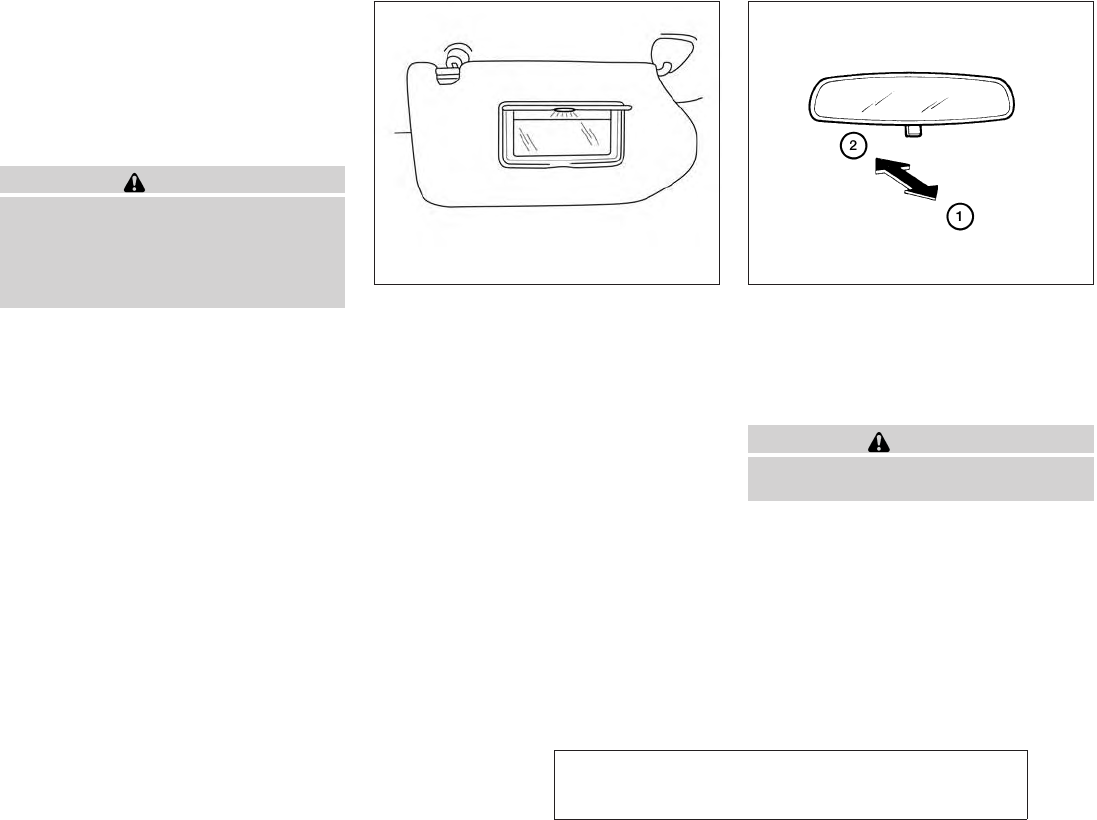
JOBNAME: 1093929-2013-asd-own PAGE: 157 SESS: 4 OUTPUT: Tue Mar 27 10:39:14 2012
s
1To block glare from the front, swing down the
main sun visor.
s
2To block glare from the side, remove the
main sun visor from the center mount and
swing the visor to the side.
s
3To extend (if so equipped) the sun visor, slide
in or out as needed.
CAUTION
●Do not store the sun visor before return-
ing the extension to its original
position.
●Do not pull the extension sun visor
forcedly downward. VANITY MIRRORS
To access the vanity mirror, pull the sun visor
down and flip open the mirror cover. Some vanity
mirrors are illuminated and turn on when the
mirror cover is open.
REARVIEW MIRROR (if so equipped)
The night position s
1reduces glare from the
headlights of vehicles behind you at night.
Use the day position s
2when driving in daylight
hours.
WARNING
Use the night position only when neces-
sary, because it reduces rear view clarity.
LPD2067 WPD0126
MIRRORS
Pre-driving checks and adjustments 3-33
ZREVIEW COPY—
2013 Altima Sedan (asd)
Owners Manual—USA_English (nna)
03/24/12—dmoore
X
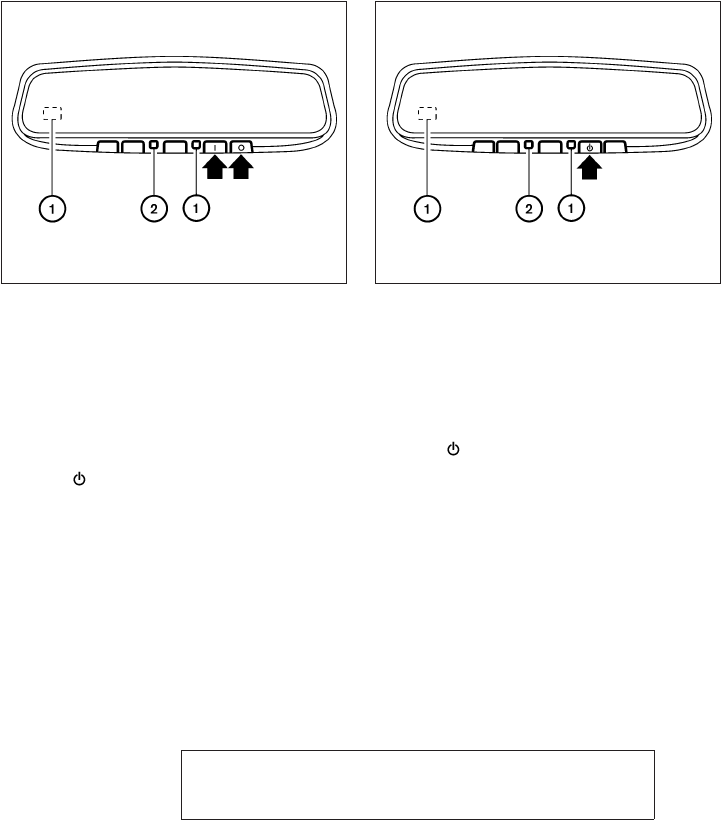
JOBNAME: 1093929-2013-asd-own PAGE: 158 SESS: 4 OUTPUT: Tue Mar 27 10:39:14 2012
AUTOMATIC ANTI-GLARE
REARVIEW MIRROR (if so equipped)
The inside mirror is designed so that it automati-
cally dims during night time conditions and ac-
cording to the intensity of the headlights of the
vehicle following you. The automatic anti-glare
feature is activated when the ignition switch is in
the ON position.
The indicator light will illuminate when the auto-
matic anti-glare feature is operating.
NOTE:
Do not hang any objects over the sensors
s
1or apply glass cleaner to the sensors.
Doing so will reduce the sensitivity of the
sensors, resulting in improper operation. Type A and Type B
The indicator light s
2will illuminate when the
automatic anti-glare feature is operating.
To turn off the automatic anti-glare feature, press:
●the O button for inside mirrors without
compass.
●the button for inside mirrors with
compass.
The indicator light will turn off.
To turn on the automatic anti-glare feature again,
press:
●the | button for inside mirrors without
compass.
●the button for inside mirrors with
compass.
The indicator light will turn on.
For information on HomeLinkTUniversal Trans-
ceiver operation, see the “HomeLinkTUniversal
Transceiver” in the “Instruments and controls”
section of this manual.
Type A - Without compass
LPD0469
Type B - With compass
LPD0470
3-34 Pre-driving checks and adjustments
ZREVIEW COPY—
2013 Altima Sedan (asd)
Owners Manual—USA_English (nna)
03/24/12—dmoore
X
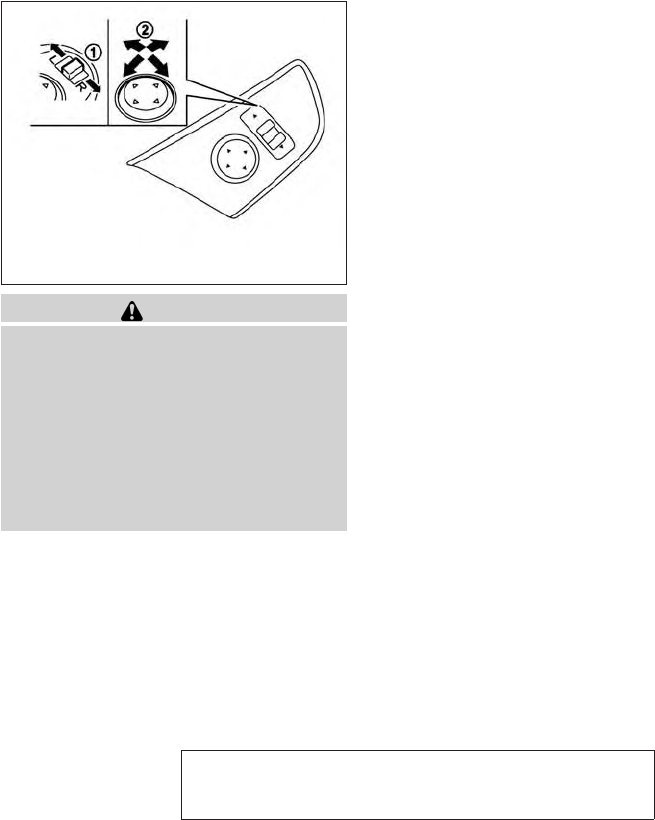
JOBNAME: 1093929-2013-asd-own PAGE: 159 SESS: 4 OUTPUT: Tue Mar 27 10:39:14 2012
For information on the compass display (if so
equipped), see “Compass display” in the “Instru-
ments and controls” section of this manual.
OUTSIDE MIRRORS
WARNING
●Do not adjust the mirrors while driving.
You could lose control of your vehicle
and cause an accident.
●Objects viewed in the outside mirror on
the passenger side are closer than they
appear. Be careful when moving to the
right. Using only this mirror could cause
an accident. Use the inside mirror or
glance over your shoulder to properly
judge distances to other objects.
The outside mirror remote control only operates
when the ignition switch is placed in the ACC or
ON position.
Move the small switch s
1to select the right or left
mirror. Adjust each mirror to the desired position
using the large switch s
2.
Heated mirrors (if so equipped)
Some outside mirrors can be heated to defrost,
defog, or de-ice for improved visibility. For addi-
tional information, see “Rear window and outside
mirror defroster switch” in the “Instruments and
controls” section of this manual.
LPD2083
Pre-driving checks and adjustments 3-35
ZREVIEW COPY—
2013 Altima Sedan (asd)
Owners Manual—USA_English (nna)
03/24/12—dmoore
X
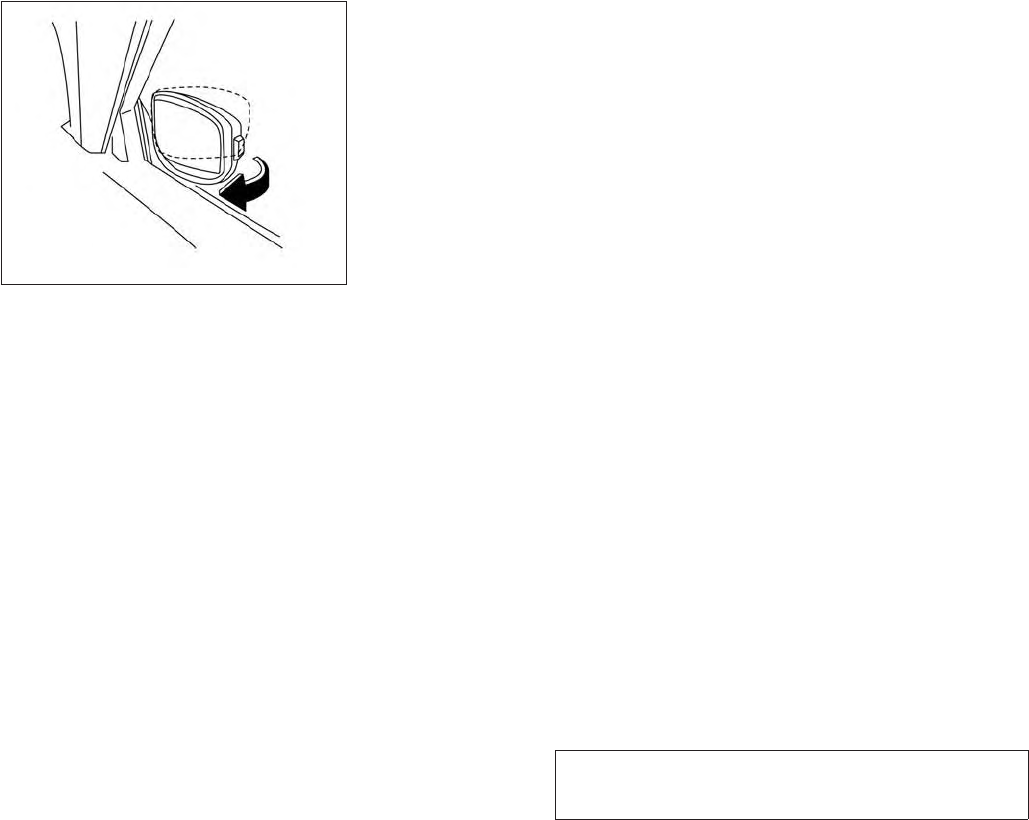
JOBNAME: 1093929-2013-asd-own PAGE: 160 SESS: 4 OUTPUT: Tue Mar 27 10:39:14 2012
Manual folding outside mirrors (if so
equipped)
Pull the outside mirror toward the door to fold it.
LPD2084
3-36 Pre-driving checks and adjustments
ZREVIEW COPY—
2013 Altima Sedan (asd)
Owners Manual—USA_English (nna)
03/24/12—dmoore
X

JOBNAME: 1093929-2013-asd-own PAGE: 161 SESS: 5 OUTPUT: Tue Mar 27 10:39:14 2012
4 Monitor, climate, audio, phone and voice
recognition systems
Control panel buttons — color screen with
Navigation System (if so equipped) . . . . . . . . . . . . . . . . . . 4-4
How to use the touch screen . . . . . . . . . . . . . . . . . . . . 4-5
How to use the BACK button . . . . . . . . . . . . . . . . . . . . 4-7
How to use the MENU button . . . . . . . . . . . . . . . . . . . . 4-7
button..................................4-11
RearView Monitor (if so equipped). . . . . . . . . . . . . . . . . . 4-11
How to read the displayed lines . . . . . . . . . . . . . . . . .4-12
How to park with predicted course lines
(Navigation System only) . . . . . . . . . . . . . . . . . . . . . . .4-13
Difference between predicted and actual
distances.....................................4-14
Adjustingthescreen...........................4-17
Operatingtips.................................4-18
Vents ...........................................4-18
Heater and air conditioner (manual)
(ifsoequipped)..................................4-19
Controls......................................4-20
Heateroperation ..............................4-21
Air conditioner operation . . . . . . . . . . . . . . . . . . . . . . .4-22
Airflowcharts.................................4-23
Heater and air conditioner (automatic)
(ifsoequipped)..................................4-27
Automaticoperation ...........................4-28
Manualoperation..............................4-28
Operating tips. . . . . . . . . . . . . . . . . . . . . . . . . . . . . . . . .4-29
Servicing air conditioner. . . . . . . . . . . . . . . . . . . . . . . . . . .4-30
Audio system . . . . . . . . . . . . . . . . . . . . . . . . . . . . . . . . . . . .4-30
Radio........................................4-30
FMradioreception ............................4-30
AMradioreception............................4-31
Satellite radio reception (if so equipped) . . . . . . . . .4-31
Audio operation precautions . . . . . . . . . . . . . . . . . . . .4-31
FM/AM radio with compact disc (CD) player
(ifsoequipped)...............................4-39
FM/AM/SAT radio with compact disc (CD)
player (Type A) (if so equipped) . . . . . . . . . . . . . . . . . 4-43
FM/AM/SAT radio with compact disc (CD)
player (Type B) (if so equipped) . . . . . . . . . . . . . . . . .4-48
USB interface (models without Navigation
System) (if so equipped) . . . . . . . . . . . . . . . . . . . . . . . 4-54
USB interface (models with Navigation
System)......................................4-56
iPodT* player operation without Navigation
System (if so equipped) . . . . . . . . . . . . . . . . . . . . . . . .4-57
iPodT* player operation with Navigation
System (if so equipped) . . . . . . . . . . . . . . . . . . . . . . . .4-59
ZREVIEW COPY—
2013 Altima Sedan (asd)
Owners Manual—USA_English (nna)
03/24/12—dmoore
X

JOBNAME: 1093929-2013-asd-own PAGE: 162 SESS: 5 OUTPUT: Tue Mar 27 10:39:14 2012
BluetoothTstreaming audio without
Navigation System (Type A) (if so equipped). . . . . .4-62
BluetoothTstreaming audio without
Navigation System (Type B) (if so equipped). . . . . .4-62
BluetoothTstreaming audio with Navigation
System (if so equipped) . . . . . . . . . . . . . . . . . . . . . . . .4-64
PandoraTaudio (United States only)
(ifsoequipped)...............................4-65
CDcareandcleaning..........................4-67
Steering wheel switch for audio control
(ifsoequipped)...............................4-68
Antenna......................................4-69
CarphoneorCBradio............................4-69
BluetoothTHands-Free Phone System without
Navigation System (Type A) (if so equipped). . . . . . . . .4-70
Regulatory Information . . . . . . . . . . . . . . . . . . . . . . . . .4-72
Usingthesystem..............................4-72
Controlbuttons ...............................4-75
Gettingstarted................................4-75
List of voice commands . . . . . . . . . . . . . . . . . . . . . . . .4-77
Voice Adaptation (VA) mode . . . . . . . . . . . . . . . . . . . .4-81
Manualcontrol................................4-83
Troubleshooting guide . . . . . . . . . . . . . . . . . . . . . . . . .4-84
BluetoothTHands-Free Phone System without
Navigation System (Type B) (if so equipped). . . . . . . . .4-85
Regulatory Information . . . . . . . . . . . . . . . . . . . . . . . . .4-86
Usingthesystem..............................4-87
Controlbuttons ...............................4-88
Connecting procedure . . . . . . . . . . . . . . . . . . . . . . . . .4-88
Voicecommands..............................4-89
Makingacall..................................4-91
Receivingacall ...............................4-91
Duringacall..................................4-92
Endingacall..................................4-92
Textmessaging................................4-92
BluetoothTsettings............................4-94
Manualcontrol................................4-96
BluetoothTHands-Free Phone System with
Navigation System (if so equipped) . . . . . . . . . . . . . . . . .4-96
Regulatory Information . . . . . . . . . . . . . . . . . . . . . . . . .4-98
Voicecommands..............................4-98
Connecting procedure . . . . . . . . . . . . . . . . . . . . . . . . .4-99
Vehicle phonebook . . . . . . . . . . . . . . . . . . . . . . . . . . .4-100
Making a call. . . . . . . . . . . . . . . . . . . . . . . . . . . . . . . . .4-101
Receiving a call . . . . . . . . . . . . . . . . . . . . . . . . . . . . . .4-101
ZREVIEW COPY—
2013 Altima Sedan (asd)
Owners Manual—USA_English (nna)
03/24/12—dmoore
X

JOBNAME: 1093929-2013-asd-own PAGE: 163 SESS: 5 OUTPUT: Tue Mar 27 10:39:14 2012
Duringacall.................................4-102
Endingacall.................................4-102
Textmessaging...............................4-102
Bluetoothsettings............................4-104
Phonesettings...............................4-105
NISSAN Voice Recognition System
(ifsoequipped).................................4-106
Usingthesystem.............................4-106
System features . . . . . . . . . . . . . . . . . . . . . . . . . . . . . .4-108
BluetoothTHands-Free Phone System voice
commands. . . . . . . . . . . . . . . . . . . . . . . . . . . . . . . . . . .4-109
Navigation System voice commands . . . . . . . . . . . .4-110
Audio system voice commands. . . . . . . . . . . . . . . . .4-110
Information voice commands. . . . . . . . . . . . . . . . . . .4-111
Help voice commands . . . . . . . . . . . . . . . . . . . . . . . .4-111
Troubleshooting guide . . . . . . . . . . . . . . . . . . . . . . . .4-112
ZREVIEW COPY—
2013 Altima Sedan (asd)
Owners Manual—USA_English (nna)
03/24/12—dmoore
X
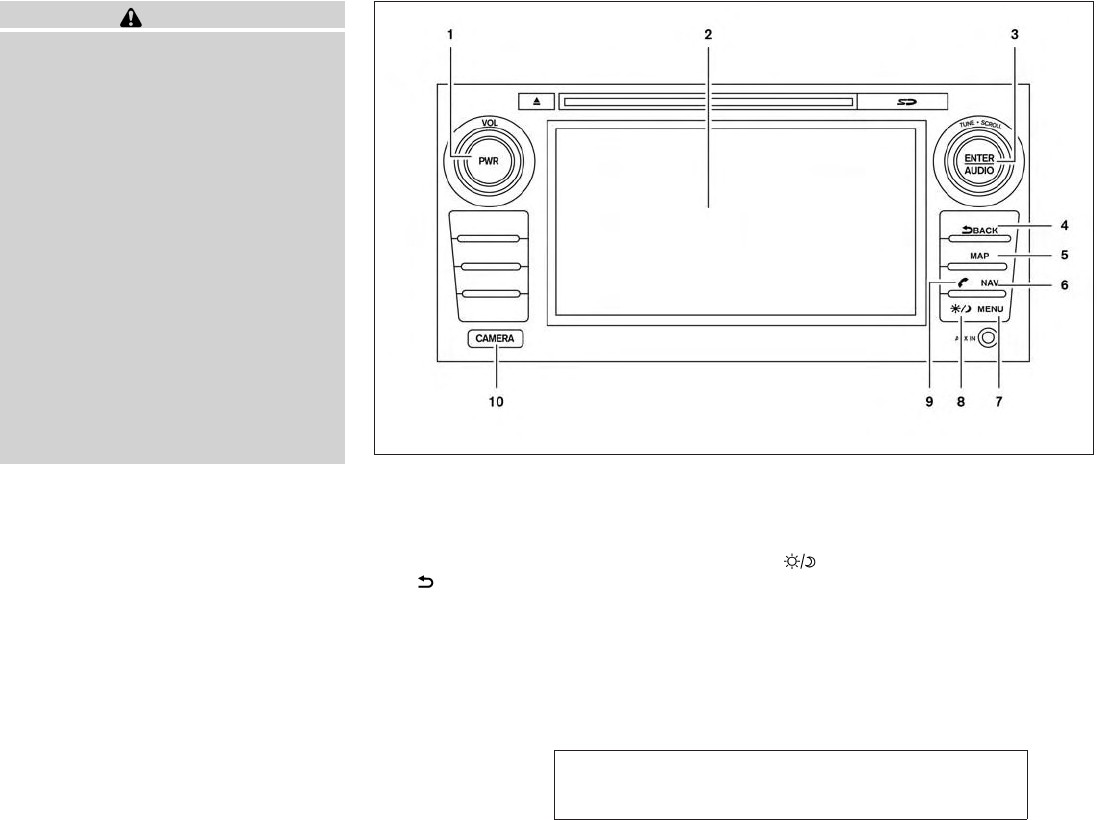
JOBNAME: 1093929-2013-asd-own PAGE: 164 SESS: 4 OUTPUT: Tue Mar 27 10:39:14 2012
WARNING
●Positioning of the heating or air condi-
tioning controls and display controls
should not be done while driving in or-
der that full attention may be given to
the driving operation.
●Do not disassemble or modify this sys-
tem. If you do, it may result in accidents,
fire, or electrical shock.
●Do not use this system if you notice any
abnormality, such as a frozen screen or
lack of sound. Continued use of the
system may result in accident, fire or
electric shock.
●In case you notice any foreign object in
the system hardware, spill liquid on it,
or notice smoke or smell coming from
it, stop using the system immediately
and contact your nearest NISSAN
dealer. Ignoring such conditions may
lead to accidents, fire or electrical
shock.
1. PWR button/VOL (volume) control knob
2. Display screen
3. ENTER / AUDIO button / TUNE / SCROLL
knob
4. BACK button
5. MAP button*
6. NAV button*
7. MENU button
8. (brightness control) button
LHA2239
CONTROL PANEL BUTTONS —
COLOR SCREEN WITH NAVIGATION
SYSTEM (if so equipped)
4-4 Monitor, climate, audio, phone and voice recognition systems
ZREVIEW COPY—
2013 Altima Sedan (asd)
Owners Manual—USA_English (nna)
03/24/12—dmoore
X

JOBNAME: 1093929-2013-asd-own PAGE: 165 SESS: 4 OUTPUT: Tue Mar 27 10:39:14 2012
9. button**
10. CAMERA button
* For information regarding the Navigation system
control buttons, refer to the separate Navigation
System Owner’s Manual.
** For information regarding the BluetoothT
Hands-Free Phone System control button, see
“BluetoothTHands-Free Phone System” in this
section.
When you use this system, make sure the engine
is running.
If you use the system with the engine not
running (ignition ON or ACC) for a long
time, it will discharge the battery, and the
engine will not start.
Reference symbols:
“Example” — Words marked in quotes refer to a
key shown only on the display. These keys can be
selected by touching the screen.
HOW TO USE THE TOUCH
SCREEN
CAUTION
●The glass display screen may break if it
is hit with a hard or sharp object. If the
glass screen breaks, do not touch it.
Doing so could result in an injury.
●To clean the display, never use a rough
cloth, alcohol, benzine, thinner or any
kind of solvent or paper towel with a
chemical cleaning agent. They will
scratch or deteriorate the panel.
●Do not splash any liquid such as water
or car fragrance on the display. Contact
with liquid will cause the system to
malfunction.
To help ensure safe driving, some functions can-
not be operated while driving.
The on-screen functions that are not available
while driving will be “grayed out” or muted.
Park the vehicle in a safe location and then oper-
ate the navigation system.
WARNING
●ALWAYS give your full attention to
driving.
●Avoid using vehicle features that could
distract you. If distracted, you could
lose control of your vehicle and cause
an accident.
Monitor, climate, audio, phone and voice recognition systems 4-5
ZREVIEW COPY—
2013 Altima Sedan (asd)
Owners Manual—USA_English (nna)
03/24/12—dmoore
X
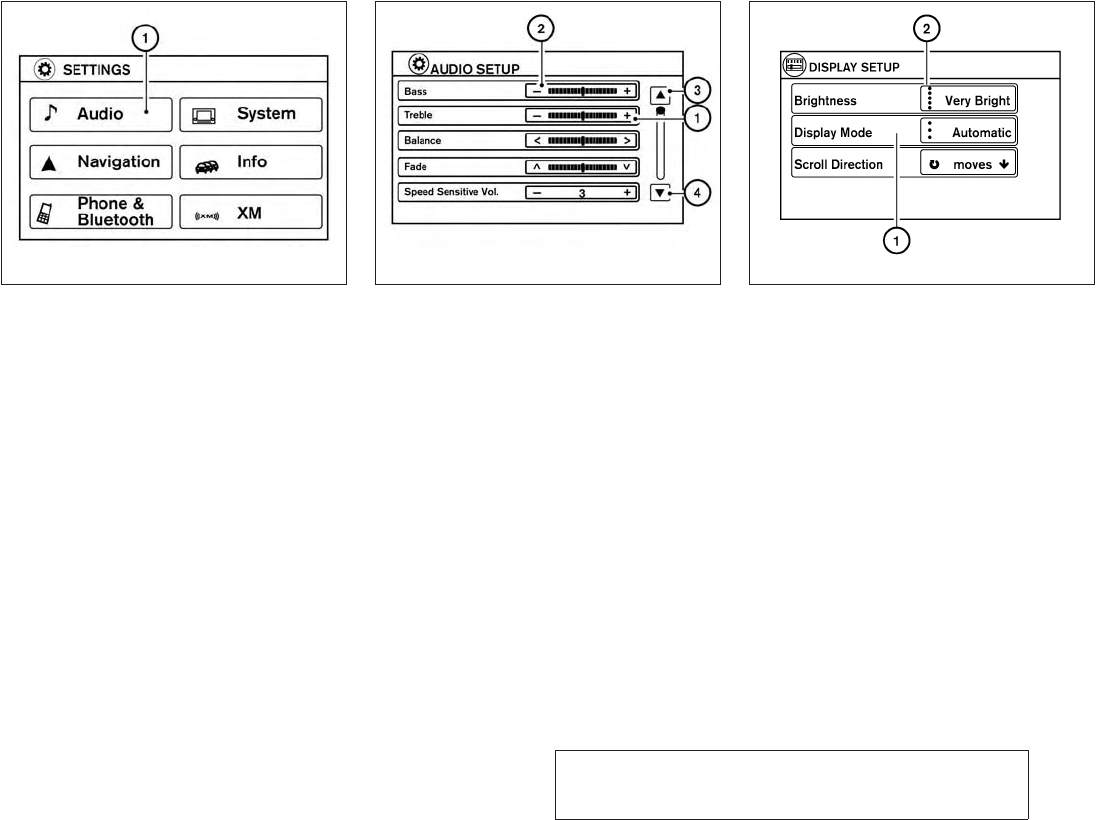
JOBNAME: 1093929-2013-asd-own PAGE: 166 SESS: 4 OUTPUT: Tue Mar 27 10:39:14 2012
Touch screen operation
Selecting the item:
Touch an item to select. For example, to select
the “Audio” key, touch the “Audio” key s
1on the
screen.
Adjusting the item:
For screens where an item can be adjusted incre-
mentally, such as when adjusting the bass and
treble for the audio system, touch the “+” key s
1
or the “2”key s
2to adjust the settings of an item.
When there are more items than can be dis-
played on one screen, touch the up arrow s
3to
scroll up the page or touch the down arrow s
4to
scroll down the page.
Other items are adjusted by selecting one of a set
number of conditions. For example, the Display
Mode can be set to “Automatic”, “Day”or “Night”.
To adjust this type of item, touch the item s
1. The
item will cycle through the available settings and
the red indicator lights to the left of the setting
condition s
2will come on or turn off accordingly.
LHA2245 LHA2246 LHA1478
4-6 Monitor, climate, audio, phone and voice recognition systems
ZREVIEW COPY—
2013 Altima Sedan (asd)
Owners Manual—USA_English (nna)
03/24/12—dmoore
X
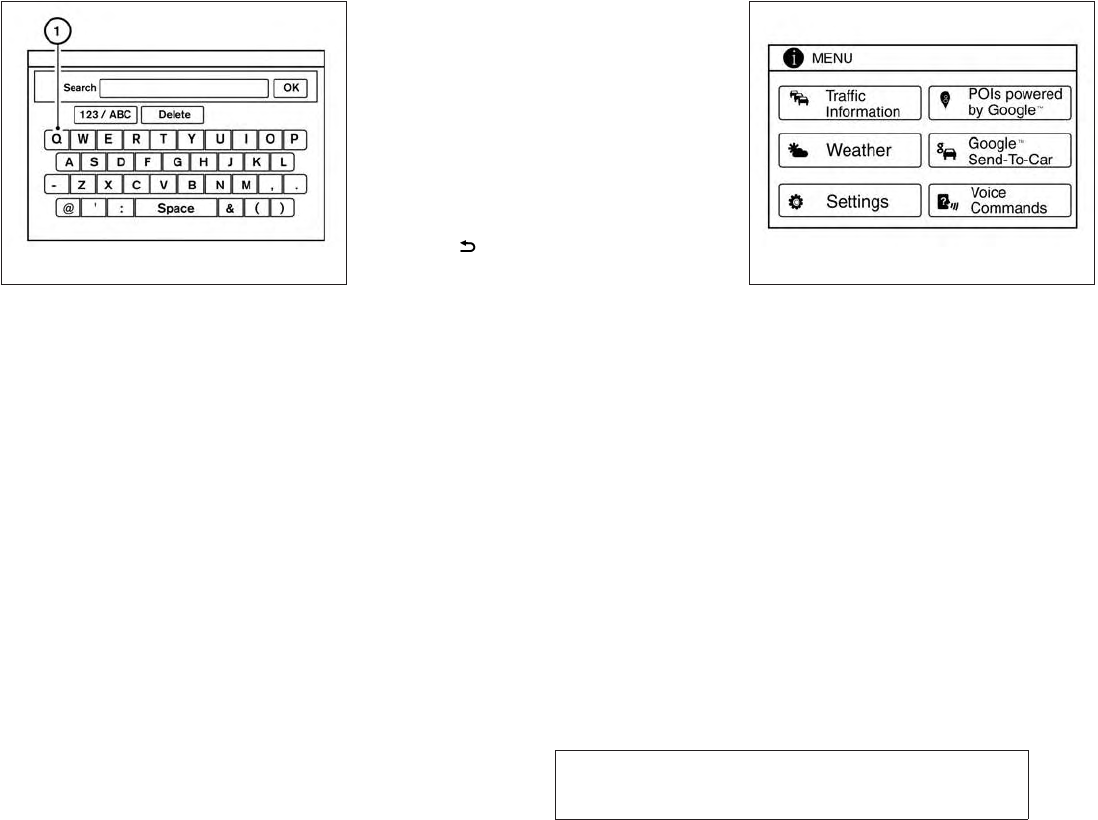
JOBNAME: 1093929-2013-asd-own PAGE: 167 SESS: 4 OUTPUT: Tue Mar 27 10:39:14 2012
Inputting characters:
Touch the letter key s
1.
There are some options available when inputting
characters.
●123 / ABC:
Changes the available character set to num-
bers.
●Space:
Inserts a space.
●Delete:
Deletes the last inputted character with one
touch. Touch and hold the “Delete” key to
delete all of the characters.
●OK:
Completes the character input.
Touch screen maintenance
If you clean the display screen, use a dry, soft
cloth. If additional cleaning is necessary, use a
small amount of neutral detergent with a soft
cloth. Never spray the screen with water or de-
tergent. Dampen the cloth first and then wipe the
screen.
HOW TO USE THE BACK BUTTON
Press the BACK button to return to the
previous screen.
HOW TO USE THE MENU BUTTON
For more information about the “POIs Powered
by Google™”, “Google™ Send-To-Car, “Traffic
Information” and “Weather” features, see the
separate Navigation System Owner’s Manual.
For more information about the “Voice Com-
mands” key, see “Nissan Voice Recognition Sys-
tem” in this section.
To select and/or adjust several functions, fea-
tures and modes that are available for your ve-
hicle:
1. Press the MENU button.
2. Select the “Settings” key.
LHA2247 LHA2253
Monitor, climate, audio, phone and voice recognition systems 4-7
ZREVIEW COPY—
2013 Altima Sedan (asd)
Owners Manual—USA_English (nna)
03/24/12—dmoore
X
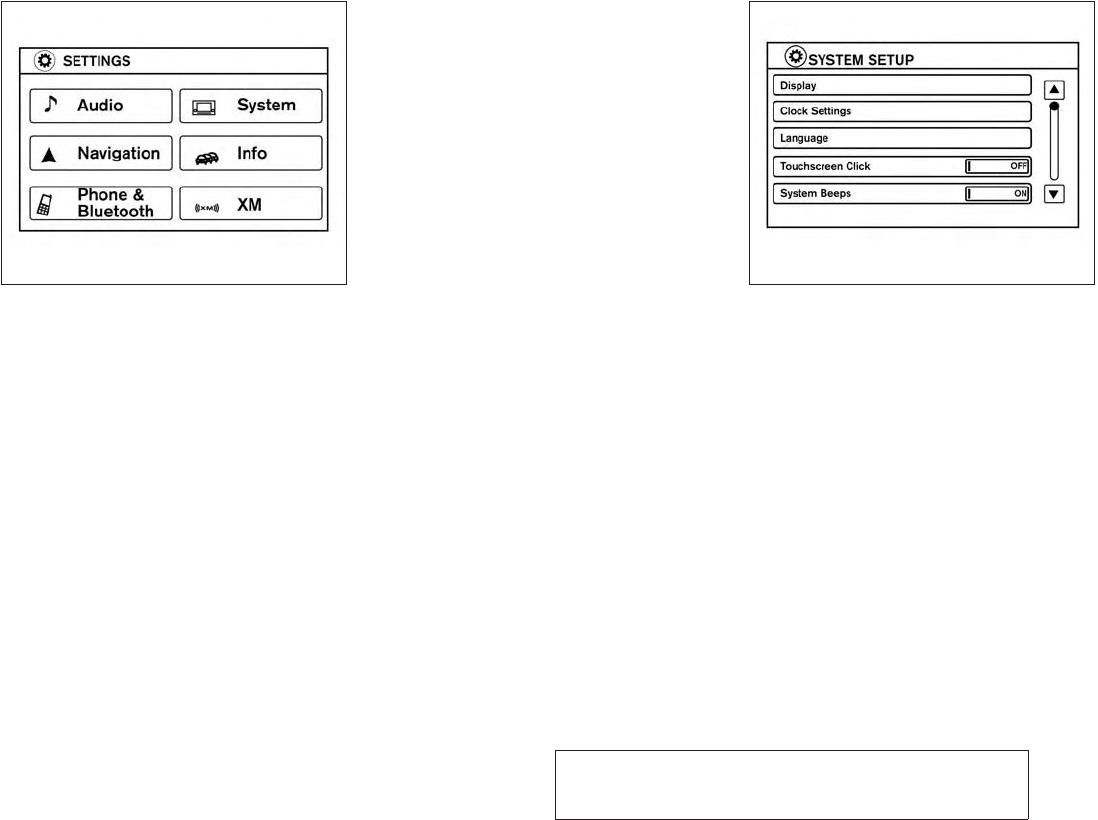
JOBNAME: 1093929-2013-asd-own PAGE: 168 SESS: 4 OUTPUT: Tue Mar 27 10:39:14 2012
3. Select the desired item.
Audio
For audio setup, refer to “Audio system” in this
section.
Navigation
Refer to the separate Navigation System Own-
er’s Manual for information regarding this item.
Phone & Bluetooth
For information regarding the BluetoothTHands-
Free Phone System, see “BluetoothTHands-
Free Phone System” in this section.
For information regarding BluetoothTaudio, see
“BluetoothTstreaming audio with Navigation
System” in this section.
System
Select the “System” key to select and/or adjust
various functions of the system. A screen with
additional options will appear.
LHA2248 LHA2249
4-8 Monitor, climate, audio, phone and voice recognition systems
ZREVIEW COPY—
2013 Altima Sedan (asd)
Owners Manual—USA_English (nna)
03/24/12—dmoore
X
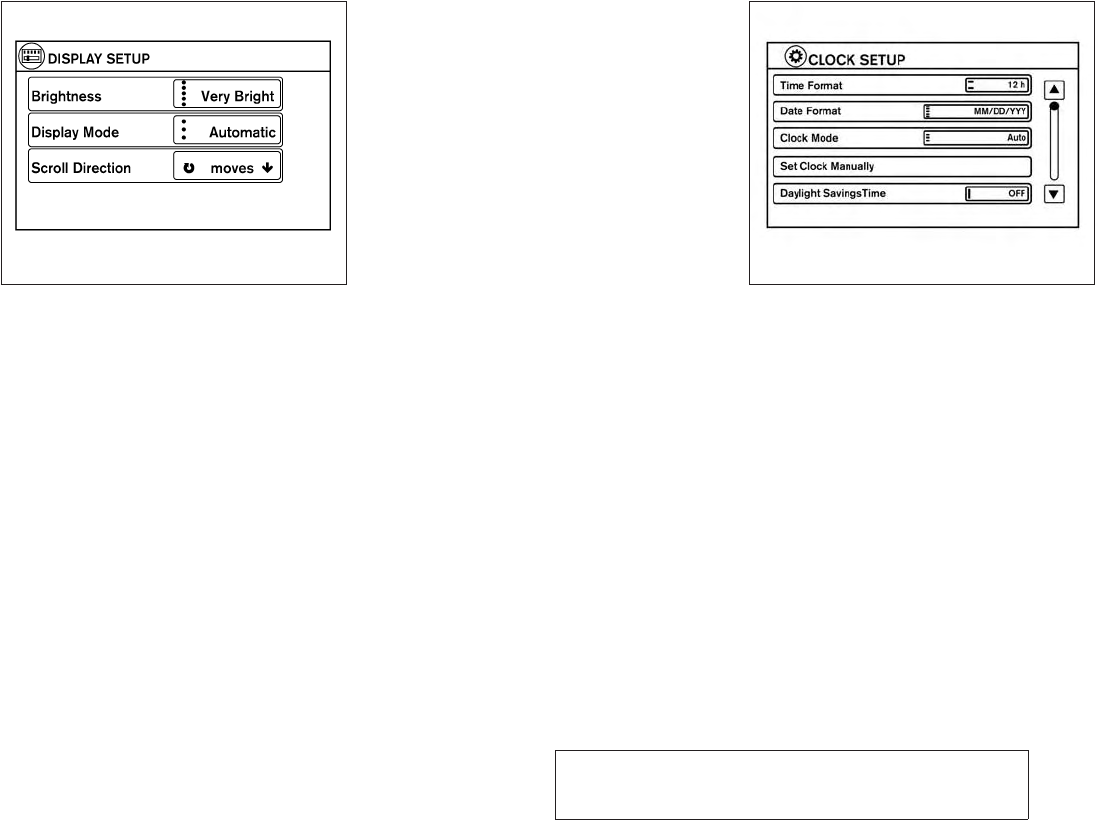
JOBNAME: 1093929-2013-asd-own PAGE: 169 SESS: 4 OUTPUT: Tue Mar 27 10:39:14 2012
Display:
Select the “Display”key to adjust the appearance
of the display. The following settings can be
adjusted:
Brightness
The brightness of the display can be set to Very
Bright, Bright, Default, Dark or Very Dark. Touch
the “Brightness”key to cycle through the options.
Display Mode
The display can be adjusted to fit the level of
lighting in the vehicle. Touch the “Display Mode”
key to cycle through the options. “Day” and
“Night” modes are suited for the respective times
of day, while “Automatic” controls the display
automatically.
Scroll Direction
The direction that menus scroll can be adjusted.
Choose either “up” or “down”.
Clock Settings:
Select the “Clock Settings” key to adjust the time
and the appearance of the clock on the display.
The following settings can be adjusted:
Time Format
The clock can be set to 12 hours or 24 hours.
Date Format
Select from five possible formats of displaying
the day, month and year.
LHA1482 LHA2250
Monitor, climate, audio, phone and voice recognition systems 4-9
ZREVIEW COPY—
2013 Altima Sedan (asd)
Owners Manual—USA_English (nna)
03/24/12—dmoore
X
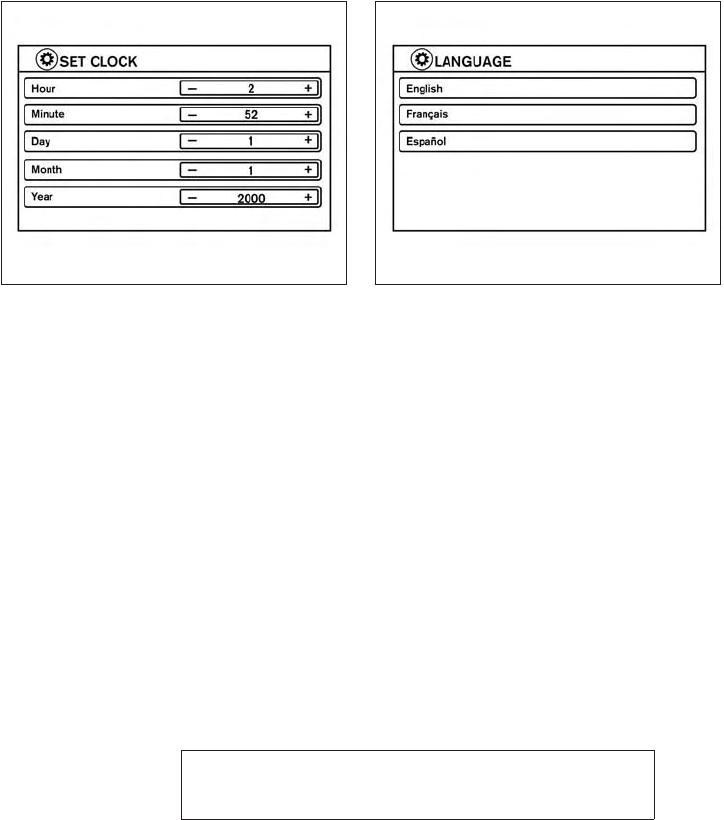
JOBNAME: 1093929-2013-asd-own PAGE: 170 SESS: 4 OUTPUT: Tue Mar 27 10:39:14 2012
Clock Mode
Select the mode for the clock. “Auto” uses the
system’s GPS to automatically maintain the time.
“Manual” allows you to set the clock using the
“Set Clock Manually” key. “Time Zone” maintains
the time based upon the zone selected when
selecting the “Time Zone” key.
Set Clock Manually
When this setting is activated, the clock can be
set manually. Touch the “+” or “-” keys to adjust
the hours, minutes, day, month and year up or
down. “Clock Mode” must be set to “Manual” for
this option to be available.
Daylight Savings Time
When this setting is activated, daylight savings
time is on. Touch the “Daylight Savings Time” key
to toggle the setting on or off.
Time Zone
Choose the applicable time zone from the list.
Language:
Select the “Language”key to adjust the language
used by the system. The language can be set to
English, Français or Español.
Touchscreen click:
Select the “Touchscreen Click” key to toggle the
touchscreen click feature on or off. When acti-
vated, a click sound will be heard every time a key
on the screen is touched.
System Beeps:
Select the “System Beeps” key to toggle the
system beep tones feature on or off. When acti-
vated, a beep sound will be heard when a pop-up
LHA2251 LHA2252
4-10 Monitor, climate, audio, phone and voice recognition systems
ZREVIEW COPY—
2013 Altima Sedan (asd)
Owners Manual—USA_English (nna)
03/24/12—dmoore
X
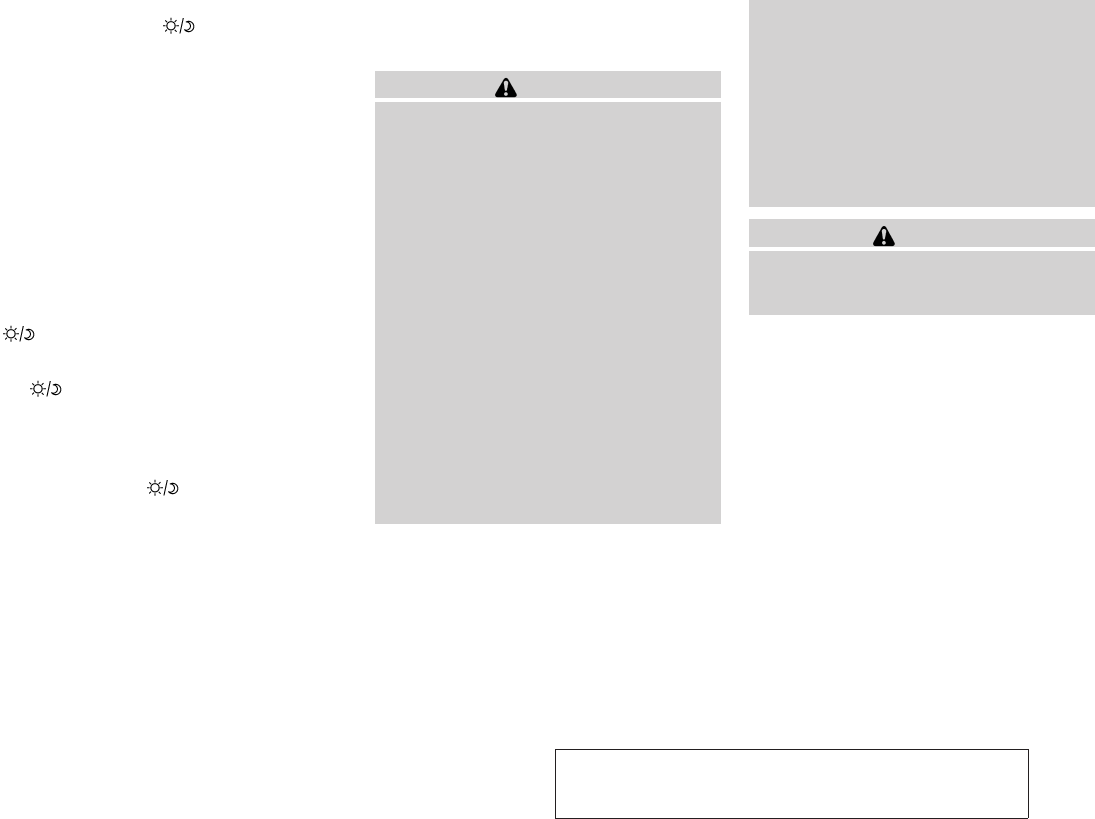
JOBNAME: 1093929-2013-asd-own PAGE: 171 SESS: 4 OUTPUT: Tue Mar 27 10:39:14 2012
message appears on the screen or a button on
the unit (such as the button) is pressed
and held for two seconds.
Reset all settings/memory:
Select the “Reset All Settings/Memory” key to
return all settings to default and to clear the
memory.
Info
For information about the “Info” key, see the
separate Navigation System Owner’s Manual.
XM
For XM setup, refer to “Audio system” in this
section.
BUTTON
To change the display brightness, press
the button. Pressing the button again will
change the display to the day or the night display.
If no operation is performed within 5 seconds, the
display will return to the previous display.
Press and hold the button for more than
two seconds to turn the display off. Press the
button again to turn the display on.
When the shift selector is shifted into the R
(Reverse) position, the monitor display shows a
rearward view from the vehicle.
WARNING
●The system is designed as an aid to the
driver in detecting large stationary ob-
jects to help avoid damaging the ve-
hicle. The system will not detect small
objects below the bumper, and may not
detect objects close to the bumper or
on the ground.
●The RearView Monitor is a convenience
but it is not a substitute for proper back-
ing. Always turn and check that it is safe
to do so before backing up. Always
back up slowly.
●Objects viewed in the RearView Moni-
tor differ from actual distance because
a wide-angle lens is used.
●Make sure that the trunk is securely
closed when backing up.
●Do not put anything on the rearview
camera. The rearview camera is in-
stalled beside the license plate light.
●When washing the vehicle with high-
pressure water, be sure not to spray it
around the camera. Otherwise, water
may enter the camera unit causing wa-
ter condensation on the lens, a mal-
function, fire or an electric shock.
●Do not strike the camera. It is a preci-
sion instrument. Otherwise, it may mal-
function or cause damage resulting in a
fire or an electric shock.
CAUTION
There is a plastic cover over the camera.
Do not scratch the cover when cleaning
dirt or snow from the cover.
REARVIEW MONITOR (if so
equipped)
Monitor, climate, audio, phone and voice recognition systems 4-11
ZREVIEW COPY—
2013 Altima Sedan (asd)
Owners Manual—USA_English (nna)
03/24/12—dmoore
X
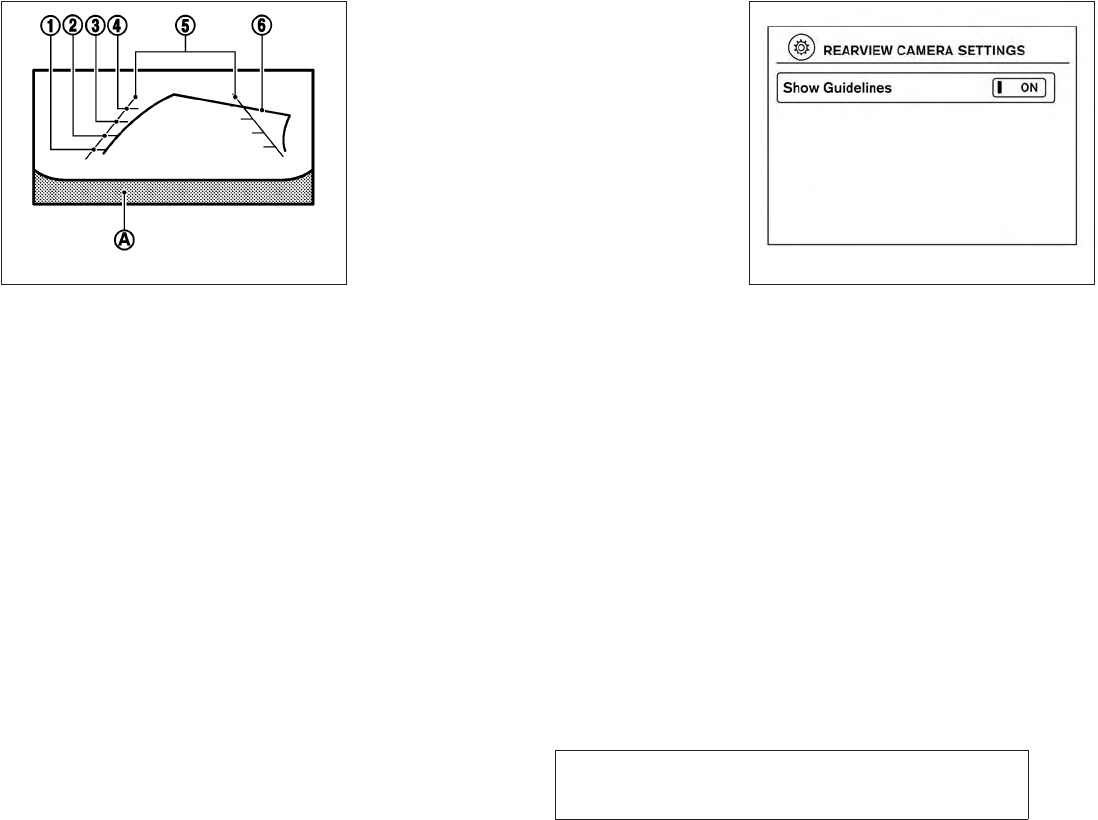
JOBNAME: 1093929-2013-asd-own PAGE: 172 SESS: 4 OUTPUT: Tue Mar 27 10:39:14 2012
HOW TO READ THE DISPLAYED
LINES
Guiding lines which indicate the vehicle width
and distances to objects with reference to the
vehicle body line s
Aare displayed on the monitor.
Distance guide lines:
Indicate distances from the vehicle body.
●Red line s
1: approx. 1.5 ft (0.5 m)
●Yellow line s
2: approx. 3 ft (1 m)
●Green line s
3: approx. 7 ft (2 m)
●Green line s
4: approx. 10 ft (3 m)
Vehicle width guide lines s
5:
Indicate the vehicle width when backing up.
Predicted course lines s
6(Navigation Sys-
tem only):
Indicate the predicted course when backing up.
The predicted course lines will be displayed on
the monitor when the shift selector is in the R
(Reverse) position and the steering wheel is
turned. The predicted course lines will move de-
pending on how much the steering wheel is
turned and will not be displayed while the steer-
ing wheel is in the neutral position.
The vehicle width guide lines and the width of the
predicted course lines are wider than the actual
width and course. The predicted course lines feature can be set to
on or off.
1. Press the CAMERA button.
2. Select the “Show Guidelines” key to toggle
the feature on or off.
LHA1196 LHA2278
4-12 Monitor, climate, audio, phone and voice recognition systems
ZREVIEW COPY—
2013 Altima Sedan (asd)
Owners Manual—USA_English (nna)
03/24/12—dmoore
X
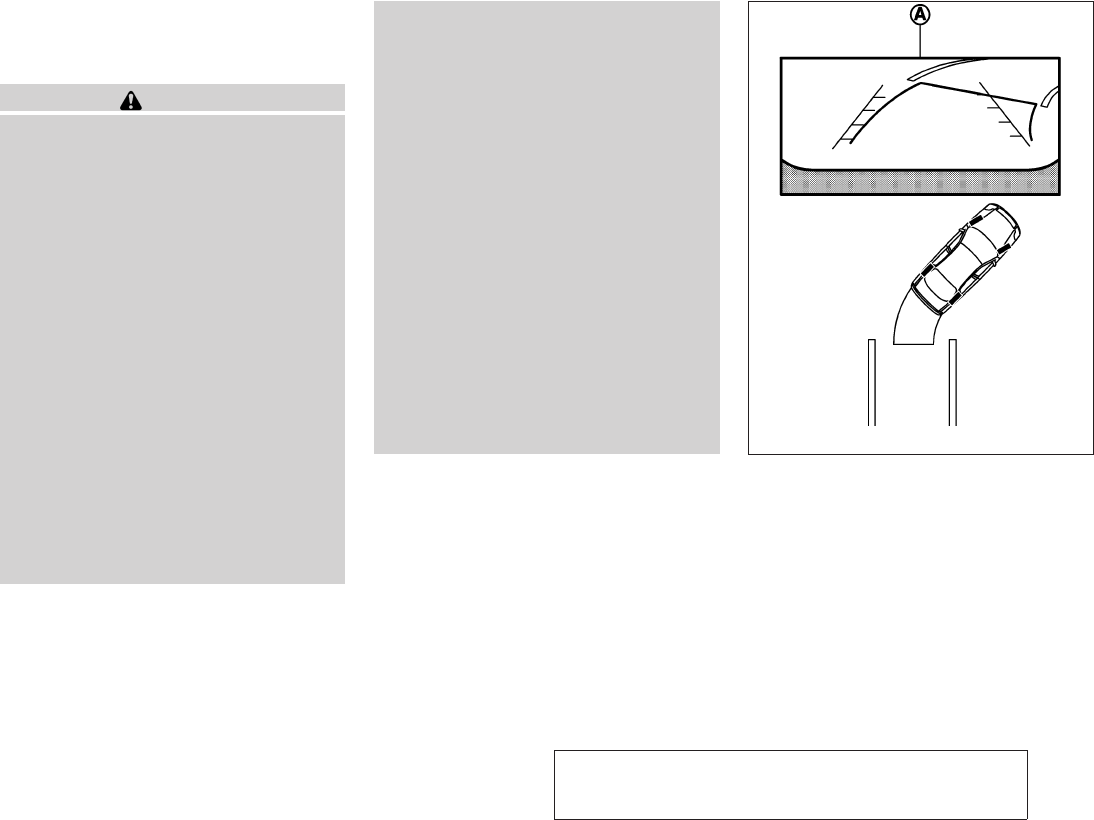
JOBNAME: 1093929-2013-asd-own PAGE: 173 SESS: 4 OUTPUT: Tue Mar 27 10:39:14 2012
HOW TO PARK WITH PREDICTED
COURSE LINES (Navigation System
only)
WARNING
●Always turn and check that it is safe to
do so before backing up. Always back
up slowly.
●Use the displayed lines as a reference.
The lines are highly affected by the
number of occupants, fuel level, vehicle
position, road conditions and road
grade.
●If the tires are replaced with different
sized tires, the predicted course lines
may be displayed incorrectly.
●On a snow-covered or slippery road,
there may be a difference between the
predicted course line and the actual
course line.
●If the battery is disconnected or be-
comes discharged, the predicted
course lines may be displayed incor-
rectly. If this occurs, please perform the
following procedures:
– Turn the steering wheel from lock to
lock while the engine is running.
– Drive the vehicle on a straight road
for more than 5 minutes.
●When the steering wheel is turned with
the ignition switch in the ACC position,
the predicted course lines may be dis-
played incorrectly.
●The distance guide line and the vehicle
width line should be used as a refer-
ence only when the vehicle is on a level
paved surface. The distance viewed on
the monitor is for reference only and
may be different than the actual dis-
tance between the vehicle and dis-
played objects.
●When backing up the vehicle up a hill,
objects viewed in the monitor are fur-
ther than they appear. When backing up
the vehicle down a hill, objects viewed
in the monitor are closer than they ap-
pear. Use the inside mirror or glance
over your shoulder to properly judge
distances to other objects.
The vehicle width and predicted course
lines are wider than the actual width and
course.
1. Visually check that the parking space is safe
before parking your vehicle.
2. The rear view of the vehicle is displayed on
the screen s
Awhen the shift selector is
moved to the R (Reverse) position.
LHA1197
Monitor, climate, audio, phone and voice recognition systems 4-13
ZREVIEW COPY—
2013 Altima Sedan (asd)
Owners Manual—USA_English (nna)
03/24/12—dmoore
X
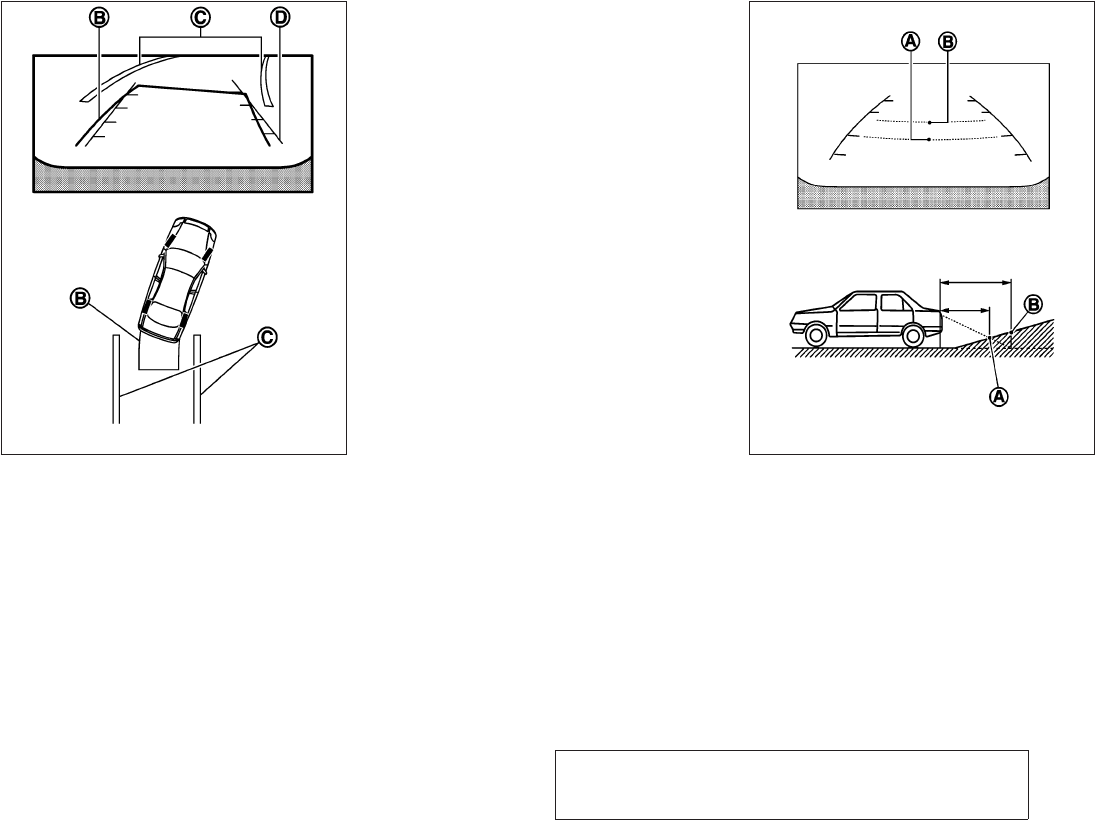
JOBNAME: 1093929-2013-asd-own PAGE: 174 SESS: 4 OUTPUT: Tue Mar 27 10:39:14 2012
3. Slowly back up the vehicle, adjusting the
steering wheel so that the predicted course
lines s
Benter the parking space s
C.
4. Maneuver the steering wheel to make the
vehicle width guide lines s
Dparallel to the
parking space s
Cwhile referring to the pre-
dicted course lines.
5. When the vehicle is parked in the space
completely, move the shift selector to the P
(Park) position and apply the parking brake.
DIFFERENCE BETWEEN
PREDICTED AND ACTUAL
DISTANCES
The distance guide line and the vehicle width
guide line should be used as a reference only
when the vehicle is on a level, paved surface. The
distance viewed on the monitor is for reference
only and may be different than the actual distance
between the vehicle and displayed objects.
LHA1198 WHA1504
4-14 Monitor, climate, audio, phone and voice recognition systems
ZREVIEW COPY—
2013 Altima Sedan (asd)
Owners Manual—USA_English (nna)
03/24/12—dmoore
X
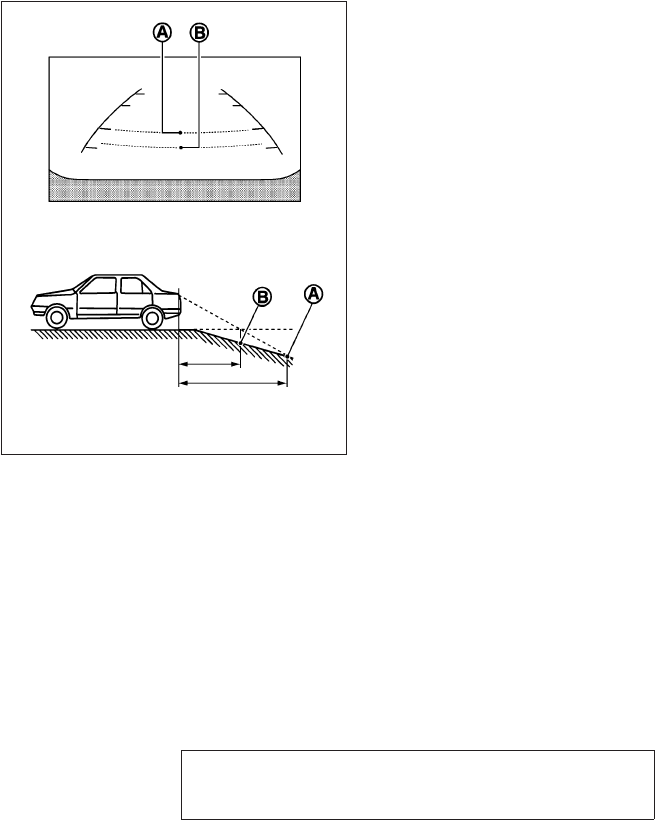
JOBNAME: 1093929-2013-asd-own PAGE: 175 SESS: 4 OUTPUT: Tue Mar 27 10:39:14 2012
Backing up on a steep uphill
When backing up the vehicle up a hill, the dis-
tance guide lines and the vehicle width guide
lines are shown closer than the actual distance.
For example, the display shows 3 ft (1.0 m) to the
place s
A, but the actual 3 ft (1.0 m) distance on
the hill is the place s
B. Note that any object on
the hill is further than it appears on the monitor.
Backing up on a steep downhill
When backing up the vehicle down a hill, the
distance guide lines and the vehicle width guide
lines are shown farther than the actual distance.
For example, the display shows 3 ft (1.0 m) to the
place s
A, but the actual 3 ft (1.0 m) distance on
the hill is the place s
B. Note that any object on
the hill is closer than it appears on the monitor.
WHA1505
Monitor, climate, audio, phone and voice recognition systems 4-15
ZREVIEW COPY—
2013 Altima Sedan (asd)
Owners Manual—USA_English (nna)
03/24/12—dmoore
X
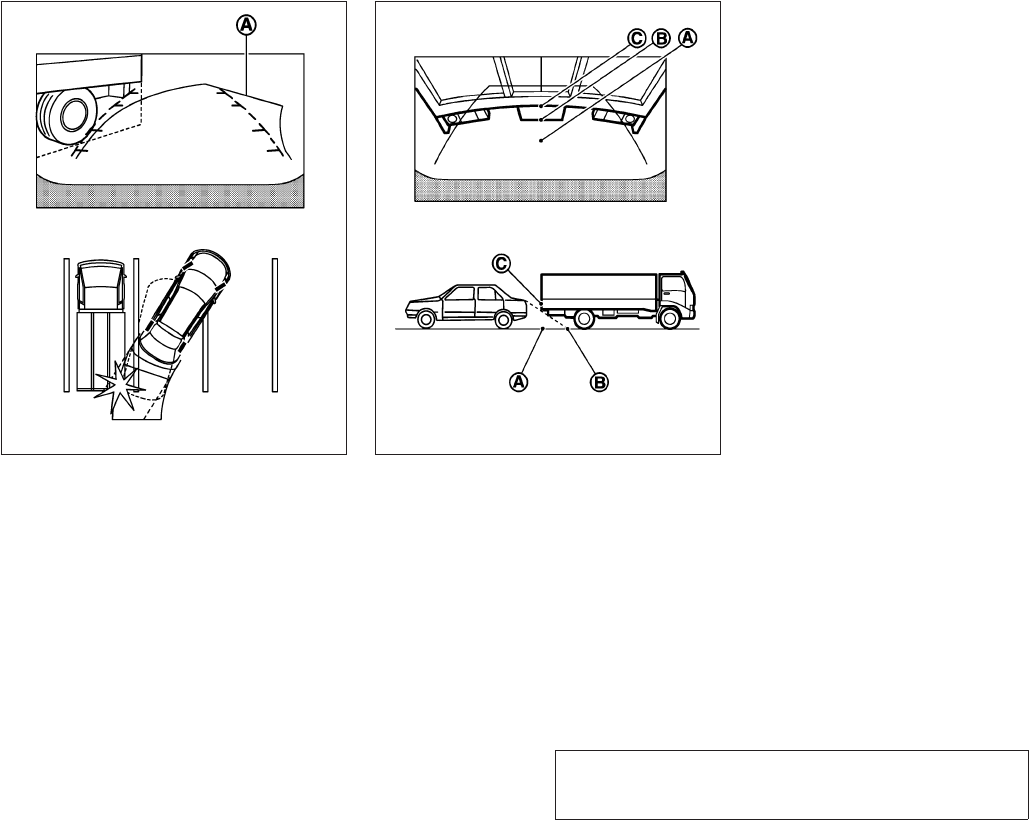
JOBNAME: 1093929-2013-asd-own PAGE: 176 SESS: 4 OUTPUT: Tue Mar 27 10:39:14 2012
Backing up near a projecting object
The predicted course lines s
Ado not touch the
object in the display. However, the vehicle may hit
the object if it projects over the actual backing up
course.
Backing up behind a projecting object
The position s
Cis shown farther than the position
s
Bin the display. However, the position s
Cis
actually at the same distance as the position s
A.
The vehicle may hit the object when backing up to
the position s
Aif the object projects over the
actual backing up course.
LHA1201 WHA1506
4-16 Monitor, climate, audio, phone and voice recognition systems
ZREVIEW COPY—
2013 Altima Sedan (asd)
Owners Manual—USA_English (nna)
03/24/12—dmoore
X
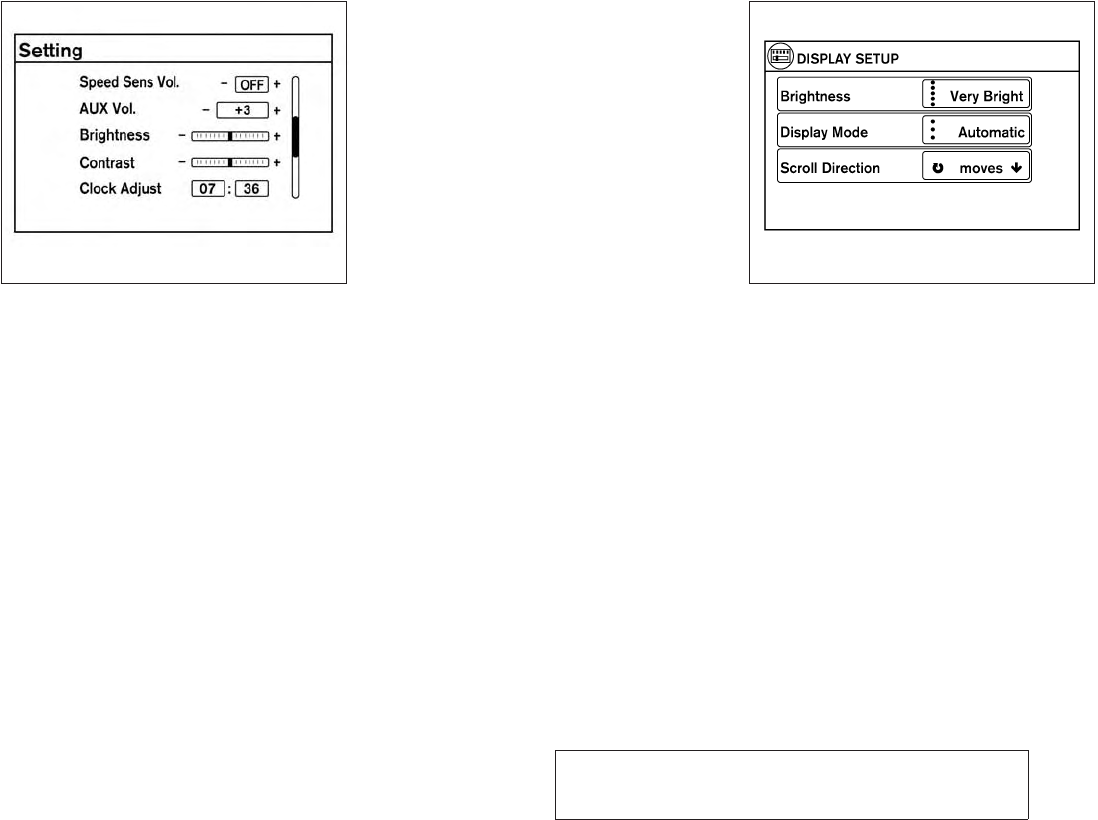
JOBNAME: 1093929-2013-asd-own PAGE: 177 SESS: 4 OUTPUT: Tue Mar 27 10:39:14 2012
ADJUSTING THE SCREEN
The procedure for adjusting the quality of the
screen differs depending on the type of screen
present on the vehicle.
For vehicles without Navigation System:
1. Press the ENTER/SETTING button.
2. Turn the TUNE-SCROLL knob to highlight
the “Brightness” or “Contrast” key.
3. Press the ENTER/SETTING button.
4. Adjust the level using the TUNE-SCROLL
knob and then press the ENTER/SETTING
button to apply the adjustment.
●Do not adjust the Brightness or Contrast of
the RearView Monitor while the vehicle is
moving.
For vehicles with Navigation System:
1. Press the MENU button.
2. Select the “Settings” key.
3. Select the “System” key.
4. Select the “Display” key.
5. Touch the “Brightness key and adjust the
level to the desired setting.
●Do not adjust the display of the RearView
Monitor while the vehicle is moving.
Without Navigation System
LHA2254
With Navigation System
LHA1482
Monitor, climate, audio, phone and voice recognition systems 4-17
ZREVIEW COPY—
2013 Altima Sedan (asd)
Owners Manual—USA_English (nna)
03/24/12—dmoore
X
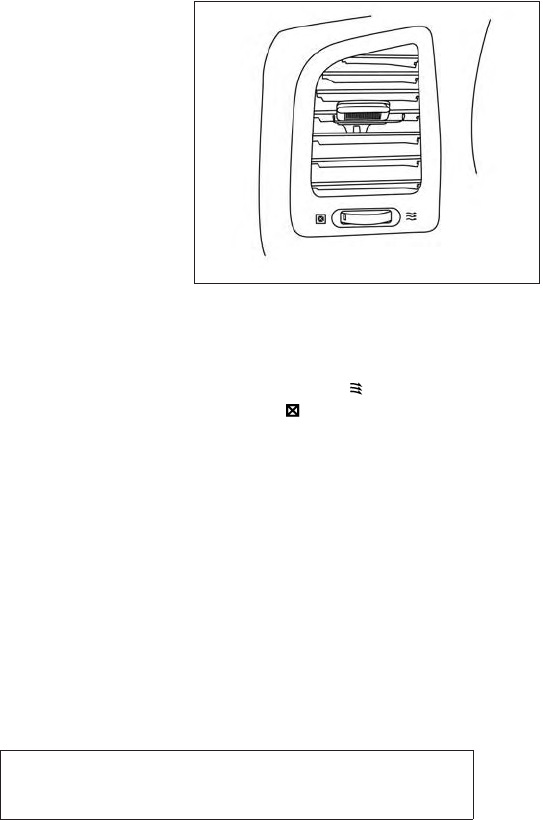
JOBNAME: 1093929-2013-asd-own PAGE: 178 SESS: 4 OUTPUT: Tue Mar 27 10:39:14 2012
OPERATING TIPS
●When the shift selector is shifted to R (Re-
verse), the monitor screen automatically
changes to the RearView Monitor mode.
However, the radio can be heard.
●It may take some time until the RearView
Monitor is displayed after the shift selector
has been shifted to R (Reverse). Objects
may be distorted momentarily until the Rear-
View Monitor screen is displayed com-
pletely. When the shift selector is returned to
a position other than R (Reverse), it may take
some time until the screen changes. Objects
on the screen may be distorted until they are
completely displayed.
●When the temperature is extremely high or
low, the screen may not clearly display ob-
jects. This is not a malfunction.
●When strong light directly enters the cam-
era, objects may not be displayed clearly.
●Vertical lines may be seen in objects on the
screen. This is due to strong reflected light
from the bumper. This is not a malfunction.
●The screen may flicker under fluorescent
light. This is not a malfunction.
●The colors of objects on the RearView Moni-
tor may differ somewhat from those of the
actual object.
●When the contrast of objects is low at night,
pressing the SETTING button or MENU but-
ton may not change the brightness.
●Objects on the monitor may not be clear in a
dark place or at night.
●If dirt, rain or snow attaches to the camera,
the RearView Monitor may not display ob-
jects. Clean the camera.
●Do not use alcohol, benzine or thinner to
clean the camera. This will cause discolor-
ation. To clean the camera, wipe with a cloth
dampened with a diluted mild cleaning agent
and then wipe with a dry cloth.
●Do not damage the camera as the monitor
screen may be adversely affected.
●Do not use body wax on the camera window.
If body wax does get on the camera window,
wipe off the wax with a clean cloth damp-
ened with mild detergent diluted with water.
Adjust air flow direction by moving the vent
slides.
Open or close the vents by using the dial. Move
the dial toward the to open the vents or
toward the to close them.
Side
LHA2255
VENTS
4-18 Monitor, climate, audio, phone and voice recognition systems
ZREVIEW COPY—
2013 Altima Sedan (asd)
Owners Manual—USA_English (nna)
03/24/12—dmoore
X
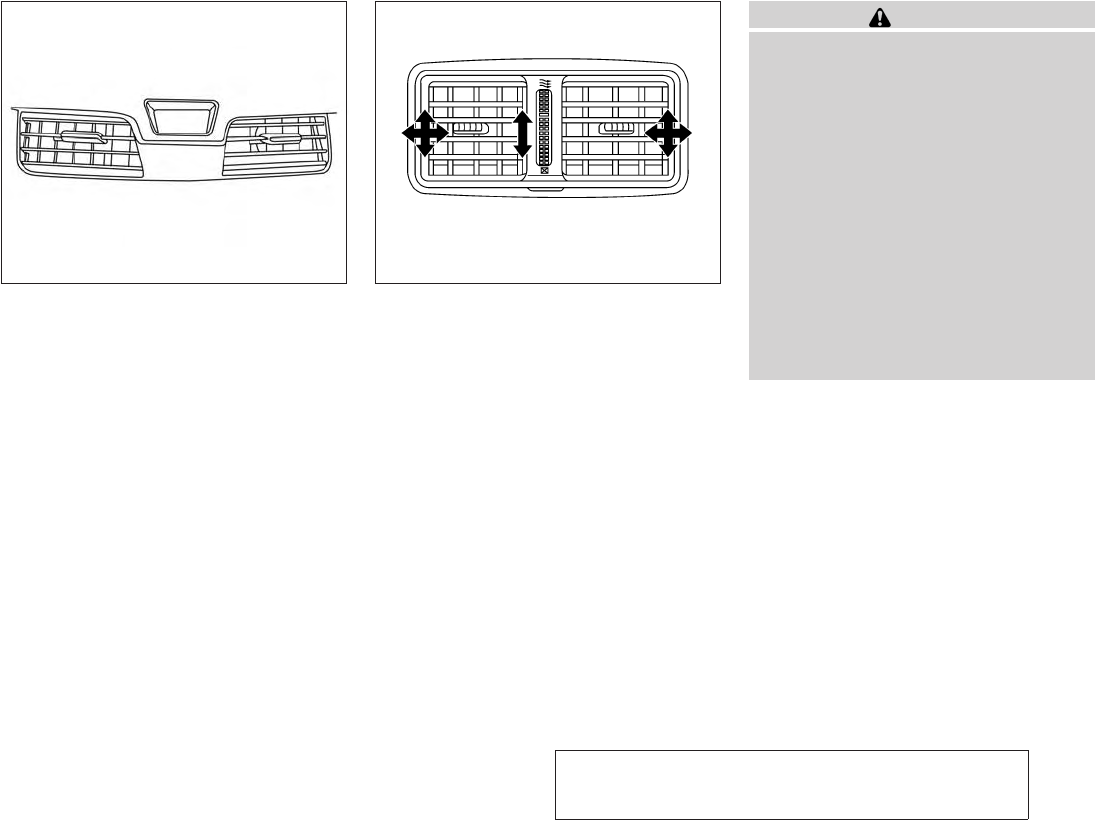
JOBNAME: 1093929-2013-asd-own PAGE: 179 SESS: 4 OUTPUT: Tue Mar 27 10:39:14 2012
WARNING
●The air conditioner cooling function op-
erates only when the engine is running.
●Do not leave children or adults who
would normally require the assistance
of others alone in your vehicle. Pets
should also not be left alone. They
could accidentally injure themselves or
others through inadvertent operation of
the vehicle. Also, on hot, sunny days,
temperatures in a closed vehicle could
quickly become high enough to cause
severe or possibly fatal injuries to
people or animals.
●Do not use the recirculation mode for
long periods as it may cause the interior
air to become stale and the windows to
fog up.
Center
LHA2256
Rear
LHA1134
HEATER AND AIR CONDITIONER
(manual) (if so equipped)
Monitor, climate, audio, phone and voice recognition systems 4-19
ZREVIEW COPY—
2013 Altima Sedan (asd)
Owners Manual—USA_English (nna)
03/24/12—dmoore
X
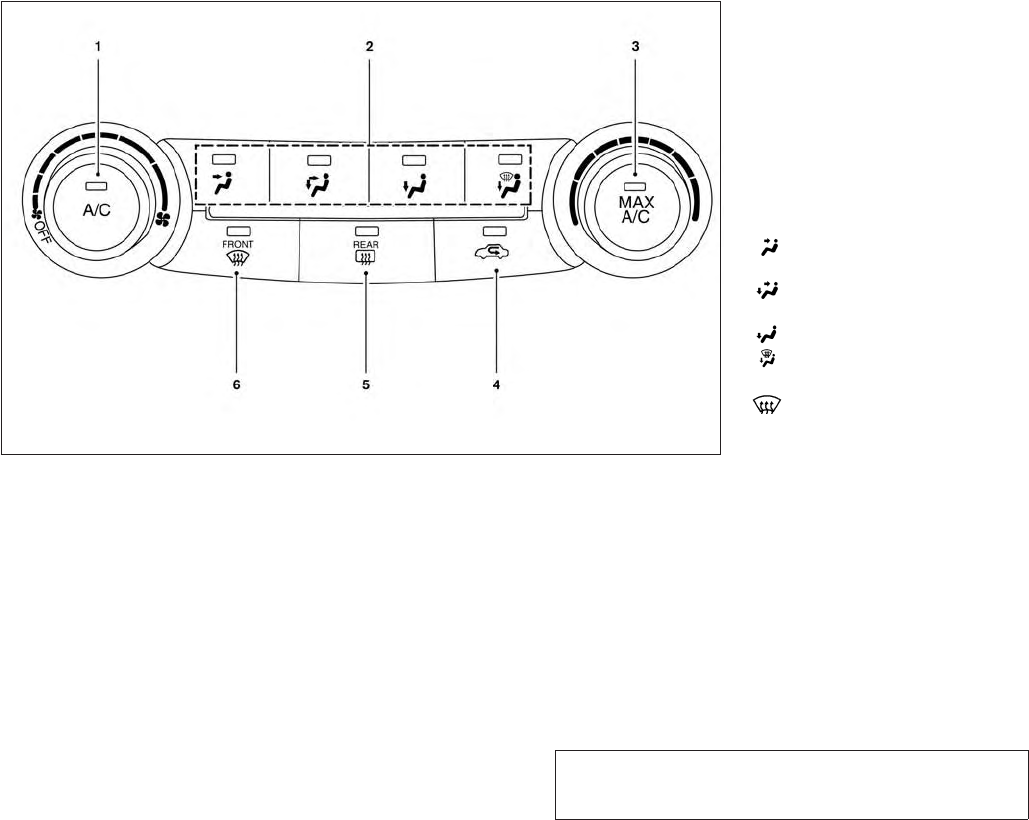
JOBNAME: 1093929-2013-asd-own PAGE: 180 SESS: 4 OUTPUT: Tue Mar 27 10:39:14 2012
1. Fan speed control / system OFF dial /
air conditioning (A/C) button
2. Air flow control buttons
3. Temperature control dial / MAX A/C
button
4. Air recirculation button
5. Rear window defroster button
6. Front windshield defrost button
CONTROLS
Fan control dial
The fan control dial turns the fan on and off, and
controls fan speed.
Air flow control buttons
The air flow control buttons allow you to select
the air flow outlets.
MAX
A/C
— Air flows from center and side
vents with maximum cooling.
— Air flows from center and side
vents.
— Air flows from center and side
vents and foot outlets.
— Air flows mainly from foot outlets.
— Air flows from defroster outlets
and foot outlets.
— Air flows mainly from defroster
outlets.
Temperature control dial
The temperature control dial allows you to adjust
the temperature of the outlet air. To lower the
temperature, turn the dial to the left. To increase
the temperature, turn the dial to the right.
LHA2243
4-20 Monitor, climate, audio, phone and voice recognition systems
ZREVIEW COPY—
2013 Altima Sedan (asd)
Owners Manual—USA_English (nna)
03/24/12—dmoore
X
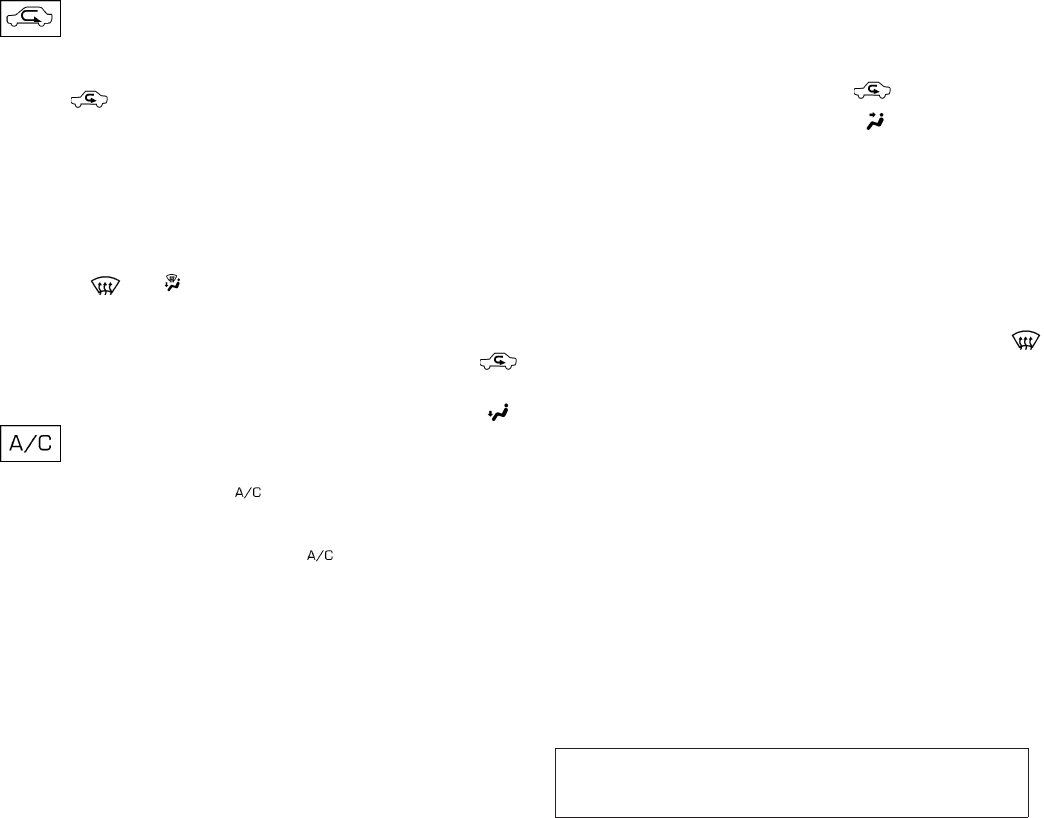
JOBNAME: 1093929-2013-asd-own PAGE: 181 SESS: 4 OUTPUT: Tue Mar 27 10:39:14 2012
Air recirculation button
On position (Indicator light on):
Interior air is recirculated inside the vehicle.
Press the button to the ON position when:
●driving on a dusty road.
●to prevent traffic fumes from entering pas-
senger compartment.
●for maximum cooling when using the air con-
ditioner.
The air recirculation function does not operate
when in the or air flow modes.
Off position (Indicator light off):
Outside air is drawn into the passenger compart-
ment and distributed through the selected outlet.
Use the off position for normal heater or air con-
ditioner operation.
Air conditioner button
Start the engine, turn the fan control dial to the
desired position and press the button to
turn on the air conditioner. The indicator light
comes on when the air conditioner is operating.
To turn off the air conditioner, push the
button again.
The air conditioner cooling function oper-
ates only when the engine is running.
Rear window and outside mirror (if so
equipped) defroster switch
For more information about the rear window and
outside mirror (if so equipped) defroster switch,
see “Rear window and outside mirror defroster
switch” in the “Instruments and controls” section
of this manual.
HEATER OPERATION
Heating
This mode is used to direct heated air to the foot
outlets. Some air also flows from the defrost
outlets and the side vent outlets.
1. Press the button to the OFF position
for normal heating.
2. Press the air flow control button.
3. Turn the fan control dial to the desired posi-
tion.
4. Turn the temperature control dial to the de-
sired position between the middle and the
hot position.
Ventilation
This mode directs outside air to the side and
center vents.
1. Press the button to the OFF position.
2. Press the air flow control button.
3. Turn the fan control dial to the desired posi-
tion.
4. Turn the temperature control dial to the de-
sired position.
Defrosting or defogging
This mode directs the air to the defrost outlets to
defrost/defog the windows.
1. Press the defrost/defog button .
2. Turn the fan control dial to the desired posi-
tion.
3. Turn the temperature control dial to the de-
sired position between the middle and the
hot position.
●To quickly remove ice or fog from the win-
dows, turn the fan control dial to the highest
setting and the temperature control to the
full HOT position.
Monitor, climate, audio, phone and voice recognition systems 4-21
ZREVIEW COPY—
2013 Altima Sedan (asd)
Owners Manual—USA_English (nna)
03/24/12—dmoore
X

JOBNAME: 1093929-2013-asd-own PAGE: 182 SESS: 5 OUTPUT: Tue Mar 27 10:39:14 2012
●When the position is selected, the air
conditioner automatically turns on (the indi-
cator light on the button will come on)
if the outside temperature is more than 36°F
(2°C). This dehumidifies the air which helps
defog the windshield. The mode au-
tomatically turns off, allowing outside air to
be drawn into the passenger compartment
to further improve the defogging perfor-
mance.
Bi-level heating
The bi-level mode directs warmed air to the side
and center vents and to the front and rear floor
outlets.
1. Press the button to the OFF position.
2. Press the air flow control button.
3. Turn the fan control dial to the desired posi-
tion.
4. Turn the temperature control dial to the de-
sired position.
Heating and defogging
This mode heats the interior and defogs the wind-
shield.
1. Press the air flow control button.
2. Turn the fan control dial to the desired posi-
tion.
3. Turn the temperature control dial to the de-
sired position between the middle and the
hot position.
●When the position is selected, the air
conditioner automatically turns on if the out-
side temperature is more than 36°F (2°C).
The indicator light on the A/C button will
come on. This dehumidifies the air which
helps defog the windshield. The
mode automatically turns off, allowing out-
side air to be drawn into the passenger
compartment to further improve the defog-
ging performance.
Operating tips
Clear snow and ice from the wiper blades
and air inlet in front of the windshield. This
improves heater operation.
AIR CONDITIONER OPERATION
Start the engine, turn the fan control dial to the
desired position, and push in the button to
activate the air conditioner. When the air condi-
tioner is on, cooling and dehumidifying functions
are added to the heater operation.
The air conditioner cooling function oper-
ates only when the engine is running.
Cooling
This mode is used to cool and dehumidify the air.
1. Press the button to the OFF position.
2. Press the air flow control button.
3. Turn the fan control dial to the desired posi-
tion.
4. Push the button. The indicator light
comes on.
5. Turn the temperature control dial to the de-
sired position.
●For quick cooling when the outside tem-
perature is high, push the button to
the ON position. Be sure to return the
to the OFF position for normal cooling. MAX
A/C may be used for quick cooling.
Dehumidified heating
This mode is used to heat and dehumidify the air.
1. Press the button to the OFF position.
2. Press the air flow control button.
3. Turn the fan control dial to the desired posi-
tion.
4-22 Monitor, climate, audio, phone and voice recognition systems
ZREVIEW COPY—
2013 Altima Sedan (asd)
Owners Manual—USA_English (nna)
03/27/12—dmoore
X

JOBNAME: 1093929-2013-asd-own PAGE: 183 SESS: 4 OUTPUT: Tue Mar 27 10:39:14 2012
4. Push the button. The indicator light
comes on.
5. Turn the temperature control dial to the de-
sired position.
Dehumidified defogging
This mode is used to defog the windows and
dehumidify the air.
1. Press the air flow control button.
2. Turn the fan control dial to the desired posi-
tion.
●When the or are selected, the
air conditioner automatically turns on (the
indicator light may or may not illuminate) if
the outside temperature is more than 36°F
(2°C). This dehumidifies the air which helps
defog the windshield. The mode au-
tomatically turns off, allowing outside air to
be drawn into the passenger compartment
to further improve the defogging perfor-
mance.
●The air conditioner is always on in
mode, regardless of whether the indicator
light is on or off.
3. Turn the temperature control dial to the de-
sired position.
Operating tips
●Keep the windows and moonroof closed
while the air conditioner is in operation.
●After parking in the sun, drive for 2 or 3
minutes with the windows open to vent hot
air from the passenger compartment. Then,
close the windows. This allows the air con-
ditioner to cool the interior more quickly.
●The air conditioning system should be
operated for approximately 10 minutes
at least once a month. This helps pre-
vent damage to the system due to lack
of lubrication.
●A visible mist may be seen coming from the
ventilators in hot, humid conditions as the air
is cooled rapidly. This does not indicate a
malfunction.
●If the engine coolant temperature
gauge indicates engine coolant tem-
perature over the normal range, turn
the air conditioner off. See “If your
vehicle overheats” in the “In case of
emergency” section of this manual.
AIR FLOW CHARTS
The following charts show the button and dial
positions for MAXIMUM AND QUICK heating,
cooling or defrosting. The air recirculation
button should always be in the OFF posi-
tion for heating and defrosting.
Monitor, climate, audio, phone and voice recognition systems 4-23
ZREVIEW COPY—
2013 Altima Sedan (asd)
Owners Manual—USA_English (nna)
03/24/12—dmoore
X
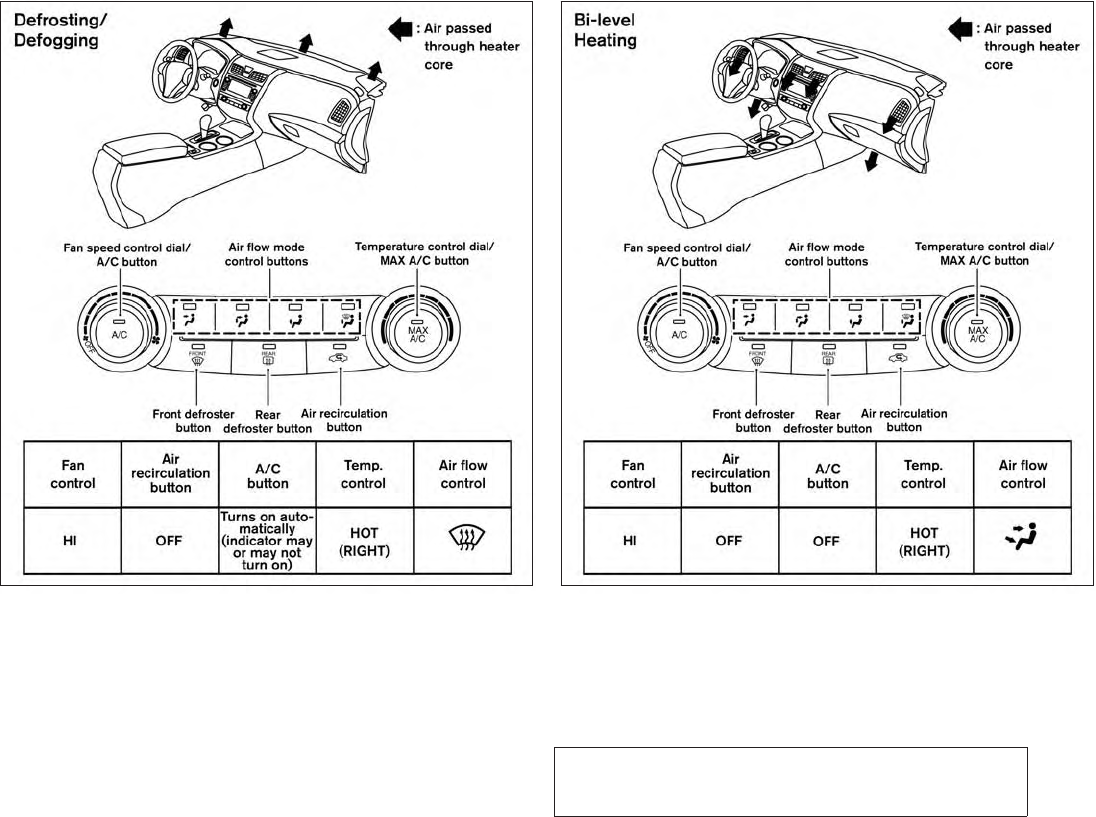
JOBNAME: 1093929-2013-asd-own PAGE: 184 SESS: 4 OUTPUT: Tue Mar 27 10:39:14 2012
LHA2284 LHA2285
4-24 Monitor, climate, audio, phone and voice recognition systems
ZREVIEW COPY—
2013 Altima Sedan (asd)
Owners Manual—USA_English (nna)
03/24/12—dmoore
X
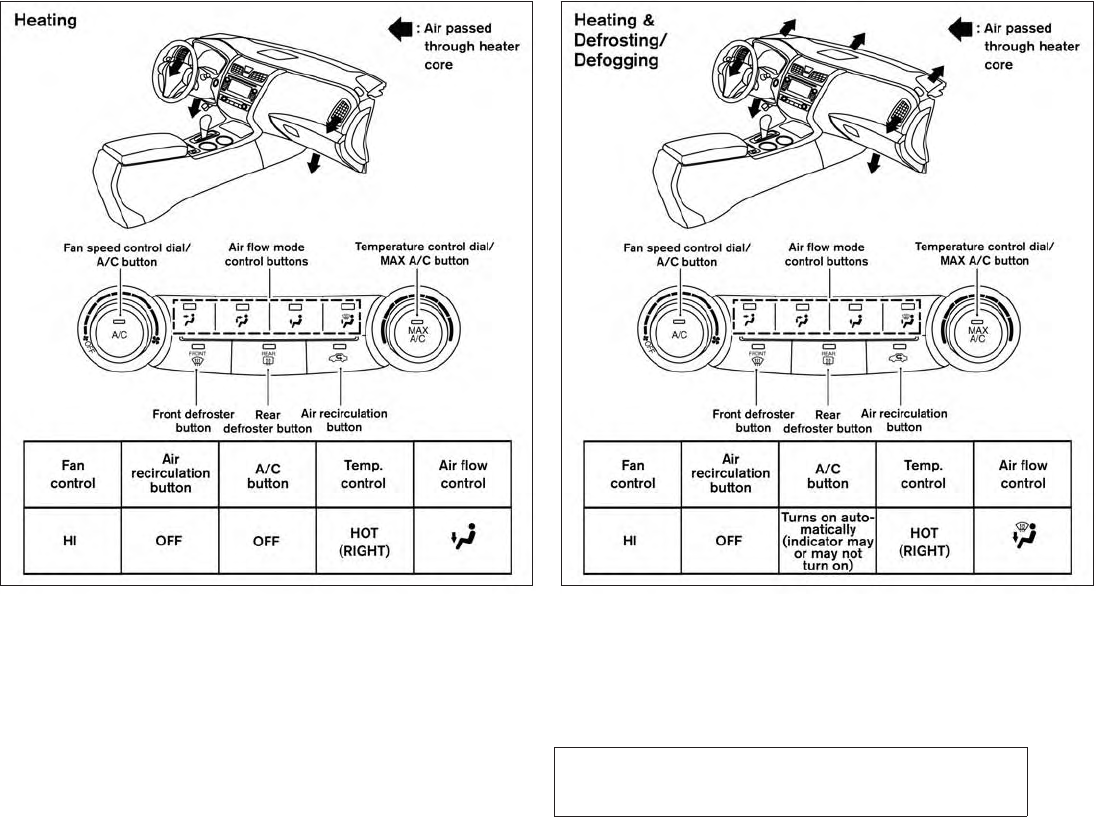
JOBNAME: 1093929-2013-asd-own PAGE: 185 SESS: 4 OUTPUT: Tue Mar 27 10:39:14 2012
LHA2286 LHA2287
Monitor, climate, audio, phone and voice recognition systems 4-25
ZREVIEW COPY—
2013 Altima Sedan (asd)
Owners Manual—USA_English (nna)
03/24/12—dmoore
X
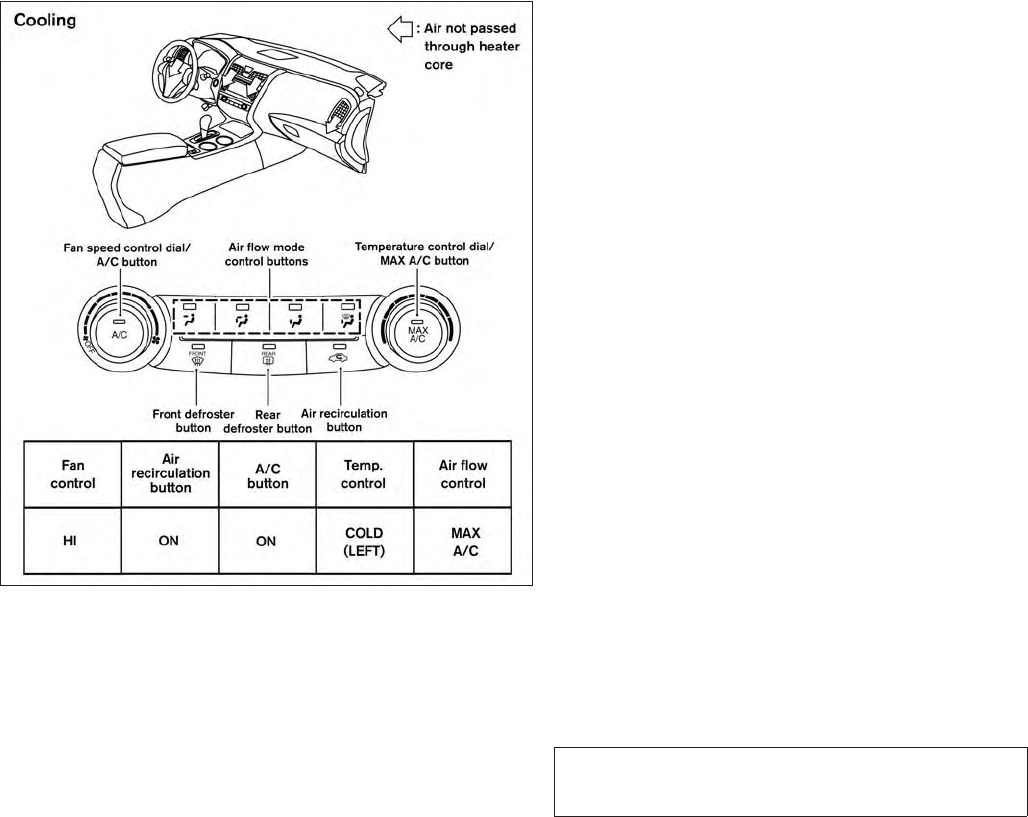
JOBNAME: 1093929-2013-asd-own PAGE: 186 SESS: 4 OUTPUT: Tue Mar 27 10:39:14 2012
LHA2288
4-26 Monitor, climate, audio, phone and voice recognition systems
ZREVIEW COPY—
2013 Altima Sedan (asd)
Owners Manual—USA_English (nna)
03/24/12—dmoore
X
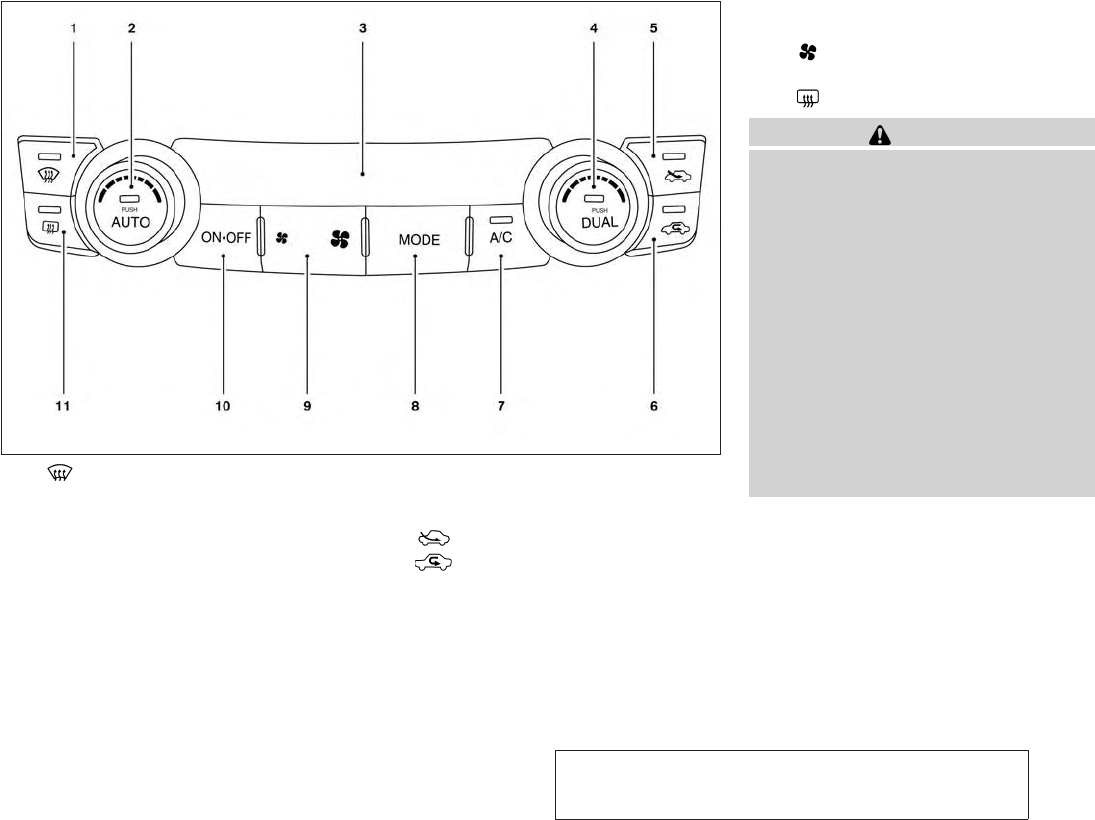
JOBNAME: 1093929-2013-asd-own PAGE: 187 SESS: 4 OUTPUT: Tue Mar 27 10:39:14 2012
1. (front defroster) button
2. Temperature control dial (driver’s side)/
AUTO (automatic) climate control but-
ton
3. Display screen
4. Temperature control dial (passenger’s
side)/DUAL (passenger’s side tempera-
ture control) button
5. Fresh air intake button
6. Air recirculation button
7. A/C (air conditioner) button
8. MODE (manual air flow control) button
9. (fan speed control) buttons
10. ON-OFF button
11. (rear window defroster) button
WARNING
●The air conditioner cooling function op-
erates only when the engine is running.
●Do not leave children or adults who
would normally require the assistance
of others alone in your vehicle. Pets
should also not be left alone. They
could accidentally injure themselves or
others through inadvertent operation of
the vehicle. Also, on hot, sunny days,
temperatures in a closed vehicle could
quickly become high enough to cause
severe or possibly fatal injuries to
people or animals.
●Do not use the recirculation mode for
long periods as it may cause the interior
air to become stale and the windows to
fog up.
Start the engine and operate the controls to
activate the air conditioner.
LHA2244
HEATER AND AIR CONDITIONER
(automatic) (if so equipped)
Monitor, climate, audio, phone and voice recognition systems 4-27
ZREVIEW COPY—
2013 Altima Sedan (asd)
Owners Manual—USA_English (nna)
03/24/12—dmoore
X
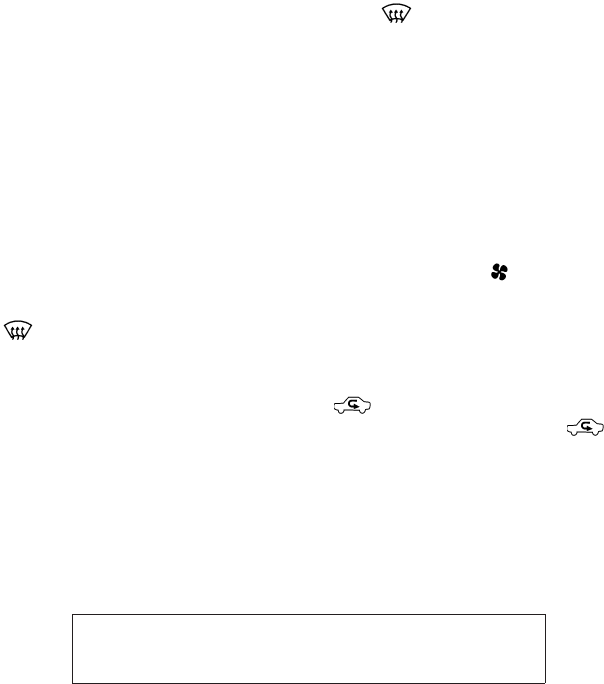
JOBNAME: 1093929-2013-asd-own PAGE: 188 SESS: 4 OUTPUT: Tue Mar 27 10:39:14 2012
AUTOMATIC OPERATION
Cooling and/or dehumidified heating
(AUTO)
This mode may be used all year round as the
system automatically works to keep a constant
temperature. Air flow distribution and fan speed
are also controlled automatically.
1. Press the AUTO button on. (The indicator on
the button will illuminate and AUTO will be
displayed.)
2. Turn the temperature control dial to the left
or right to set the desired temperature.
●Adjust the temperature display to about
75°F (24°C) for normal operation.
●The temperature of the passenger compart-
ment will be maintained automatically. Air
flow distribution and fan speed are also con-
trolled automatically.
●A visible mist may be seen coming from the
vents in hot, humid conditions as the air is
cooled rapidly. This does not indicate a mal-
function.
3. You can individually set driver’s and front
passenger’s side temperature using each
temperature control dial. When the DUAL
button or passenger’s side temperature dial
is turned, the DUAL indicator will come on.
To turn off the passenger’s side temperature
control, press the DUAL button.
Heating (A/C OFF)
The air conditioner does not activate. When you
need to heat only, use this mode.
1. Press the A/C button. (A/C OFF will be
displayed and A/C indicator will turn off.)
2. Turn the temperature control dial to set the
desired temperature.
●The temperature of the passenger compart-
ment will be maintained automatically. Air
flow distribution and fan speed are also con-
trolled automatically.
●Do not set the temperature lower than the
outside air temperature or the system may
not work properly.
●Not recommended if windows fog up.
Dehumidified defrosting or defogging
1. Press the front defroster button on.
(The indicator light on the button will come
on.)
2. Turn the temperature control dial to set the
desired temperature.
●To quickly remove ice from the outside of the
windows, use the fan speed control dial to
set the fan speed to maximum.
●As soon as possible after the windshield is
clean, press the AUTO button to return to
the automatic mode.
●When the front defroster button is
pressed, the air conditioner will automati-
cally be turned on at outside temperatures
above 36°F (2°C) (The indicator light may or
may not illuminate). The air recirculate mode
automatically turns off, allowing outside air
to be drawn into the passenger compart-
ment to further improve the defogging per-
formance.
MANUAL OPERATION
Fan speed control
Press the fan control buttons to manually
control the fan speed.
Press the AUTO button to return to automatic
control of the fan speed.
Air recirculation
Push the air recirculation button to recir-
culate interior air inside the vehicle. The
indicator light on the button will come on.
4-28 Monitor, climate, audio, phone and voice recognition systems
ZREVIEW COPY—
2013 Altima Sedan (asd)
Owners Manual—USA_English (nna)
03/24/12—dmoore
X
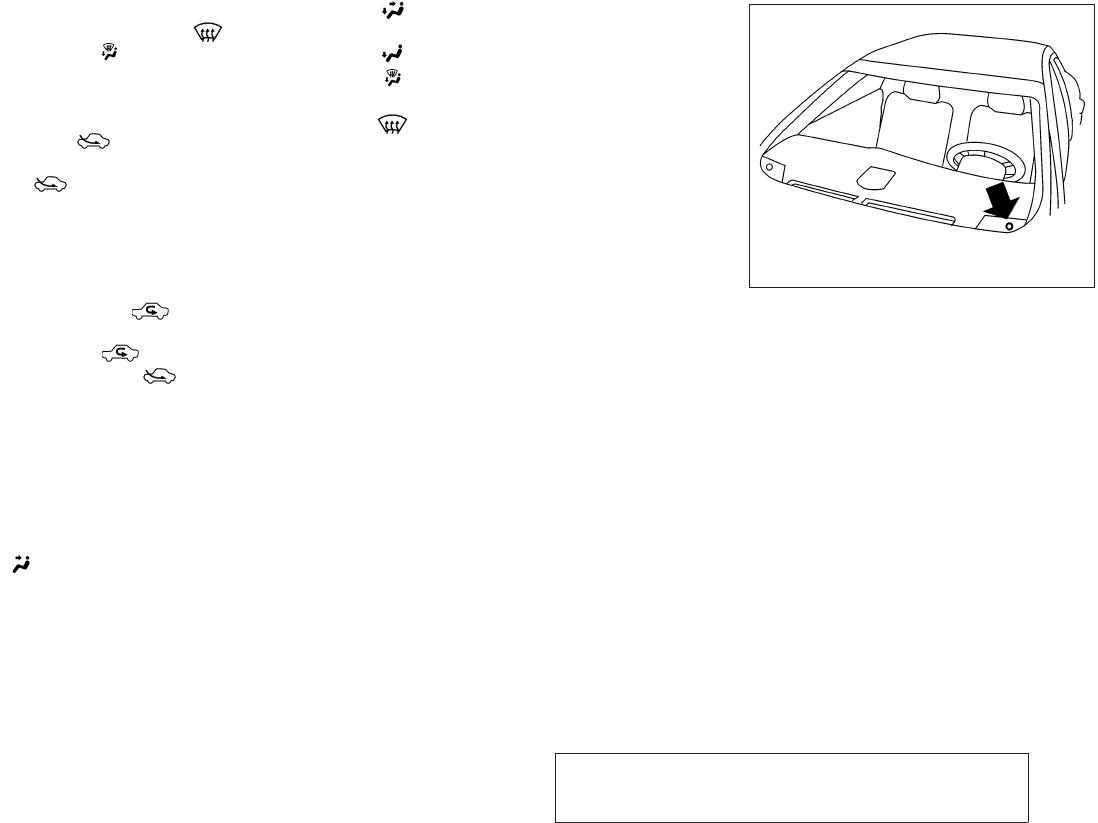
JOBNAME: 1093929-2013-asd-own PAGE: 189 SESS: 4 OUTPUT: Tue Mar 27 10:39:14 2012
The air recirculation cannot be activated when
the air conditioner is in the front defrosting
mode or the front defrosting and foot out-
let mode.
Fresh air intake
Press the fresh air intake button to draw
outside air into the passenger compartment.
The indicator light on the button will come
on.
Automatic intake air control
In the AUTO mode, the intake air will be con-
trolled automatically. To manually control the in-
take air, press the air recirculation button.
To return to the automatic control mode, press
and hold the air recirculation button or
press and hold the fresh air intake button
for about 2 seconds. The indicator lights (both air
recirculation and fresh air intake buttons) will
flash twice, and then the intake air will be con-
trolled automatically.
Air flow control
Pressing the MODE button manually controls air
flow and selects the air outlet:
— Air flows from center and side
vents.
— Air flows from center and side vents
and foot outlets.
— Air flows mainly from foot outlets.
— Air flows from defroster and foot
outlets.
— Air flows from defroster outlets.
To turn system off
Press the OFF button.
Rear window and outside mirror (if so
equipped) defroster switch
For more information about the rear window and
outside mirror (if so equipped) defroster switch,
see “Rear window and outside mirror defroster
switch” in the “Instruments and controls” section
of this manual.
OPERATING TIPS
●When the engine coolant temperature and
outside air temperature are low, the air flow
from the foot outlets may not operate for a
maximum of 150 seconds. However, this is
not a malfunction. After the coolant tempera-
ture warms up, air flow from the foot outlets
will operate normally.
The sunload sensor, located on the top driver’s
side of the instrument panel, helps the system
maintain a constant temperature. Do not put any-
thing on or around this sensor.
LHA1136
Monitor, climate, audio, phone and voice recognition systems 4-29
ZREVIEW COPY—
2013 Altima Sedan (asd)
Owners Manual—USA_English (nna)
03/24/12—dmoore
X

JOBNAME: 1093929-2013-asd-own PAGE: 190 SESS: 4 OUTPUT: Tue Mar 27 10:39:14 2012
The air conditioner system in your NISSAN ve-
hicle is charged with a refrigerant designed with
the environment in mind.
This refrigerant does not harm the earth’s
ozone layer.
Special charging equipment and lubricant is re-
quired when servicing your NISSAN air condi-
tioner. Using improper refrigerants or lubricants
will cause severe damage to your air conditioner
system. See “Air conditioner system refrigerant
and oil recommendations” in the “Technical and
consumer information” section of this manual.
A NISSAN dealer is able to service your “environ-
mentally friendly” air conditioning system.
WARNING
The air conditioner system contains re-
frigerant under high pressure. To avoid
personal injury, any air conditioner ser-
vice should be done only by an experi-
enced technician with proper equipment.
RADIO
With the ignition placed in the ACC or ON posi-
tion, press the PWR (power)/VOL (volume) knob
to turn the radio on. If you listen to the radio with
the engine not running, the ignition should be
placed in the ACC position.
Radio reception is affected by station signal
strength, distance from radio transmitter, build-
ings, bridges, mountains and other external influ-
ences. Intermittent changes in reception quality
normally are caused by these external influences.
Using a cellular phone in or near the ve-
hicle may influence radio reception quality.
Radio reception
Your NISSAN radio system is equipped with
state-of-the-art electronic circuits to enhance ra-
dio reception. These circuits are designed to
extend reception range, and to enhance the qual-
ity of that reception.
However, there are some general characteristics
of both FM and AM radio signals that can affect
radio reception quality in a moving vehicle, even
when the finest equipment is used. These char-
acteristics are completely normal in a given re-
ception area and do not indicate any malfunction
in your NISSAN radio system.
Reception conditions will constantly change be-
cause of vehicle movement. Buildings, terrain,
signal distance and interference from other ve-
hicles can work against ideal reception. De-
scribed below are some of the factors that can
affect your radio reception.
Some cellular phones or other devices may
cause interference or a buzzing noise to come
from the audio system speakers. Storing the de-
vice in a different location may reduce or elimi-
nate the noise.
FM RADIO RECEPTION
Range: FM range is normally limited to 25 – 30 mi
(40 – 48 km), with monaural (single channel) FM
having slightly more range than stereo FM. Exter-
nal influences may sometimes interfere with FM
station reception even if the FM station is within
25 mi (40 km). The strength of the FM signal is
directly related to the distance between the
transmitter and receiver. FM signals follow a line-
of-sight path, exhibiting many of the same char-
acteristics as light. For example, they will reflect
off objects.
Fade and drift: As your vehicle moves away from
a station transmitter, the signals will tend to fade
and/or drift.
SERVICING AIR CONDITIONER AUDIO SYSTEM
4-30 Monitor, climate, audio, phone and voice recognition systems
ZREVIEW COPY—
2013 Altima Sedan (asd)
Owners Manual—USA_English (nna)
03/24/12—dmoore
X
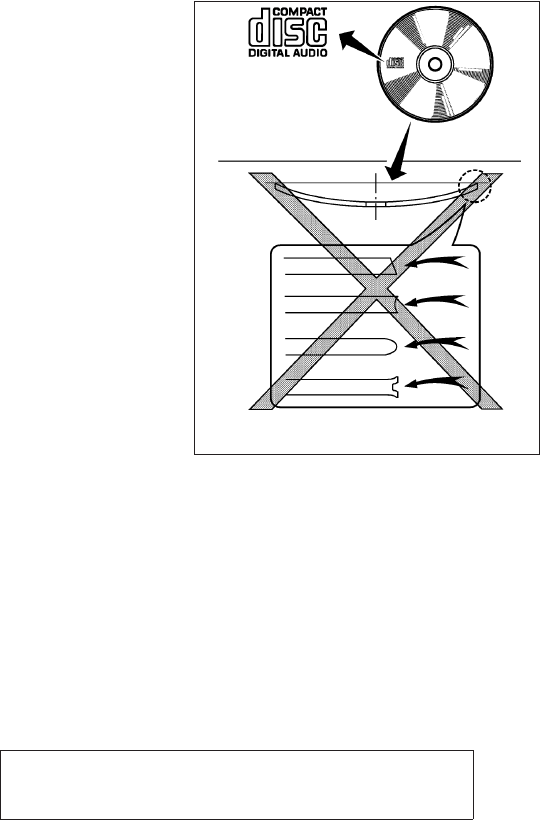
JOBNAME: 1093929-2013-asd-own PAGE: 191 SESS: 4 OUTPUT: Tue Mar 27 10:39:14 2012
Static and flutter: During signal interference from
buildings, large hills or due to antenna position
(usually in conjunction with increased distance
from the station transmitter), static or flutter can
be heard. This can be reduced by adjusting the
treble control to reduce treble response.
Multipath reception: Because of the reflective
characteristics of FM signals, direct and reflected
signals reach the receiver at the same time. The
signals may cancel each other, resulting in mo-
mentary flutter or loss of sound.
AM RADIO RECEPTION
AM signals, because of their low frequency, can
bend around objects and skip along the ground.
In addition, the signals can be bounced off the
ionosphere and bent back to earth. Because of
these characteristics, AM signals are also sub-
ject to interference as they travel from transmitter
to receiver.
Fading: Occurs while the vehicle is passing
through freeway underpasses or in areas with
many tall buildings. It can also occur for several
seconds during ionospheric turbulence even in
areas where no obstacles exist.
Static: Caused by thunderstorms, electrical
power lines, electric signs and even traffic lights.
SATELLITE RADIO RECEPTION (if so
equipped)
When the satellite radio is used for the first time
or the battery has been replaced, the satellite
radio may not work properly. This is not a mal-
function. Wait more than 10 minutes with satellite
radio ON and the vehicle outside of any metal or
large building for satellite radio to receive all of
the necessary data.
No satellite radio reception is available and “NO
SAT” is displayed when the SAT band option is
selected unless optional satellite receiver and
antenna are installed and a SiriusXM Satellite
Radio service subscription is active. Satellite ra-
dio is not available in Alaska, Hawaii and Guam.
Satellite radio performance may be affected if
cargo carried on the roof blocks the satellite radio
signal.
If possible, do not put cargo over the satellite
antenna.
A build up of ice on the satellite radio antenna can
affect satellite radio performance. Remove the
ice to restore satellite radio reception. AUDIO OPERATION PRECAUTIONS
LHA0099
Monitor, climate, audio, phone and voice recognition systems 4-31
ZREVIEW COPY—
2013 Altima Sedan (asd)
Owners Manual—USA_English (nna)
03/24/12—dmoore
X

JOBNAME: 1093929-2013-asd-own PAGE: 192 SESS: 4 OUTPUT: Tue Mar 27 10:39:14 2012
Compact disc (CD) player
CAUTION
●Do not force a compact disc into the CD
insert slot. This could damage the CD
and/or CD player.
●Trying to load a CD with the CD door
closed could damage the CD and/or CD
player.
●Only one CD can be loaded into the CD
player at a time.
●Only use high quality 4.7 in (12 cm)
round discs that have the “COMPACT
disc DIGITAL AUDIO” logo on the disc
or packaging.
●During cold weather or rainy days, the
player may malfunction due to the hu-
midity. If this occurs, remove the CD
and dehumidify or ventilate the player
completely.
●The player may skip while driving on
rough roads.
●The CD player sometimes cannot func-
tion when the compartment tempera-
ture is extremely high or low.
Decrease/increase the temperature
before use.
●Do not expose the CD to direct sun-
light.
●CDs that are in poor condition or are
dirty, scratched or covered with finger-
prints may not work properly.
●The following CDs may not work prop-
erly:
●Copy control compact discs (CCCD)
●Recordable compact discs (CD-R)
●Rewritable compact discs (CD-RW)
●Do not use the following CDs as they
may cause the CD player to malfunc-
tion:
●3.1 in (8 cm) discs with an adapter
●CDs that are not round
●CDs with a paper label
●CDs that are warped, scratched, or
have abnormal edges
●This audio system can only play pre-
recorded CDs. It has no capability to
record or burn CDs.
●If the CD cannot be played, one of the
following messages will be displayed.
CHECK DISC:
●Confirm that the CD is inserted cor-
rectly (the label side is facing up,
etc.).
●Confirm that the CD is not bent or
warped and it is free of scratches.
PRESS EJECT:
This is an error due to excessive tem-
perature inside the player. Remove the
CD by pressing the EJECT button. After
a short time, reinsert the CD. The CD
can be played when the temperature of
the player returns to normal.
UNPLAYABLE:
The file is unplayable in this audio sys-
tem (only MP3 or WMA (if so equipped)
CD).
4-32 Monitor, climate, audio, phone and voice recognition systems
ZREVIEW COPY—
2013 Altima Sedan (asd)
Owners Manual—USA_English (nna)
03/24/12—dmoore
X
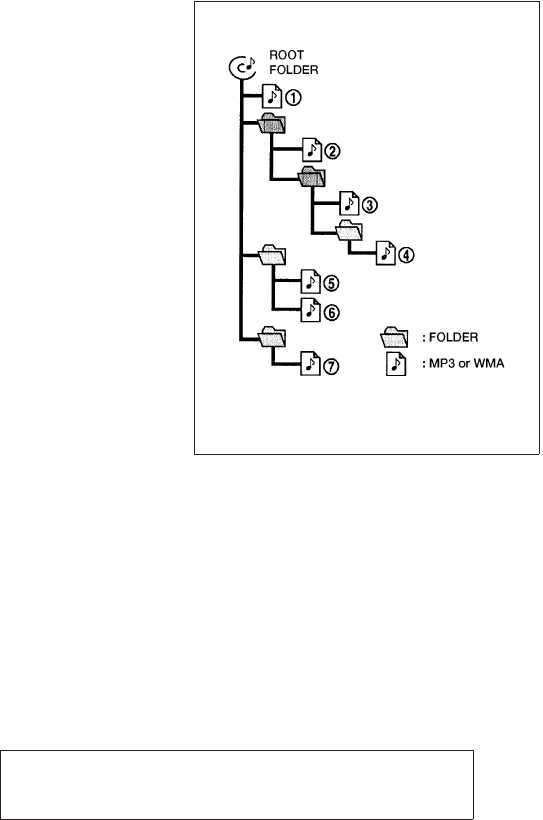
JOBNAME: 1093929-2013-asd-own PAGE: 193 SESS: 4 OUTPUT: Tue Mar 27 10:39:14 2012
Compact disc with MP3 or WMA (if
so equipped)
Terms:
●MP3 — MP3 is short for Moving Pictures
Experts Group Audio Layer 3. MP3 is the
most well-known compressed digital audio
file format. This format allows for near “CD
quality” sound, but at a fraction of the size of
normal audio files. MP3 conversion of an
audio track from CD-ROM can reduce the
file size by approximately a 10:1 ratio with
virtually no perceptible loss in quality. MP3
compression removes the redundant and
irrelevant parts of a sound signal that the
human ear doesn’t hear.
●WMA — Windows Media Audio (WMA)* is a
compressed audio format created by Micro-
soft as an alternative to MP3. The WMA
codec offers greater file compression than
the MP3 codec, enabling storage of more
digital audio tracks in the same amount of
space when compared to MP3s at the same
level of quality.
●Bit rate — Bit rate denotes the number of
bits per second used by a digital music file.
The size and quality of a compressed digital
audio file is determined by the bit rate used
when encoding the file.
●Sampling frequency — Sampling frequency
is the rate at which the samples of a signal
are converted from analog to digital (A/D
conversion) per second.
●Multisession — Multisession is one of the
methods for writing data to media. Writing
data once to the media is called a single
session, and writing more than once is called
a multisession.
●ID3/WMA Tag — The ID3/WMA tag is the
part of the encoded MP3 or WMA file that
contains information about the digital music
file such as song title, artist, encoding bit
rate, track time duration, etc. ID3 tag infor-
mation is displayed on the Artist/song title
line on the display.
* WindowsTand Windows MediaTare regis-
tered trademarks and trademarks in the United
States of America and other countries of Micro-
soft Corporation of the USA.
Playback order chart
WHA1078
Monitor, climate, audio, phone and voice recognition systems 4-33
ZREVIEW COPY—
2013 Altima Sedan (asd)
Owners Manual—USA_English (nna)
03/24/12—dmoore
X

JOBNAME: 1093929-2013-asd-own PAGE: 194 SESS: 4 OUTPUT: Tue Mar 27 10:39:14 2012
Playback order:
Music playback order of a CD with MP3 or WMA
files is as illustrated.
●The names of folders not containing MP3 or
WMA files are not shown in the display.
●If there is a file in the top level of the disc,
“Root Folder” is displayed.
●The playback order is the order in which the
files were written by the writing software.
Therefore, the files might not play in the
desired order.
4-34 Monitor, climate, audio, phone and voice recognition systems
ZREVIEW COPY—
2013 Altima Sedan (asd)
Owners Manual—USA_English (nna)
03/24/12—dmoore
X
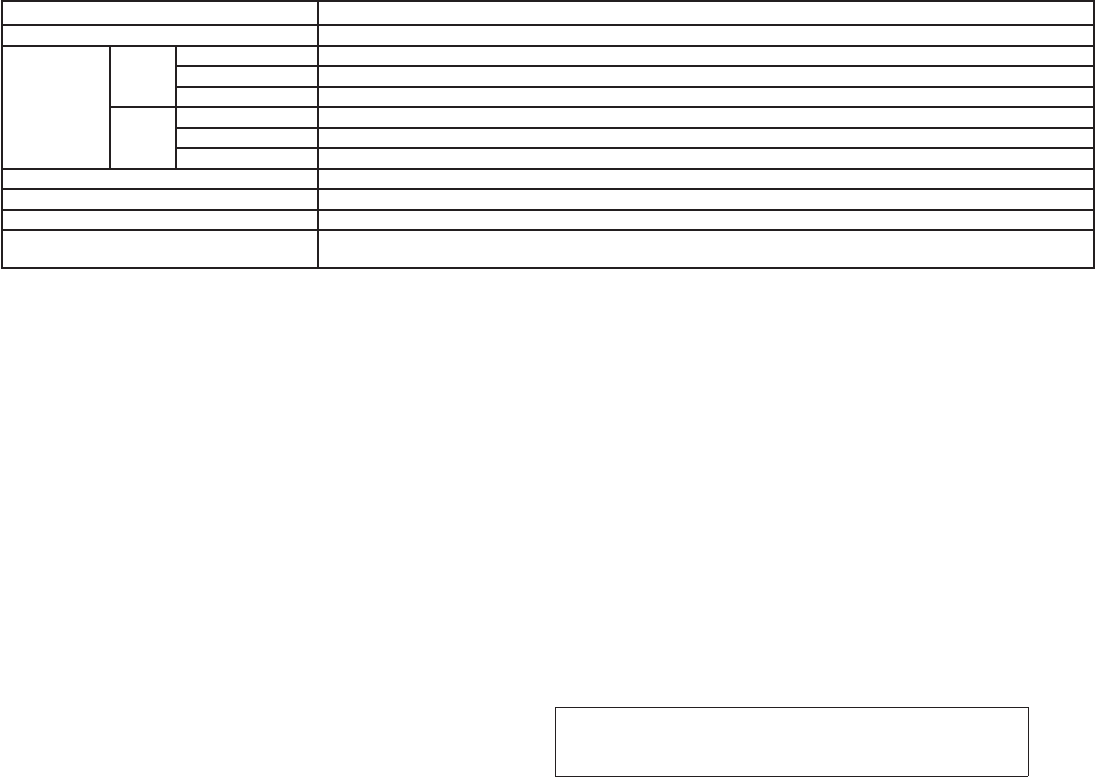
JOBNAME: 1093929-2013-asd-own PAGE: 195 SESS: 4 OUTPUT: Tue Mar 27 10:39:14 2012
Specification chart:
Supported media CD, CD-R, CD-RW
Supported file systems ISO9660 LEVEL1, ISO9660 LEVEL2, Apple ISO, Romeo, Joliet * ISO9660 Level 3 (packet writing) is not supported.
Supported
versions*1
MP3
Version MPEG1, MPEG2, MPEG2.5
Sampling frequency 8 kHz - 48 kHz
Bit rate 8 kbps - 320 kbps, VBR
WMA Version WMA7, WMA8, WMA9
Sampling frequency 32 kHz - 48 kHz
Bit rate 48 kbps - 192 kbps, VBR
Tag information ID3 tag VER1.0, VER1.1, VER2.2, VER2.3 (MP3 only)
Folder levels Folder levels: 8, Max folders: 255 (including root folder), Files: 512 (Max. 255 files for one folder)
Text character number limitation 128 characters
Displayable character codes*2 01: ASCII, 02: ISO-8859-1, 03: UNICODE (UTF-16 BOM Big Endian), 04: UNICODE (UTF-16 Non-BOM Big Endian), 05:
UNICODE (UTF-8), 06: UNICODE (Non-UTF-16 BOM Little Endian)
*1 Files created with a combination of 48 kHz sampling frequency and 64 kbps bit rate cannot be played.
*2 Available codes depend on what kind of media, versions and information are going to be displayed.
Monitor, climate, audio, phone and voice recognition systems 4-35
ZREVIEW COPY—
2013 Altima Sedan (asd)
Owners Manual—USA_English (nna)
03/24/12—dmoore
X
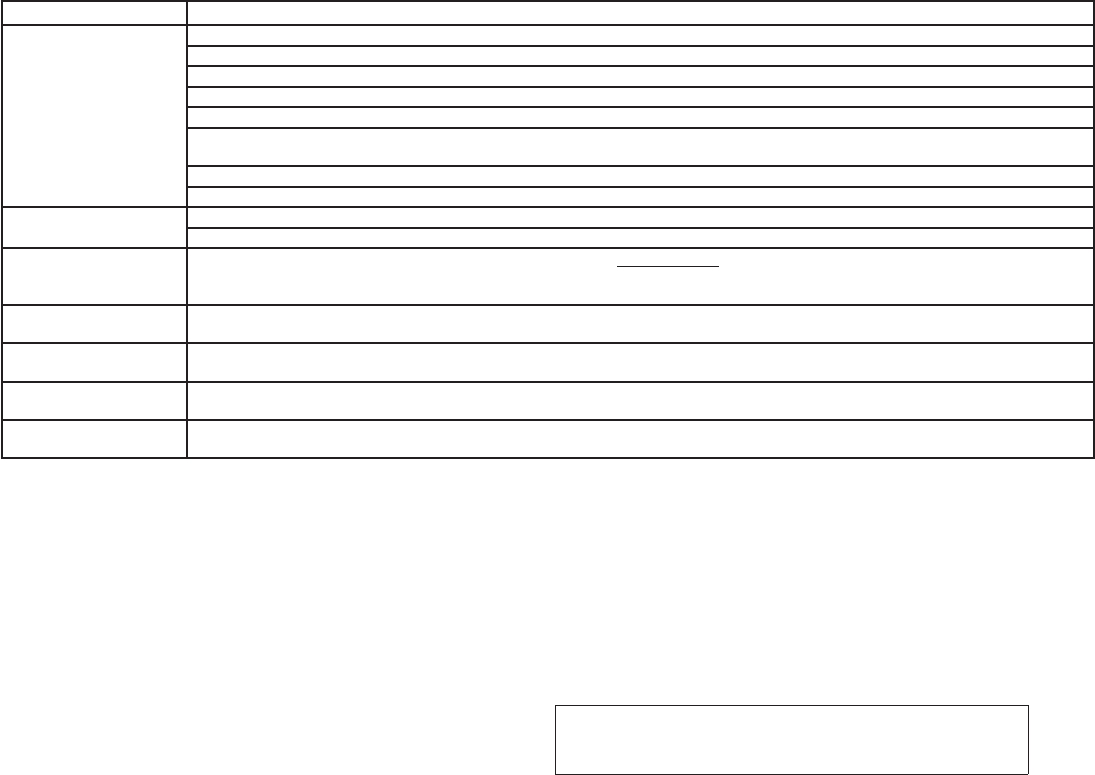
JOBNAME: 1093929-2013-asd-own PAGE: 196 SESS: 4 OUTPUT: Tue Mar 27 10:39:14 2012
Troubleshooting guide:
Symptom Cause and Countermeasure
Cannot play
Check if the disc was inserted correctly.
Check if the disc is scratched or dirty.
Check if there is condensation inside the player. If there is, wait until the condensation is gone (about 1 hour) before using the player.
If there is a temperature increase error, the CD player will play correctly after it returns to the normal temperature.
If there is a mixture of music CD files (CD-DA data) and MP3/WMA files on a CD, only the music CD files (CD-DA data) will be played.
Files with extensions other than “.MP3”,“.WMA”, “.mp3” or “.wma” cannot be played. In addition, the character codes and number of characters for
folder names and file names should be in compliance with the specifications.
Check if the finalization process, such as session close and disc close, is done for the disc.
Check if the disc is protected by copyright.
Poor sound quality Check if the disc is scratched or dirty.
Bit rate may be too low.
It takes a relatively long time
before the music starts
playing.
If there are many folders or file levels on the MP3/WMA disc, or if it is a multisession disc, some time may be required before the music starts playing.
Music cuts off or skips The writing software and hardware combination might not match, or the writing speed, writing depth, writing width, etc., might not match the
specifications. Try using the slowest writing speed.
Skipping with high bit rate
files
Skipping may occur with large quantities of data, such as for high bit rate data.
Moves immediately to the
next song when playing
When a non-MP3/WMA file has been given an extension of “.MP3”, “.WMA”, .“mp3”or “.wma”, or when play is prohibited by copyright protection, there
will be approximately 5 seconds of no sound and then the player will skip to the next song.
Songs do not play back in
the desired order
The playback order is the order in which the files were written by the writing software. Therefore, the files might not play in the desired order.
4-36 Monitor, climate, audio, phone and voice recognition systems
ZREVIEW COPY—
2013 Altima Sedan (asd)
Owners Manual—USA_English (nna)
03/24/12—dmoore
X

JOBNAME: 1093929-2013-asd-own PAGE: 197 SESS: 4 OUTPUT: Tue Mar 27 10:39:14 2012
Universal Serial Bus (USB) memory (if
so equipped)
This system supports various USB memory
sticks, USB hard drives and iPodTplayers. There
are some USB devices which may not be sup-
ported with this system.
●Make sure that the USB device is connected
correctly into the USB connector.
●Do not force the memory stick or USB cable
into the USB connector.
●During cold weather or rainy days, the player
may malfunction due to the humidity. If this
occurs, remove the USB memory stick and
dehumidify or ventilate the player com-
pletely.
●The player sometimes cannot function when
the passenger compartment temperature is
extremely high. Decrease the temperature
before use.
●Do not leave the USB memory in a place
prone to static electricity or where the air
conditioner blows directly. The data in the
USB memory may be damaged.
●Prepare the USB device by yourself be-
cause it is not equipped with the vehicle.
●The USB device cannot be formatted with
this system. If you want to format the USB
memory, use your personal computer.
●Partitioned USB devices may not be played
correctly.
●Some characters used in other languages
(Chinese, Japanese, etc.) are not displayed
properly on the vehicle center screen.
NISSAN recommends using English lan-
guage characters with USB devices.
●Do not connect the USB device if the con-
nector or cable is wet. Allow the cable
and/or connectors to dry completely before
connecting the USB device.
●Large video podcast files cause slow re-
sponses in the iPodT. The vehicle center
display may momentarily black out, but it will
soon recover.
●If the iPodTautomatically selects large video
podcast files while in the shuffle mode, the
vehicle center display may momentarily
black out, but it will soon recover.
●Audiobooks may not play in the same order
as they appear on the iPodT.
●The iPodTnano (1st Generation) may re-
main in fast forward or rewind mode if it is
connected during a seek operation. In this
case, please manually reset the iPodT.
●The iPodTnano (2nd Generation) will con-
tinue to fast forward or rewind if it is discon-
nected during a seek operation.
●An incorrect song title may appear when the
Play Mode is changed while using the iPodT
nano (2nd generation).
●If you are using an iPodT(3rd Generation
with Dock connector), do not use very long
names for the song title, album name or artist
name to avoid the iPodTresetting itself.
iPodTis a trademark of Apple Inc., registered in
the U.S. and other countries.
BluetoothTstreaming audio
●Some BluetoothTaudio devices may not be
recognized by the in-vehicle audio system.
●It is necessary to set up the wireless con-
nection between a compatible BluetoothT
audio device and the in-vehicle BluetoothT
module before using the BluetoothTaudio.
●Operating procedure of the BluetoothTau-
dio will vary depending on the devices. Make
sure how to operate your audio device be-
fore using it with this system.
Monitor, climate, audio, phone and voice recognition systems 4-37
ZREVIEW COPY—
2013 Altima Sedan (asd)
Owners Manual—USA_English (nna)
03/24/12—dmoore
X
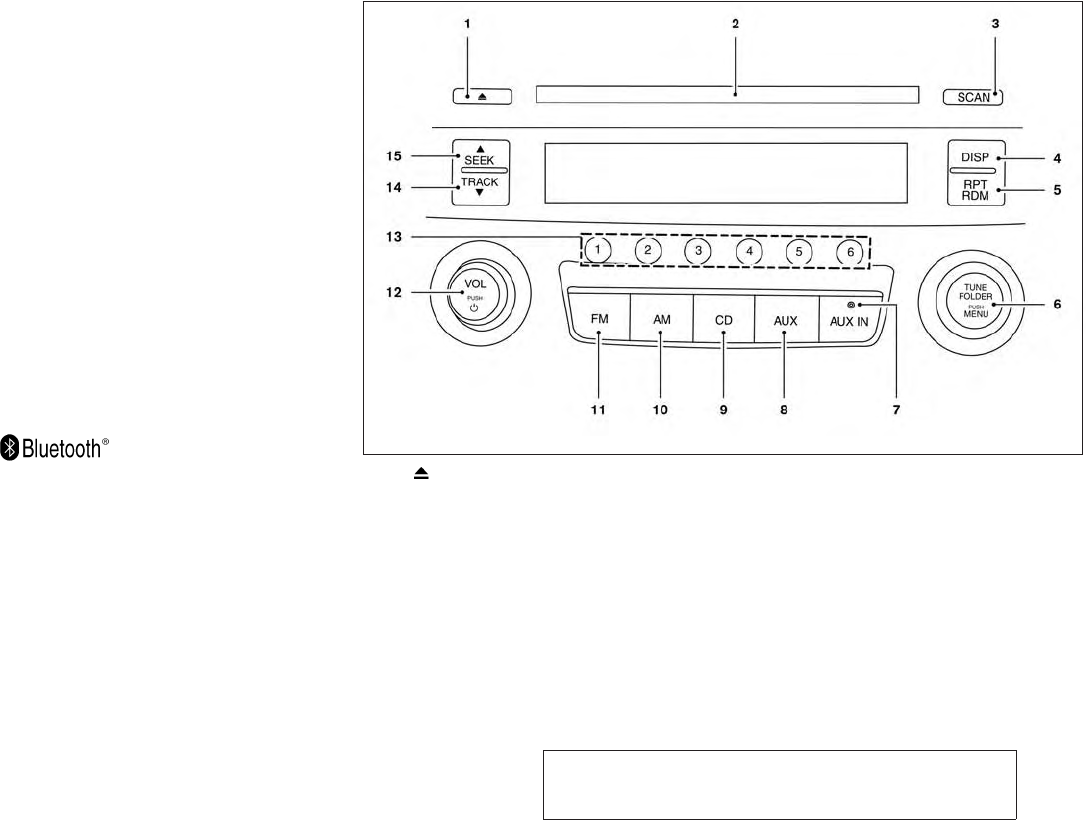
JOBNAME: 1093929-2013-asd-own PAGE: 198 SESS: 4 OUTPUT: Tue Mar 27 10:39:14 2012
●The BluetoothTaudio may be stopped under
the following conditions:
●Receiving a call on the Hands-Free
Phone System.
●Checking the connection to the hands-
free phone.
●Do not place the BluetoothTaudio device in
an area surrounded by metal or far away from
the in-vehicle BluetoothTmodule to prevent
tone quality degradation and wireless con-
nection disruption.
●While an audio device is connected through
the BluetoothTwireless connection, the bat-
tery power of the device may discharge
quicker than usual.
●This system supports the BluetoothTAudio
Distribution Profile (A2DP, AVRCP).
BLUETOOTHtis a
trademark owned by
Bluetooth SIG, Inc.
and licensed to
Visteon.
1. CD eject button
2. CD insert slot
3. SCAN button
4. DISP button
5. RPT/RDM button
6. TUNE/FOLDER knob / MENU button
7. AUX IN jack
8. AUX button
9. CD button
10. AM button
11. FM button
LHA2241
4-38 Monitor, climate, audio, phone and voice recognition systems
ZREVIEW COPY—
2013 Altima Sedan (asd)
Owners Manual—USA_English (nna)
03/24/12—dmoore
X

JOBNAME: 1093929-2013-asd-own PAGE: 199 SESS: 4 OUTPUT: Tue Mar 27 10:39:14 2012
12. VOL (volume) control knob / power but-
ton
13. Station select (1 - 6) buttons
14. TRACK button
15. SEEK button
FM/AM RADIO WITH COMPACT
DISC (CD) PLAYER (if so equipped)
For all operation precautions, see “Audio opera-
tion precautions” in this section.
Audio main operation
VOL (volume) control knob / power but-
ton
Place the ignition switch in the ACC or ON
position, then press the VOL (volume) control
knob / power button. If you listen to the radio with
the engine not running, place the ignition in the
ACC position. The mode (radio or CD) that was
playing immediately before the system was
turned off resumes playing.
When no CD is loaded, the radio comes on.
Pressing the VOL (volume) control knob / power
button again turns the system off.
Turn the VOL (volume) control knob / power
button to the right to increase volume or to the left
to decrease volume.
MENU button (Bass, Treble, Balance,
Fade, Speed Sensitive Volume and
Clock):
Press the MENU button to change the mode as
follows:
Bass →Treble →Balance →Fade →Spd. Sen.
Vol. (Speed Sensitive Volume) →AUX IN Volume
→Clock →Clock Adjust
To adjust the Bass, Treble, Fade and Balance,
press the MENU button until the desired mode
appears in the display. Press the SEEK or
TRACK button to adjust the setting to the
desired level (-5 to +5). Balance adjusts the
sound between the right and left speakers. Fade
adjusts the sound between the front and rear
speakers.
Once you have adjusted the sound quality to the
desired level, press the MENU button repeatedly
until the radio or CD display reappears. Other-
wise, the radio or CD display will automatically
reappear after about 10 seconds.
Speed Sensitive Volume (SSV) adjusts the vol-
ume of the audio system as the vehicle’s driving
speed changes. It can be set as follows:
OFF →LOW →MID →HIGH
DISP (display) button:
Press the DISP (display) button while a CD is
playing to change the text shown in the audio
display as follows:
For CDs:
Running Time →Album Title: →Artist Name: →
Song Title
For MP3 CDs:
Running Time →Folder Title: →Album Title: →
Artist Name: →Song Title:
If the text information is too long to fully be dis-
played on the screen; press and hold the DISP
button for longer than 1.5 seconds to scroll
through the rest of the text.
Press the DISP (display) button while the radio is
playing to toggle the audio display between sta-
tion number and RDS.
Clock operation
To turn the clock display on or off, press the
MENU button repeatedly until “Clock” appears
on the display. Turn the TUNE/FOLDER knob to
toggle the setting (ON or OFF).
Clock set
1. Press the MENU button repeatedly until
“Adjust Clock” appears on the display.
Monitor, climate, audio, phone and voice recognition systems 4-39
ZREVIEW COPY—
2013 Altima Sedan (asd)
Owners Manual—USA_English (nna)
03/24/12—dmoore
X

JOBNAME: 1093929-2013-asd-own PAGE: 200 SESS: 4 OUTPUT: Tue Mar 27 10:39:14 2012
2. Press the ENTER button.
3. “Change Hour” will appear on the screen.
Turn the TUNE/FOLDER knob to adjust the
hours and then press ENTER.
4. “Change Minute” will appear on the screen.
Turn the TUNE/FOLDER knob to adjust the
minutes and then press ENTER.
The display will return to the regular clock display
after 10 seconds if no further adjustment is per-
formed.
FM/AM radio operation
AM and FM buttons:
Press the AM button to change the band to AM.
If another audio source is playing when the AM
button is pressed, the audio source playing will
automatically be turned off and the last radio
station played will begin playing.
Press the FM button to change the band as
follows:
FM1 →FM2 →FM1
If another audio source is playing when the FM
button is pressed, the audio source playing will
automatically be turned off and the last radio
station played will begin playing.
The FM stereo indicator (ST) illuminates during
FM stereo reception. When the stereo broadcast
signal is weak, the radio automatically changes
from stereo to monaural reception.
SEEK and TRACK (tuning)
buttons:
Press the SEEK button to tune from low to
high frequencies and stop at the next broadcast-
ing station.
Press the TRACK button to tune from high
to low frequencies and stop at the next broad-
casting station.
Press and hold either button to seek at a faster
speed.
SCAN (tuning) button:
Press the SCAN button. SCAN illuminates in the
display window. Scan tuning begins from low to
high frequencies. Scan tuning stops for 5 sec-
onds at each broadcasting station that has suffi-
cient signal strength. When scanning, SCAN
blinks in the display. Pressing the SCAN button
again during this 5 second period stops scan
tuning and the radio remains tuned to that station.
1 to 6 Station memory operations:
Twelve stations can be set for the FM band (6 for
FM1, 6 for FM2) and six stations can be set for
the AM band.
1. Choose the radio band AM, FM1 or FM2
using the AM or FM button.
2. Tune to the desired station using manual,
SEEK or SCAN tuning. Press and hold any
of the desired station memory buttons (1 –
6) until a beep sound is heard.
3. The channel indicator will then come on and
the sound will resume. Programming is now
complete.
4. Other buttons can be set in the same man-
ner.
If the battery cable is disconnected or if the fuse
opens, the radio memory will be canceled. In that
case, reset the desired stations.
Compact disc (CD) player operation
Place the ignition switch in the ACC or ON
position, and carefully insert the compact disc
into the slot with the label side up. The compact
disc is automatically pulled into the slot and starts
to play.
If the radio is already operating, it automatically
turns off and the compact disc begins to play.
4-40 Monitor, climate, audio, phone and voice recognition systems
ZREVIEW COPY—
2013 Altima Sedan (asd)
Owners Manual—USA_English (nna)
03/24/12—dmoore
X
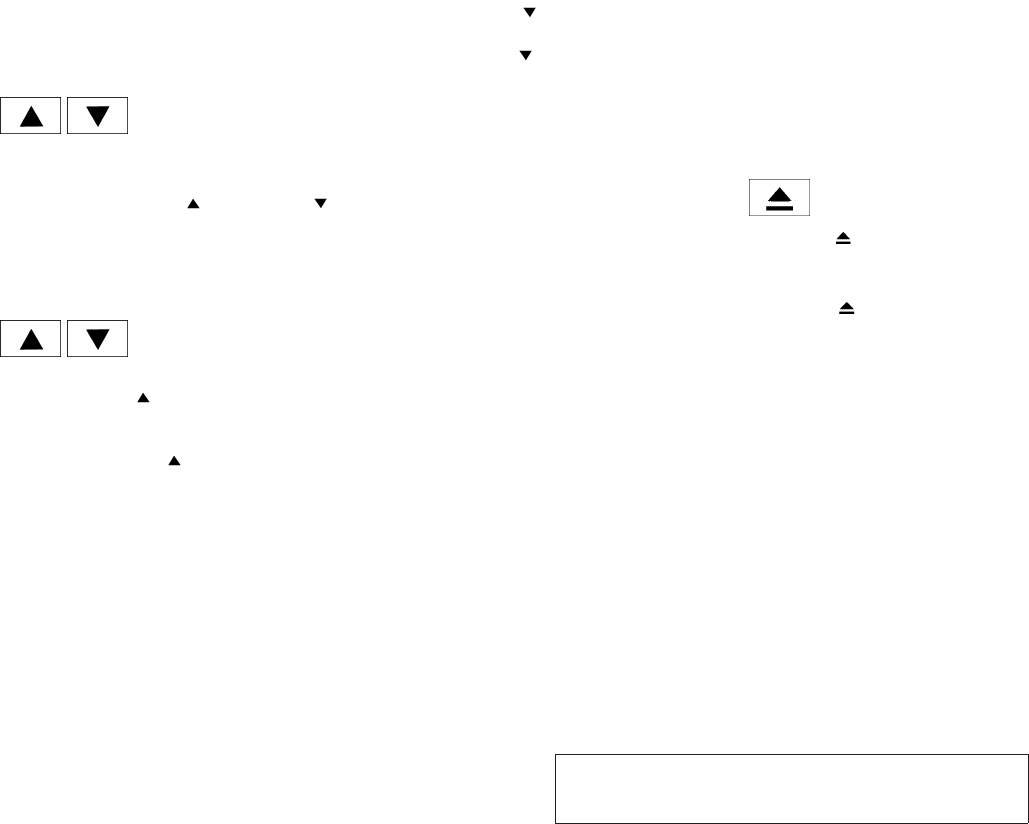
JOBNAME: 1093929-2013-asd-own PAGE: 201 SESS: 4 OUTPUT: Tue Mar 27 10:39:14 2012
CD button:
When the CD button is pressed with a compact
disc loaded and the radio playing, the radio turns
off and the last used compact disc starts to play.
SEEK and TRACK (Fast
Forward, Rewind)
buttons:
When the SEEK button or TRACK
button is pressed while the compact disc is play-
ing, the compact disc plays at an increased
speed while fast forwarding or rewinding. When
the button is released, the compact disc returns
to normal play speed.
SEEK and TRACK
buttons:
When the SEEK button is pressed while
the compact disc is playing, the next track follow-
ing the present one starts to play from the begin-
ning. Press the SEEK button several times
to skip several tracks. Each time the button is
pressed, the CD advances one additional track.
The track number appears in the display window.
(When the last track on the compact disc is
skipped, the first track is played.)
When the TRACK button is pressed, the
track being played returns to the beginning.
Press the TRACK button several times to
skip back several tracks. Each time the button is
pressed the CD moves back one track.
RPT/RDM button:
Press the RPT/RDM button while a compact disc
is playing to change the play pattern as follows:
CD:
TRACK REPEAT →DISC RANDOM →DISC
REPEAT
MP3/WMA CD:
FOLDER REPEAT →TRACK REPEAT →DISC
RANDOM →FOLDER RANDOM →DISC RE-
PEAT
TRACK REPEAT: The track that is currently play-
ing will be repeated.
DISC RANDOM: The order of the tracks on the
disc will be mixed during play.
DISC REPEAT: The disc currently playing will be
repeated.
FOLDER REPEAT: The tracks in the current
folder will be repeated.
FOLDER RANDOM: The order of the tracks in
the folder will be mixed during play.
SCAN (CDs) button:
Press the SCAN button for less than 1.5 seconds
to scan all tracks of the current disc for 10
seconds per track. The SCAN icon is flashed
during scan mode.
The scan mode is canceled once it scans through
all tracks on the disc, or if the SCAN button is
pressed during scan mode.
CD EJECT:
When the button is pressed with a com-
pact disc loaded, the compact disc will be
ejected.
When the button is pressed while the
compact disc is playing, the compact disc will
eject and the system will turn off.
AUX (Auxiliary) button:
The AUX IN jack is located on the CD player. The
AUX IN audio input jack accepts any standard
analog audio input such as from a portable cas-
sette tape/CD player, MP3 player or laptop com-
puters.
Press the AUX button to play a compatible device
when it is plugged into the AUX IN jack.
Monitor, climate, audio, phone and voice recognition systems 4-41
ZREVIEW COPY—
2013 Altima Sedan (asd)
Owners Manual—USA_English (nna)
03/24/12—dmoore
X
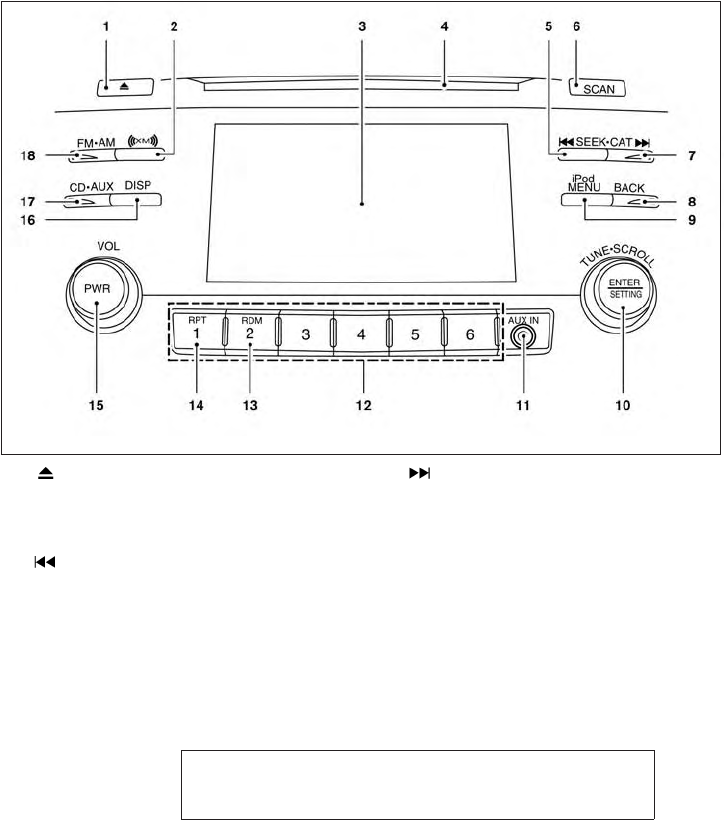
JOBNAME: 1093929-2013-asd-own PAGE: 202 SESS: 4 OUTPUT: Tue Mar 27 10:39:14 2012
Press the MENU button repeatedly until “AUX IN
Volume” appears on the screen to control the
incoming volume level of the auxiliary input de-
vice. Turn the TUNE/FOLDER knob to adjust the
level between 0 and +3.
Additional features
For more information about the BluetoothTaudio
interface available with this system, see
“BluetoothTstreaming audio without Navigation
System (Type A)” in this section.
1. CD eject button
2. XM button*
3. Display screen
4. CD insert slot
5. SEEK button
6. SCAN button
7. CAT button
8. BACK button
9. iPod MENU button
10.TUNE/SCROLL knob, ENTER/SETTING
button
11.AUX IN jack
LHA2242
4-42 Monitor, climate, audio, phone and voice recognition systems
ZREVIEW COPY—
2013 Altima Sedan (asd)
Owners Manual—USA_English (nna)
03/24/12—dmoore
X
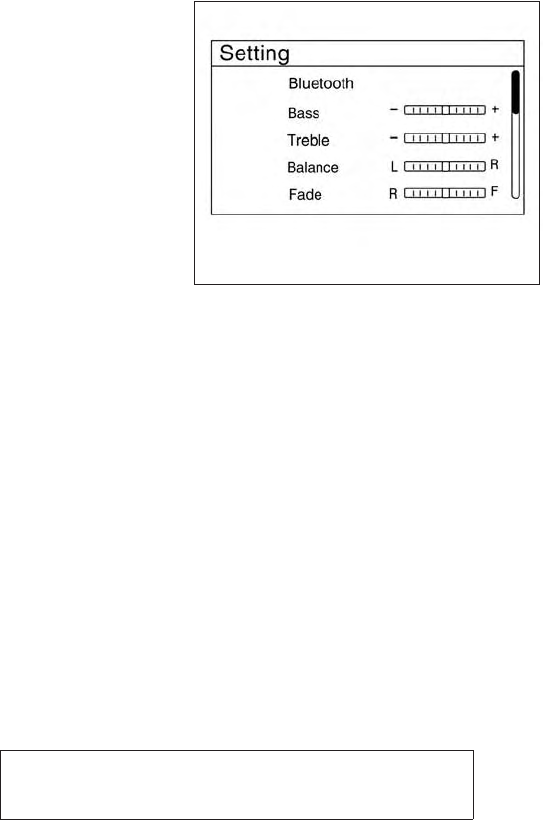
JOBNAME: 1093929-2013-asd-own PAGE: 203 SESS: 4 OUTPUT: Tue Mar 27 10:39:14 2012
12.Station select (1 - 6) buttons
13.RDM button
14.RPT button
15.VOL (volume) knob / ON-OFF button
16.DISP button
17.CD•AUX button
18.FM•AM button
*No satellite radio reception is available
when the XM button is pressed to access
satellite radio stations unless optional
satellite receiver and antenna are installed
and an SiriusXM Satellite Radio service
subscription is active. Satellite radio is
not available in Alaska, Hawaii and Guam.
FM/AM/SAT RADIO WITH
COMPACT DISC (CD) PLAYER (Type
A) (if so equipped)
For all operation precautions, see “Audio opera-
tion precautions” in this section.
Audio main operation
VOL (volume) knob / ON-OFF button:
Place the ignition switch in the ACC or ON
position and press the VOL (volume) knob /
ON-OFF button while the system is off to call up
the mode that was playing immediately before the
system was turned off.
To turn the system off, press the VOL (volume)
knob / ON-OFF button.
Turn the VOL (volume) knob / ON-OFF button to
adjust the volume.
SETTING button:
Press the SETTING button to show the Settings
screen on the display. Turn the TUNE/SCROLL
knob to navigate the options and then press the
ENTER button to make a selection.
Bass, Treble, Balance and Fade
Increase or decrease the level of bass, treble,
balance or fade. Balance controls the level of
sound between the left and right speakers. Fade
controls the level of sound between the front and
rear speakers.
LHA2257
Monitor, climate, audio, phone and voice recognition systems 4-43
ZREVIEW COPY—
2013 Altima Sedan (asd)
Owners Manual—USA_English (nna)
03/24/12—dmoore
X
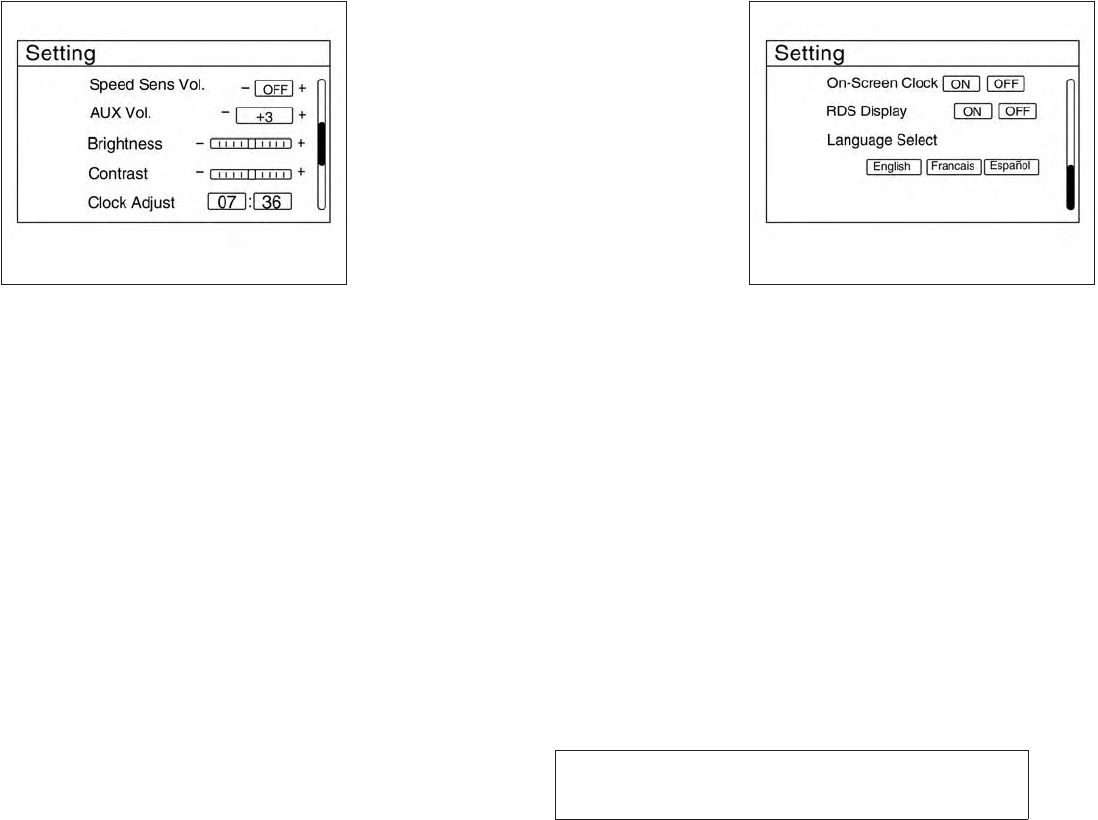
JOBNAME: 1093929-2013-asd-own PAGE: 204 SESS: 4 OUTPUT: Tue Mar 27 10:39:14 2012
Speed Sens Vol. (Speed Sensitive Volume)
Speed Sensitive Volume adjusts the volume of
the audio system as the vehicle’s driving speed
changes. The feature can be turned off or set to a
level of 1 to 5. Level 5 represents the highest
degree of volume adjustment.
AUX Vol.
Choose a setting from 0 to +3 to control the
boost of the incoming auxiliary device volume. A
setting of 0 provides no additional boost in vol-
ume. A setting of +3 provides the greatest boost
in volume.
Brightness and Contrast
Adjust the brightness or contrast to adjust the
appearance of the display screen.
Clock Adjust
Press the ENTER button to highlight the hours or
minutes and then use the TUNE/SCROLL knob
to adjust the value. Press the ENTER button
again to set the value.
On-Screen Clock
Select “ON” or “OFF” to control whether or not
the clock is shown in the upper right corner of the
display screen.
RDS Display
Select “ON” or “OFF” to control whether or not
RDS information is displayed on the screen while
the radio is playing.
Language Select
Select the desired language for the system. Eng-
lish, Spanish and French are the available lan-
guages.
LHA2258 LHA2259
4-44 Monitor, climate, audio, phone and voice recognition systems
ZREVIEW COPY—
2013 Altima Sedan (asd)
Owners Manual—USA_English (nna)
03/24/12—dmoore
X
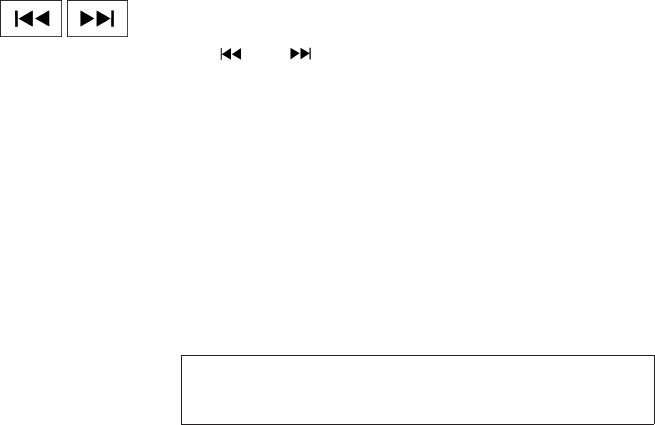
JOBNAME: 1093929-2013-asd-own PAGE: 205 SESS: 4 OUTPUT: Tue Mar 27 10:39:14 2012
iPodTMENU button
This button can only be used for iPodTopera-
tions. See “iPodTplayer operation without Navi-
gation System” later in this section for details
about the function of this button.
FM/AM/SAT radio operation
FM·AM button:
Press the FM·AM button to change the band as
follows:
AM →FM1 →FM2 →AM
If another audio source is playing when the
FM·AM button is pressed, the audio source play-
ing will automatically be turned off and the last
radio station played will begin playing.
The FM stereo indicator (STEREO) is shown on
the screen during FM stereo reception. When the
stereo broadcast signal is weak, the radio auto-
matically changes from stereo to monaural re-
ception.
XM band select:
Press the XM button to change the band as
follows:
XM1* →XM2* →XM3* →XM1 (satellite, if so
equipped)
When the XM button is pressed while the ignition
switch is in the ACC or ON position, the radio will
come on at the station last played.
The last station played will also come on when
the VOL/ON·OFF control knob is pressed ON.
*When the XM button is pressed, the satellite
radio reception will not be available unless an
optional satellite receiver and antenna are in-
stalled and a SiriusXM Satellite Radio service
subscription is active. Satellite radio is not avail-
able in Alaska, Hawaii and Guam.
If a compact disc is playing when the XM button
is pressed, the compact disc will automatically be
turned off and the last radio station played will
come on.
TUNE/SCROLL knob (Tuning):
Turn the TUNE/SCROLL knob to the left or right
for manual tuning.
SEEK tuning:
Press the SEEK•CAT button or to
tune from low to high or high to low frequencies
and to stop at the next broadcasting station.
SCAN tuning:
Press the SCAN button to stop at each broad-
casting station for 5 seconds. SCAN will appear
on the screen while the radio is scan tuning.
Pressing the button again during this 5 second
period will stop SCAN tuning and the radio will
remain tuned to that station. If the SCAN button is
not pressed within 5 seconds, SCAN tuning
moves to the next station.
1 to 6 Station memory operations:
Six stations can be set for the AM band. Twelve
stations can be set for the FM band (6 for FM1, 6
for FM2). Eighteen channels can be set for the
satellite radio (6 for XM1, 6 for XM2, 6 for XM3).
1. Choose the radio band AM, FM1 or FM2
using the FM·AM select button, or choose
the satellite band XM1, XM2 or XM3 using
the XM button.
2. Tune to the desired station using manual,
SEEK or SCAN tuning. Press and hold any
of the desired station memory buttons (1 –
6) until the preset number is updated on the
display and the sound is briefly muted.
3. The channel indicator will then come on and
the sound will resume. Programming is now
complete.
4. Other buttons can be set in the same man-
ner.
If the battery cable is disconnected, or if the fuse
opens, the radio memory will be canceled. In that
case, reset the desired stations.
Monitor, climate, audio, phone and voice recognition systems 4-45
ZREVIEW COPY—
2013 Altima Sedan (asd)
Owners Manual—USA_English (nna)
03/24/12—dmoore
X
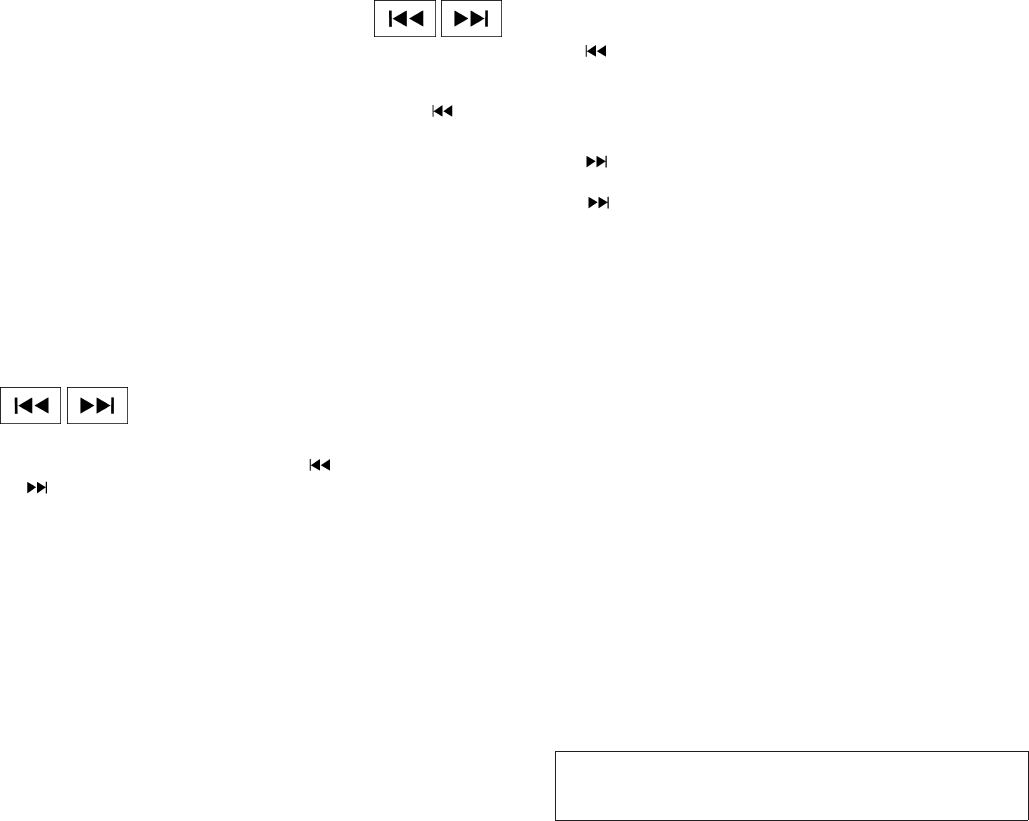
JOBNAME: 1093929-2013-asd-own PAGE: 206 SESS: 4 OUTPUT: Tue Mar 27 10:39:14 2012
Compact disc (CD) player operation
If the radio is already operating, it automatically
turns off and the compact disc begins to play.
CD·AUX button:
With a CD loaded, press the CD·AUX button until
the CD mode is displayed on the screen.
CD/MP3 display mode:
While listening to an MP3/WMA CD, certain text
may be displayed on the screen if the CD has
been encoded with text information. Depending
on how the MP3/WMA CD is encoded, informa-
tion such as Artist, Song and Folder will be dis-
played.
The track number and the total number of tracks
in the current folder or on the current disc are
displayed on the screen as well.
SEEK/CAT (Reverse or
Fast Forward) button:
Press and hold the SEEK/CAT button
or for 1.5 seconds while the compact disc
is playing to reverse or fast forward the track
being played. The compact disc plays at an in-
creased speed while reversing or fast forwarding.
When the button is released, the compact disc
returns to normal play speed.
SEEK/CAT button:
Press the SEEK/CAT button while a CD or
MP3/WMA CD is playing to return to the begin-
ning of the current track. Press the SEEK/CAT
button several times to skip backward sev-
eral tracks.
Press the SEEK/CAT button while a CD or
MP3/WMA CD is playing to advance one track.
Press the SEEK/CAT button several times
to skip forward several tracks. If the last track on
a CD is skipped, the first track on the disc is
played. If the last track in a folder of an
MP3/WMA CD is skipped, the first track of the
next folder is played.
TUNE/SCROLL knob (MP3/WMA CD
only):
If an MP3/WMA CD with multiple folders is play-
ing, turn the TUNE/SCROLL knob to change
folders. Turn the knob to the left to skip back a
folder. Turn the knob to the right to skip ahead a
folder.
RPT button:
When the RPT button is pressed while a com-
pact disc is playing, the play pattern can be
changed as follows:
CD:
1 Track Repeat ←→ OFF
CD with MP3 or WMA:
1 Folder Repeat →1 Track Repeat →OFF
1 Track Repeat: the current track will be re-
peated.
1 Folder Repeat: the current folder will be re-
peated.
OFF: No repeat play pattern is applied. The indi-
cator on the display will turn off.
The current play pattern of the CD is displayed on
the screen unless no pattern is applied.
RDM button:
When the RDM button is pressed while a com-
pact disc is playing, the play pattern can be
changed as follows:
CD:
1 Disc Random ←→ OFF
4-46 Monitor, climate, audio, phone and voice recognition systems
ZREVIEW COPY—
2013 Altima Sedan (asd)
Owners Manual—USA_English (nna)
03/24/12—dmoore
X

JOBNAME: 1093929-2013-asd-own PAGE: 207 SESS: 4 OUTPUT: Tue Mar 27 10:39:14 2012
CD with MP3 or WMA:
1 Disc Random →1 Folder Random →OFF
1 Disc Random: all tracks on the disc will be
played randomly.
1 Folder Random: all tracks in the current folder
will be played randomly.
OFF: No random play pattern is applied. The
indicator on the display will turn off.
The current play pattern of the CD is displayed on
the screen unless no pattern is applied.
CD•AUX button:
The AUX IN jack is located on the CD player. The
AUX IN audio input jack accepts any standard
analog audio input such as from a portable cas-
sette tape/CD player, MP3 player or a laptop
computer.
Press the CD•AUX button to play a compatible
device plugged into the AUX IN jack. The
CD•AUX button is also used to switch the audio
system to a source plugged into the USB input
jack in the center console. When a device is
plugged into the AUX IN jack while another de-
vice is plugged into the USB input jack, the
CD•AUX button is used to toggle between the
two functions.
For more information about the USB input jack,
see “USB interface (models without Navigation
System)” in this section.
EJECT button:
When the button is pressed with a com-
pact disc loaded, the compact disc will eject and
the last source will be played.
When the button is pressed twice with a
compact disc loaded, the compact disc will be
ejected further for easier CD removal. If the disc
is not removed within 20 seconds, the disc will
reload.
Additional features
For more information about the iPodTplayer
available with this system, see “iPodTplayer op-
eration without Navigation System” in this sec-
tion.
For more information about the USB interface
available with this system, see “USB interface
(models without Navigation System)” in this sec-
tion.
For more information about the BluetoothTaudio
interface available with this system, see
“BluetoothTstreaming audio without Navigation
System (Type B)” in this section.
For more information about the PandoraTaudio
feature available with this system, see “PandoraT
audio” in this section.
Monitor, climate, audio, phone and voice recognition systems 4-47
ZREVIEW COPY—
2013 Altima Sedan (asd)
Owners Manual—USA_English (nna)
03/24/12—dmoore
X
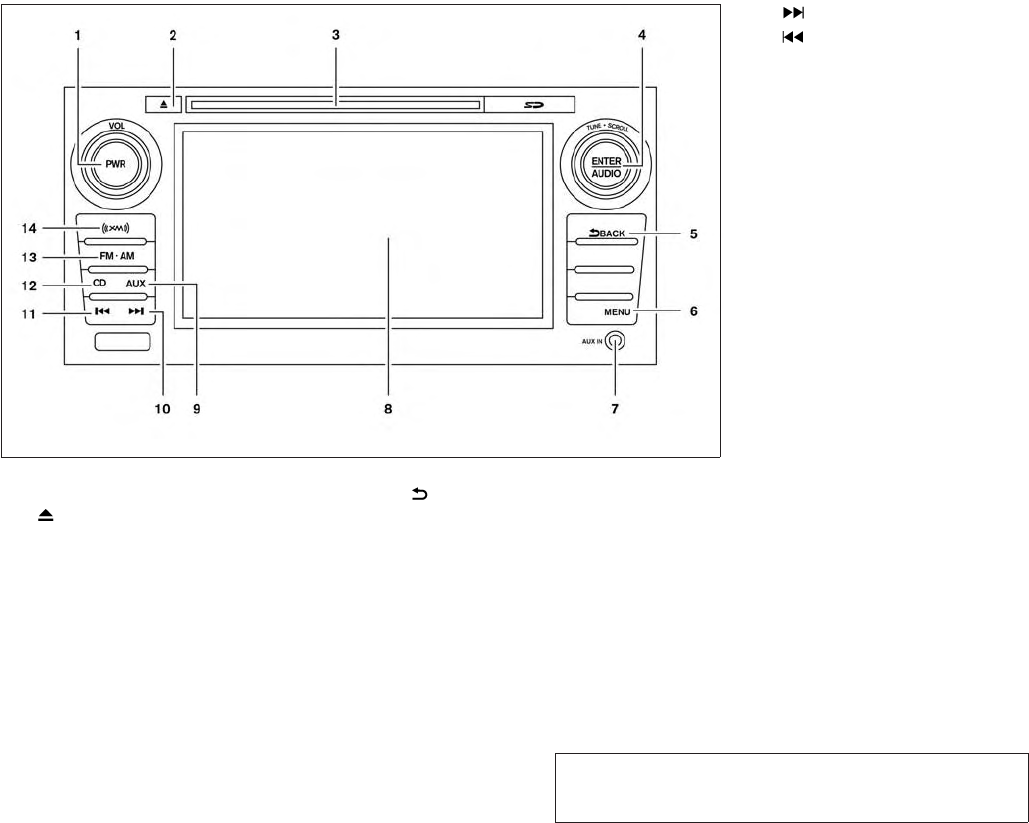
JOBNAME: 1093929-2013-asd-own PAGE: 208 SESS: 4 OUTPUT: Tue Mar 27 10:39:14 2012
1. VOL (volume) / PWR (power) button
2. CD eject button
3. CD insert slot
4. TUNE/SCROLL knob, ENTER/AUDIO
button
5. BACK button
6. MENU button
7. AUX IN jack
8. Display screen
9. AUX button
10. Forward seek button
11. Backward seek button
12.CD button
13.FM-AM button
14.XM button
*No satellite radio reception is available
when the XM button is pressed to access
satellite radio stations unless optional
satellite receiver and antenna are installed
and an SiriusXM Satellite Radio service
subscription is active. Satellite radio is
not available in Alaska, Hawaii and Guam.
FM/AM/SAT RADIO WITH
COMPACT DISC (CD) PLAYER (Type
B) (if so equipped)
For all operation precautions, see “Audio opera-
tion precautions” in this section.
Audio main operation
VOL (volume) / PWR (power) button:
Place the ignition switch in the ACC or ON
position and press the PWR (power) button
while the system is off to call up the mode (radio,
CD, AUX, BluetoothTaudio USB or iPodT) that
was playing immediately before the system was
turned off.
Type B
LHA2240
4-48 Monitor, climate, audio, phone and voice recognition systems
ZREVIEW COPY—
2013 Altima Sedan (asd)
Owners Manual—USA_English (nna)
03/24/12—dmoore
X
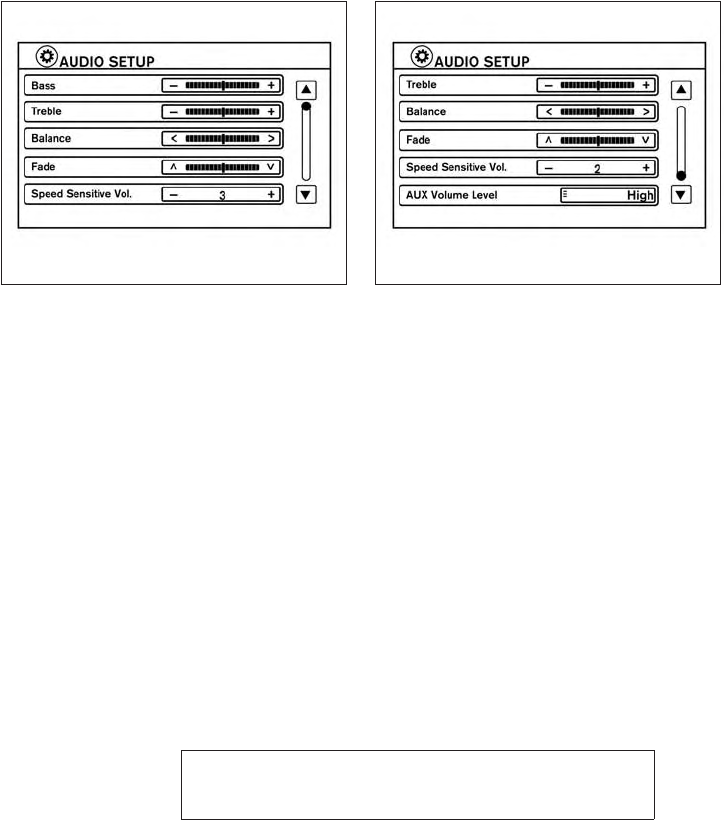
JOBNAME: 1093929-2013-asd-own PAGE: 209 SESS: 4 OUTPUT: Tue Mar 27 10:39:14 2012
To turn the system off, press the PWR (power)
button.
Turn the VOL (volume) control knob to adjust the
volume.
This vehicle may be equipped with Speed Sen-
sitive Volume. When this feature is active, the
audio volume changes as the driving speed
changes.
Audio settings:
1. Press the MENU button.
2. Select the “Settings” key.
3. Select the “Audio” key.
Use the touchscreen to adjust the following items
to the desired setting:
Bass, Treble, Balance and Fade:
Controls the sound of the audio system. Balance
adjusts the sound between the left and right
speakers. Fade adjusts the sound between the
front and rear speakers.
Speed Sensitive Vol.:
Controls the level to which the volume is adjusted
as the vehicle’s driving speed changes. Choose a
setting or choose “0” to disable the feature en-
tirely.
AUX Volume Level:
Controls the volume level of incoming sound
when an auxiliary device is connected to the
system. Available options are Low, Medium and
High.
LHA2261 LHA2262
Monitor, climate, audio, phone and voice recognition systems 4-49
ZREVIEW COPY—
2013 Altima Sedan (asd)
Owners Manual—USA_English (nna)
03/24/12—dmoore
X
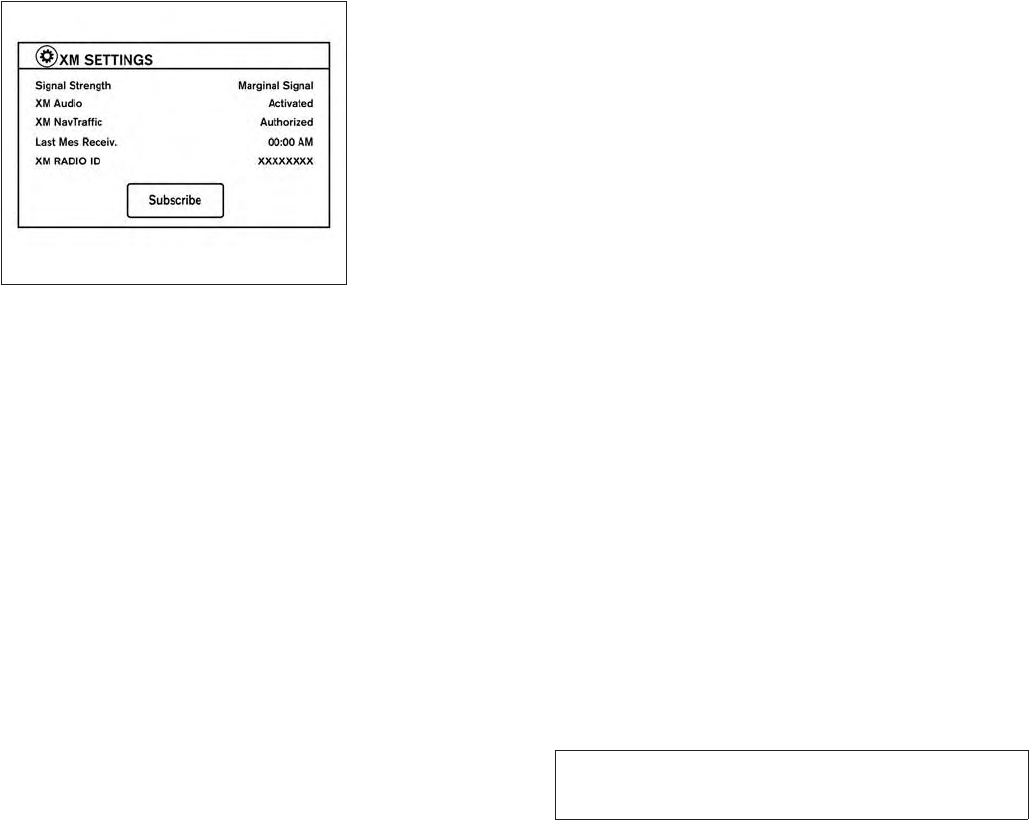
JOBNAME: 1093929-2013-asd-own PAGE: 210 SESS: 4 OUTPUT: Tue Mar 27 10:39:14 2012
XM settings:
To view the XM settings:
1. Press the MENU button.
2. Select the “Settings” key.
3. Select the “XM” key.
The signal strength, activation status and other
information are displayed on the screen.
FM/AM/SAT radio operation
FM·AM button:
Press the FM·AM button to change the band as
follows:
AM →FM1 →FM2 →AM
If another audio source is playing when the
FM·AM button is pressed, the audio source play-
ing will automatically be turned off and the last
radio station played will begin playing.
The FM stereo indicator (ST) is shown on the
screen during FM stereo reception. When the
stereo broadcast signal is weak, the radio auto-
matically changes from stereo to monaural re-
ception.
XM band select:
Pressing the XM button will change the band as
follows:
XM1* →XM2* →XM3* →XM1* (satellite, if so
equipped)
When the XM button is pressed while the ignition
switch is in the ACC or ON position, the radio will
come on at the last station played.
The last station played will also come on when
the VOL/ON-OFF control knob is pressed to turn
the radio on.
*When the XM button is pressed, the satellite
radio mode will be skipped unless an optional
satellite receiver and antenna are installed and a
SiriusXM Satellite Radio service subscription is
active. Satellite radio is not available in Alaska,
Hawaii and Guam.
If a compact disc is playing when the XM button
is pressed, the compact disc will automatically be
turned off and the last radio station played will
come on.
LHA2303
4-50 Monitor, climate, audio, phone and voice recognition systems
ZREVIEW COPY—
2013 Altima Sedan (asd)
Owners Manual—USA_English (nna)
03/24/12—dmoore
X
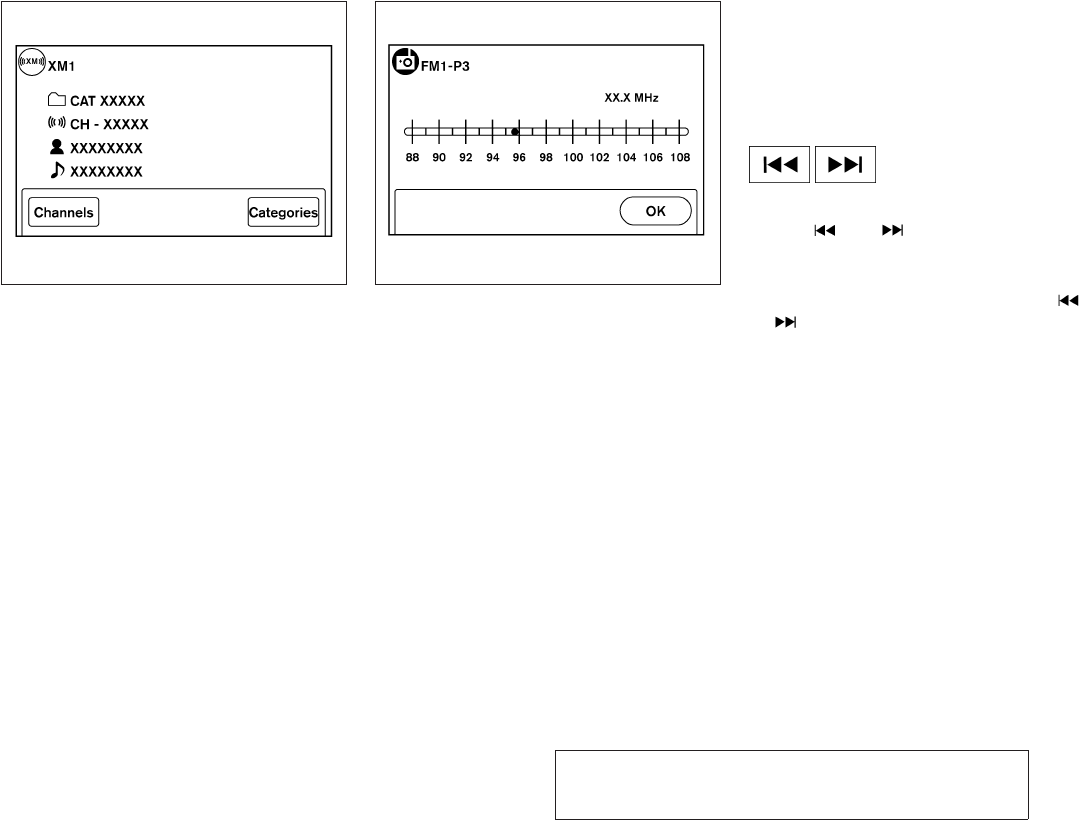
JOBNAME: 1093929-2013-asd-own PAGE: 211 SESS: 4 OUTPUT: Tue Mar 27 10:39:14 2012
While the radio is in XM mode, the operation can
be controlled through the touchscreen. Touch
the “Channels” key to display a list of channels.
Touch a channel displayed on the list to change
to that channel. Touch the “Categories” key to
display a list of categories. Touch a category
displayed on the list to display options within that
category.
Tuning with the touchscreen:
When in AM or FM mode, the radio can be tuned
using the touchscreen. To bring up the visual
tuner, touch the “Tune” key on the lower right
corner of the screen. A screen appears with a bar
running from low frequencies on the left to high
frequencies on the right. Touch the screen at the
location of the frequency you wish to tune and the
station will change to that frequency. To return to
the regular radio display screen, touch the “OK”
key.
Tuning with the TUNE/SCROLL knob:
The radio can also be manually tuned using the
TUNE/SCROLL knob. When in FM or AM mode,
turn the TUNE/SCROLL knob to the left for lower
frequencies or to the right for higher frequencies.
When in XM mode, turn the TUNE/SCROLL
knob to change the channel.
SEEK tuning:
When in FM or AM mode, press the seek
buttons or to tune from low to high
or high to low frequencies and to stop at the next
broadcasting station.
When in XM mode, press the seek buttons
or to change the category.
LHA1492 LHA1489
Monitor, climate, audio, phone and voice recognition systems 4-51
ZREVIEW COPY—
2013 Altima Sedan (asd)
Owners Manual—USA_English (nna)
03/24/12—dmoore
X
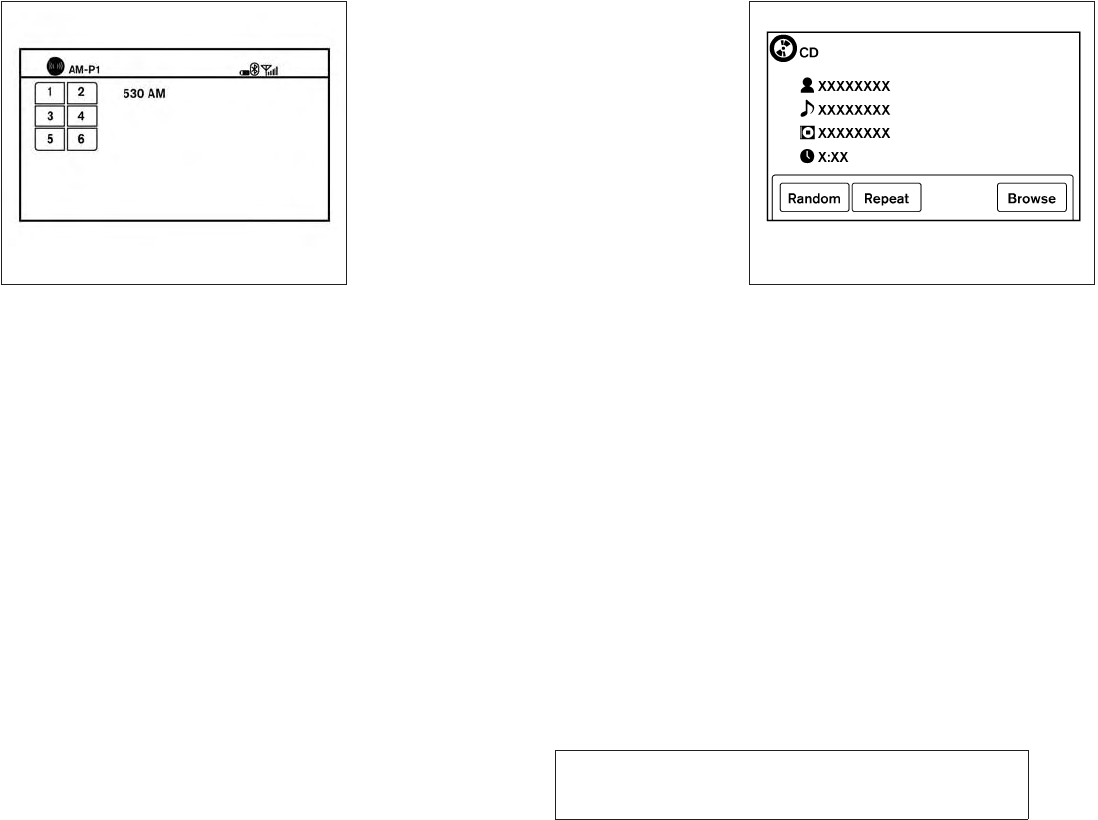
JOBNAME: 1093929-2013-asd-own PAGE: 212 SESS: 4 OUTPUT: Tue Mar 27 10:39:14 2012
1 to 6 Station memory operations:
Twelve stations can be set for the FM band (6 for
FM1, 6 for FM2) and six stations can be set for
the AM band. Eighteen stations can be set for the
XM band (6 for XM1, 6 for XM2, 6 for XM3).
1. Choose the radio band AM, FM1 or FM2
using the FM·AM select button or choose
the radio band XM1, XM2 or XM3 using the
XM button.
2. Tune to the desired station using manual or
seek tuning. Press and hold any of the de-
sired station memory buttons (1 – 6) until a
beep sound is heard.
3. The channel indicator will then come on and
the sound will resume. Programming is now
complete.
4. Other buttons can be set in the same man-
ner.
If the battery cable is disconnected or if the fuse
opens, the radio memory will be canceled. In that
case, reset the desired stations.
Presets can also be selected by touching the
desired preset number on the screen.
Compact disc (CD) player operation
If the radio is already operating, it automatically
turns off and the compact disc begins to play.
CD button:
When the CD button is pressed with the system
off and the compact disc loaded, the system will
turn on and the compact disc will start to play.
When the CD button is pressed with a compact
disc loaded and the radio playing, the radio will
automatically be turned off and the compact disc
will start to play.
CD/MP3 display mode
While listening to a CD or an MP3/WMA CD,
certain text may be displayed (when a CD en-
coded with text is being used). Depending on
how the CD or MP3/WMA CD is encoded, the
text is displayed listing the artist, album and song
title.
There are other keys displayed on the screen
when a CD is playing:
LHA2263 LHA1488
4-52 Monitor, climate, audio, phone and voice recognition systems
ZREVIEW COPY—
2013 Altima Sedan (asd)
Owners Manual—USA_English (nna)
03/24/12—dmoore
X
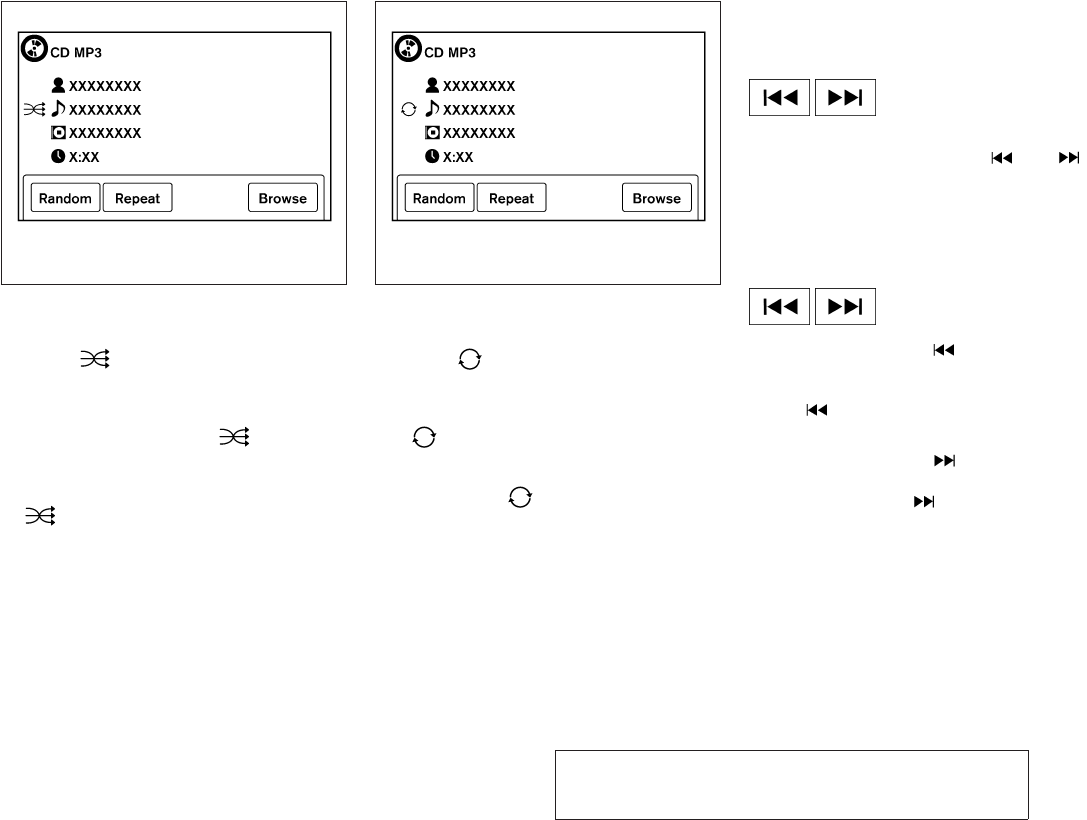
JOBNAME: 1093929-2013-asd-own PAGE: 213 SESS: 4 OUTPUT: Tue Mar 27 10:39:14 2012
Random:
Touch the “Random” key to apply a random play
pattern to the CD. When the random mode is
active, the icon will be displayed to the left
of the song title. If an MP3 CD is playing, touch-
ing “Random” alternates between randomly play-
ing songs within the current folder and songs
from the CD as a whole. The icon is dis-
played to the left of the song title or folder name
to denote which pattern is applied. To cancel
Random mode, touch the “Random” key until
no icon is displayed.
Repeat:
Touch the “Repeat” key to apply a repeat play
pattern to the CD. When the repeat mode is
active, the icon will be displayed to the left
of the song title. If an MP3 CD is playing, touch-
ing “Repeat” alternates between repeating the
current song and repeating the current folder.
The icon is displayed to the left of the song
title or folder name to denote which pattern is
applied. To cancel Repeat mode, touch the “Re-
peat” key until no icon is displayed.
Browse:
Touch the “Browse” key to display the titles on
the CD in list format. Touch the title of a song in
the list to begin playing that song. If an MP3 CD is
playing, touching the “Browse” key will also list
the folders on the disc. Follow the procedure for
selecting a song with the touchscreen to choose
a folder.
SEEK (Reverse or Fast
Forward) buttons:
Press and hold the seek buttons or
for 1.5 seconds while the compact disc is playing
to reverse or fast forward the track being played.
The compact disc plays at an increased speed
while reversing or fast forwarding. When the but-
ton is released, the compact disc returns to nor-
mal play speed.
SEEK buttons:
Press the seek button while a CD or
MP3/WMA CD is playing to return to the begin-
ning of the current track. Press the seek
button several times to skip backward sev-
eral tracks.
Press the seek button while a CD or
MP3/WMA CD is playing to advance one track.
Press the seek button several times to skip
forward several tracks. If the last track on a CD is
skipped, the first track on the disc is played. If the
last track in a folder of an MP3/WMA CD is
skipped, the first track of the next folder is played.
LHA1490 LHA1491
Monitor, climate, audio, phone and voice recognition systems 4-53
ZREVIEW COPY—
2013 Altima Sedan (asd)
Owners Manual—USA_English (nna)
03/24/12—dmoore
X
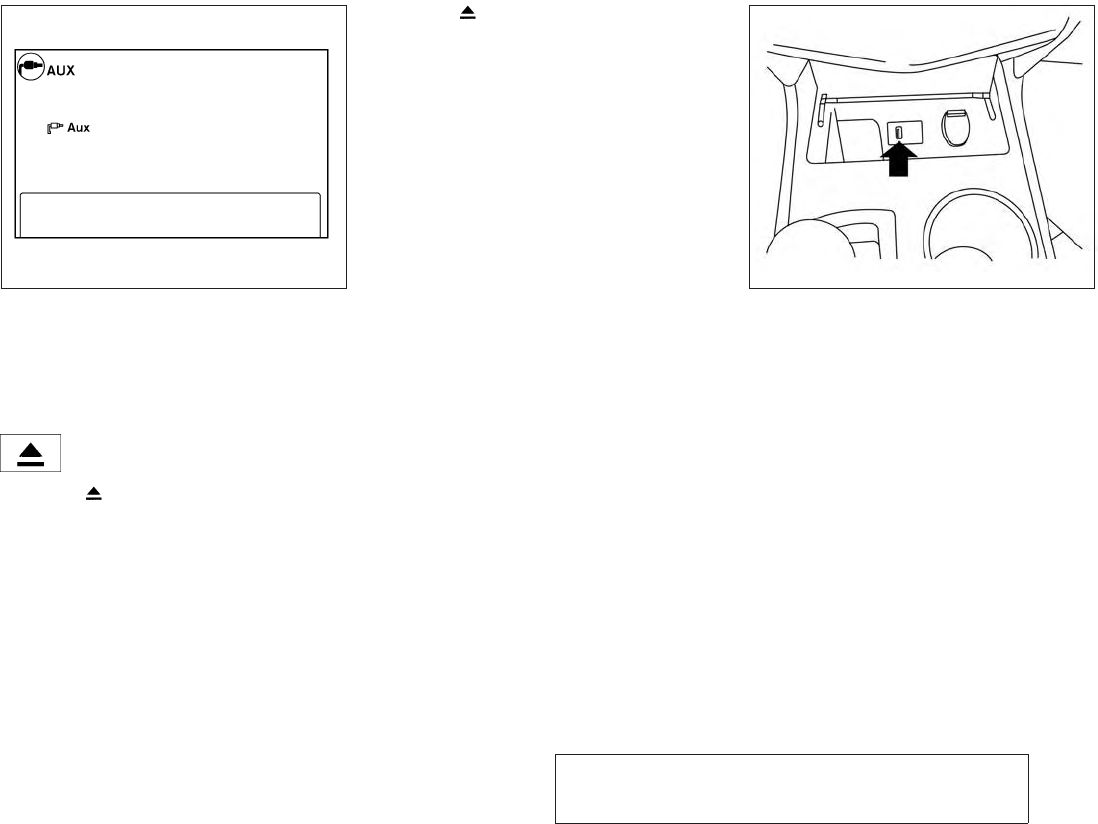
JOBNAME: 1093929-2013-asd-own PAGE: 214 SESS: 4 OUTPUT: Tue Mar 27 10:39:14 2012
AUX button:
The AUX IN audio input jack accepts any stan-
dard analog audio input such as from a portable
cassette tape/CD player, MP3 player or a laptop
computer. Press the AUX button to play a com-
patible device plugged into the AUX IN jack.
EJECT button:
When the button is pressed with a com-
pact disc loaded, the compact disc will eject and
the last source will be played.
When the button is pressed twice with a
compact disc loaded, the compact disc will be
ejected further for easier CD removal. If the disc
is not removed within 10 seconds, the disc will
reload.
Additional features
For more information about the iPodTplayer
available with this system, see “iPodTplayer op-
eration with Navigation System” in this section.
For more information about the USB interface
available with this system, see “USB interface
(models with Navigation System)” in this section.
For more information about the BluetoothTaudio
interface available with this system, see
“BluetoothTstreaming audio with Navigation
System” in this section.
For more information about the PandoraTaudio
feature available with this system, see “PandoraT
audio” in this section.
USB INTERFACE (models without
Navigation System) (if so equipped)
Connecting a device to the USB input
jack
The USB input jack is located on the center
console beneath the heater and air conditioner
controls. Insert the USB device into the jack.
When a compatible storage device is plugged
into the jack, compatible audio files on the stor-
age device can be played through the vehicle’s
audio system.
LHA1493 LHA2264
4-54 Monitor, climate, audio, phone and voice recognition systems
ZREVIEW COPY—
2013 Altima Sedan (asd)
Owners Manual—USA_English (nna)
03/24/12—dmoore
X
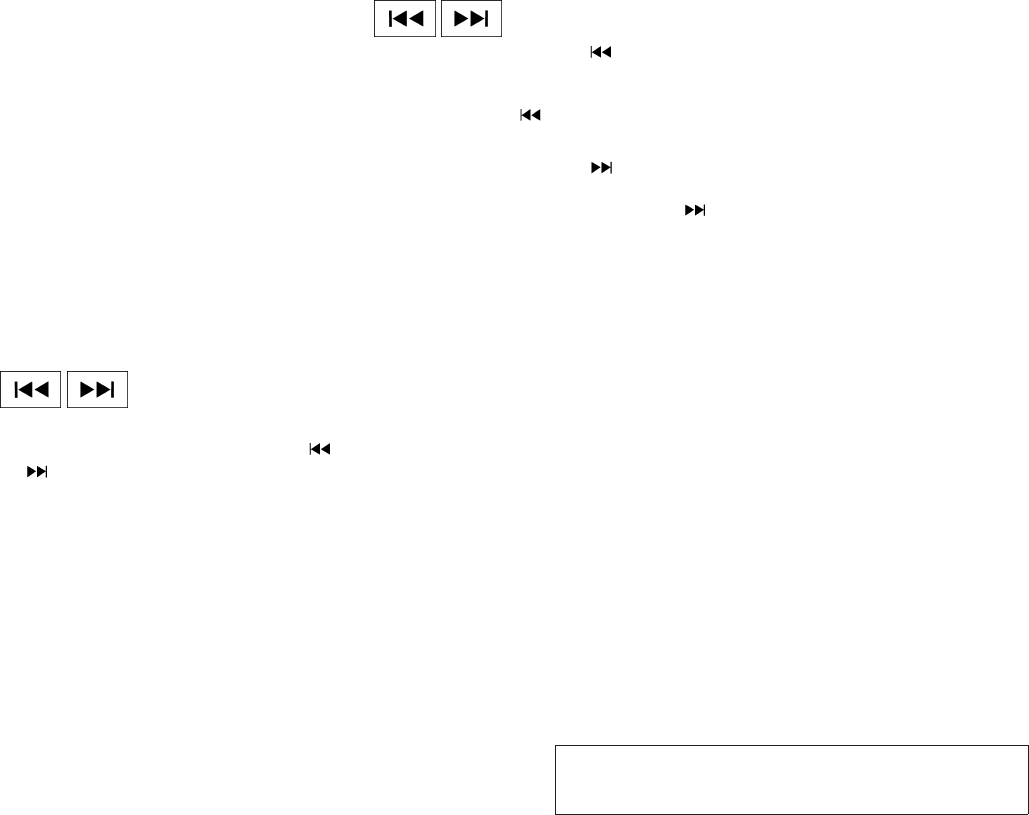
JOBNAME: 1093929-2013-asd-own PAGE: 215 SESS: 4 OUTPUT: Tue Mar 27 10:39:14 2012
Audio file operation
CD•AUX button:
Place the ignition switch in the ON or ACC
position and press the CD•AUX button to switch
to the USB input mode. If a CD is playing or
another audio source is plugged in through the
AUX IN jack on the radio, the CD•AUX button
toggles between the three sources.
Play information
Information about the audio files being played
can be displayed on the display screen of the
vehicle’s audio system. Depending on how the
audio files are encoded, information such as
Folder, Song and Artist will be displayed.
The track number and number of total tracks in
the folder are displayed on the screen as well.
SEEK/CAT (Reverse or
Fast Forward) buttons:
Press and hold the SEEK/CAT buttons
or for 1.5 seconds while an audio file on
the USB device is playing to reverse or fast
forward the track being played. The track plays at
an increased speed while reversing or fast for-
warding. When the button is released, the audio
file returns to normal play speed.
SEEK/CAT buttons:
Press the SEEK/CAT button while an au-
dio file on the USB device is playing to return to
the beginning of the current track. Press the
SEEK/CAT button several times to skip
backward several tracks.
Press the SEEK/CAT button while an au-
dio file on the USB device is playing to advance
one track. Press the SEEK/CAT button
several times to skip forward several tracks. If the
last track in a folder on the USB device is
skipped, the first track of the next folder is played.
RDM button:
When the RDM button is pressed while an audio
file on the USB device is playing, the play pattern
can be changed as follows:
All Random →1 Folder Random →OFF
All Random: all tracks on the USB device will be
played randomly.
1 Folder Random: all tracks in the current folder
will be played randomly.
OFF: No random play pattern is applied. The
indicator on the display will turn off.
The current play pattern of the USB device is
displayed on the screen unless no pattern is
applied.
RPT button:
When the RPT button is pressed while an audio
file on the USB device is playing, the play pattern
can be changed as follows:
1 Folder Repeat →1 Track Repeat →OFF
1 Track Repeat: the current track will be re-
peated.
1 Folder Repeat: the current folder will be re-
peated.
OFF: No repeat play pattern is applied. The indi-
cator on the display will turn off.
The current play pattern of the USB device is
displayed on the screen unless no pattern is
applied.
TUNE/SCROLL knob:
If there are multiple folders with audio files on the
USB device, turn the TUNE/SCROLL knob to
change folders. Turn the knob to the left to skip
back a folder. Turn the knob to the right to skip
ahead a folder. If there is only one folder of audio
files on the USB device, turning the
TUNE/SCROLL knob in either direction will re-
turn to the first track on the USB device.
Monitor, climate, audio, phone and voice recognition systems 4-55
ZREVIEW COPY—
2013 Altima Sedan (asd)
Owners Manual—USA_English (nna)
03/24/12—dmoore
X
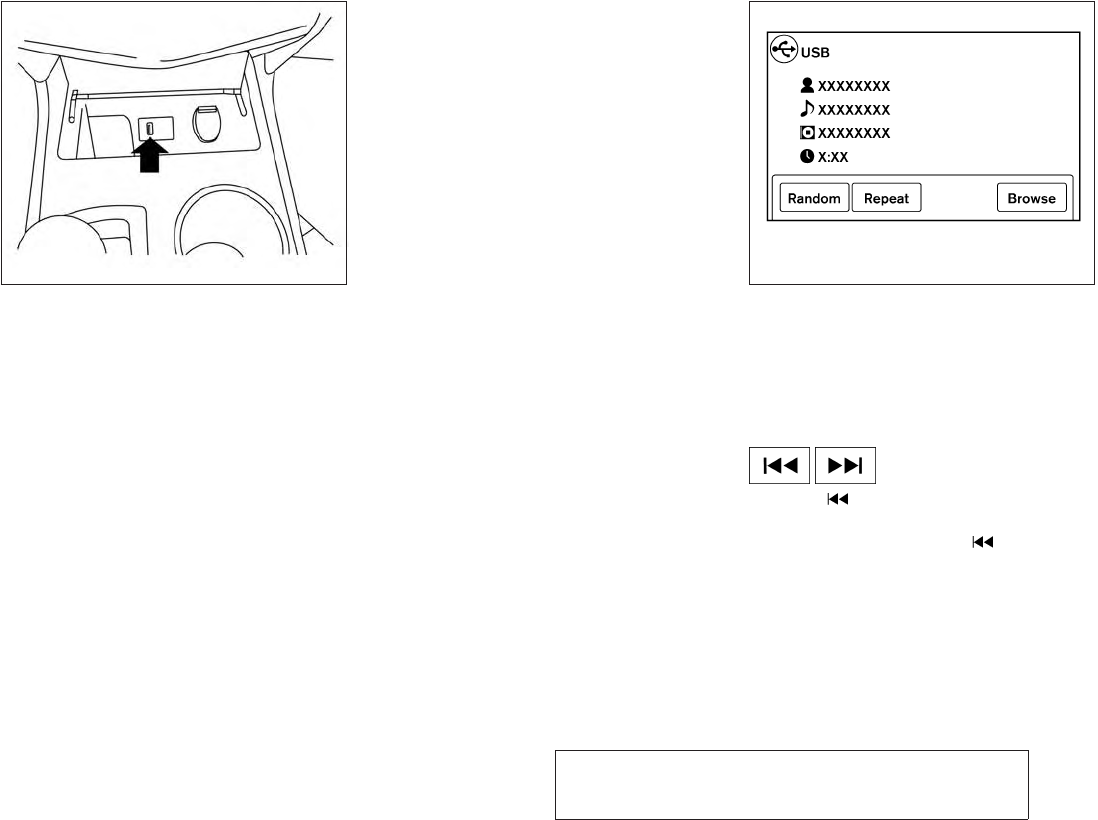
JOBNAME: 1093929-2013-asd-own PAGE: 216 SESS: 4 OUTPUT: Tue Mar 27 10:39:14 2012
USB INTERFACE (models with
Navigation System)
Connecting a device to the USB input
jack
The USB input jack is located on the center
console beneath the heater and air conditioner
controls. Insert the USB device into the jack.
When a compatible storage device is plugged
into the jack, compatible audio files on the stor-
age device can be played through the vehicle’s
audio system.
Audio file operation
AUX button:
Place the ignition switch in the ON or ACC
position and press the AUX button to switch to
the USB input mode. If another audio source is
playing and a USB memory device is inserted,
press the AUX button repeatedly until the center
display changes to the USB memory mode.
If the system has been turned off while the USB
memory was playing, push the ON-OFF/VOL
control knob to restart the USB memory.
Play information:
Information about the audio files being played is
shown on the display screen of the vehicle’s
audio system. Touch “Browse” to display the list
of folders and files on the USB device. Touch the
name of a song on the screen to begin playing
that song.
Seeking buttons:
Press the button while an audio file on the
USB device is playing to return to the beginning
of the current track. Press the button sev-
eral times to skip backward several tracks.
LHA2264 LHA1496
4-56 Monitor, climate, audio, phone and voice recognition systems
ZREVIEW COPY—
2013 Altima Sedan (asd)
Owners Manual—USA_English (nna)
03/24/12—dmoore
X
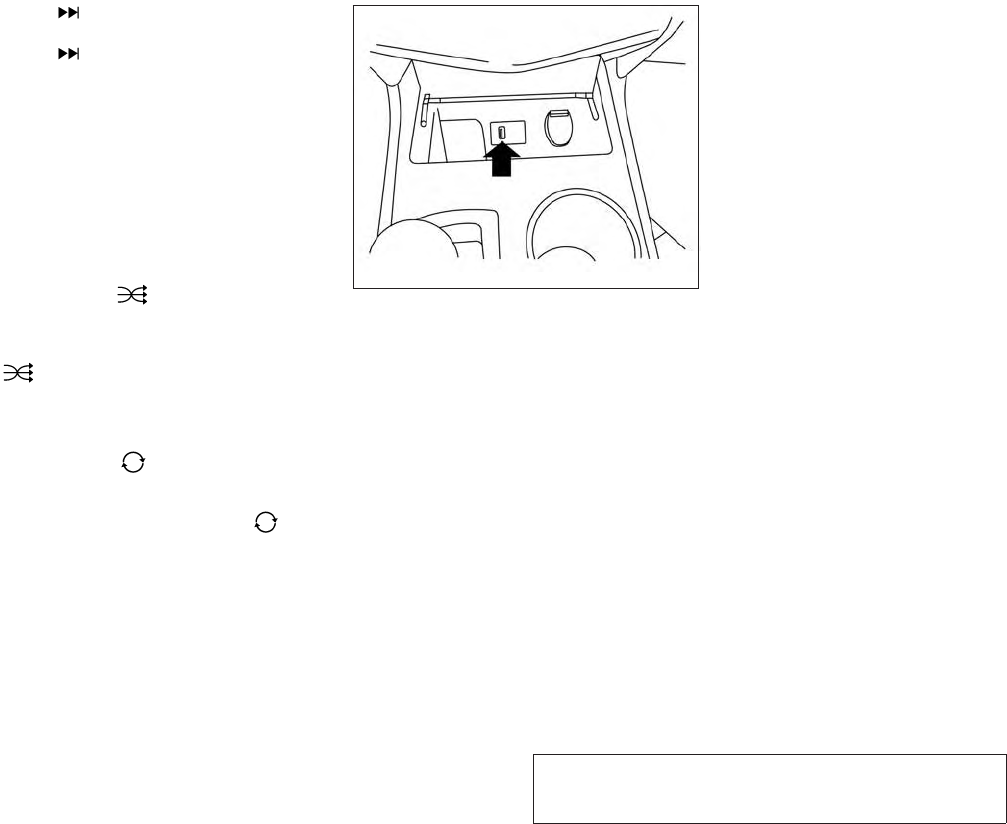
JOBNAME: 1093929-2013-asd-own PAGE: 217 SESS: 4 OUTPUT: Tue Mar 27 10:39:14 2012
Press the button while an audio file on the
USB device is playing to advance one track.
Press the button several times to skip for-
ward several tracks. If the last track in a folder on
the USB device is skipped, the first track of the
next folder is played.
Random and repeat play mode:
While files on a USB device are playing, the play
pattern can be altered so that songs are repeated
or played randomly.
Random:
Touch the “Random” key to apply a random play
pattern to the USB device. When the random
mode is active, the icon is displayed to the
left of the song title or album name to denote
which random pattern is applied. To cancel Ran-
dom mode, touch the “Random” key until
no icon is displayed.
Repeat:
Touch the “Repeat” key to apply a repeat play
pattern to the USB device. When the repeat
mode is active, the icon is displayed to the
left of the song title or album name to denote
which repeat pattern is applied. To cancel Repeat
mode, touch the “Repeat” key until no icon
is displayed.
iPodT* PLAYER OPERATION
WITHOUT NAVIGATION SYSTEM (if
so equipped)
Connecting iPodT
To connect an iPodTto the vehicle so that the
iPodTcan be controlled with the audio system
controls and display screen, use the USB jack
located on the center console below the heater
and air conditioner controls. Connect the iPodT-
specific end of the cable to the iPodTand the
USB end of the cable to the USB jack on the
vehicle. If your iPodTsupports charging via a
USB connection, its battery will be charged while
connected to the vehicle with the ignition switch
in the ACC or ON position.
While connected to the vehicle, the iPodTcan
only be operated by the vehicle audio controls.
To disconnect the iPodTfrom the vehicle, remove
the USB end of the cable from the USB jack on
the vehicle, then remove the cable from the
iPodT.
* iPodTis a trademark of Apple Inc., registered in
the U.S. and other countries.
Compatibility
The following models are compatible:
●iPodT5th Generation (firmware version 1.3
or later)
●iPodTClassic (80GB) (firmware version
1.1.2PC or later)
●iPodTClassic (120GB) (firmware version
2.0.1PC or later)
●iPodTNano - 1st generation (firmware ver-
sion 1.3.1 or later)
●iPodTNano - 2nd generation (firmware ver-
sion 1.1.3 or later)
●iPodTNano - 3rd generation (firmware ver-
sion 1.1.3PC or later)
LHA2264
Monitor, climate, audio, phone and voice recognition systems 4-57
ZREVIEW COPY—
2013 Altima Sedan (asd)
Owners Manual—USA_English (nna)
03/24/12—dmoore
X
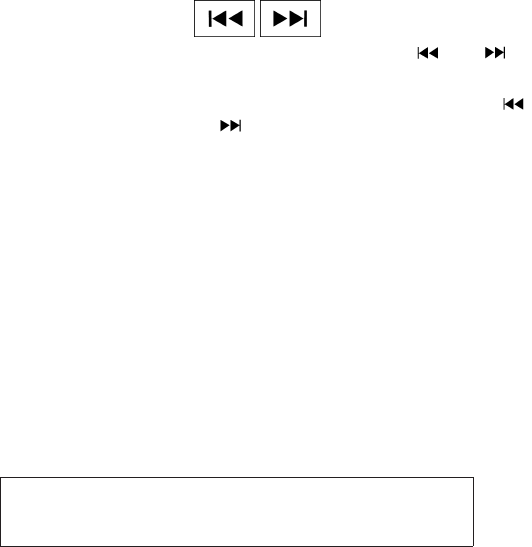
JOBNAME: 1093929-2013-asd-own PAGE: 218 SESS: 4 OUTPUT: Tue Mar 27 10:39:14 2012
●iPodTNano - 4th generation (firmware ver-
sion 1.0PC or later)
●iPodTNano - 5th generation (8GB) (firm-
ware version 1.0.2PC or later)
●iPodTNano - 5th generation (16GB) (firm-
ware version 1.0.1PC or later)
●iPodTNano - 6th generation (8GB) (firm-
ware version 1.2PC or later)
●iPodTNano - 6th generation (8GB) (firm-
ware version 1.1PC or later)
●iPodTTouch - 1st generation (firmware ver-
sion 2.2.1 or later)
●iPodTTouch - 2nd generation (firmware ver-
sion 2.2.1 or later)
●iPodTTouch - 3rd generation (firmware ver-
sion 3.1.3 or later)
●iPodTTouch - 4th generation (firmware ver-
sion 4.3.5 or later)
●iPhoneT3G (firmware version 4.1 or later)
●iPhoneT3GS (firmware version 4.3 or later)
●iPhoneT4 (firmware version 5.0 or later)
●iPhoneT4S (firmware version 5.1 or later)
●iPadT(firmware version 4.3.2 or later)
●iPadT2 (firmware version 4.3.3 or later)
Make sure that your iPodTfirmware is updated to
the version indicated above.
Audio main operation:
Place the ignition switch to the ACC or ON
position. Then, press the CD·AUX or iPodT
MENU button repeatedly to switch to the iPodT
mode.
If the audio system is turned off while the iPodTis
playing, the iPodTplays when the audio system is
turned back on.
If the audio system is off, pressing the CD·AUX or
iPodTMENU button turns the audio system on
and plays the iPodT.
If the audio system is on, the audio system auto-
matically begins playing tracks from the iPodT
when it is plugged into the jack.
iPodTMENU button:
Press the iPodTMENU button while the iPodTis
connected to show the iPodToperation menu on
the audio display. Scroll through the menu list
using the TUNE·SCROLL control dial. Press EN-
TER to select a menu item. Items in the iPodT
menu appear on the display in the following or-
der:
●Now playing
●Playlists
●Artists
●Albums
●Songs
●Podcasts
●Genres
●Composers
●Audiobooks
●Shuffle songs
For more information about each item, see the
iPodTOwner’s Manual.
SEEK/CAT buttons:
Press the SEEK/CAT buttons or to
skip backward or forward one track.
Press and hold the SEEK/CAT buttons
or for 1.5 seconds while a track is playing
to reverse or fast forward the track being played.
The track plays at an increased speed while
reversing or fast forwarding. When the button is
released, the track returns to normal play speed.
4-58 Monitor, climate, audio, phone and voice recognition systems
ZREVIEW COPY—
2013 Altima Sedan (asd)
Owners Manual—USA_English (nna)
03/24/12—dmoore
X
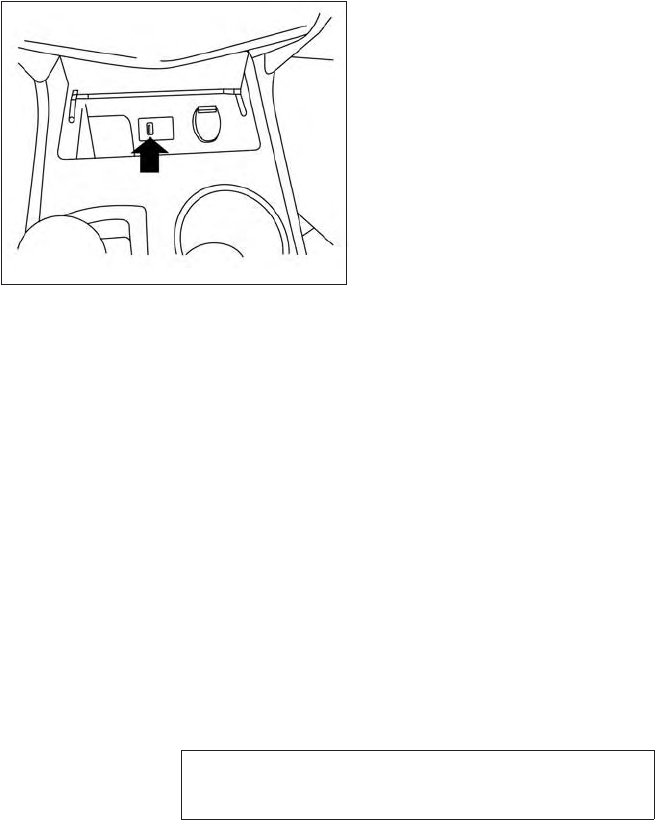
JOBNAME: 1093929-2013-asd-own PAGE: 219 SESS: 4 OUTPUT: Tue Mar 27 10:39:14 2012
REPEAT (RPT):
When the RPT button is pressed while a track is
being played, the play pattern can be changed as
follows:
Repeat Off →1 Track Repeat →All Repeat →
Repeat Off
1 Track Repeat: the current track will be repeated.
All Repeat: all songs in the current list are re-
peated.
Repeat Off: no repeat play pattern is applied.
RANDOM (RDM):
When the RDM button is pressed while a track is
being played, the play pattern can be changed as
follows:
Shuffle Off →Track Shuffle →Album Shuffle →
Shuffle Off
Track Shuffle: the tracks in the current list will be
played randomly.
Album Shuffle: the albums in the current list will
be played randomly.
Shuffle Off: no random play pattern is applied.
BACK button:
When the BACK button is pressed, it returns to
the previous menu.
iPodT* PLAYER OPERATION WITH
NAVIGATION SYSTEM (if so
equipped)
Connecting iPodT
To connect an iPodTto the vehicle so that the
iPodTcan be controlled with the audio system
controls and display screen, use the USB jack
located on the center console below the heater
and air conditioner controls. Connect the iPodT-
specific end of the cable to the iPodTand the
USB end of the cable to the USB jack on the
vehicle. If your iPodTsupports charging via a
USB connection, its battery will be charged while
connected to the vehicle with the ignition switch
in the ACC or ON position.
While connected to the vehicle, the iPodTcan
only be operated by the vehicle audio controls.
To disconnect the iPodTfrom the vehicle, remove
the USB end of the cable from the USB jack on
the vehicle, then remove the cable from the
iPodT.
* iPodTis a trademark of Apple Inc., registered in
the U.S. and other countries.
Compatibility
The following models are compatible:
●iPodT5th Generation (firmware version
1.2.3 or later)
●iPodTClassic (firmware version 1.1.1 or
later)
●iPodTTouch (firmware version 2.0.0 or
later)*
●iPodTNano - 1st generation (firmware ver-
sion 1.3.1 or later)
●iPodTNano - 2nd generation (firmware ver-
sion 1.1.3 or later)
●iPodTNano - 3rd generation (firmware ver-
sion 1.1.3 or later)
LHA2264
Monitor, climate, audio, phone and voice recognition systems 4-59
ZREVIEW COPY—
2013 Altima Sedan (asd)
Owners Manual—USA_English (nna)
03/24/12—dmoore
X
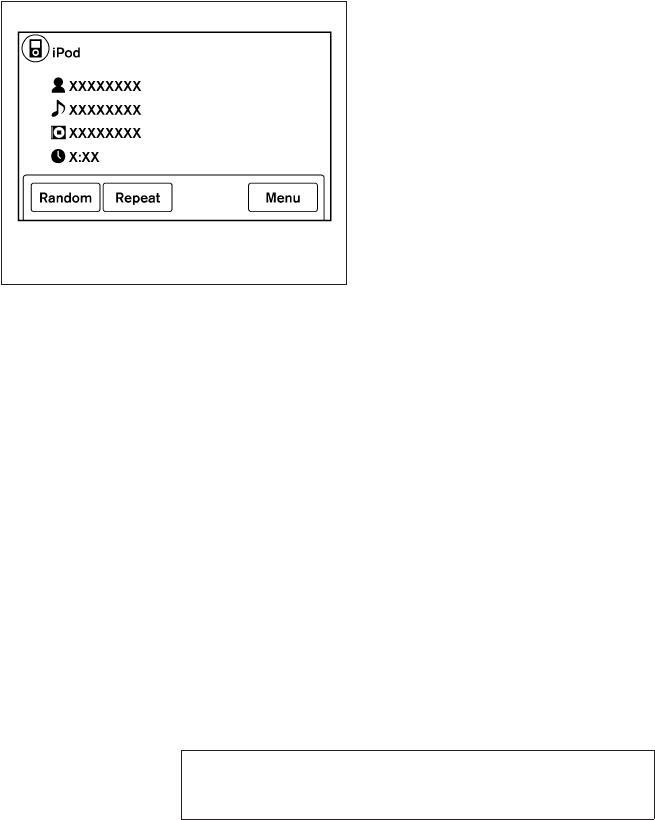
JOBNAME: 1093929-2013-asd-own PAGE: 220 SESS: 4 OUTPUT: Tue Mar 27 10:39:14 2012
●iPodTNano - 4th generation (firmware ver-
sion 1.0.4 or later)
●iPodTNano - 5th generation (firmware ver-
sion 1.0.1 or later)
* Some features of this iPodTmay not be fully
functional.
Make sure that your iPodTfirmware is updated to
the version indicated above.
Audio main operation
Place the ignition switch in the ACC or ON
position. Press the AUX button repeatedly to
switch to the iPodTmode.
If the system has been turned off while the iPodT
was playing, pressing the VOL/ON·OFF control
knob will start the iPodT.
AUX button:
When the AUX button is pressed with the system
off and the iPodTconnected, the system will turn
on. If another audio source is playing and the
iPodTis connected, press the AUX button re-
peatedly until the center display changes to the
iPodTmode.
LHA1494
4-60 Monitor, climate, audio, phone and voice recognition systems
ZREVIEW COPY—
2013 Altima Sedan (asd)
Owners Manual—USA_English (nna)
03/24/12—dmoore
X
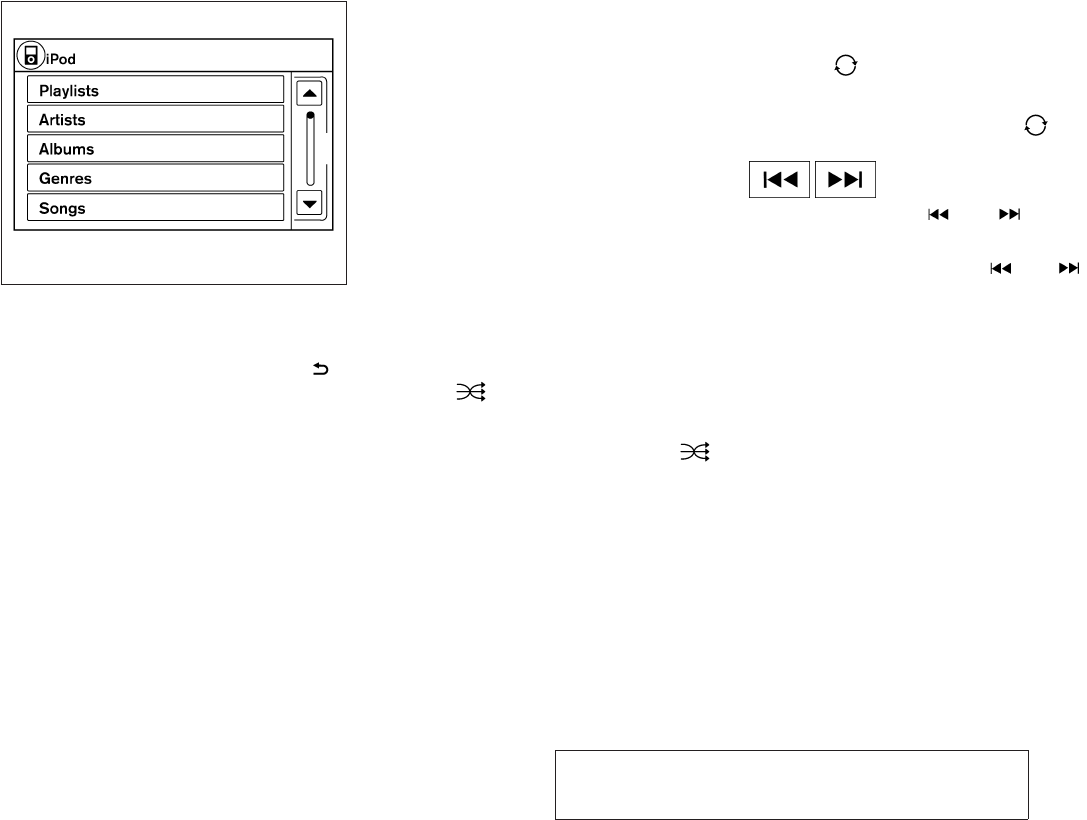
JOBNAME: 1093929-2013-asd-own PAGE: 221 SESS: 4 OUTPUT: Tue Mar 27 10:39:14 2012
Interface:
The interface for iPodToperation shown on the
vehicle’s audio system display screen is similar to
the iPodTinterface. Use the touchscreen,
BACK button or the TUNE/SCROLL knob to
navigate the menus on the screen.
When the iPodTis playing, touch the “Menu” key
to bring up the iPodTinterface.
Depending on the iPodTmodel, the following
items may be available on the menu list screen.
For further information about each item, see the
iPodTOwner’s Manual.
●Playlists
●Artists
●Albums
●Genres
●Songs
●Composers
●Audiobooks
●Podcasts
Random and repeat play mode:
While the iPodTis playing, the play pattern can
be altered so that songs are repeated or played
randomly.
Random:
Touch the “Random” key to apply a random play
pattern to the iPodT. When the random mode is
active, the icon is displayed to the left of
the song title or album name to denote which
random pattern is applied. To cancel Random
mode, touch the “Random” key until no
icon is displayed.
Repeat:
Touch the “Repeat” key to apply a repeat play
pattern to the iPodT. When the repeat mode is
active, the icon is displayed to the left of
the song title or album name to denote which
repeat pattern is applied. To cancel Repeat
mode, touch the “Repeat” key until no icon
is displayed.
Seek buttons:
Press the seek button or to skip
backward or forward one track.
Press and hold the seek button or
for 1.5 seconds while a track is playing to reverse
or fast forward the track being played. The track
plays at an increased speed while reversing or
fast forwarding. When the button is released, the
track returns to normal play speed.
LHA1495
Monitor, climate, audio, phone and voice recognition systems 4-61
ZREVIEW COPY—
2013 Altima Sedan (asd)
Owners Manual—USA_English (nna)
03/24/12—dmoore
X
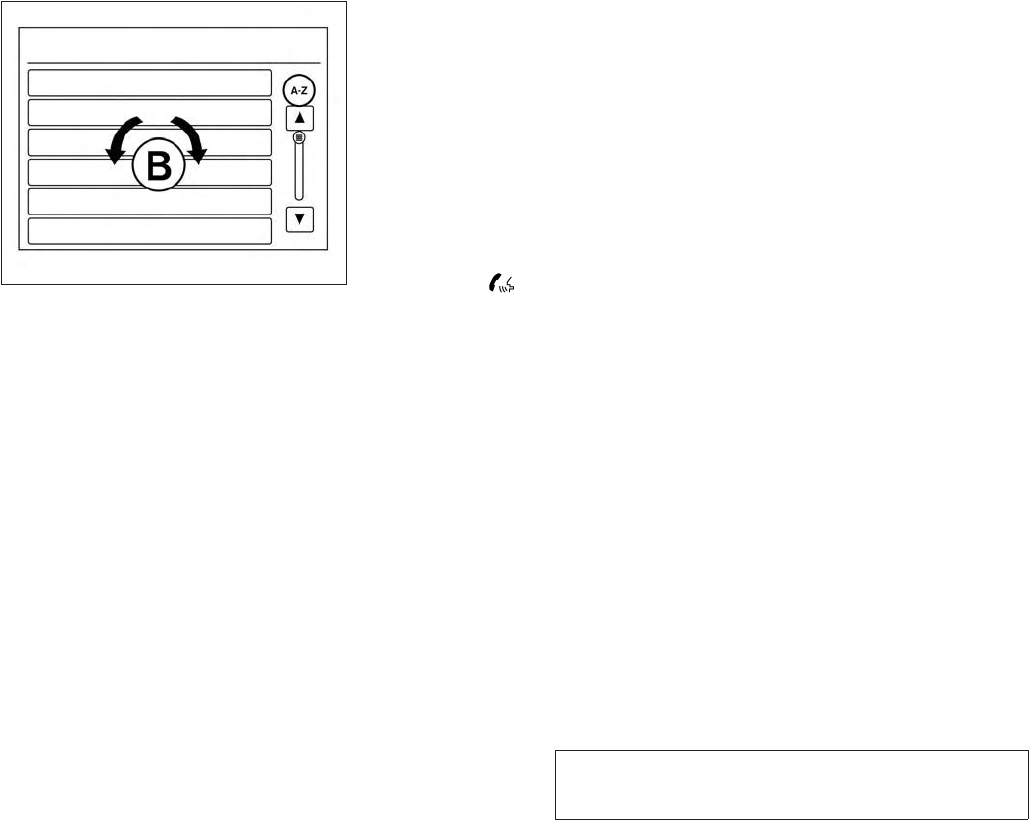
JOBNAME: 1093929-2013-asd-own PAGE: 222 SESS: 4 OUTPUT: Tue Mar 27 10:39:14 2012
Scrolling menus:
While navigating long lists of artists, albums or
songs in the music menu, it is possible to scroll
the list by the first character in the name. To
activate character indexing, touch and hold the
“A-Z” key in the upper right corner of the screen.
Turn the TUNE/SCROLL knob to choose the
number or letter to jump to in the list and then
press the ENTER button.
If no character is selected after two seconds, the
display returns to normal.
BLUETOOTHTSTREAMING AUDIO
WITHOUT NAVIGATION SYSTEM
(Type A) (if so equipped)
If you have a compatible BluetoothTaudio device
that is capable of playing audio files, the device
can be connected to the vehicle’s audio system
so that the audio files on the device play through
the vehicle’s speakers.
Connecting BluetoothTaudio
To connect your BluetoothTaudio device to the
vehicle, follow the procedure below:
1. Press the button. The system an-
nounces the available commands.
2. Say “Connect Phone”. The system acknowl-
edges the command and announces the
next set of available commands.
3. Say “Add Phone”. The system acknowl-
edges the command and asks you to initiate
connecting from the phone handset. The
connecting procedure of the cellular phone
varies according to each cellular phone
model. See the cellular phone Owner’s
Manual for details. You can also visit
www.nissanusa.com/bluetooth for instruc-
tions on connecting NISSAN recommended
cellular phones.
4. When prompted for a Passkey code, enter
“1234” from the handset. The Passkey code
“1234” has been assigned by NISSAN and
cannot be changed.
Audio main operation
To switch to the BluetoothTaudio mode, press
the AUX button repeatedly until the BluetoothT
audio mode is displayed on the screen.
Use the vehicle audio controls or the BluetoothT
device’s controls to play, pause, skip or reverse
tracks.
BLUETOOTHTSTREAMING AUDIO
WITHOUT NAVIGATION SYSTEM
(Type B) (if so equipped)
If you have a compatible BluetoothTaudio device
that is capable of playing audio files, the device
can be connected to the vehicle’s audio system
so that the audio files on the device play through
the vehicle’s speakers.
LHA2279
4-62 Monitor, climate, audio, phone and voice recognition systems
ZREVIEW COPY—
2013 Altima Sedan (asd)
Owners Manual—USA_English (nna)
03/24/12—dmoore
X
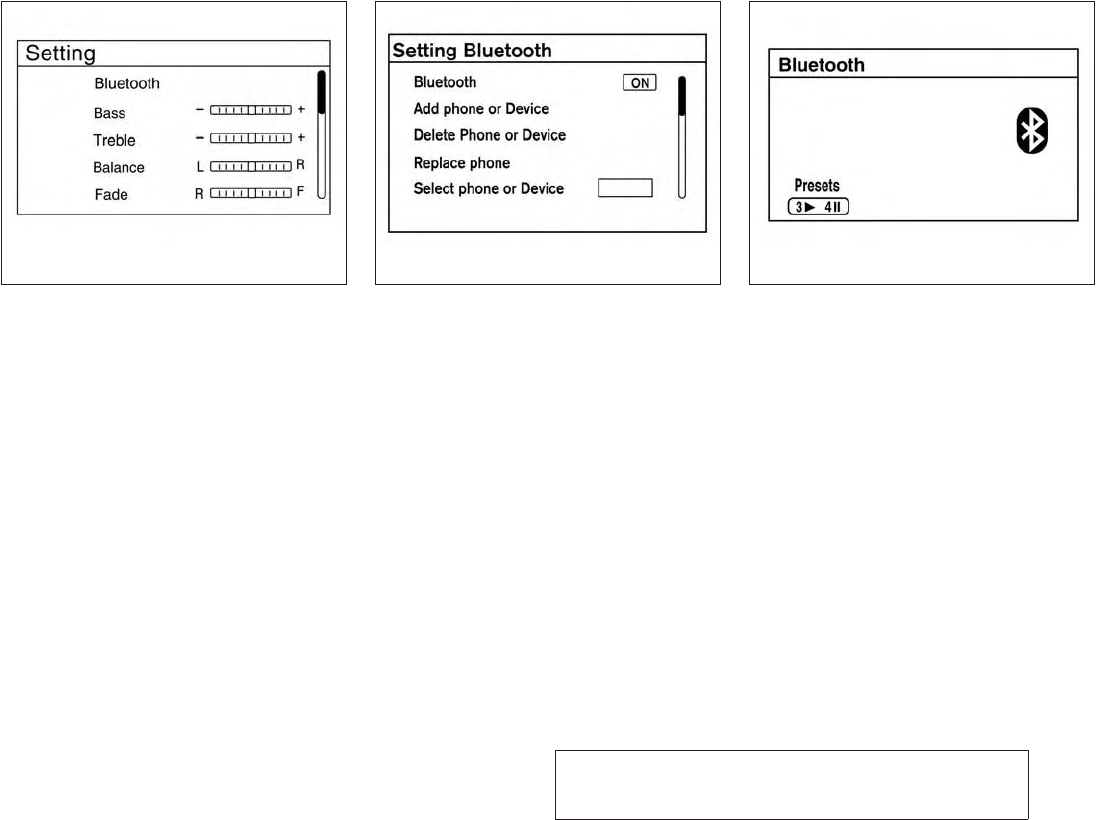
JOBNAME: 1093929-2013-asd-own PAGE: 223 SESS: 4 OUTPUT: Tue Mar 27 10:39:14 2012
Connecting BluetoothTaudio
To connect your BluetoothTaudio device to the
vehicle, follow the procedure below:
1. Press the SETTING button.
2. Select the “Bluetooth” key.
3. Select the “Add Telephone or Device” key.
This same screen can be accessed to re-
move, replace or select a different
BluetoothTdevice.
4. The system acknowledges the command
and asks you to initiate connecting from the
phone handset. The connecting procedure
of the cellular phone varies according to
each cellular phone model. See the cellular
phone Owner’s Manual for details. You can
also visit www.nissanusa.com/bluetooth for
instructions on connecting NISSAN recom-
mended cellular phones.
Audio main operation
To switch to the BluetoothTaudio mode, press
the CD•AUX button repeatedly until the
BluetoothTaudio mode is displayed on the
screen.
The controls for the BluetoothTaudio are dis-
played on the screen. Use the Preset 3 button for
play and the Preset 4 button for pause.
LHA2257 LHA2274 LHA2292
Monitor, climate, audio, phone and voice recognition systems 4-63
ZREVIEW COPY—
2013 Altima Sedan (asd)
Owners Manual—USA_English (nna)
03/24/12—dmoore
X
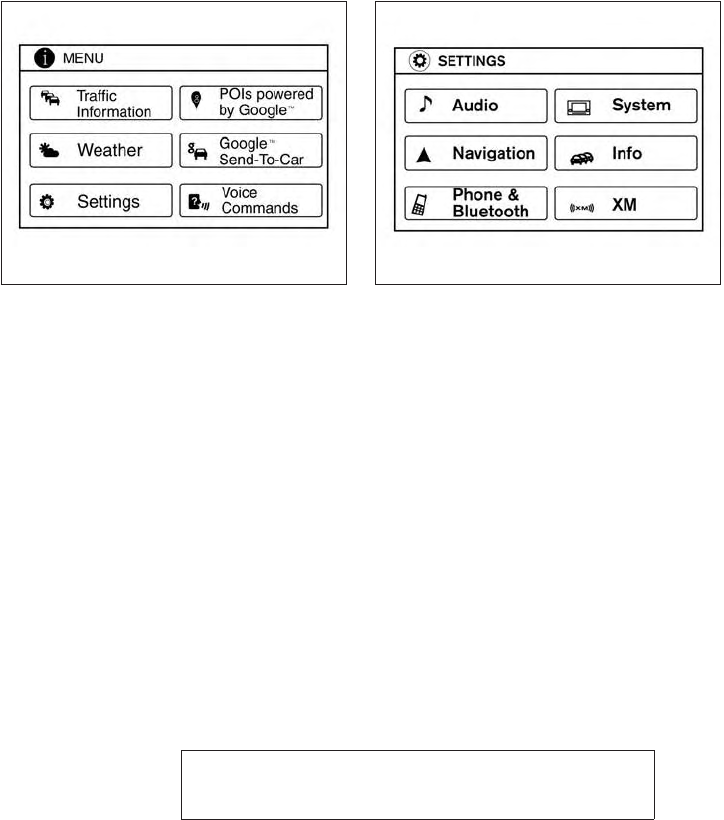
JOBNAME: 1093929-2013-asd-own PAGE: 224 SESS: 4 OUTPUT: Tue Mar 27 10:39:14 2012
BLUETOOTHTSTREAMING AUDIO
WITH NAVIGATION SYSTEM (if so
equipped)
If you have a compatible BluetoothTaudio device
that is capable of playing audio files, the device
can be connected to the vehicle’s audio system
so that the audio files on the device play through
the vehicle’s speakers.
Connecting BluetoothTaudio
To connect your BluetoothTaudio device to the
vehicle, follow the procedure below:
1. Press the MENU button.
2. Select the “Settings” key.
3. Select the “Phone & Bluetooth” key.
LHA2253 LHA2248
4-64 Monitor, climate, audio, phone and voice recognition systems
ZREVIEW COPY—
2013 Altima Sedan (asd)
Owners Manual—USA_English (nna)
03/24/12—dmoore
X
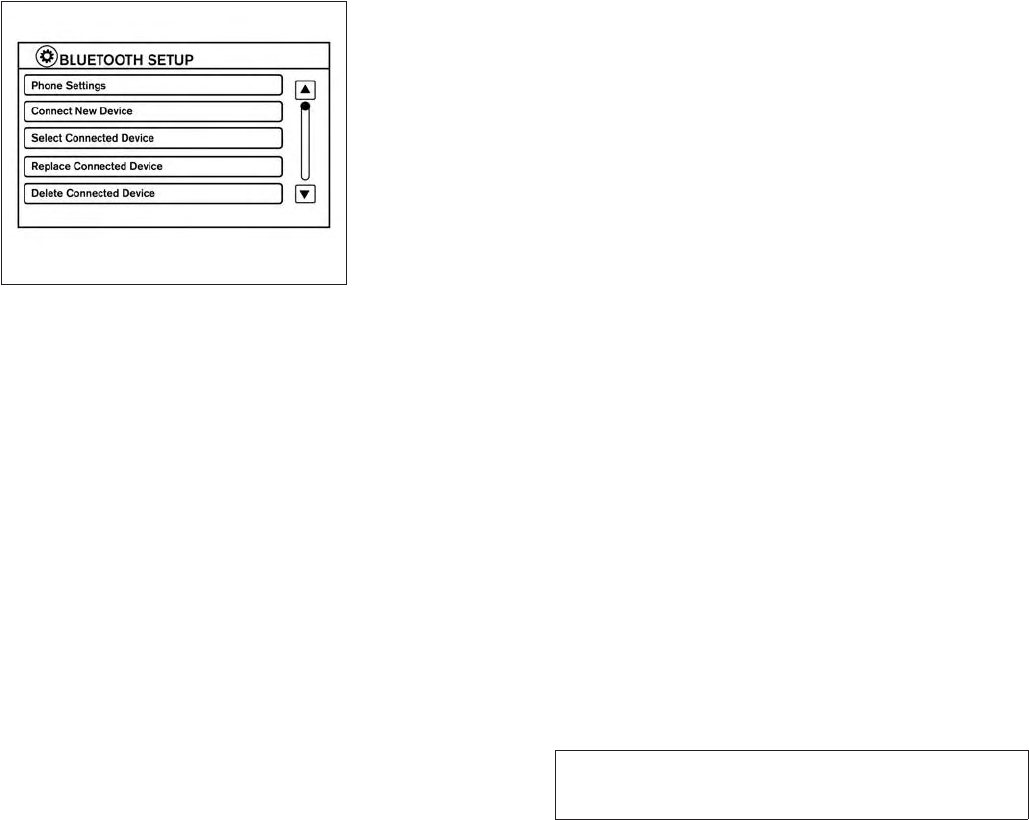
JOBNAME: 1093929-2013-asd-own PAGE: 225 SESS: 4 OUTPUT: Tue Mar 27 10:39:14 2012
4. Select the “Connect New Device” key.
5. The system acknowledges the command
and asks you to initiate connecting from the
phone handset. The connecting procedure
of the cellular phone varies according to
each cellular phone model. See the cellular
phone Owner’s Manual for details. You can
also visit www.nissanusa.com/bluetooth for
instructions on connecting NISSAN recom-
mended cellular phones.
Audio main operation
To switch to the BluetoothTaudio mode, press
the AUX button repeatedly until the BluetoothT
audio mode is displayed on the screen.
The controls for the BluetoothTaudio are dis-
played on the screen.
PANDORATAUDIO (United States
only) (if so equipped)
The vehicle’s audio system is capable of playing
audio streaming through a compatible, USB-
connected audio device using the PandoraTmu-
sic service.
Connecting a device for use with
PandoraTaudio
Devices capable of streaming PandoraTaudio
can be connected to the vehicle’s audio system
via the USB input jack. The USB input jack is
located on the center console beneath the heater
and air conditioner controls. Once connected,
the PandoraTcontrols will be displayed on the
control panel display screen.
Compatibility
The following iPhoneTmodels are compatible
with the system:
●iPhoneT3G
●iPhoneT3GS
●iPhoneT4
●iPhoneT4S
The latest PandoraTapplication should be in-
stalled on the phone.
LHA2265
Monitor, climate, audio, phone and voice recognition systems 4-65
ZREVIEW COPY—
2013 Altima Sedan (asd)
Owners Manual—USA_English (nna)
03/24/12—dmoore
X
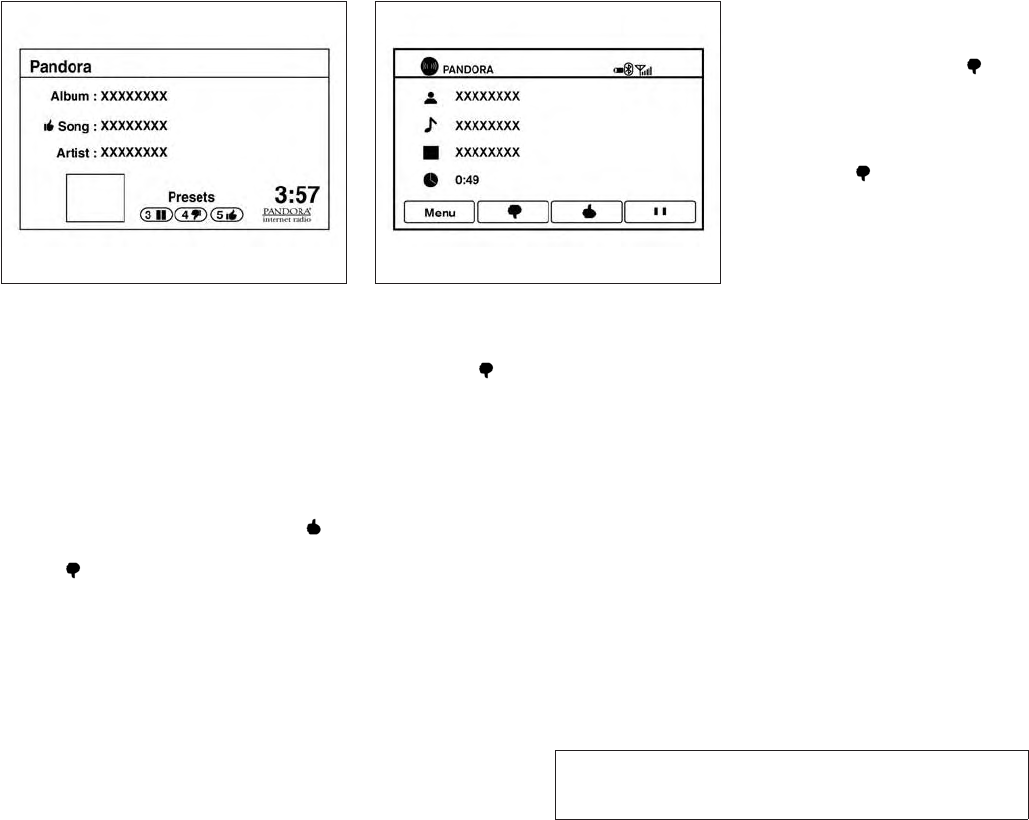
JOBNAME: 1093929-2013-asd-own PAGE: 226 SESS: 4 OUTPUT: Tue Mar 27 10:39:14 2012
Audio main operation
Models without Navigation System:
To switch to the PandoraTaudio mode, press the
CD-AUX button repeatedly until the PandoraT
audio mode is displayed on the screen.
The controls for the PandoraTaudio are dis-
played on the screen. Press the audio preset 3
button to pause or play the music.
Press the audio preset 5 button to select “ ”
(thumbs up). Press the audio preset 4 button to
select “ ” (thumbs down).
NOTE:
There is a limit of six skips per station per
hour. If a “ ” (thumbs down) is given
after the skip limit has been reached, the
current track will continue to play but the
feedback will be saved.
Models with Navigation System:
To switch to the PandoraTaudio mode, press the
AUX button repeatedly until the PandoraTaudio
mode is displayed on the screen.
The controls for the PandoraTaudio are dis-
played on the screen. Touch the keys on the
screen to play or pause the audio. Touch the key
to select “thumbs up” or the key to select
“thumbs down”.
NOTE:
There is a limit of six skips per station per
hour. If a “ ” (thumbs down) is given
after the skip limit has been reached, the
current track will continue to play but the
feedback will be saved.
Models without Navigation System
LHA2283
Models with Navigation System:
LHA2269
4-66 Monitor, climate, audio, phone and voice recognition systems
ZREVIEW COPY—
2013 Altima Sedan (asd)
Owners Manual—USA_English (nna)
03/24/12—dmoore
X
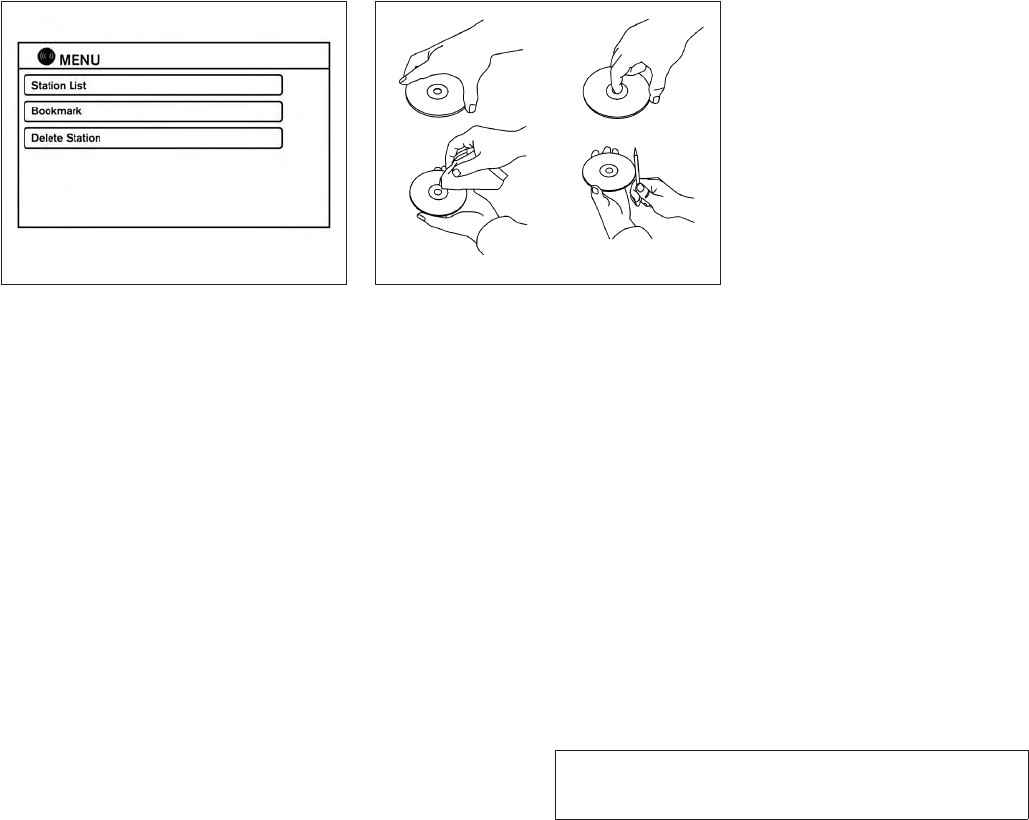
JOBNAME: 1093929-2013-asd-own PAGE: 227 SESS: 4 OUTPUT: Tue Mar 27 10:39:14 2012
PandoraTaudio settings (models with
Navigation System only)
To adjust the PandoraTaudio settings, select the
“Menu” key.
●Station List
Select to display a list of available PandoraT
stations.
●Bookmark
Select to bookmark the current station.
●Delete Station
Select to remove the current station.
CD CARE AND CLEANING
●Handle a CD by its edges. Do not bend the
disc. Never touch the surface of the disc.
●Always place the discs in the storage case
when they are not being used.
●To clean a disc, wipe the surface from the
center to the outer edge using a clean, soft
cloth. Do not wipe the disc using a circular
motion.
●Do not use a conventional record cleaner or
alcohol intended for industrial use.
●A new disc may be rough on the inner and
outer edges. Remove the rough edges by
rubbing the inner and outer edges with the
side of a pen or pencil as illustrated.
LHA2270 LHA0049
Monitor, climate, audio, phone and voice recognition systems 4-67
ZREVIEW COPY—
2013 Altima Sedan (asd)
Owners Manual—USA_English (nna)
03/24/12—dmoore
X
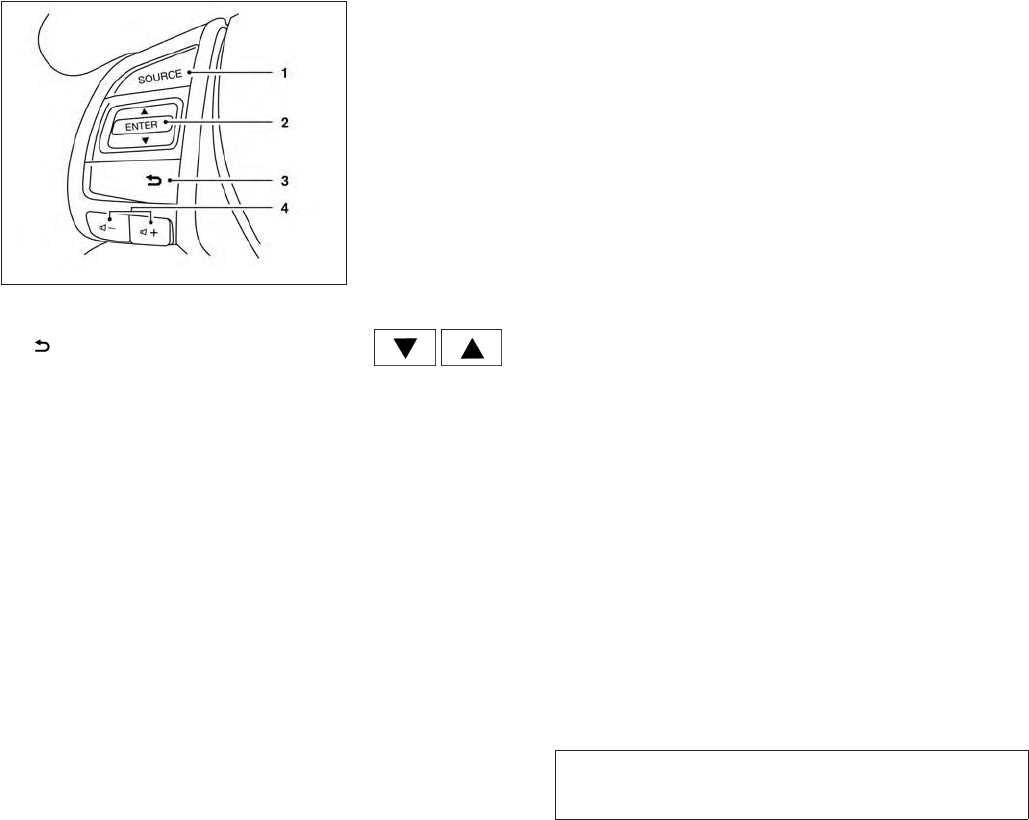
JOBNAME: 1093929-2013-asd-own PAGE: 228 SESS: 4 OUTPUT: Tue Mar 27 10:39:14 2012
1. Source select and power on switch
2. Menu control switch/ENTER button
3. (Back) switch
4. Volume control switch
STEERING WHEEL SWITCH FOR
AUDIO CONTROL (if so equipped)
POWER on switch
With the ignition switch in the ACC or ON posi-
tion, push the SOURCE switch to turn the audio
system on.
SOURCE select switch
Push the source select switch to change the
mode in the following sequence:
AM →FM1 →FM2 →XM1 (satellite radio, if so
equipped) →XM2 (satellite radio, if so equipped)
→XM3 (satellite radio, if so equipped) →CD* →
USB/iPodT* (if so equipped) →BluetoothTAu-
dio* →AUX* →AM.
* These modes are only available when compat-
ible media storage is inserted into the device or
connected to the system.
Volume control switch
Push the volume control switch to increase or
decrease the volume.
Menu control
switch/ENTER button
While the display is showing a map or audio
screen, tilt the Menu Control switch upward or
downward to select a station, track, CD or folder.
For most audio sources, tilting the switch
up/down for more than 1.5 seconds provides a
different function than a tilting up/down for less
than 1.5 seconds.
AM and FM:
●Tilt up/down for less than 1.5 seconds to
increase or decrease the preset station.
●Tilt up/down for more than 1.5 seconds to
seek up or down to the next station.
●Press the ENTER button to show the list of
preset stations.
XM (if so equipped):
●Tilt up/down for less than 1.5 seconds to
increase or decrease the preset station.
●Tilt up/down for more than 1.5 seconds to
go to the next or previous category.
●Press the ENTER button to show the XM
Menu.
iPodT(if so equipped):
●Tilt up/down for less than 1.5 seconds to
increase or decrease the track number.
●Press the ENTER button to show the iPod
Menu.
CD:
●Tilt up/down for less than 1.5 seconds to
increase or decrease the track number.
LHA2266
4-68 Monitor, climate, audio, phone and voice recognition systems
ZREVIEW COPY—
2013 Altima Sedan (asd)
Owners Manual—USA_English (nna)
03/24/12—dmoore
X

JOBNAME: 1093929-2013-asd-own PAGE: 229 SESS: 4 OUTPUT: Tue Mar 27 10:39:14 2012
●Tilt up/down for more than 1.5 seconds to
increase or decrease the folder number (if
playing compressed audio files).
●Press the ENTER button to show the CD
Menu.
USB (if so equipped):
●Tilt up/down for less than 1.5 seconds to
increase or decrease the track number.
●Tilt up/down for more than 1.5 seconds to
increase or decrease the folder number.
●Press the ENTER button to show the USB
Menu.
BluetoothTAudio (if so equipped):
●Tilt up/down for less than 1.5 seconds to
skip ahead or back to the next song.
●Tilt up/down for more than 1.5 seconds to
reverse or fast forward the current song.
PandoraTAudio (if so equipped):
●Tilt up for less than 1.5 seconds to input
“thumbs up” for the current song.
●Tilt down for less than 1.5 seconds to input
“thumbs down” for the current song.
●Tilt up for more than 1.5 seconds to skip to
the next song (if the maximum of six skips per
station per hour has not been exceeded).
AUX:
●Press the ENTER button to show the AUX
Menu.
ANTENNA
Window antenna
The antenna pattern is printed inside the rear
window.
CAUTION
●Do not place metalized film near the
rear window glass or attach any metal
parts to it. This may cause poor recep-
tion or noise.
●When cleaning the inside of the rear
window, be careful not to scratch or
damage the rear window antenna.
Lightly wipe along the antenna with a
dampened soft cloth.
When installing a CB, ham radio or car phone in
your vehicle, be sure to observe the following
precautions; otherwise, the new equipment may
adversely affect the engine control system and
other electronic parts.
WARNING
●A cellular phone should not be used for
any purpose while driving so full atten-
tion may be given to vehicle operation.
Some jurisdictions prohibit the use of
cellular phones while driving.
●If you must make a call while your ve-
hicle is in motion, the hands free cellu-
lar phone operational mode is highly
recommended. Exercise extreme cau-
tion at all times so full attention may be
given to vehicle operation.
●If you are unable to devote full attention
to vehicle operation while talking on
the phone, pull off the road to a safe
location and stop your vehicle.
CAR PHONE OR CB RADIO
Monitor, climate, audio, phone and voice recognition systems 4-69
ZREVIEW COPY—
2013 Altima Sedan (asd)
Owners Manual—USA_English (nna)
03/24/12—dmoore
X
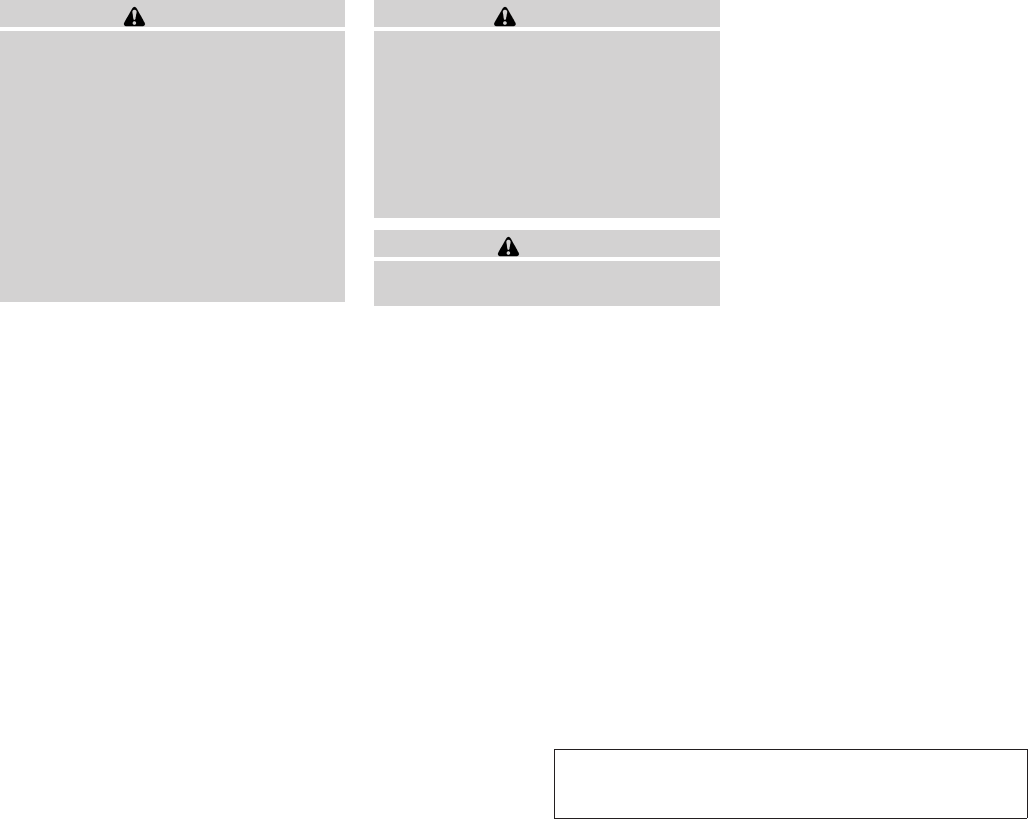
JOBNAME: 1093929-2013-asd-own PAGE: 230 SESS: 4 OUTPUT: Tue Mar 27 10:39:14 2012
CAUTION
●Keep the antenna as far away as pos-
sible from the electronic control
modules.
●Keep the antenna wire more than 8 in
(20 cm) away from the electronic con-
trol system harnesses. Do not route the
antenna wire next to any harness.
●Adjust the antenna standing-wave ratio
as recommended by the manufacturer.
●Connect the ground wire from the CB
radio chassis to the body.
●For details, consult a NISSAN dealer.
WARNING
●Use a phone after stopping your vehicle
in a safe location. If you have to use a
phone while driving, exercise extreme
caution at all times so full attention may
be given to vehicle operation.
●If you are unable to devote full attention
to vehicle operation while talking on
the phone, pull off the road to a safe
location and stop your vehicle.
CAUTION
To avoid discharging the vehicle battery,
use a phone after starting the engine.
BLUETOOTHTHANDS-FREE PHONE
SYSTEM WITHOUT NAVIGATION
SYSTEM (Type A) (if so equipped)
4-70 Monitor, climate, audio, phone and voice recognition systems
ZREVIEW COPY—
2013 Altima Sedan (asd)
Owners Manual—USA_English (nna)
03/24/12—dmoore
X
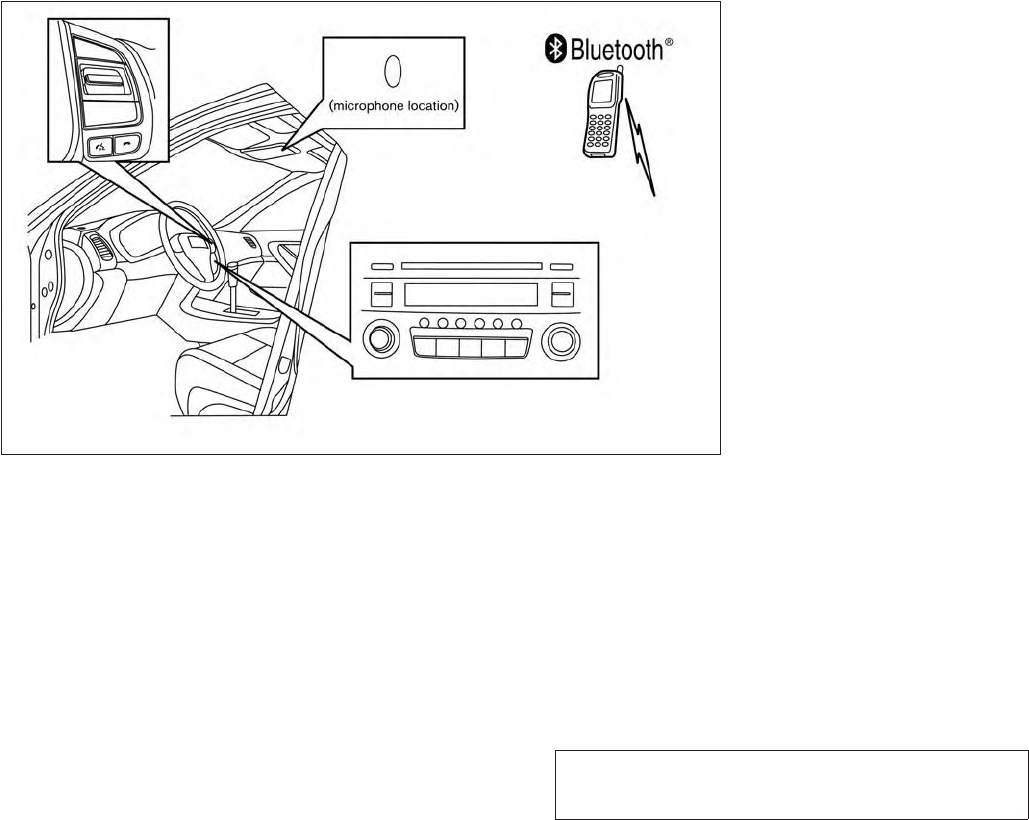
JOBNAME: 1093929-2013-asd-own PAGE: 231 SESS: 4 OUTPUT: Tue Mar 27 10:39:14 2012
Your NISSAN is equipped with the BluetoothT
Hands-Free Phone System. If you have a com-
patible BluetoothTenabled cellular phone, you
can set up the wireless connection between your
cellular phone and the in-vehicle phone module.
With BluetoothTwireless technology, you can
make or receive a hands-free telephone call with
your cellular phone in the vehicle.
Once your cellular phone is connected to the
in-vehicle phone module, no other phone con-
necting procedure is required. Your phone is
automatically connected with the in-vehicle
phone module when the ignition switch is placed
in the ON position with the previously connected
cellular phone turned on and carried in the ve-
hicle.
NOTE:
Some devices require the user to accept
connections to other BluetoothTdevices. If
your phone does not connect automatically
to the system, consult the phone’s Owner’s
Manual for details on device operation.
You can connect up to 5 different BluetoothT
cellular phones to the in-vehicle phone module.
However, you can talk on only one cellular phone
at a time.
Before using the BluetoothTHands-Free Phone
System, refer to the following notes.
●Set up the wireless connection between a
compatible cellular phone and the in-vehicle
phone module before using the hands-free
phone system.
●Some BluetoothTenabled cellular phones
may not be recognized or work properly.
Please visit www.nissanusa.com/bluetooth
for a recommended phone list and connect-
ing instructions.
LHA2289
Monitor, climate, audio, phone and voice recognition systems 4-71
ZREVIEW COPY—
2013 Altima Sedan (asd)
Owners Manual—USA_English (nna)
03/24/12—dmoore
X

JOBNAME: 1093929-2013-asd-own PAGE: 232 SESS: 4 OUTPUT: Tue Mar 27 10:39:14 2012
●You will not be able to use a hands-free
phone under the following conditions:
– Your vehicle is outside of the cellular ser-
vice area.
– Your vehicle is in an area where it is
difficult to receive a cellular signal; such
as in a tunnel, in an underground parking
garage, near a tall building or in a moun-
tainous area.
– Your cellular phone is locked to prevent it
from being dialed.
●When the radio wave condition is not ideal
or ambient sound is too loud, it may be
difficult to hear the other person’s voice dur-
ing a call.
●Do not place the cellular phone in an area
surrounded by metal or far away from the
in-vehicle phone module to prevent tone
quality degradation and wireless connection
disruption.
●While a cellular phone is connected through
the BluetoothTwireless connection, the bat-
tery power of the cellular phone may dis-
charge quicker than usual. The BluetoothT
Hands-Free Phone System cannot charge
cellular phones.
●If the hands-free phone system seems to be
malfunctioning, see “Troubleshooting guide”
in this section. You can also visit
www.nissanusa.com/bluetooth for trouble-
shooting help.
●Some cellular phones or other devices may
cause interference or a buzzing noise to
come from the audio system speakers. Stor-
ing the device in a different location may
reduce or eliminate the noise.
●Refer to the cellular phone Owner’s Manual
regarding the telephone charges, cellular
phone antenna and body, etc.
REGULATORY INFORMATION
FCC Regulatory information
– CAUTION: To maintain compliance with
FCC’s RF exposure guidelines, use only the
supplied antenna. Unauthorized antenna,
modification, or attachments could damage
the transmitter and may violate FCC regula-
tions.
– Operation is subject to the following two con-
ditions:
1. This device may not cause interference and
2. this device must accept any interference,
including interference that may cause unde-
sired operation of the device.
IC Regulatory information
– Operation is subject to the following two con-
ditions: (1) this device may not cause interfer-
ence, and (2) this device must accept any
interference, including interference that may
cause undesired operation of the device.
– This Class B digital apparatus meets all re-
quirements of the Canadian Interference-
Causing Equipment Regulations.
BLUETOOTHtis a
trademark owned by
Bluetooth SIG, Inc.
and licensed to Vis-
teon.
USING THE SYSTEM
The NISSAN Voice Recognition system allows
hands-free operation of the BluetoothTPhone
System.
If the vehicle is in motion, some commands may
not be available so full attention may be given to
vehicle operation.
4-72 Monitor, climate, audio, phone and voice recognition systems
ZREVIEW COPY—
2013 Altima Sedan (asd)
Owners Manual—USA_English (nna)
03/24/12—dmoore
X

JOBNAME: 1093929-2013-asd-own PAGE: 233 SESS: 4 OUTPUT: Tue Mar 27 10:39:14 2012
Initialization
When the ignition switch is placed in the ON
position, NISSAN Voice Recognition is initialized,
which takes a few seconds. If the button is
pressed before the initialization completes, the
system will announce “Hands-free phone system
not ready” and will not react to voice commands.
Operating tips
To get the best performance out of the NISSAN
Voice Recognition system, observe the following:
●Keep the interior of the vehicle as quiet as
possible. Close the windows to eliminate
surrounding noises (traffic noises, vibration
sounds, etc.), which may prevent the system
from recognizing voice commands correctly.
●Wait until the tone sounds before speaking a
command. Otherwise, the command will not
be received properly.
●Start speaking a command within 5 seconds
after the tone sounds.
●Speak in a natural voice without pausing
between words.
Giving voice commands
To operate NISSAN Voice Recognition, press
and release the button located on the
steering wheel. After the tone sounds, speak a
command.
The command given is picked up by the micro-
phone, and voice feedback is given when the
command is accepted.
●If you need to hear the available commands
for the current menu again, say “Help” and
the system will repeat them.
●If a command is not recognized, the system
announces, “Command not recognized.
Please try again.”Make sure the command is
said exactly as prompted by the system and
repeat the command in a clear voice.
●If you want to go back to the previous com-
mand, you can say “Go back” or “Correc-
tion” any time the system is waiting for a
response.
●You can cancel a command when the sys-
tem is waiting for a response by saying,
“Cancel” or “Quit.” The system announces
“Cancel” and ends the VR session. You can
also press and hold the button on the
steering wheel for 5 seconds at any time to
end the VR session. Whenever the VR ses-
sion is cancelled, a double beep is played to
indicate you have exited the system.
●If you want to adjust the volume of the voice
feedback, press the volume control switches
(+ or -) on the steering wheel while being
provided with feedback. You can also use
the radio volume control knob.
●In most cases you can interrupt the voice
feedback to speak the next command by
pressing the button on the steering
wheel.
●To use the system faster, you may speak the
second level commands with the main menu
command on the main menu. For example,
press the button and after the tone
say, “Call Redial.”
Monitor, climate, audio, phone and voice recognition systems 4-73
ZREVIEW COPY—
2013 Altima Sedan (asd)
Owners Manual—USA_English (nna)
03/24/12—dmoore
X

JOBNAME: 1093929-2013-asd-own PAGE: 234 SESS: 4 OUTPUT: Tue Mar 27 10:39:14 2012
How to say numbers
NISSAN Voice Recognition requires a certain
way to speak numbers in voice commands. Refer
to the following rules and examples.
●Either “zero” or “oh” can be used for “0”.
Example: 1-800-662-6200
– “One eight oh oh six six two six two oh
oh”, or
– “One eight zero zero six six two six two oh
oh”
●Words can be used for the first 4 digits
places only.
Example: 1-800-662-6200
– “One eight hundred six six two six two oh
oh”,
– NOT “One eight hundred six six two sixty
two hundred,” and
– NOT “One eight oh oh six six two sixty two
hundred”
●Numbers can be spoken in small groups.
The system will prompt you to continue en-
tering digits, if desired.
Example: 1-800-662-6200
– “One eight zero zero”
The system repeats the numbers and
prompts you to enter more.
– “six six two”
The system repeats the numbers and
prompts you to enter more.
– “six two zero zero”
●Say “pound” for “#”. Say “star” for “*” (avail-
able when using the “Special Number” com-
mand and the “Send” command during a
call).
See “List of voice commands” and “Special
number” in this section for more information.
Example: 1-555-1212 *123
– “One five five five one two one two star
one two three”
●Say “plus” for “+” (available only when using
the “Special Number” command).
●Say “pause” for a 2-second pause (available
only when storing a phone book number).
NOTE:
For best results, say phone numbers as
single digits.
The voice command “Help” is available at any
time. Please use the “Help” command to get
information on how to use the system.
4-74 Monitor, climate, audio, phone and voice recognition systems
ZREVIEW COPY—
2013 Altima Sedan (asd)
Owners Manual—USA_English (nna)
03/24/12—dmoore
X
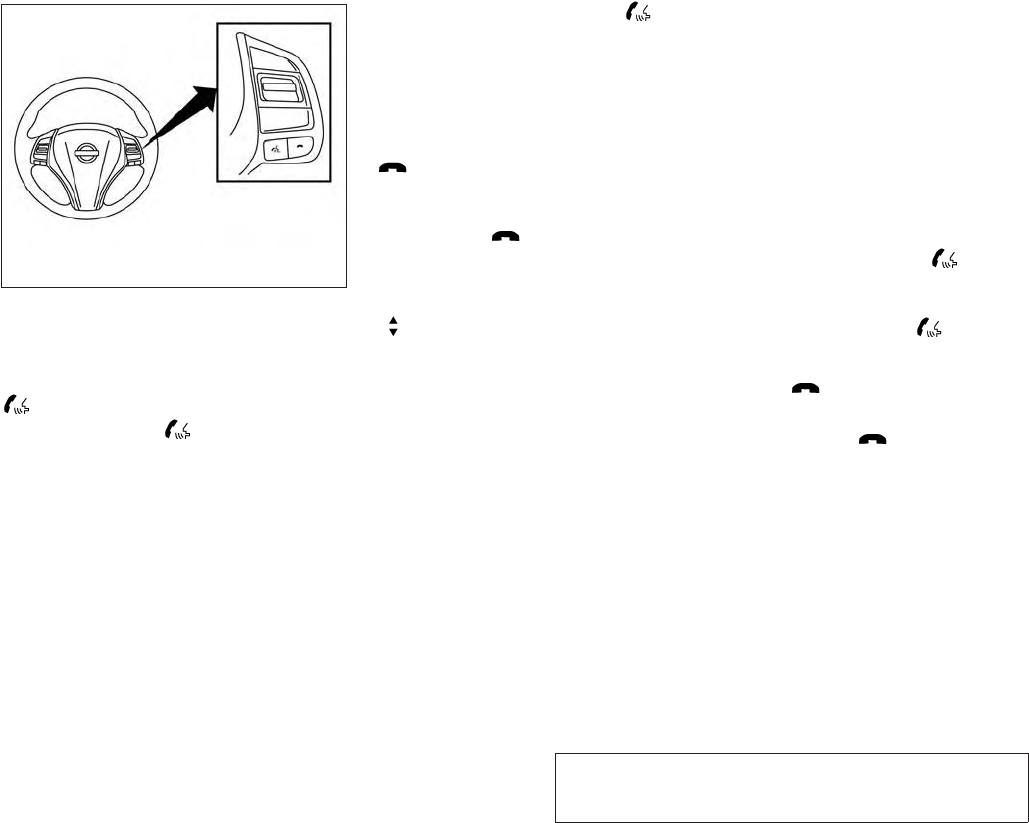
JOBNAME: 1093929-2013-asd-own PAGE: 235 SESS: 4 OUTPUT: Tue Mar 27 10:39:14 2012
CONTROL BUTTONS
The control buttons for the BluetoothTHands-
Free Phone System are located on the steering
wheel.
PHONE/SEND
Press the button to initiate
a VR session or answer an incom-
ing call.
You can also use the button
to interrupt the system feedback
and give a command at once. See
“List of voice commands” and
“During a call” in this section for
more information.
PHONE/END
While the Voice Recognition sys-
tem is active, press and hold
the button for 5 seconds to
quit the Voice Recognition system
at any time.
ENTER button / tuning switch
While using the Voice Recogni-
tion system, tilt the tuning switch
up or down to manually control
the phone system. Press the EN-
TER button to select an option on
the display screen.
GETTING STARTED
The following procedures will help you get
started using the BluetoothTHands-Free Phone
System with NISSAN Voice Recognition. For ad-
ditional command options, refer to “List of voice
commands” in this section.
Choosing a language
You can interact with the BluetoothTHands-Free
Phone System using English, Spanish or French.
To change the language, perform the following.
1. Press and hold the button for more
than 5 seconds.
2. The system announces: “Press the
PHONE/SEND ( ) button for the
hands-free phone system to enter the voice
adaptation mode or press the PHONE/END
() button to select a different lan-
guage.”
3. Press the button.
For information on voice adaptation, see
“Voice Adaptation (VA) mode” in this sec-
tion.
LHA2273
Monitor, climate, audio, phone and voice recognition systems 4-75
ZREVIEW COPY—
2013 Altima Sedan (asd)
Owners Manual—USA_English (nna)
03/24/12—dmoore
X

JOBNAME: 1093929-2013-asd-own PAGE: 236 SESS: 4 OUTPUT: Tue Mar 27 10:39:14 2012
4. The system announces the current language
and gives you the option to change the lan-
guage to Spanish (in Spanish) or French (in
French). To select the current language,
press the PHONE/SEND ( ) button. To
select a different language, tilt the tuning
switch ( or ) up or down.
NOTE:
You must press the button within 5
seconds to change the language.
5. If you decide not to change the language, do
not press either button. After 5 seconds, the
VR session will end, and the language will
not be changed.
Connecting procedure
NOTE:
The connecting procedure must be per-
formed when the vehicle is stationary. If the
vehicle starts moving during the procedure,
the procedure will be cancelled.
Main Menu
“Connect phone” s
A
“Add phone” s
B
Initiate from handset s
C
Name phone s
D
1. Press the button on the steering
wheel. The system announces the available
commands.
2. Say: “Connect phone” s
A. The system ac-
knowledges the command and announces
the next set of available commands.
3. Say: “Add phone” s
B. The system acknowl-
edges the command and asks you to initiate
connecting from the phone handset s
C.
The connecting procedure of the cellular
phone varies according to each cellular
phone model. See the cellular phone Own-
er’s Manual for details. You can also visit
www.nissanusa.com/bluetooth for instruc-
tions on connecting NISSAN recommended
cellular phones.
When prompted for a Passkey code, enter
“1234” from the handset. The Passkey code
“1234” has been assigned by NISSAN and
cannot be changed.
4. The system asks you to say a name for the
phone s
D.
If the name is too long or too short, the
system tells you, then prompts you for a
name again.
Also, if more than one phone is connected
and the name sounds too much like a name
already used, the system tells you, then
prompts you for a name again.
Making a call by entering a phone
number
Main Menu
“Call” s
A
“Phone Number” s
B
Speak the digits s
C
“Dial” s
D
1. Press the button on the steering
wheel. A tone will sound.
2. Say: “Call” s
A. The system acknowledges
the command and announces the next set of
available commands.
3. Say “Phone Number” s
B. The system ac-
knowledges the command and announces
the next set of available commands.
4-76 Monitor, climate, audio, phone and voice recognition systems
ZREVIEW COPY—
2013 Altima Sedan (asd)
Owners Manual—USA_English (nna)
03/24/12—dmoore
X

JOBNAME: 1093929-2013-asd-own PAGE: 237 SESS: 4 OUTPUT: Tue Mar 27 10:39:14 2012
Say: “Special Number” to dial more than 10
digits or any special characters.
4. Say the number you wish to call starting with
the area code in single digit format s
C. If the
system has trouble recognizing the correct
phone number, try entering the number in
the following groups: 3-digit area code,
3-digit prefix and the last 4-digits. For ex-
ample, 555-121-3354 can be said as “five
five five” as the 1st group, then “one two
one” as the 2nd group, and “three three five
four” as the 3rd group. For dialing more than
10 digits or any special characters, say
“Special Number”. See “How to say num-
bers” in this section for more information.
5. When you have finished speaking the phone
number, the system repeats it back and an-
nounces the available commands.
6. Say: “Dial” s
D. The system acknowledges
the command and makes the call.
For additional command options, see “List of
voice commands” in this section.
Receiving a call
When you hear the ring tone, press the
button on the steering wheel.
Once the call has ended, press the button
on the steering wheel.
NOTE:
If you do not wish to take the call when you
hear the ring tone, press the button
on the steering wheel.
For additional command options, see “List of
voice commands” later in this section.
LIST OF VOICE COMMANDS
Main Menu
“Call”
“Phonebook”
“Recent Calls”
“Connect Phone”
When you press and release the button on
the steering wheel, you can choose from the
commands on the Main Menu. The following
pages describe these commands and the com-
mands in each sub-menu.
Remember to wait for the tone before
speaking.
After the main menu, you can say “Help” to hear
the list of commands currently available any time
the system is waiting for a response.
If you want to end an action without completing it,
you can say “Cancel” or “Quit” at any time the
system is waiting for a response. The system will
end the VR session. Whenever the VR session is
cancelled, a double beep is played to indicate
you have exited the system.
If you want to go back to the previous command,
you can say “Go back” or “Correction” any time
the system is waiting for a response.
“Call”
Main Menu
“Call”
(Speak name) s
A
“Phone Number”
(Speak Digits) s
B
“Special Number” s
C
“Redial” s
D
“Call Back” s
E
(Speak name) s
A
If you have stored entries in the phonebook, you
can dial a number associated with a name and
location.
See “Phonebook” in this section to learn how to
store entries.
When prompted by the system, say the name of
the phone book entry you wish to call. The system
acknowledges the name.
Monitor, climate, audio, phone and voice recognition systems 4-77
ZREVIEW COPY—
2013 Altima Sedan (asd)
Owners Manual—USA_English (nna)
03/24/12—dmoore
X

JOBNAME: 1093929-2013-asd-own PAGE: 238 SESS: 4 OUTPUT: Tue Mar 27 10:39:14 2012
If there are multiple locations associated with the
name, the system asks you to choose the loca-
tion.
Once you have confirmed the name and location,
the system begins the call.
(Speak Digits) s
B
When prompted by the system, say the number
you wish to call. Refer to “How to say numbers”
and “Making a call by entering a phone number”
in this section for more details.
“Special Number” s
C
For dialing more than 10 digits or any special
characters, say “Special Number”. When the
system acknowledges the command, the system
will prompt you to speak the number.
“Redial” s
D
Use the Redial command to call the last number
that was dialed.
The system acknowledges the command, re-
peats the number and begins dialing.
If a redial number does not exist, the system
announces, “There is no number to redial” and
ends the VR session.
“Call Back” s
E
Use the Call Back command to dial the number of
the last incoming call within the vehicle.
The system acknowledges the command, re-
peats the number and begins dialing.
If a call back number does not exist, the system
announces, “There is no number to call back”and
ends the VR session.
During a call
During a call there are several command options
available. Press the button on the steering
wheel to mute the receiving voice and enter com-
mands.
●“Help” — The system announces the avail-
able commands.
●“Go back/Correction” — The system an-
nounces “Go back,” ends the VR session
and returns to the call.
●“Cancel/Quit” — The system announces
“Cancel,” ends the VR session and returns
to the call.
●“Send/Enter/Call/Dial” — Use the Send
command to enter numbers, “*”or “#” during
a call. For example, if you were directed to
dial an extension by an automated system:
Say: “Send one two three four.”
The system acknowledges the command
and sends the tones associated with the
numbers. The system then ends the VR ses-
sion and returns to the call. Say “star” for “*”,
Say “pound” for “#”.
●“Transfer call” — Use the Transfer Call com-
mand to transfer the call from the BluetoothT
Hands-Free Phone System to the cellular
phone when privacy is desired.
The system announces, “Transfer call. Call
transferred to privacy mode.” The system
then ends the VR session.
To reconnect the call from the cellular phone
to the BluetoothTHands-Free System,
press the button.
●“Mute” — Use the Mute command to mute
your voice so the other party cannot hear it.
Use the mute command again to unmute
your voice.
NOTE:
If a call is ended or the cellular phone
network connection is lost while the Mute
feature is on, the Mute feature will be reset
to “off” for the next call so the other party
can hear your voice.
4-78 Monitor, climate, audio, phone and voice recognition systems
ZREVIEW COPY—
2013 Altima Sedan (asd)
Owners Manual—USA_English (nna)
03/24/12—dmoore
X

JOBNAME: 1093929-2013-asd-own PAGE: 239 SESS: 4 OUTPUT: Tue Mar 27 10:39:14 2012
“Phonebook” (phones without
automatic phonebook download
function)
NOTE:
The “Transfer Entry” command is not avail-
able when the vehicle is moving.
Main Menu
“Phonebook”
“Transfer Entry” s
A
“Delete Entry” s
B
“List Names” s
C
For phones that do not support automatic down-
load of the phonebook (PBAP BluetoothTpro-
file), the “Phonebook”command is used to manu-
ally add entries to the vehicle phonebook.
The phonebook stores up to 40 names for each
phone connected to the system.
NOTE:
Each phone has its own separate phone-
book. You cannot access Phone A’s phone-
book if you are currently connected with
Phone B.
“Transfer Entry” s
A
Use the Transfer Entry command to store a new
name in the system.
When prompted by the system, say the name you
would like to give the new entry.
For example, say: “Mary.”
If the name is too long or too short, the system
tells you, then prompts you for a name again.
Also, if the name sounds too much like a name
already stored, the system tells you, then prompts
you for a name again.
The system will ask you to transfer a phone
number stored in the cellular phone’s memory.
Enter a phone number by voice command:
For example, say: “five five five one two one two.”
See “How to say numbers” in this section for
more information.
To transfer a phone number stored in the cellular
phone’s memory:
Say “Transfer entry.” The system acknowledges
the command and asks you to initiate the transfer
from the phone handset. The new contact phone
number will be transferred from the cellular
phone via the BluetoothTcommunication link.
The transfer procedure varies according to each
cellular phone. See the cellular phone Owner’s
Manual for details. You can also visit
www.nissanusa.com/bluetooth for instructions
on transferring phone numbers from NISSAN
recommended cellular phones.
The system repeats the number and prompts you
for the next command. When you have finished
entering numbers or transferring an entry, choose
“Store.”
The system confirms the name, location and
number.
“Delete Entry” s
B
Use the Delete Entry command to erase one
entry from the phonebook. After the system rec-
ognizes the command, speak the name to delete
or say “List Names” to choose an entry.
“List Names” s
C
Use the List Names command to hear all the
names in the phonebook.
The system recites the phonebook entries but
does not include the actual phone numbers.
When the playback of the list is complete, the
system goes back to the main menu.
You can stop the playback of the list at any time
by pressing the button on the steering
wheel. The system ends the VR session.
Monitor, climate, audio, phone and voice recognition systems 4-79
ZREVIEW COPY—
2013 Altima Sedan (asd)
Owners Manual—USA_English (nna)
03/24/12—dmoore
X

JOBNAME: 1093929-2013-asd-own PAGE: 240 SESS: 4 OUTPUT: Tue Mar 27 10:39:14 2012
“Phonebook” (phones with automatic
phonebook download function)
NOTE:
The “Transfer Entry” command is not avail-
able when the vehicle is moving.
Main Menu
“Phonebook”
Speak a Name
“List Names” s
A
“Record Name” s
B
For phones that support automatic download of
the phonebook (PBAP BluetoothTprofile), the
“Phonebook” command is used to manage en-
tries in the vehicle phonebook. You can say the
name of an entry at this menu to initiate dialing of
that entry.
The phonebook stores up to 1000 names for
each phone connected to the system.
When a phone is connected to the system, the
phonebook is automatically downloaded to the
vehicle. This feature allows you to access your
phonebook from the BluetoothTsystem and call
contacts by name. You can record a custom
voice tag for contact names that the system has
difficulty recognizing. For more information see
“Record name” in this section.
NOTE:
Each phone has its own separate phone-
book. You cannot access Phone A’s phone-
book if you are currently connected with
Phone B.
“List Names” s
A
Use the List Names command to hear all the
names and locations in the phone book.
The system recites the phone book entries but
does not include the actual phone numbers.
When the playback of the list is complete, the
system goes back to the main menu.
You can stop the playback of the list at any time
by pressing the button on the steering
wheel. The system ends the VR session. See the
“Record name”command in this section for infor-
mation about recording custom voice tags for list
entries that the system has difficulty pronounc-
ing.
“Record Name” s
B
The system allows you to record custom voice
tags for contact names in the phonebook that the
vehicle has difficulty recognizing. This feature can
also be used to record voice tags to directly dial
an entry with multiple numbers. Up to 40 voice
tags can be recorded to the system.
“Recent Calls”
Main Menu
“Recent Calls”
“Outgoing” s
A
“Incoming” s
B
“Missed” s
C
Use the Recent Calls command to access out-
going, incoming or missed calls.
“Outgoing” s
A
Use the Outgoing command to list the outgoing
calls made from the vehicle.
“Incoming” s
B
Use the Incoming command to list the incoming
calls made to the vehicle.
“Missed” s
C
Use the Missed command to list the calls made to
the vehicle that were not answered.
4-80 Monitor, climate, audio, phone and voice recognition systems
ZREVIEW COPY—
2013 Altima Sedan (asd)
Owners Manual—USA_English (nna)
03/24/12—dmoore
X

JOBNAME: 1093929-2013-asd-own PAGE: 241 SESS: 4 OUTPUT: Tue Mar 27 10:39:14 2012
“Connect Phone”
NOTE:
The Add Phone command is not available
when the vehicle is moving.
Main Menu
“Connect Phone”
“Add Phone” s
A
“Select Phone” s
B
“Delete Phone” s
C
“Replace Phone” s
D
“Bluetooth OFF” s
E
“Phonebook Download OFF” s
F
“Display Settings” s
G
Use the Connect Phone commands to manage
the phones connecting to the vehicle or to enable
the BluetoothTfunction on the vehicle.
“Add Phone” s
A
Use the Add Phone command to add a phone to
the vehicle. See “Connecting procedure” in this
section for more information.
“Select Phone” s
B
Use the Select Phone command to select from a
list of phones connected to the vehicle. The sys-
tem will list the names assigned to each phone
and then prompt you for the phone you wish to
select. Only one phone can be active at a time.
“Delete Phone” s
C
Use the Delete Phone command to delete a
phone that is connected to the vehicle. The sys-
tem will list the names assigned to each phone
and then prompt you for the phone you wish to
delete. Deleting a phone from the vehicle will also
delete that phonebook for that phone.
“Replace Phone” s
D
Use the Replace Phone command to replace an
existing phone pairing with a new phone. The
system will keep all voice tags assigned to your
phonebook.
“Bluetooth OFF” s
E
Use the Bluetooth OFF command to prevent a
wireless connection to your phone.
“Phonebook Download OFF” s
F
Use the Phonebook Download OFF command to
turn off the automatic downloading of the hand-
set phonebook to the available (if supported by
the cellular phone). When the command is rec-
ognized, “Sync Contacts OFF” will appear on the
audio display.
To turn the feature back on, say “Phonebook
Download”. When the command is recognized,
“Sync Contacts ON” will appear on the audio
display.
“Display Settings” s
G
Use the Display Settings command to control
where incoming call notifications are displayed in
the vehicle. Say “Driver Only” to have call notifi-
cations shown on the vehicle information display
only. Say “Both” to have call notifications shown
on both the vehicle information display and the
center audio display.
To turn the feature back on, say “Phonebook
Download”. When the command is recognized,
“Sync Contacts ON” will appear on the audio
display.
VOICE ADAPTATION (VA) MODE
Voice Adaptation allows up to two out-of-dialect
users to train the system to improve recognition
accuracy. By repeating a number of commands,
the users can create a voice model of their own
voice that is stored in the system. The system is
capable of storing a different voice adaptation
model for each connected phone.
Monitor, climate, audio, phone and voice recognition systems 4-81
ZREVIEW COPY—
2013 Altima Sedan (asd)
Owners Manual—USA_English (nna)
03/24/12—dmoore
X

JOBNAME: 1093929-2013-asd-own PAGE: 242 SESS: 4 OUTPUT: Tue Mar 27 10:39:14 2012
Training procedure
The procedure for training a voice is as follows.
1. Position the vehicle in a reasonably quiet
outdoor location.
2. Sit in the driver’s seat with the engine run-
ning, the parking brake on, and the transmis-
sion in P (Park).
3. Press and hold the button for more
than 5 seconds.
4. The system announces: “Press the
PHONE/SEND ( ) button for the
hands-free phone system to enter the voice
adaptation mode or press the PHONE/END
() button to select a different lan-
guage.”
5. Press the button.
For information on selecting a different lan-
guage, see “Choosing a language” in this
section.
6. Voice memory A or memory B is selected
automatically. If both memory locations are
already in use, the system will prompt you to
overwrite one. Follow the instructions pro-
vided by the system.
7. When preparation is complete and you are
ready to begin, press the button.
8. The VA mode will be explained. Follow the
instructions provided by the system.
9. When training is finished, the system will tell
you an adequate number of phrases have
been recorded.
10. The system will announce that voice adap-
tation has been completed and the system is
ready.
The VA mode will stop if:
●The button is pressed for more than 5
seconds in VA mode.
●The vehicle begins moving during VA mode.
●The ignition switch is placed in the OFF or
LOCK position.
Training phrases
During the VA mode, the system instructs the
trainer to say the following phrases. (The system
will prompt you for each phrase.)
●phonebook transfer entry
●dial three oh four two nine
●delete call back number
●incoming
●transfer entry
●eight pause nine three two pause seven
●delete all entries
●call seven two four zero nine
●phonebook delete entry
●next entry
●dial star two one seven oh
●yes
●no
●select
●missed
●dial eight five six nine two
●Bluetooth on
●outgoing
●call three one nine oh two
●nine seven pause pause three oh eight
●cancel
●call back number
●call star two zero nine five
●delete phone
4-82 Monitor, climate, audio, phone and voice recognition systems
ZREVIEW COPY—
2013 Altima Sedan (asd)
Owners Manual—USA_English (nna)
03/24/12—dmoore
X

JOBNAME: 1093929-2013-asd-own PAGE: 243 SESS: 4 OUTPUT: Tue Mar 27 10:39:14 2012
●dial eight three zero five one
●record name
●four three pause two nine pause zero
●delete redial number
●phonebook list names
●call eight oh five four one
●correction
●connect phone
●dial seven four oh one eight
●previous entry
●delete
●dial nine seven two six six
●call seven six three oh one
●go back
●call five six two eight zero
●dial six six four three seven
MANUAL CONTROL
While using the Voice Recognition system, it is
possible to select menu options by using the
steering wheel controls instead of speaking voice
commands. The manual control mode does not
allow dialing a phone number by digits. The user
may select an entry from the Phonebook or Re-
cent Calls lists. To re-activate voice recognition,
exit the manual control mode by pressing and
holding the PHONE/END ( ) button. At that
time, pressing the PHONE/SEND ( ) button
will start the Hands Free Phone System.
Operating tips
●To enter manual control mode, start the
Voice Recognition system and tilt the tuning
() switch up or down. The system will
speak 9Showing Manual Options9when
manual controls are initially activated.
●To browse the menu options, tilt the tuning
() switch up or down. The system will
always speak the current menu option. De-
pending on the audio display, it will also
show the current menu option.
●To select the current menu option, press the
PHONE/SEND ( ) button.
●To go back to the previous menu, press the
PHONE/END ( ) button. If the current
menu is the Main Menu, pressing the
PHONE/END ( ) button will exit the
Phone system.
●To exit the manual control mode, press and
hold the PHONE/END ( ) button for 5
seconds.
Monitor, climate, audio, phone and voice recognition systems 4-83
ZREVIEW COPY—
2013 Altima Sedan (asd)
Owners Manual—USA_English (nna)
03/24/12—dmoore
X
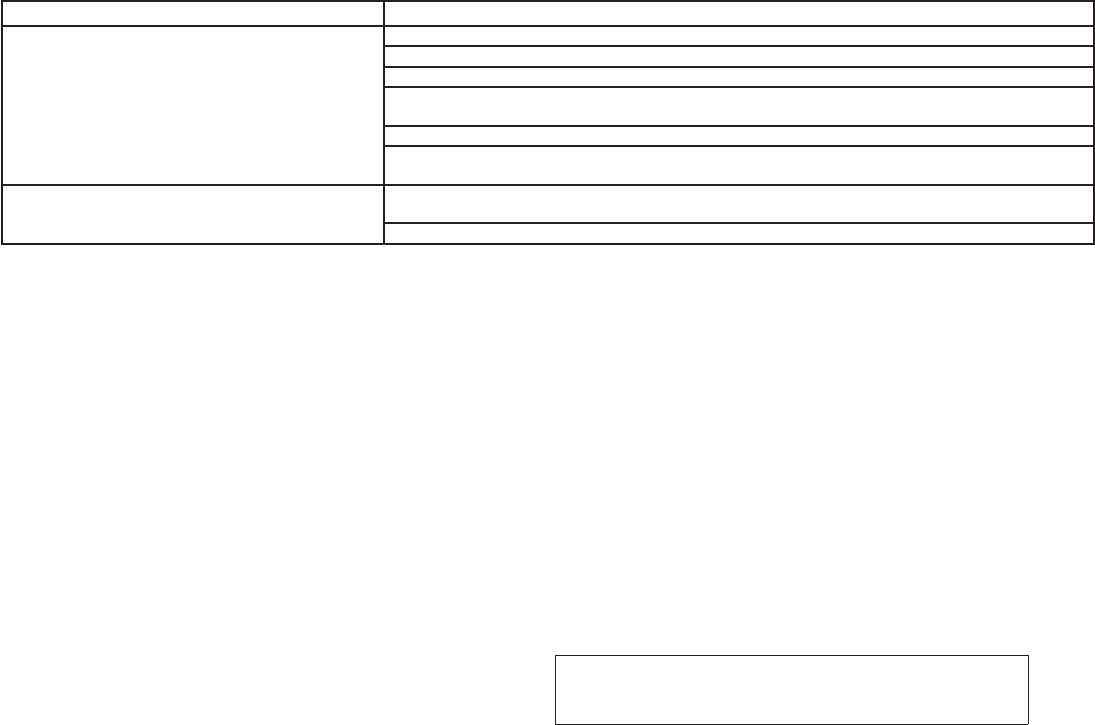
JOBNAME: 1093929-2013-asd-own PAGE: 244 SESS: 4 OUTPUT: Tue Mar 27 10:39:14 2012
TROUBLESHOOTING GUIDE
The system should respond correctly to all voice
commands without difficulty. If problems are en-
countered, try the following solutions.
Where the solutions are listed by number, try
each solution in turn, starting with number 1, until
the problem is resolved.
Symptom Solution
System fails to interpret the command correctly.
1. Ensure that the command is valid. See “List of voice commands” in this section.
2. Ensure that the command is spoken after the tone.
3. Speak clearly without pausing between words and at a level appropriate to the ambient noise level in the vehicle.
4. Ensure that the ambient noise level is not excessive (for example, windows open or defroster on). NOTE: If it is too
noisy to use the phone, it is likely that the voice commands will not be recognized.
5. If more than one command was said at a time, try saying the commands separately.
6. If the system consistently fails to recognize commands, the voice training procedure should be carried out to im-
prove the recognition response for the speaker. See “Voice Adaptation (VA) mode” in this section.
The system consistently selects the wrong entry from the
phone book.
1. Ensure that the phone book entry name requested matches what was originally stored. This can be confirmed by
using the “List Names” command. See “Phonebook” in this section.
2. Replace one of the names being confused with a new name.
4-84 Monitor, climate, audio, phone and voice recognition systems
ZREVIEW COPY—
2013 Altima Sedan (asd)
Owners Manual—USA_English (nna)
03/24/12—dmoore
X
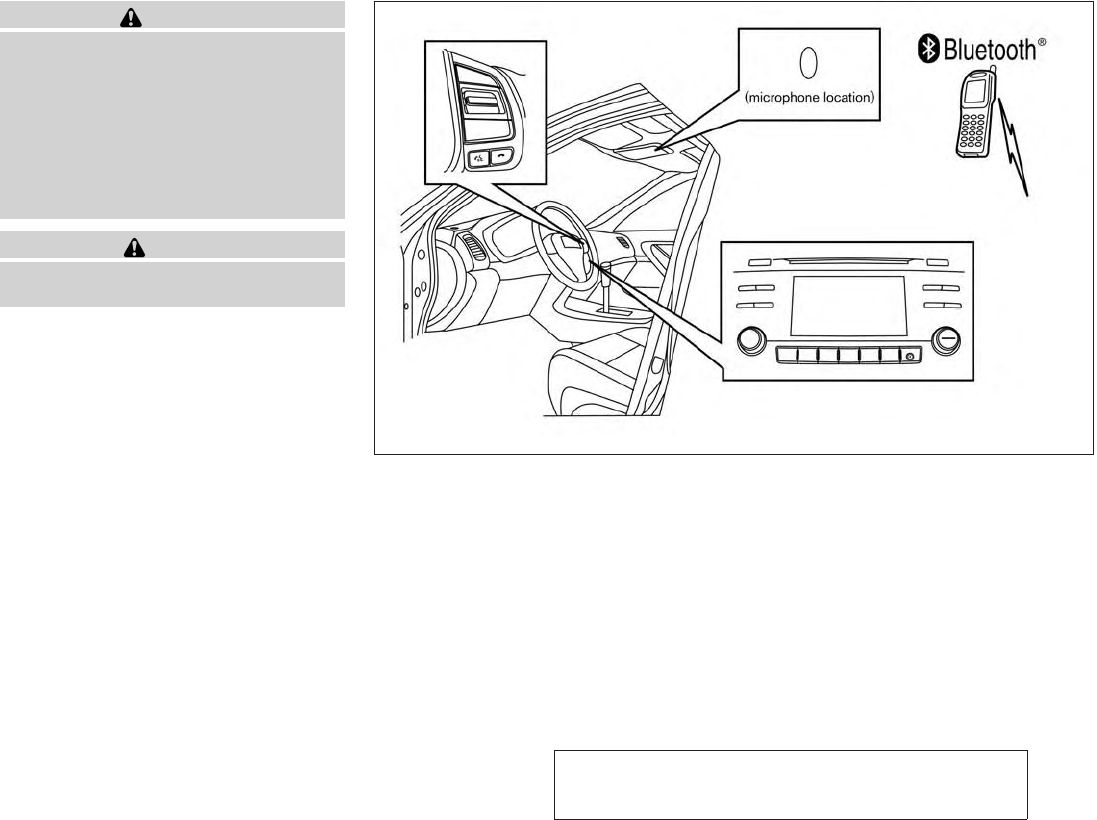
JOBNAME: 1093929-2013-asd-own PAGE: 245 SESS: 4 OUTPUT: Tue Mar 27 10:39:14 2012
WARNING
●Use a phone after stopping your vehicle
in a safe location. If you have to use a
phone while driving, exercise extreme
caution at all times so full attention may
be given to vehicle operation.
●If you are unable to devote full attention
to vehicle operation while talking on
the phone, pull off the road to a safe
location and stop your vehicle.
CAUTION
To avoid discharging the vehicle battery,
use a phone after starting the engine.
Your NISSAN is equipped with the BluetoothT
Hands-Free Phone System. If you have a com-
patible BluetoothTenabled cellular phone, you
can set up the wireless connection between your
cellular phone and the in-vehicle phone module.
With BluetoothTwireless technology, you can
make or receive a hands-free telephone call with
your cellular phone in the vehicle.
Once your cellular phone is connected to the
in-vehicle phone module, no other phone con-
necting procedure is required. Your phone is
automatically connected with the in-vehicle
LHA2290
BLUETOOTHTHANDS-FREE PHONE
SYSTEM WITHOUT NAVIGATION
SYSTEM (Type B) (if so equipped)
Monitor, climate, audio, phone and voice recognition systems 4-85
ZREVIEW COPY—
2013 Altima Sedan (asd)
Owners Manual—USA_English (nna)
03/24/12—dmoore
X

JOBNAME: 1093929-2013-asd-own PAGE: 246 SESS: 4 OUTPUT: Tue Mar 27 10:39:14 2012
phone module when the ignition switch is placed
in the ON position with the previously connected
cellular phone turned on and carried in the ve-
hicle.
NOTE:
Some devices require the user to accept
connections to other BluetoothTdevices. If
your phone does not connect automatically
to the system, consult the phone’s Owner’s
Manual for details on device operation.
You can connect up to 5 different BluetoothT
cellular phones to the in-vehicle phone module.
However, you can talk on only one cellular phone
at a time.
Before using the BluetoothTHands-Free Phone
System, refer to the following notes.
●Set up the wireless connection between a
compatible cellular phone and the in-vehicle
phone module before using the hands-free
phone system.
●Some BluetoothTenabled cellular phones
may not be recognized or work properly.
Please visit www.nissanusa.com/bluetooth
for a recommended phone list and connect-
ing instructions.
●You will not be able to use a hands-free
phone under the following conditions:
– Your vehicle is outside of the cellular ser-
vice area.
– Your vehicle is in an area where it is
difficult to receive a cellular signal; such
as in a tunnel, in an underground parking
garage, near a tall building or in a moun-
tainous area.
– Your cellular phone is locked to prevent it
from being dialed.
●When the radio wave condition is not ideal
or ambient sound is too loud, it may be
difficult to hear the other person’s voice dur-
ing a call.
●Do not place the cellular phone in an area
surrounded by metal or far away from the
in-vehicle phone module to prevent tone
quality degradation and wireless connection
disruption.
●While a cellular phone is connected through
the BluetoothTwireless connection, the bat-
tery power of the cellular phone may dis-
charge quicker than usual. The BluetoothT
Hands-Free Phone System cannot charge
cellular phones.
●If the hands-free phone system seems to be
malfunctioning, see “Troubleshooting guide”
in this section. You can also visit
www.nissanusa.com/bluetooth for trouble-
shooting help.
●Some cellular phones or other devices may
cause interference or a buzzing noise to
come from the audio system speakers. Stor-
ing the device in a different location may
reduce or eliminate the noise.
●Refer to the cellular phone Owner’s Manual
regarding the telephone charges, cellular
phone antenna and body, etc.
REGULATORY INFORMATION
FCC Regulatory information
– CAUTION: To maintain compliance with
FCC’s RF exposure guidelines, use only the
supplied antenna. Unauthorized antenna,
modification, or attachments could damage
the transmitter and may violate FCC regula-
tions.
– Operation is subject to the following two con-
ditions:
1. This device may not cause interference and
2. this device must accept any interference,
including interference that may cause unde-
sired operation of the device.
4-86 Monitor, climate, audio, phone and voice recognition systems
ZREVIEW COPY—
2013 Altima Sedan (asd)
Owners Manual—USA_English (nna)
03/24/12—dmoore
X

JOBNAME: 1093929-2013-asd-own PAGE: 247 SESS: 4 OUTPUT: Tue Mar 27 10:39:14 2012
IC Regulatory information
– Operation is subject to the following two con-
ditions: (1) this device may not cause interfer-
ence, and (2) this device must accept any
interference, including interference that may
cause undesired operation of the device.
– This Class B digital apparatus meets all re-
quirements of the Canadian Interference-
Causing Equipment Regulations.
BLUETOOTHtis a
trademark owned by
Bluetooth SIG, Inc.
and licensed to Vis-
teon.
USING THE SYSTEM
The NISSAN Voice Recognition system allows
hands-free operation of the BluetoothTPhone
System.
If the vehicle is in motion, some commands may
not be available so full attention may be given to
vehicle operation.
Initialization
When the ignition switch is placed in the ON
position, NISSAN Voice Recognition is initialized,
which takes a few seconds. If the button is
pressed before the initialization completes, the
system will announce “Hands-free phone system
not ready” and will not react to voice commands.
Operating tips
To get the best performance out of the NISSAN
Voice Recognition system, observe the following:
●Keep the interior of the vehicle as quiet as
possible. Close the windows to eliminate
surrounding noises (traffic noises, vibration
sounds, etc.), which may prevent the system
from recognizing voice commands correctly.
●Wait until the tone sounds before speaking a
command. Otherwise, the command will not
be received properly.
●Start speaking a command within 5 seconds
after the tone sounds.
●Speak in a natural voice without pausing
between words.
Giving voice commands
To operate NISSAN Voice Recognition, press
and release the button located on the
steering wheel. After the tone sounds, speak a
command.
The command given is picked up by the micro-
phone, and voice feedback is given when the
command is accepted.
●If you need to hear the available commands
for the current menu again, say “Help” and
the system will repeat them.
●If a command is not recognized, the system
announces, “Command not recognized.
Please try again.”Make sure the command is
said exactly as prompted by the system and
repeat the command in a clear voice.
●If you want to go back to the previous com-
mand, you can say “Go back” or “Correc-
tion” any time the system is waiting for a
response.
●You can cancel a command when the sys-
tem is waiting for a response by saying,
“Cancel” or “Quit.” The system announces
“Cancel” and ends the VR session. You can
also press and hold the button on the
steering wheel for 5 seconds at any time to
end the VR session. Whenever the VR ses-
sion is cancelled, a double beep is played to
indicate you have exited the system.
Monitor, climate, audio, phone and voice recognition systems 4-87
ZREVIEW COPY—
2013 Altima Sedan (asd)
Owners Manual—USA_English (nna)
03/24/12—dmoore
X
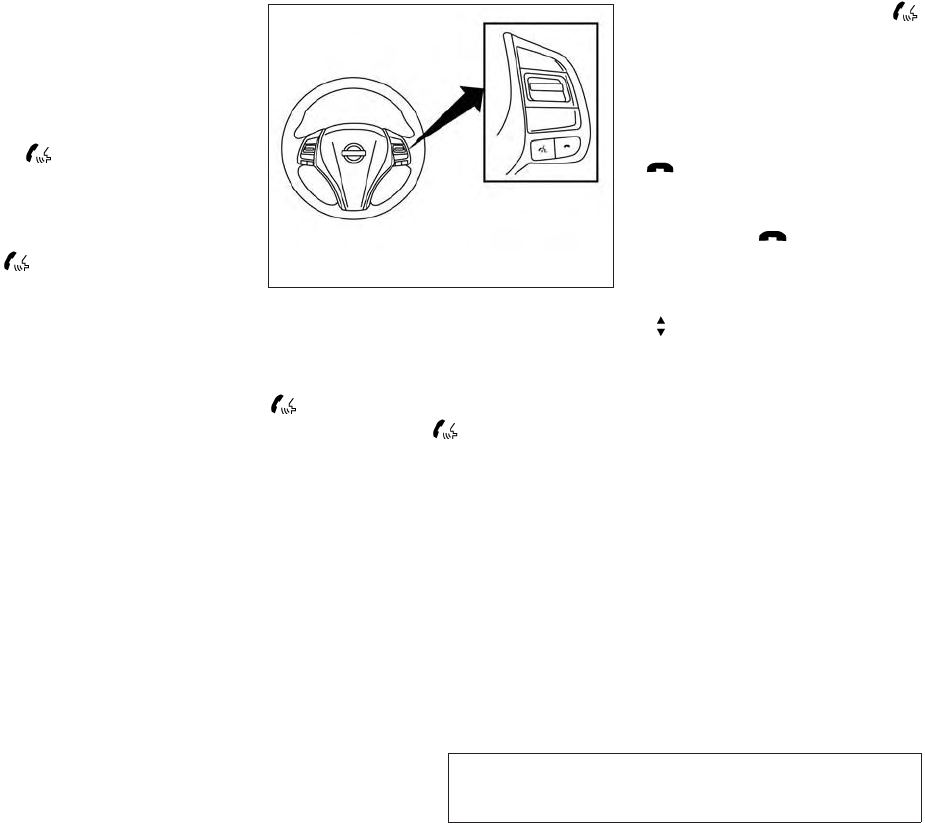
JOBNAME: 1093929-2013-asd-own PAGE: 248 SESS: 4 OUTPUT: Tue Mar 27 10:39:14 2012
●If you want to adjust the volume of the voice
feedback, press the volume control switches
(+ or -) on the steering wheel while being
provided with feedback. You can also use
the radio volume control knob.
●In most cases you can interrupt the voice
feedback to speak the next command by
pressing the button on the steering
wheel.
●To use the system faster, you may speak the
second level commands with the main menu
command on the main menu. For example,
press the button and after the tone
say, “Call Redial.”
CONTROL BUTTONS
The control buttons for the BluetoothTHands-
Free Phone System are located on the steering
wheel.
PHONE/SEND
Press the button to initiate
a VR session or answer an incom-
ing call.
You can also use the button
to interrupt the system feedback
and give a command at once. See
“List of voice commands” and
“During a call” in this section for
more information.
PHONE/END
While the voice recognition sys-
tem is active, press and hold
the button for 5 seconds to
quit the voice recognition system
at any time.
Tuning switch
While using the voice recognition
system, tilt the tuning switch up or
down to manually control the
phone system.
CONNECTING PROCEDURE
To connect a phone to the BluetoothTHands-
Free Phone System:
1. Press the SETTING button.
LHA2273
4-88 Monitor, climate, audio, phone and voice recognition systems
ZREVIEW COPY—
2013 Altima Sedan (asd)
Owners Manual—USA_English (nna)
03/24/12—dmoore
X
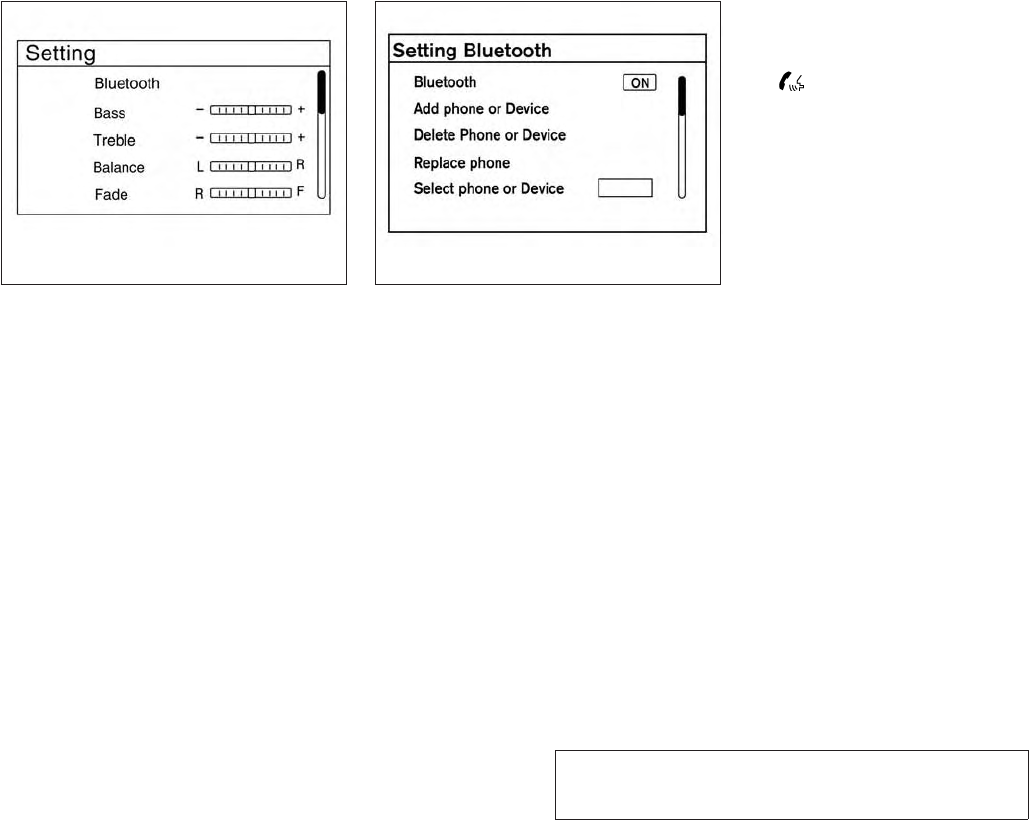
JOBNAME: 1093929-2013-asd-own PAGE: 249 SESS: 4 OUTPUT: Tue Mar 27 10:39:14 2012
2. Use the TUNE/SCROLL knob to select
“Bluetooth” and then press the ENTER but-
ton.
3. Use the TUNE/SCROLL knob to select
“Add Phone or Device” and then press the
ENTER button.
4. When a message with a PIN appears on the
screen, operate the BluetoothTphone to
enter the PIN.
The connecting procedure varies according to
each phone. See the phone’s Owner’s Manual
for details. You can also visit
www.nissanusa.com/bluetooth or call the
NISSAN Consumer Affairs Department for in-
structions on connecting recommended cellular
phones.
VOICE COMMANDS
Voice commands can be used to operate the
BluetoothTHands-Free Phone System. Press
the button and say “Phone” to bring up the
phone command menu. The available options
are:
●Call
●Phonebook
●Recent Calls
●Send Text
●Read Text
●Select Phone
“Call”
For more information on the “Call” command, see
“Making a call” in this section.
“Phonebook”
The following commands are available under
“Phonebook”:
LHA2257 LHA2274
Monitor, climate, audio, phone and voice recognition systems 4-89
ZREVIEW COPY—
2013 Altima Sedan (asd)
Owners Manual—USA_English (nna)
03/24/12—dmoore
X

JOBNAME: 1093929-2013-asd-own PAGE: 250 SESS: 4 OUTPUT: Tue Mar 27 10:39:14 2012
●(a name)
Say a name in the phonebook to bring up a
list of options for that phonebook entry. The
system will say the name it interpreted based
on the voice command provided. If the name
is incorrect, say “Correction”to hear another
name.
Once the correct phonebook entry is identi-
fied, say “Dial” to dial the number or “Send
Text” to send a text message to that number.
Say “Record Name”to record a name for the
phonebook entry. Say “Delete Recording” to
delete a recorded name for the phonebook
entry.
●List Names
Speak this command to have the system list
the names in the phonebook one by one
alphabetically. Say “Dial” to dial the number
of the current name or “Send Text” to send a
text message to that number. Say “Next En-
try” or “Previous Entry” to move through the
list alphabetically. Say “Record Name” to
record a name for the current phonebook
entry. Say “Delete Recording” to delete a
recorded name for the current phonebook
entry.
●Transfer Entry
This command can be used to transfer mul-
tiple contacts at a time. To enable manual
contact transfer capability, set “Phonebook
Download” to “Off” in the Setting menu. The
ability to transfer contacts via the OPP
Bluetooth profile depends on your mobile
phone. See your phone’s Owner’s Manual
for details and instructions.
●Delete Entry
Speak this command to delete an entry in
the phonebook. Choose an entry to delete
by speaking the desired name or say “List
Names”.
“Recent Calls”
The following commands are available under
“Recent Calls”:
●Incoming Calls
Speak this command to list the last five
incoming calls to the vehicle. If the call is
from an entry in the phonebook, the name
will be displayed. Otherwise, the phone
number of the incoming call will be dis-
played.
Say “Dial” to call the number or “Send Text”
to send a text message to that number. Say
“Next Entry” or “Previous Entry” to move
through the list of incoming calls.
●Missed Calls
Speak this command to list the last five
missed calls to the vehicle. If the call is from
an entry in the phonebook, the name will be
displayed. Otherwise, the phone number of
the missed call will be displayed.
Say “Dial” to call the number or “Send Text”
to send a text message to that number. Say
“Next Entry” or “Previous Entry” to move
through the list of missed calls.
●Outgoing Calls
Speak this command to list the last five
outgoing calls from the vehicle. If the call
was to an entry in the phonebook, the name
will be displayed. Otherwise, the phone
number of the outgoing call will be dis-
played.
Say “Dial” to call the number or “Send Text”
to send a text message to that number. Say
“Next Entry” or “Previous Entry” to move
through the list of outgoing calls.
●Redial
Speak this command to call the last number
dialed.
4-90 Monitor, climate, audio, phone and voice recognition systems
ZREVIEW COPY—
2013 Altima Sedan (asd)
Owners Manual—USA_English (nna)
03/24/12—dmoore
X
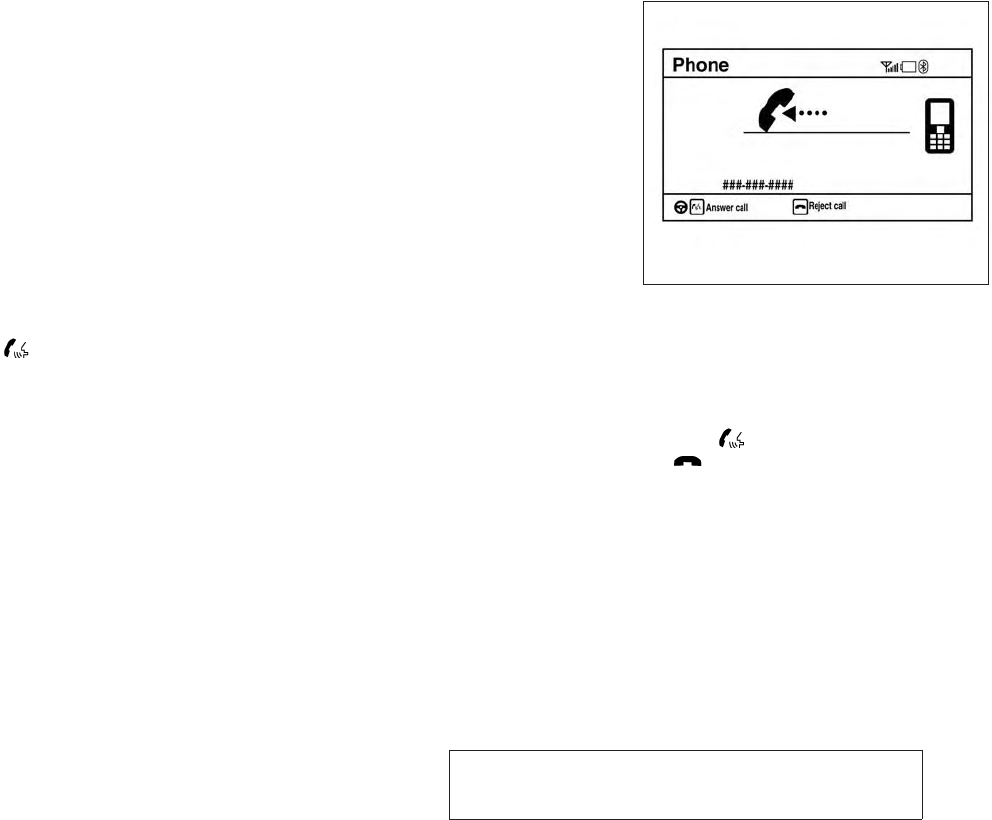
JOBNAME: 1093929-2013-asd-own PAGE: 251 SESS: 4 OUTPUT: Tue Mar 27 10:39:14 2012
●Call Back
Speak this command to call the number of
the last incoming call to the vehicle.
“Send Text / Read Text”
For more information on these commands, see
“Text messaging” in this section.
“Select Phone”
Speak this command to select a phone to use
from a list of those phones connected to the
vehicle.
MAKING A CALL
To make a call from a phone connected to the
vehicle’s BluetoothTHands-Free Phone System:
●Press the button.
●The system will prompt you for a command.
●Select one of the available voice commands
to continue:
●“(a name)” – Speak the name of a phone-
book entry to place a call to that entry. The
system will respond with the name it inter-
preted from your command and will prompt
you to confirm that the name is correct. Say
“Yes” to initiate the call or “No” to hear an-
other name from the phonebook.
●“Number” – Speak this command to place a
call by inputting numbers.
For 7- and 10-digit phone numbers, speak
the numbers. When finished, say “Dial” to
initiate the call. Say “Correction” at any time
in the process to correct a misspoken or
misinterpreted number.
For phone numbers with more digits or spe-
cial characters, say “Special Number”, then
speak the digits. Up to 24 digits can be
entered. Available special characters are
“star”, “pound”, “plus” and “pause”. When
finished, say “Dial” to initiate the call. Say
“Correction” at any time in the process to
correct a misspoken or misinterpreted num-
ber or character.
●“Redial” – Speak this command to dial the
number of the last outgoing call. The system
will display “Redialing <name/number>”.
The name of the phonebook entry will be
displayed if it available, otherwise the num-
ber being redialed will be displayed.
●“Call Back”–Speak this command to dial the
number of the last incoming call. The system
will display “Calling back <name/number.”.
The name of the phonebook entry will be
displayed if it available, otherwise the num-
ber being called back will be displayed.
RECEIVING A CALL
When a call is received by the phone connected
to the vehicle’s BluetoothTHands-Free Phone
System, the call information is displayed on either
the vehicle information display or both the vehicle
information display and he control panel display.
Press the button to accept the call. Press
the button to reject the call.
LHA2293
Monitor, climate, audio, phone and voice recognition systems 4-91
ZREVIEW COPY—
2013 Altima Sedan (asd)
Owners Manual—USA_English (nna)
03/24/12—dmoore
X
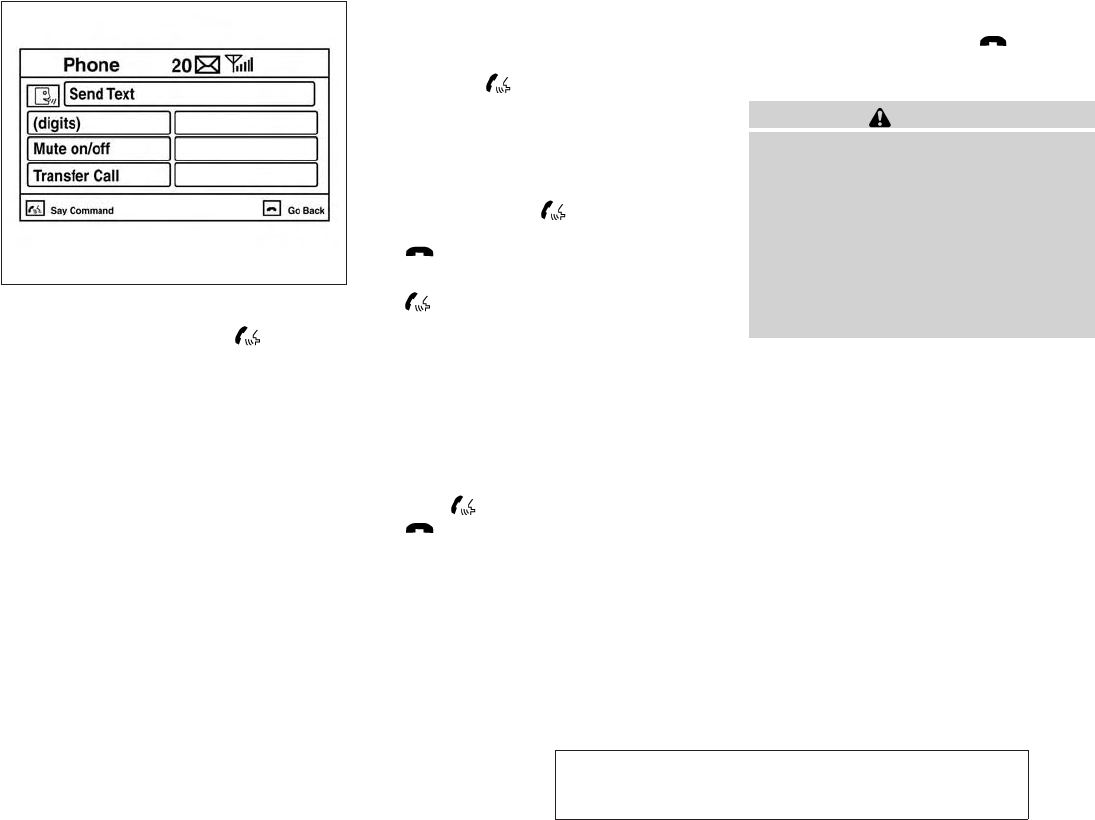
JOBNAME: 1093929-2013-asd-own PAGE: 252 SESS: 4 OUTPUT: Tue Mar 27 10:39:14 2012
DURING A CALL
While a call is active, press the button to
access additional options. Speak one of the fol-
lowing commands:
●“(numbers)” – Speak numbers and then say
“Send” or say “Correction” to change the
numbers entered.
●“Mute On” or “Mute Off” – Speak the com-
mand to mute or unmute the system.
●“Transfer Call” – Speak this command to
transfer the call to the handset. To transfer
the call back from the handset to the
BluetoothTHands-Free Phone System,
press the button and confirm when
prompted.
If supported by the phone, the BluetoothT
Hands-Free Phone System allows for call waiting
functionality. If a call is received while another call
is already active, a message will be displayed on
the screen. Press the button to hold the
active call and switch to the second call. Press
the button to reject the second call.
While the second call is active, pressing
the button will allow the same commands
that available during any call as well as two addi-
tional commands:
●“Switch Call” – Speak this command to hold
the second call and switch back to the origi-
nal call.
●“End Other Call” – Speak this command to
stay with the second call and end the original
call.
Press the button to accept the call. Press
the button to reject the call.
ENDING A CALL
To end an active call, press the button.
TEXT MESSAGING
WARNING
●Use the text messaging feature after
stopping your vehicle in a safe location.
If you have to use the feature while
driving, exercise extreme caution at all
times so full attention may be given to
vehicle operation.
●If you are unable to devote full attention
to vehicle operation while using the text
messaging feature, pull off the road to a
safe location and stop your vehicle.
NOTE:
This feature is automatically disabled if the
connected device does not support the
Message Access Profile (MAP). See the
phone’s Owner’s Manual for details and
instructions.
The system allows for the sending and receiving
of text messages through the vehicle interface.
LHA2294
4-92 Monitor, climate, audio, phone and voice recognition systems
ZREVIEW COPY—
2013 Altima Sedan (asd)
Owners Manual—USA_English (nna)
03/24/12—dmoore
X
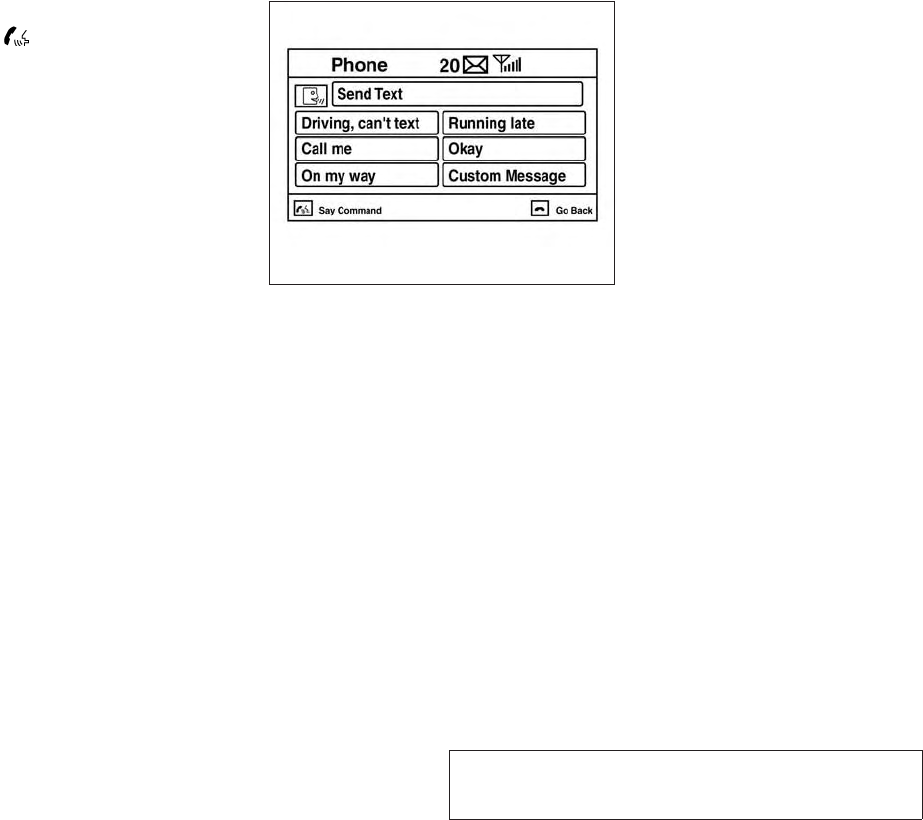
JOBNAME: 1093929-2013-asd-own PAGE: 253 SESS: 4 OUTPUT: Tue Mar 27 10:39:14 2012
Sending a text message:
1. Press the button.
2. Say “Send Text”.
3. The system will provide a list of available
commands in order to determine the recipi-
ent of the text message. Choose from the
following:
●(a name)
●Number
●Incoming Calls
●Outgoing Calls
●Missed Calls
For more information about these options,
see “Voice commands” in this section.
4. Once a recipient is chosen, the system
prompts for which message to send. Five
predefined messages are available as well
as three custom messages. To choose one
of the predefined messages, speak one of
the following:
●“Driving, can’t text”
●“Call me”
●“On my way”
●“Running late”
●“Okay”
To send one of the custom messages, say
“Custom Message”. If more than one cus-
tom message is stored, the system will
prompt for the number of the desired cus-
tom message. For more information on set-
ting and managing custom text messages,
see “BluetoothTsettings” in this section.
LHA2296
Monitor, climate, audio, phone and voice recognition systems 4-93
ZREVIEW COPY—
2013 Altima Sedan (asd)
Owners Manual—USA_English (nna)
03/24/12—dmoore
X
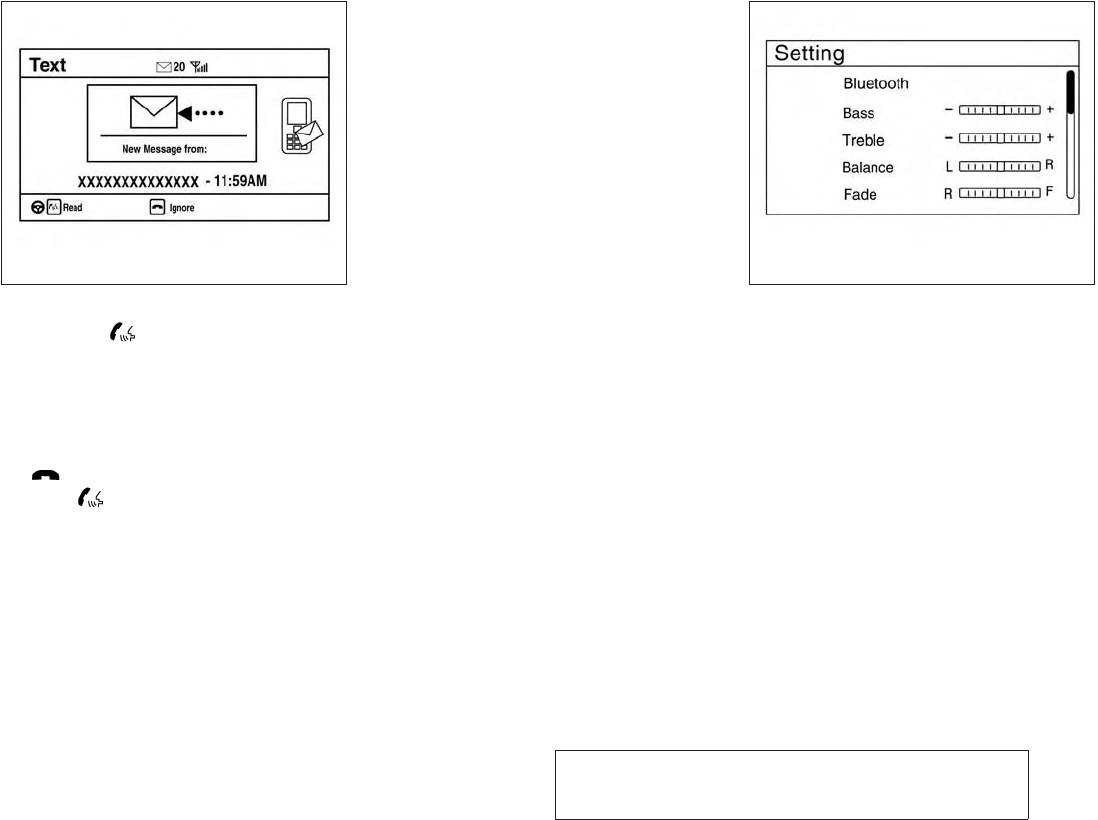
JOBNAME: 1093929-2013-asd-own PAGE: 254 SESS: 4 OUTPUT: Tue Mar 27 10:39:14 2012
Reading a received text message:
1. Press the button.
2. Say “Read Text”.
The text message, sender and delivery time are
shown on the screen. Use the tuning switch on
the steering wheel to scroll through all text mes-
sages if more than one are available. Press
the button to exit the text message screen.
Press the button to access the following
options for replying to the text message:
●Call Back
Speak this command to call the sender of
the text message using the BluetoothT
Hands-Free Phone System.
●Send Text
Speak this command to send a text message
response to the sender of the text message.
●Read Text
Speak this command to read the text mes-
sage again.
●Previous Text
Speak this command to move to the previ-
ous text message (if available).
●Next Text
Speak this command to move to the next text
message (if available).
NOTE:
Text messages are only displayed if the
vehicle speed is less than 5 mph.
BLUETOOTHTSETTINGS
To access and adjust the settings for the
BluetoothTHands-Free Phone System:
1. Press the SETTING button.
LHA2295 LHA2257
4-94 Monitor, climate, audio, phone and voice recognition systems
ZREVIEW COPY—
2013 Altima Sedan (asd)
Owners Manual—USA_English (nna)
03/24/12—dmoore
X
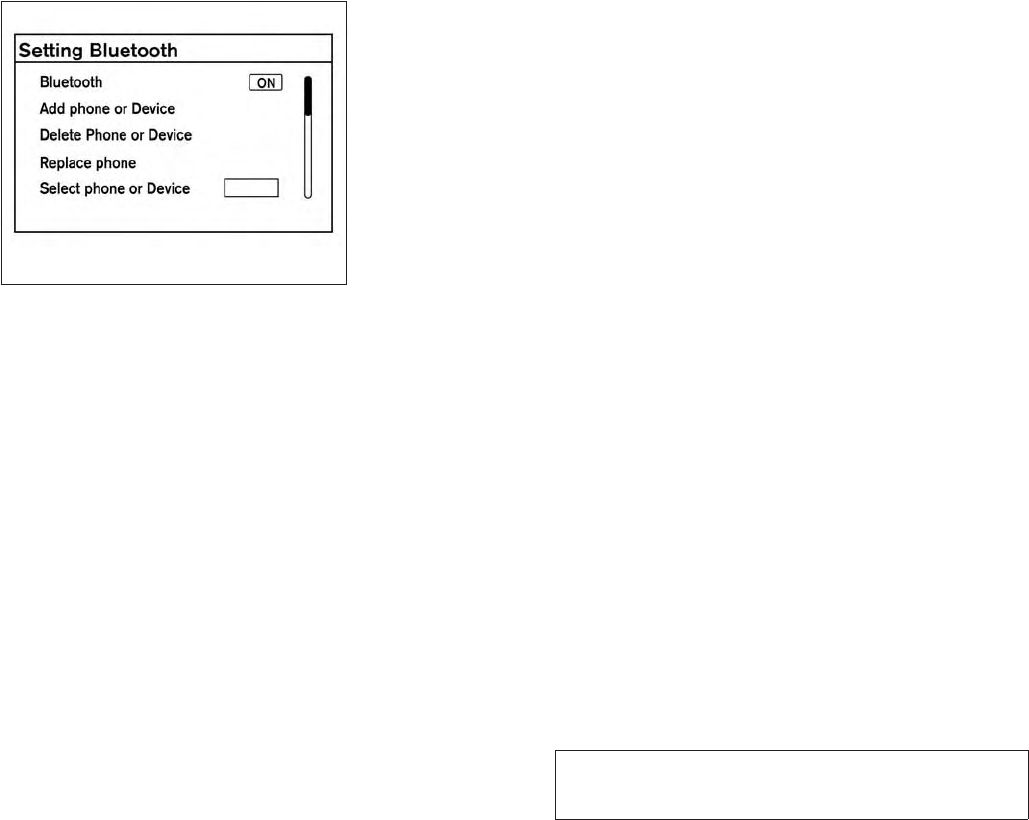
JOBNAME: 1093929-2013-asd-own PAGE: 255 SESS: 4 OUTPUT: Tue Mar 27 10:39:14 2012
2. Use the TUNE/SCROLL knob to select
“Bluetooth” and then press the ENTER but-
ton:
●Bluetooth
Select “On” or “Off” to turn the vehicle’s
BluetoothTsystem on or off.
●Add Phone or Device
To connect a phone to the system, see
“Connecting procedure” in this section.
●Delete Phone or Device
Select to delete a phone from the displayed
list. The system will ask to confirm before
deleting the phone.
●Replace Phone
Select to replace a phone from the displayed
list. When a selection is made, the system
will ask to confirm before proceeding. The
recorded phonebook for the phone being
deleted will be saved as long as the new
phone’s phonebook is the same as the old
phone’s phonebook.
●Select Phone or Device
Select to connect to a previously connected
phone from the displayed list.
●Show Incoming Calls
Select “Driver Only” to have incoming call
information displayed only in the vehicle in-
formation display. Select “Both” to have in-
coming call information displayed in both the
vehicle information display and the center
display screen.
●Phonebook Download
Select to turn on or off the automatic down-
load of a connected phone’s phonebook.
●Text Message
Select to turn on or off the vehicle’s text
messaging feature.
●New Text Sound
Select to adjust the volume of the sound that
plays when a new text is received by a phone
connected to the BluetoothTHands-Free
Phone System. The setting all the way to the
left indicates that the new text sound will be
muted.
●Show Incoming Text
Select “Driver Only” to have incoming text
messages displayed only in the vehicle infor-
mation display. Select “Both” to have incom-
ing text messages displayed in both the ve-
hicle information display and the center
display screen. Select “None” to have no
display of incoming text messages.
●Edit Custom Messages
Select to set a custom message that will be
available with the standard options when
sending a text message. To set a custom
message, send a text message to your own
phone number while the phone is connected
to the system. Three custom messages can
be set. Custom messages can only be set
while the vehicle is stationary.
LHA2274
Monitor, climate, audio, phone and voice recognition systems 4-95
ZREVIEW COPY—
2013 Altima Sedan (asd)
Owners Manual—USA_English (nna)
03/24/12—dmoore
X

JOBNAME: 1093929-2013-asd-own PAGE: 256 SESS: 4 OUTPUT: Tue Mar 27 10:39:14 2012
●Auto Reply
Select to turn on or off the Auto Reply func-
tion. When enabled, the vehicle will auto-
matically send a predefined text message to
the sender when a text message is received
while driving.
●Auto Reply Message
Select to choose the message that is sent
when the Auto Reply function is enabled.
Choose from “I’m Driving”or one of the three
custom messages stored in the system.
●Vehicle Signature On/Off
Select to choose whether or not the mes-
sage “Sent from my Altima” is added to
outgoing text messages from the vehicle.
This message cannot be changed or cus-
tomized.
MANUAL CONTROL
While using the Voice Recognition system, it is
possible to select menu options by using the
steering wheel controls instead of speaking voice
commands. The manual control mode does not
allow dialing a phone number by digits. The user
may select an entry from the Phonebook or Re-
cent Calls lists. To re-activate Voice Recognition,
exit the manual control mode by pressing and
holding the PHONE/END ( ) button. At that
time, pressing the PHONE/SEND ( ) button
will start the Hands Free Phone System.
WARNING
●Use a phone after stopping your vehicle
in a safe location. If you have to use a
phone while driving, exercise extreme
caution at all times so full attention may
be given to vehicle operation.
●If you are unable to devote full attention
to vehicle operation while talking on
the phone, pull off the road to a safe
location and stop your vehicle.
CAUTION
To avoid discharging the vehicle battery,
use a phone after starting the engine.
BLUETOOTHTHANDS-FREE PHONE
SYSTEM WITH NAVIGATION SYSTEM
(if so equipped)
4-96 Monitor, climate, audio, phone and voice recognition systems
ZREVIEW COPY—
2013 Altima Sedan (asd)
Owners Manual—USA_English (nna)
03/24/12—dmoore
X
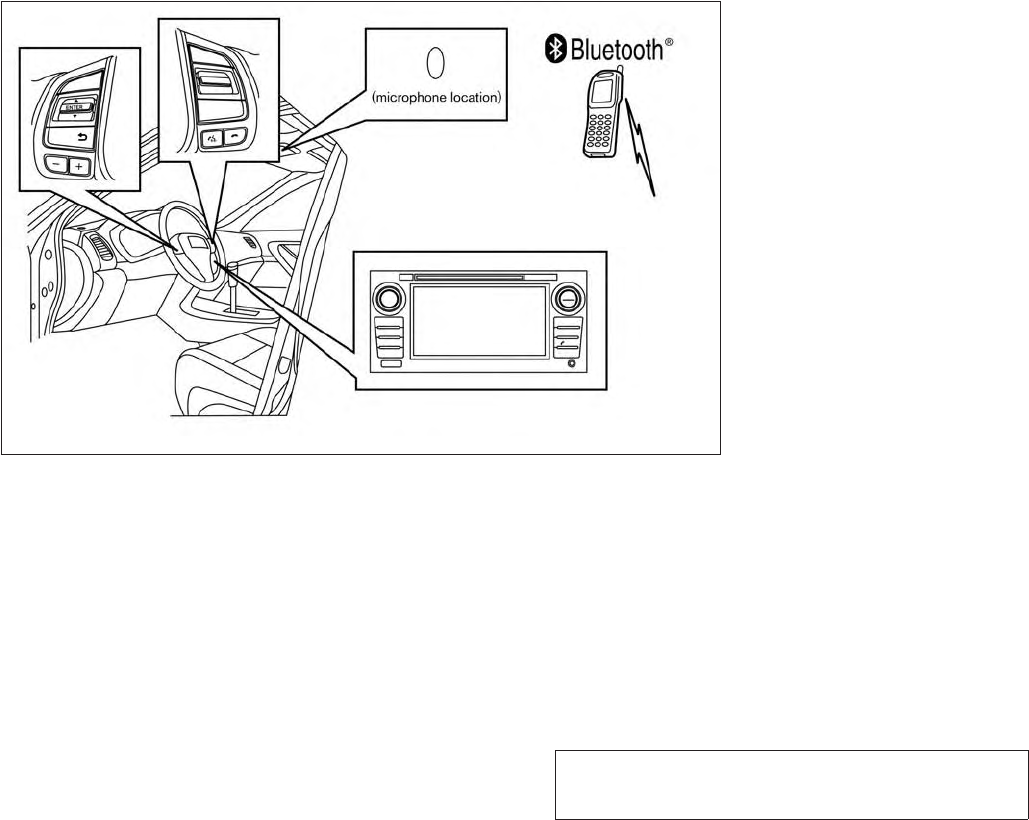
JOBNAME: 1093929-2013-asd-own PAGE: 257 SESS: 4 OUTPUT: Tue Mar 27 10:39:14 2012
Your NISSAN is equipped with the BluetoothT
Hands-Free Phone System. If you have a com-
patible BluetoothTenabled cellular phone, you
can set up the wireless connection between your
cellular phone and the in-vehicle phone module.
With BluetoothTwireless technology, you can
make or receive a hands-free telephone call with
your cellular phone in the vehicle.
Once your cellular phone is connected to the
in-vehicle phone module, no other phone con-
necting procedure is required. Your phone is
automatically connected with the in-vehicle
phone module when the ignition switch is placed
in the ON position with the connected cellular
phone turned on and carried in the vehicle.
You can register up to 5 different BluetoothT
cellular phones to the in-vehicle phone module.
However, you can talk on only one cellular phone
at a time.
NISSAN Voice Recognition system supports the
phone commands, so dialing a phone number
using your voice is possible. For more details, see
“NISSAN Voice Recognition System” in this sec-
tion.
Before using the BluetoothTHands-Free Phone
System, refer to the following notes.
●Set up the wireless connection between a
cellular phone and the in-vehicle phone
module before using the hands-free phone
system.
●Some BluetoothTenabled cellular phones
may not be recognized by the in-vehicle
phone module. Please visit
www.nissanusa.com/bluetooth for a recom-
mended phone list and connecting.
●You will not be able to use a hands-free
phone under the following conditions:
– Your vehicle is outside of the cellular ser-
vice area.
LHA2291
Monitor, climate, audio, phone and voice recognition systems 4-97
ZREVIEW COPY—
2013 Altima Sedan (asd)
Owners Manual—USA_English (nna)
03/24/12—dmoore
X
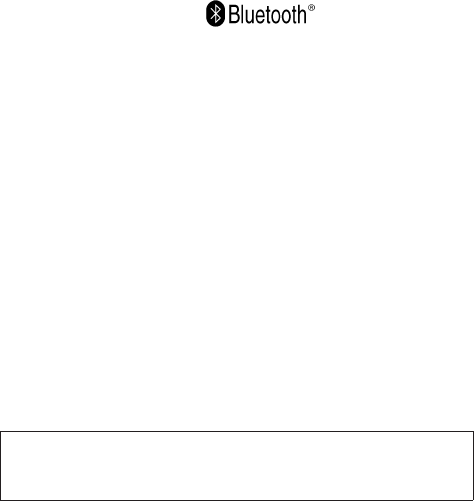
JOBNAME: 1093929-2013-asd-own PAGE: 258 SESS: 4 OUTPUT: Tue Mar 27 10:39:14 2012
– Your vehicle is in an area where it is
difficult to receive cellular signal; such as
in a tunnel, in an underground parking
garage, near a tall building or in a moun-
tainous area.
– Your cellular phone is locked to prevent it
from being dialed.
●When the radio wave condition is not ideal
or ambient sound is too loud, it may be
difficult to hear the other person’s voice dur-
ing a call.
●Immediately after the ignition switch is
placed in the ON position, it may be impos-
sible to receive a call for a short period of
time.
●Do not place the cellular phone in an area
surrounded by metal or far away from the
in-vehicle phone module to prevent tone
quality degradation and wireless connection
disruption.
●While a cellular phone is connected through
the BluetoothTwireless connection, the bat-
tery power of the cellular phone may dis-
charge quicker than usual. The BluetoothT
Hands-Free Phone System cannot charge
cellular phones.
●If the hands-free phone system seems to be
malfunctioning, see “Troubleshooting guide”
in this section. You can also visit
www.nissanusa.com/bluetooth for trouble-
shooting help.
●Some cellular phones or other devices may
cause interference or a buzzing noise to
come from the audio system speakers. Stor-
ing the device in a different location may
reduce or eliminate the noise.
●Refer to the cellular phone owner’s manual
regarding the telephone charges, cellular
phone antenna and body, etc.
●The signal strength display on the monitor
will not coincide with the signal strength
display of some cellular phones.
REGULATORY INFORMATION
FCC Regulatory information
– CAUTION: To maintain compliance with
FCC’s RF exposure guidelines, use only the
supplied antenna. Unauthorized antenna,
modification, or attachments could damage
the transmitter and may violate FCC regula-
tions.
– Operation is subject to the following two con-
ditions:
1. This device may not cause interference and
2. this device must accept any interference,
including interference that may cause unde-
sired operation of the device.
IC Regulatory information
– Operation is subject to the following two con-
ditions: (1) this device may not cause interfer-
ence, and (2) this device must accept any
interference, including interference that may
cause undesired operation of the device.
– This Class B digital apparatus meets all re-
quirements of the Canadian Interference-
Causing Equipment Regulations.
BLUETOOTHtis a
trademark owned by
Bluetooth SIG, Inc.
and licensed to
Visteon.
VOICE COMMANDS
You can use voice commands to operate various
BluetoothTHands-Free Phone System features
using the NISSAN Voice Recognition system. For
more details, see “NISSAN Voice Recognition
System” in this section.
4-98 Monitor, climate, audio, phone and voice recognition systems
ZREVIEW COPY—
2013 Altima Sedan (asd)
Owners Manual—USA_English (nna)
03/24/12—dmoore
X
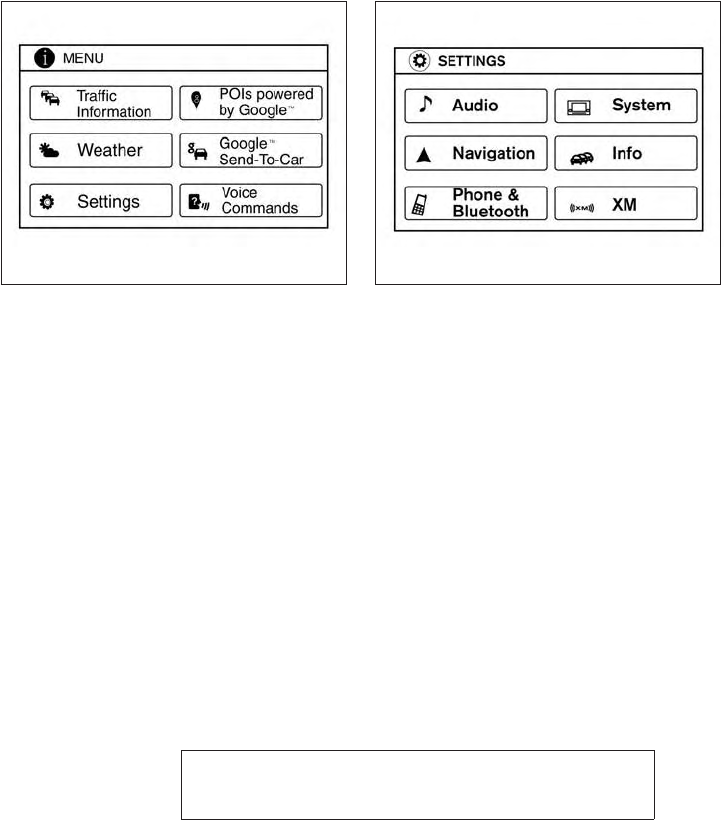
JOBNAME: 1093929-2013-asd-own PAGE: 259 SESS: 4 OUTPUT: Tue Mar 27 10:39:14 2012
CONNECTING PROCEDURE
1. Press the MENU button on the control
panel.
2. Select the “Settings” key. 3. Select the “Phone & Bluetooth” key.
LHA2253 LHA2248
Monitor, climate, audio, phone and voice recognition systems 4-99
ZREVIEW COPY—
2013 Altima Sedan (asd)
Owners Manual—USA_English (nna)
03/24/12—dmoore
X
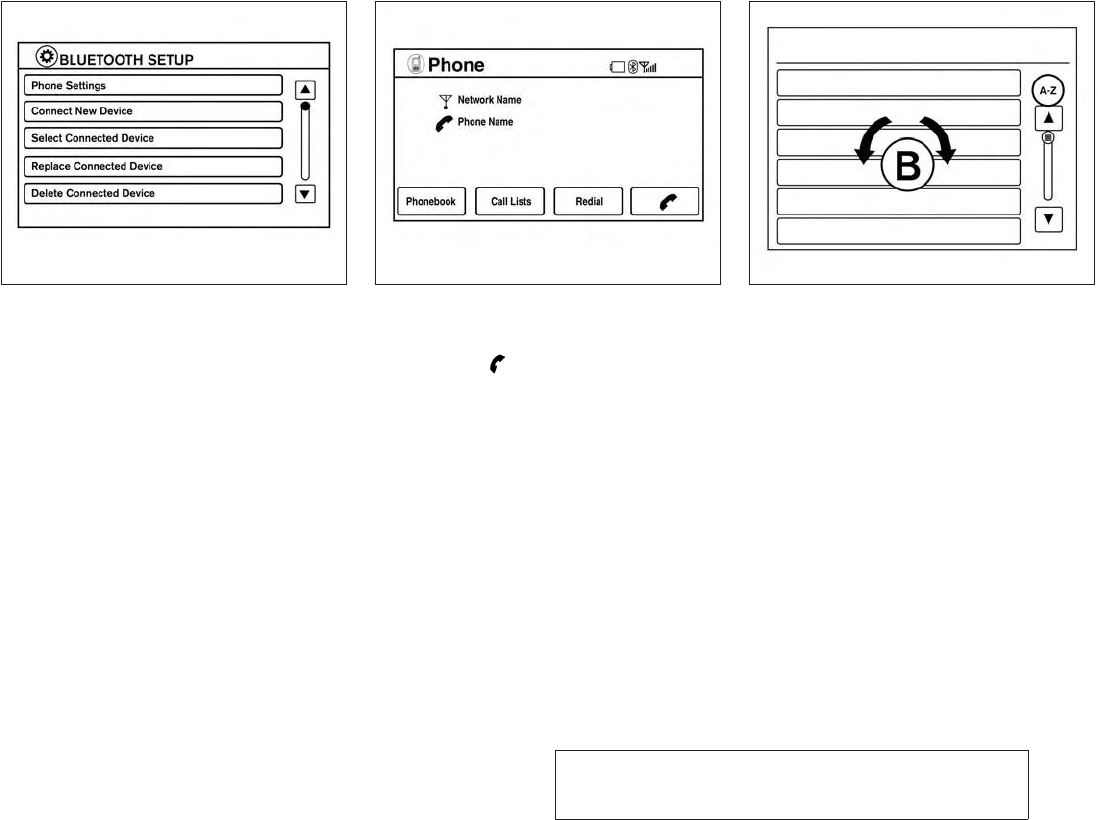
JOBNAME: 1093929-2013-asd-own PAGE: 260 SESS: 4 OUTPUT: Tue Mar 27 10:39:14 2012
4. Select the “Connect New Device” key.
5. Initiate the connecting process from the
handset. The system will display the mes-
sage: “Is PIN XXXXXX displayed on your
Bluetooth device?”. If the PIN is displayed
on your BluetoothTdevice, select “Yes” to
complete the connecting process.
For more information, see the BluetoothTde-
vice’s Owner’s Manual.
VEHICLE PHONEBOOK
To access the vehicle phonebook:
1. Press the button on the control panel.
2. Select the “Phonebook” key.
3. Choose the desired entry from the displayed
list.
NOTE:
To scroll quickly through the list, touch the
“A-Z” key in the upper right corner of the
screen. Turn the TUNE/SCROLL knob to
choose a letter or number and then press
ENTER. The list will move to the first entry
that begins with that number or letter.
4. The number of the entry will be displayed on
the screen. Touch the number to initiate di-
aling.
LHA2265 LHA2297 LHA2279
4-100 Monitor, climate, audio, phone and voice recognition systems
ZREVIEW COPY—
2013 Altima Sedan (asd)
Owners Manual—USA_English (nna)
03/24/12—dmoore
X
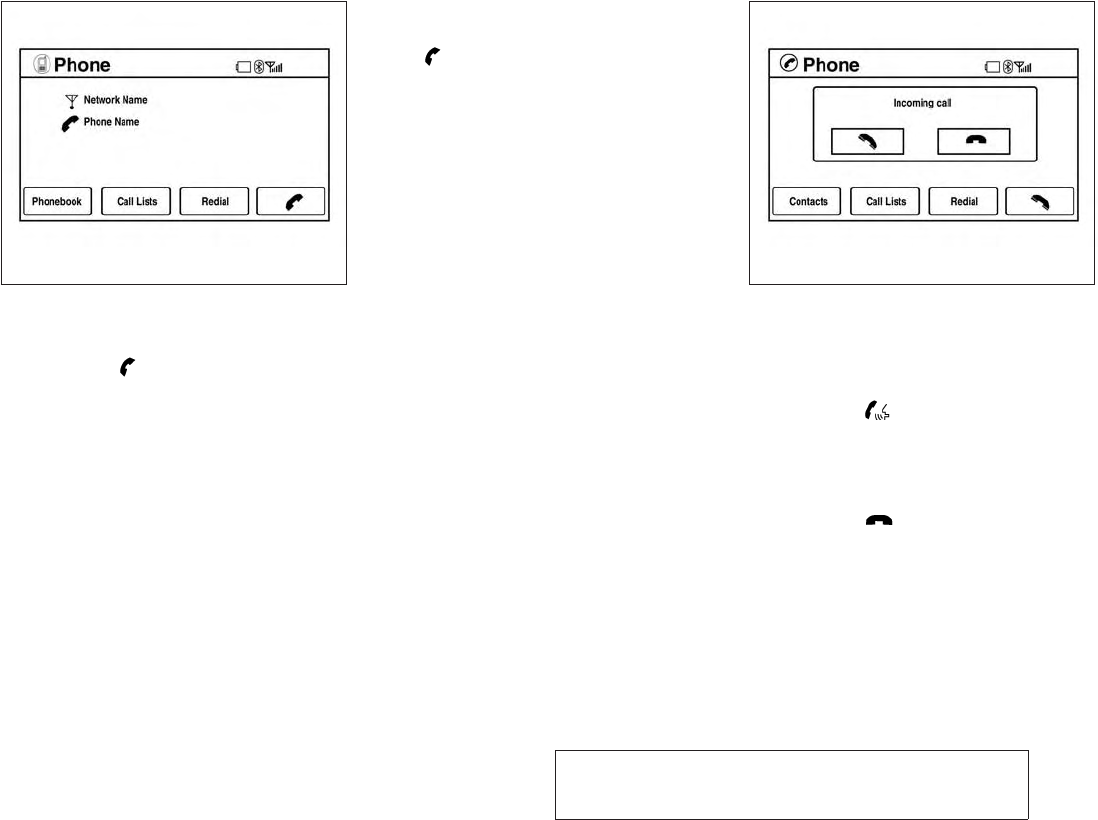
JOBNAME: 1093929-2013-asd-own PAGE: 261 SESS: 4 OUTPUT: Tue Mar 27 10:39:14 2012
MAKING A CALL
To make a call, follow the procedure below:
1. Press the button on the instrument
panel. The “Phone”screen will appear on the
display.
2. Select one of the following options to make a
call:
●“Phonebook”: Select the name from an entry
stored in the vehicle phonebook.
●“Call Lists”: Select the name from the in-
coming, outgoing or missed call history.
●“Redial”: Dial the last outgoing call from the
vehicle.
●“”: Input the phone number manually
using a keypad displayed on the screen. For
information on how to use the touchscreen,
see “How to use the touchscreen” in this
section.
RECEIVING A CALL
When a call is placed to the connected phone,
the display will change to phone mode.
To accept the incoming call, either:
●Press the button on the steering
wheel, or
●Touch the green phone icon on the screen.
To reject the incoming call, either:
●Press the button on the steering
wheel, or
●Touch the red phone icon on the screen.
LHA2297 LHA2298
Monitor, climate, audio, phone and voice recognition systems 4-101
ZREVIEW COPY—
2013 Altima Sedan (asd)
Owners Manual—USA_English (nna)
03/24/12—dmoore
X
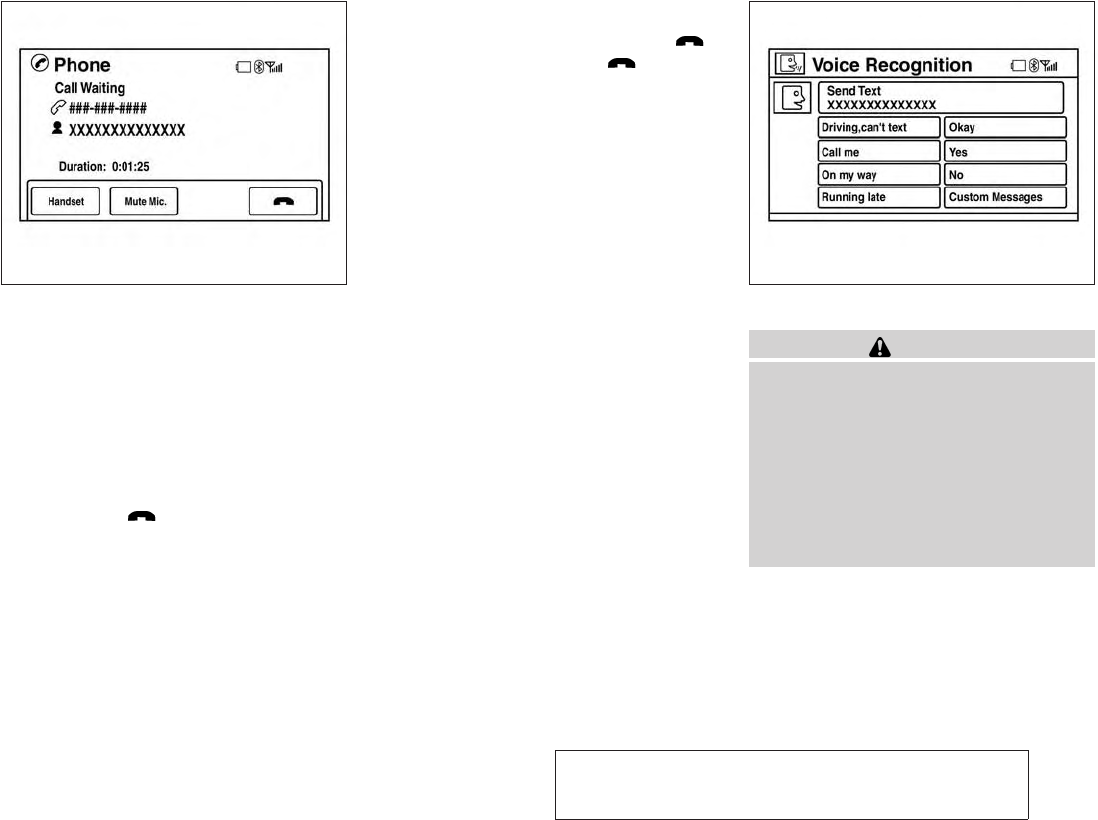
JOBNAME: 1093929-2013-asd-own PAGE: 262 SESS: 4 OUTPUT: Tue Mar 27 10:39:14 2012
DURING A CALL
While a call is active, the following options are
available on the screen:
●“Handset”
Select this option to switch control of the
phone call over to the handset.
●“Mute Mic.”
Select this option to mute the microphone.
Select again to unmute the microphone.
●Red phone ( ) icon
Select to end the phone call.
ENDING A CALL
To end a phone call, select the red phone ( )
icon on the screen or press the button on
the steering wheel.
TEXT MESSAGING
WARNING
●Use the text messaging feature after
stopping your vehicle in a safe location.
If you have to use the feature while
driving, exercise extreme caution at all
times so full attention may be given to
vehicle operation.
●If you are unable to devote full attention
to vehicle operation while using the text
messaging feature, pull off the road to a
safe location and stop your vehicle.
LHA2299 LHA2300
4-102 Monitor, climate, audio, phone and voice recognition systems
ZREVIEW COPY—
2013 Altima Sedan (asd)
Owners Manual—USA_English (nna)
03/24/12—dmoore
X
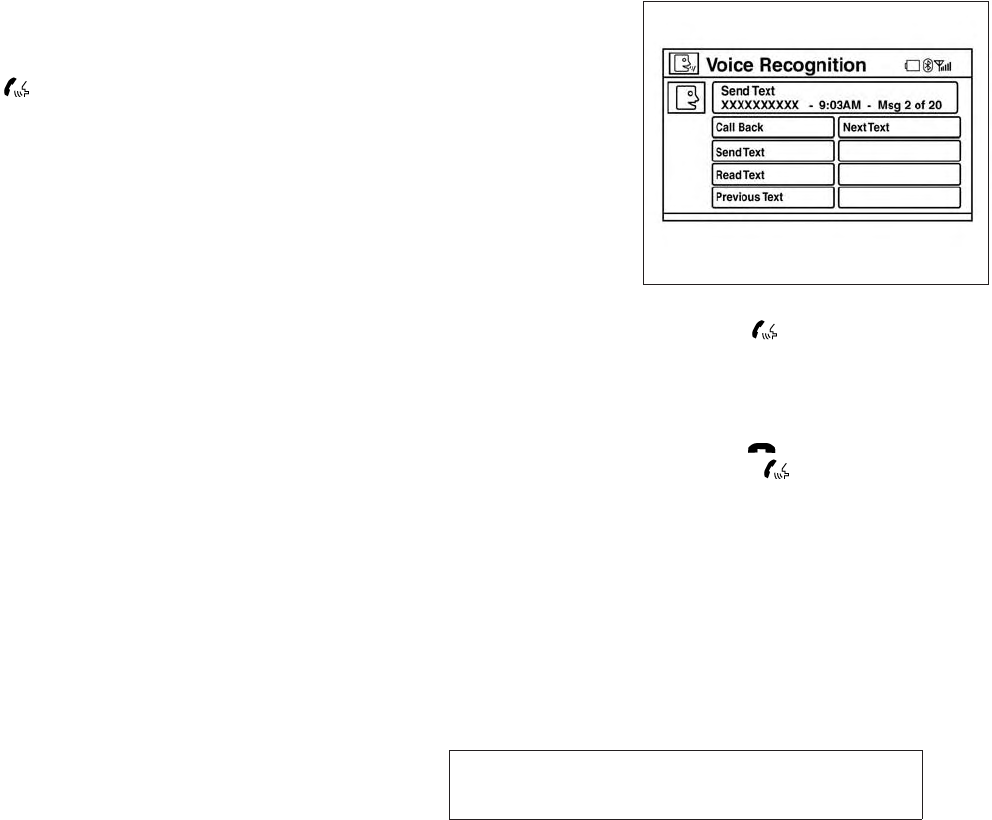
JOBNAME: 1093929-2013-asd-own PAGE: 263 SESS: 4 OUTPUT: Tue Mar 27 10:39:14 2012
The system allows for the sending and receiving
of text messages through the vehicle interface.
Sending a text message:
1. Press the button.
2. Say “Send Text”.
3. The system will provide a list of available
commands in order to determine the recipi-
ent of the text message. Choose from the
following:
●(a name)
●Number
●Incoming Calls
●Outgoing Calls
●Missed Calls
For more information about these options,
see “Voice commands” in this section.
4. Once a recipient is chosen, the system
prompts for which message to send. Five
predefined messages are available as well
as three custom messages. To choose one
of the predefined messages, speak one of
the following:
●“Driving, can’t text”
●“Call me”
●“On my way”
●“Running late”
●“Okay”
To send one of the custom messages, say
“Custom Messages”. If more than one cus-
tom message is stored, the system will
prompt for the number of the desired cus-
tom message. For more information on set-
ting and managing custom text messages,
see “BluetoothTsettings” in this section.
Reading a received text message:
1. Press the button.
2. Say “Read Text”.
The text message, sender and delivery time are
shown on the screen. Use the tuning switch to scroll
through all text messages if more than one are avail-
able. Press the button to exit the text message
screen. Press the button to access the follow-
ing options for replying to the text message:
●Call Back
Speak this command to call the sender of
the text message using the BluetoothT
Hands-Free Phone System.
LHA2301
Monitor, climate, audio, phone and voice recognition systems 4-103
ZREVIEW COPY—
2013 Altima Sedan (asd)
Owners Manual—USA_English (nna)
03/24/12—dmoore
X
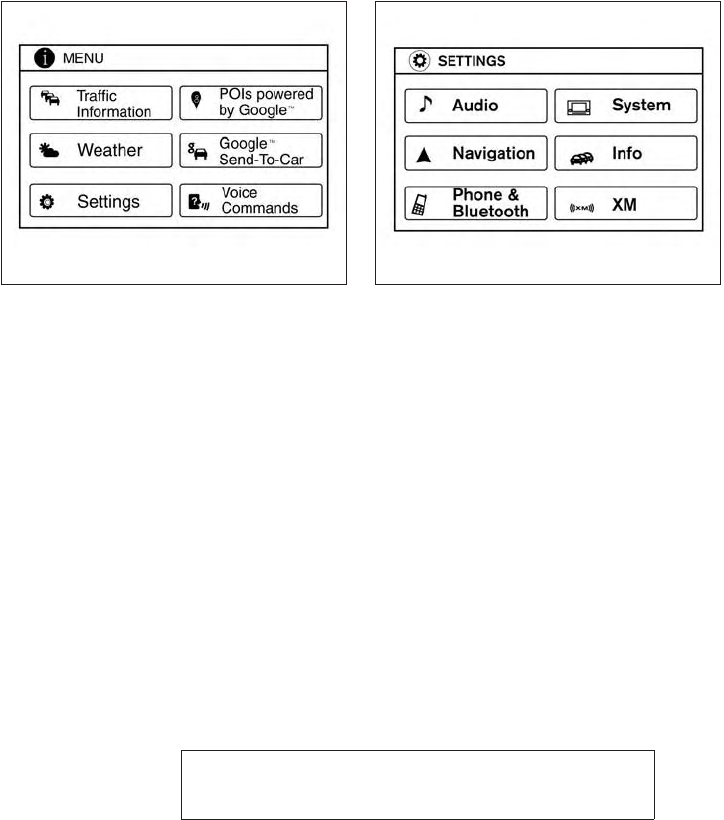
JOBNAME: 1093929-2013-asd-own PAGE: 264 SESS: 4 OUTPUT: Tue Mar 27 10:39:14 2012
●Send Text
Speak this command to send a text message
response to the sender of the text message.
●Read Text
Speak this command to read the text mes-
sage again.
●Previous Text
Speak this command to move to the previ-
ous text message (if available).
●Next Text
Speak this command to move to the next text
message (if available).
NOTE:
Text messages are only displayed if the
vehicle speed is less than 5 mph.
BLUETOOTH SETTINGS
To access the phone settings:
1. Press the MENU button.
2. Select the “Settings” key.
3. Select the “Phone & Bluetooth” key.
LHA2253 LHA2248
4-104 Monitor, climate, audio, phone and voice recognition systems
ZREVIEW COPY—
2013 Altima Sedan (asd)
Owners Manual—USA_English (nna)
03/24/12—dmoore
X
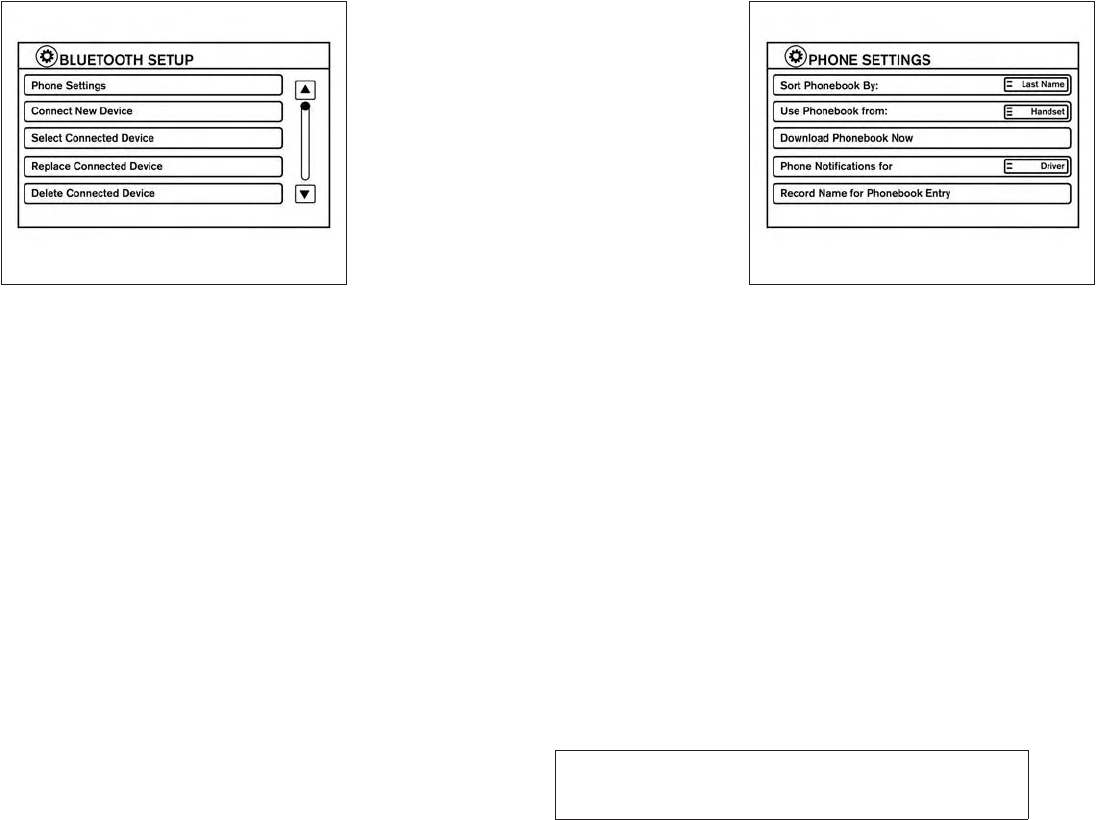
JOBNAME: 1093929-2013-asd-own PAGE: 265 SESS: 4 OUTPUT: Tue Mar 27 10:39:14 2012
●Phone Settings
See “Phone settings”in this section for more
information.
●Connect New Device
Select to connect a new BluetoothTdevice
to the BluetoothTHands-Free Phone Sys-
tem.
●Select Connected Device
Select to choose a BluetoothTdevice from a
list of those devices connected to the
BluetoothTHands-Free Phone System.
●Replace Connected Device
Select to replace a BluetoothTdevice from a
list of those devices connected to the
BluetoothTHands-Free Phone System.
●Delete Connected Device
Select to delete a BluetoothTdevice from a
list of those devices connected to the
BluetoothTHands-Free Phone System.
●Bluetooth
Select to toggle the BluetoothTon and off.
PHONE SETTINGS
To access the phone settings:
1. Press the MENU button.
2. Select the “Settings” key.
3. Select the “Phone & Bluetooth” key.
4. Select the “Phone Settings” key and adjust
the following settings as desired:
●Sort Phonebook By:
Select “First Name” or “Last Name” to
choose how phonebook entries are alpha-
betically displayed on the screen.
LHA2265 LHA2302
Monitor, climate, audio, phone and voice recognition systems 4-105
ZREVIEW COPY—
2013 Altima Sedan (asd)
Owners Manual—USA_English (nna)
03/24/12—dmoore
X

JOBNAME: 1093929-2013-asd-own PAGE: 266 SESS: 4 OUTPUT: Tue Mar 27 10:39:14 2012
●Use Phonebook From:
Select “Handset” to use the phone’s phone-
book. Select “SIM” to use the phonebook on
the SIM card. Select “Both” to use both
sources.
●Download Phonebook Now
Select to download the phonebook to the
vehicle from the chosen source.
●Phone Notifications for
Select “Driver” to have phone notifications
shown in the vehicle information display. Se-
lect “Both” to have phone notifications
shown in both the vehicle information display
and the center display screen.
●Record Name for Phonebook Entry
Select to record a name for a phonebook
entry for use with the NISSAN Voice Recog-
nition System.
●Text Message Service
Select to toggle the text message function-
ality on or off.
●Show Incoming Text for
Select “Driver” to have text message notifi-
cations shown in the vehicle information dis-
play. Select “Both” to have text message
notifications shown in both the vehicle infor-
mation display and the center display
screen. Select “None” to have text message
notifications not displayed.
●SMS Auto Reply Function
Select to toggle the SMS auto reply func-
tionality on or off.
●SMS Auto Reply Message
Select to choose a message that is sent
when the auto reply function is activated.
●Add Vehicle’s Signature
Select to toggle on or off the addition of the
vehicle signature to outgoing messages.
●Predefined SMS Messages
Select the predefined SMS messages that
are used by the system.
The NISSAN Voice Recognition system allows
hands-free operation of the systems equipped on
this vehicle, such as the phone and navigation
systems.
To operate NISSAN Voice Recognition, press
the button located on the steering wheel.
When prompted, speak the command for the
system you wish to activate. The command given
is picked up by the microphone and performed
when it is properly recognized. NISSAN Voice
Recognition will provide a voice response as well
as a message in the center display to inform you
of the command results.
USING THE SYSTEM
Initialization
When the ignition switch is in the ON position,
NISSAN Voice Recognition is initialized, which
takes a few seconds. When completed, the sys-
tem is ready to accept voice commands. If
the button is pressed before the initializa-
tion completes, the system will announce: “Voice
Recognition System not ready. Please wait.”
NISSAN VOICE RECOGNITION
SYSTEM (if so equipped)
4-106 Monitor, climate, audio, phone and voice recognition systems
ZREVIEW COPY—
2013 Altima Sedan (asd)
Owners Manual—USA_English (nna)
03/24/12—dmoore
X
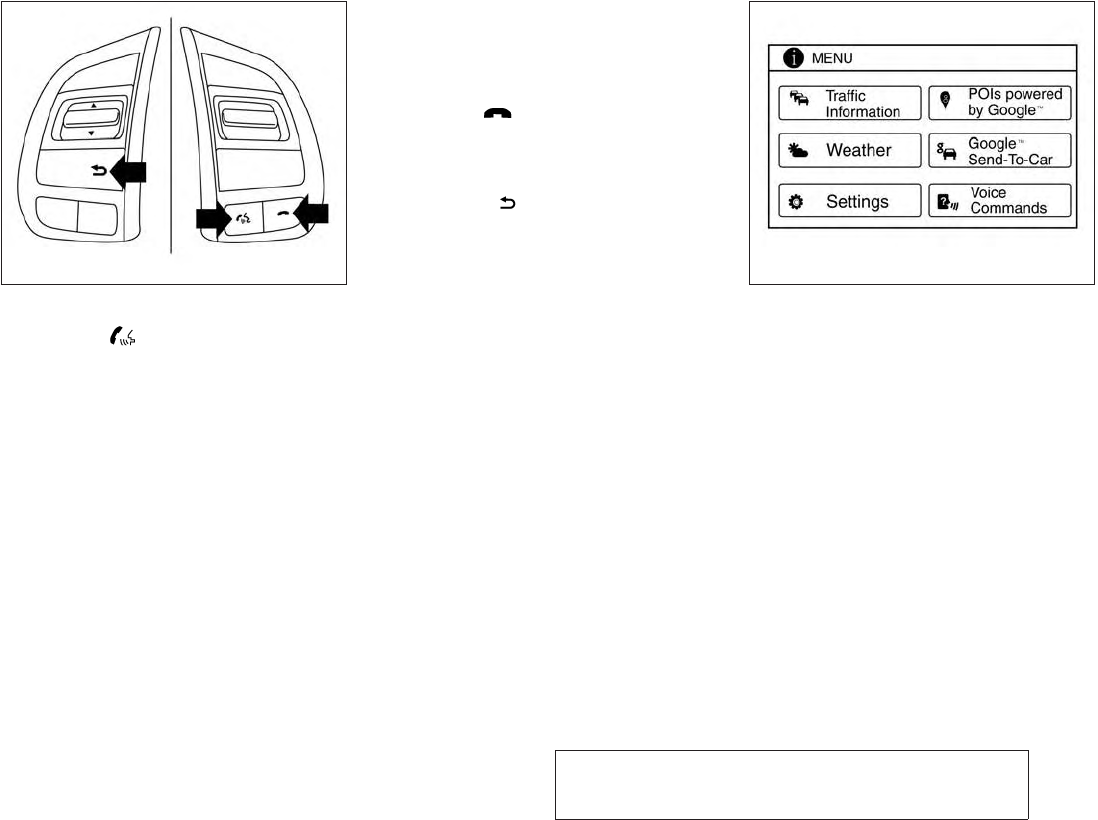
JOBNAME: 1093929-2013-asd-own PAGE: 267 SESS: 4 OUTPUT: Tue Mar 27 10:39:14 2012
Giving voice commands
1. Press the button.
2. The system announces: “Please say a com-
mand.” A list of available commands is spo-
ken by the system.
3. After the tone sounds and the face icon on
the display changes, speak a command.
Available commands are discussed later in
this section.
4. Voice and display feedback are provided
when the command is accepted.
●If the command is not recognized, the sys-
tem announces: “Command not recog-
nized.”Repeat the command in a clear voice.
●If you want to cancel the command or go
back to the previous menu of commands,
press the button. The system will an-
nounce: “Voice recognition canceled” or
“Go back” depending on the current menu
level.
●Press the button to move back
through the menus displayed on the screen.
●If you want to adjust the volume of the voice
feedback, use the volume control switches
on the steering wheel or the volume knob on
the control panel. ●The voice command screen can also be
accessed using the control panel display:
1. Press the MENU button.
2. Select the “Voice Commands” key.
Operating tips
To get the best performance out of NISSAN
Voice Recognition, observe the following:
●Keep the interior of the vehicle as quiet as
possible. Close the windows to eliminate the
surrounding noises (traffic noises, vibration
sounds, etc.), which may prevent the system
from recognizing the voice commands cor-
rectly.
LHA2282 LHA2253
Monitor, climate, audio, phone and voice recognition systems 4-107
ZREVIEW COPY—
2013 Altima Sedan (asd)
Owners Manual—USA_English (nna)
03/24/12—dmoore
X
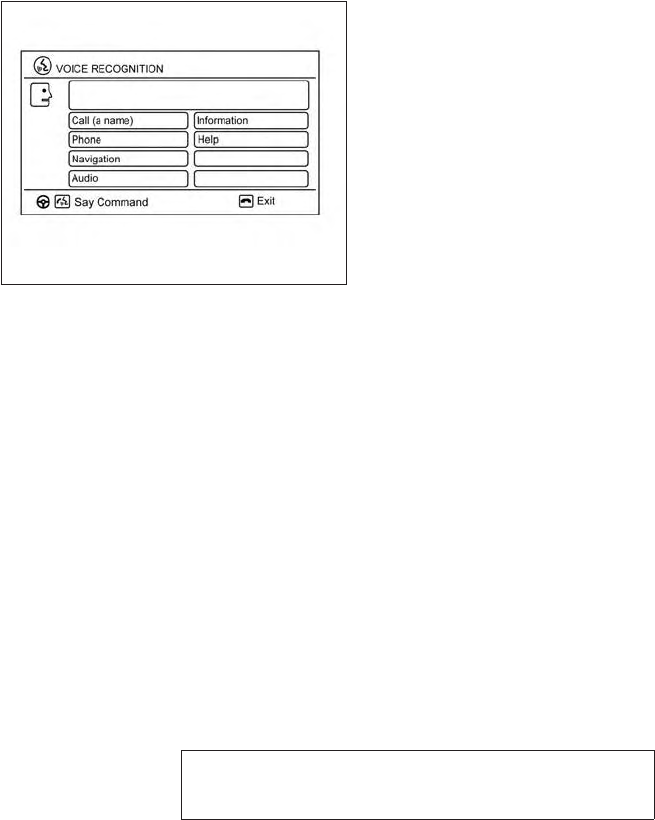
JOBNAME: 1093929-2013-asd-own PAGE: 268 SESS: 4 OUTPUT: Tue Mar 27 10:39:14 2012
●Wait until a tone sounds before speaking a
command. Otherwise, the command will not
be received properly.
●Start speaking a command within 3.5 sec-
onds after the tone sounds.
●Speak in a natural voice without pausing
between words.
SYSTEM FEATURES
NISSAN Voice Recognition can activate the fol-
lowing systems:
●Bluetooth Hands-Free Phone System
●Navigation
●Audio
●Information
For additional information on the navigation sys-
tem, see the separate Navigation System Own-
er’s Manual.
How to say numbers
NISSAN Voice Recognition requires a certain
way to speak numbers in voice commands. Refer
to the following examples.
General rule: Either “zero”or “oh” can be used for
“0”.
Phone numbers
Speak phone numbers according to the following
example. For 1-800-662-6200, say dial number
and then speak the phone number in any of the
following formats:
●“one eight oh oh six six two six two oh oh”
●“one eight hundred six six two six two oh oh”
●“one eight zero zero six six two six two oh oh”
For the best voice recognition phone dialing re-
sults, say phone numbers as single digits. Also,
full numbers can only be spoken for “800”. For
example, you cannot say 555-6000 as “five five
five six thousand”.
LHA2281
4-108 Monitor, climate, audio, phone and voice recognition systems
ZREVIEW COPY—
2013 Altima Sedan (asd)
Owners Manual—USA_English (nna)
03/24/12—dmoore
X

JOBNAME: 1093929-2013-asd-own PAGE: 269 SESS: 4 OUTPUT: Tue Mar 27 10:39:14 2012
BLUETOOTHTHANDS-FREE
PHONE SYSTEM VOICE
COMMANDS
To access the BluetoothTHands-Free Phone
System voice commands:
1. Press the button.
2. Say “Call” and then a name in the vehicle
phonebook to call that entry. Otherwise, say
“Phone” to access various phone com-
mands.
If the BluetoothThas been set to “Off”, the sys-
tem announces: “BluetoothTis off. Would you
like to turn BluetoothTon?”
If no phone is connected to the system and the
vehicle is stationary, the system announces:
“There is no phone connected. Would you like to
connect a phone now?” Say “Yes” to connect a
phone. All further BluetoothTHands-Free Phone
System voice commands are only available if a
phone is connected.
If a phone is connected and BluetoothTis set to
“On”, the following voice commands are avail-
able:
●Dial Number
Allows for up to 24 digits to be dialed. After
the number is entered, say “Dial” to initiate
dialing. Say “Correction”to correct the num-
ber entered. Say “Go Back” to return to the
main menu.
●List Phonebook
Starting with the first alphabetical entry in
the vehicle phonebook, the system prompts
for an additional command. Say “Dial” to call
the number of the phonebook entry. Say
“Send Text” to send a text message to the
number of the phonebook entry. Say “Next
Entry”to skip to the next alphabetical entry in
the vehicle phonebook, where the same op-
tions will then be available.
●Recent Calls
The system prompts for an additional com-
mand. Say “Missed Calls”, “Incoming Calls”
or “Outgoing Calls” to display a list of such
calls on the screen.
Speak the number of the entry displayed on
the screen to dial that number or say “Next
Page” to view entries on the next page (if
available).
●Redial
Redials the last called number.
●Read Text
Reads an incoming text message. For more
information about text messaging with the
BluetoothTHands-Free Phone System, see
“BluetoothTHands-Free Phone System
with Navigation System” in this section.
●Send Text
Sends a text message. For more information
about text messaging with the BluetoothT
Hands-Free Phone System, see
“BluetoothTHands-Free Phone System
with Navigation System” in this section.
●Select Phone
The system replies “Please use manual con-
trols to continue”. Use manual controls to
change the active phone from among the
listed phones connected to the vehicle.
For more information about the BluetoothT
Hands-Free Phone System, see “BluetoothT
Hands-Free Phone System with Navigation Sys-
tem” in this section.
Monitor, climate, audio, phone and voice recognition systems 4-109
ZREVIEW COPY—
2013 Altima Sedan (asd)
Owners Manual—USA_English (nna)
03/24/12—dmoore
X

JOBNAME: 1093929-2013-asd-own PAGE: 270 SESS: 4 OUTPUT: Tue Mar 27 10:39:14 2012
NAVIGATION SYSTEM VOICE
COMMANDS
The following voice commands are available for
the Navigation System:
●Places
●Street Address
●Address Book
●Home
●Previous Destination
For more information about these commands,
see the separate Navigation System Owner’s
Manual.
AUDIO SYSTEM VOICE
COMMANDS
To access the audio system voice commands:
1. Press the button.
2. Say “Audio”
3. Speak a command from the following avail-
able commands:
●FM
Switches the audio system to the FM mode.
●AM
Switches the audio system to the AM mode.
●XM (satellite radio, if so equipped)
Switches the audio system to the SiriusXM
Satellite Radio mode.
●CD
Switches the audio system to the CD mode.
A CD must be inserted for this command to
be functional.
●iPodT
Switches the audio system to the iPodT
mode. An iPodTmust be connected for this
command to be available and functional.
The following sub-commands are available
for iPodT:
– Now Playing
– Menu
– Playlists
– Artists
– Albums
– Genres
– Songs
– Shuffle Songs*
– Composers*
– Audiobooks*
– Podcasts*
* Say “Next Page” to access these com-
mands. Say “Previous Page” to return to the
first page of commands.
●USB
Switches the audio system to the USB
mode. A USB device must be inserted for
this command to be available and functional.
●Pandora
Switches the audio system to the Pandora
audio mode. A compatible BluetoothTaudio
device with a Pandora application must be
connected to the system for this command
to be functional.
●BluetoothT
Switches the audio system to the
BluetoothTaudio mode. A compatible
BluetoothTaudio device must be connected
to the system for this command to be func-
tional.
●AUX
Switches the audio system to the AUX
mode. An AUX device must be connected
for this command to be functional.
For more information about the audio system, see
“Audio system” in this section.
4-110 Monitor, climate, audio, phone and voice recognition systems
ZREVIEW COPY—
2013 Altima Sedan (asd)
Owners Manual—USA_English (nna)
03/24/12—dmoore
X

JOBNAME: 1093929-2013-asd-own PAGE: 271 SESS: 4 OUTPUT: Tue Mar 27 10:39:14 2012
INFORMATION VOICE COMMANDS
The following voice commands are available for
the information functions of the Navigation Sys-
tem:
●Traffic
●Current Weather
●Weather Forecast
●Google™ Send-To-Car
●POIs Powered by Google™
For more information about these commands,
see the separate Navigation System Owner’s
Manual.
HELP VOICE COMMANDS
The following voice commands can be spoken to
have the system provide instructions and tips for
using the NISSAN Voice Recognition system.
●List Commands
●What Can I Say?
●General Help
●Quit
●Exit
Monitor, climate, audio, phone and voice recognition systems 4-111
ZREVIEW COPY—
2013 Altima Sedan (asd)
Owners Manual—USA_English (nna)
03/24/12—dmoore
X
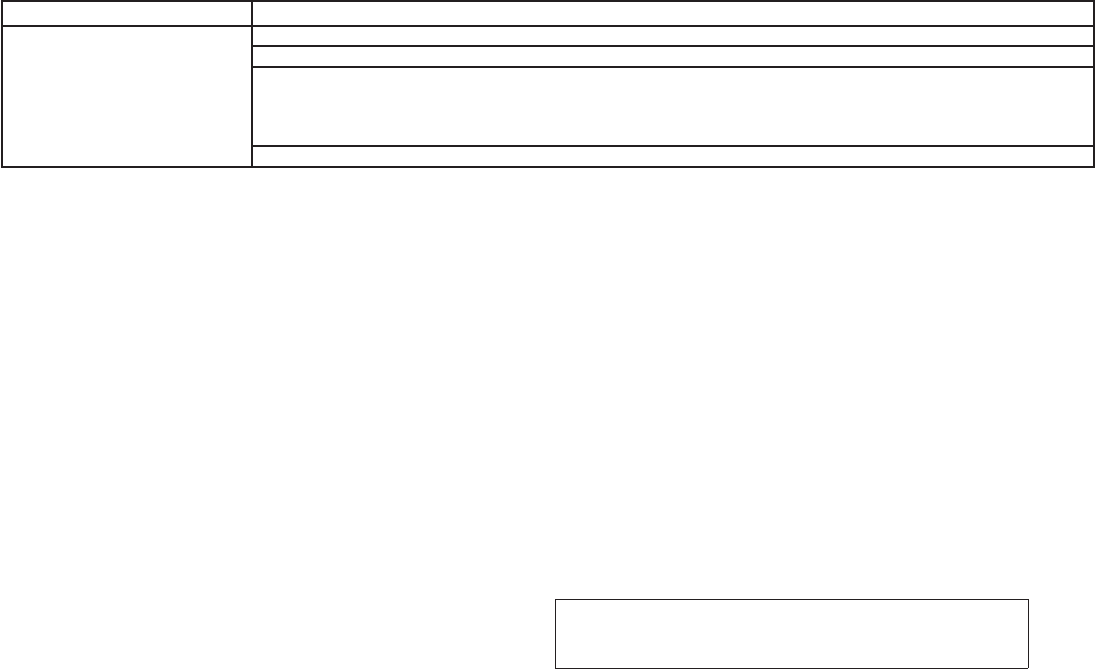
JOBNAME: 1093929-2013-asd-own PAGE: 272 SESS: 4 OUTPUT: Tue Mar 27 10:39:14 2012
TROUBLESHOOTING GUIDE
The system should respond correctly to all voice
commands without difficulty. If problems are en-
countered, follow the solutions given in this guide
for the appropriate error. Where the solutions are
listed by number, try each solution in turn, starting
with number one, until the problem is resolved.
Symptom/error message Solution
The system responds “Command Not
Recognized” or the system fails to rec-
ognize the command correctly.
1. Ensure that the command format is valid. Use the “List Commands” or “What Can I Say?” command under the “Help” menu.
2. Speak clearly without pausing between words and at a level appropriate to the ambient noise level.
3. Ensure that the ambient noise level is not excessive (for example, with the windows open or the defroster on).
NOTE:
If it is too noisy to use the phone, it is likely that voice commands will not be recognized.
4. If optional words of the command have been omitted, then the command should be tried with these in place.
4-112 Monitor, climate, audio, phone and voice recognition systems
ZREVIEW COPY—
2013 Altima Sedan (asd)
Owners Manual—USA_English (nna)
03/24/12—dmoore
X

JOBNAME: 1093929-2013-asd-own PAGE: 273 SESS: 5 OUTPUT: Tue Mar 27 10:39:14 2012
5 Starting and driving
Precautions when starting and driving. . . . . . . . . . . . . . . . 5-2
Exhaust gas (carbon monoxide) . . . . . . . . . . . . . . . . . . 5-2
Three-waycatalyst..............................5-2
Tire Pressure Monitoring System (TPMS). . . . . . . . . . 5-3
Avoiding collision and rollover. . . . . . . . . . . . . . . . . . . . 5-6
Off-roadrecovery...............................5-6
Rapidairpressureloss..........................5-7
Drinking alcohol/drugs and driving. . . . . . . . . . . . . . . . 5-8
Push-Button Ignition Switch . . . . . . . . . . . . . . . . . . . . . . . . 5-8
Operatingrange................................5-9
Ignition switch positions. . . . . . . . . . . . . . . . . . . . . . . . . 5-9
Emergency engine shut off . . . . . . . . . . . . . . . . . . . . .5-10
NISSAN Intelligent KeyTbattery discharge . . . . . . . 5-10
NISSAN vehicle immobilizer system . . . . . . . . . . . . .5-11
Before starting the engine . . . . . . . . . . . . . . . . . . . . . . . . .5-11
Startingtheengine ...............................5-12
Remote start (if so equipped) . . . . . . . . . . . . . . . . . . .5-12
Drivingthevehicle................................5-13
Continuously Variable Transmission (CVT). . . . . . . .5-13
Parkingbrake....................................5-19
Cruise control (if so equipped) . . . . . . . . . . . . . . . . . . . . .5-19
Precautions on cruise control . . . . . . . . . . . . . . . . . . .5-19
Cruise control operations. . . . . . . . . . . . . . . . . . . . . . . 5-19
Break-in schedule . . . . . . . . . . . . . . . . . . . . . . . . . . . . . . . .5-20
Increasing fuel economy. . . . . . . . . . . . . . . . . . . . . . . . . . . 5-21
Parking/parking on hills. . . . . . . . . . . . . . . . . . . . . . . . . . . .5-22
Power steering system . . . . . . . . . . . . . . . . . . . . . . . . . . . .5-23
Brake system . . . . . . . . . . . . . . . . . . . . . . . . . . . . . . . . . . . .5-23
Brakeprecautions.............................5-23
Anti-lock Braking System (ABS). . . . . . . . . . . . . . . . .5-24
Brakeassist ..................................5-25
Vehicle Dynamic Control (VDC) system . . . . . . . . . . . . .5-25
Cold weather driving. . . . . . . . . . . . . . . . . . . . . . . . . . . . . .5-27
Freeing a frozen door lock . . . . . . . . . . . . . . . . . . . . . .5-27
Anti-freeze. . . . . . . . . . . . . . . . . . . . . . . . . . . . . . . . . . . .5-27
Battery . . . . . . . . . . . . . . . . . . . . . . . . . . . . . . . . . . . . . . .5-27
Draining of coolant water . . . . . . . . . . . . . . . . . . . . . . .5-27
Tireequipment................................5-27
Special winter equipment. . . . . . . . . . . . . . . . . . . . . . .5-28
Drivingonsnoworice .........................5-28
Engine block heater (if so equipped) . . . . . . . . . . . . .5-28
ZREVIEW COPY—
2013 Altima Sedan (asd)
Owners Manual—USA_English (nna)
03/24/12—dmoore
X
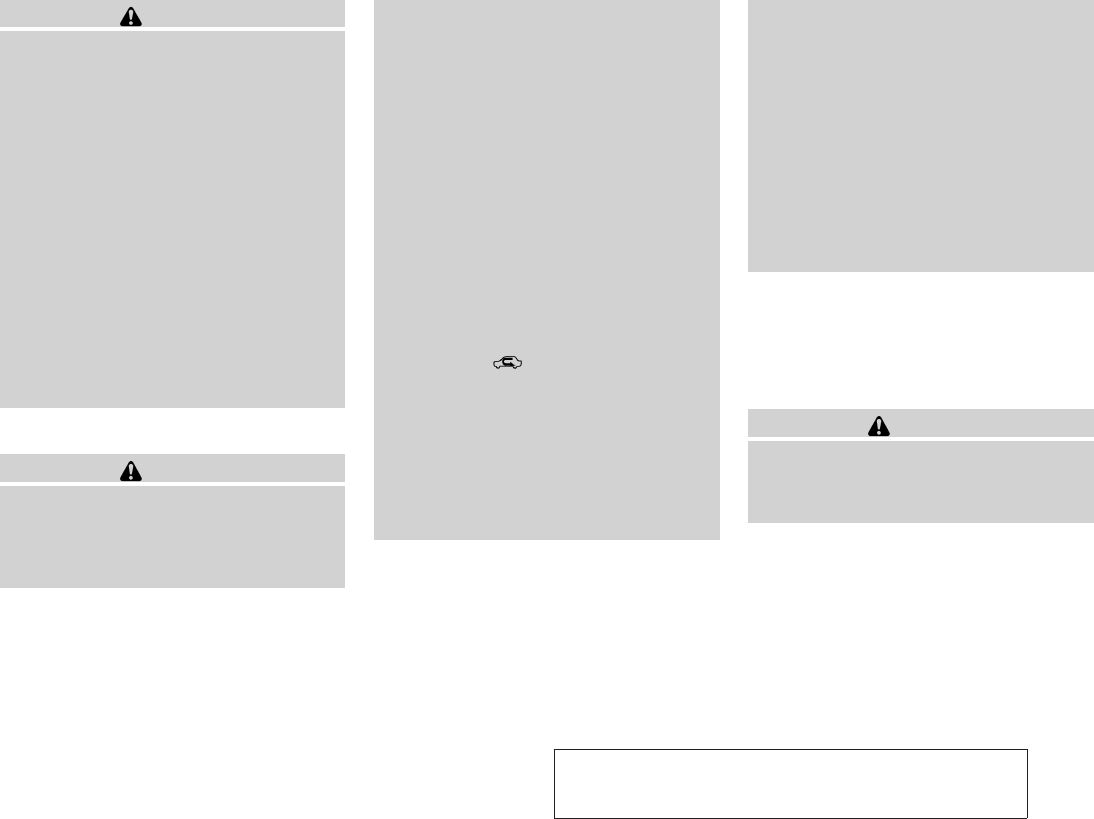
JOBNAME: 1093929-2013-asd-own PAGE: 274 SESS: 4 OUTPUT: Tue Mar 27 10:39:14 2012
WARNING
●Do not leave children or adults who
would normally require the assistance
of others alone in your vehicle. Pets
should also not be left alone. They
could accidentally injure themselves or
others through inadvertent operation of
the vehicle. Also, on hot, sunny days,
temperatures in a closed vehicle could
quickly become high enough to cause
severe or possibly fatal injuries to
people or animals.
●Closely supervise children when they
are around cars to prevent them from
playing and becoming locked in the
trunk where they could be seriously in-
jured. Keep the car locked, with the rear
seatback and trunk lid securely latched
when not in use, and prevent children’s
access to car keys.
EXHAUST GAS (carbon monoxide)
WARNING
●Do not breathe exhaust gases; they
contain colorless and odorless carbon
monoxide. Carbon monoxide is danger-
ous. It can cause unconsciousness or
death.
●If you suspect that exhaust fumes are
entering the vehicle, drive with all win-
dows fully open, and have the vehicle
inspected immediately.
●Do not run the engine in closed spaces
such as a garage.
●Do not park the vehicle with the engine
running for any extended length of time.
●Keep the rear vent windows, lift gates,
doors and trunk lids (if so equipped)
closed while driving, otherwise exhaust
gases could be drawn into the passen-
ger compartment. If you must drive with
one of these open, follow these
precautions:
1. Open all the windows.
2. Set the air recirculation but-
ton to off and the fan control dial to
high to circulate the air.
●If electrical wiring or other cable con-
nections must pass to a trailer through
the seal on the trunk lid or the body,
follow the manufacturer’s recommen-
dation to prevent carbon monoxide en-
try into the vehicle.
●The exhaust system and body should be
inspected by a qualified mechanic
whenever:
a. The vehicle is raised for service.
b. You suspect that exhaust fumes are
entering into the passenger
compartment.
c. You notice a change in the sound of
the exhaust system.
d. You have had an accident involving
damage to the exhaust system, un-
derbody, or rear of the vehicle.
THREE-WAY CATALYST
The three-way catalyst is an emission control
device installed in the exhaust system. Exhaust
gases in the three-way catalyst are burned at
high temperatures to help reduce pollutants.
WARNING
●The exhaust gas and the exhaust sys-
tem are very hot. Keep people, animals
or flammable materials away from the
exhaust system components.
PRECAUTIONS WHEN STARTING
AND DRIVING
5-2 Starting and driving
ZREVIEW COPY—
2013 Altima Sedan (asd)
Owners Manual—USA_English (nna)
03/24/12—dmoore
X

JOBNAME: 1093929-2013-asd-own PAGE: 275 SESS: 4 OUTPUT: Tue Mar 27 10:39:14 2012
●Do not stop or park the vehicle over
flammable materials such as dry grass,
waste paper or rags. They may ignite
and cause a fire.
CAUTION
●Do not use leaded gasoline. Deposits
from leaded gasoline will seriously re-
duce the three-way catalyst’s ability to
help reduce exhaust pollutants.
●Keep your engine tuned up. Malfunc-
tions in the ignition, fuel injection, or
electrical systems can cause overrich
fuel flow into the three-way catalyst,
causing it to overheat. Do not keep driv-
ing if the engine misfires, or if notice-
able loss of performance or other un-
usual operating conditions are
detected. Have the vehicle inspected
promptly by a NISSAN dealer.
●Avoid driving with an extremely low fuel
level. Running out of fuel could cause
the engine to misfire, damaging the
three-way catalyst.
●Do not race the engine while warming it
up.
●Do not push or tow your vehicle to start
the engine.
TIRE PRESSURE MONITORING
SYSTEM (TPMS)
Each tire, including the spare (if provided),
should be checked monthly when cold and in-
flated to the inflation pressure recommended by
the vehicle manufacturer on the vehicles tire and
loading information label. (If your vehicle has tires
of a different size than the size indicated on the
vehicle tire and loading information label, you
should determine the proper tire inflation pres-
sure for those tires.)
As an added safety feature, your vehicle has been
equipped with a Tire Pressure Monitoring System
(TPMS) that illuminates a low tire pressure telltale
when one or more of your tires is significantly
under-inflated. Accordingly, when the low tire
pressure telltale illuminates, you should stop and
check your tires as soon as possible, and inflate
them to the proper pressure. Driving on a signifi-
cantly under-inflated tire causes the tire to over-
heat and can lead to tire failure. Under-inflation
also reduces fuel efficiency and tire tread life, and
may affect the vehicle’s handling and stopping
ability.
Please note that the TPMS is not a substitute for
proper tire maintenance, and it is the driver’s
responsibility to maintain correct tire pressure,
even if under-inflation has not reached the level to
trigger illumination of the TPMS low tire pressure
telltale.
Your vehicle has also been equipped with a
TPMS malfunction indicator to indicate when the
system is not operating properly. The TPMS mal-
function indicator is combined with the low tire
pressure telltale. When the system detects a
malfunction, the telltale will flash for approxi-
mately one minute and then remain continuously
illuminated. This sequence will continue upon
subsequent vehicle start-ups as long as the mal-
function exists. When the malfunction indicator is
illuminated, the system may not be able to detect
or signal low tire pressure as intended. TPMS
malfunctions may occur for a variety of reasons,
including the installation of replacement or alter-
nate tires or wheels on the vehicle that prevent
the TPMS from functioning properly. Always
check the TPMS malfunction telltale after replac-
ing one or more tires or wheels on your vehicle to
ensure that the replacement or alternate tires and
wheels allow the TPMS to continue to function
properly.
Additional information:
●The TPMS does not monitor the tire
pressure of the spare tire.
Starting and driving 5-3
ZREVIEW COPY—
2013 Altima Sedan (asd)
Owners Manual—USA_English (nna)
03/24/12—dmoore
X

JOBNAME: 1093929-2013-asd-own PAGE: 276 SESS: 4 OUTPUT: Tue Mar 27 10:39:14 2012
●The TPMS will activate only when the vehicle
is driven at speeds above 16 MPH (25
km/h). Also, this system may not detect a
sudden drop in tire pressure (for example a
flat tire while driving).
●The low tire pressure warning light does not
automatically turn off when the tire pressure
is adjusted on all 4 tires. After all 4 tires are
inflated to the recommended pressure, the
vehicle must be driven at speeds above 16
MPH (25 km/h) to activate the TPMS and
turn off the low tire pressure warning light.
Use a tire pressure gauge to check the tire
pressure.
●The “Tire Pressure Low - Add Air” warning
appears in the vehicle information display
when the low tire pressure warning light is
illuminated and low tire pressure is detected.
The “Tire Pressure Low - Add Air” warning
turns off when the low tire pressure warning
light turns off.
●The “Tire Pressure Low - Add Air” warning
does not appear if the low tire pressure
warning light illuminates to indicate a TPMS
malfunction.
●Tire pressure rises and falls depending on
the heat caused by the vehicle’s operation
and the outside temperature. Low outside
temperature can lower the temperature of
the air inside the tire which can cause a
lower tire inflation pressure. This may cause
the low tire pressure warning light to illumi-
nate. If the warning light illuminates in low
ambient temperature, check the tire pres-
sure for all four tires.
●The Tire and Loading Information label (also
referred to as the vehicle placard or tire
inflation pressure label) is located in the
driver’s door opening.
●You can also check the tire pressure of all
tires (expect the spare) on the vehicle infor-
mation display screen (if so equipped). The
order of the tire pressure figures displayed
on the screen corresponds with the actual
order of the tire position.
For additional information, see “Low tire pressure
warning light” in the “Instruments and controls”
section, “Tire Pressure Monitoring System
(TPMS)” in the “In case of emergency” section
and “Tire Pressure” in the “Maintenance and do-
it-yourself” section.
WARNING
●Radio waves could adversely affect
electric medical equipment. Those who
use a pacemaker should contact the
electric medical equipment manufac-
turer for the possible influences before
use.
●If the low tire pressure warning light
illuminates while driving, avoid sudden
steering maneuvers or abrupt braking,
reduce vehicle speed, pull off the road
to a safe location and stop the vehicle
as soon as possible. Driving with under-
inflated tires may permanently damage
the tires and increase the likelihood of
tire failure. Serious vehicle damage
could occur and may lead to an acci-
dent and could result in serious per-
sonal injury. Check the tire pressure for
all four tires. Adjust the tire pressure to
the recommended COLD tire pressure
shown on the tire and loading informa-
tion label to turn the low tire pressure
warning light OFF. If you have a flat tire,
replace it with a spare tire as soon as
possible. (See “Flat tire” in the “In case
of emergency” section for changing a
flat tire.)
5-4 Starting and driving
ZREVIEW COPY—
2013 Altima Sedan (asd)
Owners Manual—USA_English (nna)
03/24/12—dmoore
X

JOBNAME: 1093929-2013-asd-own PAGE: 277 SESS: 4 OUTPUT: Tue Mar 27 10:39:14 2012
●When a spare tire is mounted or a wheel
is replaced, tire pressure will not be
indicated, the TPMS will not function
and the low tire pressure warning light
will flash for approximately 1 minute.
The light will remain on after 1 minute.
Contact your NISSAN dealer as soon as
possible for tire replacement and/or
system resetting.
●Replacing tires with those not originally
specified by NISSAN could affect the
proper operation of the TPMS.
●Do not inject any tire liquid or aerosol
tire sealant into the tires, as this may
cause a malfunction of the tire pressure
sensors.
CAUTION
Do not place metalized film or any metal
parts (antenna, etc.) on the windows. This
may cause poor reception of the signals
from the tire pressure sensors, and the
TPMS will not function properly.
Some devices and transmitters may temporarily
interfere with the operation of the TPMS and
cause the low tire pressure warning light to illu-
minate.
Some examples are:
– Facilities or electric devices using similar radio
frequencies are near the vehicle.
– If a transmitter set to similar frequencies is
being used in or near the vehicle.
– If a computer (or similar equipment) or a
DC/AC converter is being used in or near the
vehicle.
FCC Notice:
For USA:
This device complies with Part 15 of the
FCC Rules. Operation is subject to the fol-
lowing two conditions:
1. This device may not cause harmful in-
terference, and
2. This device must accept any interfer-
ence received, including interference
that may cause undesired operation.
Note: Changes or modification not ex-
pressly approved by the party respon-
sible for compliance could void the us-
er’s authority to operate the
equipment.
For Canada:
This device complies with RSS-210 of In-
dustry Canada. Operation is subject to the
following two conditions:
1. This device may not cause interfer-
ence, and
2. This device must accept any interfer-
ence, include interference that may
cause undesired operation of the de-
vice.
TPMS with Easy Fill Tire Alert
When adding air to an under-inflated tire, the
TPMS with Easy Fill Tire Alert provides visual and
audible signals outside the vehicle to help you
inflate the tires to the recommended COLD tire
pressure.
Vehicle set-up:
1. Park the vehicle in a safe and level place.
2. Apply the parking brake and place the shift
selector to the P (Park) position.
3. Place the ignition switch to the ON position.
Do not start the engine.
Starting and driving 5-5
ZREVIEW COPY—
2013 Altima Sedan (asd)
Owners Manual—USA_English (nna)
03/24/12—dmoore
X

JOBNAME: 1093929-2013-asd-own PAGE: 278 SESS: 4 OUTPUT: Tue Mar 27 10:39:14 2012
Operation:
1. Add air to the tire.
2. After a few seconds, the hazard indicators
will start flashing.
3. When the designated pressure is reached,
the horn beeps once and the hazard indica-
tors stop flashing.
4. Perform the above steps for each tire.
●If the tire is over-inflated more than ap-
proximately 4 psi (30 kPa), the horn
beeps and the hazard indicators flash 3
times. To correct the pressure, push the
core of the valve stem on the tire briefly to
release pressure. When the pressure
reaches the designated pressure, the
horn beeps once.
●If the hazard indicator does not flash
within approximately 15 seconds after
starting to inflate the tire, it indicates that
the Easy Fill Tire Alert is not operating.
●The TPMS will not activate the Easy Fill
Tire Alert under the following conditions:
– If there is interference from an external
device or transmitter.
– The air pressure from the inflation device
is not sufficient to inflate the tire.
– There is a malfunction in the TPMS sys-
tem.
– There is a malfunction in the horn or haz-
ard indicators.
– The identification code of the tires pres-
sure sensor is not registered to the sys-
tem.
– The battery of the tire pressure sensor is
low.
●If the Easy Fill Tire Alert does not operate
due to TPMS interference, move the ve-
hicle about 3 ft (1 m) backward or forward
and try again.
If the Easy Fill Tire Alert is not working, use a tire
pressure gauge.
AVOIDING COLLISION AND
ROLLOVER
WARNING
Failure to operate this vehicle in a safe
and prudent manner may result in loss of
control or an accident.
Be alert and drive defensively at all times. Obey
all traffic regulations. Avoid excessive speed,
high speed cornering, or sudden steering ma-
neuvers, because these driving practices could
cause you to lose control of your vehicle. As with
any vehicle, loss of control could result in a
collision with other vehicles or objects or
cause the vehicle to roll over, particularly if
the loss of control causes the vehicle to
slide sideways. Be attentive at all times, and
avoid driving when tired. Never drive when under
the influence of alcohol or drugs (including pre-
scription or over-the-counter drugs which may
cause drowsiness). Always wear your seat belt
as outlined in the “Safety – Seats, seat belts and
supplemental restraint system” section of this
manual, and also instruct your passengers to do
so.
Seat belts help reduce the risk of injury in colli-
sions and rollovers. In a rollover crash, an
unbelted or improperly belted person is
significantly more likely to be injured or
killed than a person properly wearing a
seat belt.
OFF-ROAD RECOVERY
If the right side or left side wheels unintentionally
leave the road surface, maintain control of the
vehicle by following the procedure below. Please
note that this procedure is only a general guide.
The vehicle must be driven as appropriate based
on the conditions of the vehicle, road and traffic.
1. Remain calm and do not overreact.
5-6 Starting and driving
ZREVIEW COPY—
2013 Altima Sedan (asd)
Owners Manual—USA_English (nna)
03/24/12—dmoore
X

JOBNAME: 1093929-2013-asd-own PAGE: 279 SESS: 4 OUTPUT: Tue Mar 27 10:39:14 2012
2. Do not apply the brakes.
3. Maintain a firm grip on the steering wheel
with both hands and try to hold a straight
course.
4. When appropriate, slowly release the accel-
erator pedal to gradually slow the vehicle.
5. If there is nothing in the way, steer the ve-
hicle to follow the road while vehicle speed
is reduced. Do not attempt to drive the ve-
hicle back onto the road surface until vehicle
speed is reduced.
6. When it is safe to do so, gradually turn the
steering wheel until both tires return to the
road surface. When all tires are on the road
surface, steer the vehicle to stay in the ap-
propriate driving lane.
●If you decide that it is not safe to return the
vehicle to the road surface based on vehicle,
road or traffic conditions, gradually slow the
vehicle to a stop in a safe place off the road.
RAPID AIR PRESSURE LOSS
Rapid air pressure loss or a “blow-out” can occur
if the tire is punctured or is damaged due to
hitting a curb or pothole. Rapid air pressure loss
can also be caused by driving on under-inflated
tires.
Rapid air pressure loss can affect the handling
and stability of the vehicle, especially at highway
speeds.
Help prevent rapid air pressure loss by maintain-
ing the correct air pressure and visually inspect
the tires for wear and damage. See “Wheels and
tires” in the “Maintenance and do-it-yourself”
section of this manual. If a tire rapidly loses air
pressure or “blows-out” while driving, maintain
control of the vehicle by following the procedure
below. Please note that this procedure is only a
general guide. The vehicle must be driven as
appropriate based on the conditions of the ve-
hicle, road and traffic.
WARNING
The following actions can increase the
chance of losing control of the vehicle if
there is a sudden loss of tire air pressure.
Losing control of the vehicle may cause a
collision and result in personal injury.
●The vehicle generally moves or pulls in
the direction of the flat tire.
●Do not rapidly apply the brakes.
●Do not rapidly release the accelerator
pedal.
●Do not rapidly turn the steering wheel.
1. Remain calm and do not over react.
2. Maintain a firm grip on the steering wheel
with both hands and try to hold a straight
course.
3. When appropriate, slowly release the accel-
erator pedal to gradually slow the vehicle.
4. Gradually steer the vehicle to a safe location
off the road and away from traffic if possible.
5. Lightly apply the brake pedal to gradually
stop the vehicle.
6. Turn on the hazard warning flashers and
either contact a roadside emergency service
to change the tire or see “Changing a flat
tire” in the “In case of emergency” section of
this manual.
Starting and driving 5-7
ZREVIEW COPY—
2013 Altima Sedan (asd)
Owners Manual—USA_English (nna)
03/24/12—dmoore
X
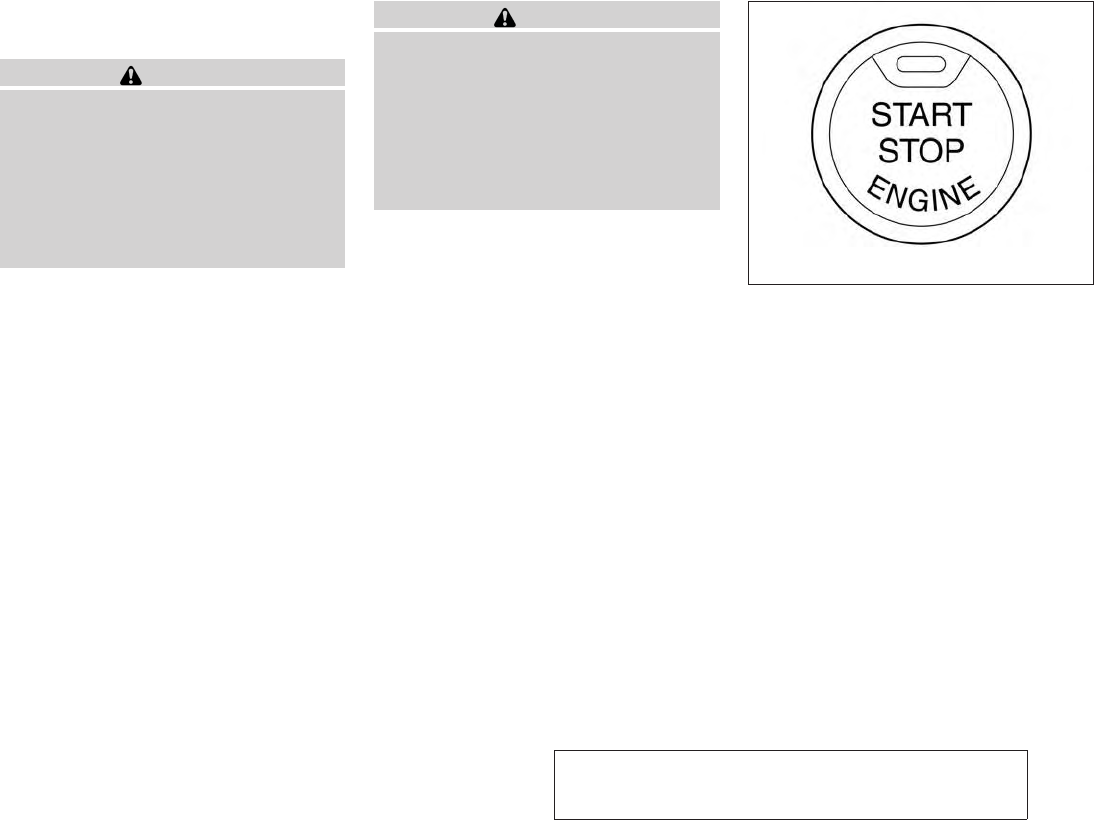
JOBNAME: 1093929-2013-asd-own PAGE: 280 SESS: 4 OUTPUT: Tue Mar 27 10:39:14 2012
DRINKING ALCOHOL/DRUGS AND
DRIVING
WARNING
Never drive under the influence of alcohol
or drugs. Alcohol in the bloodstream re-
duces coordination, delays reaction time
and impairs judgement. Driving after
drinking alcohol increases the likelihood
of being involved in an accident injuring
yourself and others. Additionally, if you
are injured in an accident, alcohol can
increase the severity of the injury.
NISSAN is committed to safe driving. However,
you must choose not to drive under the influence
of alcohol. Every year thousands of people are
injured or killed in alcohol-related accidents. Al-
though the local laws vary on what is considered
to be legally intoxicated, the fact is that alcohol
affects all people differently and most people
underestimate the effects of alcohol.
Remember, drinking and driving don’t mix! And
that is true for drugs, too (over-the-counter, pre-
scription, and illegal drugs). Don’t drive if your
ability to operate your vehicle is impaired by alco-
hol, drugs, or some other physical condition.
WARNING
Do not operate the push-button ignition
switch while driving the vehicle except in
an emergency. (The engine will stop when
the ignition switch is pushed 3 consecu-
tive times in quick succession or the igni-
tion switch is pushed and held for more
than 2 seconds.) If the engine stops while
the vehicle is being driven, this could lead
to a crash and serious injury.
When the ignition switch is pushed without de-
pressing the brake pedal, the ignition switch will
illuminate.
Push the ignition switch center:
●once to change to ACC.
●two times to change to ON.
●three times to return to OFF.
The ignition switch will automatically return to the
LOCK position when any door is either opened or
closed with the switch in the OFF position.
LSD2014
PUSH-BUTTON IGNITION SWITCH
5-8 Starting and driving
ZREVIEW COPY—
2013 Altima Sedan (asd)
Owners Manual—USA_English (nna)
03/24/12—dmoore
X
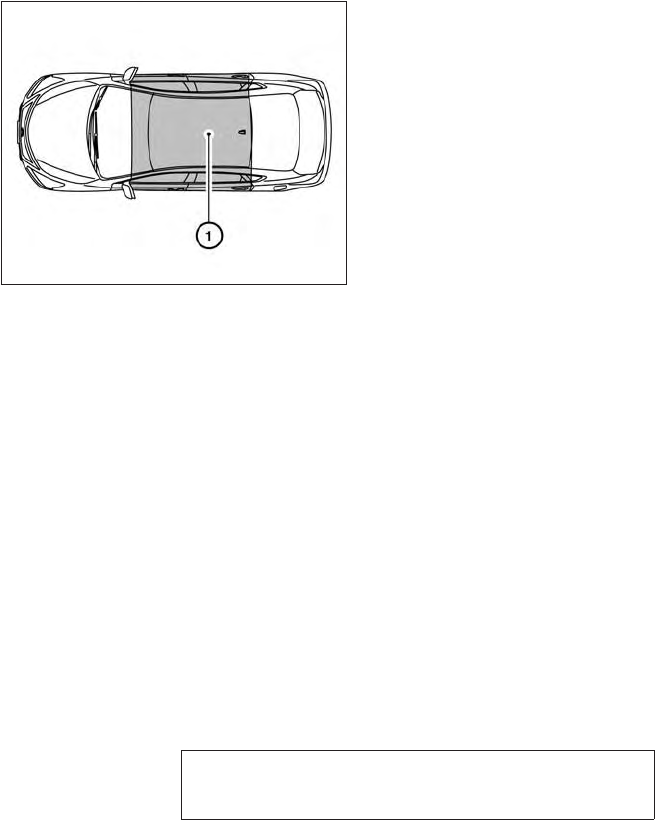
JOBNAME: 1093929-2013-asd-own PAGE: 281 SESS: 4 OUTPUT: Tue Mar 27 10:39:14 2012
The ignition lock is designed so that the ignition
switch position cannot be switched to OFF until
the shift selector is moved to the P (Park) posi-
tion.
When the ignition switch cannot be pushed to-
ward the OFF position, proceed as follows:
1. Move the shift selector into the P (Park)
position.
2. Push the ignition switch. The ignition switch
position will change to the ON position.
3. Push the ignition switch again to the OFF
position.
The shift selector can be moved from the P
(Park) position if the ignition switch is in
the ON position and the brake pedal is
depressed.
If the battery of the vehicle is discharged,
the push-button ignition switch cannot be
moved from the LOCK position.
Some indicators and warnings for operation are
displayed on the vehicle information display. See
“Vehicle information display” in the “Instruments
and controls” section of this manual.
OPERATING RANGE
The Intelligent Key functions can only be used
when the Intelligent Key is within the specified
operating range.
When the Intelligent Key battery is almost dis-
charged or strong radio waves are present near
the operating location, the Intelligent Key sys-
tem’s operating range becomes narrower and
may not function properly.
If the Intelligent Key is within the operating range,
it is possible for anyone, even someone who does
not carry the Intelligent Key, to turn the ignition
switch to start the engine.
The operating range of the engine start function
is inside of the vehicle s
1.
●The luggage area is not included in the op-
erating range, but the Intelligent Key may
function.
●If the Intelligent Key is placed on the instru-
ment panel, inside the glove box, storage bin
or door pocket, the Intelligent Key may not
function.
●If the Intelligent Key is placed near the door
or window outside the vehicle, the Intelligent
Key may function.
IGNITION SWITCH POSITIONS
LOCK (Normal parking position) :
The ignition switch can only be locked in the
LOCK position.
The ignition switch will be unlocked when it is
placed in the ACC position while carrying the
Intelligent Key.
OFF:
The ignition switch is in the OFF position when
the engine is turned off using the ignition switch.
No lights will illuminate on the ignition switch.
LSD2089
Starting and driving 5-9
ZREVIEW COPY—
2013 Altima Sedan (asd)
Owners Manual—USA_English (nna)
03/24/12—dmoore
X
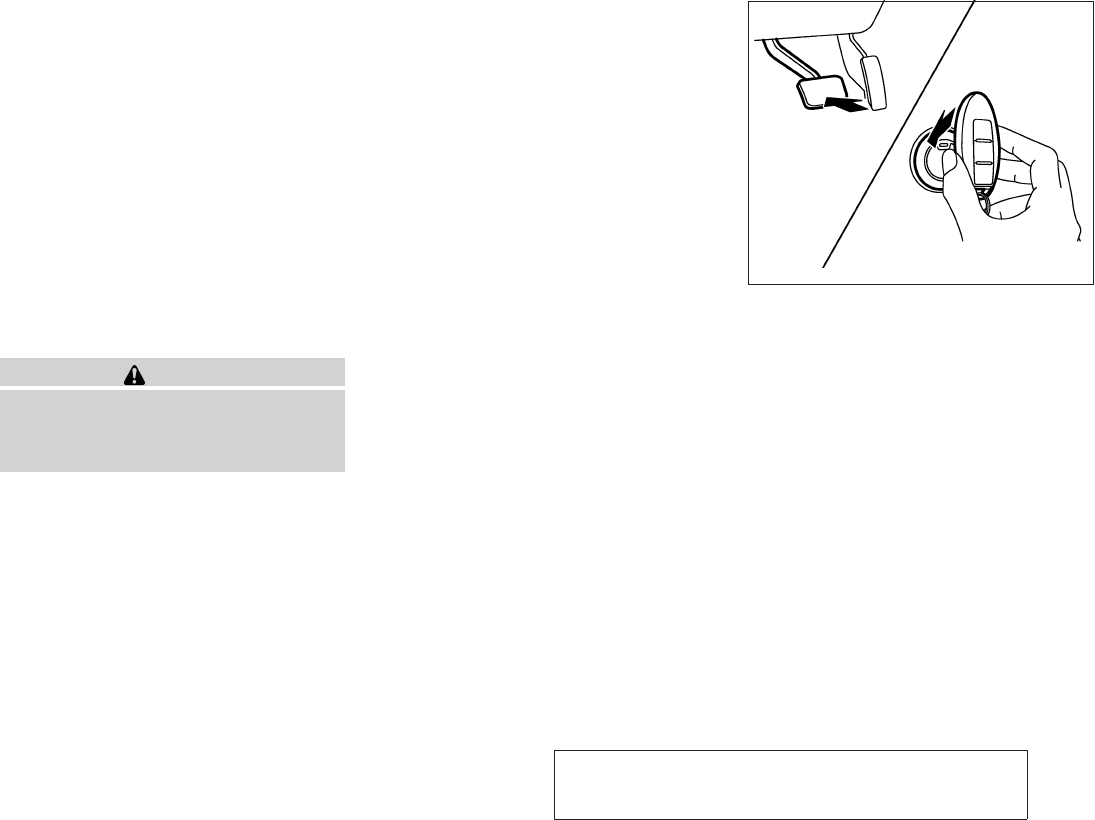
JOBNAME: 1093929-2013-asd-own PAGE: 282 SESS: 4 OUTPUT: Tue Mar 27 10:39:14 2012
ACC (Accessories) :
This position activates electrical accessories,
such as the radio, when the engine is not running.
ACC has a battery saver feature that will turn the
ignition switch to the OFF position after 30 min-
utes under the following conditions:
●all doors are closed
●shift selector is in P (Park)
●any door is opened
●shift selector is moved out of P (Park)
●ignition switch changes position
ON (Normal operating position) :
This position turns on the ignition system and the
electrical accessories.
CAUTION
Do not leave the vehicle with the ignition
switch in ACC or ON positions when the
engine is not running for an extended pe-
riod. This can discharge the battery.
EMERGENCY ENGINE SHUT OFF
To shut off the engine in an emergency situation
while driving, perform the following procedure:
– Rapidly push the push-button ignition switch 3
consecutive times in less than 1.5 seconds, or
– Push and hold the push-button ignition switch
for more than 2 seconds.
NISSAN INTELLIGENT KEYT
BATTERY DISCHARGE
If the battery of the NISSAN Intelligent KeyTis
discharged, or environmental conditions interfere
with the Intelligent Key operation, start the engine
according to the following procedure:
1. Place the shift selector in the P (Park) posi-
tion.
2. Firmly apply the foot brake.
3. Touch the ignition switch with the Intelligent
Key as illustrated. (A chime will sound.)
SSD0860
5-10 Starting and driving
ZREVIEW COPY—
2013 Altima Sedan (asd)
Owners Manual—USA_English (nna)
03/24/12—dmoore
X

JOBNAME: 1093929-2013-asd-own PAGE: 283 SESS: 4 OUTPUT: Tue Mar 27 10:39:14 2012
4. Push the ignition switch while depressing
the brake pedal within 10 seconds after the
chime sounds. The engine will start.
After step 3 is performed, when the ignition
switch is pushed without depressing the brake
pedal, the ignition switch position will change to
ACC.
NOTE:
●When the ignition switch is pushed to the
ACC or ON position or the engine is started
by the above procedure, the Intelligent Key
battery discharge indicator appears in the
vehicle information display even when the
Intelligent Key is inside the vehicle. This is
not a malfunction. To turn off the Intelligent
Key battery discharge indicator, touch the
ignition switch with the Intelligent Key again.
●If the Intelligent Key battery discharge indi-
cator appears, replace the battery as soon
as possible. See “NISSAN Intelligent KeyT
replacement” in the “Maintenance and do-it-
yourself” section.
NISSAN VEHICLE IMMOBILIZER
SYSTEM
The NISSAN Vehicle Immobilizer system will not
allow the engine to start without the use of the
registered key.
If the engine fails to start using a registered key
(for example, when interference is caused by
another registered key, an automated toll road
device or automatic payment device on the key
ring), restart the engine using the following pro-
cedure:
1. Leave the ignition switch in the ON position
for approximately 5 seconds.
2. Place the ignition switch in the OFF or
LOCK position, and wait approximately 10
seconds.
3. Repeat steps 1 and 2.
4. Restart the engine while holding the device
(which may have caused the interference)
separate from the registered key.
If the no start condition re-occurs, NISSAN rec-
ommends placing the registered key on a sepa-
rate key ring to avoid interference from other
devices.
●Make sure the area around the vehicle is
clear.
●Check fluid levels such as engine oil, cool-
ant, brake fluid, and windshield-washer fluid
as frequently as possible, or at least when-
ever you refuel.
●Check that all windows and lights are clean.
●Visually inspect tires for their appearance
and condition. Also check tires for proper
inflation.
●Lock all doors.
●Position seat and adjust head restraints.
●Adjust inside and outside mirrors.
●Fasten seat belts and ask all passengers to
do likewise.
●Check the operation of warning lights when
the ignition switch is pushed to the ON
position. See “Warning/indicator lights and
audible reminders” in the “Instruments and
controls” section of this manual.
BEFORE STARTING THE ENGINE
Starting and driving 5-11
ZREVIEW COPY—
2013 Altima Sedan (asd)
Owners Manual—USA_English (nna)
03/24/12—dmoore
X

JOBNAME: 1093929-2013-asd-own PAGE: 284 SESS: 4 OUTPUT: Tue Mar 27 10:39:14 2012
1. Apply the parking brake.
2. Move the shift selector to P (Park) or N
(Neutral). P (Park) is recommended.
The starter is designed not to operate if
the shift selector is in any of the driving
positions.
3. Push the ignition switch to the ON position.
Depress the brake pedal and push the igni-
tion switch to start the engine.
To start the engine immediately, push and
release the ignition switch while depressing
the brake pedal with the ignition switch in
any position.
●If the engine is very hard to start in ex-
tremely cold weather or when restarting,
depress the accelerator pedal a little (ap-
proximately 1/3 to the floor) and while
holding, crank the engine. Release the
accelerator pedal when the engine starts.
●If the engine is very hard to start because
it is flooded, depress the accelerator
pedal all the way to the floor and hold it.
Push the ignition switch to the ON posi-
tion to start cranking the engine. After 5 or
6 seconds, stop cranking by pushing the
ignition switch to LOCK. After cranking
the engine, release the accelerator pedal.
Crank the engine with your foot off the
accelerator pedal by depressing the
brake pedal and pushing the push-button
ignition switch to start the engine. If the
engine starts, but fails to run, repeat the
above procedure.
CAUTION
Do not operate the starter for more than
15 seconds at a time. If the engine does
not start, push the ignition switch to the
OFF position and wait 10 seconds before
cranking again, otherwise the starter
could be damaged.
4. Warm-up
Allow the engine to idle for at least 30 sec-
onds after starting. Do not race the engine
while warming it up. Drive at moderate
speed for a short distance first, especially in
cold weather. In cold weather, keep the en-
gine running for a minimum of 2 - 3 minutes
before shutting it off. Starting and stopping
the engine over a short period of time may
make the vehicle more difficult to start.
5. To stop the engine, shift the shift selector to
the P (Park) position and push the ignition
switch to the OFF position.
NOTE:
Care should be taken to avoid situations
that can lead to potential battery discharge
and potential no-start conditions such as:
1. Installation or extended use of electronic
accessories that consume battery power
when the engine is not running (Phone char-
gers, GPS, DVD players, etc.)
2. Vehicle is not driven regularly and/or only
driven short distances. In these cases, the
battery may need to be charged to maintain
battery health.
REMOTE START (if so equipped)
Vehicles started with the remote start require the
ignition switch to be placed in the ON position
before the shift selector can be moved from the P
(Park) position. To place the ignition switch to the
ON position, follow these steps:
1. Make sure that the Intelligent Key is on you.
2. Apply the brake.
3. Press the ignition switch once to the ON
position.
For additional information, see “NISSAN Intelli-
gent Key” in the “Pre-driving checks and adjust-
ments” section of this manual.
STARTING THE ENGINE
5-12 Starting and driving
ZREVIEW COPY—
2013 Altima Sedan (asd)
Owners Manual—USA_English (nna)
03/24/12—dmoore
X

JOBNAME: 1093929-2013-asd-own PAGE: 285 SESS: 4 OUTPUT: Tue Mar 27 10:39:14 2012
CONTINUOUSLY VARIABLE
TRANSMISSION (CVT)
WARNING
●Do not depress the accelerator pedal
while shifting from P (Park) or N (Neu-
tral) to R (Reverse), D (Drive), Ds (Drive
Sport) or manual shift mode (if so
equipped). Always depress the brake
pedal until shifting is completed. Fail-
ure to do so could cause you to lose
control and have an accident.
●Cold engine idle speed is high, so use
caution when shifting into a forward or
reverse gear before the engine has
warmed up.
●Do not downshift abruptly on slippery
roads. This may cause a loss of control.
●Never shift to P (Park) or R (Reverse)
while the vehicle is moving. This could
cause an accident.
●Except in an emergency, do not shift to
the N (Neutral) position while driving.
Doing so can cause a loss of engine
braking which may result in a collision,
serious personal injury or death. In ad-
dition, coasting with the transmission
in the N (Neutral) position may cause
serious damage to the transmission.
CAUTION
When stopping the vehicle on an uphill
grade, do not hold the vehicle by depress-
ing the accelerator pedal. The foot brake
should be used for this purpose.
The CVT in your vehicle is electronically con-
trolled to produce maximum power and smooth
operation.
The CVT can operate in two different automatic
drive modes:
●D (Drive) mode - Move the shift selector to D
(Drive), the transmission is in the normal
forward automatic driving mode. The posi-
tion indicator in the meter shows a “D”. The
D (Drive) mode does not produce a gear
change sensation like a traditional automatic
transmission.
●Ds (Drive Sport) mode - Move the shift se-
lector from D (Drive) to the to Ds (Drive
Sport). The position indicator in the meter
shows a “Ds”. In Ds (Drive Sport) mode,
transmission operation changes to 9Sporty”
driving shift operation, creating a more ag-
gressive acceleration feeling than the D
(Drive) mode and a gear change sensation
when the driver accelerates or when using
the shift paddles (if so equipped). During Ds
(Drive Sport) mode operation, the driver
must move the shift selector from Ds mode
to D mode and back again to re-select Ds
(Drive Sport) mode.
●To cancel the Ds mode, return the shift se-
lector to the D (Drive) position. The trans-
mission returns to the automatic drive mode.
The CVT can operate in two manual drive modes:
●M (Manual) mode (if so equipped) - With the
shift selector in the Ds (Drive Sport) mode,
using the shift paddles (if so equipped) up
(+) or down (–) produces noticeable up-
shifts and downshifts. The position indicator
in the meter shows a “M”.
●To Ds (Drive Sport) mode return the shift
selector to the D (Drive) mode.
Follow these procedures for maximum vehicle
performance and driving enjoyment.
DRIVING THE VEHICLE
Starting and driving 5-13
ZREVIEW COPY—
2013 Altima Sedan (asd)
Owners Manual—USA_English (nna)
03/24/12—dmoore
X
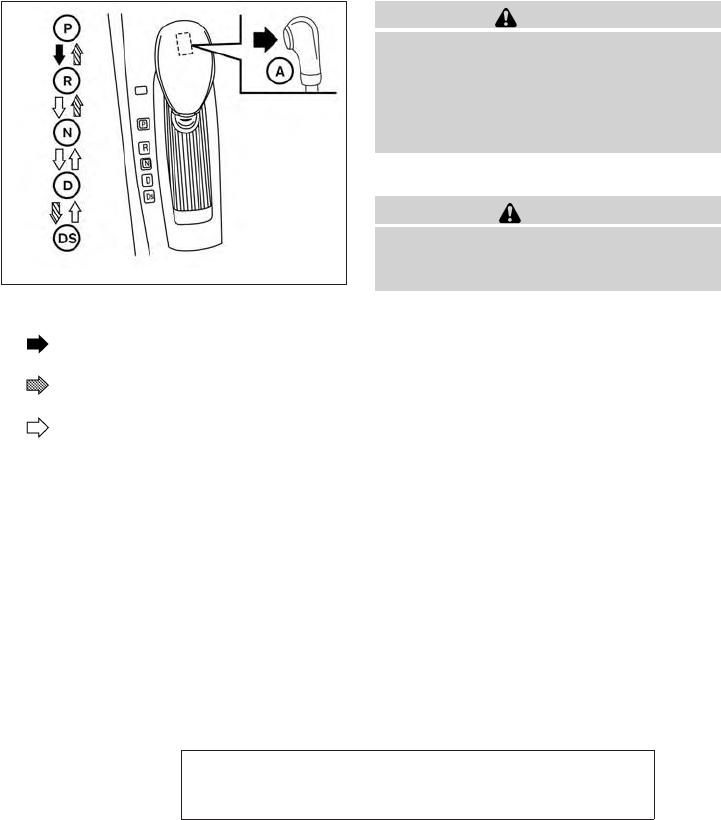
JOBNAME: 1093929-2013-asd-own PAGE: 286 SESS: 4 OUTPUT: Tue Mar 27 10:39:14 2012
NOTE:
Engine power may be automatically re-
duced to protect the CVT if the engine
speed increases quickly when driving on
slippery roads or while being tested on
some dynamometers.
Starting the vehicle
1. After starting the engine, fully depress the
foot brake pedal before moving the shift
selector out of the P (Park) position.
2. Keep the foot brake pedal depressed and
move the shift selector into a driving gear.
3. Release the foot brake, then gradually start
the vehicle in motion.
4. Stop the vehicle completely before shifting
the shift selector to the P (Park) position.
The CVT is designed so the foot brake
pedal MUST be depressed before shifting
from P (Park) to any drive position while
the ignition switch is in the ON position.
The shift selector cannot be moved out of P
(Park) and into any of the other gear posi-
tions if the ignition switch is pushed to the
LOCK position.
To move the shift selector:
Press the button s
Awhile depressing the
brake pedal
Press the buttons
Ato shift
Shift without pressing button s
A
Shifting
After starting the engine, fully depress the brake
pedal and move the shift selector from P (Park) to
any of the desired shift positions.
WARNING
Apply the parking brake if the shift selec-
tor is in any position while the engine is
not running. Failure to do so could cause
the vehicle to move unexpectedly or roll
away and result in serious personal injury
or property damage.
P (Park):
CAUTION
To prevent transmission damage, use the
P (Park) or R (Reverse) position only when
the vehicle is completely stopped.
Use the P (Park) shift selector position when the
vehicle is parked or when starting the engine.
Make sure the vehicle is completely stopped.
The brake pedal should be depressed to
move the shift selector from N (Neutral) or
any drive position to P (Park). Apply the
parking brake. When parking on a hill, apply the
parking brake first, then move the shift selector
into the P (Park) position.
LSD2085
5-14 Starting and driving
ZREVIEW COPY—
2013 Altima Sedan (asd)
Owners Manual—USA_English (nna)
03/24/12—dmoore
X
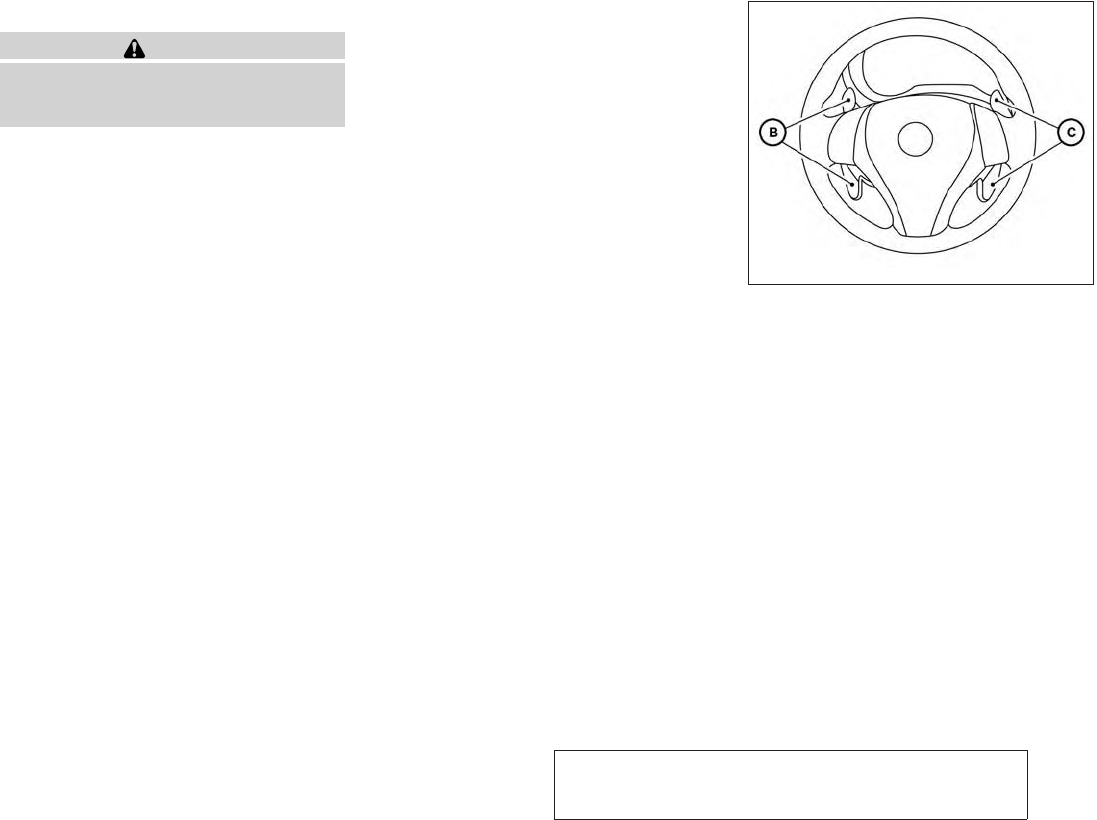
JOBNAME: 1093929-2013-asd-own PAGE: 287 SESS: 4 OUTPUT: Tue Mar 27 10:39:14 2012
R (Reverse):
CAUTION
To prevent transmission damage, use the
P (Park) or R (Reverse) position only when
the vehicle is completely stopped.
Use the R (Reverse) position to back up. Make
sure the vehicle is completely stopped before
selecting the R (Reverse) position. The brake
pedal must be depressed to move the shift
selector from P (Park), N (Neutral) or any
drive position to R (Reverse).
N (Neutral):
Neither forward nor reverse gear is engaged. The
engine can be started in this position. You may
shift to N (Neutral) and restart a stalled engine
while the vehicle is moving.
D (Drive):
Use this position for all normal forward driving.
Ds (Drive Sport):
When the shift selector is shifted from the D
(Drive) to Ds (Drive Sport) position, the transmis-
sion enters the Ds (Drive Sport) mode. Moving
the shift selector to the Ds (Drive Sport) position
allows you to enjoy “sporty”driving shift operation
on a winding road and feel smooth acceleration
or deceleration on a hilly road by moving in a
lower gear automatically. When canceling the DS
mode, return the shift selector to the D (Drive)
position. The transmission returns to the normal
driving mode.
Manual shift mode (if so equipped)
When the shift selector is in the Ds (Drive Sport)
position, the transmission is ready for the manual
shift mode. Shift ranges can be selected manu-
ally by pulling the right-side or left-side paddle
shifter.
When shifting up, pull the right side paddle
shifter (+) s
C(if so equipped). The transmission
shifts to the higher range.
When shifting down, pull the left side paddle
shifter (2)s
B(if so equipped). The transmission
shifts to the lower range.
LSD2086
Starting and driving 5-15
ZREVIEW COPY—
2013 Altima Sedan (asd)
Owners Manual—USA_English (nna)
03/24/12—dmoore
X

JOBNAME: 1093929-2013-asd-own PAGE: 288 SESS: 4 OUTPUT: Tue Mar 27 10:39:14 2012
When canceling the manual shift mode, return
the selector lever to the D (Drive) position. The
transmission returns to the normal driving mode.
When you pull the paddle shifter (if so equipped)
while in the D (Drive) position, the transmission
will shift to the upper or lower range temporarily.
The transmission will automatically return to the D
(Drive) position after a short period of time. If you
want to return to the D (Drive) position manually,
pull and hold the paddle shifter for about 1.5
seconds.
In the manual shift mode, the shift range is dis-
played on the position indicator in the meter.
Shift ranges up or down one by one as follows:
1⇔2⇔3⇔4⇔5⇔6⇔7⇔8
M8 (8th) and M7 (7th):
Use this position for all normal forward driving at
highway speeds.
M6 (6th) and M5 (5th):
Use this position when driving up long slopes, or
for engine braking when driving down long
slopes.
M4 (4th), M3 (3rd) and M2 (2nd):
Use for hill climbing or engine braking on downhill
grades.
M1 (First):
Use this position when climbing steep hills slowly
or driving slowly through deep snow, sand or
mud, or for maximum engine braking on steep
downhill grades.
●Remember not to drive at high speeds for
extended periods of time in lower than 7
range. This reduces fuel economy.
When shifting up:
Move the shift selector to the + (up) side. (Shifts
to higher range.)
When shifting down:
Move the shift selector to the 2(down) side.
(Shifts to lower range.)
●Moving the shift selector rapidly to the same
side twice will shift the ranges in succession.
When canceling the manual shift mode:
Return the shift selector to the D (Drive) position
to return the transmission to the normal driving
mode.
●In the manual shift mode, the transmis-
sion may not shift to the selected gear.
This helps maintain driving perfor-
mance and reduces the chance of ve-
hicle damage or loss of control.
●In the manual shift mode, the transmis-
sion may shift up automatically to a
higher range than selected if the en-
gine speed is too high. When the ve-
hicle speed decreases, the transmis-
sion automatically shifts down and
shifts to 1st gear before the vehicle
comes to a stop.
●CVT operation is limited to automatic drive
mode when CVT fluid temperature is ex-
tremely low even if manual shift mode is
selected. This is not a malfunction. When
CVT fluid warms up, manual mode can be
selected.
●When the CVT fluid temperature is high, the
shift range may upshift in lower rpm than
usual. This is not a malfunction.
5-16 Starting and driving
ZREVIEW COPY—
2013 Altima Sedan (asd)
Owners Manual—USA_English (nna)
03/24/12—dmoore
X
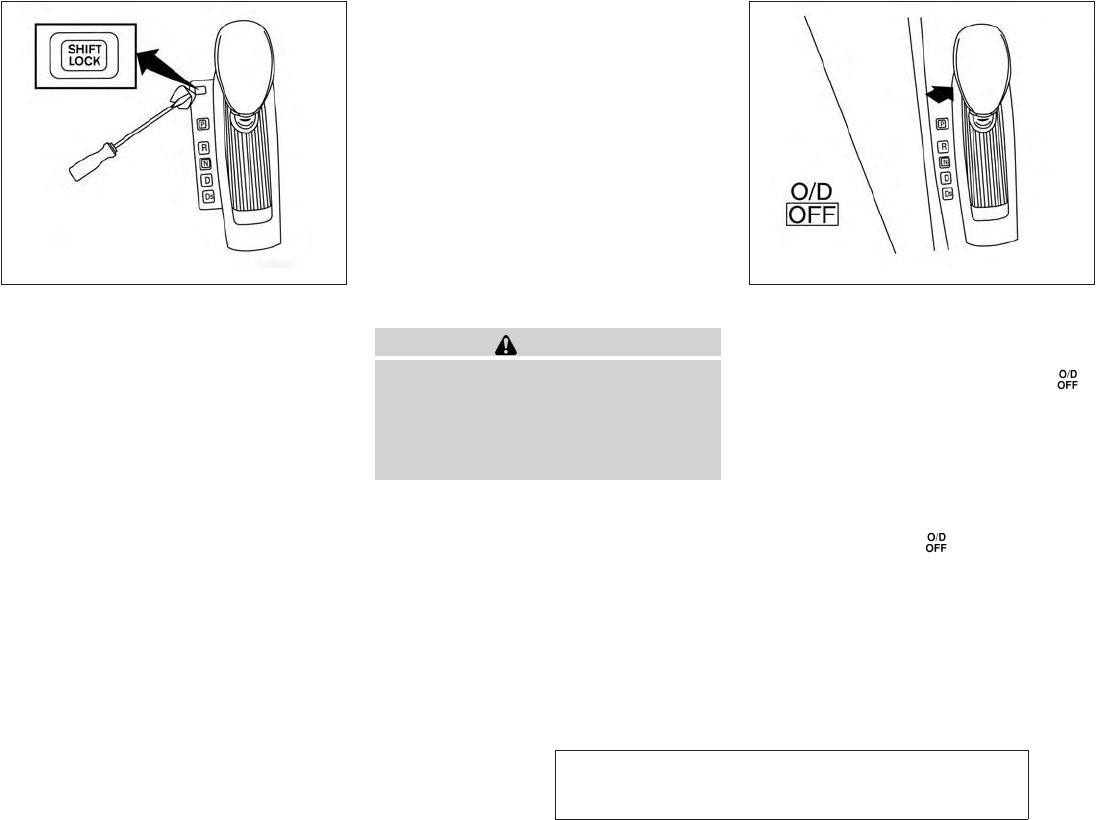
JOBNAME: 1093929-2013-asd-own PAGE: 289 SESS: 4 OUTPUT: Tue Mar 27 10:39:14 2012
Shift lock release
If the battery charge is low or discharged, the
shift selector may not be moved from the P (Park)
position even with the brake pedal depressed
and the shift selector button pushed.
It will be necessary to jump start or have your
battery charged, see “Jump starting” in the “In
case of emergency” section. Contact your
NISSAN dealer or a professional towing service.
To move the shift selector, complete the following
procedure:
1. Push the ignition switch to the LOCK posi-
tion.
2. Apply the parking brake.
3. Using a protective cloth on the tip of a 3 mm
screwdriver, remove the shift lock release
cover.
●If available, a plastic trim tool can also be
used.
4. Insert the small screwdriver in the shift lock
release slot and push down.
5. Move the shift selector to the N (Neutral)
position while holding down the shift lock
release.
If the shift selector cannot be moved out of P
(Park), have a NISSAN dealer check the trans-
mission as soon as possible.
WARNING
If the shift selector cannot be moved from
the P (Park) position while the engine is
running and the brake pedal is depressed,
the stop lights may not work. Malfunction-
ing stop lights could cause an accident
injuring yourself and others.
Overdrive (O/D) OFF switch (if so
equipped)
When the O/D OFF switch is pushed with the
shift selector in the D (Drive) position, the
light in the instrument panel illuminates. See
“Overdrive off indicator light” in the “Instruments
and controls” section of this manual.
Use the Overdrive off mode when you need im-
proved engine braking.
To turn off the Overdrive off mode, push the O/D
OFF switch again. The indicator light will
turn off.
LSD2087 LSD2090
Starting and driving 5-17
ZREVIEW COPY—
2013 Altima Sedan (asd)
Owners Manual—USA_English (nna)
03/24/12—dmoore
X
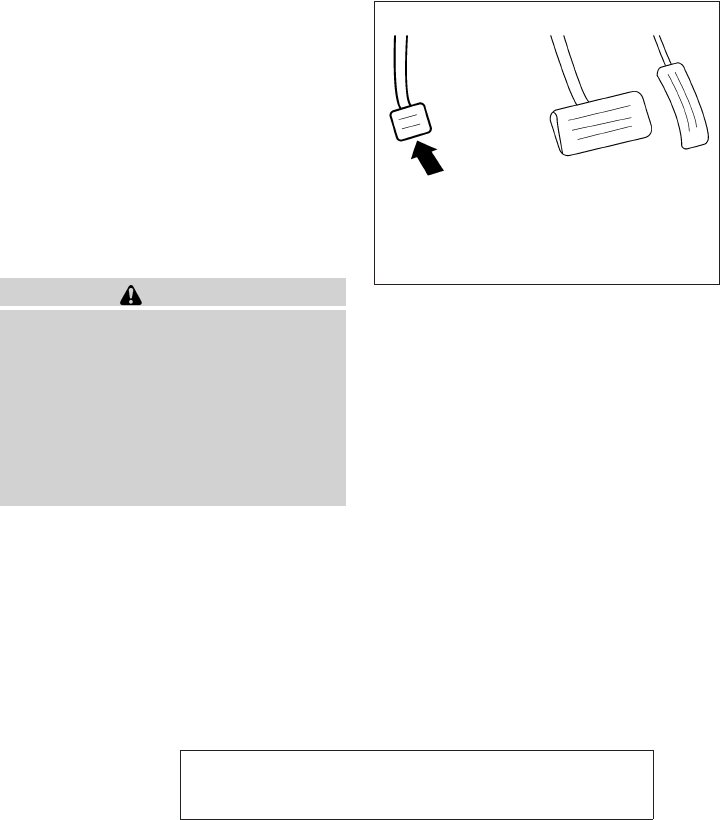
JOBNAME: 1093929-2013-asd-own PAGE: 290 SESS: 4 OUTPUT: Tue Mar 27 10:39:14 2012
Each time the engine is started, or when the shift
selector is shifted to any position other than D
(Drive), the Overdrive off mode will be automati-
cally turned off.
Accelerator downshift
— in D position —
For passing or hill climbing, depress the accel-
erator pedal to the floor. This shifts the transmis-
sion down into a lower gear, depending on the
vehicle speed.
High fluid temperature protection
mode
This transmission has a high fluid temperature
protection mode. If the fluid temperature be-
comes too high (for example, when climbing
steep grades in high temperature with heavy
loads, such as when towing a trailer), engine
power and, under some conditions, vehicle
speed will be decreased automatically to reduce
the chance of transmission damage. Vehicle
speed can be controlled with the accelerator
pedal, but the engine and vehicle speed may be
limited.
Fail-safe
If the vehicle is driven under extreme con-
ditions, such as excessive wheel spinning
and subsequent hard braking, the fail-safe
system may be activated. The MIL may
come on to indicate the fail-safe mode is
activated, see “Malfunction Indicator Light
(MIL)”in the “Instrument and controls” sec-
tion. This will occur even if all electrical
circuits are functioning properly. In this
case, place the ignition switch in the OFF
position and wait for 10 seconds. Then
push the switch back to the ON position.
The vehicle should return to its normal op-
erating condition. If it does not return to its
normal operating condition, have a
NISSAN dealer check the transmission and
repair if necessary.
WARNING
When the high fluid temperature protec-
tion mode or fail-safe operation occurs,
vehicle speed may be gradually reduced.
The reduced speed may be lower than
other traffic, which could increase the
chance of a collision. Be especially care-
ful when driving. If necessary, pull to the
side of the road at a safe place and allow
the transmission to return to normal op-
eration, or have it repaired if necessary.
1. To engage, firmly depress the foot brake.
2. To release:
●Move the shift selector to the P (Park)
position
●Firmly depress the parking brake pedal
and it will release.
●Before driving, be sure the brake warning
light goes out.
LSD0158
5-18 Starting and driving
ZREVIEW COPY—
2013 Altima Sedan (asd)
Owners Manual—USA_English (nna)
03/24/12—dmoore
X
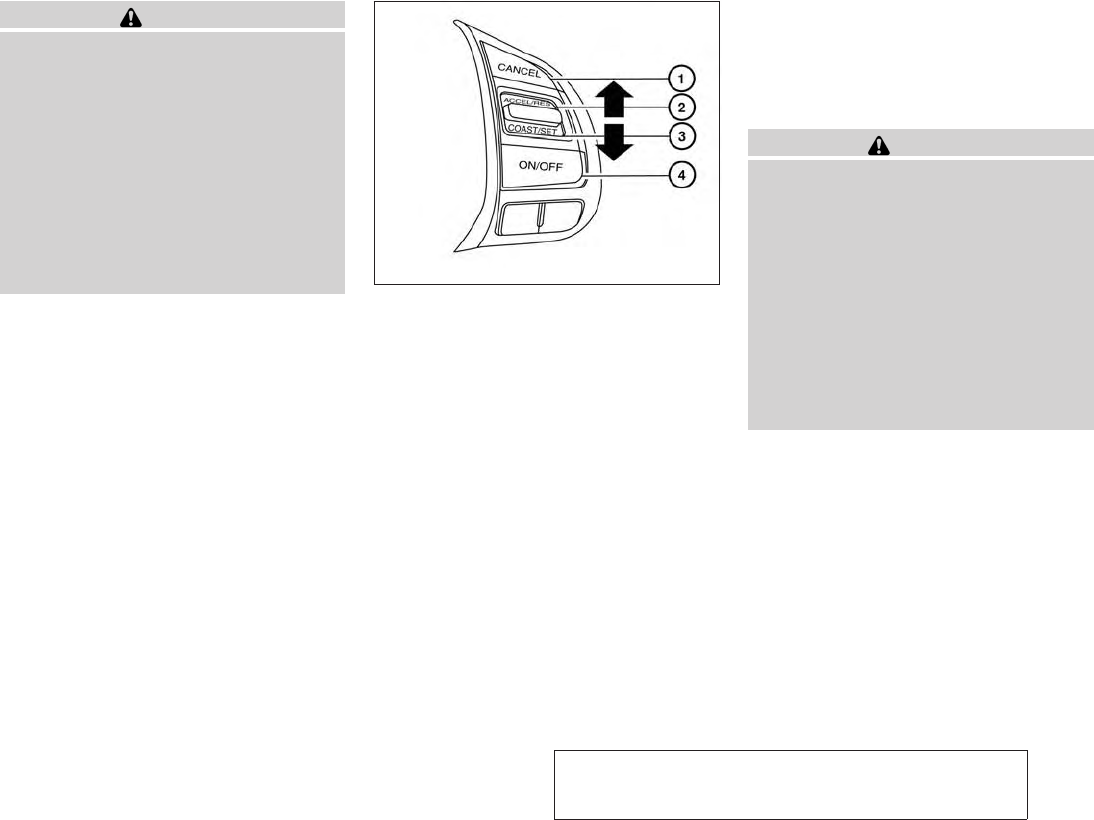
JOBNAME: 1093929-2013-asd-own PAGE: 291 SESS: 4 OUTPUT: Tue Mar 27 10:39:14 2012
WARNING
●Be sure the parking brake is fully re-
leased before driving. Failure to do so
can cause brake failure and lead to an
accident.
●Do not release the parking brake from
outside the vehicle.
●Do not use the shift selector in place of
the parking brake. When parking, be
sure the parking brake is fully engaged.
●Do not leave children unattended in a
vehicle. They could release the parking
brake and cause an accident.
1. CANCEL switch
2. ACCEL/RES switch
3. COAST/SET switch
4. ON/OFF switch
PRECAUTIONS ON CRUISE
CONTROL
●If the cruise control system malfunctions, it
cancels automatically. The SET indicator
light in the instrument panel then blinks to
warn the driver.
●If the SET indicator light blinks, turn the
cruise control switch off and have the sys-
tem checked by a NISSAN dealer.
●The SET indicator light may blink when the
cruise control switch is turned ON while
pushing the ACCEL/RES, COAST/SET, or
CANCEL switch. To properly set the cruise
control system, use the following proce-
dures.
WARNING
Do not use the cruise control when driving
under the following conditions:
●When it is not possible to keep the
vehicle at a set speed.
●In heavy traffic or in traffic that varies in
speed.
●On winding or hilly roads.
●On slippery roads (rain, snow, ice, etc.).
●In very windy areas.
Doing so could cause a loss of vehicle
control and result in an accident.
CRUISE CONTROL OPERATIONS
The cruise control allows driving at a speed be-
tween 25 - 89 MPH (40 - 144 km/h) without
keeping your foot on the accelerator pedal.
To turn on the cruise control, push the
ON·OFF switch on. The CRUISE indicator light in
the instrument panel will illuminate.
LSD2088
PARKING BRAKE CRUISE CONTROL (if so equipped)
Starting and driving 5-19
ZREVIEW COPY—
2013 Altima Sedan (asd)
Owners Manual—USA_English (nna)
03/24/12—dmoore
X

JOBNAME: 1093929-2013-asd-own PAGE: 292 SESS: 4 OUTPUT: Tue Mar 27 10:39:14 2012
To set cruising speed, accelerate the vehicle to
the desired speed, push the COAST/SET switch
and release it. Take your foot off the accelerator
pedal. Your vehicle maintains the set speed.
●To pass another vehicle, depress the ac-
celerator pedal. When you release the
pedal, the vehicle returns to the previously
set speed.
●The vehicle may not maintain the set speed
when going up or down steep hills. If this
happens, drive without the cruise control.
To cancel the preset speed, use one of the
following three methods.
●Push the CANCEL button.
●Tap the brake pedal.
●Push the ON·OFF switch off. The CRUISE
indicator light in the instrument panel goes
out.
The cruise control is automatically canceled if:
●you depress the brake pedal while pushing
the ACCEL/RES or SET/COAST switch.
The preset speed is deleted from memory.
●the vehicle slows down more than 8 MPH
(13 km/h) below the set speed.
●you move the shift selector to N (Neutral).
To reset at a faster cruising speed, use one
of the following three methods.
●Depress the accelerator pedal. When the
vehicle attains the desired speed, push and
release the COAST/SET switch.
●Push and hold the ACCEL/RES switch.
When the vehicle attains the speed you de-
sire, release the switch.
●Push and release the ACCEL/RES switch.
Each time you do this, the set speed in-
creases by about 1 MPH (1.6 km/h).
To reset at a slower cruising speed, use one
of the following three methods.
●Lightly tap the brake pedal. When the ve-
hicle attains the desired speed, push the
COAST/SET switch and release it.
●Push and hold the COAST/SET switch. Re-
lease the switch when the vehicle slows to
the desired speed.
●Push and release the COAST/SET switch.
Each time you do this, the set speed de-
creases by about 1 MPH (1.6 km/h).
To resume the preset speed, push and re-
lease the ACCEL/RES switch. The vehicle re-
turns to the last set cruising speed when the
vehicle speed is over 25 MPH (40 km/h).
CAUTION
During the first 1,200 miles (2,000 km),
follow these recommendations to obtain
maximum engine performance and en-
sure the future reliability and economy of
your new vehicle. Failure to follow these
recommendations may result in short-
ened engine life and reduced engine
performance.
●Avoid driving for long periods at constant
speed, either fast or slow, and do not run the
engine over 4,000 rpm.
●Do not accelerate at full throttle in any gear.
●Avoid quick starts.
●Avoid hard braking as much as possible.
●Do not tow a trailer for the first 500 miles
(800 km). Your engine, axle or other parts
could be damaged.
BREAK-IN SCHEDULE
5-20 Starting and driving
ZREVIEW COPY—
2013 Altima Sedan (asd)
Owners Manual—USA_English (nna)
03/24/12—dmoore
X

JOBNAME: 1093929-2013-asd-own PAGE: 293 SESS: 4 OUTPUT: Tue Mar 27 10:39:14 2012
●Accelerate slowly and smoothly. Maintain
cruising speeds with a constant accelerator
position.
●Drive at moderate speeds on the highway.
Driving at high speed lowers fuel economy.
●Avoid unnecessary stopping and braking.
Maintain a safe distance behind other ve-
hicles.
●Use a proper gear range which suits road
conditions. On level roads, shift into high
gear as soon as possible.
●Avoid unnecessary engine idling.
●Keep your engine tuned up.
●Follow the recommended periodic mainte-
nance schedule.
●Keep the tires inflated to the correct pres-
sure. Low tire pressure increases tire wear
and lowers fuel economy.
●Keep the wheels in correct alignment. Im-
proper alignment increases tire wear and
lowers fuel economy.
●Air conditioner operation lowers fuel
economy. Use the air conditioner only when
necessary.
●When cruising at highway speeds, it is more
economical to use the air conditioner and
leave the windows closed to reduce drag.
●Use the recommended viscosity engine oil.
See “Capacities and recommended
fuel/lubricants” in the “Technical and con-
sumer information” section of this manual.
INCREASING FUEL ECONOMY
Starting and driving 5-21
ZREVIEW COPY—
2013 Altima Sedan (asd)
Owners Manual—USA_English (nna)
03/24/12—dmoore
X
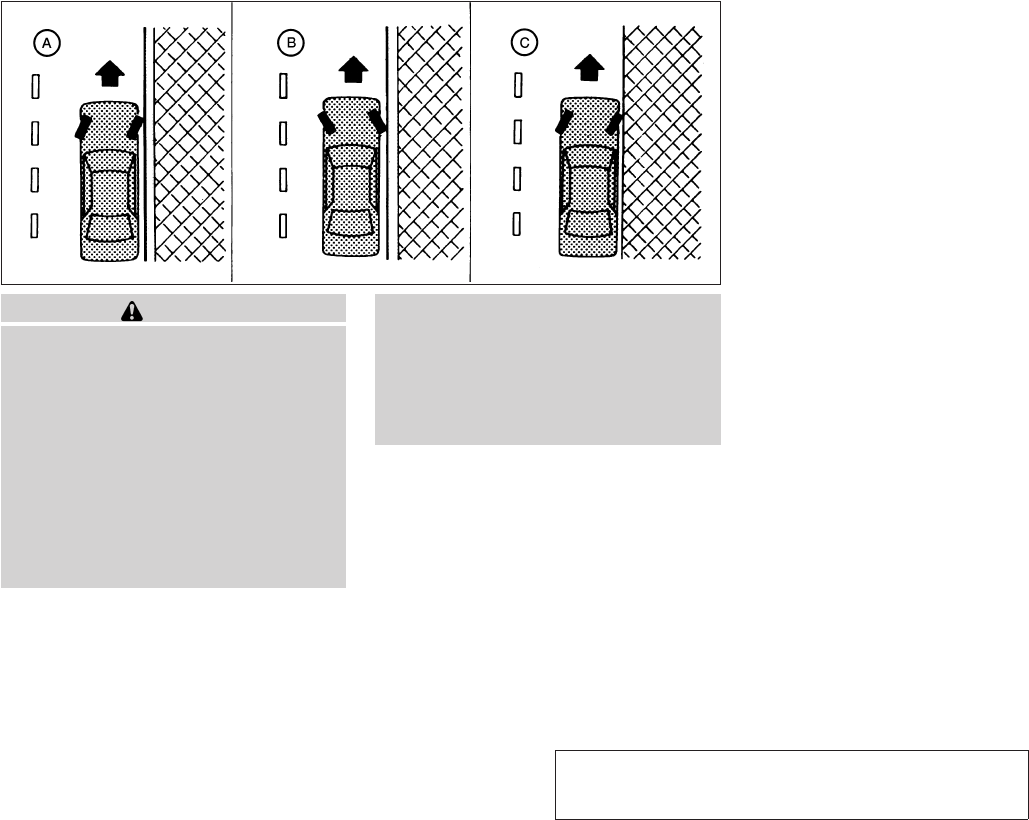
JOBNAME: 1093929-2013-asd-own PAGE: 294 SESS: 5 OUTPUT: Tue Mar 27 10:39:14 2012
WARNING
●Do not stop or park the vehicle over
flammable materials such as dry grass,
waste paper or rags. They may ignite
and cause a fire.
●
Safe parking procedures require that
both the parking brake be set and the
transmission placed into P (Park). Fail-
ure to do so could cause the vehicle to
move unexpectedly or roll away and re-
sult in an accident. Make sure the shift
selector has been pushed as far forward
as it can go and cannot be moved without
depressing the foot brake pedal.
●Never leave the engine running while
the vehicle is unattended.
●Do not leave children unattended inside
the vehicle. They could unknowingly ac-
tivate switches or controls. Unattended
children could become involved in seri-
ous accidents.
1. Firmly apply the parking brake.
2. Move the shift selector to the P (Park) posi-
tion.
3. To help prevent the vehicle from rolling into
traffic when parked on an incline, it is a good
practice to turn the wheels as illustrated.
●HEADED DOWNHILL WITH CURB: s
A
Turn the wheels into the curb and move the
vehicle forward until the curb side wheel
gently touches the curb.
●HEADED UPHILL WITH CURB: s
B
Turn the wheels away from the curb and
move the vehicle back until the curb side
wheel gently touches the curb.
●HEADED UPHILL OR DOWNHILL, NO
CURB: s
C
Turn the wheels toward the side of the road
so the vehicle will move away from the cen-
ter of the road if it moves.
4. Place the ignition switch in the LOCK posi-
tion.
WSD0050
PARKING/PARKING ON HILLS
5-22 Starting and driving
ZREVIEW COPY—
2013 Altima Sedan (asd)
Owners Manual—USA_English (nna)
03/27/12—dmoore
X

JOBNAME: 1093929-2013-asd-own PAGE: 295 SESS: 5 OUTPUT: Tue Mar 27 10:39:14 2012
WARNING
●If the engine is not running or is turned
off while driving, the power assist for
the steering will not work. Steering will
be harder to operate.
●When the power steering warning light
illuminates with the engine running,
there will be no power assist for the
steering. You will still have control of
the vehicle, but the steering will be
much harder to operate. Have the
power steering system checked by an
NISSAN dea;er .
The power steering system is designed to pro-
vide power assistance while driving to operate
the steering wheel with light force.
When the steering wheel is operated repeatedly
or continuously while parking or driving at a very
low speed, the power assist for the steering
wheel will be reduced. This is to prevent over-
heating of the power steering system and protect
it from getting damaged. While the power assist
is reduced, steering wheel operation will become
heavy. If the steering wheel operation is still per-
formed, the power steering may stop and the
power steering warning light will illuminate. Stop
the engine and push the ignition switch to the
OFF position. The temperature of the power
steering system will go down and the power
assist level will return to normal after starting the
engine. The power steering warning light will go
off. Avoid repeating such steering wheel opera-
tions that could cause the power steering system
to overheat.
You may hear a noise from the front of the vehicle
when the steering wheel is operated. This is not a
malfunction.
If the power steering warning light illuminates
while the engine is running, it may indicate the
power steering system is not functioning properly
and may need servicing. Have the power steering
system checked by a NISSAN dealer.
When the power steering warning light illumi-
nates with the engine running, the power assist
for the steering will cease operation but you will
still have control of the vehicle. At this time,
greater steering efforts are required to operate
the steering wheel, especially in sharp turns and
at low speeds.
The brake system has two separate hydraulic
circuits. If one circuit malfunctions, you will still
have braking at 2 wheels.
BRAKE PRECAUTIONS
Vacuum assisted brakes
The brake booster aids braking by using engine
vacuum. If the engine stops, you can stop the
vehicle by depressing the brake pedal. However,
greater foot pressure on the brake pedal will be
required to stop the vehicle and stopping dis-
tance will be longer.
Using the brakes
Avoid resting your foot on the brake pedal while
driving. This will overheat the brakes, wear out the
brake pads faster, and reduce gas mileage.
To help reduce brake wear and to prevent the
brakes from overheating, reduce speed and
downshift to a lower gear before going down a
slope or long grade. Overheated brakes may
reduce braking performance and could result in
loss of vehicle control.
POWER STEERING SYSTEM BRAKE SYSTEM
Starting and driving 5-23
ZREVIEW COPY—
2013 Altima Sedan (asd)
Owners Manual—USA_English (nna)
03/27/12—dmoore
X

JOBNAME: 1093929-2013-asd-own PAGE: 296 SESS: 5 OUTPUT: Tue Mar 27 10:39:14 2012
WARNING
●While driving on a slippery surface, be
careful when braking, accelerating or
downshifting. Abrupt braking or accel-
erating could cause the wheels to skid
and result in an accident.
●If the engine is not running or is turned
off while driving, the power assist for
the brakes will not work. Braking will be
harder.
Wet brakes
When the vehicle is washed or driven through
water, the brakes may get wet. As a result, your
braking distance will be longer and the vehicle
may pull to one side during braking.
To dry the brakes, drive the vehicle at a safe
speed while lightly pressing the brake pedal to
heat up the brakes. Do this until the brakes return
to normal. Avoid driving the vehicle at high
speeds until the brakes function correctly.
Parking brake break-in
Break-in the parking brake shoes whenever the
stopping effect of the parking brake is weakened
or whenever the parking brake shoes and/or
drum/rotors are replaced, in order to assure the
best brake performance.
This procedure is described in the vehicle service
manual and can be performed by a NISSAN
dealer.
ANTI-LOCK BRAKING SYSTEM
(ABS)
WARNING
●The Anti-lock Braking System (ABS) is a
sophisticated device, but it cannot pre-
vent accidents resulting from careless
or dangerous driving techniques. It can
help maintain vehicle control during
braking on slippery surfaces. Remem-
ber that stopping distances on slippery
surfaces will be longer than on normal
surfaces even with ABS. Stopping dis-
tances may also be longer on rough,
gravel or snow covered roads, or if you
are using tire chains. Always maintain a
safe distance from the vehicle in front
of you. Ultimately, the driver is respon-
sible for safety.
●Tire type and condition may also affect
braking effectiveness.
– When replacing tires, install the
specified size of tires on all four
wheels.
– When installing a spare tire, make
sure that it is the proper size and type
as specified on the Tire and Loading
Information label. See “Tire and
Loading Information label” in the
“Technical and consumer informa-
tion” section of this manual.
– For detailed information, see
“Wheels and tires” in the “Mainte-
nance and do-it-yourself” section of
this manual.
The Anti-lock Braking System (ABS) controls the
brakes so the wheels do not lock during hard
braking or when braking on slippery surfaces.
The system detects the rotation speed at each
wheel and varies the brake fluid pressure to pre-
vent each wheel from locking and sliding. By
preventing each wheel from locking, the system
helps the driver maintain steering control and
helps to minimize swerving and spinning on slip-
pery surfaces.
Using the system
Depress the brake pedal and hold it down. De-
press the brake pedal with firm steady pressure,
but do not pump the brakes. The ABS will oper-
ate to prevent the wheels from locking up. Steer
the vehicle to avoid obstacles.
5-24 Starting and driving
ZREVIEW COPY—
2013 Altima Sedan (asd)
Owners Manual—USA_English (nna)
03/27/12—dmoore
X
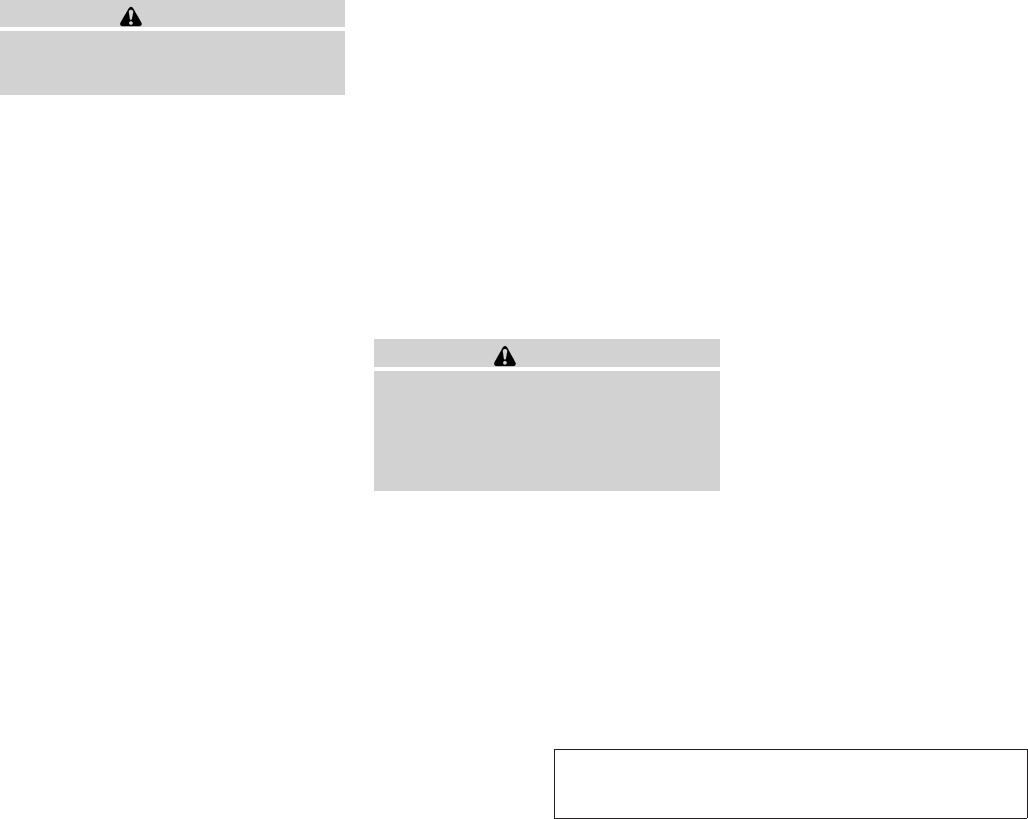
JOBNAME: 1093929-2013-asd-own PAGE: 297 SESS: 5 OUTPUT: Tue Mar 27 10:39:14 2012
WARNING
Do not pump the brake pedal. Doing so
may result in increased stopping
distances.
Self-test feature
The ABS includes electronic sensors, electric
pumps, hydraulic solenoids and a computer. The
computer has a built-in diagnostic feature that
tests the system each time you start the engine
and move the vehicle at a low speed in forward or
reverse. When the self-test occurs, you may hear
a “clunk”noise and/or feel a pulsation in the brake
pedal. This is normal and does not indicate a
malfunction. If the computer senses a malfunc-
tion, it switches the ABS off and illuminates the
ABS warning light on the instrument panel. The
brake system then operates normally, but without
anti-lock assistance.
If the ABS warning light illuminates during the
self-test or while driving, have the vehicle
checked by a NISSAN dealer.
Normal operation
The ABS operates at speeds above 3 - 6 MPH (5
- 10 km/h). The speed varies according to road
conditions.
When the ABS senses that 1 or more wheels are
close to locking up, the actuator rapidly applies
and releases hydraulic pressure. This action is
similar to pumping the brakes very quickly. You
may feel a pulsation in the brake pedal and hear a
noise from under the hood or feel a vibration from
the actuator when it is operating. This is normal
and indicates that the ABS is operating properly.
However, the pulsation may indicate that road
conditions are hazardous and extra care is re-
quired while driving.
BRAKE ASSIST
When the force applied to the brake pedal ex-
ceeds a certain level, the brake assist is activated
generating greater braking force than a conven-
tional brake booster even with light pedal force.
WARNING
The brake assist is only an aid to assist
braking operation and is not a collision
warning or avoidance device. it is the driv-
ers responsibility to stay alert, drive safely
and be in control of the vehicle at all
times.
The Vehicle Dynamic Control (VDC) system uses
various sensors to monitor driver inputs and ve-
hicle motion. Under certain driving conditions,
the VDC System helps to perform the following
functions:
●Controls brake pressure to reduce wheel
slip on one slipping drive wheel so power is
transferred to a non slipping drive wheel on
the same axle.
●Controls brake pressure and engine output
to reduce drive wheel slip based on vehicle
speed (traction control function).
●Controls brake pressure at individual wheels
and engine output to help the driver maintain
control of the vehicle in the following condi-
tions:
– understeer (vehicle tends to not follow
the steered path despite increased steer-
ing input)
– oversteer (vehicle tends to spin due to
certain road or driving conditions)
The VDC system can help the driver to maintain
control of the vehicle, but it cannot prevent loss of
vehicle control in all driving situations.
VEHICLE DYNAMIC CONTROL (VDC)
SYSTEM
Starting and driving 5-25
ZREVIEW COPY—
2013 Altima Sedan (asd)
Owners Manual—USA_English (nna)
03/27/12—dmoore
X
deleted
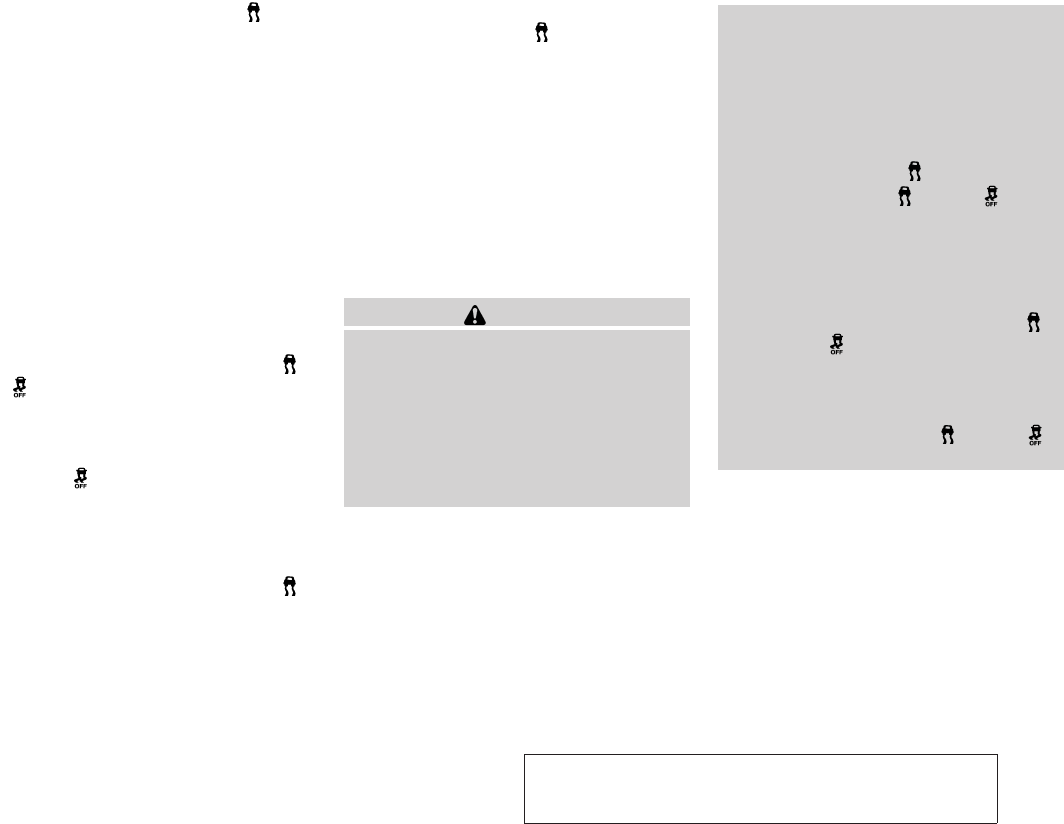
JOBNAME: 1093929-2013-asd-own PAGE: 298 SESS: 5 OUTPUT: Tue Mar 27 10:39:14 2012
When the VDC system operates, the indi-
cator in the instrument panel flashes so note the
following:
●The road may be slippery or the system may
determine some action is required to help
keep the vehicle on the steered path.
●You may feel a pulsation in the brake pedal
and hear a noise or vibration from under the
hood. This is normal and indicates that the
VDC system is working properly.
●Adjust your speed and driving to the road
conditions.
See “Slip indicator light” and ”Vehicle Dynamic
Control (VDC) off indicator light” in the ”Instru-
ments and controls” section.
If a malfunction occurs in the system, the
and indicator lights come on in the instru-
ment panel. The VDC system automatically turns
off when these indicator lights are on.
The VDC OFF switch is used to turn off the VDC
system. The indicator illuminates to indi-
cate the VDC system is off.
When the VDC switch is used to turn off the
system, the VDC system still operates to prevent
one drive wheel from slipping by transferring
power to a non slipping drive wheel. The
indicator flashes if this occurs. All other VDC
functions are off and the indicator will not
flash.
The VDC system is automatically reset to on
when the ignition switch is placed in the off
position then back to the on position.
The computer has a built in diagnostic feature
that tests the system each time you start the
engine and move the vehicle forward or in reverse
at a slow speed. When the self-test occurs, you
may hear a clunk noise and/or feel a pulsation in
the brake pedal. This is normal and is not an
indication of a malfunction.
WARNING
●The VDC system is designed to help the
driver maintain stability but does not
prevent accidents due to abrupt steer-
ing operation at high speeds or by care-
less or dangerous driving techniques.
Reduce vehicle speed and be especially
careful when driving and cornering on
slippery surfaces and always drive
carefully.
●Do not modify the vehicle’s suspension.
If suspension parts such as shock ab-
sorbers, struts, springs, stabilizer bars,
bushings and wheels are not NISSAN
recommended for your vehicle or are
extremely deteriorated, the VDC system
may not operate properly. This could
adversely affect vehicle handling per-
formance, and the indicator may
flash or both the and indi-
cator lights may illuminate.
●If brake related parts such as brake
pads, rotors and calipers are not
NISSAN recommended or are extremely
deteriorated, the VDC system may not
operate properly and both the
and the indicator lights may
illuminate.
●If engine control related parts are not
NISSAN recommended or are extremely
deteriorated, both the and
indicator lights may illuminate.
5-26 Starting and driving
ZREVIEW COPY—
2013 Altima Sedan (asd)
Owners Manual—USA_English (nna)
03/27/12—dmoore
X
comes
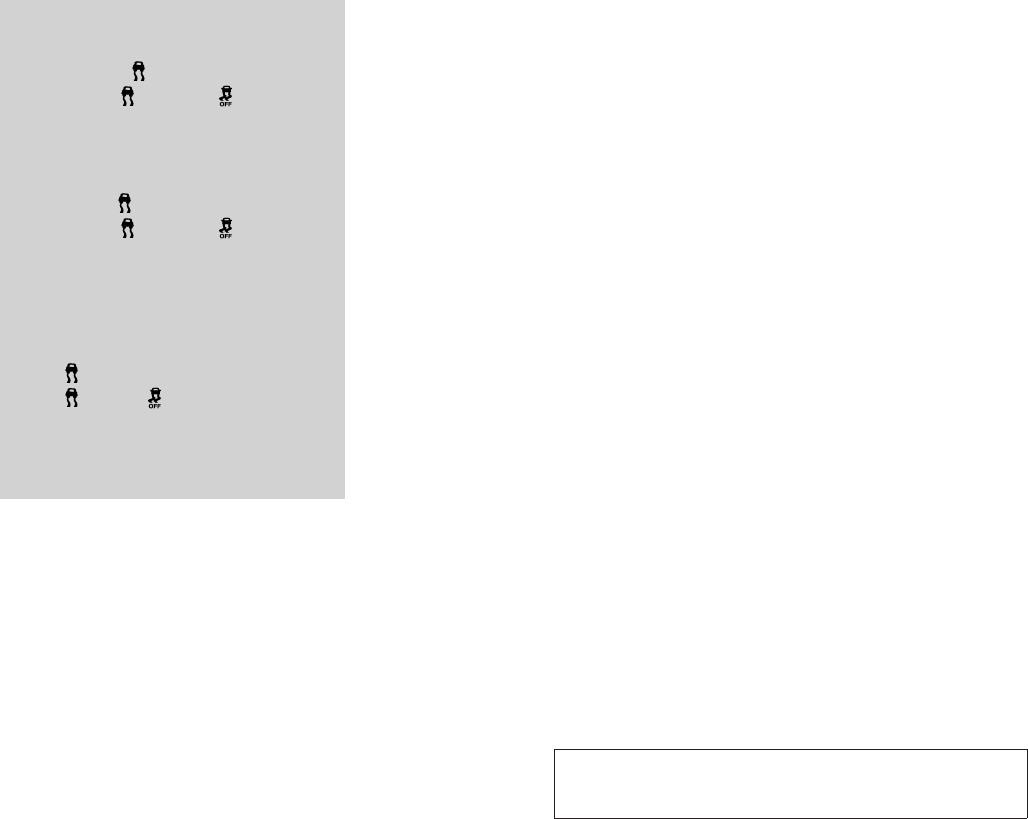
JOBNAME: 1093929-2013-asd-own PAGE: 299 SESS: 5 OUTPUT: Tue Mar 27 10:39:14 2012
●When driving on extremely inclined sur-
faces such as higher banked corners,
the VDC system may not operate prop-
erly and the indicator may flash or
both the and indicator
lights may illuminate. Do not drive on
these types of roads.
●When driving on an unstable surface
such as a turntable, ferry, elevator or
ramp, the indicator may flash or
both the and indicator
lights may illuminate. This is not a mal-
function. Restart the engine after driv-
ing onto a stable surface.
●If wheels or tires other than the NISSAN
recommended ones are used, the VDC
system may not operate properly and
the indicator may flash or both
the and indicator lights may
illuminate.
●The VDC system is not a substitute for
winter tires or tire chains on a snow
covered road.
FREEING A FROZEN DOOR LOCK
To prevent a door lock from freezing, apply de-
icer through the key hole. If the lock becomes
frozen, heat the key before inserting it into the key
hole or use the remote keyless entry function on
the Intelligent Key.
ANTI-FREEZE
In the winter when it is anticipated that the tem-
perature will drop below 32°F (0°C), check the
anti-freeze to assure proper winter protection.
For details, see “Engine cooling system” in the
“Maintenance and do-it-yourself” section of this
manual.
BATTERY
If the battery is not fully charged during extremely
cold weather conditions, the battery fluid may
freeze and damage the battery. To maintain maxi-
mum efficiency, the battery should be checked
regularly. For details, see “Battery” in the “Main-
tenance and do-it-yourself” section of this
manual.
DRAINING OF COOLANT WATER
If the vehicle is to be left outside without anti-
freeze, drain the cooling system, including the
engine block. Refill before operating the vehicle.
For details, see “Changing engine coolant” in the
“Maintenance and do-it-yourself” section of this
manual.
TIRE EQUIPMENT
1. SUMMER tires have a tread designed to
provide superior performance on dry pave-
ment. However, the performance of these
tires will be substantially reduced in snowy
and icy conditions. If you operate your ve-
hicle on snowy or icy roads, NISSAN recom-
mends the use of MUD & SNOW or ALL
SEASON TIRES on all four wheels. Please
consult a NISSAN dealer for the tire type,
size, speed rating and availability informa-
tion.
2. For additional traction on icy roads, studded
tires may be used. However, some U.S.
states and Canadian provinces prohibit their
use. Check local, state and provincial laws
before installing studded tires.
Skid and traction capabilities of studded
snow tires on wet or dry surfaces may be
poorer than that of non-studded snow tires.
COLD WEATHER DRIVING
Starting and driving 5-27
ZREVIEW COPY—
2013 Altima Sedan (asd)
Owners Manual—USA_English (nna)
03/27/12—dmoore
X

JOBNAME: 1093929-2013-asd-own PAGE: 300 SESS: 5 OUTPUT: Tue Mar 27 10:39:14 2012
3. Tire chains may be used. For details see
“Tire chains” in the “Maintenance and do-it-
yourself” section of this manual.
SPECIAL WINTER EQUIPMENT
It is recommended that the following items be
carried in the vehicle during winter:
●A scraper and stiff-bristled brush to remove
ice and snow from the windows and wiper
blades.
●A sturdy, flat board to be placed under the
jack to give it firm support.
●A shovel to dig the vehicle out of snowdrifts.
●Extra washer fluid to refill the windshield-
washer fluid reservoir.
DRIVING ON SNOW OR ICE
WARNING
●Wet ice (32°F, 0°C and freezing rain),
very cold snow or ice can be slick and
very hard to drive on. The vehicle will
have much less traction or “grip” under
these conditions. Try to avoid driving on
wet ice until the road is salted or
sanded.
●Whatever the condition, drive with cau-
tion. Accelerate and slow down with
care. If accelerating or downshifting too
fast, the drive wheels will lose even
more traction.
●Allow more stopping distance under
these conditions. Braking should be
started sooner than on dry pavement.
●Allow greater following distances on
slippery roads.
●Watch for slippery spots (glare ice).
These may appear on an otherwise
clear road in shaded areas. If a patch of
ice is seen ahead, brake before reach-
ing it. Try not to brake while on the ice,
and avoid any sudden steering
maneuvers.
●Do not use the cruise control on slip-
pery roads.
●Snow can trap dangerous exhaust
gases under your vehicle. Keep snow
clear of the exhaust pipe and from
around your vehicle.
ENGINE BLOCK HEATER (if so
equipped)
Engine block heaters are used to assist with cold
temperature starting.
The engine block heater should be used when
the outside temperature is 20°F (27°C) or lower.
WARNING
●Do not use your engine block heater
with an ungrounded electrical system
or a 2-pronged adapter. You can be se-
riously injured by an electrical shock if
you use an ungrounded connection.
●Disconnect and properly store the en-
gine block heater cord before starting
the engine. Damage to the cord could
result in an electrical shock and can
cause serious injury.
●Use a heavy-duty 3-wire, 3-pronged ex-
tension cord rated for at least 10 A. Plug
the extension cord into a Ground Fault
Interrupt (GFI) protected, grounded
110-VAC outlet. Failure to use the
proper extension cord or a grounded
outlet can result in a fire or electrical
shock and cause serious personal
injury.
5-28 Starting and driving
ZREVIEW COPY—
2013 Altima Sedan (asd)
Owners Manual—USA_English (nna)
03/27/12—dmoore
X

JOBNAME: 1093929-2013-asd-own PAGE: 301 SESS: 5 OUTPUT: Tue Mar 27 10:39:14 2012
To use the engine block heater:
1. Turn the engine off.
2. Open the hood and unwrap the engine block
heater cord.
3. Plug the engine block heater cord into a
grounded 3-wire, 3-pronged extension
cord.
4. Plug the extension cord into a Ground Fault
Interrupt (GFI) protected, grounded 110-
volt AC (VAC) outlet.
5. The engine block heater must be plugged in
for at least 2 - 4 hours, depending on outside
temperatures, to properly warm the engine
coolant. Use an appropriate timer to turn the
engine block heater on.
6. Before starting the engine, unplug and prop-
erly store the cord to keep it away from
moving parts.
Starting and driving 5-29
ZREVIEW COPY—
2013 Altima Sedan (asd)
Owners Manual—USA_English (nna)
03/27/12—dmoore
X

JOBNAME: 1093929-2013-asd-own PAGE: 302 SESS: 5 OUTPUT: Tue Mar 27 10:39:14 2012
MEMO
5-30 Starting and driving
ZREVIEW COPY—
2013 Altima Sedan (asd)
Owners Manual—USA_English (nna)
03/27/12—dmoore
X

JOBNAME: 1093929-2013-asd-own PAGE: 303 SESS: 5 OUTPUT: Tue Mar 27 10:39:14 2012
6 In case of emergency
Emergency engine shut off . . . . . . . . . . . . . . . . . . . . . . . . . 6-2
Flattire...........................................6-2
Tire Pressure Monitoring System (TPMS). . . . . . . . . . 6-2
Changingaflattire .............................6-3
Jumpstarting .....................................6-7
Push starting. . . . . . . . . . . . . . . . . . . . . . . . . . . . . . . . . . . . . . 6-9
If your vehicle overheats . . . . . . . . . . . . . . . . . . . . . . . . . . . . 6-9
Towing your vehicle . . . . . . . . . . . . . . . . . . . . . . . . . . . . . . .6-10
Towing recommended by NISSAN . . . . . . . . . . . . . . 6-11
Vehicle recovery (freeing a stuck vehicle) . . . . . . . . .6-12
ZREVIEW COPY—
2013 Altima Sedan (asd)
Owners Manual—USA_English (nna)
03/27/12—dmoore
X

JOBNAME: 1093929-2013-asd-own PAGE: 304 SESS: 5 OUTPUT: Tue Mar 27 10:39:14 2012
To shut off the engine in an emergency situation
while driving, perform the following procedure:
– Rapidly push the push-button ignition switch 3
consecutive times in less than 1.5 seconds, or
– Push and hold the push-button ignition switch
for more than 2 seconds.
TIRE PRESSURE MONITORING
SYSTEM (TPMS)
This vehicle is equipped with the Tire Pressure
Monitoring System (TPMS). It monitors tire pres-
sure of all tires except the spare. When the low
tire pressure warning light is lit, and the “Tire
Pressure Low - Add Air” warning appears in the
vehicle information display, one or more of your
tires is significantly under-inflated. If equipped,
the system also displays pressure of all tires
(except the spare tire) on the display screen by
sending a signal from a sensor that is installed in
each wheel. If the vehicle is being driven with low
tire pressure, the TPMS will activate and warn
you of it by the low tire pressure warning light.
This system will activate only when the vehicle is
driven at speeds above 16 MPH (25 km/h). For
more details, refer to “Warning/indicator lights
and audible reminders” in the “Instruments and
controls” section and “Tire Pressure Monitoring
System (TPMS)” in the “Starting and driving”
section.
WARNING
●Radio waves could adversely affect
electric medical equipment. Those who
use a pacemaker should contact the
electric medical equipment manufac-
turer for the possible influences before
use.
●If the low tire pressure warning light
illuminates while driving, avoid sudden
steering maneuvers or abrupt braking,
reduce vehicle speed, pull off the road
to a safe location and stop the vehicle
as soon as possible. Driving with under-
inflated tires may permanently damage
the tires and increase the likelihood of
tire failure. Serious vehicle damage
could occur and may lead to an acci-
dent and could result in serious per-
sonal injury. Check the tire pressure for
all four tires. Adjust the tire pressure to
the recommended COLD tire pressure
shown on the Tire and Loading Informa-
tion label to turn the low tire pressure
warning light OFF. If you have a flat tire,
replace it with a spare tire as soon as
possible.
EMERGENCY ENGINE SHUT OFF FLAT TIRE
6-2 In case of emergency
ZREVIEW COPY—
2013 Altima Sedan (asd)
Owners Manual—USA_English (nna)
03/27/12—dmoore
X
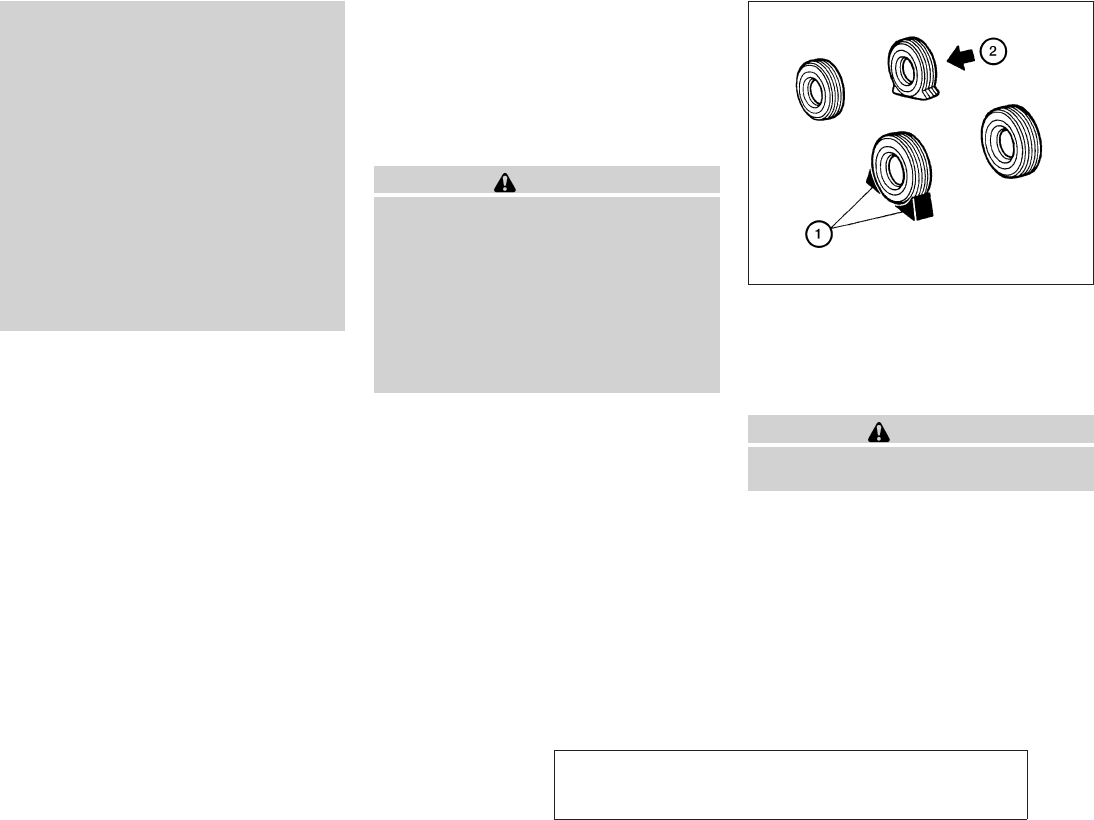
JOBNAME: 1093929-2013-asd-own PAGE: 305 SESS: 5 OUTPUT: Tue Mar 27 10:39:14 2012
●When a spare tire is mounted or a wheel
is replaced, tire pressure will not be
indicated, the TPMS will not function
and the low tire pressure warning light
will flash for approximately 1 minute.
The light will remain on after 1 minute.
Contact your NISSAN dealer as soon as
possible for tire replacement and/or
system resetting.
●Replacing tires with those not originally
specified by NISSAN could affect the
proper operation of the TPMS.
●Do not inject any tire liquid or aerosol
tire sealant into the tires, as this may
cause a malfunction of the tire pressure
sensors.
CHANGING A FLAT TIRE
If you have a flat tire, follow the instructions be-
low:
Stopping the vehicle
1. Safely move the vehicle off the road and
away from traffic.
2. Turn on the hazard warning flashers.
3. Park on a level surface and apply the parking
brake. Move the shift selector to P (Park).
4. Turn off the engine.
5. Raise the hood to warn other traffic and to
signal professional road assistance person-
nel that you need assistance.
6. Have all passengers get out of the vehicle
and stand in a safe place, away from traffic
and clear of the vehicle.
WARNING
●Make sure the parking brake is securely
applied and the CVT is shifted into P
(Park).
●Never change tires when the vehicle is
on a slope, ice or slippery areas. This is
hazardous.
●Never change tires if oncoming traffic is
close to your vehicle. Wait for profes-
sional road assistance.
Blocking wheels
Place suitable blocks s
1at both the front and
back of the wheel diagonally opposite the flat tire
s
2to prevent the vehicle from moving when it is
jacked up.
WARNING
Be sure to block the wheel as the vehicle
may move and result in personal injury.
WCE0044
In case of emergency 6-3
ZREVIEW COPY—
2013 Altima Sedan (asd)
Owners Manual—USA_English (nna)
03/27/12—dmoore
X
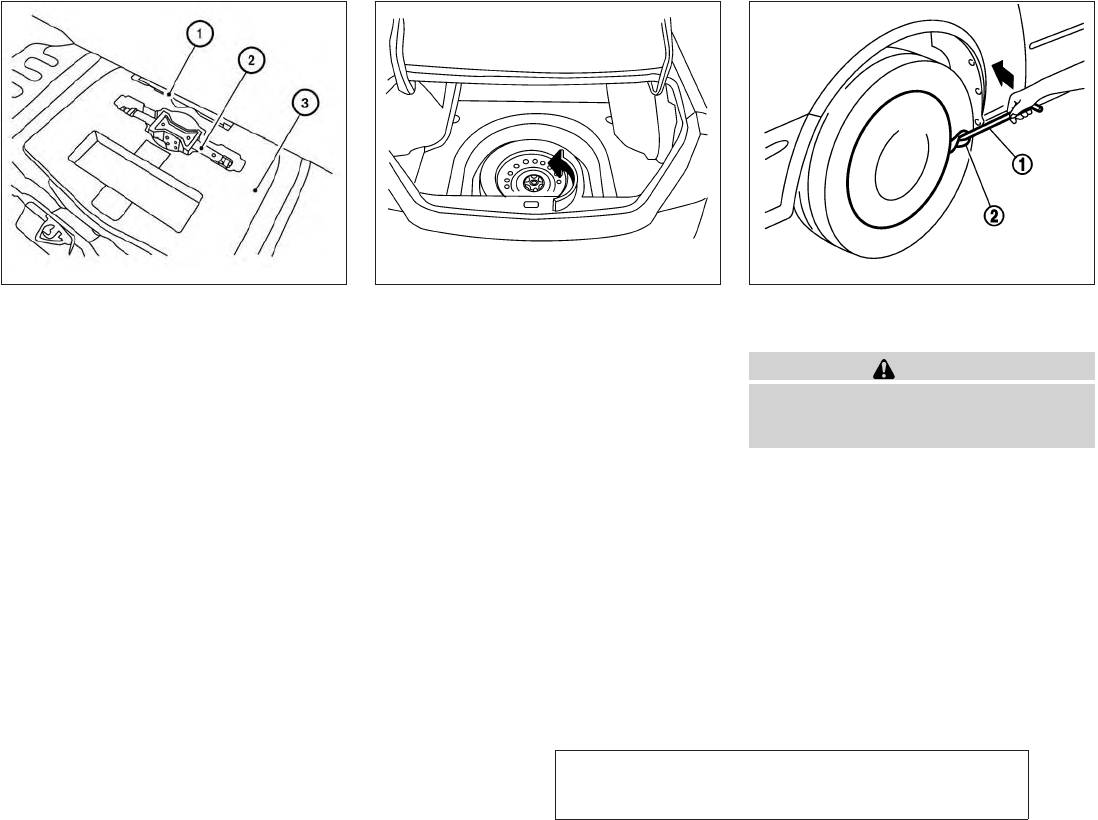
JOBNAME: 1093929-2013-asd-own PAGE: 306 SESS: 5 OUTPUT: Tue Mar 27 10:39:14 2012
Getting the spare tire and tools
Open the trunk. Lift the luggage floor. Remove
the jack s
1and wheel nut wrench s
2from the
from the storage cover s
3. Then remove the
storage cover s
3to access the spare tire.
Turn the clamp to remove the spare tire. Remove
the spare tire. Removing wheel cover (if so
equipped)
CAUTION
Do not use your hands to pry off wheel
caps or wheel covers. Doing so could re-
sult in personal injury.
To remove the wheel cover, use the jack rod s
1
as illustrated.
Apply cloth s
2between the wheel and jack rod to
prevent damaging the wheel and wheel cover.
Use caution not to scratch the wheel cover or
wheel surface.
LCE2046 WCE0067 SCE0630
6-4 In case of emergency
ZREVIEW COPY—
2013 Altima Sedan (asd)
Owners Manual—USA_English (nna)
03/27/12—dmoore
X
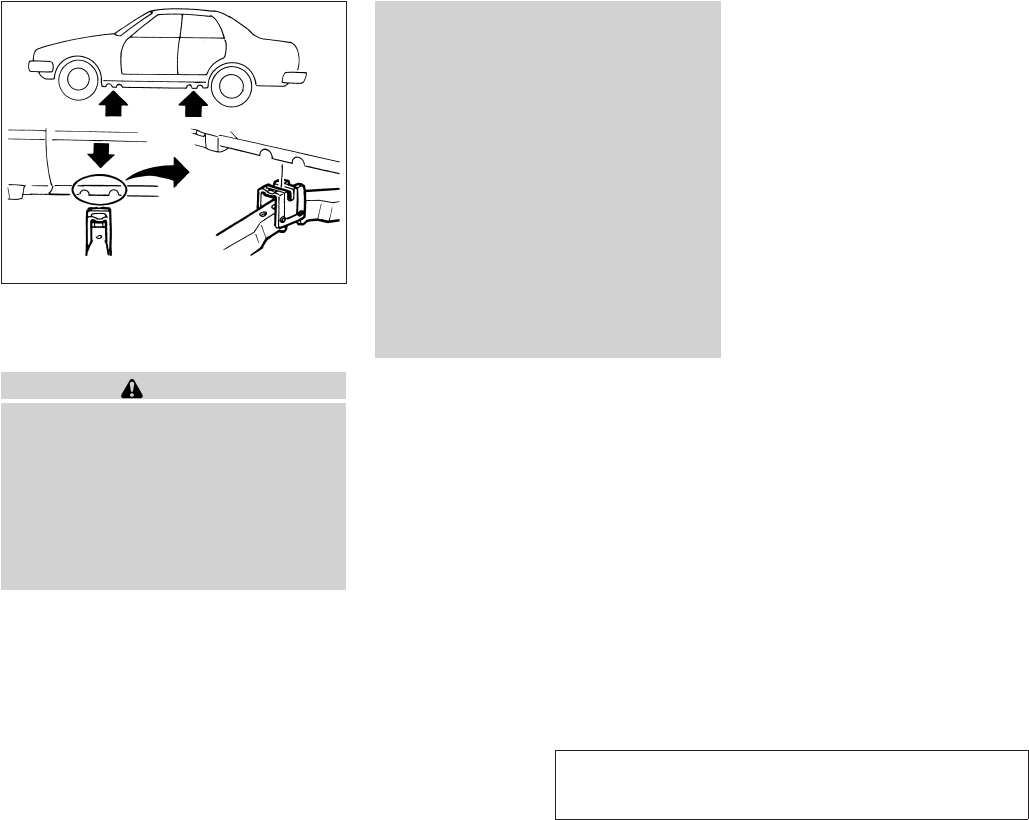
JOBNAME: 1093929-2013-asd-own PAGE: 307 SESS: 5 OUTPUT: Tue Mar 27 10:39:14 2012
Jacking up vehicle and removing the
damaged tire
WARNING
●Never get under the vehicle while it is
supported only by the jack. If it is nec-
essary to work under the vehicle, sup-
port it with safety stands.
●Use only the jack provided with your
vehicle to lift the vehicle. Do not use the
jack provided with your vehicle on other
vehicles. The jack is designed for lifting
only your vehicle during a tire change.
●Use the correct jack-up points. Never
use any other part of the vehicle for jack
support.
●Never jack up the vehicle more than
necessary.
●Never use blocks on or under the jack.
●Do not start or run the engine while
vehicle is on the jack. It may cause the
vehicle to move. This is especially true
for vehicles with limited slip
differentials.
●Do not allow passengers to stay in the
vehicle while it is on the jack.
●Never run the engine with a wheel(s) off
the ground. It may cause the vehicle to
move.
Jack-up point
WCE0160
In case of emergency 6-5
ZREVIEW COPY—
2013 Altima Sedan (asd)
Owners Manual—USA_English (nna)
03/27/12—dmoore
X
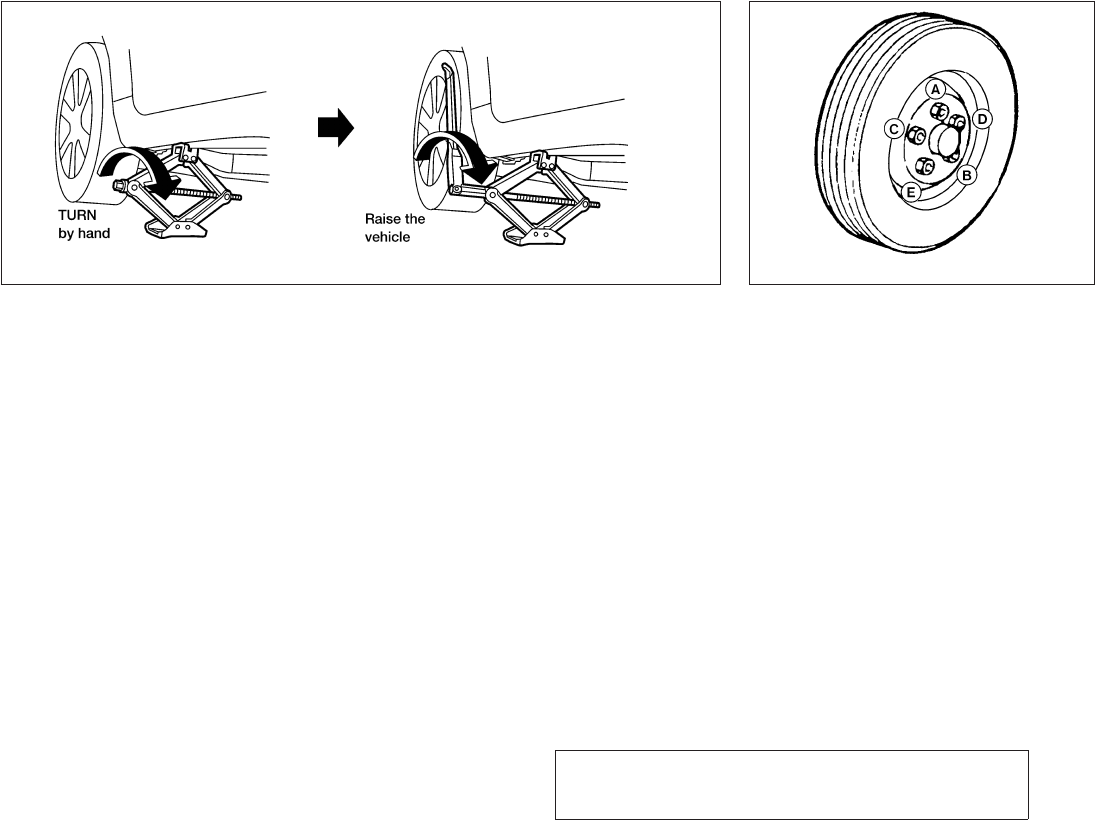
JOBNAME: 1093929-2013-asd-own PAGE: 308 SESS: 5 OUTPUT: Tue Mar 27 10:39:14 2012
Always refer to the proper illustrations for the
correct placement and jack-up points for your
specific vehicle model and jack type.
Carefully read the caution label attached to
the jack body and the following instruc-
tions.
1. Loosen each wheel nut one or two turns by
turning counterclockwise with the wheel nut
wrench. Do not remove the wheel nuts
until the tire is off the ground.
2. Place the jack directly under the jack-up
point as illustrated so the top of the jack
contacts the vehicle at the jack-up point.
Align the jack head between the two
notches in the front or the rear as shown.
Also fit the groove of the jack head between
the notches as shown.
The jack should be used on firm and
level ground.
3. To lift the vehicle, securely hold the jack lever
and rod with both hands. Carefully raise the
vehicle until the tire clears the ground. Re-
move the wheel nuts, and then remove the
tire.
Installing the spare tire
The spare tire is designed for emergency
use. See specific instructions under the
heading “Wheels and tires” in the “Mainte-
nance and do-it-yourself” section of this
manual.
1. Clean any mud or dirt from the surface be-
tween the wheel and hub.
2. Carefully put the spare tire on and tighten
the wheel nuts finger tight.
3. With the wheel nut wrench, tighten wheel
nuts alternately and evenly as illustrated until
they are tight.
LCE0020 WCE0056
6-6 In case of emergency
ZREVIEW COPY—
2013 Altima Sedan (asd)
Owners Manual—USA_English (nna)
03/27/12—dmoore
X

JOBNAME: 1093929-2013-asd-own PAGE: 309 SESS: 5 OUTPUT: Tue Mar 27 10:39:14 2012
4. Lower the vehicle slowly until the tire
touches the ground. Then, with the wheel
nut wrench, tighten the wheel nuts securely
in the sequence illustrated (s
A,s
B,s
C,s
D,
s
E). Lower the vehicle completely.
WARNING
●Incorrect wheel nuts or improperly
tightened wheel nuts can cause the
wheel to become loose or come off.
This could cause an accident.
●Do not use oil or grease on the wheel
studs or nuts. This could cause the nuts
to become loose.
●Retighten the wheel nuts when the ve-
hicle has been driven for 1,000 km (600
miles) (also in cases of a flat tire, etc.).
As soon as possible, tighten the wheel nuts
to the specified torque with a torque
wrench.
Wheel nut tightening torque:
113 N·m (83 ft-lb)
The wheel nuts must be kept tightened to
specification at all times. It is recom-
mended that wheel nuts be tightened to
specifications at each lubrication interval.
Adjust tire pressure to the COLD pressure.
COLD pressure: After vehicle has been
parked for three hours or more or driven
less than 1 mile (1.6 km).
COLD tire pressures are shown on the Tire
Load and Information label affixed to the
driver side center pillar.
5. Securely store the flat tire and jacking equip-
ment in the vehicle.
6. Place the spare tire cover and the trunk floor
carpeting over the damaged tire.
7. Close the trunk.
WARNING
●Always make sure that the spare tire
and jacking equipment are properly se-
cured after use. Such items can become
dangerous projectiles in an accident or
sudden stop.
●The spare tire is designed for emer-
gency use. See specific instructions un-
der the heading “Wheels and tires” in
the “Maintenance and do-it-yourself”
section of this manual.
To start your engine with a booster battery, the
instructions and precautions below must be fol-
lowed.
WARNING
●If done incorrectly, jump starting can
lead to a battery explosion, resulting in
severe injury or death. It could also
damage your vehicle.
●Explosive hydrogen gas is always pres-
ent in the vicinity of the battery. Keep all
sparks and flames away from the
battery.
●Do not allow battery fluid to come into
contact with eyes, skin, clothing or
painted surfaces. Battery fluid is a cor-
rosive sulfuric acid solution which can
cause severe burns. If the fluid should
come into contact with anything, imme-
diately flush the contacted area with
water.
●Keep battery out of the reach of
children.
●The booster battery must be rated at 12
volts. Use of an improperly rated battery
can damage your vehicle.
JUMP STARTING
In case of emergency 6-7
ZREVIEW COPY—
2013 Altima Sedan (asd)
Owners Manual—USA_English (nna)
03/27/12—dmoore
X
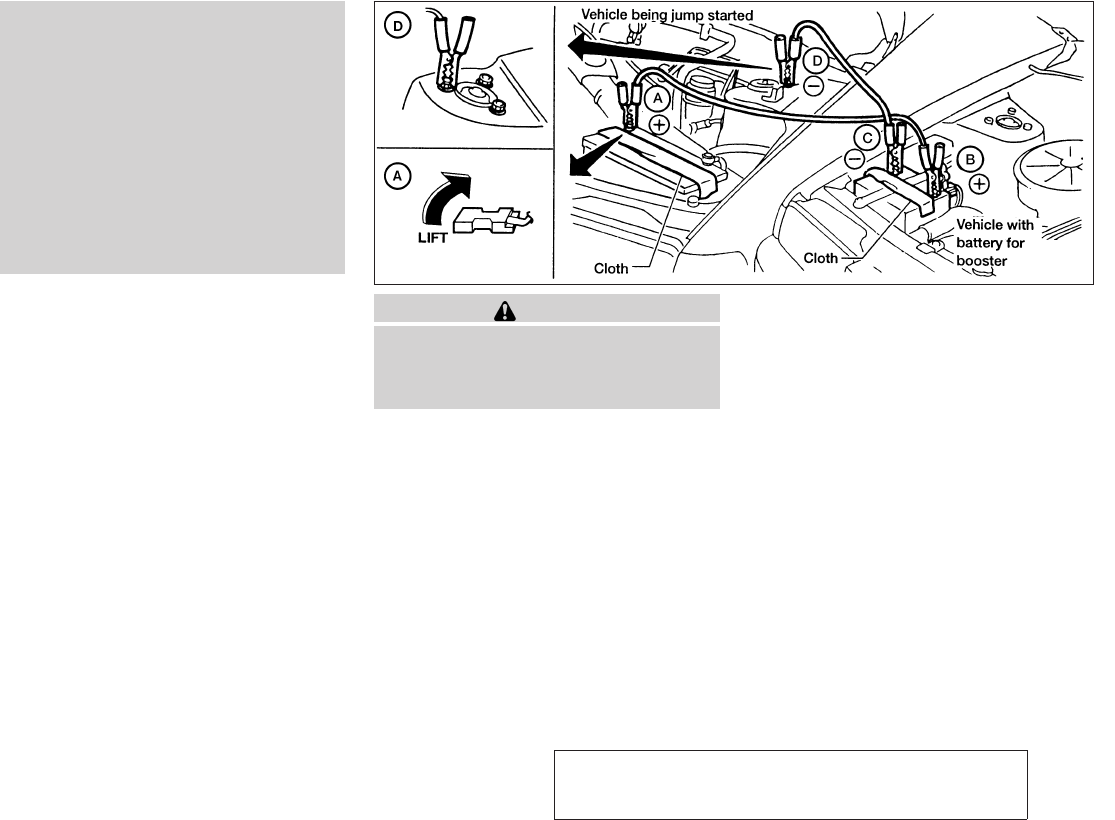
JOBNAME: 1093929-2013-asd-own PAGE: 310 SESS: 5 OUTPUT: Tue Mar 27 10:39:14 2012
●Whenever working on or near a battery,
always wear suitable eye protectors (for
example, goggles or industrial safety
spectacles) and remove rings, metal
bands, or any other jewelry. Do not lean
over the battery when jump starting.
●Do not attempt to jump start a frozen
battery. It could explode and cause se-
rious injury.
●Your vehicle has an automatic engine
cooling fan. It could come on at any
time. Keep hands and other objects
away from it.
WARNING
Always follow the instructions below.
Failure to do so could result in damage to
the charging system and cause personal
injury.
1. If the booster battery is in another vehicle,
position the two vehicles to bring their bat-
teries near each other.
Do not allow the two vehicles to touch.
2. Apply the parking brake. Move the shift se-
lector to P (Park). Switch off all unnecessary
electrical systems (lights, heater, air condi-
tioner, etc.).
3. Remove the vent caps on the battery (if so
equipped). Cover the battery with an old
cloth to reduce explosion hazard.
4. Connect the jumper cables in the sequence
illustrated (s
A,s
B,s
C,s
D).
WCE0054
6-8 In case of emergency
ZREVIEW COPY—
2013 Altima Sedan (asd)
Owners Manual—USA_English (nna)
03/27/12—dmoore
X

JOBNAME: 1093929-2013-asd-own PAGE: 311 SESS: 5 OUTPUT: Tue Mar 27 10:39:14 2012
CAUTION
●Always connect positive (1) to positive
(1) and negative (2) to body ground (for
example, strut mounting bolt, engine
lift bracket, etc.) — not to the battery.
●Make sure the jumper cables do not
touch moving parts in the engine com-
partment and that the cable clamps do
not contact any other metal.
5. Start the engine of the booster vehicle and
let it run for a few minutes.
6. Keep the engine speed of the booster ve-
hicle at about 2,000 rpm and start the en-
gine of the vehicle being jump started.
CAUTION
Do not keep the starter motor engaged for
more than 10 seconds. If the engine does
not start right away, place the ignition
switch in the OFF position and wait 3 to 4
seconds before trying again.
7.
After starting the engine, carefully disconnect
the negative cable and then the positive cable.
8. Replace the vent caps (if so equipped). Be
sure to dispose of the cloth used to cover
the vent holes as it may be contaminated
with corrosive acid.
CAUTION
●Do not push start this vehicle. The
three-way catalyst may be damaged.
●Continuously Variable Transmission
(CVT) models cannot be push-started or
tow-started. Attempting to do so may
cause transmission damage.
If your vehicle is overheating (indicated by an
extremely high temperature gauge reading), or if
you feel a lack of engine power, detect abnormal
noise, etc. take the following steps.
WARNING
●Do not continue to drive if your vehicle
overheats. Doing so could cause engine
damage or a vehicle fire.
●To avoid the danger of being scalded,
never remove the radiator cap while the
engine is still hot. When the radiator
cap is removed, pressurized hot water
will spurt out, possibly causing serious
injury.
●Do not open the hood if steam is com-
ing out.
1. Move the vehicle safely off the road, apply
the parking brake and move the shift selector
to P (Park).
Do not stop the engine.
2. Turn off the air conditioner. Open all the
windows, move the heater or air conditioner
temperature control to maximum hot and fan
control to high speed.
PUSH STARTING IF YOUR VEHICLE OVERHEATS
In case of emergency 6-9
ZREVIEW COPY—
2013 Altima Sedan (asd)
Owners Manual—USA_English (nna)
03/27/12—dmoore
X
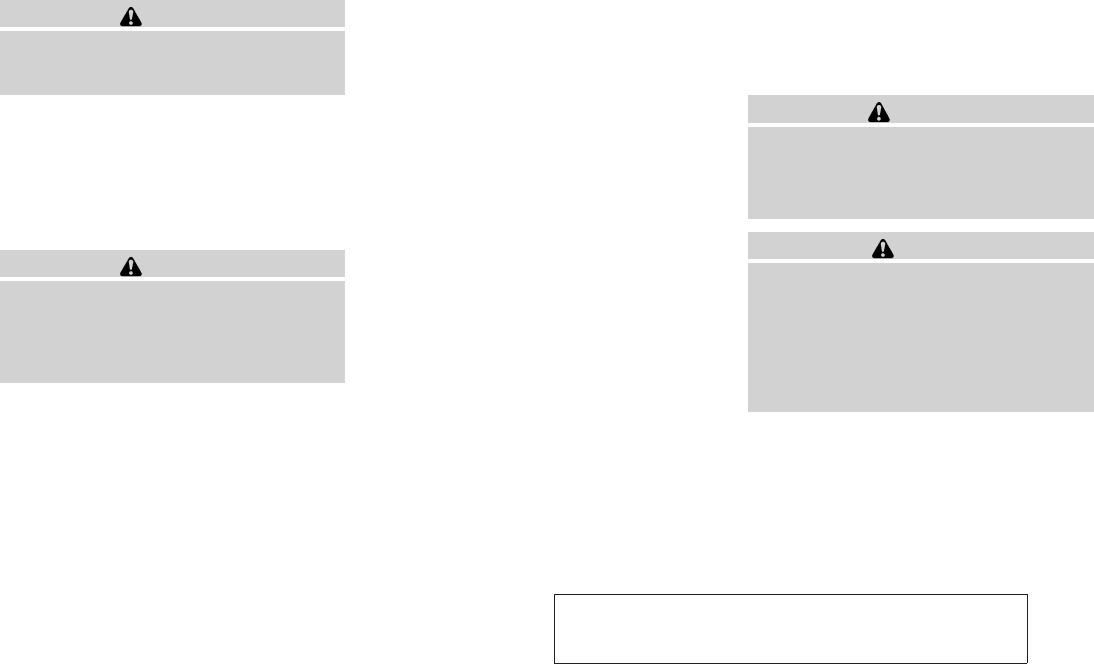
JOBNAME: 1093929-2013-asd-own PAGE: 312 SESS: 5 OUTPUT: Tue Mar 27 10:39:14 2012
3. Get out of the vehicle. Look and listen for
steam or coolant escaping from the radiator
before opening the hood. (If steam or cool-
ant is escaping, turn off the engine.) Do not
open the hood further until no steam or
coolant can be seen.
4. Open the engine hood.
WARNING
If steam or water is coming from the en-
gine, stand clear to prevent getting
burned.
5. Visually check drive belts for damage or
looseness. Also check if the cooling fan is
running. The radiator hoses and radiator
should not leak water. If coolant is leaking,
the water pump belt is missing or loose, or
the cooling fan does not run, stop the en-
gine.
WARNING
Be careful not to allow your hands, hair,
jewelry or clothing to come into contact
with, or get caught in, engine belts or the
engine cooling fan. The engine cooling
fan can start at any time.
6. After the engine cools down, check the cool-
ant level in the engine coolant reservoir tank
with the engine running. Add coolant to the
engine coolant reservoir tank if necessary.
Have your vehicle repaired at a NISSAN
dealer.
When towing your vehicle, all State (Provincial in
Canada) and local regulations for towing must be
followed. Incorrect towing equipment could dam-
age your vehicle. Towing instructions are avail-
able from a NISSAN dealer. Local service opera-
tors are generally familiar with the applicable laws
and procedures for towing. To assure proper
towing and to prevent accidental damage to your
vehicle, NISSAN recommends having a service
operator tow your vehicle. It is advisable to have
the service operator carefully read the following
precautions:
WARNING
●Never ride in a vehicle that is being
towed.
●Never get under your vehicle after it has
been lifted by a tow truck.
CAUTION
●When towing, make sure that the trans-
mission, axles, steering system and
powertrain are in working condition. If
any of these conditions apply, dollies or
a flatbed tow truck must be used.
●Always attach safety chains before
towing.
TOWING YOUR VEHICLE
6-10 In case of emergency
ZREVIEW COPY—
2013 Altima Sedan (asd)
Owners Manual—USA_English (nna)
03/27/12—dmoore
X
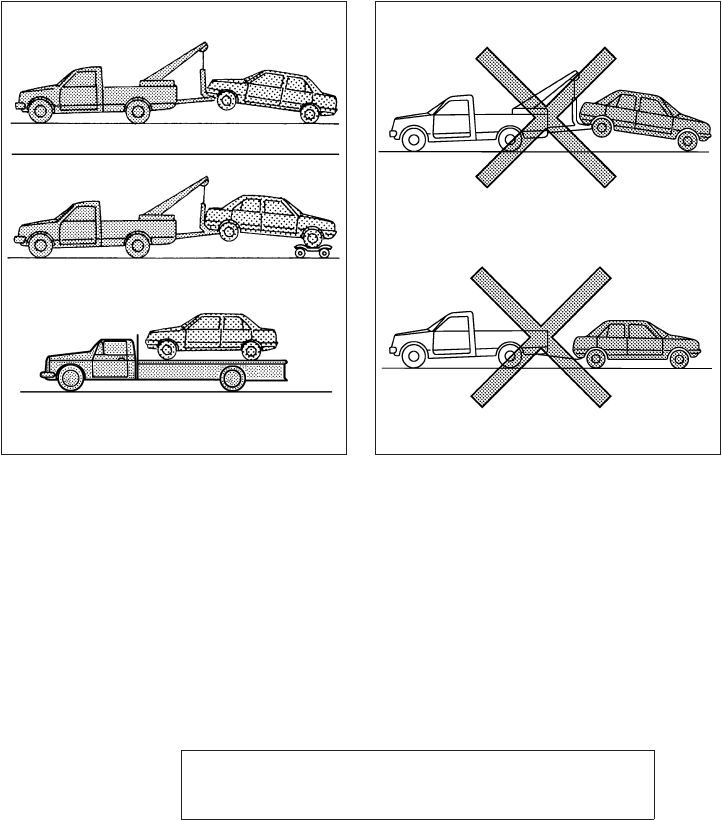
JOBNAME: 1093929-2013-asd-own PAGE: 313 SESS: 5 OUTPUT: Tue Mar 27 10:39:14 2012
For information about towing your vehicle behind
a recreational vehicle (RV), refer to “Flat towing”
in the “Technical and consumer information” sec-
tion of this manual.
TOWING RECOMMENDED BY
NISSAN
NISSAN recommends that your vehicle be towed
with the driving (front) wheels off the ground or
place the vehicle on a flat bed truck as illustrated.
ACE0511 SCE0199A
In case of emergency 6-11
ZREVIEW COPY—
2013 Altima Sedan (asd)
Owners Manual—USA_English (nna)
03/27/12—dmoore
X

JOBNAME: 1093929-2013-asd-own PAGE: 314 SESS: 5 OUTPUT: Tue Mar 27 10:39:14 2012
CAUTION
●Never tow Continuously Variable Trans-
mission (CVT) models with the front
wheels on the ground or four wheels on
the ground (forward or backward), as
this may cause serious and expensive
damage to the transmission. If it is nec-
essary to tow the vehicle with the rear
wheels raised always use towing dollies
under the front wheels.
●When towing Continuously Variable
Transmission (CVT) models with the
front wheels on towing dollies:
– Place the ignition switch in the OFF
position, and secure the steering
wheel in a straight-ahead position
with a rope or similar device.
– Move the shift selector to the N (Neu-
tral) position.
●When towing Continuously Variable
Transmission (CVT) models with the
rear wheels on the ground (if you do not
use towing dollies): Always release the
parking brake.
VEHICLE RECOVERY (freeing a stuck
vehicle)
Pulling a stuck vehicle
WARNING
To avoid vehicle damage, serious per-
sonal injury or death when recovering a
stuck vehicle:
●Contact a professional towing service
to recover the vehicle if you have any
questions regarding the recovery
procedure.
●Do not use the vehicle tie-downs to tow
or free a stuck vehicle.
●Only use devices specifically designed
for vehicle recovery and follow the
manufacturer’s instructions.
●Always pull the recovery device straight
out from the front of the vehicle. Never
pull at an angle.
●Route recovery devices so they do not
touch any part of the vehicle except the
attachment point.
If your vehicle is stuck in sand, snow, mud, etc.,
use a tow strap or other device designed specifi-
cally for vehicle recovery. Always follow the
manufacturer’s instructions for the recovery de-
vice.
Do not use the tie-down hooks for towing or
vehicle recovery.
Rocking a stuck vehicle
WARNING
●Stand clear of a stuck vehicle.
●Do not spin your tires at high speed.
This could cause them to explode and
result in serious injury. Parts of your
vehicle could also overheat and be
damaged.
If your vehicle is stuck in sand, snow, mud, etc.,
use the following procedure:
1. Turn off the Vehicle Dynamic Control (VDC)
system.
2. Make sure the area in front and behind the
vehicle is clear of obstructions.
3. Turn the steering wheel right and left to clear
an area around the front tires.
6-12 In case of emergency
ZREVIEW COPY—
2013 Altima Sedan (asd)
Owners Manual—USA_English (nna)
03/27/12—dmoore
X

JOBNAME: 1093929-2013-asd-own PAGE: 315 SESS: 5 OUTPUT: Tue Mar 27 10:39:14 2012
4. Slowly rock the vehicle forward and back-
ward.
●Shift back and forth between R (Reverse)
and D (Drive).
●Apply the accelerator as little as possible
to maintain the rocking motion.
●Release the accelerator pedal before
shifting between R (Reverse) and D
(Drive).
●Do not spin the tires above 35 MPH (55
km/h).
5. If the vehicle cannot be freed after a few
tries, contact a professional towing service
to remove the vehicle.
In case of emergency 6-13
ZREVIEW COPY—
2013 Altima Sedan (asd)
Owners Manual—USA_English (nna)
03/27/12—dmoore
X

JOBNAME: 1093929-2013-asd-own PAGE: 316 SESS: 5 OUTPUT: Tue Mar 27 10:39:14 2012
MEMO
6-14 In case of emergency
ZREVIEW COPY—
2013 Altima Sedan (asd)
Owners Manual—USA_English (nna)
03/27/12—dmoore
X

JOBNAME: 1093929-2013-asd-own PAGE: 317 SESS: 5 OUTPUT: Tue Mar 27 10:39:14 2012
7 Appearance and care
Cleaningexterior..................................7-2
Washing ......................................7-2
Waxing........................................7-2
Removingspots................................7-3
Underbody ....................................7-3
Glass.........................................7-3
Aluminum alloy wheels (if so equipped) . . . . . . . . . . . 7-3
Chromeparts..................................7-4
Tiredressings..................................7-4
Cleaninginterior...................................7-4
Airfresheners..................................7-5
Floormats.....................................7-5
Seatbelts .....................................7-6
Corrosion protection . . . . . . . . . . . . . . . . . . . . . . . . . . . . . . . 7-6
Most common factors contributing to vehicle
corrosion......................................7-6
Environmental factors influence the rate of
corrosion......................................7-6
To protect your vehicle from corrosion . . . . . . . . . . . . 7-6
ZREVIEW COPY—
2013 Altima Sedan (asd)
Owners Manual—USA_English (nna)
03/27/12—dmoore
X

JOBNAME: 1093929-2013-asd-own PAGE: 318 SESS: 5 OUTPUT: Tue Mar 27 10:39:14 2012
In order to maintain the appearance of your ve-
hicle, it is important to take proper care of it.
To protect the paint surfaces, please wash your
vehicle as soon as you can:
●after a rainfall to prevent possible damage
from acid rain.
●after driving on coastal roads.
●when contaminants such as soot, bird drop-
pings, tree sap, metal particles or bugs get
on the paint surface.
●when dust or mud builds up on the surface.
Whenever possible, store or park your vehicle
inside a garage or in a covered area.
When it is necessary to park outside, park in a
shady area or protect the vehicle with a body
cover.
Be careful not to scratch the paint surface
when putting on or removing the body
cover.
WASHING
Wash dirt off with a wet sponge and plenty of
water. Clean the vehicle thoroughly using a mild
soap, a special vehicle soap or general purpose
dishwashing liquid mixed with clean, lukewarm
(never hot) water.
CAUTION
●Do not use car washes that use acid in
the detergent. Some car washes, espe-
cially brushless ones, use some acid for
cleaning. The acid may react with some
plastic vehicle components, causing
them to crack. This could affect their
appearance, and also could cause them
not to function properly. Always check
with your car wash to confirm that acid
is not used.
●Do not wash the vehicle with strong
household soap, strong chemical deter-
gents, gasoline or solvents.
●Do not wash the vehicle in direct sun-
light or while the vehicle body is hot, as
the surface may become water-spotted.
●Avoid using tight-napped or rough
cloths, such as washing mitts. Care
must be taken when removing
caked-on dirt or other foreign sub-
stances so the paint surface is not
scratched or damaged.
Rinse the vehicle thoroughly with plenty of clean
water.
Inside flanges, seams and folds on the doors,
hatches and hood are particularly vulnerable to
the effects of road salt. Therefore, these areas
must be cleaned regularly. Take care that the
drain holes in the lower edge of the door are
open. Spray water under the body and in the
wheel wells to loosen the dirt and wash away
road salt.
A damp chamois can be used to dry the vehicle to
avoid water spots.
WAXING
Regular waxing protects the paint surface and
helps retain new vehicle appearance. Polishing is
recommended to remove built-up wax residue
and to avoid a weathered appearance before
re-applying wax.
A NISSAN dealer can assist you in choosing the
proper product.
●Wax your vehicle only after a thorough wash-
ing. Follow the instructions supplied with the
wax.
●Do not use a wax containing any abrasives,
cutting compounds or cleaners that may
damage the vehicle finish.
Machine compounding or aggressive polishing
on a base coat/clear coat paint finish may dull the
finish or leave swirl marks.
CLEANING EXTERIOR
7-2 Appearance and care
ZREVIEW COPY—
2013 Altima Sedan (asd)
Owners Manual—USA_English (nna)
03/27/12—dmoore
X
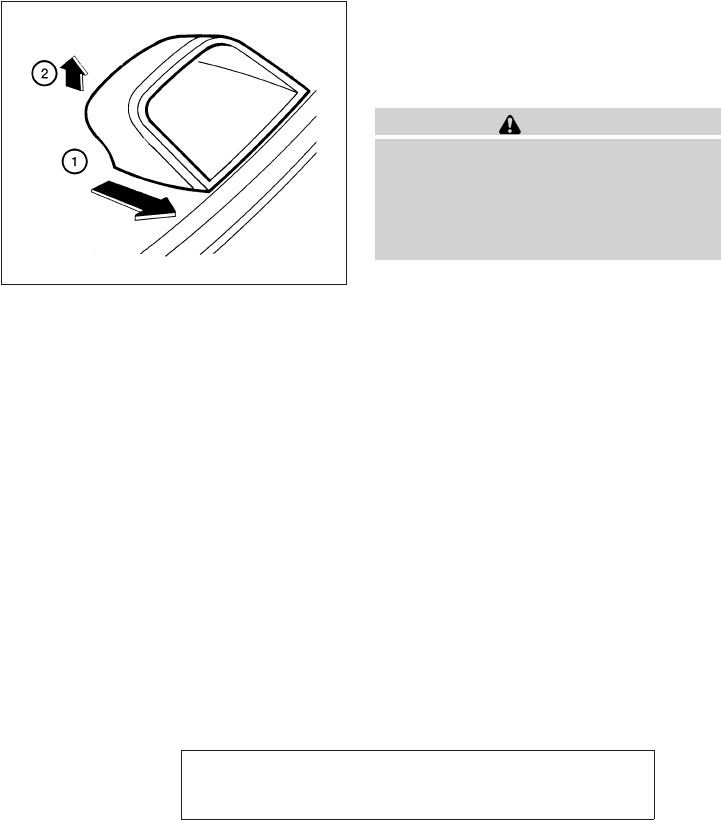
JOBNAME: 1093929-2013-asd-own PAGE: 319 SESS: 5 OUTPUT: Tue Mar 27 10:39:14 2012
REMOVING SPOTS
Remove tar and oil spots, industrial dust, insects,
and tree sap as quickly as possible from the
surface of the paint to avoid lasting damage or
staining. Special cleaning products are available
at a NISSAN dealer or any automotive accessory
store.
UNDERBODY
In areas where road salt is used in winter, it is
necessary to clean the underbody regularly in
order to prevent dirt and salt from building up and
causing the acceleration of corrosion on the un-
derbody and suspension. Before the winter pe-
riod and again in the spring, the underseal must
be checked and, if necessary, retreated. GLASS
When cleaning the rear window, it may be easier
to clean if the high-mounted stop light (if so
equipped) is removed first.
Be careful when removing the high-mounted
stop light to reduce the risk of damaging the
high-mounted stop light wires.
To remove the high-mounted stop light:
s
1Push toward rear of vehicle.
s
2Lift to remove.
The high-mounted stop light must be properly
reinstalled before driving your vehicle.
Use glass cleaner to remove smoke and dust film
from the glass surfaces. It is normal for glass to
become coated with a film after the vehicle is
parked in the hot sun. Glass cleaner and a soft
cloth will easily remove this film.
CAUTION
When cleaning the inside of the windows,
do not use sharp-edged tools, abrasive
cleaners or chlorine-based disinfectant
cleaners. They could damage the electri-
cal conductors, radio antenna elements or
rear window defroster elements.
ALUMINUM ALLOY WHEELS (if so
equipped)
Wash the wheels regularly with a sponge damp-
ened in a mild soap solution, especially during
winter months in areas where road salt is used. If
not removed, road salt can discolor the wheels.
WAI0005
Appearance and care 7-3
ZREVIEW COPY—
2013 Altima Sedan (asd)
Owners Manual—USA_English (nna)
03/27/12—dmoore
X

JOBNAME: 1093929-2013-asd-own PAGE: 320 SESS: 5 OUTPUT: Tue Mar 27 10:39:14 2012
CAUTION
Follow the directions below to avoid
staining or discoloring the wheels:
●Do not use a cleaner that uses strong
acid or alkali contents to clean the
wheels.
●Do not apply wheel cleaners to the
wheels when they are hot. The wheel
temperature should be the same as am-
bient temperature.
●Rinse the wheel to completely remove
the cleaner within 15 minutes after the
cleaner is applied.
CHROME PARTS
Clean all chrome parts regularly with a non-
abrasive chrome polish to maintain the finish.
TIRE DRESSINGS
NISSAN does not recommend the use of tire
dressings. Tire manufacturers apply a coating to
the tires to help reduce discoloration of the rub-
ber. If a tire dressing is applied to the tires, it may
react with the coating and form a compound. This
compound may come off the tire while driving and
stain the vehicle paint.
If you choose to use a tire dressing, take the
following precautions:
●Use a water-based tire dressing. The coat-
ing on the tire dissolves more easily than
with an oil-based tire dressing.
●Apply a light coat of tire dressing to help
prevent it from entering the tire
tread/grooves (where it would be difficult to
remove).
●Wipe off excess tire dressing using a dry
towel. Make sure the tire dressing is com-
pletely removed from the tire tread/grooves.
●Allow the tire dressing to dry as recom-
mended by the tire dressing manufacturer.
Occasionally remove loose dust from the interior
trim, plastic parts and seats using a vacuum
cleaner or soft bristled brush. Wipe the vinyl and
leather surfaces with a clean, soft cloth damp-
ened in mild soap solution, then wipe clean with a
dry, soft cloth.
Regular care and cleaning is required in order to
maintain the appearance of the leather.
Before using any fabric protector, read the manu-
facturer’s recommendations. Some fabric pro-
tectors contain chemicals that may stain or
bleach the seat material.
Use a cloth dampened only with water to clean
the meter and gauge lens.
CAUTION
●Never use benzine, thinner or any simi-
lar material.
●Small dirt particles can be abrasive and
damaging to leather surfaces and
should be removed promptly. Do not
use saddle soap, car waxes, polishes,
oils, cleaning fluids, solvents, deter-
gents or ammonia-based cleaners as
they may damage the leather’s natural
finish.
CLEANING INTERIOR
7-4 Appearance and care
ZREVIEW COPY—
2013 Altima Sedan (asd)
Owners Manual—USA_English (nna)
03/27/12—dmoore
X
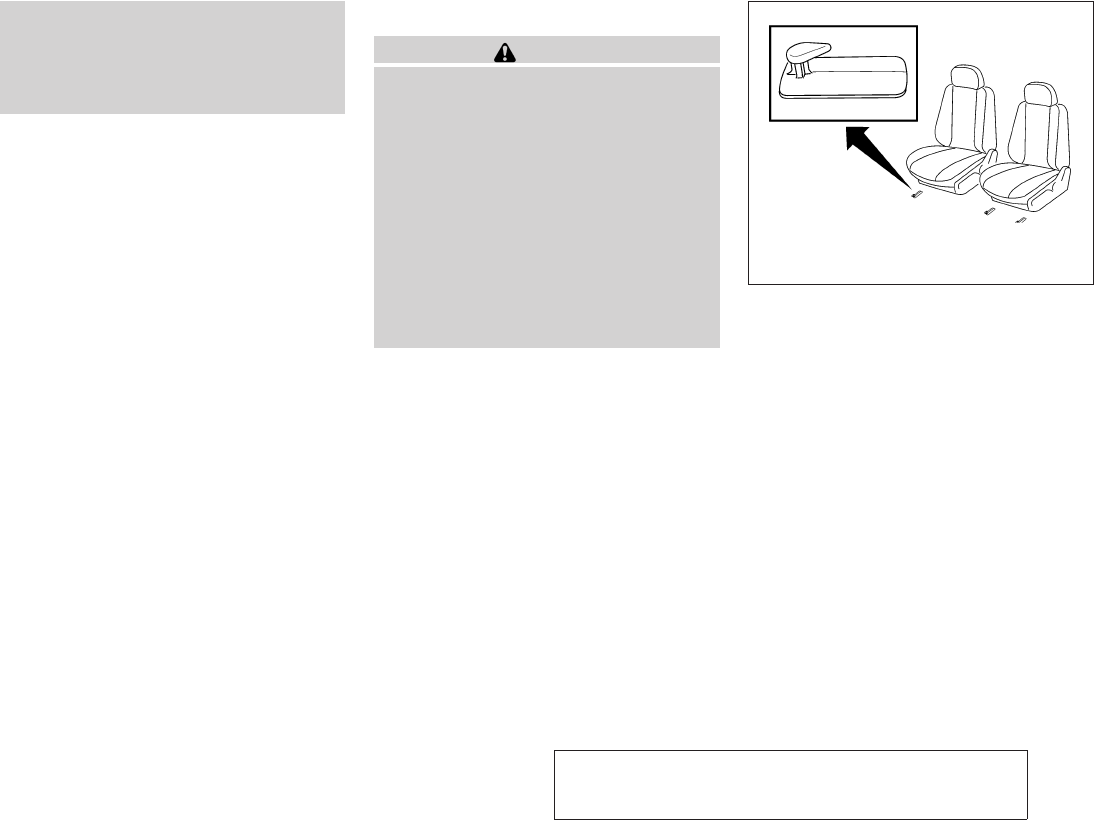
JOBNAME: 1093929-2013-asd-own PAGE: 321 SESS: 5 OUTPUT: Tue Mar 27 10:39:14 2012
●Never use fabric protectors unless rec-
ommended by the manufacturer.
●Do not use glass or plastic cleaner on
meter or gauge lens covers. It may dam-
age the lens cover.
AIR FRESHENERS
Most air fresheners use a solvent that could affect
the vehicle interior. If you use an air freshener,
take the following precautions:
●Hanging-type air fresheners can cause per-
manent discoloration when they contact ve-
hicle interior surfaces. Place the air fresh-
ener in a location that allows it to hang free
and not contact an interior surface.
●Liquid-type air fresheners typically clip on
the vents. These products can cause imme-
diate damage and discoloration when
spilled on interior surfaces.
Carefully read and follow the manufacturer’s in-
structions before using the air fresheners.
FLOOR MATS
WARNING
To avoid potential pedal interference that
may result in a collision or injury:
●NEVER place a floor mat on top of an-
other floor mat in the driver front
position.
●Use only genuine NISSAN floor mats
specifically designed for use in your ve-
hicle model. See your NISSAN dealer
for more information.
●Properly position the mats in the floor-
well using the floor mat positioning aid.
See (Floor mat positioning aid(in this
section.
The use of genuine NISSAN floor mats can ex-
tend the life of your vehicle carpet and make it
easier to clean the interior. Mats should be main-
tained with regular cleaning and replaced if they
become excessively worn.
Floor mat positioning aid
This vehicle includes two driver’s side front floor
mat brackets and one passenger’s side front floor
mat bracket to help keep your floor mats in place.
Genuine NISSAN floor mats have been specially
designed for your vehicle model. The driver’s side
floor mat has two grommet holes incorporated in
it and the passenger’s side has one grommet
hole. Position each mat by placing the floor mat
bracket hook through the floor mat grommet
holes while centering the mat in the floorwell.
Periodically check to make certain the mats are
properly positioned.
LAI0009
Appearance and care 7-5
ZREVIEW COPY—
2013 Altima Sedan (asd)
Owners Manual—USA_English (nna)
03/27/12—dmoore
X

JOBNAME: 1093929-2013-asd-own PAGE: 322 SESS: 5 OUTPUT: Tue Mar 27 10:39:14 2012
SEAT BELTS
The seat belts can be cleaned by wiping them
with a sponge dampened in a mild soap solution.
Allow the belts to dry completely in the shade
before using them. See “Seat belt maintenance”
in the “Safety – Seats, seat belts and supplemen-
tal restraint system” section of this manual.
WARNING
Do not allow wet seat belts to roll up in the
retractor. NEVER use bleach, dye or
chemical solvents to clean the seat belts,
since these materials may severely
weaken the seat belt webbing.
MOST COMMON FACTORS
CONTRIBUTING TO VEHICLE
CORROSION
●The accumulation of moisture-retaining dirt
and debris in body panel sections, cavities,
and other areas.
●Damage to paint and other protective coat-
ings caused by gravel and stone chips or
minor traffic accidents.
ENVIRONMENTAL FACTORS
INFLUENCE THE RATE OF
CORROSION
Moisture
Accumulation of sand, dirt and water on the ve-
hicle body underside can accelerate corrosion.
Wet floor coverings will not dry completely inside
the vehicle and should be removed for drying to
avoid floor panel corrosion.
Relative humidity
Corrosion will be accelerated in areas of high
relative humidity, especially those areas where
the temperatures stay above freezing and where
atmospheric pollution exists and road salt is
used.
Temperature
High temperatures accelerate the rate of corro-
sion to those parts which are not well ventilated.
Air pollution
Industrial pollution, the presence of salt in the air
in coastal areas, or heavy road salt use acceler-
ates the corrosion process. Road salt also accel-
erates the disintegration of paint surfaces.
TO PROTECT YOUR VEHICLE
FROM CORROSION
●Wash and wax your vehicle often to keep the
vehicle clean.
●Always check for minor damage to the paint
and repair it as soon as possible.
●Keep drain holes at the bottom of the doors
open to avoid water accumulation.
●Check the underbody for accumulation of
sand, dirt or salt. If present, wash with water
as soon as possible.
CORROSION PROTECTION
7-6 Appearance and care
ZREVIEW COPY—
2013 Altima Sedan (asd)
Owners Manual—USA_English (nna)
03/27/12—dmoore
X
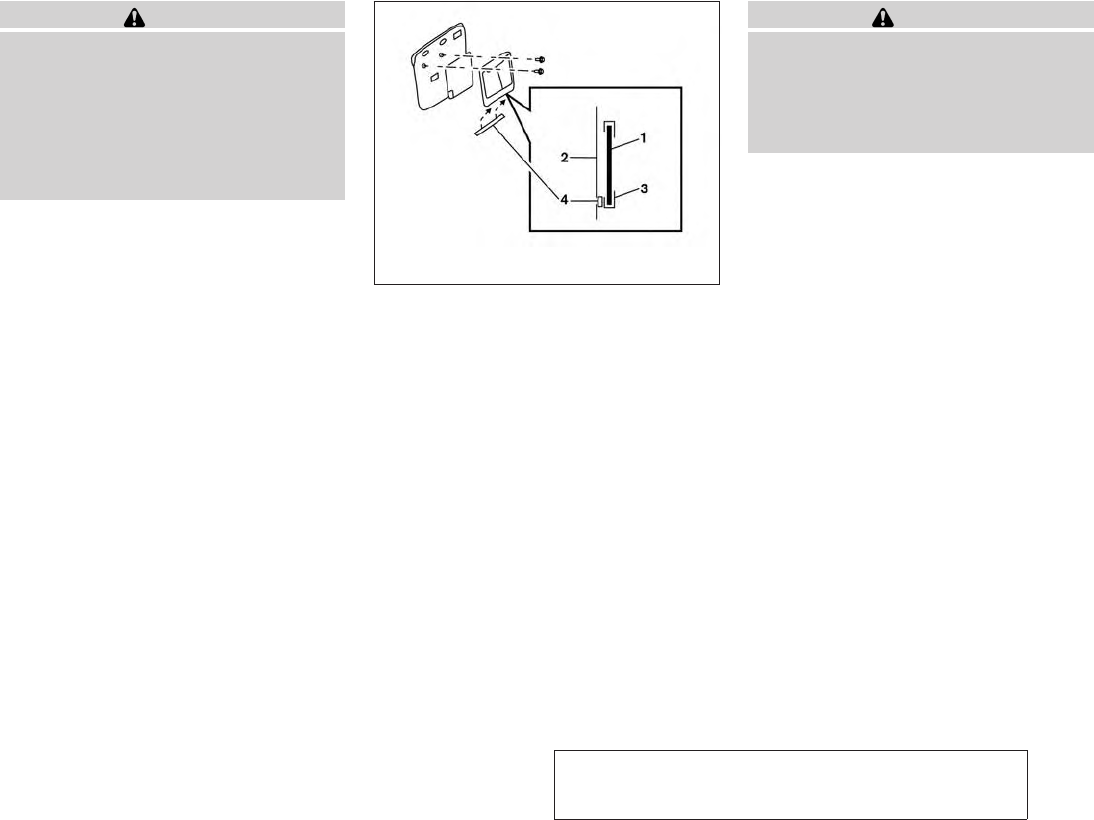
JOBNAME: 1093929-2013-asd-own PAGE: 323 SESS: 5 OUTPUT: Tue Mar 27 10:39:14 2012
CAUTION
●NEVER remove dirt, sand or other de-
bris from the passenger compartment
by washing it out with a hose. Remove
dirt with a vacuum cleaner or broom.
●Never allow water or other liquids to
come in contact with electronic compo-
nents inside the vehicle as this may
damage them.
Chemicals used for road surface de-icing are
extremely corrosive. They accelerate corrosion
and deterioration of underbody components
such as the exhaust system, fuel and brake lines,
brake cables, floor pan and fenders.
In winter, the underbody must be cleaned
periodically.
For additional protection against rust and corro-
sion, which may be required in some areas, con-
sult a NISSAN dealer.
License plate bracket padding
1. License plate
2. Trunk
3. License plate frame
4. Padding
CAUTION
A license plate frame could vibrate and
cause noise or paint damage. To avoid
damage or noise, add a soft adhesive pad
with a maximum thickness of 1/8 in (4
mm) to the back lower edge of the license
plate frame.
LAI2001
Appearance and care 7-7
ZREVIEW COPY—
2013 Altima Sedan (asd)
Owners Manual—USA_English (nna)
03/27/12—dmoore
X

JOBNAME: 1093929-2013-asd-own PAGE: 324 SESS: 5 OUTPUT: Tue Mar 27 10:39:14 2012
8 Maintenance and do-it-yourself
Maintenance requirements. . . . . . . . . . . . . . . . . . . . . . . . . . 8-2
Generalmaintenance..............................8-2
Explanation of general maintenance items . . . . . . . . . 8-2
Maintenance precautions . . . . . . . . . . . . . . . . . . . . . . . . . . . 8-5
Engine compartment check locations . . . . . . . . . . . . . . . . 8-6
Enginecoolingsystem.............................8-8
Checking engine coolant level . . . . . . . . . . . . . . . . . . . 8-9
Changing engine coolant. . . . . . . . . . . . . . . . . . . . . . . . 8-9
Engineoil........................................8-10
Checking engine oil level . . . . . . . . . . . . . . . . . . . . . . .8-10
Changingengineoil ...........................8-11
Changing engine oil filter . . . . . . . . . . . . . . . . . . . . . . .8-12
Continuously Variable Transmission (CVT) fluid . . . . . . 8-13
Powersteeringfluid...............................8-14
Brakefluid.......................................8-14
Brakefluid....................................8-15
Windshield-washer fluid. . . . . . . . . . . . . . . . . . . . . . . . . . . 8-15
Windshield-washer fluid reservoir . . . . . . . . . . . . . . .8-15
Battery..........................................8-16
Jumpstarting .................................8-18
Variable voltage control system. . . . . . . . . . . . . . . . . . . . .8-18
Drivebelt........................................8-19
Sparkplugs......................................8-20
Replacing spark plugs . . . . . . . . . . . . . . . . . . . . . . . . .8-20
Air cleaner . . . . . . . . . . . . . . . . . . . . . . . . . . . . . . . . . . . . . . .8-20
In-cabin microfilter . . . . . . . . . . . . . . . . . . . . . . . . . . . . .8-21
Windshield wiper blades . . . . . . . . . . . . . . . . . . . . . . . . . .8-21
Cleaning .....................................8-21
Replacing ....................................8-22
Brakes . . . . . . . . . . . . . . . . . . . . . . . . . . . . . . . . . . . . . . . . . .8-23
Self-adjusting brakes . . . . . . . . . . . . . . . . . . . . . . . . . . 8-23
Brake pad wear indicators . . . . . . . . . . . . . . . . . . . . . .8-23
Fuses . . . . . . . . . . . . . . . . . . . . . . . . . . . . . . . . . . . . . . . . . . .8-23
Enginecompartment...........................8-24
Passenger compartment . . . . . . . . . . . . . . . . . . . . . . .8-25
Battery replacement . . . . . . . . . . . . . . . . . . . . . . . . . . . . . . 8-27
NISSAN Intelligent KeyT.......................8-27
Lights . . . . . . . . . . . . . . . . . . . . . . . . . . . . . . . . . . . . . . . . . . .8-28
Headlights. . . . . . . . . . . . . . . . . . . . . . . . . . . . . . . . . . . .8-28
Front park light . . . . . . . . . . . . . . . . . . . . . . . . . . . . . . . .8-29
Fog lights (if so equipped). . . . . . . . . . . . . . . . . . . . . . 8-29
Turn signal lights . . . . . . . . . . . . . . . . . . . . . . . . . . . . . .8-30
Exterior and interior lights. . . . . . . . . . . . . . . . . . . . . . .8-32
Wheels and tires . . . . . . . . . . . . . . . . . . . . . . . . . . . . . . . . . 8-35
Tire pressure. . . . . . . . . . . . . . . . . . . . . . . . . . . . . . . . . .8-35
Tire labeling. . . . . . . . . . . . . . . . . . . . . . . . . . . . . . . . . . . 8-39
ZREVIEW COPY—
2013 Altima Sedan (asd)
Owners Manual—USA_English (nna)
03/27/12—dmoore
X

JOBNAME: 1093929-2013-asd-own PAGE: 325 SESS: 5 OUTPUT: Tue Mar 27 10:39:14 2012
Typesoftires..................................8-42
Tirechains....................................8-43
Changing wheels and tires . . . . . . . . . . . . . . . . . . . . .8-44
ZREVIEW COPY—
2013 Altima Sedan (asd)
Owners Manual—USA_English (nna)
03/27/12—dmoore
X

JOBNAME: 1093929-2013-asd-own PAGE: 326 SESS: 5 OUTPUT: Tue Mar 27 10:39:14 2012
Your NISSAN has been designed to have mini-
mum maintenance requirements with long ser-
vice intervals to save you both time and money.
However, some day-to-day and regular mainte-
nance is essential to maintain your NISSAN’s
good mechanical condition, as well as its emis-
sions and engine performance.
It is the owner’s responsibility to make sure that
the scheduled maintenance, as well as general
maintenance, is performed.
As the vehicle owner, you are the only one who
can ensure that your vehicle receives proper
maintenance. You are a vital link in the mainte-
nance chain.
Scheduled maintenance
For your convenience, both required and optional
scheduled maintenance items are described and
listed in your “NISSAN Service and Maintenance
Guide”. You must refer to that guide to ensure
that necessary maintenance is performed on your
NISSAN at regular intervals.
General maintenance
General maintenance includes those items which
should be checked during normal day-to-day op-
eration. They are essential for proper vehicle op-
eration. It is your responsibility to perform these
maintenance procedures regularly as prescribed.
Performing general maintenance checks requires
minimal mechanical skill and only a few general
automotive tools.
These checks or inspections can be done by you,
a qualified technician, or, if you prefer, a NISSAN
dealer.
Where to go for service
If maintenance service is required or your vehicle
appears to malfunction, have the systems
checked and corrected by a NISSAN dealer.
NISSAN technicians are well-trained specialists
who are kept up-to-date with the latest service
information through technical bulletins, service
tips, and in-dealership training programs. They
are completely qualified to work on NISSAN ve-
hicles before they work on your vehicle, rather
than after they have worked on it.
You can be confident that a NISSAN dealer’s
service department performs the best job to meet
the maintenance requirements on your vehicle —
in a reliable and economical way.
During the normal day-to-day operation of the
vehicle, general maintenance should be per-
formed regularly as prescribed in this section. If
you detect any unusual sounds, vibrations or
smells, be sure to check for the cause or have a
NISSAN dealer do it promptly. In addition, you
should notify a NISSAN dealer if you think that
repairs are required.
When performing any checks or maintenance
work, closely observe the “Maintenance precau-
tions” later in this section.
EXPLANATION OF GENERAL
MAINTENANCE ITEMS
Additional information on the following
items with “ * ” is found later in this section.
Outside the vehicle
The maintenance items listed here should be
performed from time to time, unless otherwise
specified.
Doors and engine hood
Check that the doors
and engine hood operate properly. Also ensure that
all latches lock securely. Lubricate hinges, latches,
latch pins, rollers and links as necessary. Make sure
that the secondary latch keeps the hood from
opening when the primary latch is released.
When driving in areas using road salt or other
corrosive materials, check lubrication frequently.
MAINTENANCE REQUIREMENTS GENERAL MAINTENANCE
8-2 Maintenance and do-it-yourself
ZREVIEW COPY—
2013 Altima Sedan (asd)
Owners Manual—USA_English (nna)
03/27/12—dmoore
X

JOBNAME: 1093929-2013-asd-own PAGE: 327 SESS: 5 OUTPUT: Tue Mar 27 10:39:14 2012
Lights* Clean the headlights on a regular basis.
Make sure that the headlights, stop lights, tail
lights, turn signal lights, and other lights are all
operating properly and installed securely. Also
check headlight aim.
Road wheel nuts (lug nuts)* When checking
the tires, make sure no wheel nuts are missing,
and check for any loose wheel nuts. Tighten if
necessary.
Tire rotation* Tires should be rotated every
7,500 miles (12,000 km).
Tires* Check the pressure with a gauge often
and always prior to long distance trips. If neces-
sary, adjust the pressure in all tires, including the
spare, to the pressure specified. Check carefully
for damage, cuts or excessive wear.
Tire Pressure Monitoring System (TPMS)
transmitter components Replace the TPMS
transmitter grommet seal, valve core and cap
when the tires are replaced due to wear or age.
Wheel alignment and balance If the vehicle
should pull to either side while driving on a
straight and level road, or if you detect uneven or
abnormal tire wear, there may be a need for wheel
alignment. If the steering wheel or seat vibrates at
normal highway speeds, wheel balancing may be
needed.
●For additional information regarding tires,
refer to “Important Tire Safety Information”
(US) or “Tire Safety Information”(Canada) in
the Warranty Information Booklet.
Windshield Clean the windshield on a regular
basis. Check the windshield at least every six
months for cracks or other damage. Have a dam-
aged windshield repaired by a qualified repair
facility.
Windshield wiper blades* Check for cracks or
wear if they do not wipe properly.
Inside the vehicle
The maintenance items listed here should be
checked on a regular basis, such as when per-
forming periodic maintenance, cleaning the ve-
hicle, etc.
Additional information on the following
items with an “*” is found later in this sec-
tion.
Accelerator pedal Check the pedal for smooth
operation and make sure the pedal does not bind
or require uneven effort. Keep the floor mat away
from the pedal.
Brake pedal Check the pedal for smooth opera-
tion. If the brake pedal suddenly goes down fur-
ther than normal, the pedal feels spongy or the
vehicle seems to take longer to stop, see a
NISSAN dealer immediately. Keep the floor mat
away from the pedal.
Brakes Check that the brakes do not pull the
vehicle to one side when applied.
Continuously Variable Transmission (CVT)
P (Park) position mechanism On a fairly
steep hill, check that the vehicle is held securely
with the shift selector in the P (Park) position
without applying any brakes.
Parking brake Check the parking brake opera-
tion regularly. The vehicle should be securely held
on a fairly steep hill with only the parking brake
applied. If the parking brake needs adjustment,
see a NISSAN dealer.
Seats
Check seat position controls such as seat
adjusters, seatback recliner, etc., to ensure they
operate smoothly and all latches lock securely in
every position. Check that the head restraints move
up and down smoothly and the lock knobs (if so
equipped) hold securely in all latched positions.
Seat belts Check that all parts of the seat belt
system (for example, buckles, anchors, adjusters
and retractors) operate properly and smoothly,
and are installed securely. Check the belt web-
bing for cuts, fraying, wear or damage.
Maintenance and do-it-yourself 8-3
ZREVIEW COPY—
2013 Altima Sedan (asd)
Owners Manual—USA_English (nna)
03/27/12—dmoore
X

JOBNAME: 1093929-2013-asd-own PAGE: 328 SESS: 5 OUTPUT: Tue Mar 27 10:39:14 2012
Steering wheel Check for changes in the steer-
ing system, such as excessive freeplay, hard
steering or strange noises.
Warning lights and chimes Make sure all
warning lights and chimes are operating properly.
Windshield wiper and washer* Check that
the wipers and washer operate properly and that
the wipers do not streak.
Windshield defroster Check that the air
comes out of the defroster outlets properly and in
sufficient quantity when operating the heater or
air conditioner.
Under the hood and vehicle
The maintenance items listed here should be
checked periodically (for example, each time you
check the engine oil or refuel).
Battery* Check the fluid level in each cell. It
should be between the MAX and MIN lines. Ve-
hicles operated in high temperatures or under
severe conditions require frequent checks of the
battery fluid level.
NOTE:
Care should be taken to avoid situations that
can lead to potential battery discharge and
potential no-start conditions such as: 1. In-
stallation or extended use of electronic ac-
cessories that consume battery power when
the engine is not running (Phone chargers,
GPS, DVD players, etc.) 2. Vehicle is not
driven regularly and/or only driven short dis-
tances. In these cases, the battery may need
to be charged to maintain battery health.
Brake fluid levels* Make sure that the brake
fluid level is between the MIN and MAX lines on
the reservoir.
Engine coolant level* Check the coolant level
when the engine is cold.
Engine drive belts* Make sure the drive belts
are not frayed, worn, cracked or oily.
Engine oil level* Check the level after parking
the vehicle on a level surface with the engine off.
Wait more than 10 minutes for the oil to drain
back into the oil pan.
Exhaust system Make sure there are no loose
supports, cracks or holes. If the sound of the
exhaust seems unusual or there is a smell of
exhaust fumes, immediately have the exhaust
system inspected by a NISSAN dealer. See “Ex-
haust gas (carbon monoxide)” in the “Starting
and driving” section of this manual.
Fluid leaks
Check under the vehicle for fuel, oil,
water or other fluid leaks after the vehicle has been
parked for a while. Water dripping from the air
conditioner after use is normal. If you should notice
any leaks or if gasoline fumes are evident, check for
the cause and have it corrected immediately.
Power steering fluid level* and lines Check
the level when the fluid is cold, with the engine
off. Check the lines for proper attachment, leaks,
cracks, etc.
Radiator and hoses
Check the front of the radia-
tor and clean off any dirt, insects, leaves, etc., that
may have accumulated. Make sure the hoses have
no cracks, deformation, rot or loose connections.
Underbody
The underbody is frequently exposed
to corrosive substances such as those used on icy
roads or to control dust. It is very important to
remove these substances from the underbody, oth-
erwise rust may form on the floor pan, frame, fuel
lines and exhaust system. At the end of winter, the
underbody should be thoroughly flushed with plain
water, in those areas where mud and dirt may have
accumulated. See the “Appearance and care” sec-
tion of this manual.
Windshield-washer fluid* Check that there is
adequate fluid in the reservoir.
8-4 Maintenance and do-it-yourself
ZREVIEW COPY—
2013 Altima Sedan (asd)
Owners Manual—USA_English (nna)
03/27/12—dmoore
X

JOBNAME: 1093929-2013-asd-own PAGE: 329 SESS: 5 OUTPUT: Tue Mar 27 10:39:14 2012
When performing any inspection or maintenance
work on your vehicle, always take care to prevent
serious accidental injury to yourself or damage to
the vehicle. The following are general precau-
tions which should be closely observed.
WARNING
●Park the vehicle on a level surface, ap-
ply the parking brake securely and
block the wheels to prevent the vehicle
from moving. Move the shift selector to
P (Park).
●Be sure the ignition key is in the OFF or
LOCK position when performing any
parts replacement or repairs.
●If you must work with the engine run-
ning, keep your hands, clothing, hair
and tools away from moving fans, belts
and any other moving parts.
●It is advisable to secure or remove any
loose clothing and remove any jewelry,
such as rings, watches, etc. before
working on your vehicle.
●Always wear eye protection whenever
you work on your vehicle.
●
Your vehicle is equipped with an auto-
matic engine cooling fan. It may come on
at any time without warning, even if the
ignition key is in the OFF position and the
engine is not running. To avoid injury,
always disconnect the negative battery
cable before working near the fan.
●If you must run the engine in an en-
closed space such as a garage, be sure
there is proper ventilation for exhaust
gases to escape.
●Never get under the vehicle while it is
supported only by a jack. If it is neces-
sary to work under the vehicle, support
it with safety stands.
●Keep smoking materials, flame and
sparks away from the fuel tank and
battery.
●On gasoline engine models, the fuel
filter or fuel lines should be serviced by
a NISSAN dealer because the fuel lines
are under high pressure even when the
engine is off.
CAUTION
●Do not work under the hood while the
engine is hot. Turn the engine off and
wait until it cools down.
●Avoid contact with used engine oil and
coolant. Improperly disposed engine
oil, engine coolant and/or other vehicle
fluids can damage the environment. Al-
ways conform to local regulations for
disposal of vehicle fluid.
●Never leave the engine or the CVT re-
lated component harness connector
disconnected while the ignition switch
is in the ON position.
●Never connect or disconnect the battery
or any transistorized component while
the ignition switch is in the ON position.
This “Maintenance and do-it-yourself” section
gives instructions regarding only those items
which are relatively easy for an owner to perform.
A genuine NISSAN service manual is also avail-
able. See “Owner’s Manual/Service Manual or-
der information” in the “Technical and consumer
information” section of this manual.
You should be aware that incomplete or improper
servicing may result in operating difficulties or
excessive emissions, and could affect warranty
coverage. If in doubt about any servicing,
have it done by a NISSAN dealer.
MAINTENANCE PRECAUTIONS
Maintenance and do-it-yourself 8-5
ZREVIEW COPY—
2013 Altima Sedan (asd)
Owners Manual—USA_English (nna)
03/27/12—dmoore
X
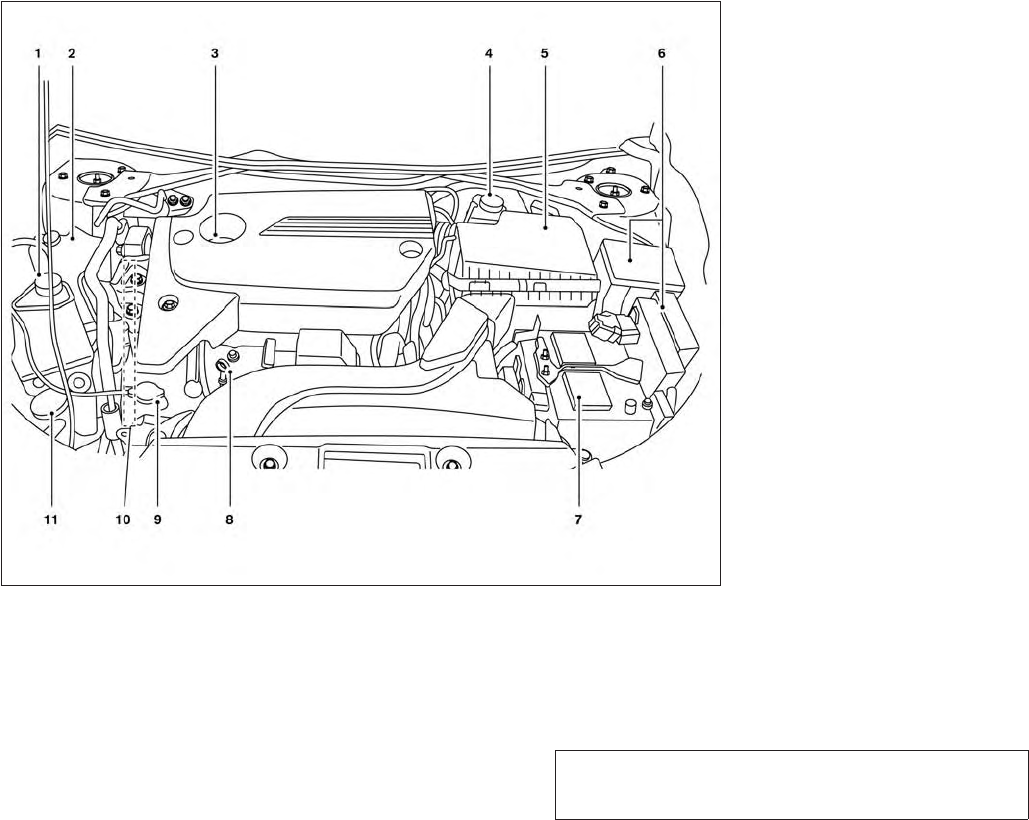
JOBNAME: 1093929-2013-asd-own PAGE: 330 SESS: 5 OUTPUT: Tue Mar 27 10:39:14 2012
QR25DE engine
1. Power steering fluid reservoir
2. Engine coolant reservoir
3. Engine oil filler cap
4. Brake fluid reservoir
5. Air cleaner
6. Fuse block/ Fusible links
7. Battery
8. Engine oil dipstick
9. Radiator cap
10. Drive belt location
11. Windshield-washer fluid reservoir
LDI2111
ENGINE COMPARTMENT CHECK
LOCATIONS
8-6 Maintenance and do-it-yourself
ZREVIEW COPY—
2013 Altima Sedan (asd)
Owners Manual—USA_English (nna)
03/27/12—dmoore
X
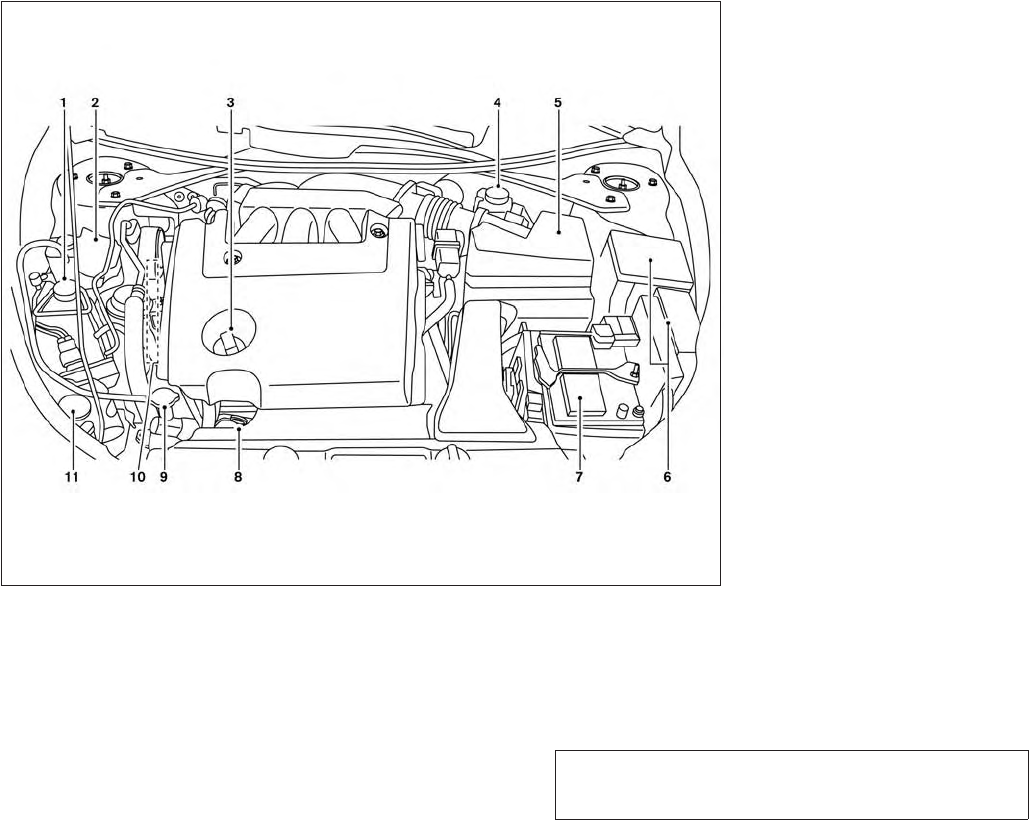
JOBNAME: 1093929-2013-asd-own PAGE: 331 SESS: 5 OUTPUT: Tue Mar 27 10:39:14 2012
VQ35DE engine
1. Power steering fluid reservoir
2. Engine coolant reservoir
3. Engine oil filler cap
4. Brake fluid reservoir
5. Air cleaner
6. Fuse block/ Fusible links
7. Battery
8. Engine oil dipstick
9. Radiator cap
10. Drive belt location
11. Windshield-washer fluid reservoir
LDI2112
Maintenance and do-it-yourself 8-7
ZREVIEW COPY—
2013 Altima Sedan (asd)
Owners Manual—USA_English (nna)
03/27/12—dmoore
X

JOBNAME: 1093929-2013-asd-own PAGE: 332 SESS: 5 OUTPUT: Tue Mar 27 10:39:14 2012
The engine cooling system is filled at the factory
with a pre-diluted mixture of 50% Genuine
NISSAN Engine Coolant (blue) and 50% water
to provide year-round anti-freeze and coolant
protection. The anti-freeze solution contains rust
and corrosion inhibitors. Additional engine cool-
ing system additives are not necessary.
WARNING
●Never remove the radiator or coolant
reservoir cap when the engine is hot.
Wait until the engine and radiator cool
down. Serious burns could be caused
by high pressure fluid escaping from
the radiator. See precautions in “If your
vehicle overheats” found in the “In case
of emergency” section of this manual.
●The radiator is equipped with a pres-
sure type radiator cap. To prevent en-
gine damage, use only a genuine
NISSAN radiator cap.
CAUTION
●Never use any cooling system additives
such as radiator sealer. Additives may
clog the cooling system and cause
damage to the engine, transmission,
and/or cooling system.
●When adding or replacing coolant, be
sure to use only Genuine NISSAN Long
Life Antifreeze/Coolant (blue) or
equivalent. Genuine NISSAN Long Life
Antifreeze/Coolant (blue) is pre-diluted
to provide antifreeze protection to -34°
F (-37° C). If additional freeze protec-
tion is needed due to weather where
you operate your vehicle, add Genuine
NISSAN Long Life Antifreeze/Coolant
(blue) concentrate following the direc-
tions on the container. If an equivalent
coolant other than Genuine NISSAN
Long Life Antifreeze/Coolant (blue) is
used, follow the coolant manufacturer’s
instructions to maintain minimum anti-
freeze protection to -34° F (-37° C). The
use of other types of coolant solutions
other than Genuine NISSAN Long Life
Antifreeze/Coolant (blue) or equivalent
may damage the engine cooling
system.
●The life expectancy of the factory-fill
coolant is 105,000 miles (168,000 km) or
7 years. Mixing any other type of cool-
ant other than Genuine NISSAN Long
Life Antifreeze/Coolant (blue), includ-
ing Genuine NISSAN Long Life
Antifreeze/Coolant (green), or the use
of non-distilled water will reduce the
life expectancy of the factory-fill cool-
ant. Refer to the Nissan Service and
Maintenance Guide for more details.
ENGINE COOLING SYSTEM
8-8 Maintenance and do-it-yourself
ZREVIEW COPY—
2013 Altima Sedan (asd)
Owners Manual—USA_English (nna)
03/27/12—dmoore
X
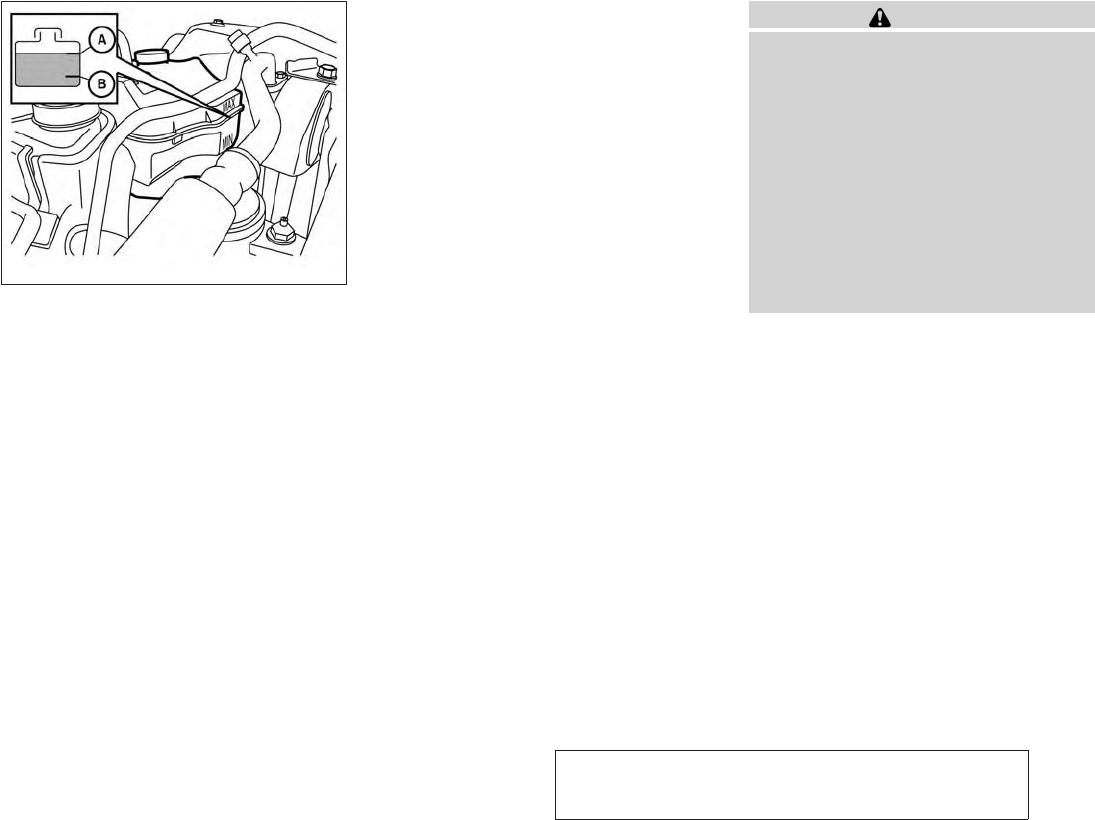
JOBNAME: 1093929-2013-asd-own PAGE: 333 SESS: 5 OUTPUT: Tue Mar 27 10:39:14 2012
CHECKING ENGINE COOLANT
LEVEL
Check the coolant level in the reservoir when
the engine is cold. If the coolant level is below
the MIN level s
B, add coolant to the MAX level
s
A. If the reservoir is empty, check the coolant
level in the radiator when the engine is cold. If
there is insufficient coolant in the radiator, fill the
radiator with coolant up to the filler opening and
also add it to the reservoir up to the MAX level s
A.
This vehicle contains Genuine NISSAN Long Life
Antifreeze/Coolant (blue). The life expectancy of
the factory-fill coolant is 105,000 miles (168,000
km) or 7 years. Mixing any other type of coolant or
the use of non-distilled water will reduce the life
expectancy of the factory-fill coolant. Refer to the
NISSAN Service and Maintenance Guide for
more details.
If the cooling system frequently requires
coolant, have it checked by a NISSAN
dealer.
CHANGING ENGINE COOLANT
A NISSAN dealer can change the engine coolant.
The service procedure can be found in the
NISSAN Service Manual.
Improper servicing can result in reduced
heater performance and engine overheat-
ing.
WARNING
●To avoid the danger of being scalded,
never change the coolant when the en-
gine is hot.
●Never remove the radiator cap when the
engine is hot. Serious burns could be
caused by high pressure fluid escaping
from the radiator.
●Avoid direct skin contact with used
coolant. If skin contact is made, wash
thoroughly with soap or hand cleaner
as soon as possible.
●Keep coolant out of the reach of chil-
dren and pets.
Engine coolant must be disposed of properly.
Check your local regulations.
LDI2119
Maintenance and do-it-yourself 8-9
ZREVIEW COPY—
2013 Altima Sedan (asd)
Owners Manual—USA_English (nna)
03/27/12—dmoore
X
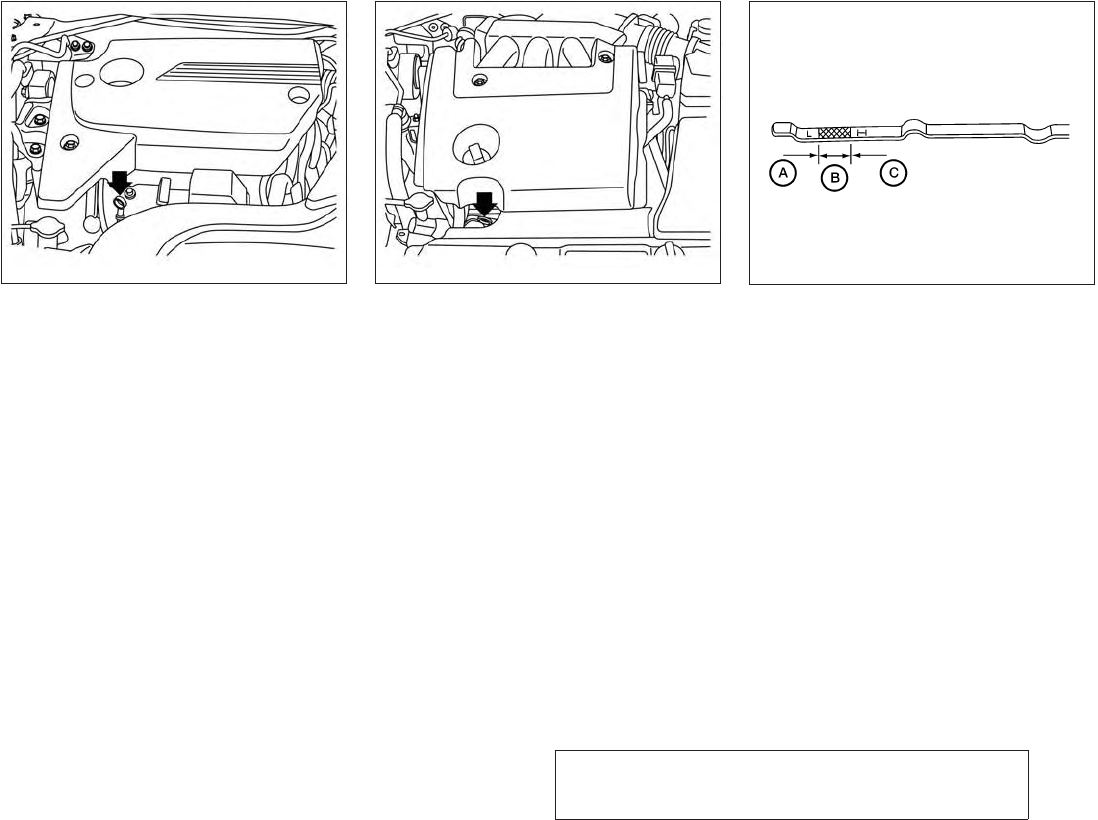
JOBNAME: 1093929-2013-asd-own PAGE: 334 SESS: 5 OUTPUT: Tue Mar 27 10:39:14 2012
CHECKING ENGINE OIL LEVEL
1. Park the vehicle on a level surface and apply
the parking brake.
2. Start the engine and let it idle until it reaches
operating temperature.
3. Turn off the engine. Wait more than 10
minutes for the oil to drain back into
the oil pan.
4. Remove the dipstick and wipe it clean. Re-
insert it all the way.
5. Remove the dipstick again and check the oil
level. It should be between the H (High) and
L (Low) marks s
B. This is the normal oper-
ating oil level range. If the oil level is below
the L (Low) mark s
A, remove the oil filler cap
and pour recommended oil through the
opening. Do not overfill s
C.
6. Recheck oil level with the dipstick.
It is normal to add some oil between oil
maintenance intervals or during the
break-in period, depending on the severity
of operating conditions.
QR25DE engine
LDI2120
VQ35DE engine
LDI2121 WDI0214
ENGINE OIL
8-10 Maintenance and do-it-yourself
ZREVIEW COPY—
2013 Altima Sedan (asd)
Owners Manual—USA_English (nna)
03/27/12—dmoore
X
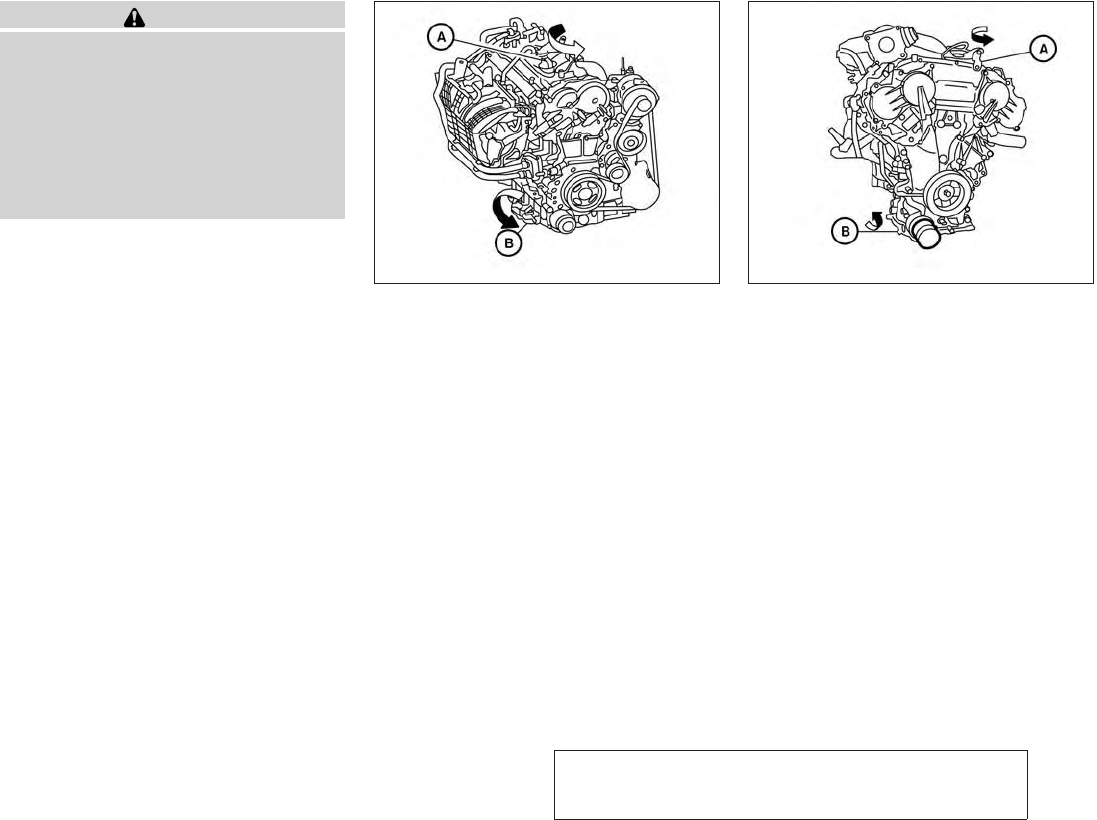
JOBNAME: 1093929-2013-asd-own PAGE: 335 SESS: 5 OUTPUT: Tue Mar 27 10:39:14 2012
CAUTION
●Oil level should be checked regularly.
Operating the engine with an insuffi-
cient amount of oil can damage the
engine, and such damage is not cov-
ered by warranty.
●It is normal to add some oil between oil
maintenance intervals or during the
break-in period, depending on the se-
verity of operating conditions.
CHANGING ENGINE OIL
1. Park the vehicle on a level surface and apply
the parking brake.
2. Start the engine and let it idle until it reaches
operating temperature, then turn it off.
3. Remove the oil filler cap s
Aby turning it
counterclockwise.
4. Place a large drain pan under the drain plug
s
B.
5. Remove the drain plugs
Bwith a wrench by
turning it counterclockwise and completely
drain the oil.
If the oil filter is to be changed, remove and
replace it at this time. See “Changing engine
oil filter” in this section.
●Waste oil must be disposed of prop-
erly.
●Check your local regulations.
QR25DE engine
LDI2123
VQ35DE engine
LDI2145
Maintenance and do-it-yourself 8-11
ZREVIEW COPY—
2013 Altima Sedan (asd)
Owners Manual—USA_English (nna)
03/27/12—dmoore
X
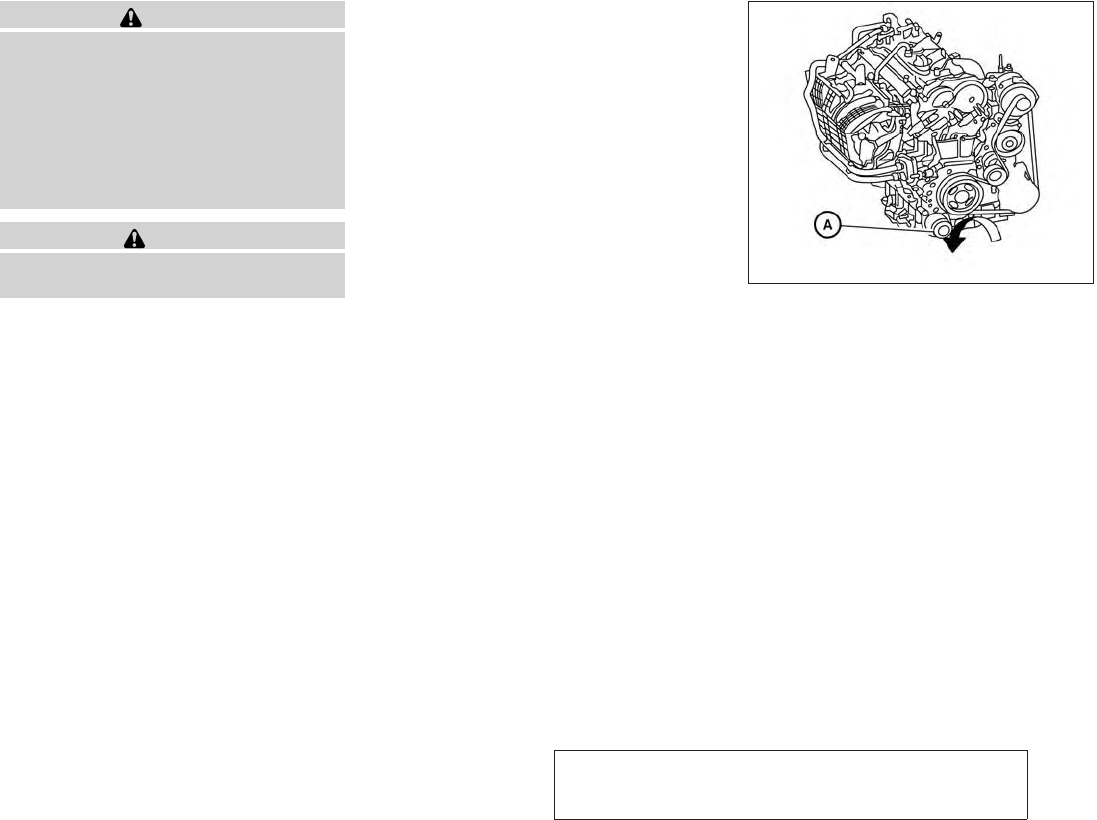
JOBNAME: 1093929-2013-asd-own PAGE: 336 SESS: 5 OUTPUT: Tue Mar 27 10:39:14 2012
WARNING
●Prolonged and repeated contact with
used engine oil may cause skin cancer.
●Try to avoid direct skin contact with
used oil. If skin contact is made, wash
thoroughly with soap or hand cleaner
as soon as possible.
●Keep used engine oil out of reach of
children.
CAUTION
Be careful not to burn yourself. The engine
oil may be hot.
6. Clean and reinstall the drain plug and a new
washer. Securely tighten the drain plug with
a wrench. Do not use excessive force.
Drain plug tightening torque:
29 - 39 N·m (22 - 29 ft-lb)
7. Refill engine with recommended oil through
the oil filler opening, then install the oil filler
cap securely.
See “Capacities and recommended
fuel/lubricants” in the “Technical and con-
sumer information” section of this manual for
drain and refill capacity.
The drain and refill capacity depends on the
oil temperature and drain time. Use these
specifications for reference only. Always use
the dipstick to determine when the proper
amount of oil is in the engine.
8. Start the engine. Check for leakage around
the drain plug and oil filter. Correct as re-
quired.
9. Turn the engine off and wait more than 10
minutes. Check the oil level with the dipstick.
Add engine oil if necessary.
CHANGING ENGINE OIL FILTER
1. Park the vehicle on a level surface and apply
the parking brake.
2. Turn the engine off.
3. Place a large drain pan under the oil filter s
A.
4. Loosen the oil filter s
Awith an oil filter
wrench by turning it counterclockwise. Then
remove the oil filter by turning it by hand.
QR25DE
LDI2122
8-12 Maintenance and do-it-yourself
ZREVIEW COPY—
2013 Altima Sedan (asd)
Owners Manual—USA_English (nna)
03/27/12—dmoore
X
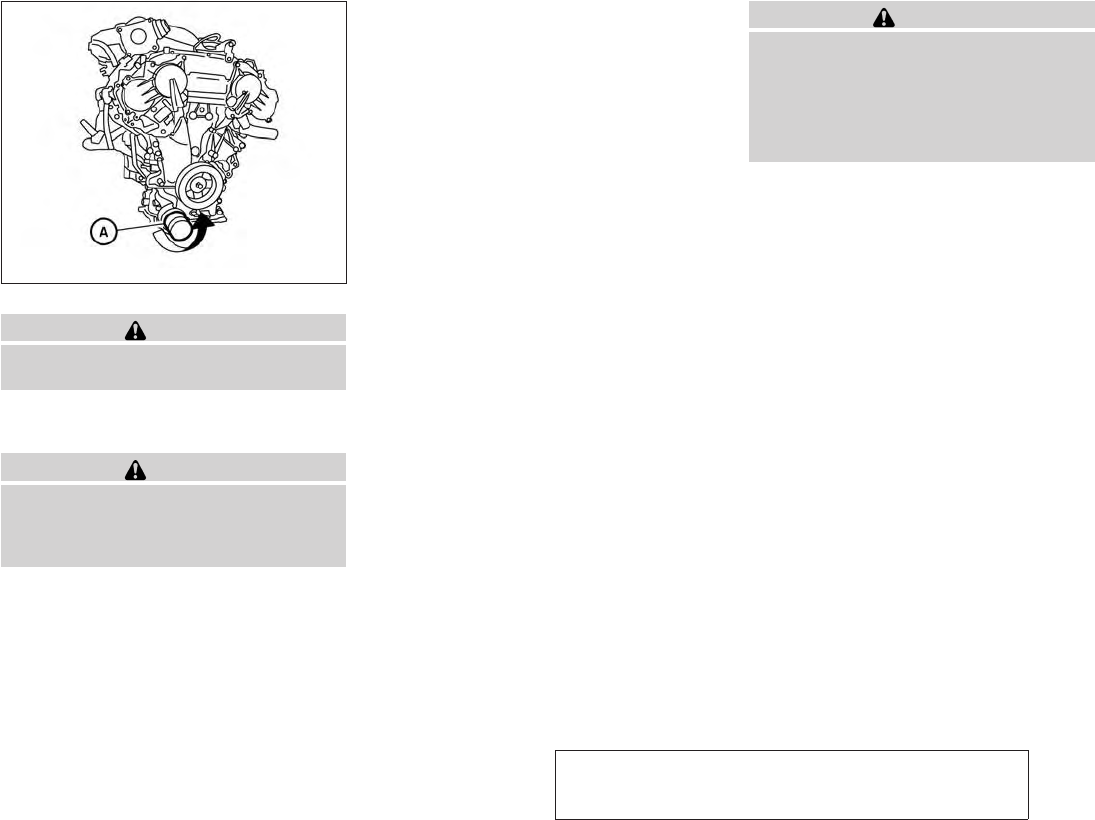
JOBNAME: 1093929-2013-asd-own PAGE: 337 SESS: 5 OUTPUT: Tue Mar 27 10:39:14 2012
CAUTION
Be careful not to burn yourself. The engine
oil may be hot.
5. Wipe the engine oil filter sealing surface with
a clean rag.
CAUTION
Be sure to remove any old gasket material
remaining on the sealing surface of the
engine. Failure to do so could lead to
engine damage.
6. Coat the gasket on the new filter with clean
engine oil.
7. Screw on the oil filter until a slight resistance
is felt, then tighten an additional 2/3 turn.
8. Start the engine and check for leakage
around the oil filter. Correct as required.
9. Turn the engine off and wait more than 10
minutes. Check the oil level. Add engine oil if
necessary.
CAUTION
●Use only Genuine NISSAN CVT Fluid
NS-3. Do not mix with other fluids.
●Using transmission fluid other than
Genuine NISSAN CVT Fluid NS-3 will
damage the CVT, which is not covered
by the warranty.
When checking or replacement of CVT fluid is
required, we recommend your NISSAN dealer for
servicing.
VQ35DE
LDI2143
CONTINUOUSLY VARIABLE
TRANSMISSION (CVT) FLUID
Maintenance and do-it-yourself 8-13
ZREVIEW COPY—
2013 Altima Sedan (asd)
Owners Manual—USA_English (nna)
03/27/12—dmoore
X
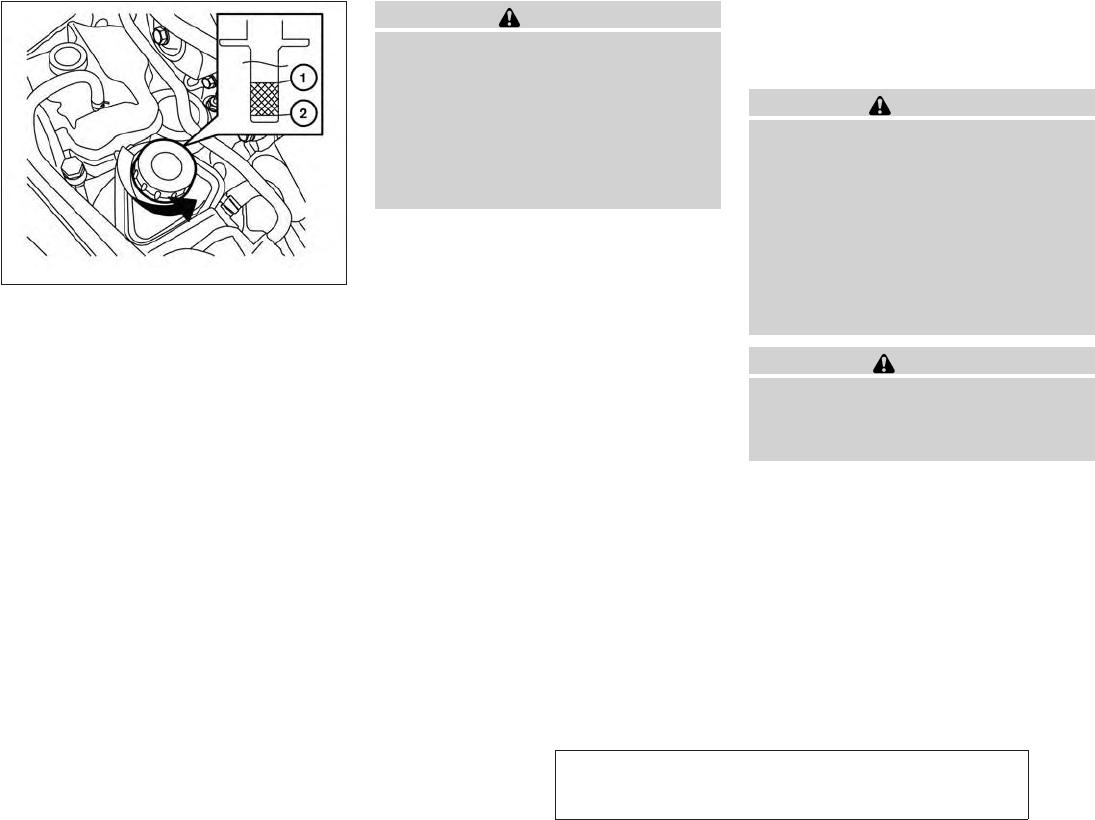
JOBNAME: 1093929-2013-asd-own PAGE: 338 SESS: 5 OUTPUT: Tue Mar 27 10:39:14 2012
Check the fluid level in the reservoir.
The fluid level should be checked when the fluid
is cold at fluid temperatures of 0 to 30ºC (32 to
86ºF). The fluid level can be checked with the
level gauge which is attached to the cap. To
check the fluid level, remove the cap. The fluid
level should be between the MAX s
1and MIN s
2
lines.
If the fluid is below the MIN s
2line, add Genuine
NISSAN E-PSF. Remove the cap and fill through
the opening.
CAUTION
●Do not overfill.
●Use of a power steering fluid other than
Genuine NISSAN E-PSF will prevent the
power steering system from operating
properly.
●Power steering fluid is poisonous and
should be stored carefully in marked
containers out of the reach of children.
For further brake fluid specification information,
refer to “Capacities and recommended
fuel/lubricants” in the “Technical and consumer
information” section of this manual.
WARNING
●Use only new fluid from a sealed con-
tainer. Old, inferior or contaminated
fluid may damage the brake systems.
The use of improper fluids can damage
the brake system and affect the vehi-
cle’s stopping ability.
●Clean the filler cap before removing.
●Brake fluid is poisonous and should be
stored carefully in marked containers
out of reach of children.
CAUTION
Do not spill the fluid on any painted sur-
faces. This will damage the paint. If fluid is
spilled, immediately wash the surface
with water.
LDI2126
POWER STEERING FLUID BRAKE FLUID
8-14 Maintenance and do-it-yourself
ZREVIEW COPY—
2013 Altima Sedan (asd)
Owners Manual—USA_English (nna)
03/27/12—dmoore
X
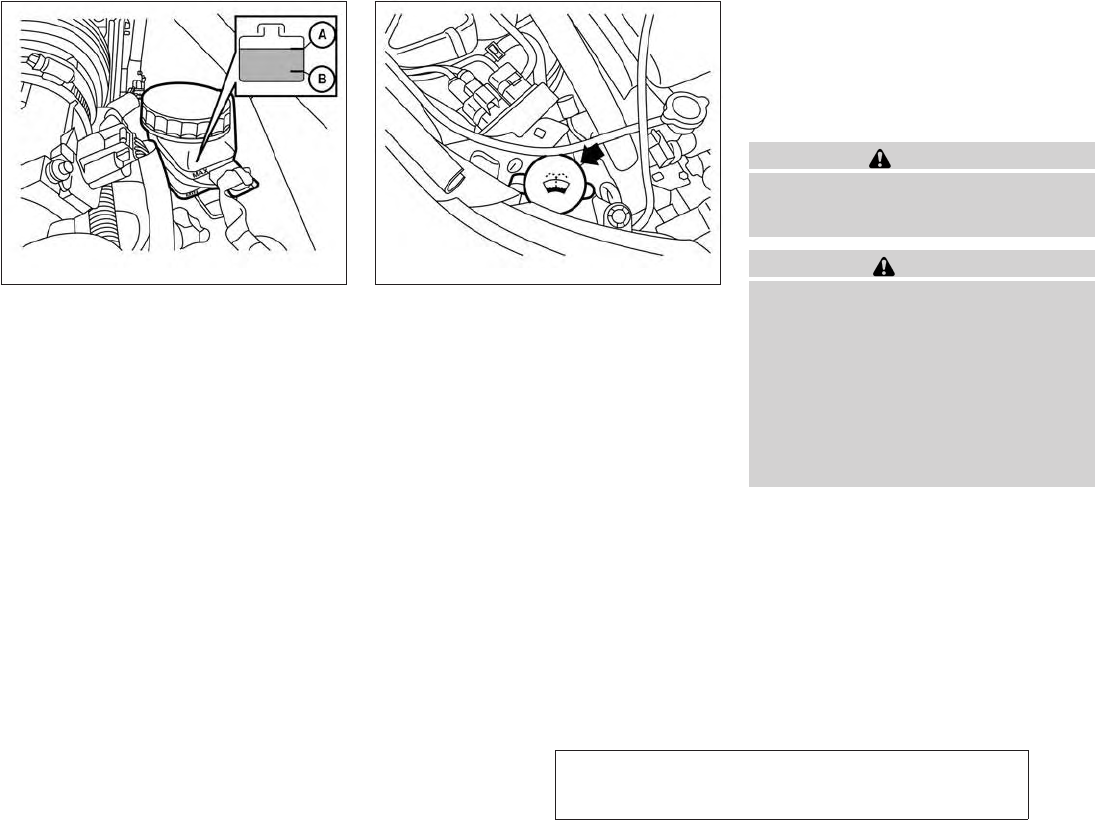
JOBNAME: 1093929-2013-asd-own PAGE: 339 SESS: 5 OUTPUT: Tue Mar 27 10:39:14 2012
BRAKE FLUID
Check the brake fluid level in the reservoir. If the
fluid level is below the MIN line or the brake
warning light comes on, add Genuine NISSAN
Super Heavy Duty Brake Fluid or equivalent DOT
3fluid up to the MAX line. If fluid must be added
frequently, the system should be checked by a
NISSAN dealer.
WINDSHIELD-WASHER FLUID
RESERVOIR
Fill the windshield-washer fluid reservoir periodi-
cally. Add windshield-washer fluid when the low
windshield-washer fluid warning light comes on.
To fill the windshield-washer fluid reservoir, lift
the cap off the reservoir and pour the windshield-
washer fluid into the reservoir opening.
Add a washer solvent to the washer for better
cleaning. In the winter season, add a windshield
washer antifreeze. Follow the manufacturer’s in-
structions for the mixture ratio.
Refill the reservoir more frequently when driving
conditions require an increased amount of
windshield-washer fluid.
Recommended fluid is Genuine NISSAN Wind-
shield Washer Concentrate Cleaner & Anti-
freeze or equivalent.
WARNING
Anti-freeze is is poisonous and should be
stored carefully in marked containers out
of the reach of children.
CAUTION
●Do not substitute engine anti-freeze
coolant for windshield-washer fluid.
This may result in damage to the paint.
●Do not fill the windshield-washer fluid
reservoir with washer fluid concen-
trates at full strength. Some methyl al-
cohol based washer fluid concentrates
may permanently stain the grille if
spilled while filling the windshield-
washer fluid reservoir.
LDI2125 LDI2116
WINDSHIELD-WASHER FLUID
Maintenance and do-it-yourself 8-15
ZREVIEW COPY—
2013 Altima Sedan (asd)
Owners Manual—USA_English (nna)
03/27/12—dmoore
X

JOBNAME: 1093929-2013-asd-own PAGE: 340 SESS: 5 OUTPUT: Tue Mar 27 10:39:14 2012
●Pre-mix washer fluid concentrates with
water to the manufacturer’s recom-
mended levels before pouring the fluid
into the windshield-washer fluid reser-
voir. Do not use the windshield-washer
fluid reservoir to mix the washer fluid
concentrate and water.
●Keep the battery surface clean and dry.
Clean the battery with a solution of baking
soda and water.
●Make certain the terminal connections are
clean and securely tightened.
●If the vehicle is not to be used for 30 days or
longer, disconnect the negative (-) battery
terminal cable to prevent discharge.
NOTE:
Care should be taken to avoid situations
that can lead to potential battery discharge
and potential no-start conditions such as:
1. Installation or extended use of electronic
accessories that consume battery power
when the engine is not running (Phone
chargers, GPS, DVD players, etc.) 2. Vehicle
is not driven regularly and/or only driven
short distances. In these cases, the battery
may need to be charged to maintain battery
health.
WARNING
●Do not expose the battery to flames, an
electrical spark or a cigarette. Hydro-
gen gas generated by the battery is ex-
plosive. Explosive gases can cause
blindness or injury. Do not allow battery
fluid to contact your skin, eyes, fabrics
or painted surfaces. Sulfuric acid can
cause blindness or injury. After touch-
ing a battery or battery cap, do not
touch or rub your eyes. Thoroughly
wash your hands. If the acid contacts
your eyes, skin or clothing, immediately
flush with water for at least 15 minutes
and seek medical attention.
BATTERY
8-16 Maintenance and do-it-yourself
ZREVIEW COPY—
2013 Altima Sedan (asd)
Owners Manual—USA_English (nna)
03/27/12—dmoore
X
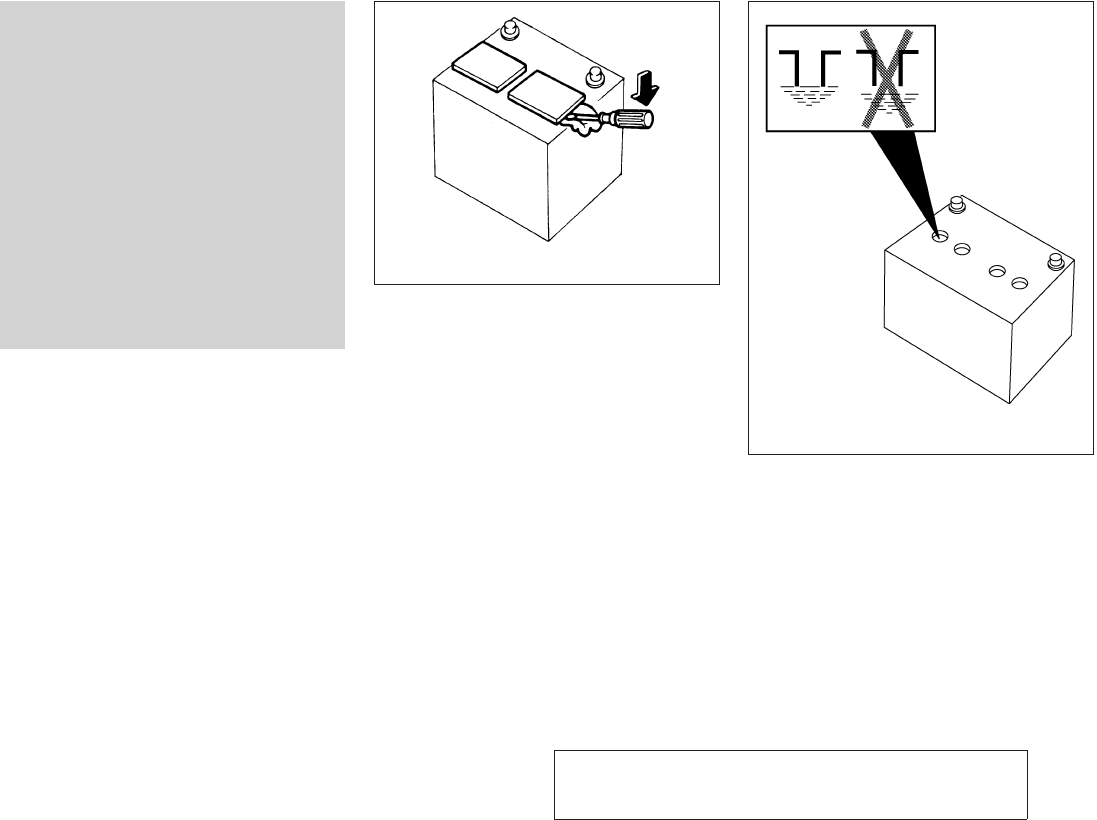
JOBNAME: 1093929-2013-asd-own PAGE: 341 SESS: 5 OUTPUT: Tue Mar 27 10:39:14 2012
●Do not operate the vehicle if the fluid in
the battery is low. Low battery fluid can
cause a higher load on the battery
which can generate heat, reduce bat-
tery life, and in some cases lead to an
explosion.
●When working on or near a battery, al-
ways wear suitable eye protection and
remove all jewelry.
●Battery posts, terminals and related ac-
cessories contain lead and lead com-
pounds. Wash hands after handling.
●Keep battery out of the reach of
children.
●Do not tip the battery. Keep the vent
caps tight and the battery level.
1. Remove the vent caps with a screwdriver as
shown. Use a cloth to protect the battery
case.
2. Check the fluid level in each cell. If it is
necessary to add fluid, add only distilled
water to bring the level up to the bottom of
the filler opening. Do not overfill. Reinstall
the vent caps.
WDI0224
LDI0302
Maintenance and do-it-yourself 8-17
ZREVIEW COPY—
2013 Altima Sedan (asd)
Owners Manual—USA_English (nna)
03/27/12—dmoore
X
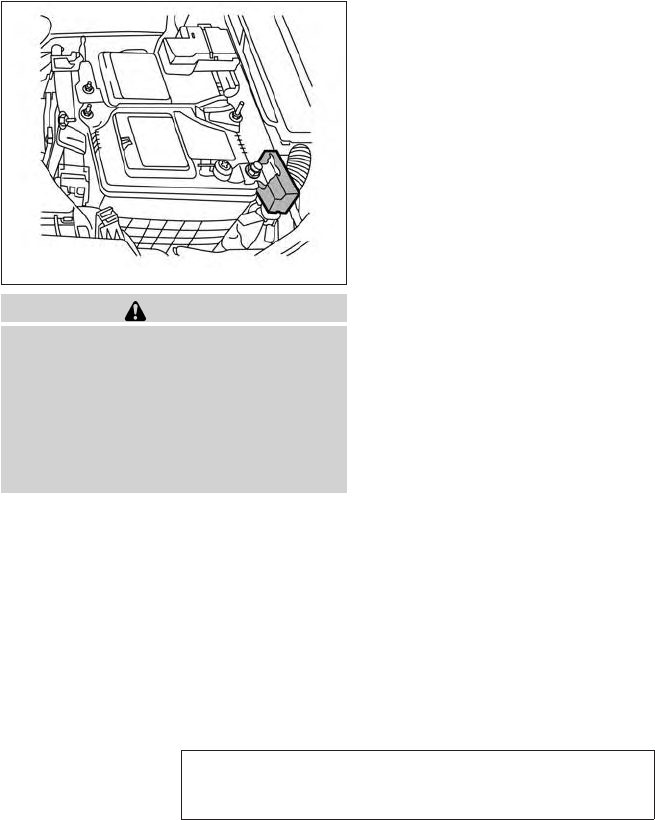
JOBNAME: 1093929-2013-asd-own PAGE: 342 SESS: 5 OUTPUT: Tue Mar 27 10:39:14 2012
Vehicles operated in high temperatures or under
severe conditions require frequent checks of the
battery fluid level.
JUMP STARTING
If jump starting is necessary, see “Jump starting”
in the “In case of emergency” section of this
manual. If the engine does not start by jump
starting, the battery may have to be replaced.
Contact a NISSAN dealer.
CAUTION
●Do not ground accessories directly to
the battery terminal. Doing so will by-
pass the variable voltage control sys-
tem and the vehicle battery may not
charge completely.
●Use electrical accessories with the en-
gine running to avoid discharging the
vehicle battery.
Your vehicle is equipped with a variable voltage
control system. This system measures the
amount of electrical discharge from the battery
and controls voltage generated by the generator.
The current sensor is located near the battery
along the negative battery cable. If you add elec-
trical accessories to your vehicle, be sure to
ground them to a suitable body ground such as
the frame or engine block area.
LDI2132
VARIABLE VOLTAGE CONTROL
SYSTEM
8-18 Maintenance and do-it-yourself
ZREVIEW COPY—
2013 Altima Sedan (asd)
Owners Manual—USA_English (nna)
03/27/12—dmoore
X
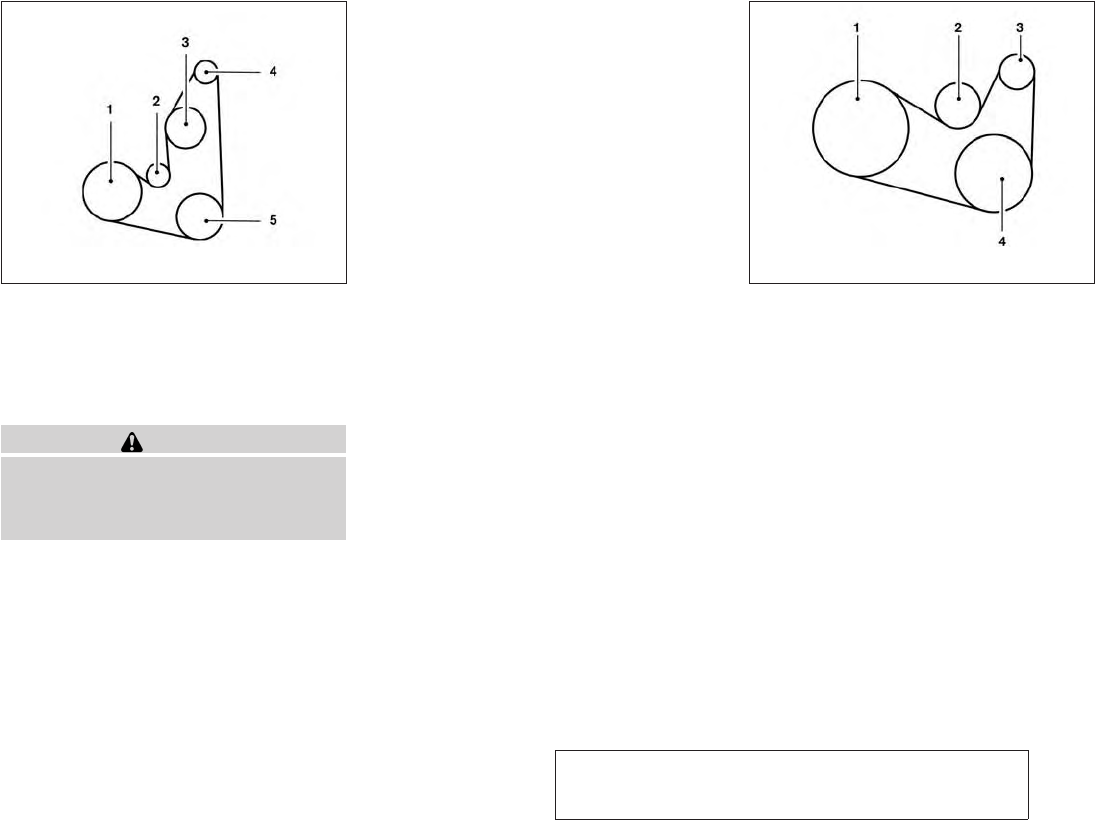
JOBNAME: 1093929-2013-asd-own PAGE: 343 SESS: 5 OUTPUT: Tue Mar 27 10:39:14 2012
1. Crankshaft pulley
2. Drive belt Automatic tensioner
3. Water pump pulley
4. Alternator
5. Air conditioner
WARNING
Be sure the ignition switch is placed in the
OFF or LOCK position before servicing
drive belt. The engine could rotate
unexpectedly.
1. Visually inspect the belt for signs of unusual
wear, cuts, fraying or looseness. If the belt is
in poor condition or is loose, have it replaced
or adjusted by a NISSAN dealer.
2. Have the belt checked regularly for condi-
tion and tension in accordance with the
maintenance schedule found in the
“NISSAN Service and Maintenance Guide”.
1. Crankshaft pulley
2. Drive belt automatic tensioner
3. Alternator
4. Air conditioner
QR25DE engine
LDI2130
VQ35DE engine
LDI2131
DRIVE BELT
Maintenance and do-it-yourself 8-19
ZREVIEW COPY—
2013 Altima Sedan (asd)
Owners Manual—USA_English (nna)
03/27/12—dmoore
X
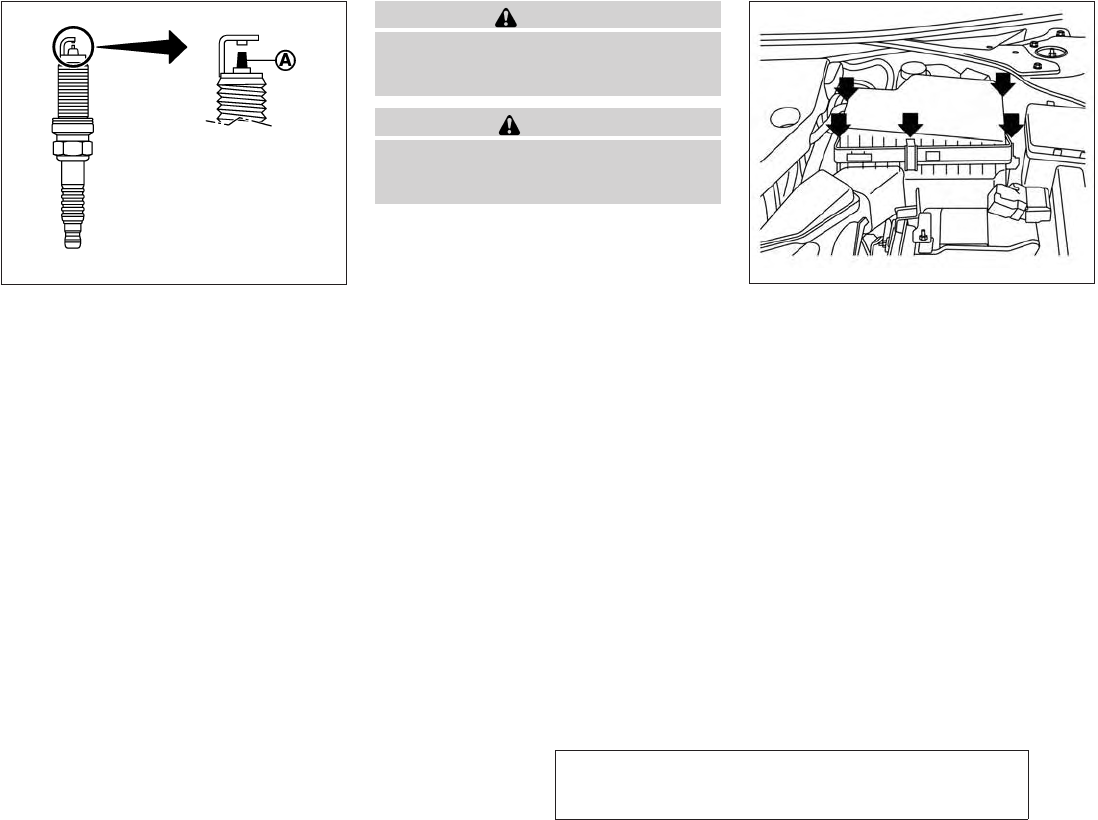
JOBNAME: 1093929-2013-asd-own PAGE: 344 SESS: 5 OUTPUT: Tue Mar 27 10:39:14 2012
REPLACING SPARK PLUGS
Iridium-tipped spark plugs
It is not necessary to replace iridium-tipped s
A
spark plugs as frequently as conventional type
spark plugs because they last much longer. Fol-
low the maintenance log shown in the “NISSAN
Service and Maintenance Guide”. Do not service
iridium-tipped spark plugs by cleaning or regap-
ping.
●QR25DE: Always replace spark plugs
with recommended ones.
●VQ35DE: Always replace spark plugs
with recommended or equivalent ones
WARNING
Be sure the engine and ignition switch are
off and that the parking brake is engaged
securely.
CAUTION
Be sure to use the correct socket to re-
move the spark plugs. An incorrect socket
can damage the spark plugs.
If replacement is required, see your NISSAN
dealer for assistance.
NOTE:
The air cleaner filter should not be cleaned
and reused.
Replace the air cleaner filter according to the
maintenance log shown in the “Warranty Informa-
tion and Maintenance Booklet.”
To remove the air cleaner filter:
●Unlatch the clips and move the air cleaner
cover upward.
●Remove the air cleaner filter.
SDI1895
QR25DE
LDI2117
SPARK PLUGS AIR CLEANER
8-20 Maintenance and do-it-yourself
ZREVIEW COPY—
2013 Altima Sedan (asd)
Owners Manual—USA_English (nna)
03/27/12—dmoore
X
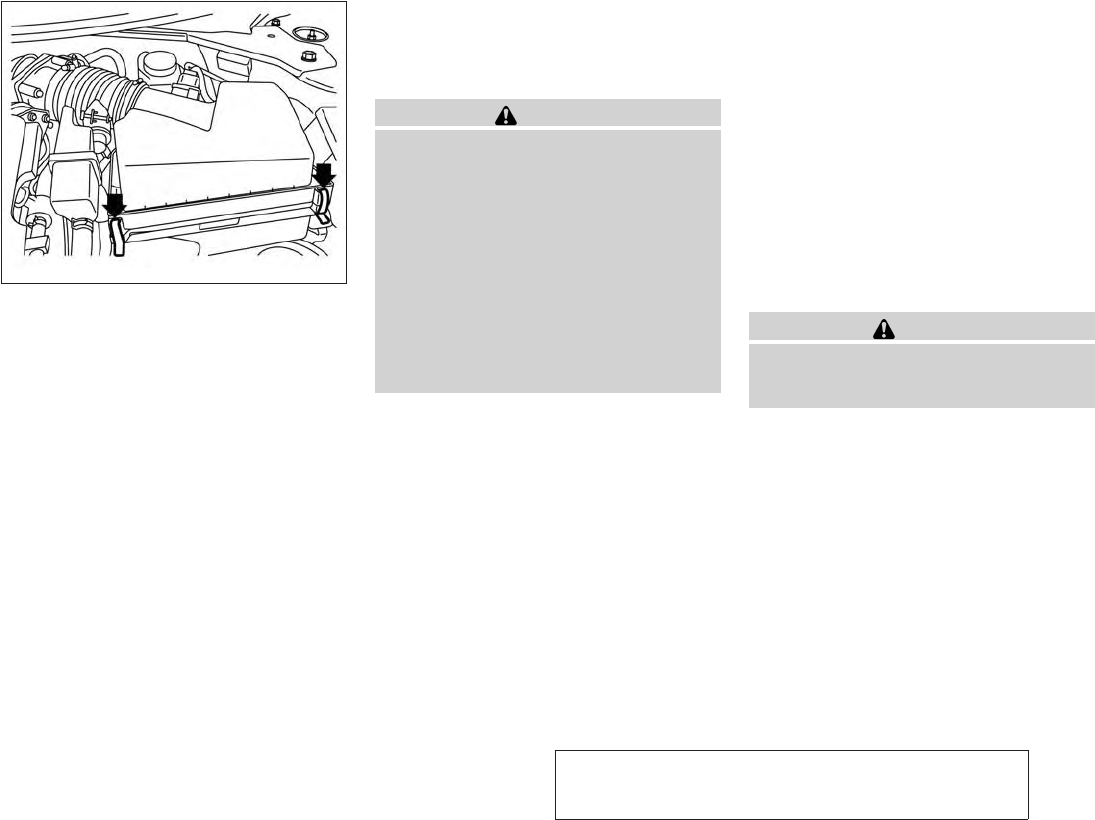
JOBNAME: 1093929-2013-asd-own PAGE: 345 SESS: 5 OUTPUT: Tue Mar 27 10:39:14 2012
●Wipe the inside of the air cleaner filter hous-
ing and the cover with a damp cloth.
NOTE:
After installing a new air cleaner, make
sure the air cleaner cover is seated in the
housing and latch the clips.
WARNING
●
Operating the engine with the air cleaner
removed can cause you or others to be
burned. The air cleaner not only cleans
the air, it stops the flame if the engine
backfires. If it isn’t there, and the engine
backfires, you could be burned. Do not
drive with the air cleaner removed, and
be careful when working on the engine
with the air cleaner removed.
●Never pour fuel into the throttle body or
attempt to start the engine with the air
cleaner removed. Doing so could result
in serious injury.
IN-CABIN MICROFILTER
The in-cabin microfilter restricts the entry of air-
borne dust and pollen particles and reduces
some objectionable outside odors. The filter is
located behind the glove box. Refer to the
“NISSAN Service and Maintenance Guide” for
change intervals.
If replacement is required, see your NISSAN
dealer.
CLEANING
If your windshield is not clear after using the
windshield washer or if a wiper blade chatters
when running, wax or other material may be on
the blade or windshield.
Clean the outside of the windshield with a washer
fluid or a mild detergent. Your windshield is clean
if beads do not form when rinsing with clear
water.
Clean each blade by wiping it with a cloth soaked
in a washer fluid or a mild detergent. Then rinse
the blades with clear water. If your windshield is
still not clear after cleaning the blades and using
the wiper, install new windshield wiper blades.
CAUTION
Worn windshield wiper blades can dam-
age the windshield and impair driver
vision.
VQ35DE
LDI2118
WINDSHIELD WIPER BLADES
Maintenance and do-it-yourself 8-21
ZREVIEW COPY—
2013 Altima Sedan (asd)
Owners Manual—USA_English (nna)
03/27/12—dmoore
X
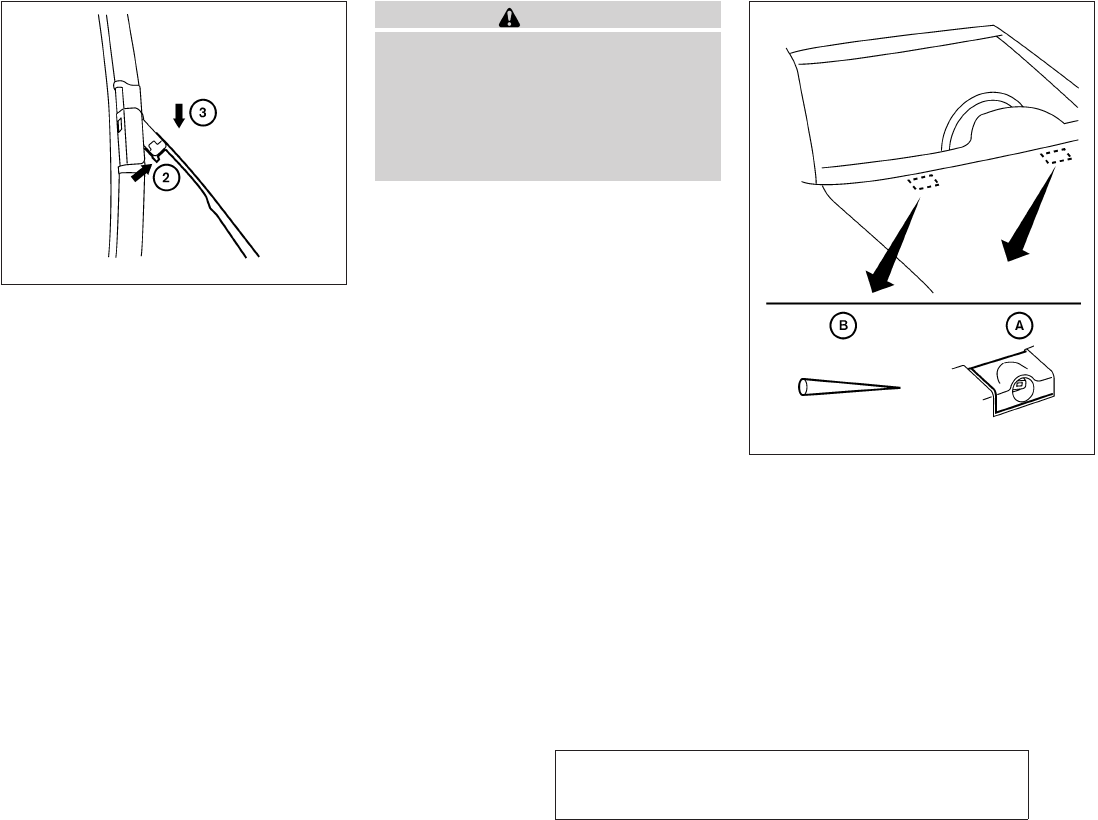
JOBNAME: 1093929-2013-asd-own PAGE: 346 SESS: 5 OUTPUT: Tue Mar 27 10:39:14 2012
REPLACING
Replace the wiper blades if they are worn.
1. Lift the wiper arm away from the windshield.
s
2Push the release tab, then move the wiper
blade down the wiper arm to remove.
s
3Remove the wiper blade.
4. Insert the new wiper blade onto the wiper
arm until it clicks into place.
5. Rotate the wiper blade so the dimple is in the
groove.
6. Return the wiper to its original position and
release it until it has made contact with the
windshield.
CAUTION
●After wiper blade replacement, return
the wiper arm to its original position;
otherwise it may be damaged when the
hood is opened.
●Make sure the wiper blades contact the
glass; otherwise the arms may be dam-
aged from wind pressure.
If you wax the surface of the hood, be careful not
to let wax get into the windshield washer nozzle
s
A. This may cause clogging or improper wind-
shield washer operation. If wax gets into the
nozzle, remove it with a needle or small pin s
B.
WDI0594
WDI0570
8-22 Maintenance and do-it-yourself
ZREVIEW COPY—
2013 Altima Sedan (asd)
Owners Manual—USA_English (nna)
03/27/12—dmoore
X
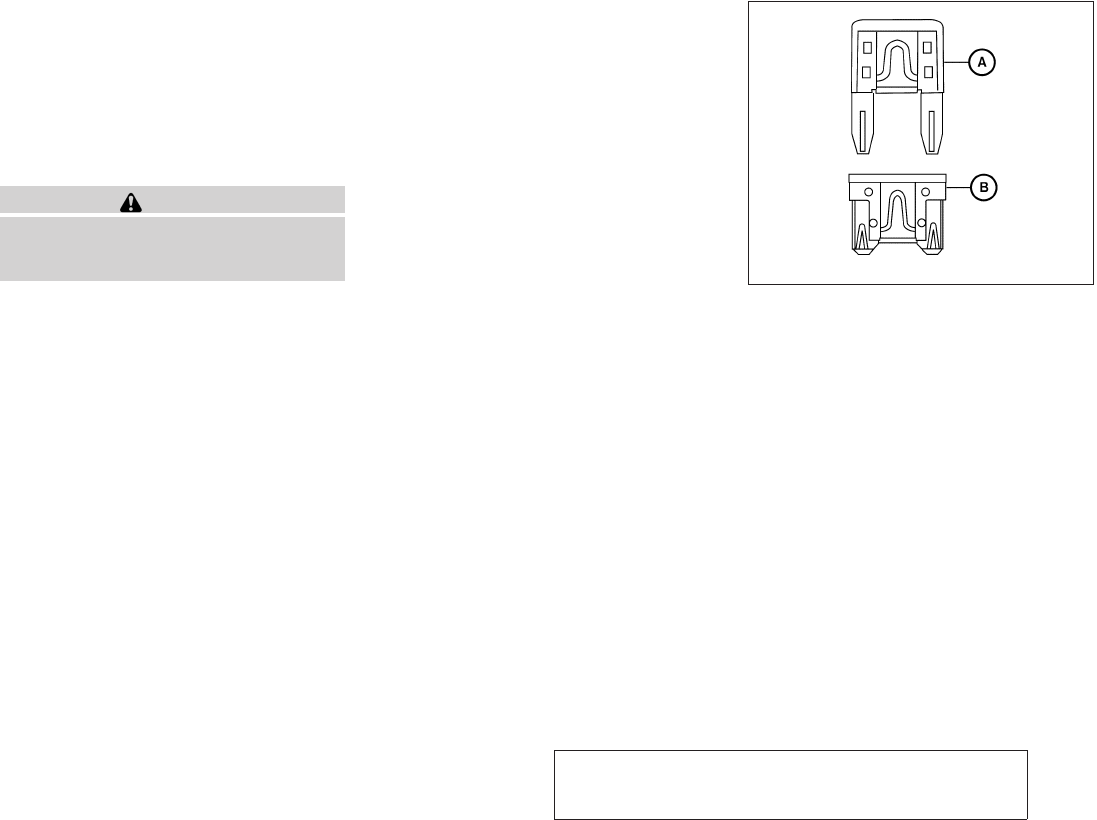
JOBNAME: 1093929-2013-asd-own PAGE: 347 SESS: 5 OUTPUT: Tue Mar 27 10:39:14 2012
If the brakes do not operate properly, have the
brakes checked by a NISSAN dealer.
SELF-ADJUSTING BRAKES
Your vehicle is equipped with self-adjusting
brakes.
The front and rear disc-type brakes self-adjust
every time the brake pedal is applied.
WARNING
See a NISSAN dealer for a brake system
check if the brake pedal height does not
return to normal.
BRAKE PAD WEAR INDICATORS
The disc brake pads on your vehicle have audible
wear indicators. When a brake pad requires re-
placement, a high pitched scraping or screech-
ing sound will be heard when the vehicle is in
motion. The noise will be heard whether or not the
brake pedal is depressed. Have the brakes
checked as soon as possible if the wear indicator
sound is heard.
Under some driving or climate conditions, occa-
sional brake squeak, squeal or other noise may
be heard. Occasional brake noise during light to
moderate stops is normal and does not affect the
function or performance of the brake system.
Proper brake inspection intervals should
be followed. For more information regarding
brake inspections, see the appropriate mainte-
nance schedule information in the “NISSAN Ser-
vice and Maintenance Guide”.
Two types of fuses are used. Type s
Ais used in
the fuse boxes in the engine compartment. Type
s
Bis used in the passenger compartment fuse
box.
Type A fuses are provided as spare fuses. They
are stored in the passenger compartment fuse
box.
Type A fuses can be installed in the engine com-
partment and passenger compartment fuse
boxes.
LDI0455
BRAKES FUSES
Maintenance and do-it-yourself 8-23
ZREVIEW COPY—
2013 Altima Sedan (asd)
Owners Manual—USA_English (nna)
03/27/12—dmoore
X
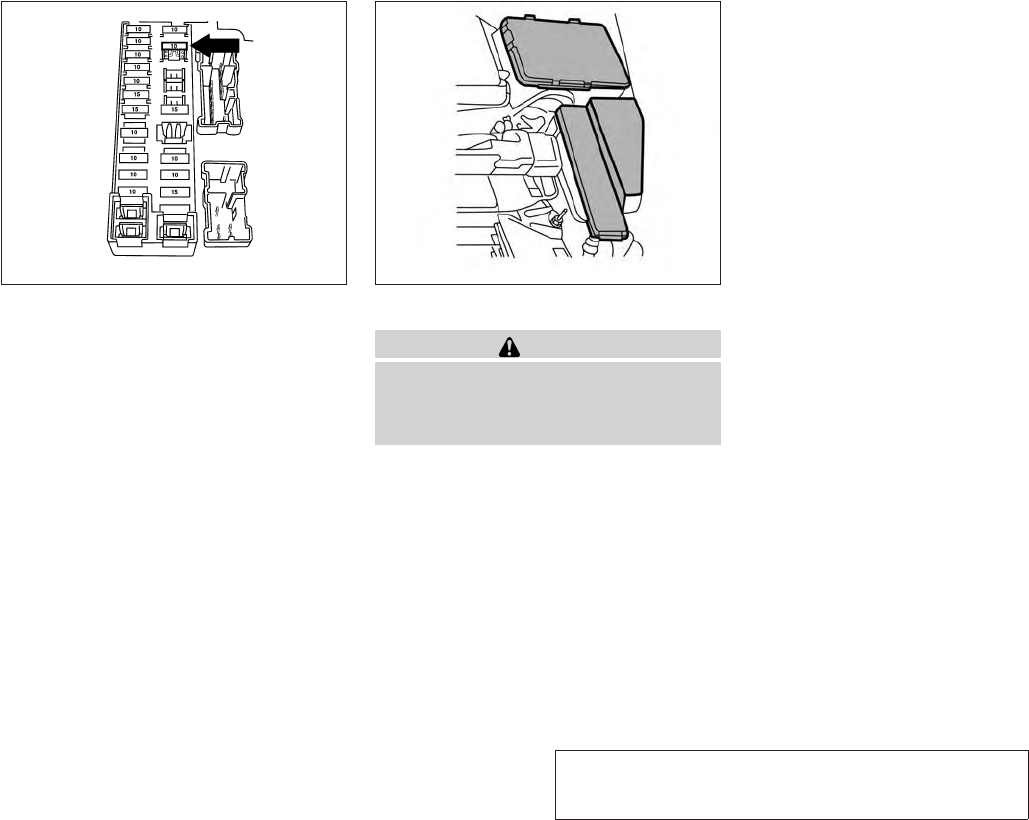
JOBNAME: 1093929-2013-asd-own PAGE: 348 SESS: 5 OUTPUT: Tue Mar 27 10:39:14 2012
If a type A fuse is used to replace a type B fuse,
the type A fuse will not be level with the fuse
pocket as shown in the illustration. This will not
affect the performance of the fuse. Make sure the
fuse is installed in the fuse box securely.
Type B fuses cannot be installed in the under-
hood fuse boxes. Only use type A fuses in the
underhood fuse boxes.
ENGINE COMPARTMENT
CAUTION
Never use a fuse of a higher or lower
amperage rating than specified on the
fuse box cover. This could damage the
electrical system or cause a fire.
If any electrical equipment does not come on,
check for an open fuse.
1. Be sure the ignition switch and the headlight
switch are OFF.
2. Open the engine hood.
3. Remove the fuse box cover by pushing the
tab and lifting the cover up.
4. Remove the fuse with the fuse puller. The
fuse puller is located in the center of the fuse
block in the passenger compartment.
LDI0457 LDI2133
8-24 Maintenance and do-it-yourself
ZREVIEW COPY—
2013 Altima Sedan (asd)
Owners Manual—USA_English (nna)
03/27/12—dmoore
X
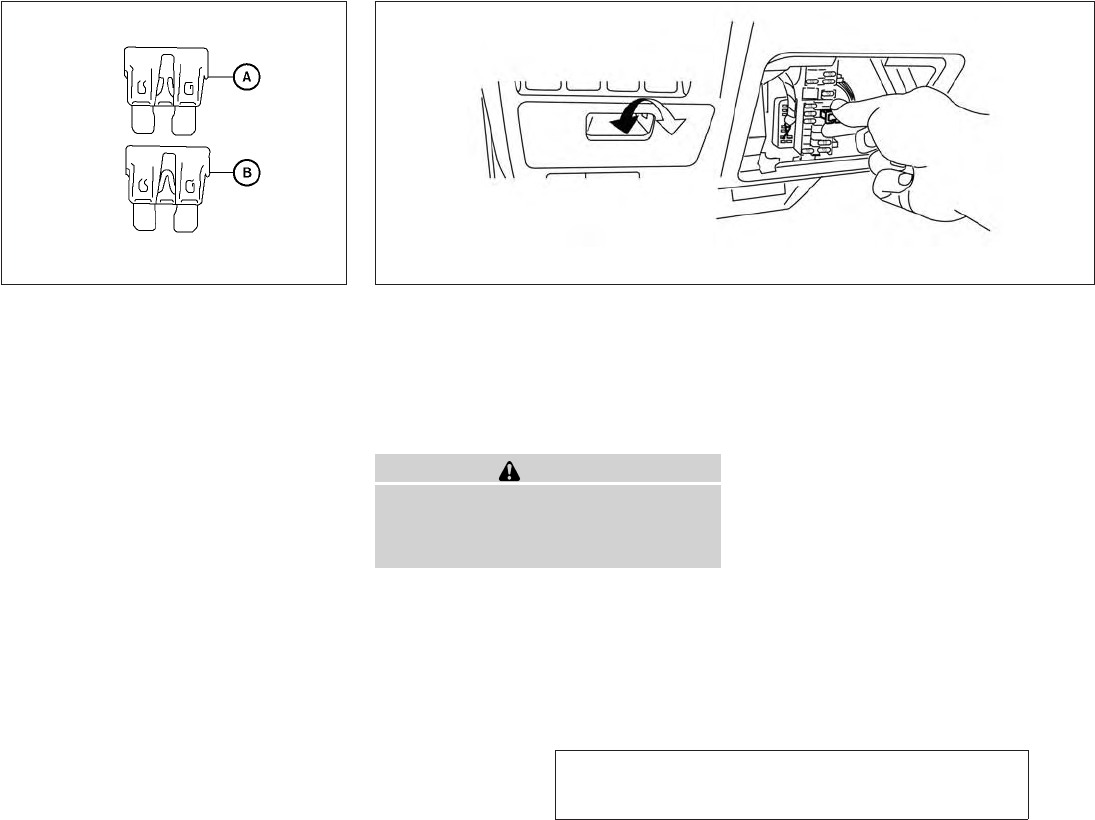
JOBNAME: 1093929-2013-asd-own PAGE: 349 SESS: 5 OUTPUT: Tue Mar 27 10:39:14 2012
5. If the fuse is open s
A, replace it with a new
fuse s
B.
6. If a new fuse also opens, have the electrical
system checked and repaired by a NISSAN
dealer.
Fusible links
If the electrical equipment does not operate and
fuses are in good condition, check the fusible
links. If any of these fusible links are melted,
replace with only Genuine NISSAN parts.
PASSENGER COMPARTMENT
CAUTION
Never use a fuse of a higher or lower
amperage rating than specified on the
fuse box cover. This could damage the
electrical system or cause a fire.
If any electrical equipment does not operate,
check for an open fuse.
1. Be sure the ignition switch and the headlight
switch are OFF.
2. Pull the fuse box cover to remove.
3. Remove the fuse with the fuse puller.
WDI0452 LDI2134
Maintenance and do-it-yourself 8-25
ZREVIEW COPY—
2013 Altima Sedan (asd)
Owners Manual—USA_English (nna)
03/27/12—dmoore
X
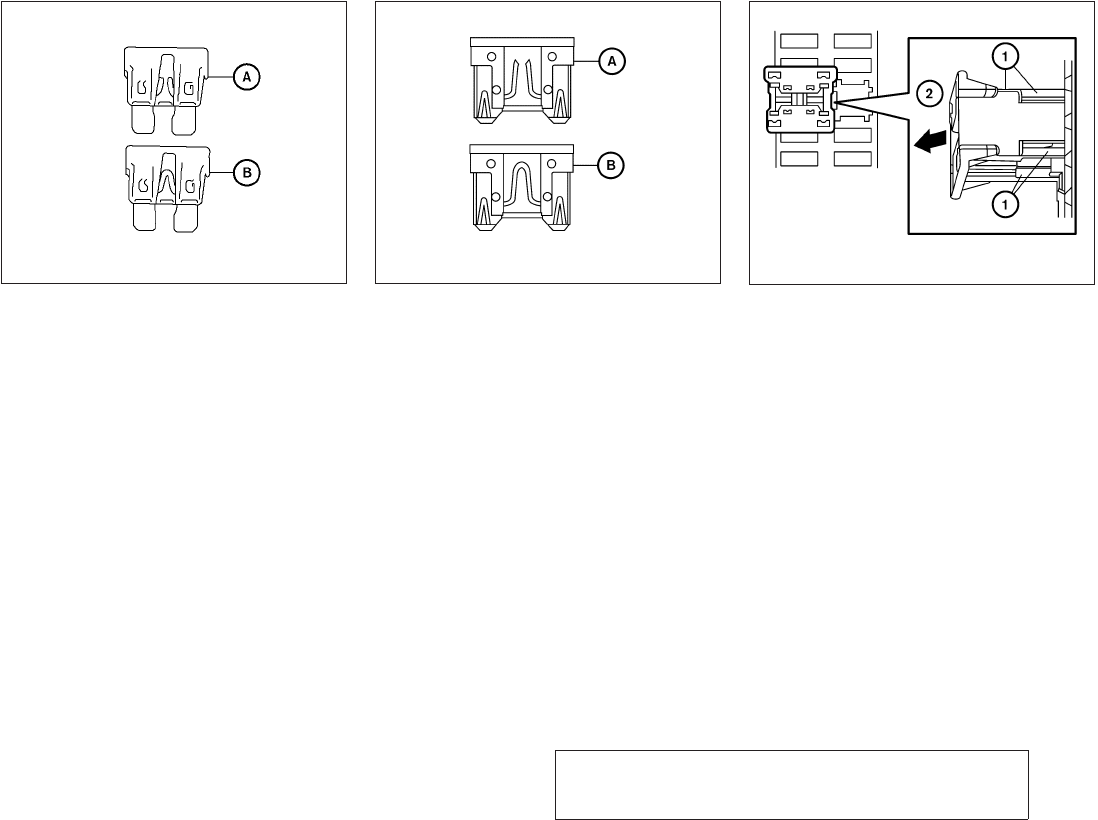
JOBNAME: 1093929-2013-asd-own PAGE: 350 SESS: 5 OUTPUT: Tue Mar 27 10:39:14 2012
4. If the fuse is open s
A, replace it with an
equivalent good fuse s
B.
5. Push the fuse box cover to install.
6. If a new fuse also opens, have the electrical
system checked and repaired by a NISSAN
dealer.
Extended storage switch
If any electrical equipment does not operate,
remove the extended storage switch and check
for an open fuse.
NOTE:
The extended storage switch is used for
long term vehicle storage. Even if the ex-
tended storage switch is broken it is not
necessary to replace it. Replace only the
open fuse in the switch with a new fuse.
Type A
WDI0452
Type B
LDI0456 LDI2035
8-26 Maintenance and do-it-yourself
ZREVIEW COPY—
2013 Altima Sedan (asd)
Owners Manual—USA_English (nna)
03/27/12—dmoore
X
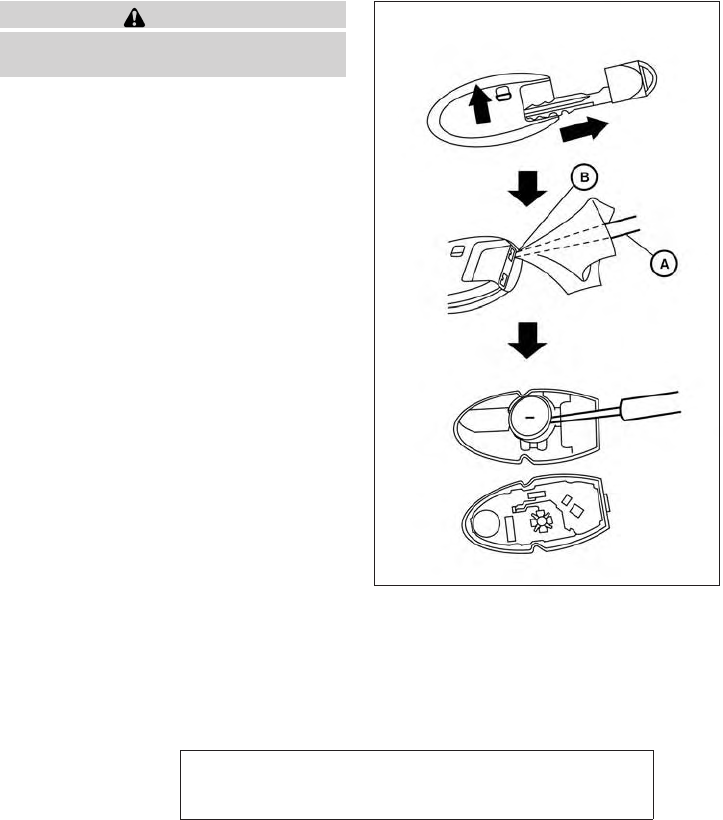
JOBNAME: 1093929-2013-asd-own PAGE: 351 SESS: 5 OUTPUT: Tue Mar 27 10:39:14 2012
How to replace the extended storage switch:
1. To remove the extended storage switch, be
sure the ignition switch is in the OFF or
LOCK position.
2. Be sure the headlight switch is in the OFF
position.
3. Remove the fuse box cover.
4. Pinch the locking tabs s
1found on each
side of the storage switch.
5. Pull the storage switch straight out from the
fuse box s
2.
CAUTION
Be careful not to allow children to swallow
the battery or removed parts.
NISSAN INTELLIGENT KEYT
Replace the battery in the Intelligent Key as fol-
lows:
1. Remove the mechanical key from the Intelli-
gent Key.
2. Insert a small screwdriver s
Ainto the slit s
B
of the corner and twist it to separate the
upper part from the lower part. Use a cloth to
protect the casing.
3. Replace the battery with a new one.
Recommended battery: CR2032 or equiva-
lent.
●Do not touch the internal circuit and elec-
tric terminals as doing so could cause a
malfunction.
●Hold the battery by the edges. Holding
the battery across the contact points will
seriously deplete the storage capacity.
●Make sure that the + side faces the bot-
tom of the case.
LDI2001
BATTERY REPLACEMENT
Maintenance and do-it-yourself 8-27
ZREVIEW COPY—
2013 Altima Sedan (asd)
Owners Manual—USA_English (nna)
03/27/12—dmoore
X
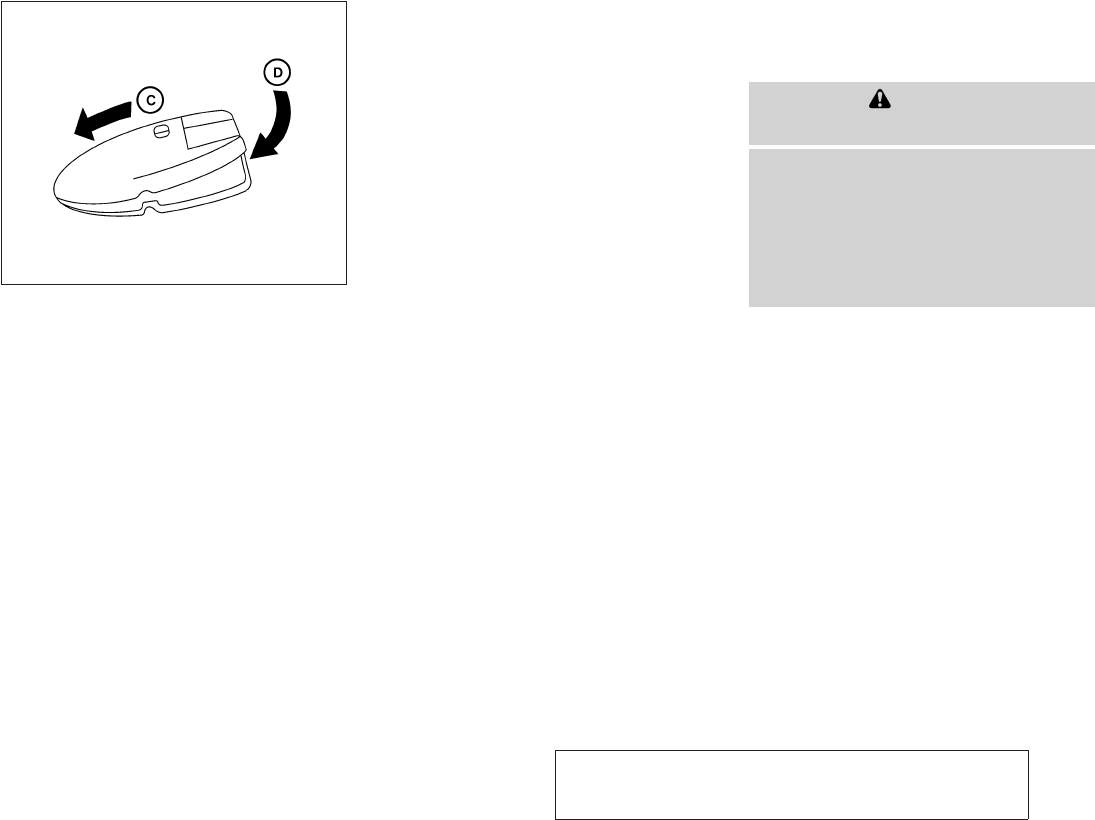
JOBNAME: 1093929-2013-asd-own PAGE: 352 SESS: 5 OUTPUT: Tue Mar 27 10:39:14 2012
4. Close the lid securely as illustrated s
Cs
D.
5. Operate the buttons to check the operation.
See a NISSAN dealer if you need assistance for
replacement.
FCC Notice:
For USA:
This device complies with Part 15 of the
FCC Rules. Operation is subject to the fol-
lowing two conditions: (1) This device may
not cause harmful interference, and (2) this
device must accept any interference re-
ceived, including interference that may
cause undesired operation. Note: Changes
or modifications not expressly approved by
the party responsible for compliance could
void the user’s authority to operate the
equipment.
For Canada:
This device complies with RSS-210 of In-
dustry Canada. Operation is subject to the
following two conditions: (1) this device
may not cause interference, and (2) this
device must accept any interference, in-
cluding interference that may cause unde-
sired operation of the device.
HEADLIGHTS
Replacing the xenon headlight bulb (if
so equipped)
WARNING
cHIGH VOLTAGE
When xenon headlights are on, they pro-
duce a high voltage. To prevent an electric
shock, never attempt to modify or disas-
semble. Always have your xenon head-
lights replaced at a NISSAN dealer. For
additional information, see “Headlight
and turn signal switch” in the “Instru-
ments and controls” section.
Replacing the halogen headlight bulb
(if so equipped)
If bulb replacement is required, see your NISSAN
dealer.
WDI0568
LIGHTS
8-28 Maintenance and do-it-yourself
ZREVIEW COPY—
2013 Altima Sedan (asd)
Owners Manual—USA_English (nna)
03/27/12—dmoore
X

JOBNAME: 1093929-2013-asd-own PAGE: 353 SESS: 5 OUTPUT: Tue Mar 27 10:39:14 2012
CAUTION
●Aiming is not necessary after replacing
the bulb. When aiming adjustment is
necessary, contact a NISSAN dealer.
●Do not leave the headlight assembly
open without a bulb installed for a long
period of time. Dust, moisture, smoke,
etc. entering the headlight body may
affect bulb performance. Remove the
bulb from the headlight assembly just
before a replacement bulb is installed.
●Only touch the base when handling the
bulb. Never touch the glass envelope.
Touching the glass could significantly
affect bulb life and/or headlight
performance.
●High pressure halogen gas is sealed
inside the halogen bulb. The bulb may
break if the glass envelope is scratched
or the bulb is dropped.
●Use the same number and wattage as
shown in the chart.
Fog may temporarily form inside the lens of the
exterior lights in the rain or in a car wash. A
temperature difference between the inside and
the outside of the lens causes the fog. This is not
a malfunction. If large drops of water collect
inside the lens, contact a NISSAN dealer.
FRONT PARK LIGHT
If replacement is required, see your NISSAN
dealer.
FOG LIGHTS (if so equipped)
Replacing the fog light bulb
Maintenance and do-it-yourself 8-29
ZREVIEW COPY—
2013 Altima Sedan (asd)
Owners Manual—USA_English (nna)
03/27/12—dmoore
X
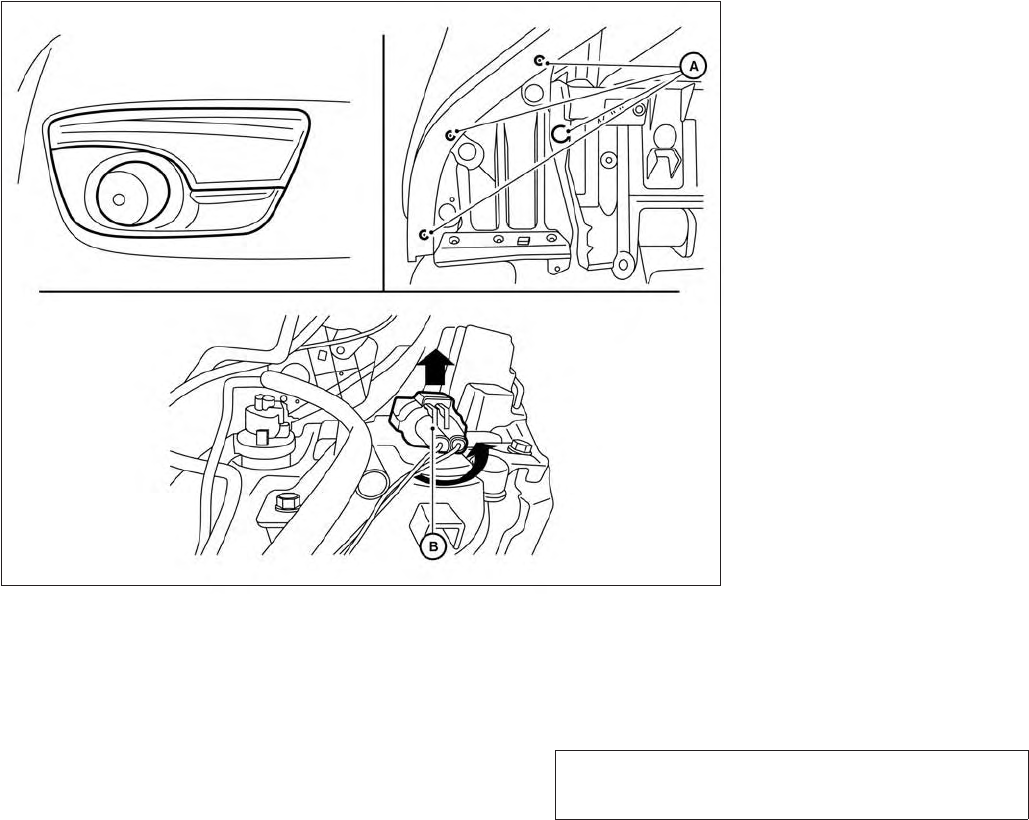
JOBNAME: 1093929-2013-asd-own PAGE: 354 SESS: 5 OUTPUT: Tue Mar 27 10:39:14 2012
1. Disconnect the negative battery cable.
2. Remove the fastenerss
A; carefully pull back
the front fender protector .
3. Rotate the bulb s
Bcounterclockwise and
pull out to remove.
TURN SIGNAL LIGHTS
Replacing the turn signal bulb
LDI2144
8-30 Maintenance and do-it-yourself
ZREVIEW COPY—
2013 Altima Sedan (asd)
Owners Manual—USA_English (nna)
03/27/12—dmoore
X
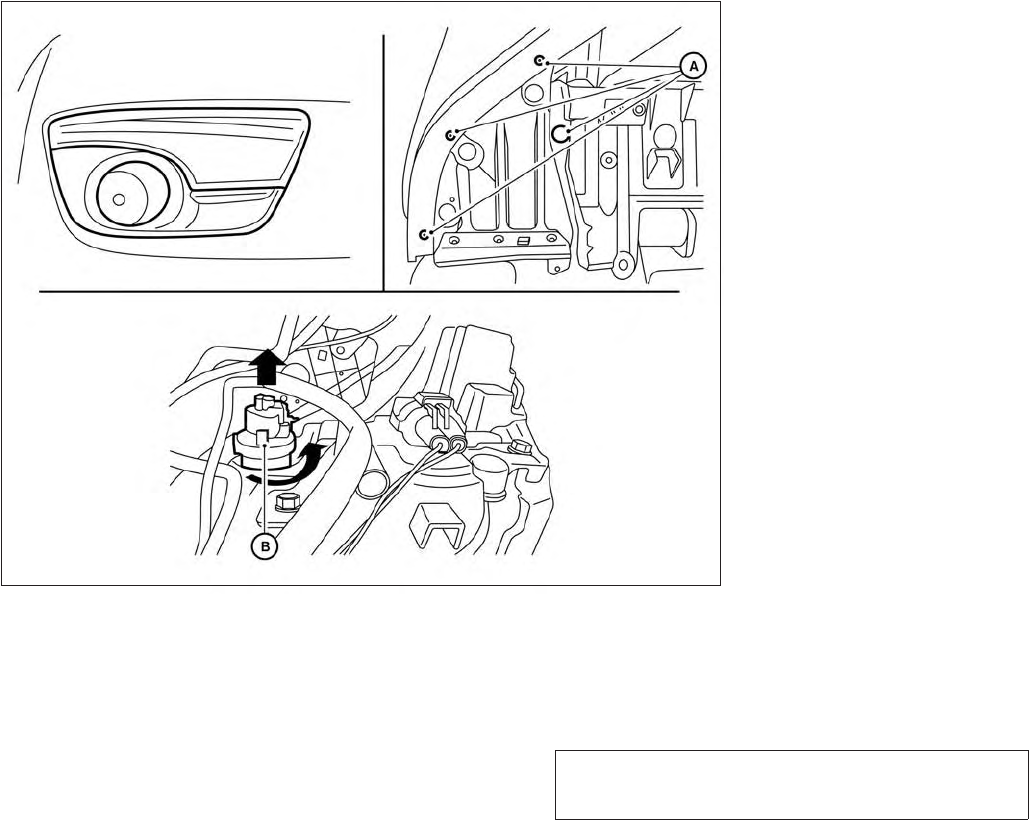
JOBNAME: 1093929-2013-asd-own PAGE: 355 SESS: 5 OUTPUT: Tue Mar 27 10:39:14 2012
1. Disconnect the negative battery cable.
2. Remove the fastenerss
A; carefully pull back
the front fender protector.
3. Rotate the bulbs
Bcounterclockwise and
pull out to remove.
LDI2137
Maintenance and do-it-yourself 8-31
ZREVIEW COPY—
2013 Altima Sedan (asd)
Owners Manual—USA_English (nna)
03/27/12—dmoore
X

JOBNAME: 1093929-2013-asd-own PAGE: 356 SESS: 5 OUTPUT: Tue Mar 27 10:39:14 2012
EXTERIOR AND INTERIOR LIGHTS
Item Wattage (W) Bulb No.*
1
Headlight assembly *
2
Low (Halogen) 55 H11
Low (Xenon) 35 D25
High 65 H9
Park 5 W5W
Door mirror turn signal light *
2
— LED
Turn signal light 8 7444A
Front fog light (if so equipped) 55 H11
Day time running lights (Canada only) 19 PS19W
Step light 3.8 194 C HTEI
Rear combination light *
2
Tail/Stop — (LED)/ 27/8 LED/ 3156AK
Turn 27 3156AK
Backup (reversing) 18 921
License plate light *
2
5 W5W
High-mounted stop light *
2
Inside — LED
Spoiler (if so equipped) — LED
Front map light *
2
— LED
Rear personal light 8 U88
Trunk light 3.4 158
Vanity mirror light — HTU–14v
Glove box light *
2
— —
Console light *
2
— —
*
1
Always check with the Parts Department at a NISSAN dealer for the latest parts information.
*
2
See a NISSAN dealer for assistance.
8-32 Maintenance and do-it-yourself
ZREVIEW COPY—
2013 Altima Sedan (asd)
Owners Manual—USA_English (nna)
03/27/12—dmoore
X
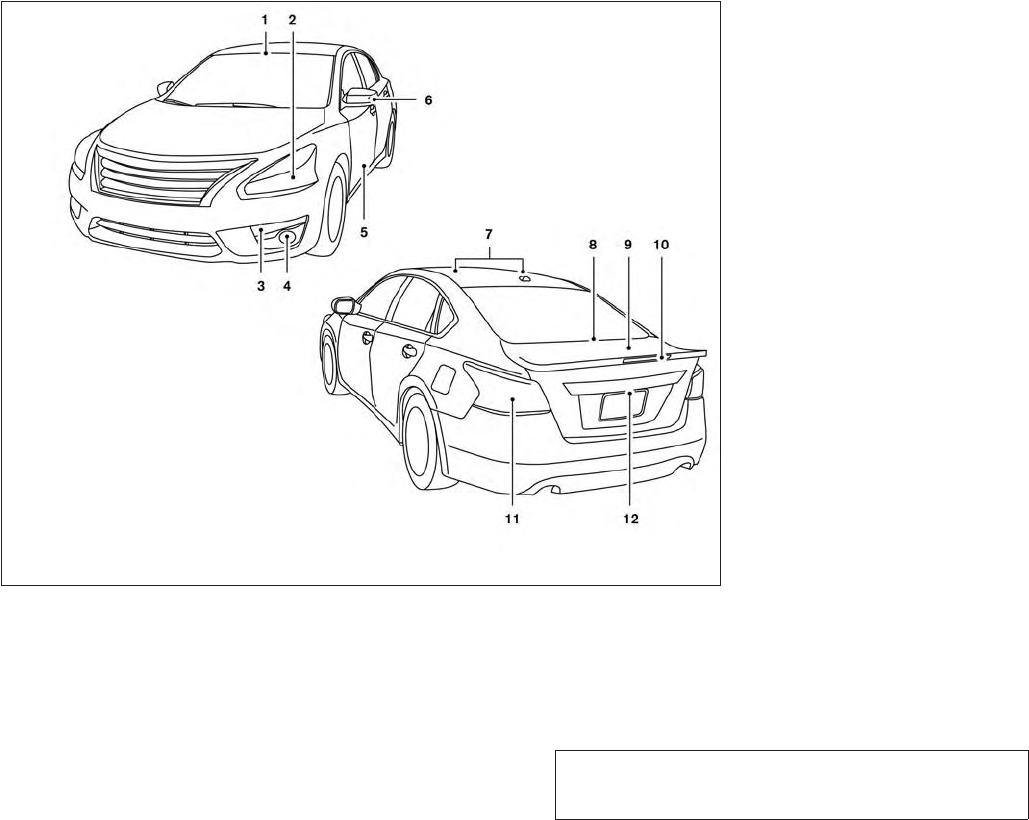
JOBNAME: 1093929-2013-asd-own PAGE: 357 SESS: 5 OUTPUT: Tue Mar 27 10:39:14 2012
1. Front map light
2. Headlamp assembly
3. Turn signal light
4. Fog light (if so equipped)/ Day time
running light (if so equipped)
5. Step light
6. Door mirror turn signal light
7. Personal light
8. High-mount stoplight (if so equipped)
9. Trunk light
10. Spoiler-mount stop light
11. Rear combination light
12. License plate light
LDI2100
Maintenance and do-it-yourself 8-33
ZREVIEW COPY—
2013 Altima Sedan (asd)
Owners Manual—USA_English (nna)
03/27/12—dmoore
X
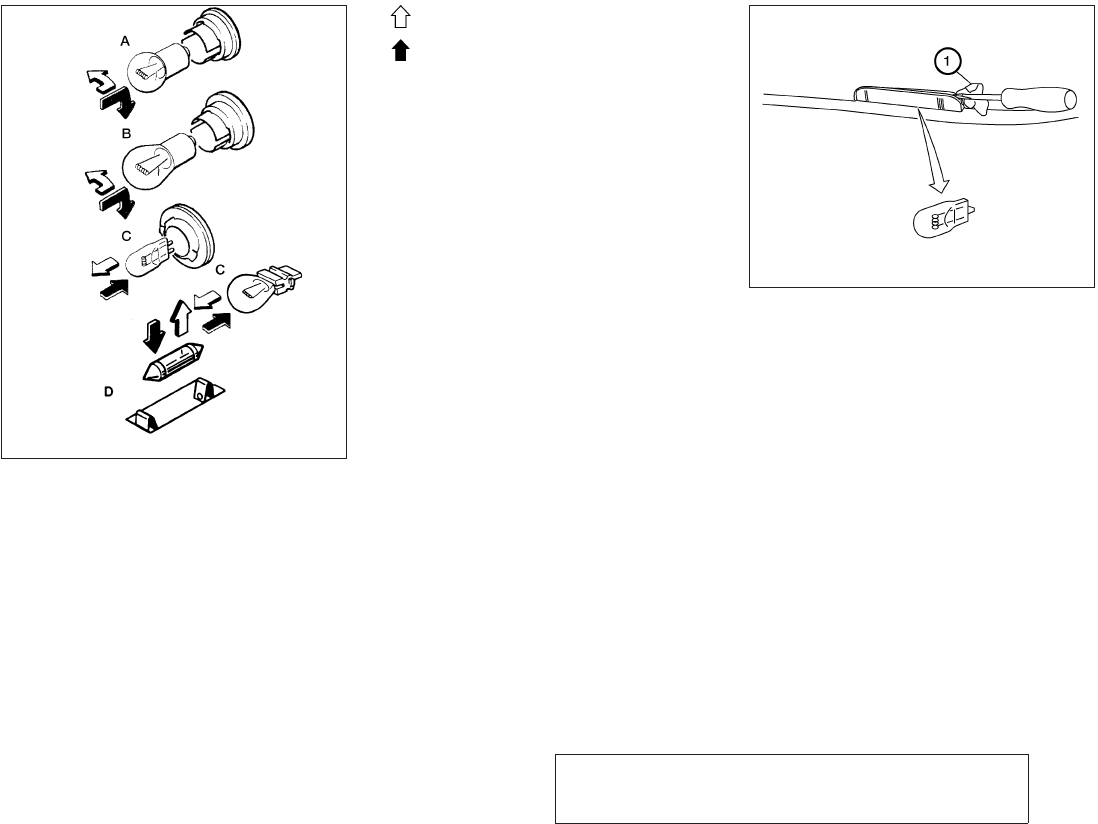
JOBNAME: 1093929-2013-asd-own PAGE: 358 SESS: 5 OUTPUT: Tue Mar 27 10:39:14 2012
Replacement procedures
All other lights are either type A, B, C or D. When
replacing a bulb, first remove the lens, light
and/or cover.
Indicates bulb removal
Indicates bulb installation
Use a cloth s
1to protect the housing.
WDI0306
Step light
LDI0341
8-34 Maintenance and do-it-yourself
ZREVIEW COPY—
2013 Altima Sedan (asd)
Owners Manual—USA_English (nna)
03/27/12—dmoore
X
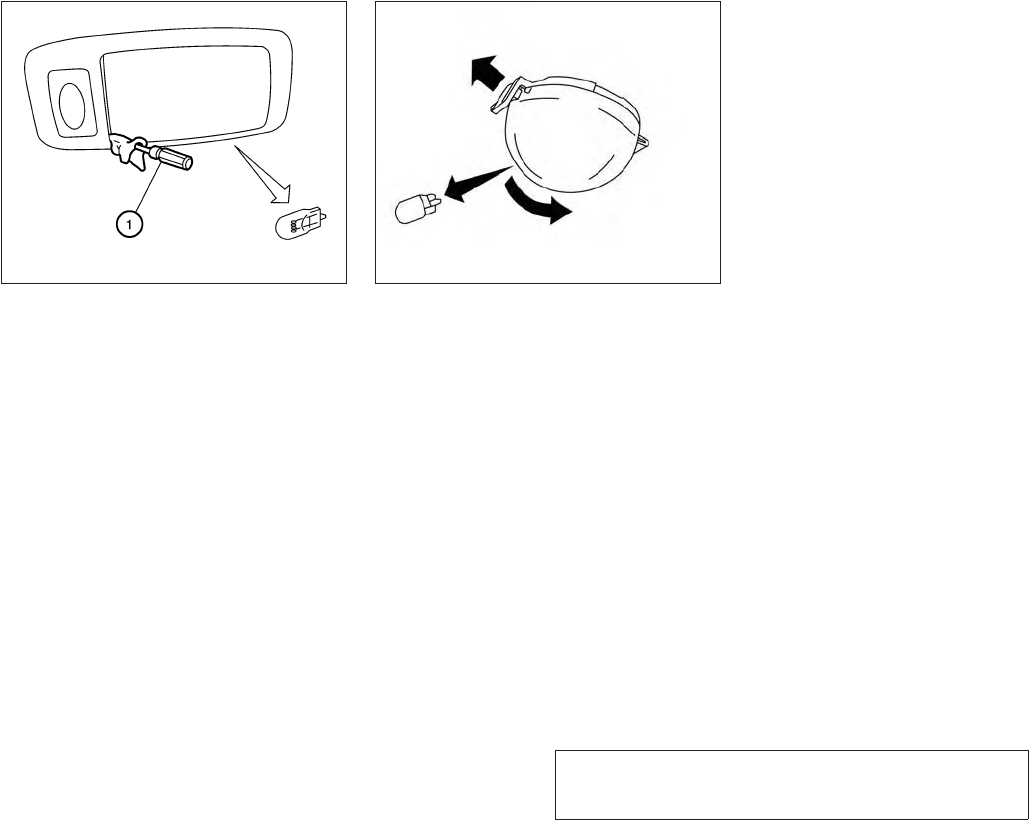
JOBNAME: 1093929-2013-asd-own PAGE: 359 SESS: 5 OUTPUT: Tue Mar 27 10:39:14 2012
Use a cloth s
1to protect the housing.
Rear combination light
Bulb replacement requires the removal of the rear
combination light assembly. If replacement is re-
quired, see your NISSAN dealer.
If you have a flat tire, see “Flat tire” in the
“In case of emergency” section of this
manual.
TIRE PRESSURE
Tire Pressure Monitoring System
(TPMS)
This vehicle is equipped with the Tire
Pressure Monitoring System (TPMS). It
monitors tire pressure of all tires except
the spare. When the low tire pressure
warning light is lit and the “Tire Pressure
Low - Add Air” warning appears in the
vehicle information display, one or more of
your tires is significantly under-inflated.
The TPMS will activate only when the
vehicle is driven at speeds above 16 MPH
(25 km/h). Also, this system may not de-
tect a sudden drop in tire pressure (for
example a flat tire while driving).
For more details, refer to “Low tire pres-
sure warning light”in the “Instruments and
controls” section, “Tire Pressure Monitor-
ing System (TPMS)” in the “Starting and
driving” section, and “Flat tire” in the “In
case of emergency” section.
Personal light
WDI0670
Trunk light
LDI2135
WHEELS AND TIRES
Maintenance and do-it-yourself 8-35
ZREVIEW COPY—
2013 Altima Sedan (asd)
Owners Manual—USA_English (nna)
03/27/12—dmoore
X

JOBNAME: 1093929-2013-asd-own PAGE: 360 SESS: 5 OUTPUT: Tue Mar 27 10:39:14 2012
Tire inflation pressure
Check the tire pressures (including the
spare) often and always prior to long dis-
tance trips. The recommended tire pres-
sure specifications are shown on the
F.M.V.S.S./C.M.V.S.S. certification label
or the Tire and Loading Information label
under the “Cold Tire Pressure” heading.
The Tire and Loading Information label is
affixed to the driver side center pillar. Tire
pressures should be checked regularly
because:
●Most tires naturally lose air over time.
●Tires can lose air suddenly when
driven over potholes or other objects
or if the vehicle strikes a curb while
parking.
The tire pressures should be checked
when the tires are cold. The tires are
considered COLD after the vehicle has
been parked for 3 or more hours, or driven
less than 1 mile (1.6 km) at moderate
speeds.
The “TPMS with Easy Fill Tire Alert” pro-
vides visual and audible signals outside
the vehicle for inflating tires to the recom-
mended COLD tire pressure. For more
information, see “TPMS with Easy Fill Tire
Alert”in the “Starting and driving” section.
Incorrect tire pressure, including un-
der inflation, may adversely affect
tire life and vehicle handling.
WARNING
●Improperly inflated tires can fail
suddenly and cause an accident.
●The Gross Vehicle Weight Rating
(GVWR) is located on the
F.M.V.S.S./C.M.V.S.S. certifica-
tion label. The vehicle weight ca-
pacity is indicated on the Tire and
Loading Information label. Do
not load your vehicle beyond this
capacity. Overloading your ve-
hicle may result in reduced tire
life, unsafe operating conditions
due to premature tire failure, or
unfavorable handling character-
istics and could also lead to a
serious accident. Loading be-
yond the specified capacity may
also result in failure of other ve-
hicle components.
●Before taking a long trip, or
whenever you heavily load your
vehicle, use a tire pressure gauge
to ensure that the tire pressures
are at the specified level.
●For additional information re-
garding tires, refer to “Important
Tire Safety Information” (US) or
“Tire Safety Information”
(Canada) in the Warranty Infor-
mation Booklet.
8-36 Maintenance and do-it-yourself
ZREVIEW COPY—
2013 Altima Sedan (asd)
Owners Manual—USA_English (nna)
03/27/12—dmoore
X
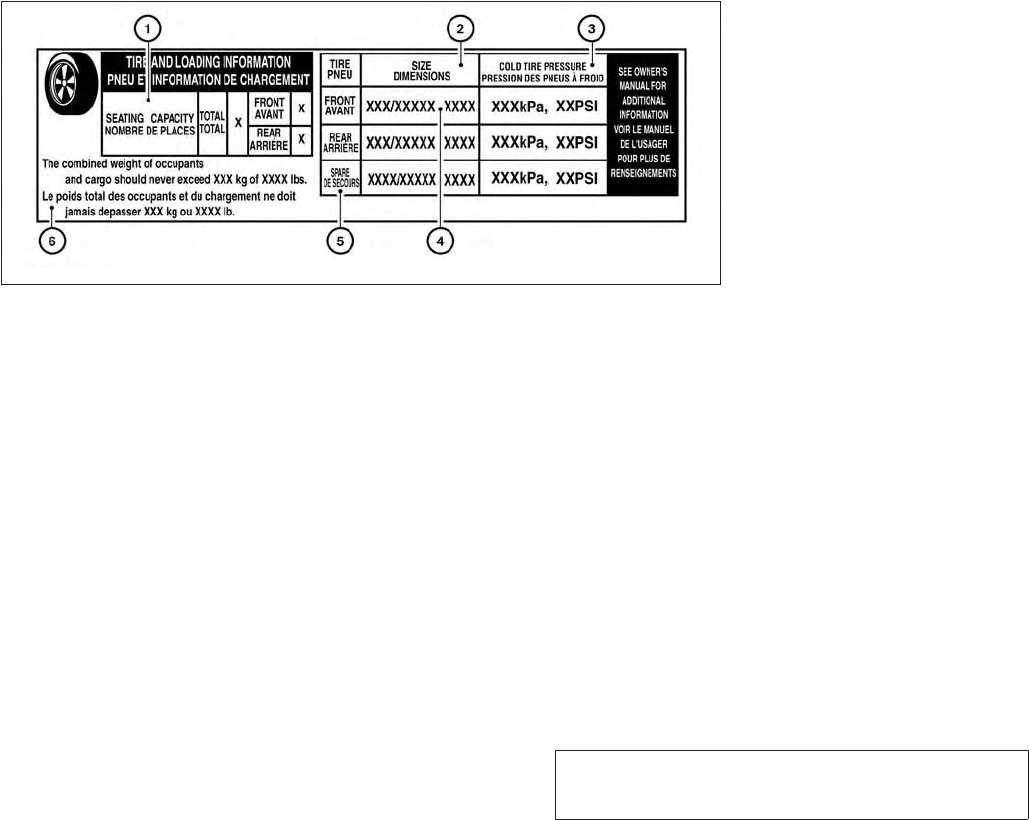
JOBNAME: 1093929-2013-asd-own PAGE: 361 SESS: 5 OUTPUT: Tue Mar 27 10:39:14 2012
Tire and loading information label
s
1Seating capacity: The maximum num-
ber of occupants that can be seated
in the vehicle.
s
2Original tire size: The size of the tires
originally installed on the vehicle at
the factory.
s
3Cold tire pressure: Inflate the tires to
this pressure when the tires are cold.
Tires are considered COLD after the
vehicle has been parked for 3 or more
hours, or driven less than 1 mile (1.6
km) at moderate speeds. The recom-
mended cold tire inflation is set by the
manufacturer to provide the best bal-
ance of tire wear, vehicle handling,
driveability, tire noise, etc., up to the
vehicle’s GVWR.
s
4Tire size – refer to “Tire labeling” later
in this section.
s
5Spare tire size.
s
6Vehicle load limit: See “Vehicle load-
ing information” in the “Technical and
consumer information” section.
LDI2083
Maintenance and do-it-yourself 8-37
ZREVIEW COPY—
2013 Altima Sedan (asd)
Owners Manual—USA_English (nna)
03/27/12—dmoore
X
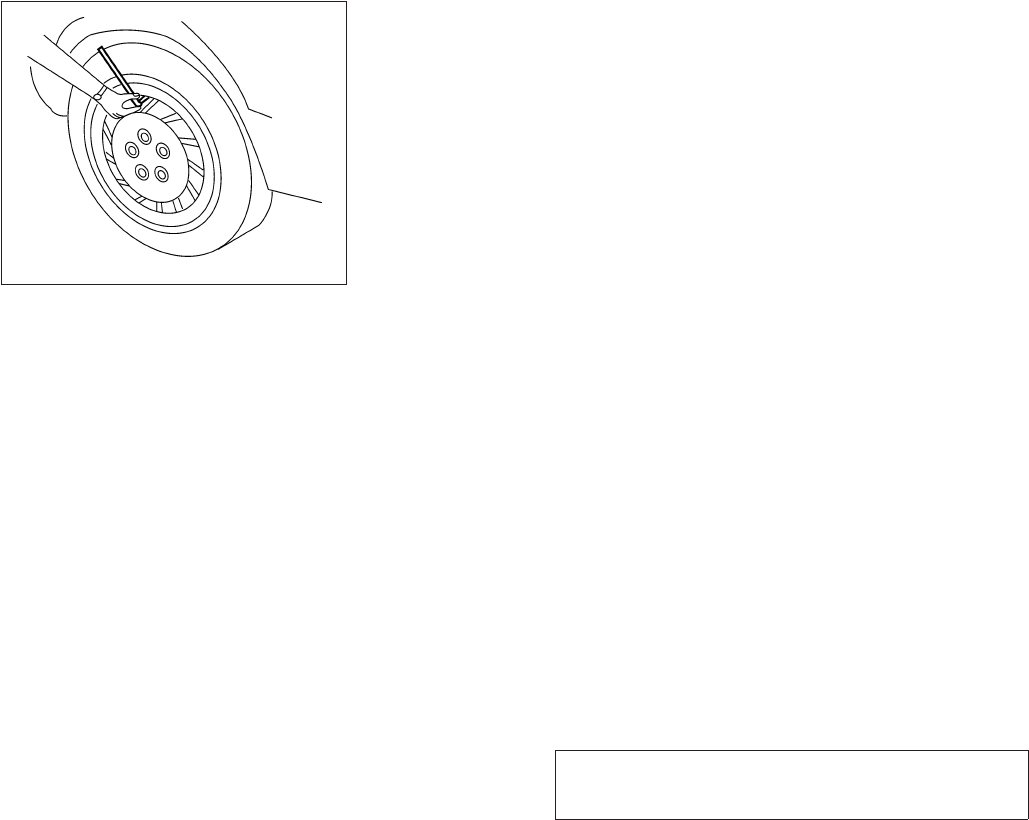
JOBNAME: 1093929-2013-asd-own PAGE: 362 SESS: 5 OUTPUT: Tue Mar 27 10:39:14 2012
Checking tire pressure
1. Remove the valve stem cap from the
tire.
2. Press the pressure gauge squarely
onto the valve stem. Do not press too
hard or force the valve stem side-
ways, or air will escape. If the hissing
sound of air escaping from the tire is
heard while checking the pressure,
reposition the gauge to eliminate this
leakage.
3. Remove the gauge.
4. Read the tire pressure on the gauge
stem and compare to the specifica-
tion shown on the Tire and Loading
Information label.
5. Add air to the tire as needed. If too
much air is added, press the core of
the valve stem briefly with the tip of
the gauge stem to release pressure.
Recheck the pressure and add or
release air as needed.
6. Install the valve stem cap.
7. Check the pressure of all other tires,
including the spare.
LDI0393
8-38 Maintenance and do-it-yourself
ZREVIEW COPY—
2013 Altima Sedan (asd)
Owners Manual—USA_English (nna)
03/27/12—dmoore
X
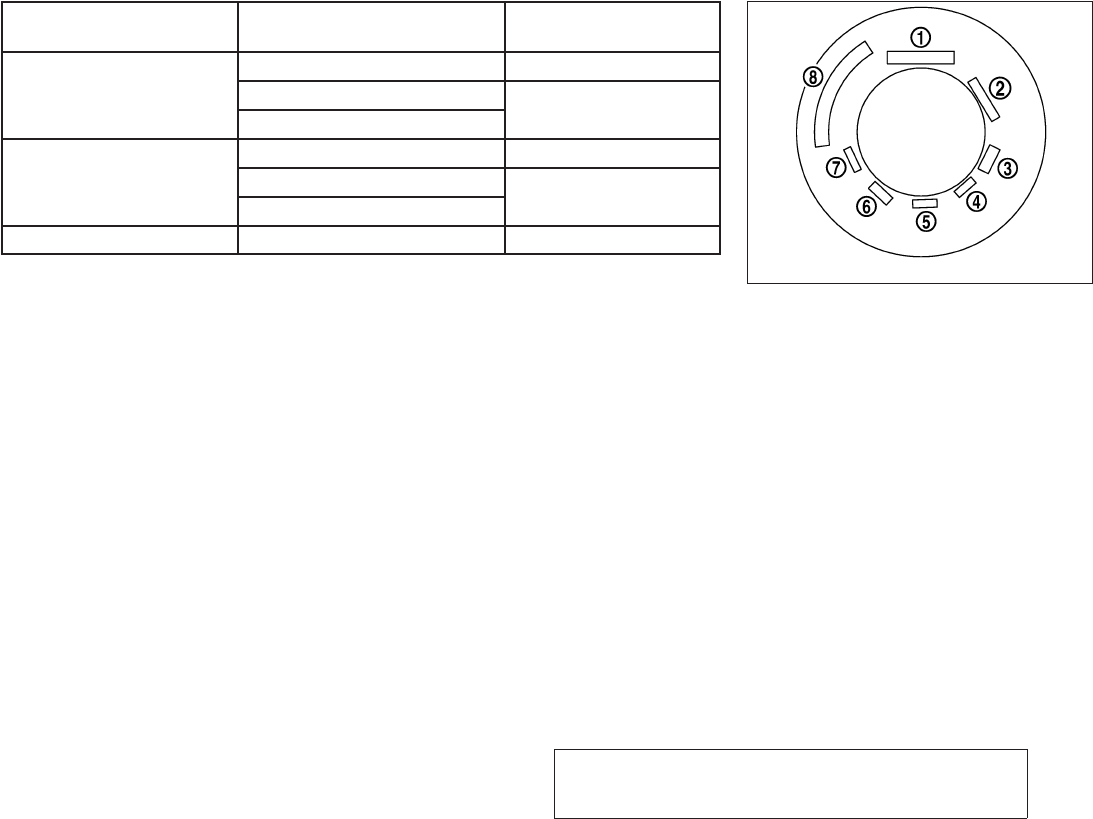
JOBNAME: 1093929-2013-asd-own PAGE: 363 SESS: 5 OUTPUT: Tue Mar 27 10:39:14 2012
Size Cold Tire Inflation Pres-
sure
Front Original Tire P215/60R16 220 kPa, 32 PSI
P215/55R17 230 kPa, 33 PSI
P235/45R18
Rear Original Tire P215/60R16 220 kPa, 32 PSI
P215/55R17 230 kPa, 33 PSI
P235/45R18
Spare Tire T135/70D16 420 kPa, 60 PSI
TIRE LABELING
Federal law requires tire manufacturers to
place standardized information on the
sidewall of all tires. This information iden-
tifies and describes the fundamental
characteristics of the tire and also pro-
vides the tire identification number (TIN)
for safety standard certification. The TIN
can be used to identify the tire in case of a
recall.
Example
WDI0394
Maintenance and do-it-yourself 8-39
ZREVIEW COPY—
2013 Altima Sedan (asd)
Owners Manual—USA_English (nna)
03/27/12—dmoore
X
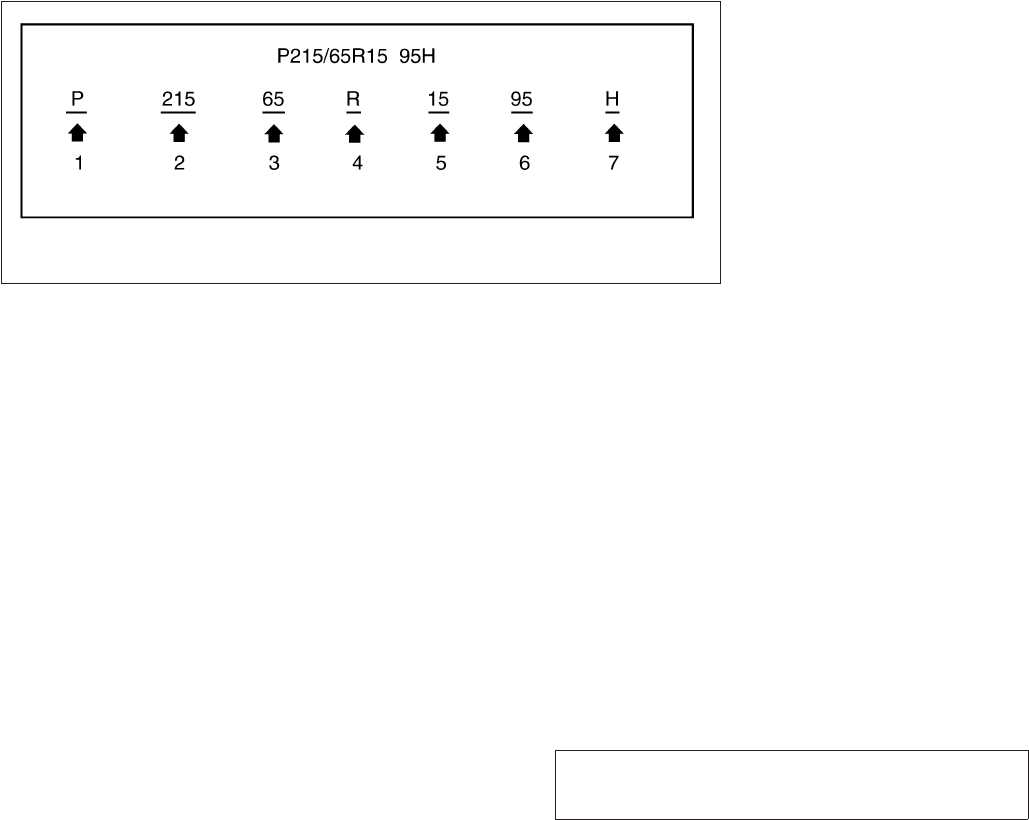
JOBNAME: 1093929-2013-asd-own PAGE: 364 SESS: 5 OUTPUT: Tue Mar 27 10:39:14 2012
s
1Tire size (example: P215/65R15 95H)
1. P: The “P” indicates the tire is de-
signed for passenger vehicles (not all
tires have this information).
2. Three-digit number (215): This num-
ber gives the width in millimeters of
the tire from sidewall edge to side-
wall edge.
3. Two-digit number (65): This number,
known as the aspect ratio, gives the
tire’s ratio of height to width.
4. R: The “R” stands for radial.
5. Two-digit number (15): This number
is the wheel or rim diameter in inches.
6. Two- or three-digit number (95): This
number is the tire’s load index. It is a
measurement of how much weight
each tire can support. You may not
find this information on all tires be-
cause it is not required by law.
7. H: Tire speed rating. You should not
drive the vehicle faster than the tire
speed rating.
Example
WDI0395
8-40 Maintenance and do-it-yourself
ZREVIEW COPY—
2013 Altima Sedan (asd)
Owners Manual—USA_English (nna)
03/27/12—dmoore
X
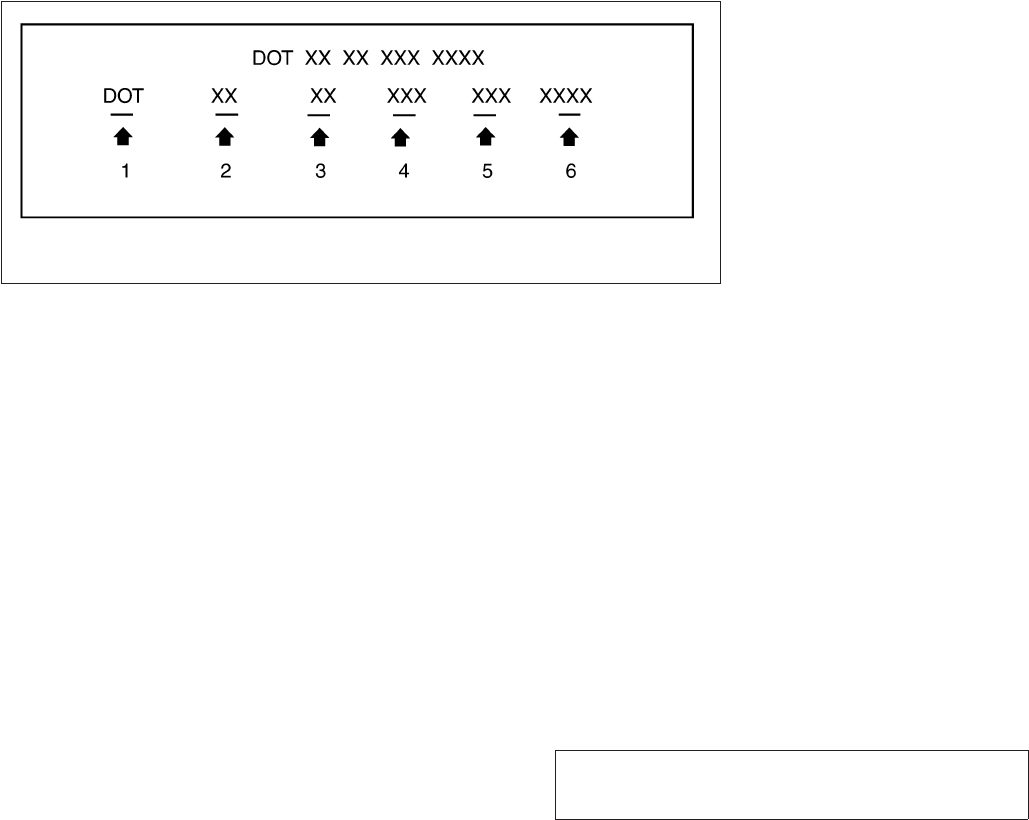
JOBNAME: 1093929-2013-asd-own PAGE: 365 SESS: 5 OUTPUT: Tue Mar 27 10:39:14 2012
s
2TIN (Tire Identification Number) for a
new tire (example: DOT XX XX XXX
XXXX)
1. DOT: Abbreviation for the “Depart-
ment Of Transportation”. The symbol
can be placed above, below or to the
left or right of the Tire Identification
Number.
2. Two-digit code: Manufacturer’s
identification mark.
3. Two-digit code: Tire size.
4. Three-digit code: Tire type code
(Optional).
5. Three-digit code: Date of Manufac-
ture.
6. Four numbers represent the week
and year the tire was built. For ex-
ample, the numbers 3103 means the
31st week of 2003. If these numbers
are missing, then look on the other
sidewall of the tire.
s
3Tire ply composition and material
The number of layers or plies of rubber-
coated fabric in the tire. Tire manufactur-
ers also must indicate the materials in the
tire, which include steel, nylon, polyester,
and others.
s
4Maximum permissible inflation pres-
sure
This number is the greatest amount of air
pressure that should be put in the tire. Do
not exceed the maximum permissible in-
flation pressure.
s
5Maximum load rating
This number indicates the maximum load
in kilograms and pounds that can be car-
ried by the tire. When replacing the tires
on the vehicle, always use a tire that has
the same load rating as the factory in-
stalled tire.
s
6Term of “tubeless” or “tube type”
Indicates whether the tire requires an in-
ner tube (“tube type”) or not (“tubeless”).
Example
WDI0396
Maintenance and do-it-yourself 8-41
ZREVIEW COPY—
2013 Altima Sedan (asd)
Owners Manual—USA_English (nna)
03/27/12—dmoore
X

JOBNAME: 1093929-2013-asd-own PAGE: 366 SESS: 5 OUTPUT: Tue Mar 27 10:39:14 2012
s
7The word “radial”
The word “radial” is shown if the tire has
radial structure.
s
8Manufacturer or brand name
Manufacturer or brand name is shown.
Other Tire-related Terminology
In addition to the many terms that are
defined throughout this section, Intended
Outboard Sidewall is (1) the sidewall that
contains a whitewall, bears white lettering
or bears manufacturer, brand, and/or
model name molding that is higher or
deeper than the same molding on the
other sidewall of the tire, or (2) the out-
ward facing sidewall of an asymmetrical
tire that has a particular side that must
always face outward when mounted on a
vehicle.
TYPES OF TIRES
WARNING
●When changing or replacing tires, be
sure all four tires are of the same type
(i.e., Summer, All Season or Snow) and
construction. A NISSAN dealer may be
able to help you with information about
tire type, size, speed rating and
availability.
●Replacement tires may have a lower
speed rating than the factory equipped
tires, and may not match the potential
maximum vehicle speed. Never exceed
the maximum speed rating of the tire.
●For additional information regarding
tires, refer to “Important Tire Safety In-
formation”(US) or “Tire Safety Informa-
tion” (Canada) in the Warranty Informa-
tion Booklet.
All season tires
NISSAN specifies All Season tires on some mod-
els to provide good performance all year, includ-
ing snowy and icy road conditions. All Season
tires are identified by ALL SEASON and/or M&S
on the tire sidewall. Snow tires have better snow
traction than All Season tires and may be more
appropriate in some areas.
Summer tires
NISSAN specifies summer tires on some models
to provide superior performance on dry roads.
Summer tire performance is substantially re-
duced in snow and ice. Summer tires do not have
the tire traction rating “M&S” on the tire sidewall.
If you plan to operate your vehicle in snowy or icy
conditions, NISSAN recommends the use of
SNOW tires or ALL SEASON tires on all four
wheels.
Snow tires
If snow tires are needed, it is necessary to select
tires equivalent in size and load rating to the
original equipment tires. If you do not, it can
adversely affect the safety and handling of your
vehicle.
Generally, snow tires have lower speed ratings
than factory equipped tires and may not match
the potential maximum vehicle speed. Never ex-
ceed the maximum speed rating of the tire.
If you install snow tires, they must be the same
size, brand, construction and tread pattern on all
four wheels.
8-42 Maintenance and do-it-yourself
ZREVIEW COPY—
2013 Altima Sedan (asd)
Owners Manual—USA_English (nna)
03/27/12—dmoore
X
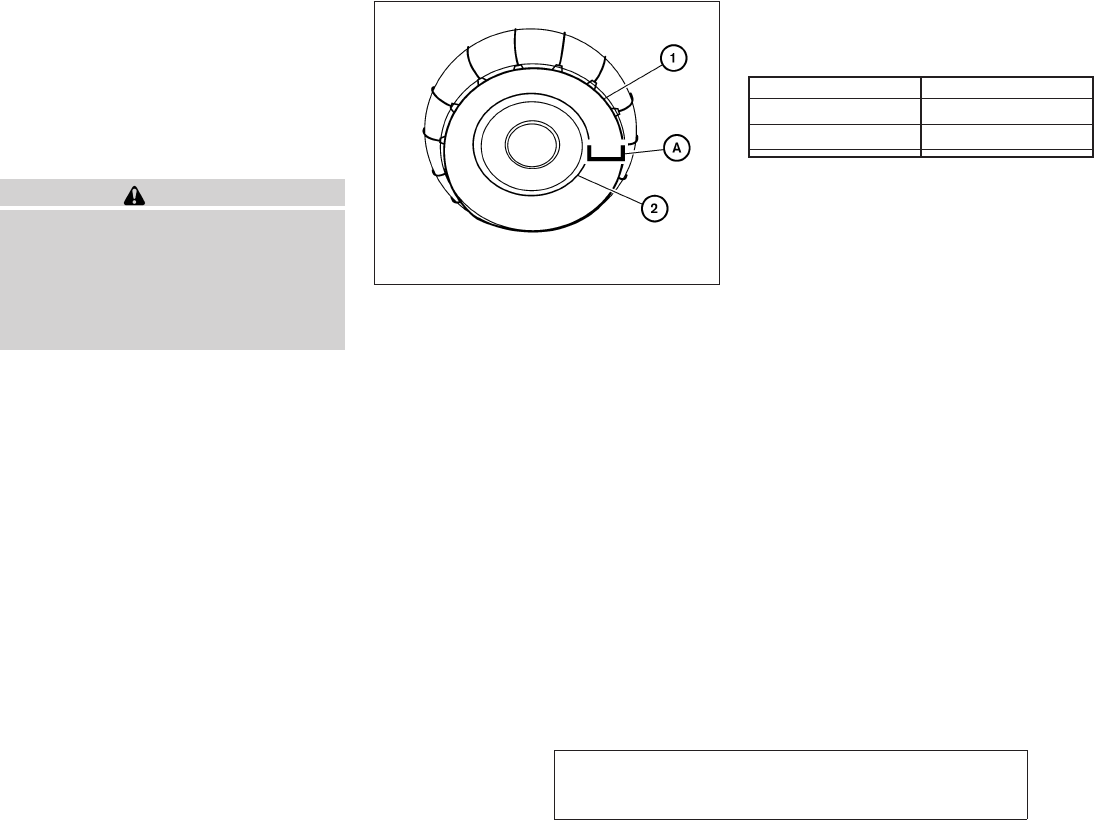
JOBNAME: 1093929-2013-asd-own PAGE: 367 SESS: 5 OUTPUT: Tue Mar 27 10:39:14 2012
For additional traction on icy roads, studded tires
may be used. However, some U.S. states and
Canadian provinces prohibit their use. Check
local, state and provincial laws before installing
studded tires. Skid and traction capabilities of
studded snow tires on wet or dry surfaces may be
poorer than that of non-studded snow tires.
TIRE CHAINS
CAUTION
Only certain SAE class “S” tire chains can
be used on this vehicle. Using the wrong
Class “S” chains on this vehicle will cause
damage to the vehicle. If you plan to use
tire chains/cables, you should use a tire
chain that meets the minimum clearances
for your vehicle.
Use of tire chains may be prohibited according to
location. Check the local laws before installing
tire chains. When installing tire chains, make sure
they are the proper size for the tires on your
vehicle and are installed according to the chain
manufacturer’s suggestions. Use a tire chain that
is designed to provide the specified space s
A
between the installed tire chain s
1and where the
tire meets the rim s
2as shown on the chart.
NOTE:
Tire chains are not permitted for use with
18 in wheels.
Wheel size Minimum space required
16 in .7 in (17 mm)
17 in .2 in (4 mm)
A tire chain that provides the specified amount of
space will provide the necessary clearance be-
tween the tire and the closest vehicle suspension
or body component. The minimum clearances are
determined using the factory-equipped tires.
Other types may damage your vehicle. Use chain
tensioners when recommended by the tire chain
manufacturer to ensure a tight fit. Loose end links
of the tire chain must be secured or removed to
prevent the possibility of whipping action dam-
age to the fenders or underbody. If possible,
avoid fully loading your vehicle when using tire
chains. In addition, drive at a reduced speed.
Otherwise, your vehicle may be damaged and/or
vehicle handling and performance may be ad-
versely affected.
Tire chains must be installed only on the
front wheels and not on the rear wheels.
Never install tire chains on a TEMPORARY USE
ONLY spare tire.
LDI0574
Maintenance and do-it-yourself 8-43
ZREVIEW COPY—
2013 Altima Sedan (asd)
Owners Manual—USA_English (nna)
03/27/12—dmoore
X
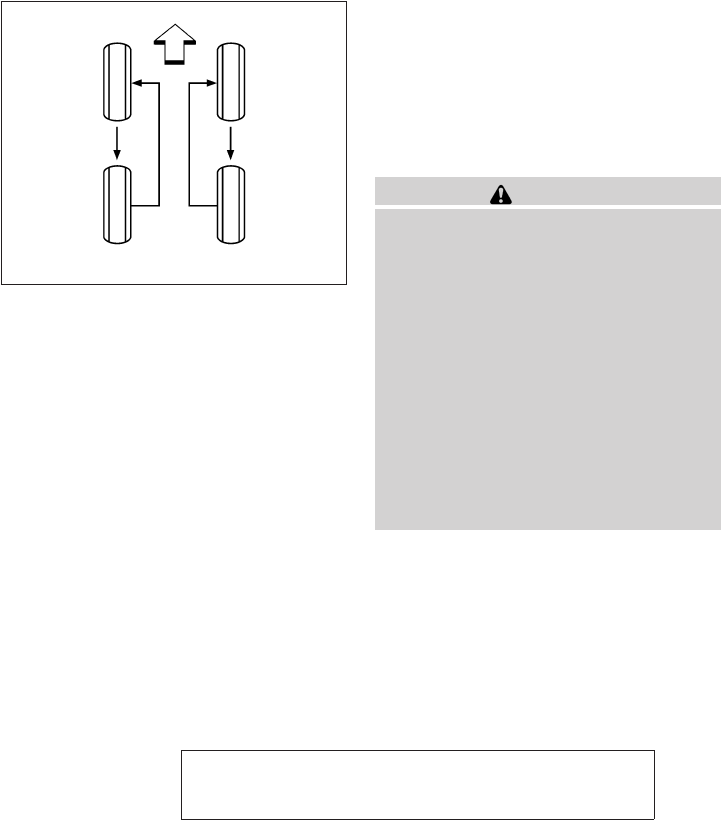
JOBNAME: 1093929-2013-asd-own PAGE: 368 SESS: 5 OUTPUT: Tue Mar 27 10:39:14 2012
Do not use tire chains on dry roads. Driving with
tire chains in such conditions can cause damage
to the various mechanisms of the vehicle due to
some overstress.
CHANGING WHEELS AND TIRES
Tire rotation
NISSAN recommends rotating the tires
every 7,500 miles (12,000 km).
See “Flat tire” in the “In case of emer-
gency” section of this manual for tire re-
placing procedures.
As soon as possible, tighten the
wheel nuts to the specified torque
with a torque wrench.
Wheel nut tightening torque:
83 ft-lb (113 N·m)
The wheel nuts must be kept tight-
ened to specifications at all times. It
is recommended that wheel nuts be
tightened to specification at each
tire rotation interval.
WARNING
●After rotating the tires, check and
adjust the tire pressure.
●Retighten the wheel nuts when
the vehicle has been driven for
600 miles (1,000 km) (also in
cases of a flat tire, etc.).
●Do not include the spare tire in
the tire rotation.
●For additional information re-
garding tires, refer to “Important
Tire Safety Information” (US) or
“Tire Safety Information”
(Canada) in the Warranty Infor-
mation Booklet.
WDI0258
8-44 Maintenance and do-it-yourself
ZREVIEW COPY—
2013 Altima Sedan (asd)
Owners Manual—USA_English (nna)
03/27/12—dmoore
X
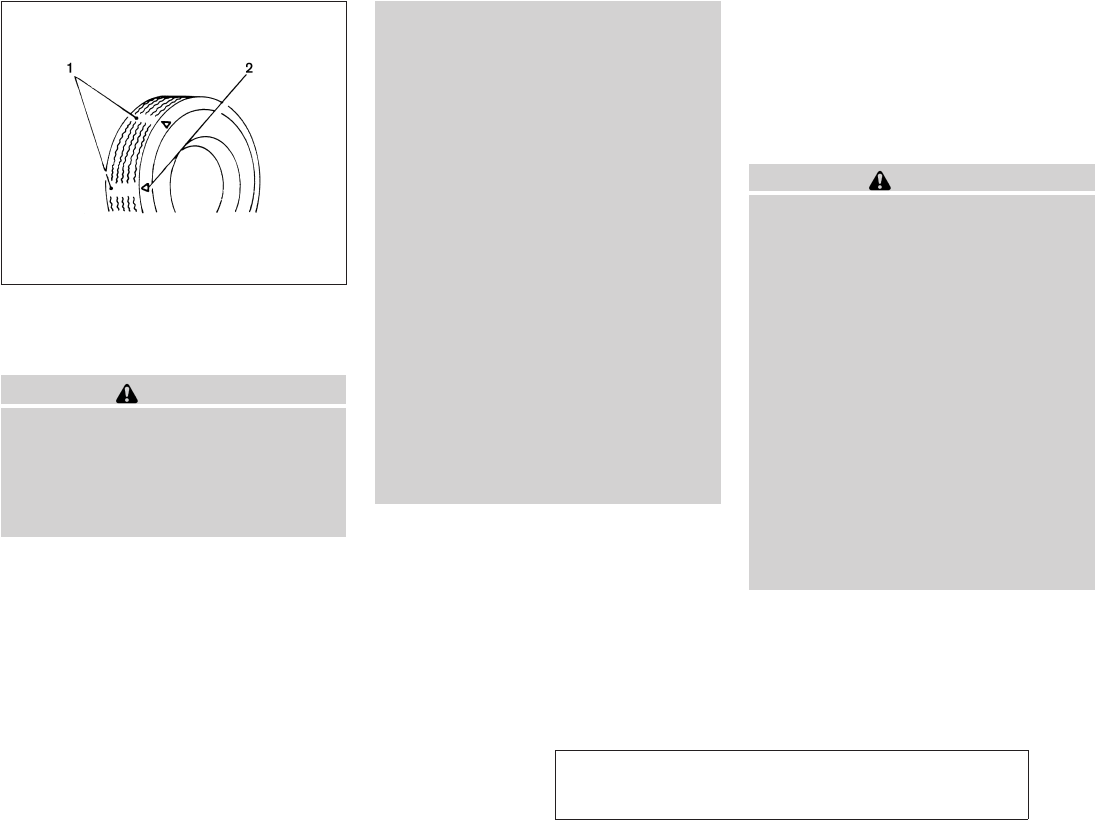
JOBNAME: 1093929-2013-asd-own PAGE: 369 SESS: 5 OUTPUT: Tue Mar 27 10:39:14 2012
1. Wear indicator
2. Location mark
Tire wear and damage
WARNING
●Tires should be periodically in-
spected for wear, cracking, bulg-
ing or objects caught in the tread.
If excessive wear, cracks, bulging
or deep cuts are found, the tire(s)
should be replaced.
●The original tires have built-in
tread wear indicators. When the
wear indicators are visible, the
tire(s) should be replaced.
●Tires degrade with age and use.
Have tires, including the spare,
over 6 years old checked by a
qualified technician because
some tire damage may not be ob-
vious. Replace the tires as neces-
sary to prevent tire failure and
possible personal injury.
●Improper service of the spare tire
may result in serious personal in-
jury. If it is necessary to repair the
spare tire, contact a NISSAN
dealer.
●For additional information re-
garding tires, refer to “Important
Tire Safety Information” (US) or
“Tire Safety Information”
(Canada) in the Warranty Infor-
mation Booklet.
Replacing wheels and tires
When replacing a tire, use the same size, tread
design, speed rating and load carrying capacity
as originally equipped. Recommended types and
sizes are shown in “Wheels and tires” in the
“Technical and consumer information” section of
this manual.
WARNING
●The use of tires other than those recom-
mended or the mixed use of tires of
different brands, construction (bias,
bias-belted or radial), or tread patterns
can adversely affect the ride, braking,
handling, VDC system, ground clear-
ance, body-to-tire clearance, tire chain
clearance, speedometer calibration,
headlight aim and bumper height.
Some of these effects may lead to acci-
dents and could result in serious per-
sonal injury.
●If your vehicle was originally equipped
with 4 tires that were the same size and
you are only replacing 2 of the 4 tires ,
install the new tires on the rear axle.
Placing new tires on the front axle may
cause loss of vehicle control in some
driving conditions and cause an acci-
dent and personal injury.
WDI0259
Maintenance and do-it-yourself 8-45
ZREVIEW COPY—
2013 Altima Sedan (asd)
Owners Manual—USA_English (nna)
03/27/12—dmoore
X

JOBNAME: 1093929-2013-asd-own PAGE: 370 SESS: 5 OUTPUT: Tue Mar 27 10:39:14 2012
●If the wheels are changed for any rea-
son, always replace with wheels which
have the same off-set dimension.
Wheels of a different off-set could
cause premature tire wear, degrade ve-
hicle handling characteristics, affect
the VDC system and/or interference
with the brake discs/drums. Such inter-
ference can lead to decreased braking
efficiency and/or early brake pad/shoe
wear. Refer to “Wheels and tires” in the
“Technical and consumer information”
section of this manual for wheel off-set
dimensions.
●When a spare tire is mounted or a wheel
is replaced, the TPMS will not function
and the low tire pressure warning light
will flash for approximately 1 minute.
The light will remain on after 1 minute.
Contact your NISSAN dealer as soon as
possible for tire replacement and/or
system resetting.
●Replacing tires with those not originally
specified by NISSAN could affect the
proper operation of the TPMS.
●Do not install a damaged or deformed
wheel or tire even if it has been re-
paired. Such wheels or tires could have
structural damage and could fail with-
out warning.
●The use of retread tires is not
recommended.
●For additional information regarding
tires, refer to “Important Tire Safety In-
formation”(US) or “Tire Safety Informa-
tion” (Canada) in the Warranty Informa-
tion Booklet.
Wheel balance
Unbalanced wheels may affect vehicle handling
and tire life. Even with regular use, wheels can get
out of balance. Therefore, they should be bal-
anced as required.
Wheel balance service should be per-
formed with the wheels off the vehicle.
Spin balancing the wheels on the vehicle
could lead to mechanical damage.
●For additional information regarding
tires, refer to “Important Tire Safety
Information” (US) or “Tire Safety Infor-
mation” (Canada) in the Warranty In-
formation Booklet.
Care of wheels
●Wash the wheels when washing the vehicle
to maintain their appearance.
●Clean the inner side of the wheels when the
wheel is changed or the underside of the
vehicle is washed.
●Do not use abrasive cleaners when washing
the wheels.
●Inspect wheel rims regularly for dents or
corrosion. Such damage may cause loss of
pressure or poor seal at the tire bead.
●NISSAN recommends waxing the road
wheels to protect against road salt in areas
where it is used during winter.
8-46 Maintenance and do-it-yourself
ZREVIEW COPY—
2013 Altima Sedan (asd)
Owners Manual—USA_English (nna)
03/27/12—dmoore
X

JOBNAME: 1093929-2013-asd-own PAGE: 371 SESS: 5 OUTPUT: Tue Mar 27 10:39:14 2012
Spare tire (TEMPORARY USE ONLY
spare tire)
Observe the following precautions if the TEM-
PORARY USE ONLY spare tire must be used.
Otherwise, your vehicle could be damaged or
involved in an accident:
WARNING
●The spare tire should be used for emer-
gency use only. It should be replaced
with the standard tire at the first oppor-
tunity to avoid possible tire or differen-
tial damage.
●Drive carefully while the TEMPORARY
USE ONLY spare tire is installed. Avoid
sharp turns and abrupt braking while
driving.
●Periodically check spare tire inflation
pressure. Always keep the pressure of
the TEMPORARY USE ONLY spare tire
at 60 psi (420 kPa, 4.2 bar).
●With the TEMPORARY USE ONLY spare
tire installed do not drive the vehicle at
speeds faster than 50 MPH (80 km/h).
●When driving on roads covered with
snow or ice, the TEMPORARY USE
ONLY spare tire should be used on the
rear wheels and the original tire used
on the front wheels (drive wheels). Use
tire chains only on the front (original)
tires.
●Tire tread of the TEMPORARY USE
ONLY spare tire will wear at a faster rate
than the standard tire. Replace the
spare tire as soon as the tread wear
indicators appear.
●Do not use the spare tire on other
vehicles.
●Do not use more than one spare tire at
the same time.
●Do not tow a trailer when the TEMPO-
RARY USE ONLY spare tire is installed.
CAUTION
●Do not use tire chains on a TEMPO-
RARY USE ONLY spare tire. Tire chains
will not fit properly and may cause dam-
age to the vehicle.
●Because the TEMPORARY USE ONLY
spare tire is smaller than the original
tire, ground clearance is reduced. To
avoid damage to the vehicle, do not
drive over obstacles. Also, do not drive
the vehicle through an automatic car
wash since it may get caught.
Maintenance and do-it-yourself 8-47
ZREVIEW COPY—
2013 Altima Sedan (asd)
Owners Manual—USA_English (nna)
03/27/12—dmoore
X

JOBNAME: 1093929-2013-asd-own PAGE: 372 SESS: 5 OUTPUT: Tue Mar 27 10:39:14 2012
MEMO
8-48 Maintenance and do-it-yourself
ZREVIEW COPY—
2013 Altima Sedan (asd)
Owners Manual—USA_English (nna)
03/27/12—dmoore
X

JOBNAME: 1093929-2013-asd-own PAGE: 373 SESS: 5 OUTPUT: Tue Mar 27 10:39:14 2012
9 Technical and consumer information
Capacities and recommended fuel/lubricants . . . . . . . . . 9-2
Fuelrecommendation...........................9-3
Engine oil and oil filter recommendations . . . . . . . . . . 9-6
Air conditioner system refrigerant and oil
recommendations ..............................9-7
Specifications.....................................9-8
Engine........................................9-8
Wheelsandtires...............................9-9
Dimensions and weights . . . . . . . . . . . . . . . . . . . . . . . . 9-9
When traveling or registering your vehicle in
anothercountry ..................................9-10
Vehicleidentification..............................9-10
Vehicle identification number (VIN) plate . . . . . . . . .9-10
Vehicle identification number
(chassisnumber)..............................9-10
Engineserialnumber...........................9-11
F.M.V.S.S./C.M.V.S.S. certification label . . . . . . . . . .9-11
Emission control information label . . . . . . . . . . . . . . . 9-12
Tire and loading information label. . . . . . . . . . . . . . . .9-12
Air conditioner specification label. . . . . . . . . . . . . . . . 9-12
Installing front license plate . . . . . . . . . . . . . . . . . . . . . . . .9-13
Vehicle loading information . . . . . . . . . . . . . . . . . . . . . . . .9-13
Terms........................................9-13
Vehicleloadcapacity ..........................9-14
Loadingtips ..................................9-16
Measurement of weights . . . . . . . . . . . . . . . . . . . . . . .9-16
Towing a trailer . . . . . . . . . . . . . . . . . . . . . . . . . . . . . . . . . . . 9-17
Flat towing. . . . . . . . . . . . . . . . . . . . . . . . . . . . . . . . . . . .9-17
Uniform tire quality grading . . . . . . . . . . . . . . . . . . . . . . . . 9-17
Emission control system warranty . . . . . . . . . . . . . . . . . .9-18
Reporting safety defects . . . . . . . . . . . . . . . . . . . . . . . . . .9-19
Readiness for inspection/maintenance (I/M) test . . . . .9-20
Event Data Recorders (EDR). . . . . . . . . . . . . . . . . . . . . . . 9-20
Owner’s Manual/Service Manual order information . . . 9-21
ZREVIEW COPY—
2013 Altima Sedan (asd)
Owners Manual—USA_English (nna)
03/27/12—dmoore
X
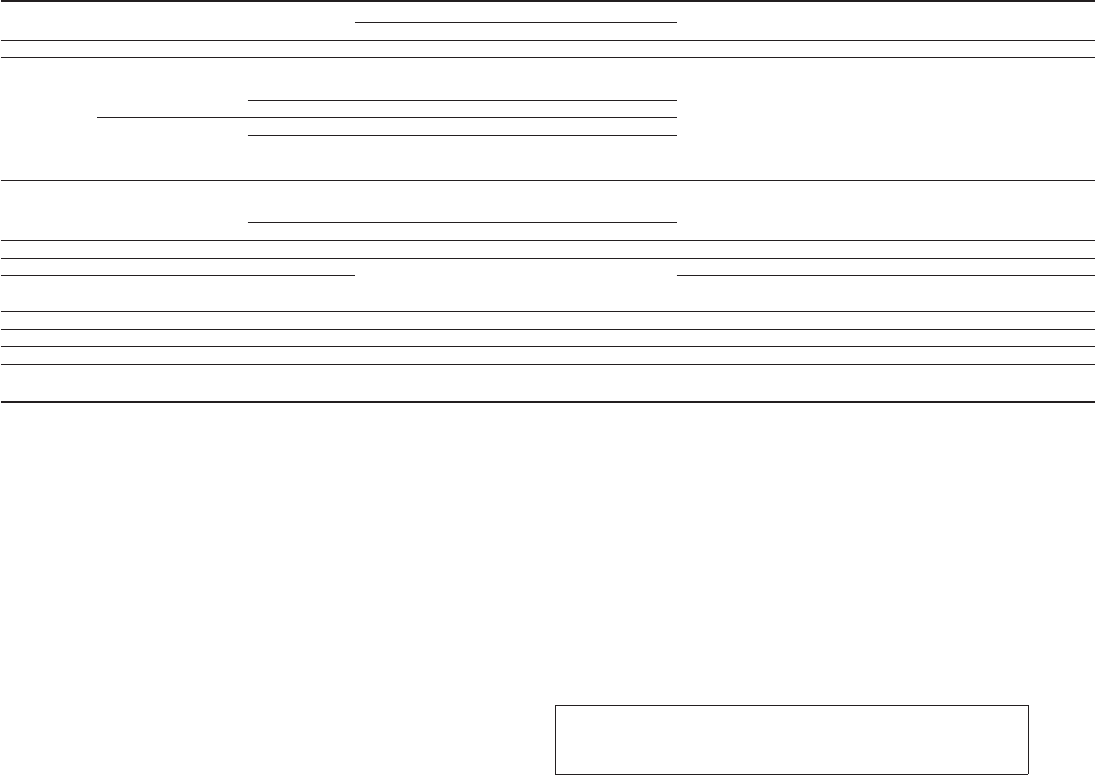
JOBNAME: 1093929-2013-asd-own PAGE: 374 SESS: 5 OUTPUT: Tue Mar 27 10:39:14 2012
The following are approximate capacities. The actual refill capacities may be slightly different. When refilling, follow the procedure
described in the “Maintenance and do-it-yourself” section to determine the proper refill capacity.
Capacity (Approximate) Recommended Fluids and Lubricants
US measure Imp measure Liter
Fuel 18 gal 15 gal 68.0 See “Fuel recommendation” later in this section.
Engine oil *6
Drain and Refill
With oil filter change QR25DE 4-7/8 qt 4 qt 4.6 For QR25DE engine models:
• Engine oil with API Certification Mark *1
• Viscosity SAE 0W-20 *1
For VQ35DE engine models:
• Engine oil with API Certification Mark *1, *7
• Viscosity SAE 5W-30 *1, *7
VQ35DE 5-1/8 qt 4-1/4 qt 4.8
Without oil filter
change
QR25DE 4-1/2 qt 3-3/4 qt 4.3
VQ35DE 4-3/4 qt 4 qt 4.5
Cooling system With reservoir QR25DE 2 gal 1-3/4 gal 8.1 Pre-diluted Genuine NISSAN Long Life Antifreeze/Coolant (blue) or
equivalent
VQ35DE 2-5/8 gal 2-1/8 gal 9.8
Continuously Variable Transmission (CVT) fluid — — — Genuine NISSAN CVT Fluid NS-3 *2
Power steering fluid (PSF) Refill to the proper level according to the instruc-
tions in the “Maintenance and do-it-yourself”
section.*8
Genuine NISSAN E-PSF or equivalent.*3
Brake fluid Genuine NISSAN Super Heavy Duty Brake Fluid *4 or equivalent
DOT 3
Multi-purpose grease — — — NLGI No. 2 (Lithium Soap base)
Air conditioning system refrigerant — — — HFC-134a (R-134a) *5
Air conditioning system oil — — — Genuine NISSAN A/C System Oil Type S or equivalent *5
Windshield-washer fluid 1-1/4 gal 1 gal 4.5 Genuine NISSAN Windshield Washer Concentrate Cleaner & Anti-
freeze fluid or equivalent
*1: For further details, see “Engine oil and oil filter recommendations” in this section.
*2: Use only Genuine NISSAN CVT Fluid NS-3. Using transmission fluid other than Genuine NISSAN CVT Fluid NS-3 will damage the CVT, which is not covered by
the NISSAN new vehicle limited warranty.
*3: Use of a power steering fluid other than Genuine NISSAN E-PSF will prevent the power steering system from operating properly.
*4: Available in mainland USA through a NISSAN dealer.
*5: For further details, see “Air conditioner system refrigerant and oil recommendations” in this section.
*6: For further details, see “Engine oil” in the “Maintenance and do-it-yourself” section of this manual.
*7: NISSAN recommends Genuine NISSAN Ester Oil available at a NISSAN dealer.
*8: See your NISSAN dealer for service.
CAPACITIES AND RECOMMENDED
FUEL/LUBRICANTS
9-2 Technical and consumer information
ZREVIEW COPY—
2013 Altima Sedan (asd)
Owners Manual—USA_English (nna)
03/27/12—dmoore
X

JOBNAME: 1093929-2013-asd-own PAGE: 375 SESS: 5 OUTPUT: Tue Mar 27 10:39:14 2012
FUEL RECOMMENDATION
Use unleaded regular gasoline with an octane
rating of at least 87 AKI (Anti-Knock Index) num-
ber (Research octane number 91).
CAUTION
●Using a fuel other than that specified
could adversely affect the emission
control system, and may also affect the
warranty coverage.
●Under no circumstances should a
leaded gasoline be used, because this
will damage the three-way catalyst.
●
Do not use E-15 or E-85 fuel in your ve-
hicle. Your vehicle is not designed to run
on E-15 or E-85 fuel. Using E-15 or E-85
fuel in a vehicle not specifically designed
for E-15 or E-85 fuel can adversely affect
the emission control devices and sys-
tems of the vehicle. Damage caused by
such fuel is not covered by the NISSAN
new vehicle limited warranty.
●U.S. government regulations require
ethanol dispensing pumps to be identi-
fied by a small, square, orange and
black label with the common abbrevia-
tion or the appropriate percentage for
that region.
Gasoline specifications
NISSAN recommends using gasoline that meets
the World-Wide Fuel Charter (WWFC) specifi-
cations where it is available. Many of the automo-
bile manufacturers developed this specification
to improve emission control system and vehicle
performance. Ask your service station manager if
the gasoline meets the WWFC specifications.
Reformulated gasoline
Some fuel suppliers are now producing reformu-
lated gasolines. These gasolines are specially
designed to reduce vehicle emissions. NISSAN
supports efforts towards cleaner air and sug-
gests that you use reformulated gasoline when
available.
Gasoline containing oxygenates
Some fuel suppliers sell gasoline containing oxy-
genates such as ethanol, MTBE and methanol
with or without advertising their presence.
NISSAN does not recommend the use of fuels of
which the oxygenate content and the fuel com-
patibility for your NISSAN cannot be readily de-
termined. If in doubt, ask your service station
manager.
If you use oxygenate-blend gasoline, please take
the following precautions as the usage of such
fuels may cause vehicle performance problems
and/or fuel system damage.
●The fuel should be unleaded and have
an octane rating no lower than that
recommended for unleaded gasoline.
●
If an oxygenate-blend other than metha-
nol blend is used, it should contain no
more than 10% oxygenate. (MTBE may,
however, be added up to 15%.)
●E-15 fuel contains more than 10% oxy-
genate. E-15 fuel will adversely affect
the emission control devices and sys-
tems of the vehicle and should not be
used. Damage caused by such fuel is
not covered by the NISSAN new ve-
hicle limited warranty.
●
If a methanol blend is used, it should
contain no more than 5% methanol
(methyl alcohol, wood alcohol). It
should also contain a suitable amount
of appropriate cosolvents and corrosion
inhibitors. If not properly formulated
with appropriate cosolvents and corro-
sion inhibitors, such methanol blends
may cause fuel system damage and/or
vehicle performance problems. At this
time, sufficient data is not available to
ensure that all methanol blends are suit-
able for use in NISSAN vehicles.
Technical and consumer information 9-3
ZREVIEW COPY—
2013 Altima Sedan (asd)
Owners Manual—USA_English (nna)
03/27/12—dmoore
X

JOBNAME: 1093929-2013-asd-own PAGE: 376 SESS: 5 OUTPUT: Tue Mar 27 10:39:14 2012
If any driveability problems such as engine stall-
ing and difficult hot-starting are experienced after
using oxygenate-blend fuels, immediately
change to a non-oxygenate fuel or a fuel with a
low blend of MTBE.
Take care not to spill gasoline during refu-
eling. Gasoline containing oxygenates can
cause paint damage.
E-15 fuel
E-15 fuel is a mixture of approximately 15% fuel
ethanol and 85% unleaded gasoline. E-15 can
only be used in vehicles designed to run on E-15
fuel. Do not use E-15 in your vehicle. U.S. gov-
ernment regulations require fuel ethanol dispens-
ing pumps to be identified with small, square,
orange and black label with the common abbre-
viation or the appropriate percentage for that
region.
E–85 fuel
E-85 fuel is a mixture of approximately 85% fuel
ethanol and 15% unleaded gasoline. E-85 can
only be used in a Flexible Fuel Vehicle (FFV). Do
not use E-85 in your vehicle. U.S. government
regulations require fuel ethanol dispensing
pumps to be identified by a small, square, orange
and black label with the common abbreviation or
the appropriate percentage for that region.
Aftermarket fuel additives
NISSAN does not recommend the use of any
aftermarket fuel additives (for example, fuel injec-
tor cleaner, octane booster, intake valve deposit
removers, etc.) which are sold commercially.
Many of these additives intended for gum, varnish
or deposit removal may contain active solvents or
similar ingredients that can be harmful to the fuel
system and engine.
Octane rating tips
Using unleaded gasoline with an octane
rating lower than recommended can cause
persistent, heavy “spark knock.” (“Spark
knock” is a metallic rapping noise.) If se-
vere, this can lead to engine damage. If you
detect a persistent heavy spark knock even
when using gasoline of the stated octane
rating, or if you hear steady spark knock
while holding a steady speed on level
roads, have a NISSAN dealer correct the
condition. Failure to correct the condition
is misuse of the vehicle, for which NISSAN
is not responsible.
Incorrect ignition timing may result in spark
knock, after-run and/or overheating, which may
cause excessive fuel consumption or engine
damage. If any of the above symptoms are en-
countered, have your vehicle checked at a
NISSAN dealer.
However, now and then you may notice
light spark knock for a short time while
accelerating or driving up hills. This is not a
cause for concern, because you get the
greatest fuel benefit when there is light
spark knock for a short time under heavy
engine load.
9-4 Technical and consumer information
ZREVIEW COPY—
2013 Altima Sedan (asd)
Owners Manual—USA_English (nna)
03/27/12—dmoore
X
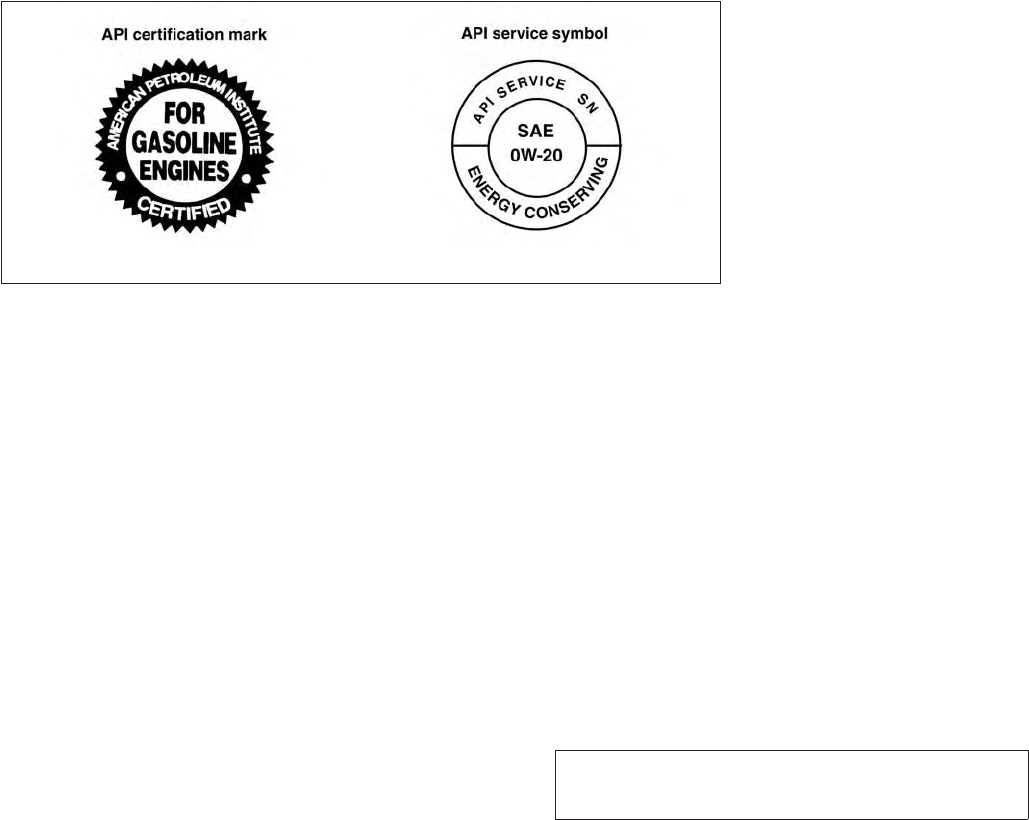
JOBNAME: 1093929-2013-asd-own PAGE: 377 SESS: 5 OUTPUT: Tue Mar 27 10:39:14 2012
QR25DE engine models
LTI2037
Technical and consumer information 9-5
ZREVIEW COPY—
2013 Altima Sedan (asd)
Owners Manual—USA_English (nna)
03/27/12—dmoore
X
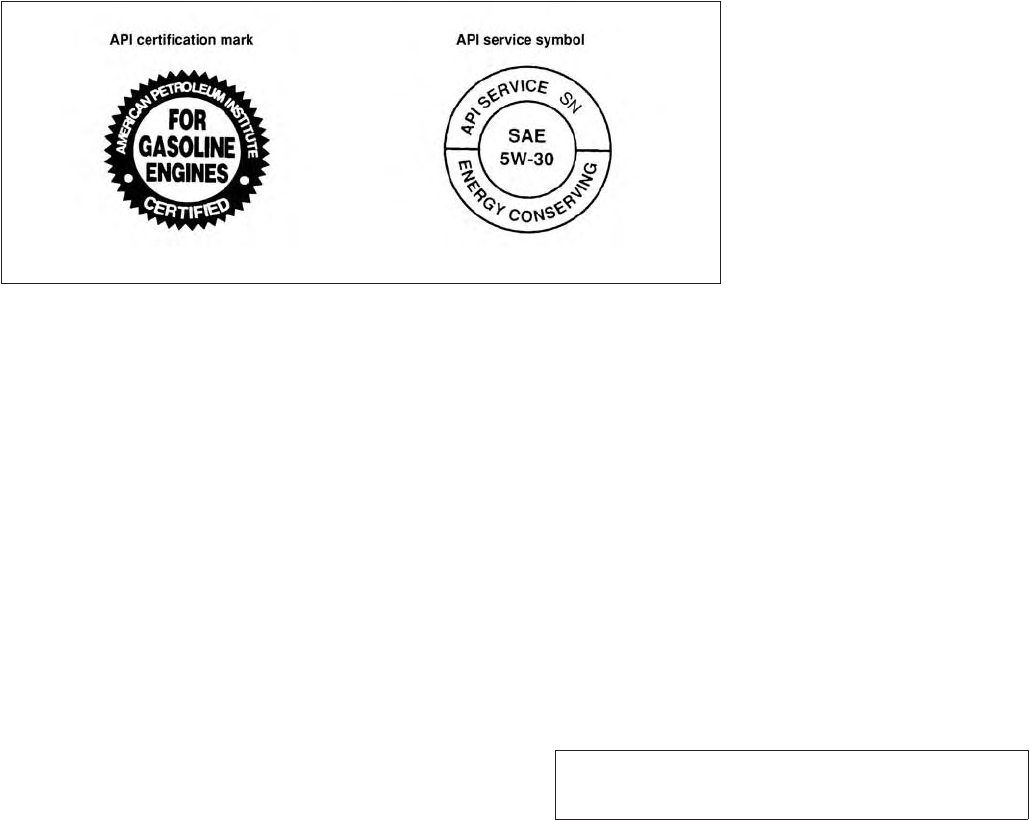
JOBNAME: 1093929-2013-asd-own PAGE: 378 SESS: 5 OUTPUT: Tue Mar 27 10:39:14 2012
ENGINE OIL AND OIL FILTER
RECOMMENDATIONS
Selecting the correct oil
It is essential to choose the correct grade, quality
and viscosity engine oil to ensure satisfactory
engine life and performance. See “Capacities
and recommended fuel/lubricants” earlier in this
section. NISSAN recommends the use of an
energy conserving oil in order to improve fuel
economy.
Select only engine oils that meet the American
Petroleum Institute (API) certification or Interna-
tional Lubricant Standardization and Approval
Committee (ILSAC) certification and SAE vis-
cosity standard. These oils have the API certifica-
tion mark on the front of the container. Oils which
do not have the specified quality label should not
be used as they could cause engine damage.
Oil additives
NISSAN does not recommend the use of oil
additives. The use of an oil additive is not neces-
sary when the proper oil type is used and main-
tenance intervals are followed.
Oil which may contain foreign matter or has been
previously used should not be used.
Oil viscosity
The engine oil viscosity or thickness changes
with temperature. Because of this, it is important
to select the engine oil viscosity based on the
temperatures at which the vehicle will be oper-
ated before the next oil change. Choosing an oil
viscosity other than that recommended could
cause serious engine damage.
Selecting the correct oil filter
Your new NISSAN vehicle is equipped with a
high-quality genuine NISSAN oil filter. When re-
placing, use a genuine NISSAN oil filter or its
equivalent for the reason described in “Change
intervals.”
Change intervals
The oil and oil filter change intervals for your
engine are based on the use of the specified
quality oils and filters. Using engine oil and filters
that are not of the specified quality, or exceeding
recommended oil and filter change intervals
could reduce engine life. Damage to the engine
caused by improper maintenance or use of incor-
rect oil and filter quality and/or viscosity is not
covered by the NISSAN new vehicle limited war-
ranty.
VQ35DE engine models
LTI2024
9-6 Technical and consumer information
ZREVIEW COPY—
2013 Altima Sedan (asd)
Owners Manual—USA_English (nna)
03/27/12—dmoore
X

JOBNAME: 1093929-2013-asd-own PAGE: 379 SESS: 5 OUTPUT: Tue Mar 27 10:39:14 2012
Your engine was filled with a high-quality engine
oil when it was built. You do not have to change
the oil before the first recommended change
interval. Oil and filter change intervals depend
upon how you use your vehicle.
Operation under the following conditions may
require more frequent oil and filter changes:
●repeated short distance driving at cold out-
side temperatures
●driving in dusty conditions
●extensive idling
●towing a trailer
●stop and go commuting
Refer to the “NISSAN Service and Maintenance
Guide” for the maintenance schedule.
AIR CONDITIONER SYSTEM
REFRIGERANT AND OIL
RECOMMENDATIONS
The air conditioner system in your NISSAN
vehicle must be charged with the refriger-
ant HFC-134a (R-134a) and NISSAN A/C
system oil Type S or the exact equivalents.
CAUTION
The use of any other refrigerant or oil will
cause severe damage to the air condition-
ing system and will require the replace-
ment of all air conditioner system
components.
The refrigerant HFC-134a (R-134a) in your
NISSAN vehicle does not harm the earth’s ozone
layer. Although this refrigerant does not affect the
earth’s atmosphere, certain government regula-
tions require the recovery and recycling of any
refrigerant during automotive air conditioner sys-
tem service. A NISSAN dealer has the trained
technicians and equipment needed to recover
and recycle your air conditioner system refriger-
ant.
Contact a NISSAN dealer when servicing your air
conditioner system.
Technical and consumer information 9-7
ZREVIEW COPY—
2013 Altima Sedan (asd)
Owners Manual—USA_English (nna)
03/27/12—dmoore
X
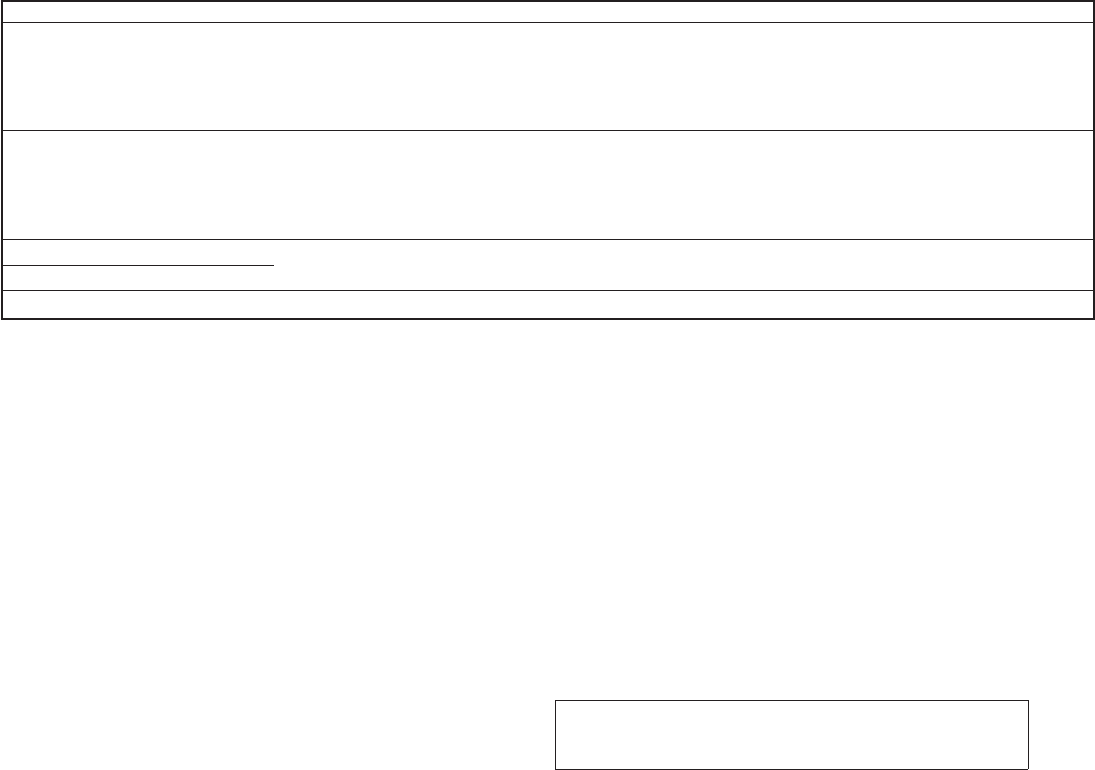
JOBNAME: 1093929-2013-asd-own PAGE: 380 SESS: 5 OUTPUT: Tue Mar 27 10:39:14 2012
ENGINE
Model QR25DE VQ35DE
Type Gasoline, 4-cycle, DOHC Gasoline, 4-cycle, DOHC
Cylinder arrangement 4-cylinder in-line 6-cylinder, V-block, Slanted at 60°
Bore x Stroke in (mm) 3.5 x 3.9 (89.0 x 100.0) 3.760 x 3.205 (95.5 x 81.4)
Displacement cu in (cm
3
) 151.82 (2,488) 213.45 (3,498)
Firing order 1–3–4–2 1–2–3–4–5–6
Idle speed
No adjustment is necessary.
CVT (in “N” position)
Ignition timing (degree B.T.D.C. at idle
speed)
CO % at idle
Spark plug FXE20HE-11C FXE22HR-11
Spark plug gap (Nominal) in (mm) 0.043 (1.1) 0.043 (1.1)
Camshaft operation Timing chain Timing chain
This spark ignition system complies with the Canadian standard ICES-002.
SPECIFICATIONS
9-8 Technical and consumer information
ZREVIEW COPY—
2013 Altima Sedan (asd)
Owners Manual—USA_English (nna)
03/27/12—dmoore
X

JOBNAME: 1093929-2013-asd-own PAGE: 381 SESS: 5 OUTPUT: Tue Mar 27 10:39:14 2012
WHEELS AND TIRES
Wheel type Size Offset mm (in)
Steel 16 x 7.0J 50 (1.97)
Aluminum 17 x 7.5J 50 (1.97)
Aluminum 18 x 7.5J 55 (2.17)
T-type (ST spare) 16 x 4T 40 (1.57)
T-type (AL spare) 16 x 4T 30 (1.18)
Tire size 2.5 models P215/60R16
2.5 models and 3.5
models
P215/55R17
3.5 models P235/45R18
Spare tire T135/70D16
DIMENSIONS AND WEIGHTS
Overall length in (mm) 191.5 (4,863)
Overall width in (mm) 72.0 (1,830)
Overall height
2.5 models in (mm) 57.9 (1,471)
3.5 models in (mm) 58.1 (1,477)
Front track
16 and 17 inch tire in (mm) 62.4 (1,585)
18 inch tire in (mm) 62.0 (1,575)
Rear track
16 and 17 inch tire in (mm) 62.4 (1,585)
18 inch tire in (mm) 62.0 (1,575)
Wheelbase in (mm) 109.3 (2,775)
Gross vehicle weight rating lb (kg) See the “F.M.V.S.S./C.M.V.S.S.
certification label” on the center
pillar between the driver’s side
front and rear doors.
Gross axle weight rating
Front lb (kg)
Rear lb (kg)
Technical and consumer information 9-9
ZREVIEW COPY—
2013 Altima Sedan (asd)
Owners Manual—USA_English (nna)
03/27/12—dmoore
X
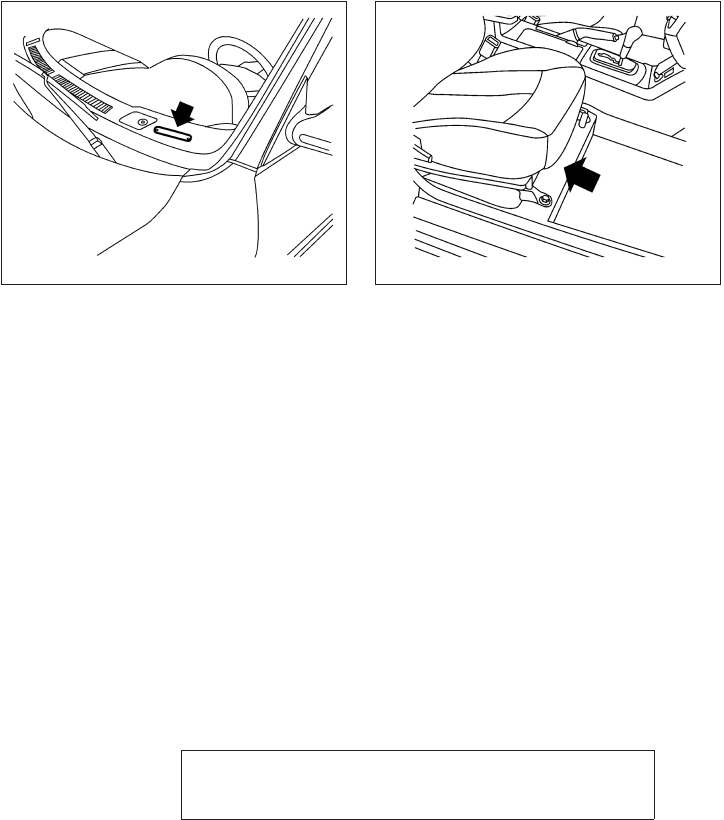
JOBNAME: 1093929-2013-asd-own PAGE: 382 SESS: 5 OUTPUT: Tue Mar 27 10:39:14 2012
When planning to drive your NISSAN ve-
hicle in another country, you should first find
out if the fuel available is suitable for your vehi-
cle’s engine.
Using fuel with an octane rating that is too low
may cause engine damage. All gasoline vehicles
must be operated with unleaded gasoline. There-
fore, avoid taking your vehicle to areas where
appropriate fuel is not available.
When transferring the registration of your
vehicle to another country, state, province
or district, it may be necessary to modify the
vehicle to meet local laws and regulations.
The laws and regulations for motor vehicle emis-
sion control and safety standards vary according
to the country, state, province or district; there-
fore, vehicle specifications may differ.
When any vehicle is to be taken into an-
other country, state, province or district
and registered, its modifications, transpor-
tation, and registration are the responsibil-
ity of the user. NISSAN is not responsible
for any inconvenience that may result.
VEHICLE IDENTIFICATION NUMBER
(VIN) PLATE
The vehicle identification number (VIN) plate is
attached as shown. This number is the identifica-
tion for your vehicle and is used in the vehicle
registration.
VEHICLE IDENTIFICATION NUMBER
(chassis number)
The vehicle identification number is located as
shown.
LTI0025 WTI0037
WHEN TRAVELING OR REGISTERING
YOUR VEHICLE IN ANOTHER
COUNTRY
VEHICLE IDENTIFICATION
9-10 Technical and consumer information
ZREVIEW COPY—
2013 Altima Sedan (asd)
Owners Manual—USA_English (nna)
03/27/12—dmoore
X
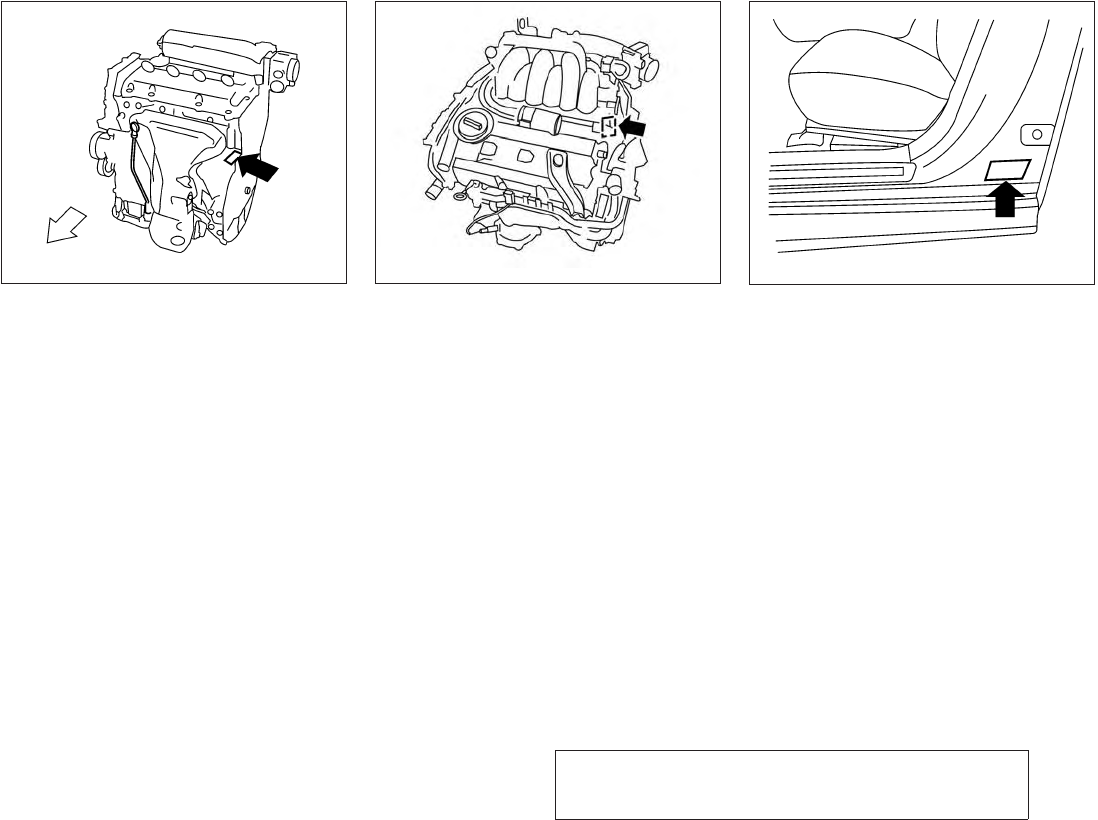
JOBNAME: 1093929-2013-asd-own PAGE: 383 SESS: 5 OUTPUT: Tue Mar 27 10:39:14 2012
ENGINE SERIAL NUMBER
The number is stamped on the engine as shown.
F.M.V.S.S./C.M.V.S.S.
CERTIFICATION LABEL
The Federal/Canadian Motor Vehicle Safety
Standard (F.M.V.S.S./C.M.V.S.S.) certification la-
bel is affixed as shown. This label contains valu-
able vehicle information, such as: Gross Vehicle
Weight Ratings (GVWR), Gross Axle Weight
Rating (GAWR), month and year of manufacture,
Vehicle Identification Number (VIN), etc. Review
it carefully.
QR25DE
WTI0096
VQ35DE
LTI2034 WTI0172
Technical and consumer information 9-11
ZREVIEW COPY—
2013 Altima Sedan (asd)
Owners Manual—USA_English (nna)
03/27/12—dmoore
X
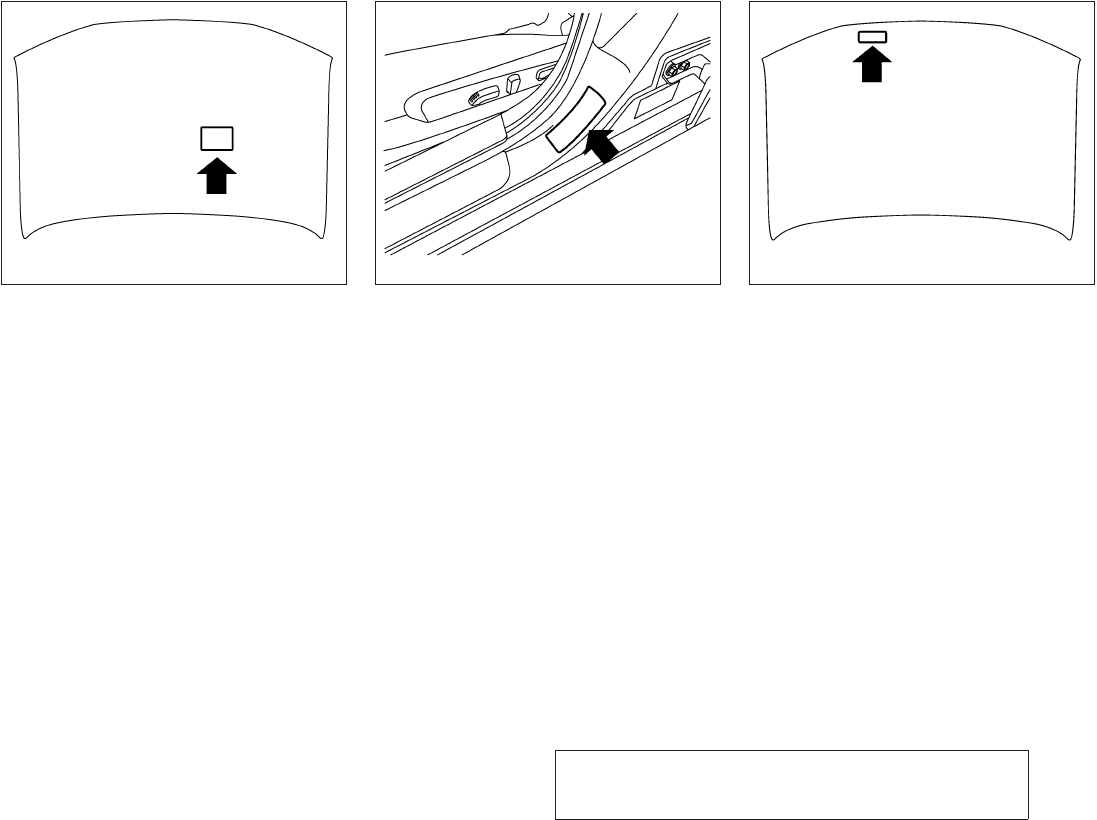
JOBNAME: 1093929-2013-asd-own PAGE: 384 SESS: 5 OUTPUT: Tue Mar 27 10:39:14 2012
EMISSION CONTROL
INFORMATION LABEL
The emission control information label is at-
tached to the underside of the hood as shown.
TIRE AND LOADING INFORMATION
LABEL
The cold tire pressure is shown on the Tire and
Loading Information label. The label is located as
shown.
AIR CONDITIONER SPECIFICATION
LABEL
The air conditioner specification label is affixed to
the underside of the hood as shown.
LTI2004 LTI0224 WTI0178
9-12 Technical and consumer information
ZREVIEW COPY—
2013 Altima Sedan (asd)
Owners Manual—USA_English (nna)
03/27/12—dmoore
X
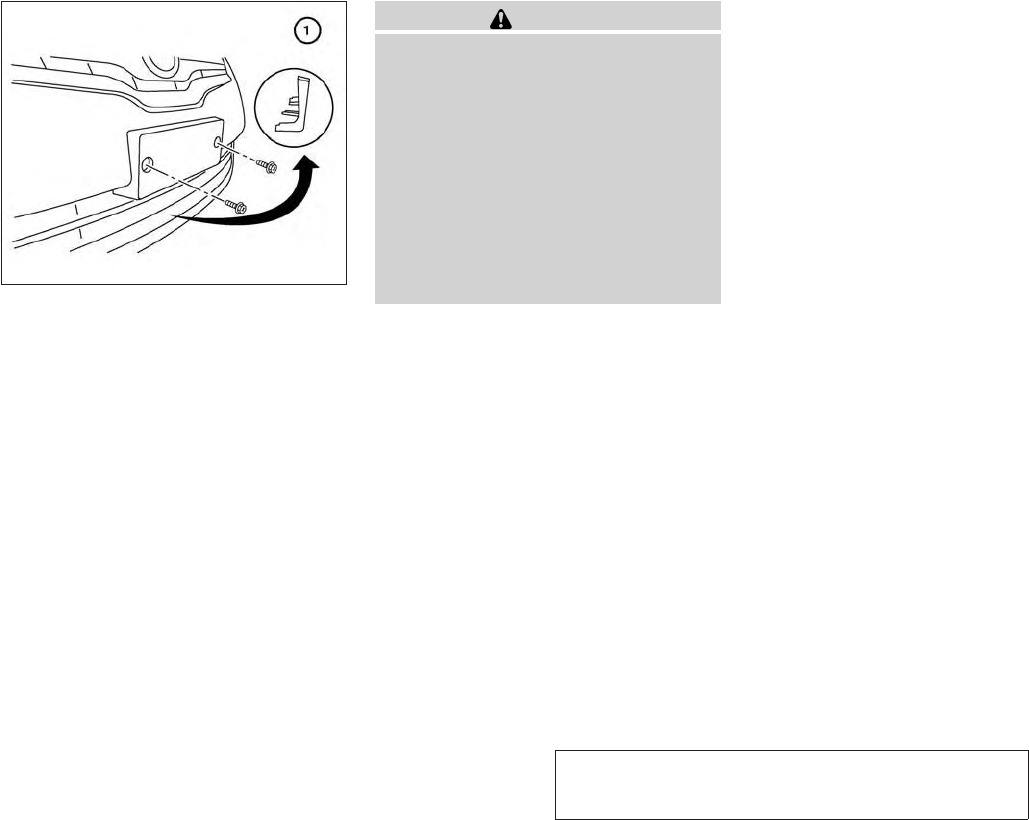
JOBNAME: 1093929-2013-asd-own PAGE: 385 SESS: 5 OUTPUT: Tue Mar 27 10:39:14 2012
To mount the front license plate, attach the li-
cense plate bracket s
1to the plastic finisher at
the location marks (small dimples) using the two
6 mm screws provided.
WARNING
●It is extremely dangerous to ride
in a cargo area inside a vehicle. In
a collision, people riding in these
areas are more likely to be seri-
ously injured or killed.
●Do not allow people to ride in any
area of your vehicle that is not
equipped with seats and seat
belts.
●Be sure everyone in your vehicle
is in a seat and using a seat belt
properly.
TERMS
It is important to familiarize yourself with
the following terms before loading your
vehicle:
●Curb Weight (actual weight of your
vehicle) - vehicle weight including:
standard and optional equipment, flu-
ids, emergency tools, and spare tire
assembly. This weight does not in-
clude passengers and cargo.
●GVW (Gross Vehicle Weight) - curb
weight plus the combined weight of
passengers and cargo.
●GVWR (Gross Vehicle Weight Rat-
ing) - maximum total combined
weight of the unloaded vehicle, pas-
sengers, luggage, hitch, trailer
tongue load and any other optional
equipment. This information is lo-
cated on the F.M.V.S.S./C.M.V.S.S.
certification label.
●GAWR (Gross Axle Weight Rating) -
maximum weight (load) limit specified
for the front or rear axle. This informa-
tion is located on the
F.M.V.S.S./C.M.V.S.S. certification
label.
●GCWR (Gross Combined Weight
rating) - The maximum total weight
rating of the vehicle, passengers,
cargo, and trailer.
LTI2013
INSTALLING FRONT LICENSE PLATE VEHICLE LOADING INFORMATION
Technical and consumer information 9-13
ZREVIEW COPY—
2013 Altima Sedan (asd)
Owners Manual—USA_English (nna)
03/27/12—dmoore
X

JOBNAME: 1093929-2013-asd-own PAGE: 386 SESS: 5 OUTPUT: Tue Mar 27 10:39:14 2012
●Vehicle Capacity Weight, Load limit,
Total load capacity - maximum total
weight limit specified of the load
(passengers and cargo) for the ve-
hicle. This is the maximum combined
weight of occupants and cargo that
can be loaded into the vehicle. If the
vehicle is used to tow a trailer, the
trailer tongue weight must be in-
cluded as part of the cargo load. This
information is located on the Tire and
Loading Information label.
●Cargo capacity - permissible weight
of cargo, the subtracted weight of
occupants from the load limit.
VEHICLE LOAD CAPACITY
Do not exceed the load limit of your ve-
hicle shown as “The combined weight of
occupants and cargo” on the Tire and
Loading Information label. Do not exceed
the number of occupants shown as
“Seating Capacity” on the Tire and Load-
ing Information label.
To get “the combined weight of occu-
pants and cargo”, add the weight of all
occupants, then add the total luggage
weight. Examples are shown in the follow-
ing illustration.
9-14 Technical and consumer information
ZREVIEW COPY—
2013 Altima Sedan (asd)
Owners Manual—USA_English (nna)
03/27/12—dmoore
X
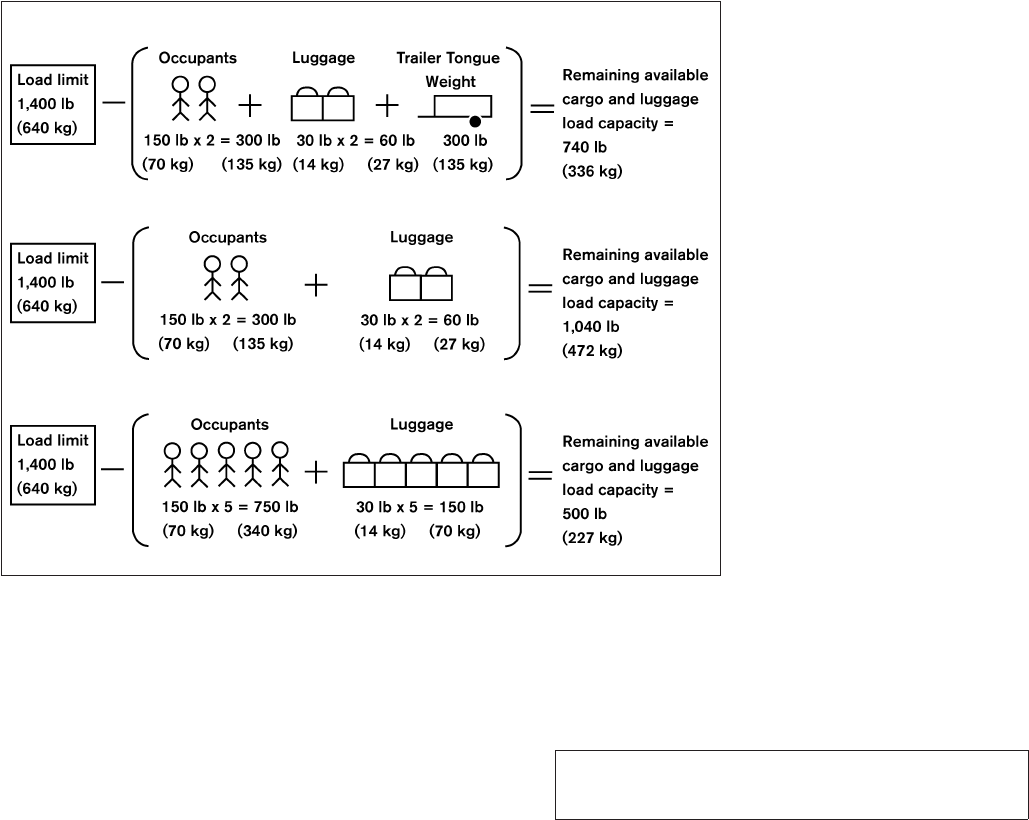
JOBNAME: 1093929-2013-asd-own PAGE: 387 SESS: 5 OUTPUT: Tue Mar 27 10:39:14 2012
Steps for determining correct load
limit
1. Locate the statement “The combined
weight of occupants and cargo
should never exceed XXX lbs or XXX
kg” on your vehicle’s placard.
2. Determine the combined weight of
the driver and passengers that will be
riding in your vehicle.
3. Subtract the combined weight of the
driver and passengers from XXX lbs
or XXX kg.
4. The resulting figure equals the avail-
able amount of cargo and luggage
load capacity. For example, if the
XXX amount equals 1,400 lbs. and
there will be five 150 lb. passengers
in your vehicle, the amount of avail-
able cargo and luggage load capac-
ity is 650 lbs. (1,400-750 (5 X 150)
= 650 lbs) or (640-340 (5 X 70) =
300 kg.)
Example
LTI0152
Technical and consumer information 9-15
ZREVIEW COPY—
2013 Altima Sedan (asd)
Owners Manual—USA_English (nna)
03/27/12—dmoore
X

JOBNAME: 1093929-2013-asd-own PAGE: 388 SESS: 5 OUTPUT: Tue Mar 27 10:39:14 2012
5. Determine the combined weight of
luggage and cargo being loaded on
the vehicle. That weight may not
safely exceed the available cargo and
luggage load capacity calculated in
Step 4.
Before driving a loaded vehicle, confirm
that you do not exceed the Gross Vehicle
Weight Rating (GVWR) or the Gross Axle
Weight Rating (GAWR) for your vehicle.
See “Measurement of weights” later in
this section.
Also check tires for proper inflation pres-
sures. See the Tire and Loading Informa-
tion label.
LOADING TIPS
●The GVW must not exceed GVWR
or GAWR as specified on the
F.M.V.S.S./C.M.V.S.S. certification
label.
●Do not load the front and rear axle to
the GAWR. Doing so will exceed the
GVWR.
WARNING
●Properly secure all cargo with
ropes or straps to help prevent it
from sliding or shifting. Do not
place cargo higher than the seat-
backs. In a sudden stop or colli-
sion, unsecured cargo could
cause personal injury.
●Do not load your vehicle any
heavier than the GVWR or the
maximum front and rear GAWRs.
If you do, parts of your vehicle
can break, tire damage could oc-
cur, or it can change the way your
vehicle handles. This could result
in loss of control and cause per-
sonal injury.
●Overloading not only can shorten
the life of your vehicle and the
tire, but can also cause unsafe
vehicle handling and longer brak-
ing distances. This may cause a
premature tire failure which
could result in a serious accident
and personal injury. Failures
caused by overloading are not
covered by the vehicle’s
warranty.
MEASUREMENT OF WEIGHTS
Secure loose items to prevent weight
shifts that could affect the balance of your
vehicle. When the vehicle is loaded, drive
to a scale and weigh the front and the rear
wheels separately to determine axle
loads. Individual axle loads should not ex-
ceed either of the gross axle weight rat-
ings (GAWR). The total of the axle loads
should not exceed the gross vehicle
weight rating (GVWR). These ratings are
given on the vehicle certification label. If
weight ratings are exceeded, move or re-
move items to bring all weights below the
ratings.
9-16 Technical and consumer information
ZREVIEW COPY—
2013 Altima Sedan (asd)
Owners Manual—USA_English (nna)
03/27/12—dmoore
X

JOBNAME: 1093929-2013-asd-own PAGE: 389 SESS: 5 OUTPUT: Tue Mar 27 10:39:14 2012
Do not tow a trailer with your vehicle.
FLAT TOWING
Towing your vehicle with all four wheels on the
ground is sometimes called flat towing. This
method is sometimes used when towing a vehicle
behind a recreational vehicle, such as a motor
home.
CAUTION
●Failure to follow these guidelines can
result in severe transmission damage.
●Whenever flat towing your vehicle, al-
ways tow forward, never backward.
●DO NOT tow any continuously variable
transmission vehicle with all four
wheels on the ground (flat towing). Do-
ing so WILL DAMAGE internal transmis-
sion parts due to lack of transmission
lubrication.
●For emergency towing procedures refer
to “Towing recommended by NISSAN”
in the “In case of emergency” section of
this manual.
Continuously Variable Transmission
To tow a vehicle equipped with a continuously
variable transmission, an appropriate vehicle
dolly MUST be placed under the towed vehicle’s
drive wheels. Always follow the dolly manufac-
turer’s recommendations when using their prod-
uct.
DOT (Department of Transportation) Quality
Grades: All passenger car tires must conform to
federal safety requirements in addition to these
grades.
Quality grades can be found where applicable on
the tire sidewall between tread shoulder and
maximum section width. For example:
Treadwear 200 Traction AA Temperature A
Treadwear
The treadwear grade is a comparative rating
based on the wear rate of the tire when tested
under controlled conditions on a specified gov-
ernment test course. For example, a tire graded
150 would wear one and one-half (1 1/2) times
as well on the government course as a tire graded
100. The relative performance of tires depends
upon the actual conditions of their use, however,
and may depart significantly from the norm due to
variations in driving habits, service practices and
differences in road characteristics and climate.
Traction AA, A, B and C
The traction grades, from highest to lowest, are
AA, A, B, and C. Those grades represent the
tire’s ability to stop on wet pavement as mea-
sured under controlled conditions on specified
government test surfaces of asphalt and con-
crete. A tire marked C may have poor traction
performance.
TOWING A TRAILER UNIFORM TIRE QUALITY GRADING
Technical and consumer information 9-17
ZREVIEW COPY—
2013 Altima Sedan (asd)
Owners Manual—USA_English (nna)
03/27/12—dmoore
X

JOBNAME: 1093929-2013-asd-own PAGE: 390 SESS: 5 OUTPUT: Tue Mar 27 10:39:14 2012
WARNING
The traction grade assigned to this tire is
based on straight-ahead braking traction
tests, and does not include acceleration,
cornering, hydroplaning, or peak traction
characteristics.
Temperature A, B and C
The temperature grades are A (the highest), B,
and C, representing the tire’s resistance to the
generation of heat, and its ability to dissipate heat
when tested under controlled conditions on a
specified indoor laboratory test wheel. Sustained
high temperature can cause the material of the
tire to degenerate and reduce tire life, and exces-
sive temperature can lead to sudden tire failure.
The grade C corresponds to a level of perfor-
mance which all passenger car tires must meet
under the Federal Motor Safety Standard No.
109. Grades B and A represent higher levels of
performance on the laboratory test wheel than
the minimum required by law.
WARNING
The temperature grade for this tire is es-
tablished for a tire that is properly inflated
and not overloaded. Excessive speed,
under-inflation, or excessive loading, ei-
ther separately or in combination, can
cause heat build-up and possible tire
failure.
Your NISSAN vehicle is covered by the following
emission warranties:
For USA
1. Emission Defects Warranty
2. Emissions Performance Warranty
Details of this warranty may be found with other
vehicle warranties in your Warranty Information
Booklet which comes with your NISSAN vehicle.
If you did not receive a Warranty Information
Booklet, or it is lost, you may obtain a replace-
ment by writing to:
●Nissan North America, Inc.
Consumer Affairs Department
P.O. Box 685003
Franklin, TN 37068-5003
For Canada
Emission Control System Warranty
Details of this warranty may be found with other
vehicle warranties in your Warranty Information
Booklet which comes with your NISSAN vehicle.
If you did not receive a Warranty Information
Booklet, or it is lost, you may obtain a replace-
ment by writing to:
●Nissan Canada Inc.
5290 Orbitor Drive
Mississauga, Ontario, L4W 4Z5
EMISSION CONTROL SYSTEM
WARRANTY
9-18 Technical and consumer information
ZREVIEW COPY—
2013 Altima Sedan (asd)
Owners Manual—USA_English (nna)
03/27/12—dmoore
X

JOBNAME: 1093929-2013-asd-own PAGE: 391 SESS: 5 OUTPUT: Tue Mar 27 10:39:14 2012
For USA
If you believe that your vehicle has a de-
fect which could cause a crash or could
cause injury or death, you should immedi-
ately inform the National Highway Traffic
Safety Administration (NHTSA) in addi-
tion to notifying NISSAN.
If NHTSA receives similar complaints, it
may open an investigation, and if it finds
that a safety defect exists in a group of
vehicles, it may order a recall and remedy
campaign. However, NHTSA cannot be-
come involved in individual problems be-
tween you, your dealer, or NISSAN.
To contact NHTSA, you may call the Ve-
hicle Safety Hotline toll-free at 1-888-
327-4236 (TTY: 1-800-424-9153); go
to http://www.safercar.gov; or write to:
Administrator, NHTSA, 400 Seventh
Street, SW., Washington, D.C. 20590.
You can also obtain other information
about motor vehicle safety from
http://www.safercar.gov.
You may notify NISSAN by contacting our
Consumer Affairs Department, toll-free, at
1-800-NISSAN-1.
For Canada
If you believe that your vehicle has a de-
fect which could cause a crash or could
cause injury or death, you should immedi-
ately inform Transport Canada in addition
to notifying NISSAN.
If Transport Canada receives complaints,
it may open an investigation, and if it finds
that a safety defect exists in a group of
vehicles, it may request that NISSAN con-
duct a recall campaign. However, Trans-
port Canada cannot become involved in
individual problems between you, your
dealer, or NISSAN.
You may contact Transport Canada’s De-
fect Investigations and Recalls Division
toll free at 1-800-333-0510. You may
also report safety defects online at:
https://wwwapps.tc.gc.ca/Saf-Sec-
Sur/7/PCDB-BDPP/Index.aspx.
Additional information concerning motor
vehicle safety may be obtained from Trans-
port Canada’s Road Safety Information
Centre at 1-800-333-0371 or online at
www.tc.gc.ca/roadsafety (English speak-
ers) or www.tc.gc.ca/securiteroutiere
(French speakers).
To notify NISSAN of any safety concerns
please contact our Consumer Information
Centre toll free at 1-800-387-0122.
REPORTING SAFETY DEFECTS
Technical and consumer information 9-19
ZREVIEW COPY—
2013 Altima Sedan (asd)
Owners Manual—USA_English (nna)
03/27/12—dmoore
X

JOBNAME: 1093929-2013-asd-own PAGE: 392 SESS: 5 OUTPUT: Tue Mar 27 10:39:14 2012
Due to legal requirements in some states and
Canadian Provinces, your vehicle may be re-
quired to be in what is called the “ready condi-
tion” for an Inspection/Maintenance (I/M) test of
the emission control system.
The vehicle is set to the “ready condition” when it
is driven through certain driving patterns. Usually,
the ready condition can be obtained by ordinary
usage of the vehicle.
If a powertrain system component is repaired or the
battery is disconnected, the vehicle may be reset to
a “not ready” condition. Before taking the I/M test,
check the vehicle’s inspection/maintenance test
readiness condition. Place the ignition switch in the
ON position without starting the engine. If the
Malfunction Indicator Light (MIL) comes on steady
for 20 seconds and then blinks for 10 seconds , the
I/M test condition is “not ready”. If the MIL does not
blink after 20 seconds, the I/M test condition is
“ready”. Contact a NISSAN dealer to set the “ready
condition” or to prepare the vehicle for testing.
This vehicle is equipped with an Event Data Re-
corder (EDR). The main purpose of an EDR is to
record, in certain crash or near crash-like situa-
tions, such as an air bag deployment or hitting a
road obstacle, data that will assist in understand-
ing how a vehicle’s systems performed. The EDR
is designed to record data related to vehicle
dynamics and safety systems for a short period of
time, typically 30 seconds or less. The EDR in this
vehicle is designed to record such data as:
●How various systems in your vehicle were
operating;
●Whether or not the driver and passenger
safety belts were buckled/fastened;
●How far (if at all) the driver was depressing
the accelerator and/or brake pedal; and,
●How fast the vehicle was traveling.
●Sounds are not recorded.
These data can help provide a better understand-
ing of the circumstances in which crashes and
injuries occur. NOTE: EDR data are recorded by
your vehicle only if a nontrivial crash situation
occurs; no data are recorded by the EDR under
normal driving conditions and no personal data
(e.g. name, gender, age and crash location) are
recorded. However, other parties, such as law
enforcement, could combine the EDR data with
the type of personally identifying data routinely
acquired during a crash investigation.
To read data recorded by an EDR, special equip-
ment is required and access to the vehicle or the
EDR is needed. In addition to the vehicle manu-
facturer and NISSAN dealer, other parties, such
as law enforcement, that have the special equip-
ment, can read the information if they have ac-
cess to the vehicle or the EDR. EDR data will only
be accessed with the consent of the vehicle
owner or lessee or as otherwise required or per-
mitted by law.
READINESS FOR INSPECTION/
MAINTENANCE (I/M) TEST EVENT DATA RECORDERS (EDR)
9-20 Technical and consumer information
ZREVIEW COPY—
2013 Altima Sedan (asd)
Owners Manual—USA_English (nna)
03/27/12—dmoore
X

JOBNAME: 1093929-2013-asd-own PAGE: 393 SESS: 9 OUTPUT: Tue Mar 27 10:39:14 2012
Genuine NISSAN Service Manuals for this model
year and prior can be purchased. A genuine
NISSAN Service Manual is the best source of
service and repair information for your vehicle.
This manual is the same one used by the factory-
trained technicians working at NISSAN dealer-
ships. Genuine NISSAN Owner’s Manuals can
also be purchased.
For USA
For current pricing and availability of genuine
NISSAN Service Manuals, contact:
1-800-450-9491
www.nissan-techinfo.com
For current pricing and availability of genuine
NISSAN Owner’s Manuals, contact:
1-800-247-5321
For Canada
To purchase a copy of a genuine NISSAN Ser-
vice Manual or Owner’s Manual, for this model
year and prior, please contact your nearest
NISSAN dealer. For the phone number and loca-
tion of a NISSAN dealer in your area, call the
NISSAN Information Center at 1-800-387-0122
and a bilingual NISSAN representative will assist
you.
OWNER’S MANUAL/SERVICE
MANUAL ORDER INFORMATION
Technical and consumer information 9-21
ZREVIEW COPY—
2013 Altima Sedan (asd)
Owners Manual—USA_English (nna)
03/27/12—dmoore
X

JOBNAME: 1093929-2013-asd-own PAGE: 394 SESS: 9 OUTPUT: Tue Mar 27 10:39:14 2012
MEMO
9-22 Technical and consumer information
ZREVIEW COPY—
2013 Altima Sedan (asd)
Owners Manual—USA_English (nna)
03/27/12—dmoore
X

JOBNAME: 1093929-2013-asd-own PAGE: 395 SESS: 9 OUTPUT: Tue Mar 27 10:39:14 2012
10 Index
A
ABS (Anti-lock Braking System). . . . . . . .5-24
Air bag (See supplemental restraint
system) . . . . . . . . . . . . . . . . . . . . .1-37
Air bag system
Front (See supplemental front impact air bag
system) . . . . . . . . . . . . . . . . . . .1-45
Air bag warning light. . . . . . . . . . .1-52, 2-13
Air cleaner housing filter . . . . . . . . . . . .8-20
Air conditioner
Air conditioner operation . . . . . . . . . .4-22
Air conditioner service . . . . . . . . . . .4-30
Air conditioner specification label . . . . .9-12
Air conditioner system refrigerant and
oil recommendations . . . . . . . . . . . . .9-7
Heater and air conditioner
controls. . . . . . . . . . . . . . . .4-19, 4-28
Servicing air conditioner . . . . . . . . . .4-30
Air flow charts. . . . . . . . . . . . . . . . . .4-23
Alarm system
(See vehicle security system) . . . . . . . . .2-26
Anchor point locations . . . . . . . . . . . . .1-23
Antenna . . . . . . . . . . . . . . . . . . . . .4-69
Anti-lock brake warning light. . . . . . . . . .2-10
Anti-lock Braking System (ABS). . . . . . . .5-24
Armrests . . . . . . . . . . . . . . . . . . . . .1-7
Audible reminders . . . . . . . . . . . . . . .2-16
Audio system . . . . . . . . . . . . . . . . . .4-30
BluetoothTaudio. . . . . . . . . . .4-62, 4-64
Compact disc (CD) player . .4-40, 4-46, 4-52
FM-AM radio with compact disc (CD)
player....................4-39
FM/AM/SAT radio with compact disc
(CD) player. . . . . . . . . . . . . .4-43, 4-48
Audio System
iPodTPlayer . . . . . . . . . . . . .4-57, 4-59
Audio system
Radio ....................4-30
USB interface . . . . . . . . . . . .4-54, 4-56
Autolight switch. . . . . . . . . . . . . . . . .2-32
Automatic
Automatic power window switch . . . . .2-44
Transmission shift selector lock release. .5-17
Automatic anti-glare inside mirror . . . . . . .3-34
Automatic door locks . . . . . . . . . . . . . .3-5
AUX jack. . . . . . . . . . . . . .4-41, 4-47, 4-54
B
Battery......................8-16
Charge warning light . . . . . . . . . . . .2-11
Before starting the engine . . . . . . . . . . .5-11
Belt (See drive belt) . . . . . . . . . . . . . .8-19
Block heater
Engine....................5-28
BluetoothTaudio. . . . . . . . . . . . .4-62, 4-64
BluetoothThands-free phone
system . . . . . . . . . . . . . . .4-70, 4-85, 4-96
Booster seats . . . . . . . . . . . . . . . . . .1-33
Brake
Anti-lock Braking System (ABS). . . . . .5-24
Brakefluid..................8-14
Brake light (See stop light). . . . . . . . .8-32
Brake system . . . . . . . . . . . . . . . .5-23
Brake warning light . . . . . . . . . . . . .2-11
Brake wear indicators . . . . . . . .2-16, 8-23
Parking brake operation . . . . . . . . . .5-19
Self-adjusting brakes . . . . . . . . . . . .8-23
Brakes......................8-23
Break-in schedule . . . . . . . . . . . . . . .5-20
Brightness/contrast button. . . . . . . . . . .4-11
Brightness control
Instrument panel . . . . . . . . . . . . . .2-34
Bulb check/instrument panel. . . . . . . . . .2-10
Bulb replacement . . . . . . . . . . . . . . . .8-32
C
Capacities and recommended
fuel/lubricants. . . . . . . . . . . . . . . . . . .9-2
Cargo (See vehicle loading information) . . .9-13
Car phone or CB radio . . . . . . . . . . . . .4-69
CD care and cleaning . . . . . . . . . . . . .4-67
CD player (See audio system) . .4-40, 4-46, 4-52
Check tire pressure. . . . . . . . . . . . . . .2-25
Child restraints. . . . . . .1-17, 1-18, 1-19, 1-21
Precautions on child
restraints . . . . . . . .1-19, 1-25, 1-30, 1-33
Top tether strap anchor point locations . .1-23
Child safety rear door lock. . . . . . . . . . . .3-6
Chimes, audible reminders. . . . . . . . . . .2-16
Cleaning exterior and interior . . . . . . . . . .7-2
Clock......................4-39
(models without navigation system) . . . .4-39
ZREVIEW COPY—
2013 Altima Sedan (asd)
Owners Manual—USA_English (nna)
03/27/12—dmoore
X

JOBNAME: 1093929-2013-asd-own PAGE: 396 SESS: 9 OUTPUT: Tue Mar 27 10:39:14 2012
Clock set . . . . . . . . . . . . . . . . . . . . .4-39
C.M.V.S.S. certification label . . . . . . . . . .9-11
Cold weather driving . . . . . . . . . . . . . .5-27
Compact disc (CD) player . . . .4-40, 4-46, 4-52
Compass display . . . . . . . . . . . . . . . . .2-6
Console box . . . . . . . . . . . . . . . . . . .2-41
Console light . . . . . . . . . . . . . . . . . . .2-47
Continuously Variable Transmission (CVT). . .5-13
Continuously Variable Transmission
(CVT) fluid . . . . . . . . . . . . . . . . . .8-13
Driving with Continuously Variable
Transmission (CVT) . . . . . . . . . . . . .5-13
Transmission shift selector lock release . .5-17
Control panel buttons . . . . . . . . . . . . . . .4-4
Brightness/contrast button . . . . . . . . .4-11
Enter button . . . . . . . . . . . . . . . . . .4-4
Setting button . . . . . . . . . . . . . . . . .4-7
Controls
Heater and air conditioner
controls . . . . . . . . . . . . . . . .4-19, 4-28
Coolant
Capacities and recommended
fuel/lubricants . . . . . . . . . . . . . . . . .9-2
Changing engine coolant . . . . . . . . . . .8-9
Checking engine coolant level . . . . . . . .8-9
Engine coolant temperature gauge . . . . .2-5
Corrosion protection . . . . . . . . . . . . . . .7-6
Cruise control . . . . . . . . . . . . . . . . . .5-19
Cup holders . . . . . . . . . . . . . . . .2-40, 2-41
D
Daytime running light system (Canada only) . .2-33
Defroster switch
Rear window and outside mirror defroster
switch.....................2-29
Dimensions and weights . . . . . . . . . . . . .9-9
Dimmer switch for instrument panel . . . . . .2-34
Display controls (see control panel buttons) . .4-4
Doorlocks.....................3-4
Drivebelt.....................8-19
Driving
Cold weather driving . . . . . . . . . . . .5-27
Driving with Continuously Variable
Transmission (CVT) . . . . . . . . . . . . .5-13
Precautions when starting and driving . . . .5-2
E
Economy - fuel . . . . . . . . . . . . . . . . . .5-21
Emission control information label . . . . . . .9-12
Emission control system warranty . . . . . . .9-18
Engine
Before starting the engine. . . . . . . . . .5-11
Block heater . . . . . . . . . . . . . . . . .5-28
Capacities and recommended
fuel/lubricants . . . . . . . . . . . . . . . . .9-2
Changing engine coolant . . . . . . . . . . .8-9
Changing engine oil . . . . . . . . . . . . .8-11
Changing engine oil filter . . . . . . . . . .8-12
Checking engine coolant level . . . . . . . .8-9
Checking engine oil level . . . . . . . . . .8-10
Engine compartment check locations . . . .8-6
Engine coolant temperature gauge . . . . .2-5
Engine cooling system . . . . . . . . . . . .8-8
Engineoil...................8-10
Engine oil and oil filter recommendation . . .9-6
Engine oil viscosity . . . . . . . . . . . . . .9-6
Engine serial number . . . . . . . . . . . .9-11
Engine specifications . . . . . . . . . . . . .9-8
Starting the engine . . . . . . . . . . . . .5-12
Enterbutton....................4-4
Event data recorders . . . . . . . . . . . . . .9-20
Exhaust gas (Carbon monoxide) . . . . . . . . .5-2
Extended storage switch . . . . . . . . . . . .8-26
Eyeglass case . . . . . . . . . . . . . . . . . .2-39
F
Flashers
(See hazard warning flasher switch) . . . . . .2-35
Flattire.......................6-2
Floor mat positioning aid . . . . . . . . . . . . .7-5
Fluid
Brakefluid..................8-14
Capacities and recommended
fuel/lubricants . . . . . . . . . . . . . . . . .9-2
Continuously Variable Transmission
(CVT)fluid..................8-13
Engine coolant. . . . . . . . . . . . . . . . .8-8
Engineoil...................8-10
Windshield-washer fluid. . . . . . . . . . .8-15
F.M.V.S.S. certification label. . . . . . . . . . .9-11
Fog light switch . . . . . . . . . . . . . . . . .2-34
Front air bag system
(See supplemental restraint system) . . . . . .1-45
Frontseats.....................1-2
Fuel
Capacities and recommended
fuel/lubricants . . . . . . . . . . . . . . . . .9-2
Fuel economy . . . . . . . . . . . . . . . .5-21
Fuel-filler door and cap . . . . . . . . . . .3-30
Fuel-filler door lock opener lever . . . . . .3-30
10-2
ZREVIEW COPY—
2013 Altima Sedan (asd)
Owners Manual—USA_English (nna)
03/27/12—dmoore
X

JOBNAME: 1093929-2013-asd-own PAGE: 397 SESS: 9 OUTPUT: Tue Mar 27 10:39:14 2012
Fuelgauge...................2-5
Fuel octane rating . . . . . . . . . . . . . . .9-4
Fuel recommendation . . . . . . . . . . . . .9-3
Loose fuel cap warning. . . . . . . .2-25, 3-30
Fuses . . . . . . . . . . . . . . . . . . . . . . .8-23
Fusible links . . . . . . . . . . . . . . . . . . .8-25
G
Garage door opener, HomeLinkTUniversal
Transceiver . . . . . . . . . . . . . . . . . . . .2-49
Gascap .....................3-30
Gauge
Engine coolant temperature gauge . . . . .2-5
Fuelgauge...................2-5
Odometer...................2-4
Speedometer.................2-4
Tachometer ..................2-4
Trip odometer . . . . . . . . . . . . . . . . .2-4
General maintenance . . . . . . . . . . . . . . .8-2
Glove box. . . . . . . . . . . . . . . . . . . . .2-41
Glove box lock . . . . . . . . . . . . . . . . . .2-41
Grocery hooks . . . . . . . . . . . . . . . . . .2-42
H
Hands-free phone system,
BluetoothT. . . . . . . . . . . . .4-70, 4-85, 4-96
Hazard warning flasher switch . . . . . . . . .2-35
Headlight and turn signal switch . . . . . . . .2-30
Headlight control switch . . . . . . . . . . . .2-30
Headlights . . . . . . . . . . . . . . . . . . . .8-28
Heated seats . . . . . . . . . . . . . . . . . . .2-36
Heated steering wheel . . . . . . . . . . . . .2-37
Heater
Heater and air conditioner
controls . . . . . . . . . . . . . . . .4-19, 4-28
Heater operation . . . . . . . . . . .4-21, 4-28
HomeLinkTUniversal Transceiver. . . . . . . .2-49
Hoodrelease...................3-27
Horn .......................2-35
I
Ignition Switch
Push-Button Ignition Switch . . . . . . . . .5-8
Immobilizer system . . . . . . . . .2-27, 3-3, 5-11
Important vehicle information label . . . . . . .9-11
In-cabin microfilter . . . . . . . . . . . . . . . .8-21
Increasing fuel economy. . . . . . . . . . . . .5-21
Indicator lights and audible reminders
(See warning/indicator lights and audible
reminders)....................2-10
Inside automatic anti-glare mirror . . . . . . . .3-34
Insidemirror...................3-33
Instrument brightness control . . . . . . . . . .2-34
Instrument panel . . . . . . . . . . . . . . .0-6, 2-2
Instrument panel dimmer switch . . . . . . . .2-34
Intelligent Key system
Key operating range . . . . . . . . . .3-8, 3-19
Key operation . . . . . . . . . . . . . . . . .3-9
Mechanical key . . . . . . . . . . . . . . . .3-3
Remote keyless entry operation . . .3-13, 3-19
Troubleshooting guide . . . . . . . .3-16, 3-24
Warning signals. . . . . . . . . . . .3-16, 3-24
Interiorlight....................2-47
Interior trunk lid release . . . . . . . . . . . . .3-29
iPodTPlayer. . . . . . . . . . . . . . . .4-57, 4-59
ISOFIX child restraints . . . . . . . . . . . . .1-21
J
Jumpstarting ...................6-7
K
Keyfob battery replacement . . . . . . . . . . .8-27
Keyless entry
With Intelligent Key system
(See Intelligent Key system) . . . . .3-13, 3-19
Keys, For Intelligent Key system . . . . . . . . .3-2
L
Labels
Air conditioner specification label . . . . .9-12
C.M.V.S.S. certification label . . . . . . . .9-11
Emission control information label . . . . .9-12
Engine serial number . . . . . . . . . . . .9-11
F.M.V.S.S. certification label. . . . . . . . .9-11
Tire and Loading Information label . . . . .9-12
Vehicle identification number (VIN) plate. .9-10
Warning labels (for SRS) . . . . . . . . . .1-52
LATCH (Lower Anchors and Tethers for CHildren)
System......................1-21
License plate
Installing the license plate . . . . . . . . . .9-13
Light
Air bag warning light . . . . . . . . .1-52, 2-13
Brake light (See stop light) . . . . . . . . .8-32
Bulb check/instrument panel . . . . . . . .2-10
Bulb replacement . . . . . . . . . . . . . .8-32
Charge warning light . . . . . . . . . . . .2-11
Console light . . . . . . . . . . . . . . . . .2-47
10-3
ZREVIEW COPY—
2013 Altima Sedan (asd)
Owners Manual—USA_English (nna)
03/27/12—dmoore
X

JOBNAME: 1093929-2013-asd-own PAGE: 398 SESS: 9 OUTPUT: Tue Mar 27 10:39:14 2012
Fog light switch . . . . . . . . . . . . . . .2-34
Headlight and turn signal switch . . . . . .2-30
Headlight control switch . . . . . . . . . .2-30
Headlights . . . . . . . . . . . . . . . . . .8-28
Interior light. . . . . . . . . . . . . . . . . .2-47
Light bulbs . . . . . . . . . . . . . . . . . .8-28
Low tire pressure warning light . . . . . . .2-11
Low windshield-washer fluid warning
light......................2-24
Passenger air bag and status light . . . . .1-46
Personal lights . . . . . . . . . . . . . . . .2-48
Security indicator light. . . . . . . . . . . .2-15
Spotlights (See map light) . . . . . . . . .2-48
Trunk light . . . . . . . . . . . . . . . . . .2-49
Warning/indicator lights and audible
reminders. . . . . . . . . . . . . . . . . . .2-10
Lights
Maplights..................2-48
Lock
Child safety rear door lock . . . . . . . . . .3-6
Doorlocks...................3-4
Fuel-filler door lock opener lever . . . . . .3-30
Glove box lock . . . . . . . . . . . . . . . .2-41
Power door locks . . . . . . . . . . . . . . .3-5
Trunk lid lock opener lever. . . . . . . . . .3-28
Loose fuel cap warning. . . . . . . . . .2-25, 3-30
Low fuel warning light . . . . . . . . . .2-13, 2-24
Low tire pressure warning light . . . . . . . . .2-11
Low windshield-washer fluid warning light. . .2-24
Luggage (See vehicle loading information) . .9-13
M
Maintenance
General maintenance . . . . . . . . . . . . .8-2
Inside the vehicle . . . . . . . . . . . . . . .8-3
Maintenance precautions . . . . . . . . . . .8-5
Outside the vehicle . . . . . . . . . . . . . .8-2
Seat belt maintenance. . . . . . . . . . . .1-17
Under the hood and vehicle . . . . . . . . .8-4
Malfunction indicator light . . . . . . . . . . . .2-14
Manual front seat adjustment . . . . . . . . . . .1-2
Maplights....................2-48
Mappocket....................2-39
Meters and gauges . . . . . . . . . . . . . . . .2-3
Instrument brightness control . . . . . . . .2-34
Mirror
Automatic anti-glare inside mirror. . . . . .3-34
Inside mirror . . . . . . . . . . . . . . . . .3-33
Outside mirror control . . . . . . . . . . . .3-35
Outside mirrors . . . . . . . . . . . . . . .3-35
Vanity mirror . . . . . . . . . . . . . . . . .3-33
Moonroof.....................2-45
N
NISSAN Intelligent KeyT............3-18
NISSAN vehicle immobilizer system . . .2-27, 3-3,
5-11
NISSAN voice recognition system . . . . . .4-106
O
Octane rating (See fuel octane rating). . . . . .9-4
Odometer.....................2-4
Oil Capacities and recommended
fuel/lubricants . . . . . . . . . . . . . . . . .9-2
Changing engine oil . . . . . . . . . . . . .8-11
Changing engine oil filter . . . . . . . . . .8-12
Checking engine oil level . . . . . . . . . .8-10
Engineoil...................8-10
Engine oil and oil filter recommendation . . .9-6
Engine oil viscosity . . . . . . . . . . . . . .9-6
Outside mirror control . . . . . . . . . . . . . .3-35
Outside mirrors . . . . . . . . . . . . . . . . .3-35
Overheat
If your vehicle overheats . . . . . . . . . . .6-9
Owner’s manual order form . . . . . . . . . . .9-21
Owner’s manual/service manual order
information....................9-21
P
Parking
Parking brake operation . . . . . . . . . . .5-19
Parking/parking on hills . . . . . . . . . . .5-22
Personal lights . . . . . . . . . . . . . . . . . .2-48
Phone, BluetoothThands-free
system . . . . . . . . . . . . . . .4-70, 4-85, 4-96
Power
Power door locks . . . . . . . . . . . . . . .3-5
Power outlet . . . . . . . . . . . . . . . . .2-38
Power rear windows . . . . . . . . . . . . .2-44
Power steering system . . . . . . . . . . .5-23
Power windows . . . . . . . . . . . . . . .2-42
Rear power windows . . . . . . . . . . . .2-44
Precautions
Maintenance precautions . . . . . . . . . . .8-5
Precautions on child
restraints. . . . . . . . .1-19, 1-25, 1-30, 1-33
Precautions on seat belt usage . . . . . . .1-10
Precautions on supplemental restraint
system....................1-37
10-4
ZREVIEW COPY—
2013 Altima Sedan (asd)
Owners Manual—USA_English (nna)
03/27/12—dmoore
X

JOBNAME: 1093929-2013-asd-own PAGE: 399 SESS: 9 OUTPUT: Tue Mar 27 10:39:14 2012
Precautions when starting and driving . . . .5-2
Programmable features . . . . . . . . . . . . . .4-7
Push starting. . . . . . . . . . . . . . . . . . . .6-9
R
Radio
Car phone or CB radio . . . . . . . . . . .4-69
FM-AM radio with compact disc
(CD) player . . . . . . . . . . . . . . . . . .4-39
FM/AM/SAT radio with compact disc
(CD) player . . . . . . . . . . . . . .4-43, 4-48
Readiness for inspection maintenance
(I/M) test . . . . . . . . . . . . . . . . . . . . .9-20
Rear power windows . . . . . . . . . . . . . .2-44
Rear seat. . . . . . . . . . . . . . . . . . . . . .1-6
RearView Monitor . . . . . . . . . . . . . . . .4-11
Rear window and outside mirror defroster
switch. . . . . . . . . . . . . . . . . . . . . . .2-29
Recorders
Eventdata..................9-20
Refrigerant recommendation . . . . . . . . . . .9-7
Registering your vehicle in another country . .9-10
Reporting safety defects (US only) . . . . . . .9-19
S
Safety
Child safety rear door lock . . . . . . . . . .3-6
Child seat belts . . . . .1-19, 1-25, 1-30, 1-33
Reporting safety defects (US only) . . . . .9-19
Seat adjustment
Front manual seat adjustment . . . . . . . .1-2
Front power seat adjustment . . . . . . . . .1-4
Rear seat adjustment . . . . . . . . . . . . .1-6
Seatback pockets . . . . . . . . . . . . . . . .2-39
Seat belt
Childsafety..................1-17
Infants and small children . . . . . . . . . .1-18
Injured Person . . . . . . . . . . . . . . . .1-13
Larger children . . . . . . . . . . . . . . . .1-18
Precautions on seat belt usage . . . . . . .1-10
Pregnant women. . . . . . . . . . . . . . .1-13
Seat belt extenders . . . . . . . . . . . . .1-16
Seat belt maintenance. . . . . . . . . . . .1-17
Seatbelts...................1-10
Shoulder belt height adjustment . . . . . .1-16
Three-point type with retractor . . . . . . .1-13
Seat belt warning light. . . . . . . . . . . . . .2-13
Seats
Adjustment...................1-2
Frontseats...................1-2
Heated seats . . . . . . . . . . . . . . . . .2-36
Manual front seat adjustment . . . . . . . . .1-2
Rearseat....................1-6
Security indicator light. . . . . . . . . . . . . .2-15
Security system (NISSAN vehicle immobilizer
system), engine start . . . . . . . .2-27, 3-3, 5-11
Self-adjusting brakes . . . . . . . . . . . . . .8-23
Service manual order form . . . . . . . . . . .9-21
Servicing air conditioner. . . . . . . . . . . . .4-30
Settingbutton...................4-7
Shifting
Continuously Variable Transmission
(CVT).....................5-14
Shift lock release. . . . . . . . . . . . . . . . .5-17
Shoulder belt height adjustment . . . . . . . .1-16
Spark plug replacement . . . . . . . . . . . . .8-20
Speedometer...................2-4
Spotlights (See map light) . . . . . . . . . . .2-48
SRS warning label . . . . . . . . . . . . . . . .1-52
Starting
Before starting the engine. . . . . . . . . .5-11
Jump starting . . . . . . . . . . . . . . . . .6-7
Precautions when starting and driving . . . .5-2
Pushstarting..................6-9
Starting the engine . . . . . . . . . . . . .5-12
Steering
Heated steering wheel . . . . . . . . . . .2-37
Power steering system . . . . . . . . . . .5-23
Stoplight.....................8-32
Storage......................2-39
Sunglasses case. . . . . . . . . . . . . . . . .2-39
Sunglasses holder . . . . . . . . . . . . . . . .2-39
Sunroof......................2-45
Sunroof (see Moonroof) . . . . . . . . . . . . .2-45
Sunvisors....................3-32
Supplemental air bag warning light . . .1-52, 2-13
Supplemental front impact air bag system . . .1-45
Supplemental restraint system
Information and warning labels . . . . . . .1-52
Precautions on supplemental restraint
system....................1-37
Supplemental restraint system
(Supplemental air bag system) . . . . . . . . .1-37
Switch
Autolight switch . . . . . . . . . . . . . . .2-32
Automatic power window switch . . . . . .2-44
Fog light switch . . . . . . . . . . . . . . .2-34
Hazard warning flasher switch . . . . . . .2-35
Headlight and turn signal switch . . . . . .2-30
Headlight control switch . . . . . . . . . .2-30
Power door lock switch . . . . . . . . . . . .3-5
Rear window and outside mirror defroster
switch.....................2-29
Turn signal switch . . . . . . . . . . . . . .2-34
10-5
ZREVIEW COPY—
2013 Altima Sedan (asd)
Owners Manual—USA_English (nna)
03/27/12—dmoore
X

JOBNAME: 1093929-2013-asd-own PAGE: 400 SESS: 9 OUTPUT: Tue Mar 27 10:39:14 2012
Vehicle dynamic control (VDC) off
switch.....................2-37
Windshield wiper and washer switch . . .2-28
T
Tachometer . . . . . . . . . . . . . . . . . . . .2-4
Temperature gauge
Engine coolant temperature gauge . . . . .2-5
Theft (NISSAN vehicle immobilizer system),
engine start . . . . . . . . . . . . .2-27, 3-3, 5-11
Three-way catalyst . . . . . . . . . . . . . . . .5-2
TireFlat tire . . . . . . . . . . . . . . . . . . . . .6-2
Spare tire . . . . . . . . . . . . . . . .6-4, 8-47
Tire and Loading Information label . . . . .9-12
Tire chains . . . . . . . . . . . . . . . . . .8-43
Tire placard. . . . . . . . . . . . . . . . . .9-12
Tire pressure . . . . . . . . . . . . . . . . .8-35
Tire rotation. . . . . . . . . . . . . . . . . .8-44
Types of tires . . . . . . . . . . . . . . . . .8-42
Uniform tire quality grading . . . . . . . . .9-17
Wheels and tires. . . . . . . . . . . . . . .8-35
Wheel/tire size. . . . . . . . . . . . . . . . .9-9
Tire pressure
Low tire pressure warning light . . . . . . .2-11
Tire Pressure Monitoring System (TPMS) . . . .5-3
Towing
Flat towing . . . . . . . . . . . . . . . . . .9-17
Tow truck towing. . . . . . . . . . . . . . .6-10
Trailer towing . . . . . . . . . . . . . . . . .9-17
Transceiver
HomeLinkTUniversal Transceiver. . . . . .2-49
Transmission
Continuously Variable Transmission
(CVT)fluid..................8-13
Driving with Continuously Variable
Transmission (CVT) . . . . . . . . . . . . .5-13
Shift selector lock release. . . . . . . . . .5-17
Travel (See registering your vehicle in another
country)......................9-10
Tripodometer...................2-4
Trunk access through the rear seat . . . . . . .1-6
Trunk lid lock opener lever. . . . . . . . . . . .3-28
Trunklight ....................2-49
Turn signal switch . . . . . . . . . . . . . . . .2-34
U
Uniform tire quality grading . . . . . . . . . . .9-17
USB interface
Audio file operation . . . . . . . . . .4-55, 4-56
V
Vanitymirror...................3-33
Variable voltage control system . . . . . . . . .8-19
Vehicle dimensions and weights . . . . . . . . .9-9
Vehicle dynamic control (VDC) off switch . . .2-37
Vehicle dynamic control (VDC) system. . . . .5-25
Vehicle identification. . . . . . . . . . . . . . .9-10
Vehicle identification number (VIN)
(Chassis number) . . . . . . . . . . . . . . . .9-10
Vehicle identification number (VIN) plate. . . .9-10
Vehicle loading information . . . . . . . . . . .9-13
Vehicle recovery . . . . . . . . . . . . . . . . .6-12
Vehicle security system . . . . . . . . . . . . .2-26
Vehicle security system (NISSAN vehicle immobi-
lizer system), engine start . . . . . .2-27, 3-3, 5-11
Ventilators....................4-18
Visors.......................3-32
Voice recognition system . . . . . . . . . . .4-106
W
Warning
Air bag warning light . . . . . . . . .1-52, 2-13
Anti-lock brake warning light . . . . . . . .2-10
Battery charge warning light . . . . . . . .2-11
Brake warning light . . . . . . . . . . . . .2-11
Hazard warning flasher switch . . . . . . .2-35
Low fuel warning light . . . . . . . .2-13, 2-24
Low tire pressure warning light . . . . . . .2-11
Low windshield-washer fluid warning
light......................2-24
Passenger air bag and status light . . . . .1-46
Seat belt warning light. . . . . . . . . . . .2-13
Vehicle security system . . . . . . . . . . .2-26
Warning/indicator lights and audible
reminders...................2-10
Warning labels (for SRS) . . . . . . . . . .1-52
Warning lights . . . . . . . . . . . . . . . . . .2-10
Washer switch
Windshield wiper and washer switch . . .2-28
Weights (See dimensions and weights) . . . . .9-9
Wheels and tires. . . . . . . . . . . . . . . . .8-35
Wheel/tire size. . . . . . . . . . . . . . . . . . .9-9
When traveling or registering your vehicle
in another country . . . . . . . . . . . . . . . .9-10
Windows
Locking passengers’ windows . . . . . . .2-44
Power rear windows . . . . . . . . . . . . .2-44
10-6
ZREVIEW COPY—
2013 Altima Sedan (asd)
Owners Manual—USA_English (nna)
03/27/12—dmoore
X

JOBNAME: 1093929-2013-asd-own PAGE: 401 SESS: 9 OUTPUT: Tue Mar 27 10:39:14 2012
Power windows . . . . . . . . . . . . . . .2-42
Rear power windows . . . . . . . . . . . .2-44
Windshield-washer fluid. . . . . . . . . . . . .8-15
Windshield wiper and washer switch . . . . .2-28
Wiper
Windshield wiper and washer switch . . .2-28
Wiper blades. . . . . . . . . . . . . . . . .8-21
10-7
ZREVIEW COPY—
2013 Altima Sedan (asd)
Owners Manual—USA_English (nna)
03/27/12—dmoore
X

JOBNAME: 1093929-2013-asd-own PAGE: 402 SESS: 9 OUTPUT: Tue Mar 27 10:39:14 2012
RECOMMENDED FUEL:
Use unleaded regular gasoline with an octane
rating of at least 87 AKI (Anti-Knock Index) num-
ber (Research octane number 91).
CAUTION
●Using a fuel other than that specified
could adversely affect the emission
control system, and may also affect the
warranty coverage.
●Under no circumstances should a
leaded gasoline be used, because this
will damage the three-way catalyst.
●Do not use E-15 or E-85 fuel in your
vehicle. Your vehicle is not designed to
run on E-15 or E-85 fuel. Using E-15 or
E-85 fuel in a vehicle not specifically
designed for E-15 or E-85 fuel can ad-
versely affect the emission control de-
vices and systems of the vehicle. Dam-
age caused by such fuel is not covered
by the NISSAN new vehicle limited
warranty.
●U.S. government regulations require
ethanol dispensing pumps to be identi-
fied by a small, square, orange and
black label with the common abbrevia-
tion or the appropriate percentage for
that region.
For additional information, see “Capacities and
recommended fuel/lubricants” in the “Technical
and consumer information” section.
RECOMMENDED ENGINE OIL:
For QR25DE engine models:
●Engine oil with API Certification Mark
●Viscosity SAE 0W-20
See “Engine oil and oil filter recommendations”in
the “Technical and consumer information” sec-
tion of this manual.
For VQ35DE engine models:
●Engine oil with API Certification Mark
●Viscosity SAE 5W-30
See “Engine oil and oil filter recommendations”in
the “Technical and consumer information” sec-
tion of this manual.
COLD TIRE PRESSURE:
See Tire and Loading Information label.
The label is typically located on the driver side
center pillar or on the driver’s door. For additional
information, see “Wheels and tires” in the “Main-
tenance and do-it-yourself” section of this
manual.
RECOMMENDED NEW VEHICLE
BREAK-IN PROCEDURE:
During the first 1,200 mi (2,000 km) of vehicle
use, follow the recommendations outlined in the
“Break-in schedule” information found in the
“Starting and driving” section of this manual. Fol-
low these recommendations for the future reli-
ability and economy of your new vehicle. Failure
to follow these recommendations may result in
vehicle damage or shortened engine life.
GAS STATION INFORMATION
ZREVIEW COPY—
2013 Altima Sedan (asd)
Owners Manual—USA_English (nna)
03/27/12—dmoore
X